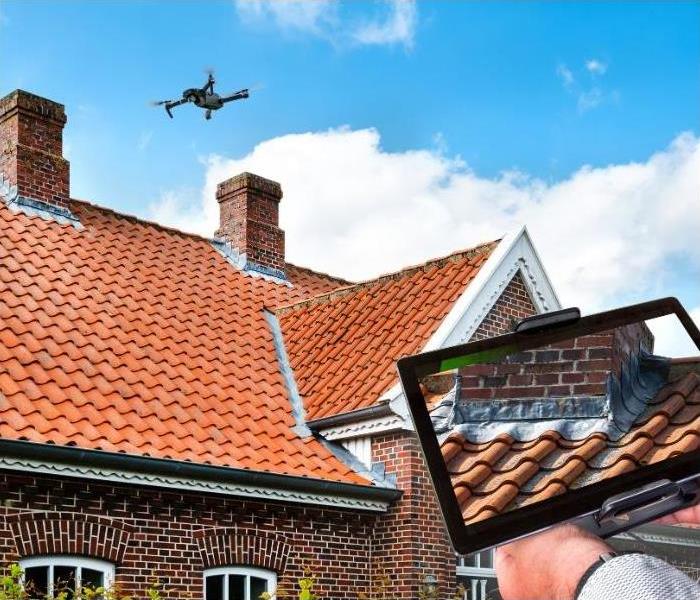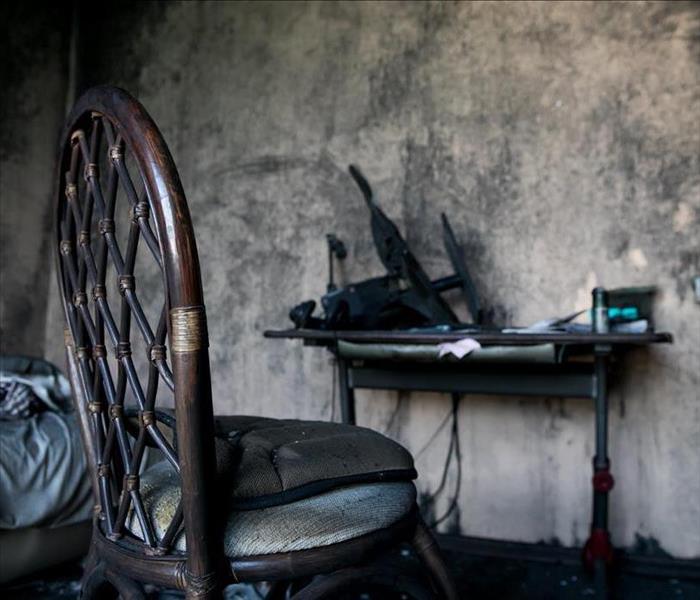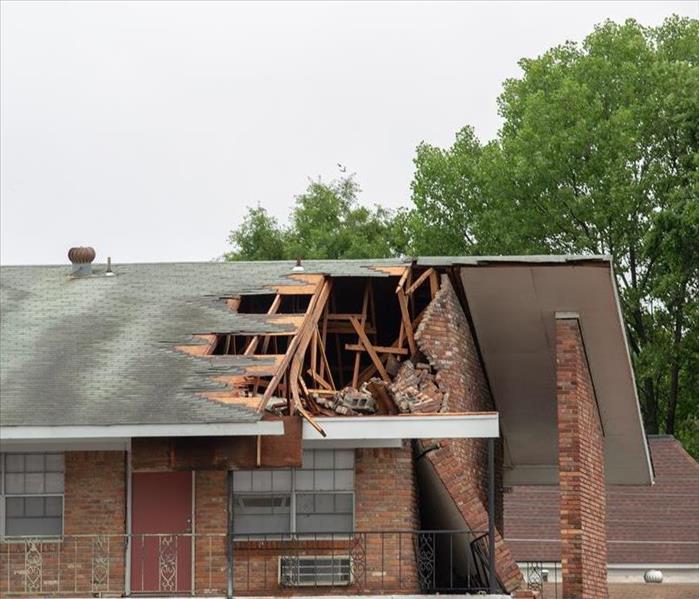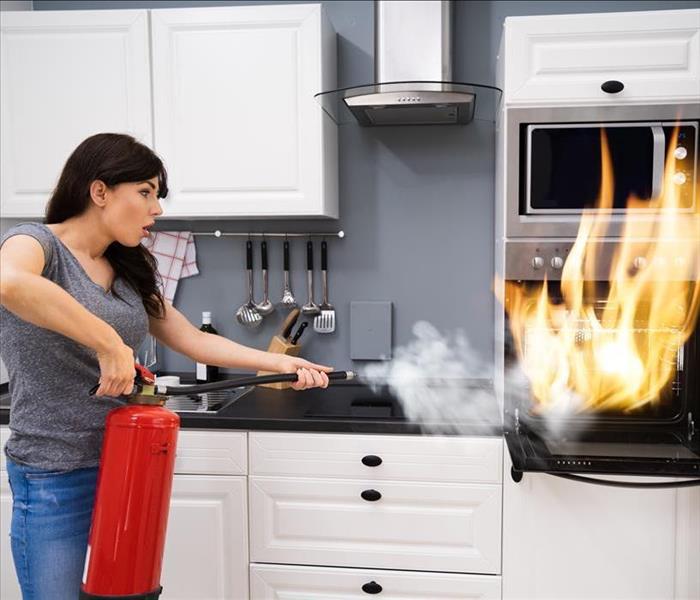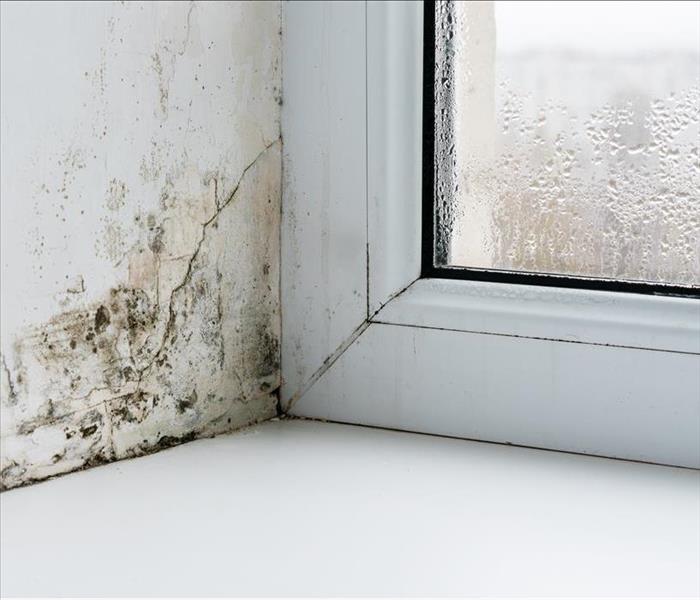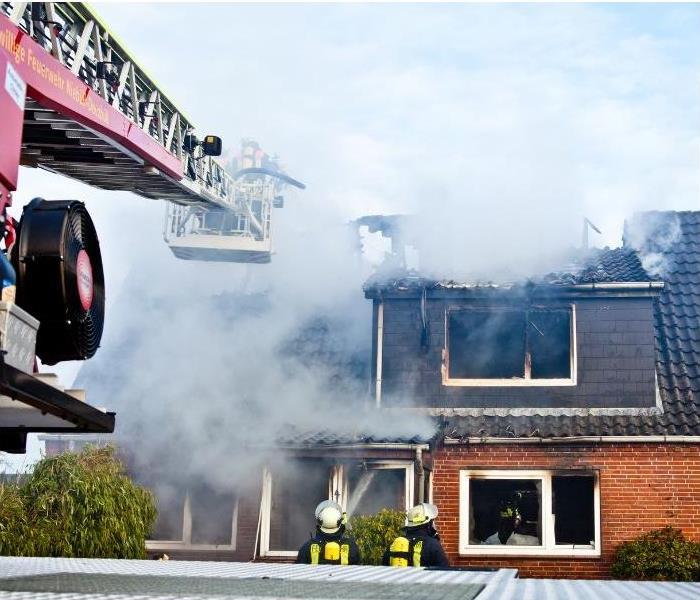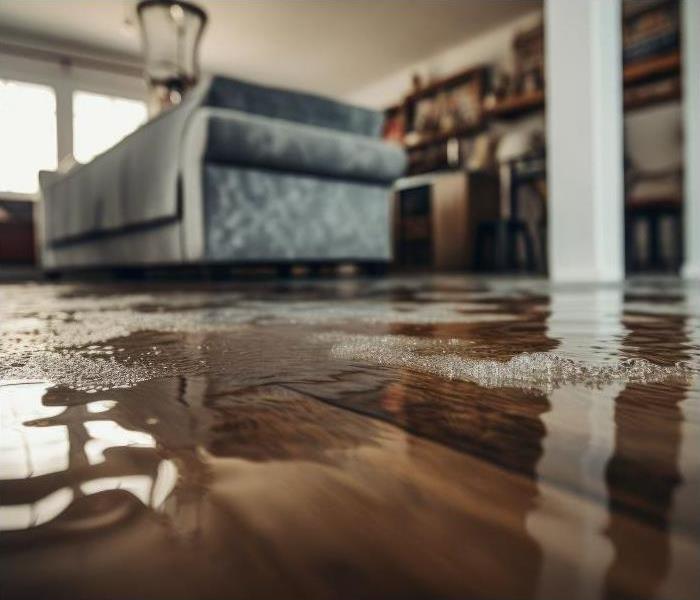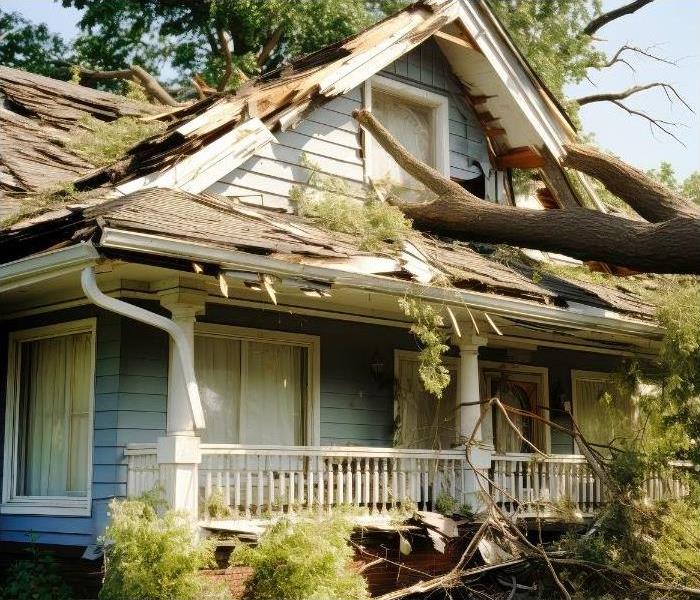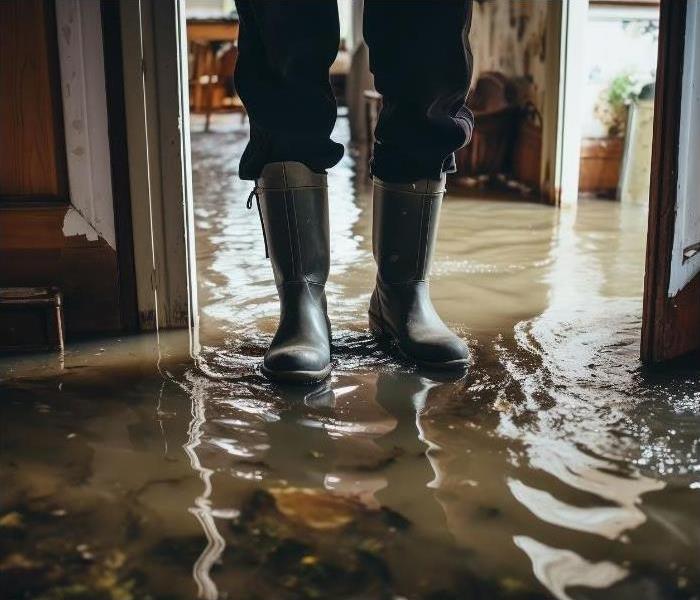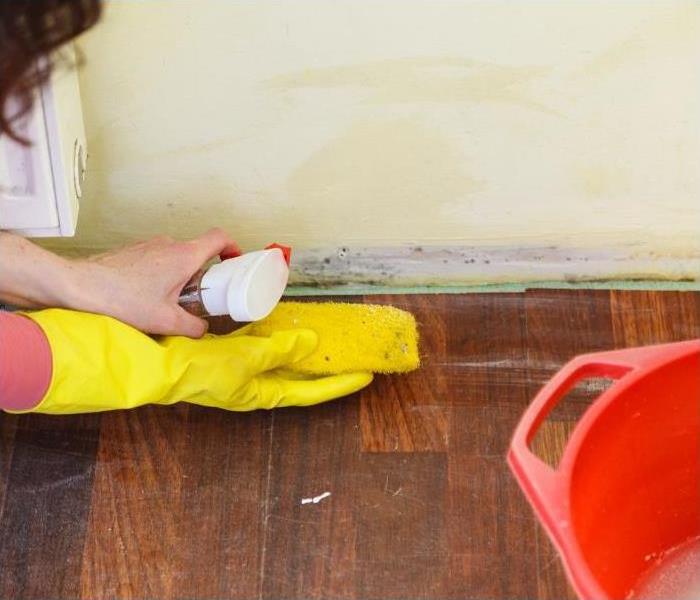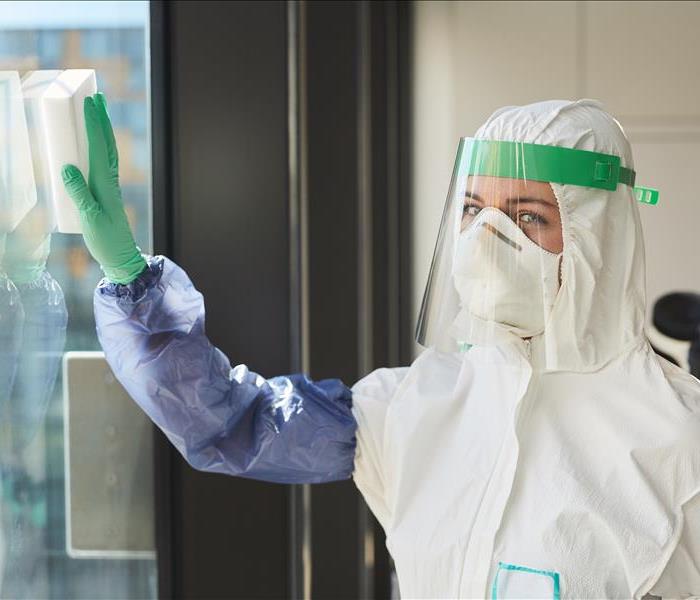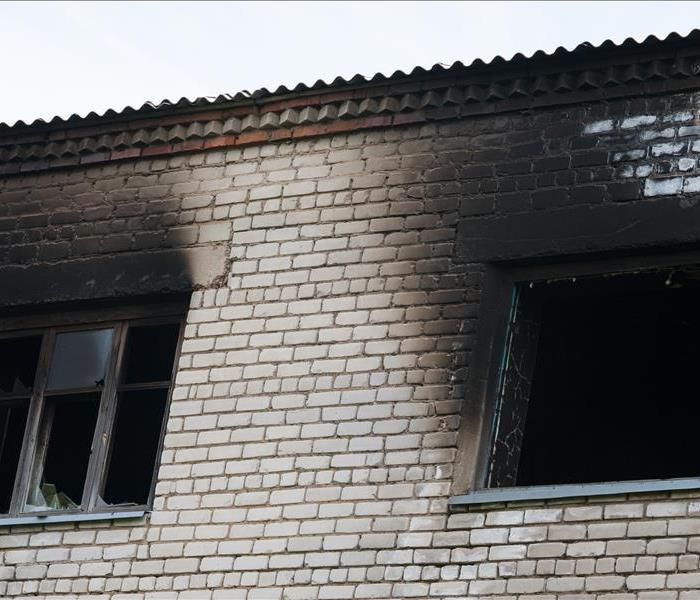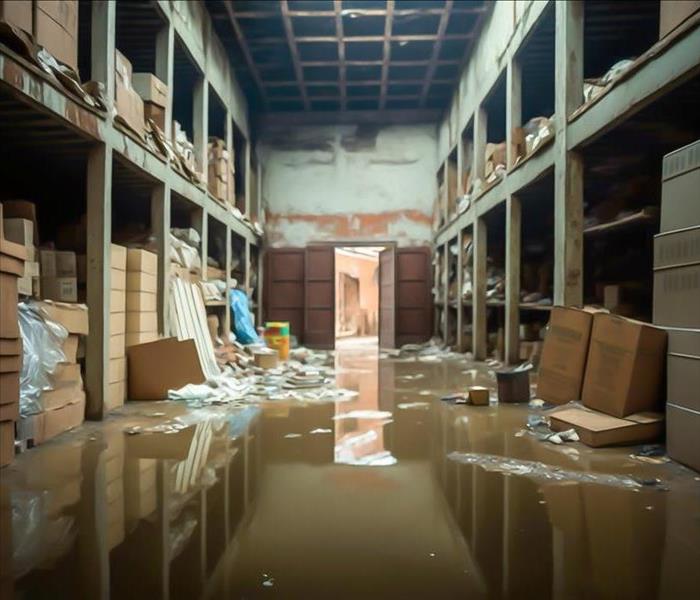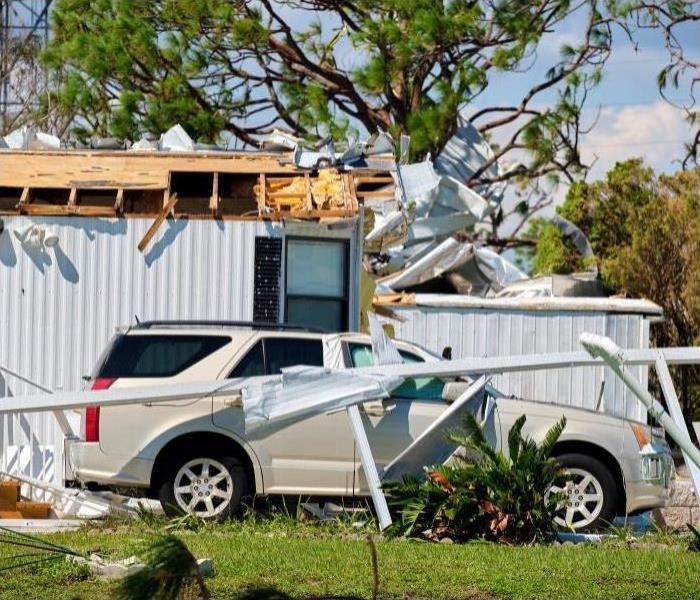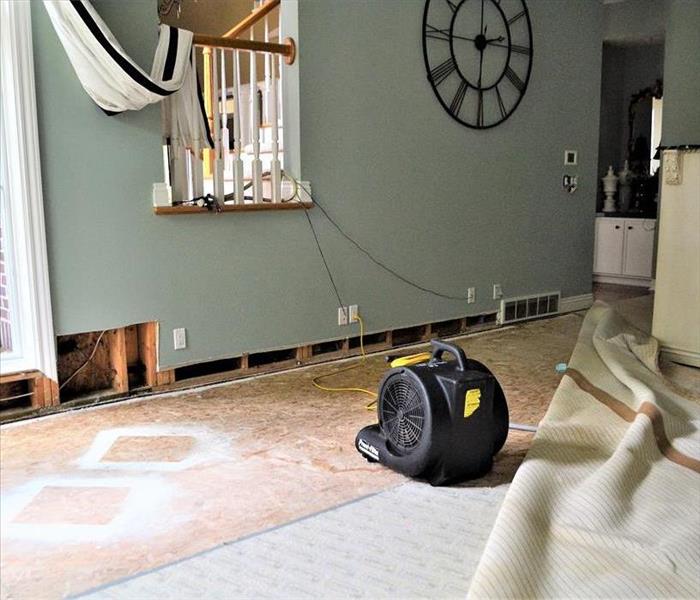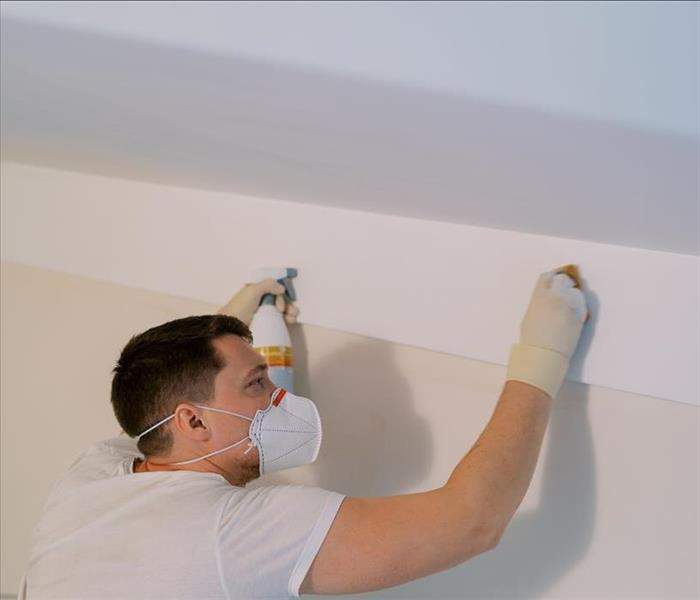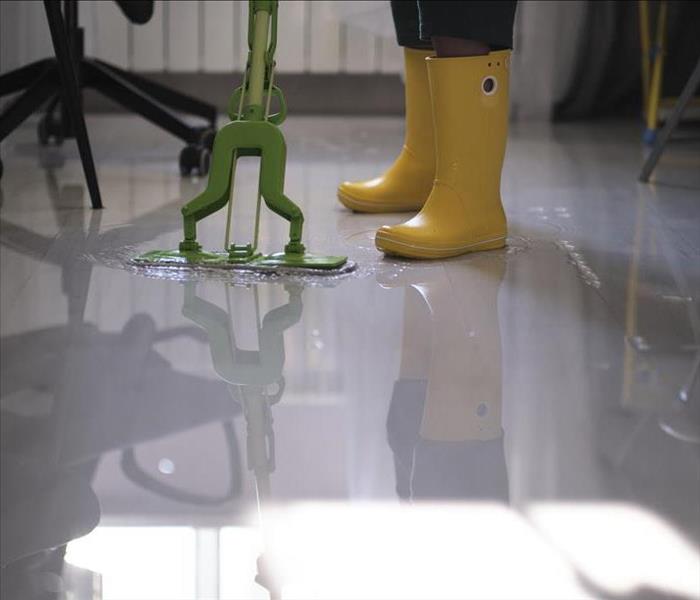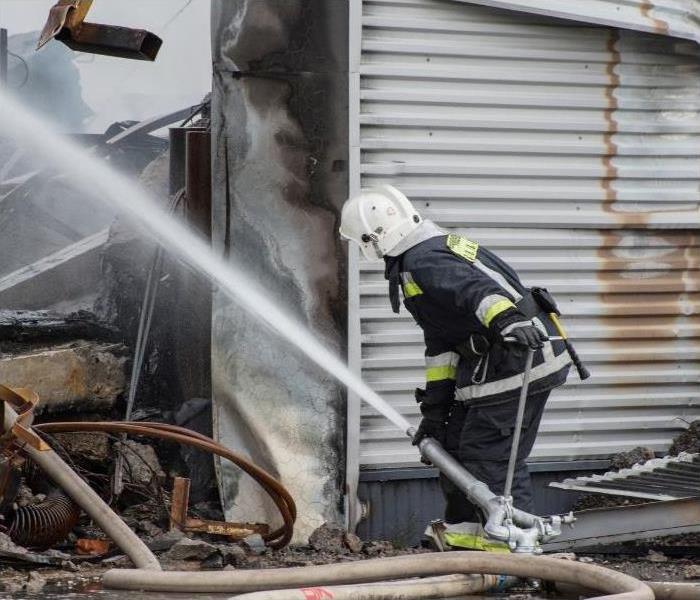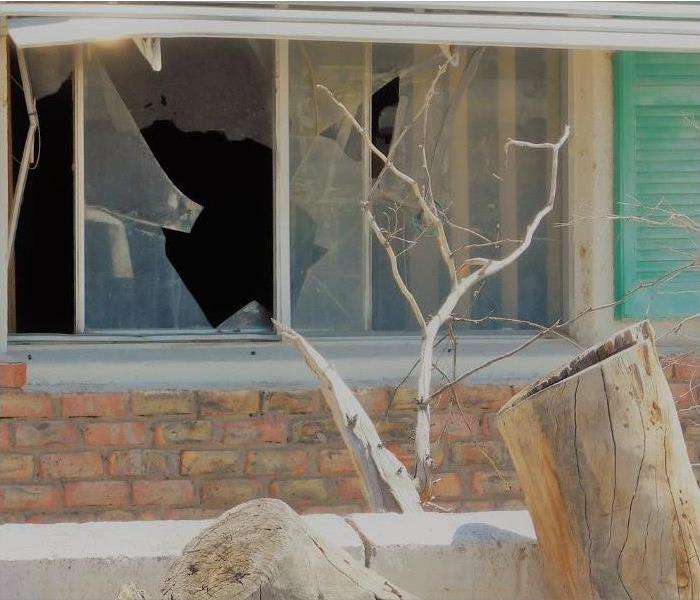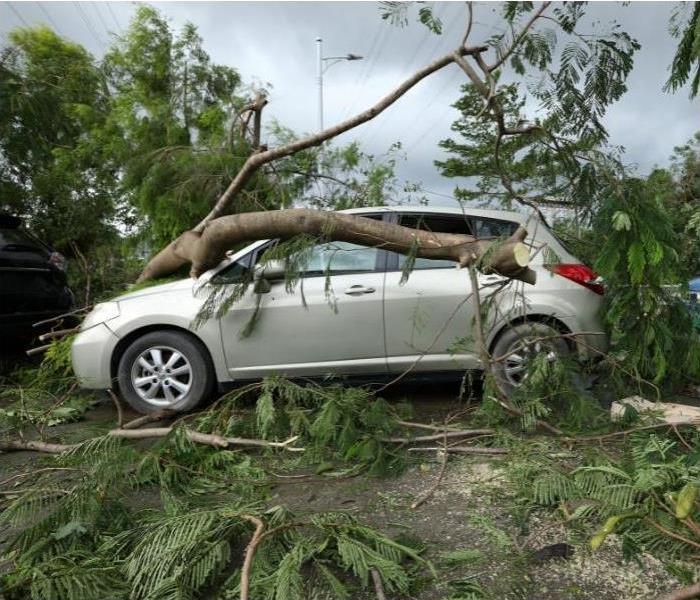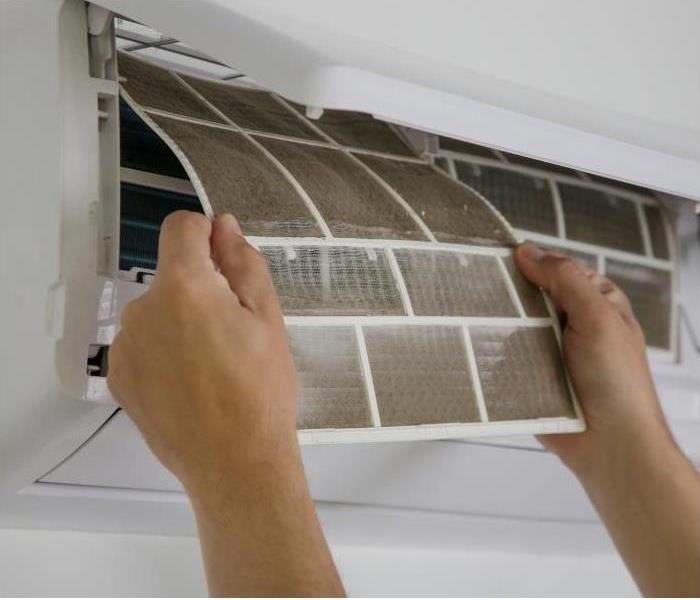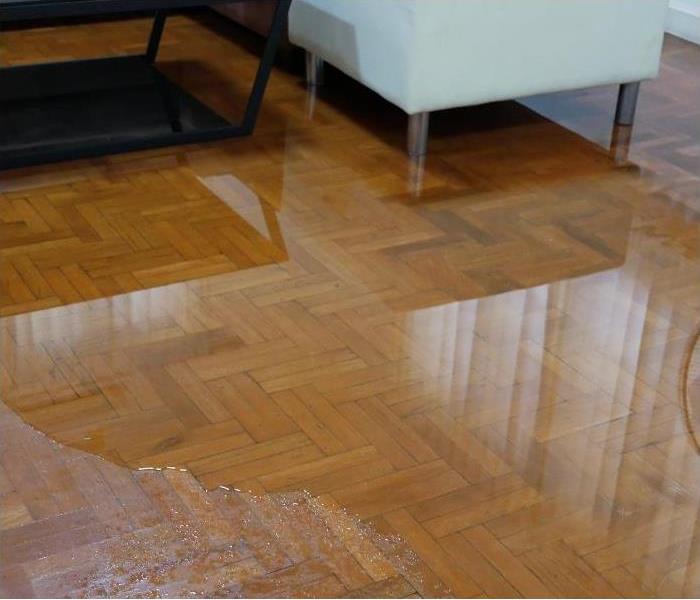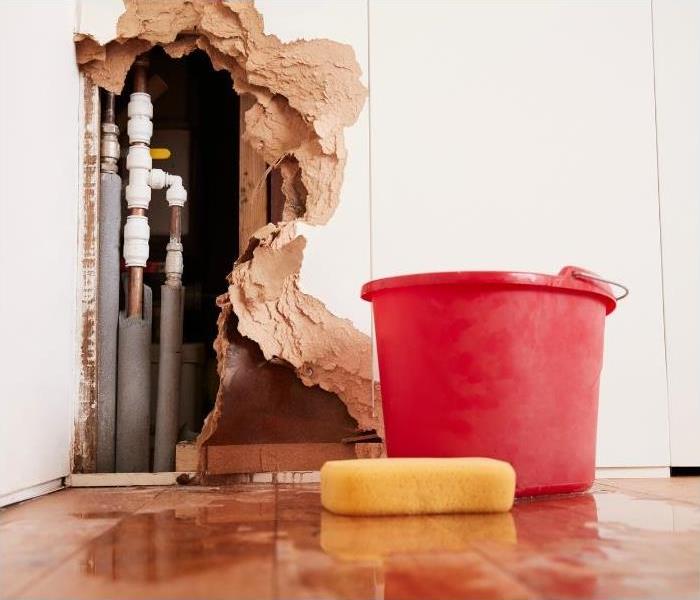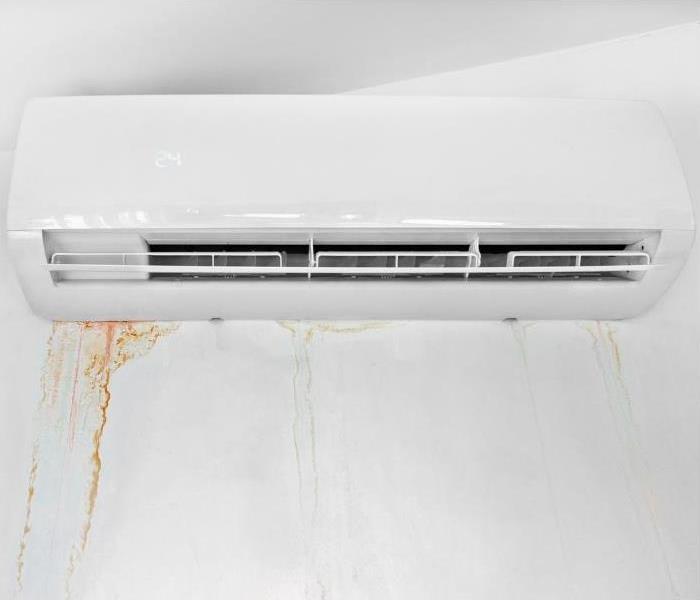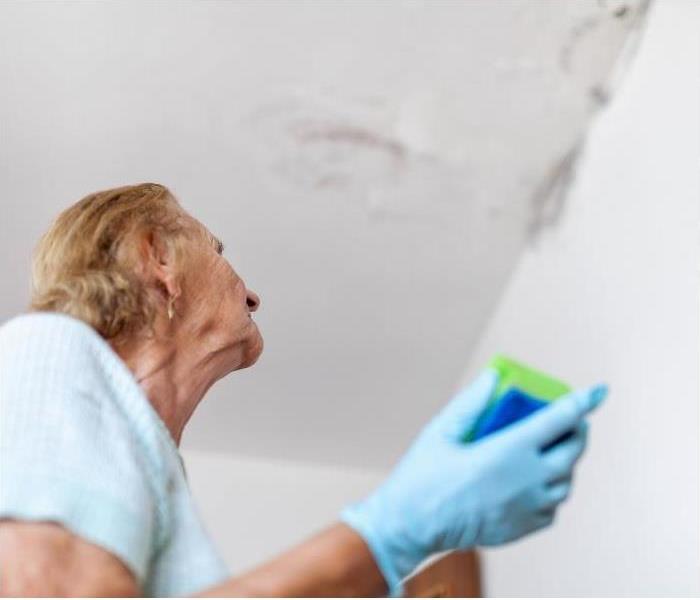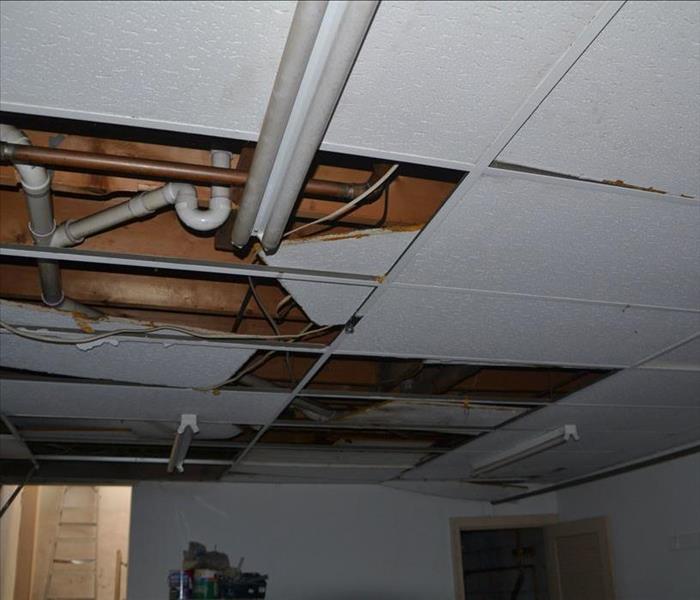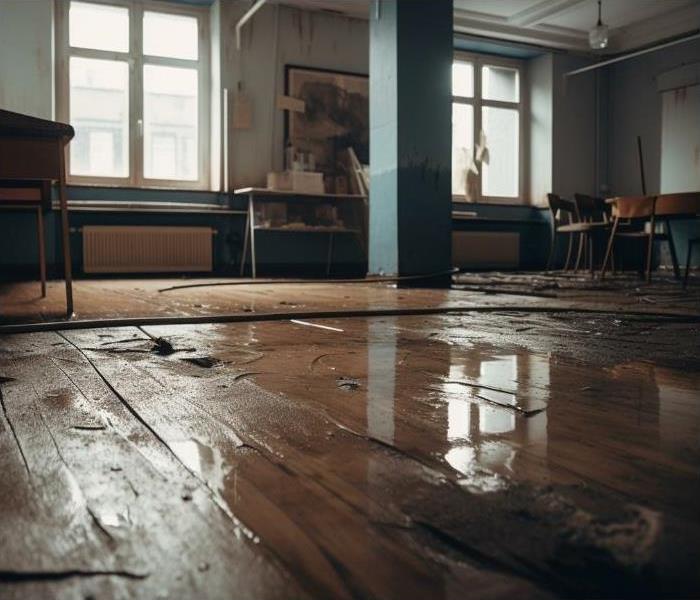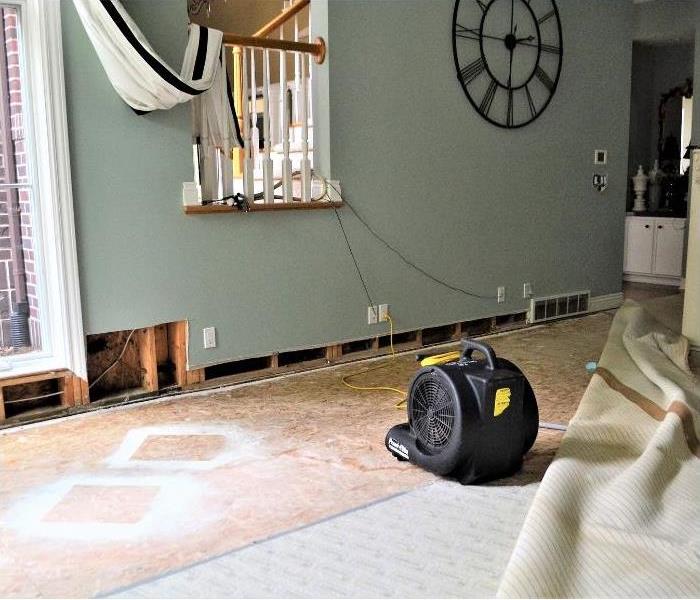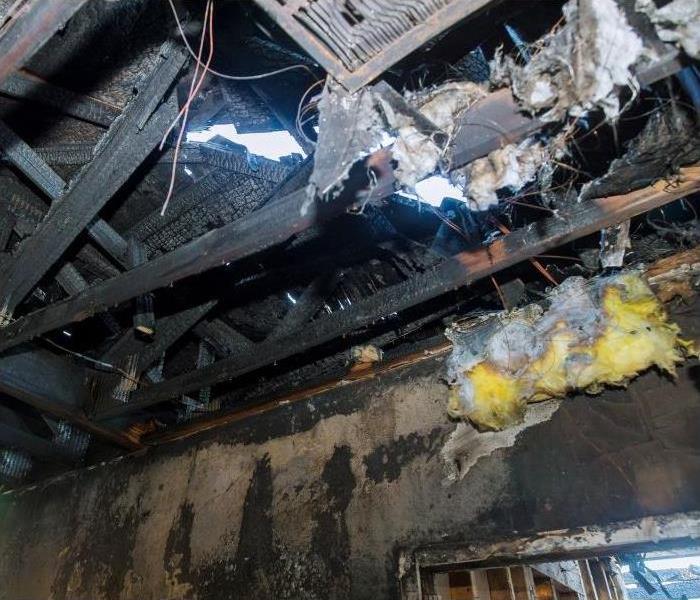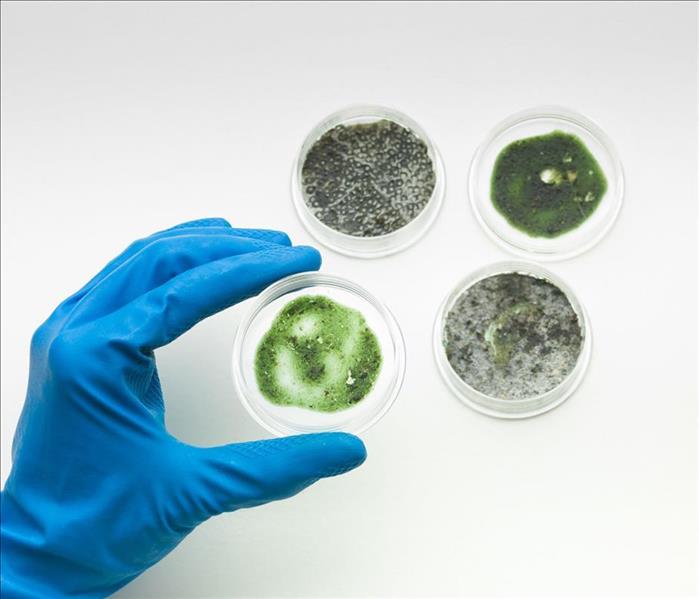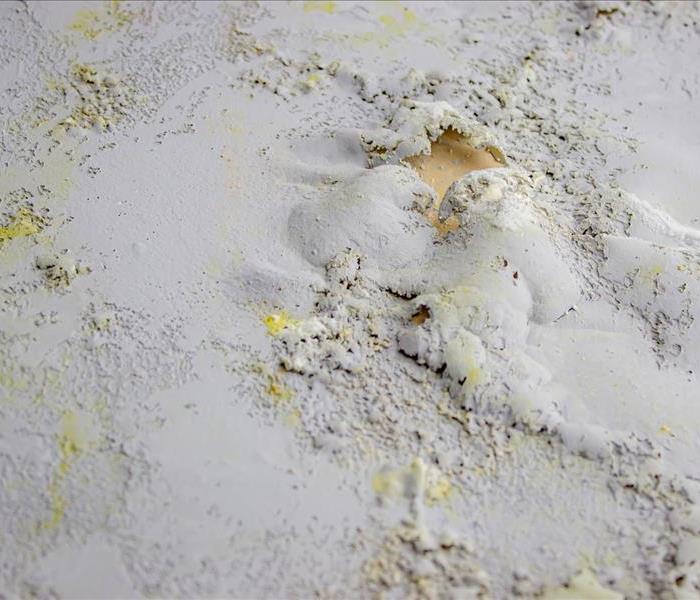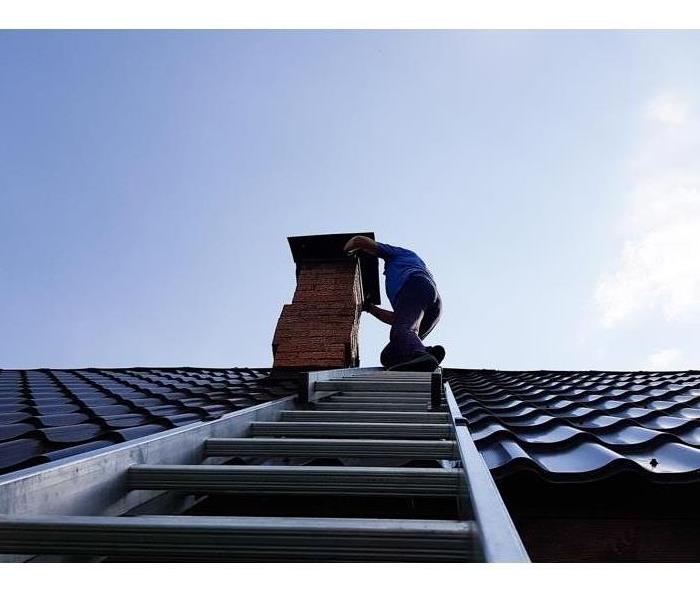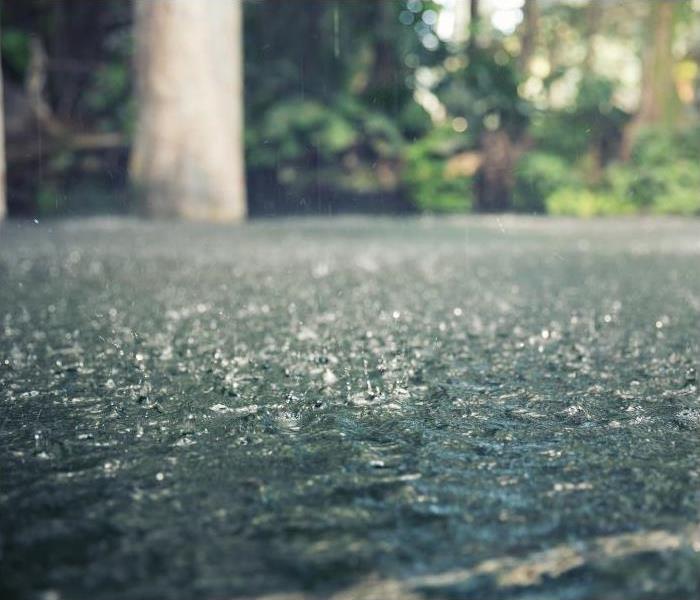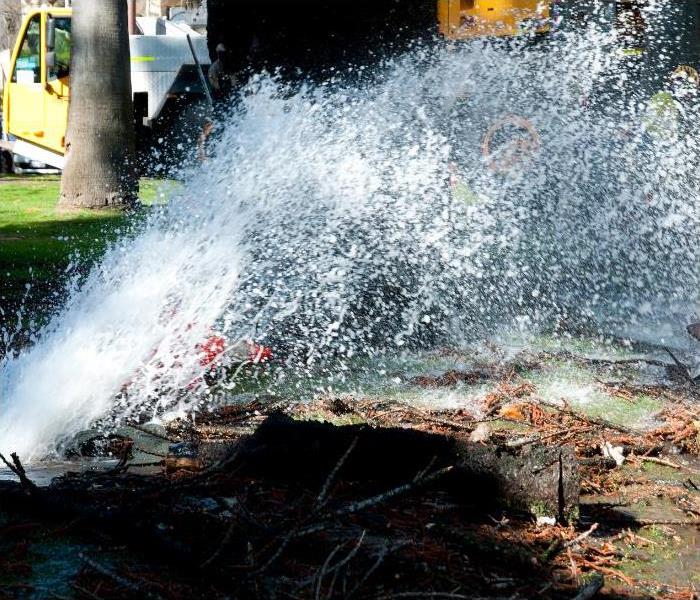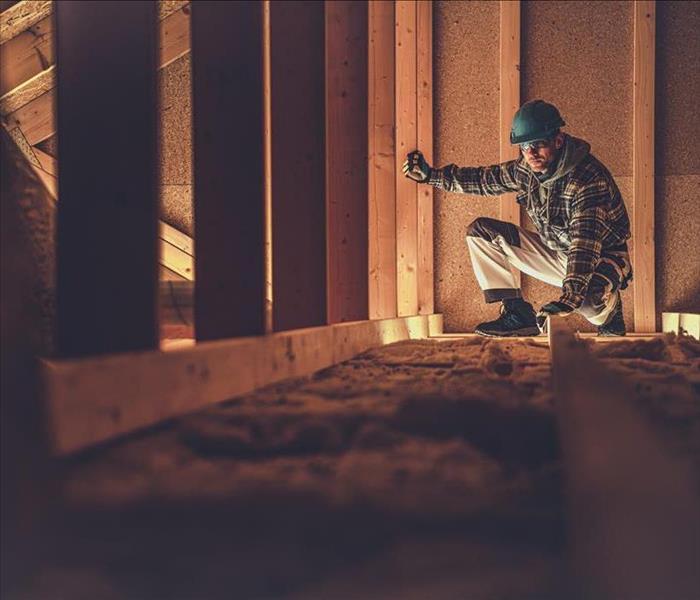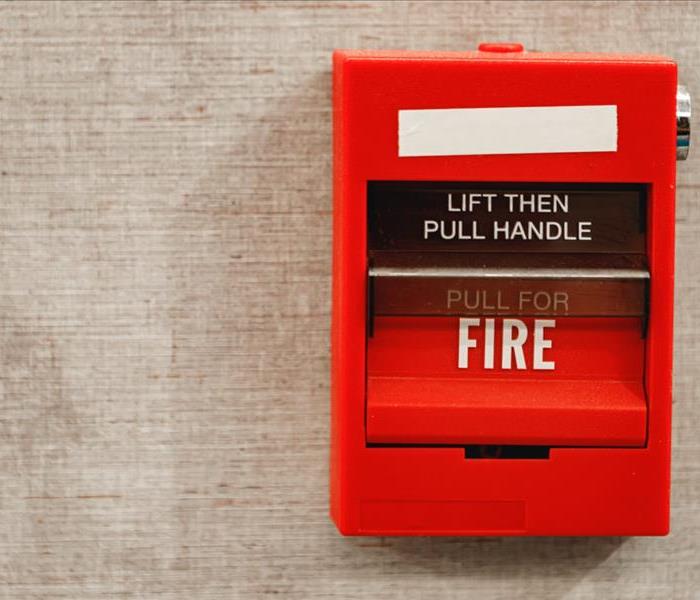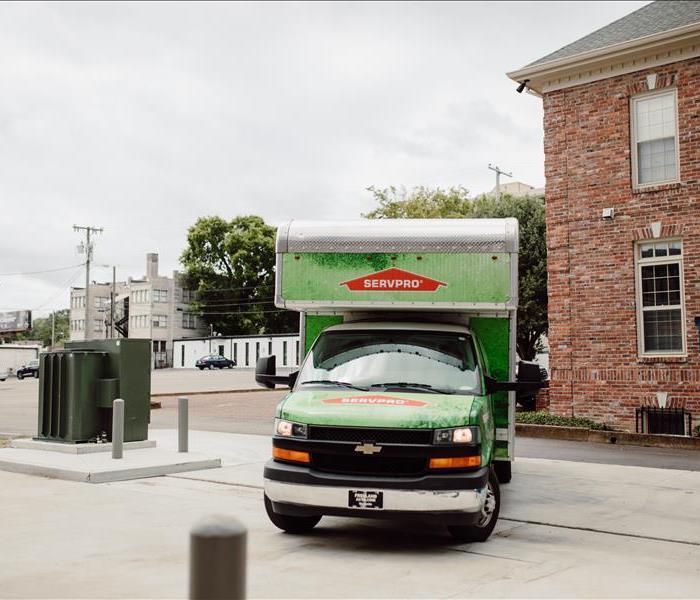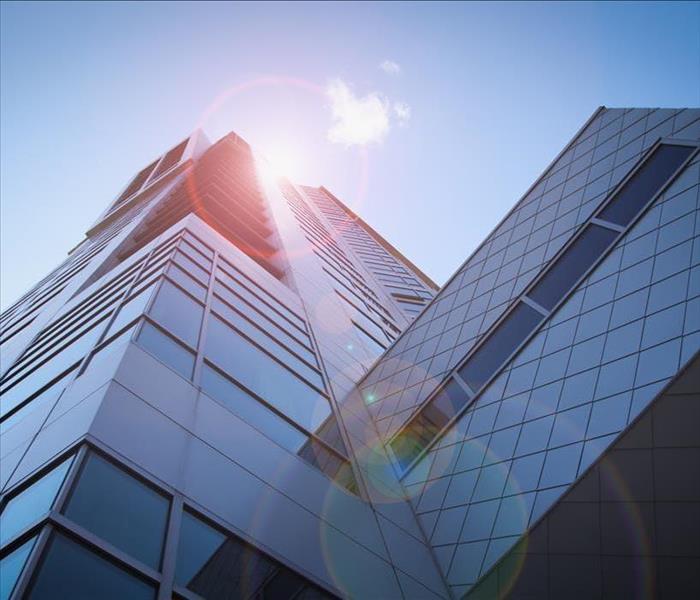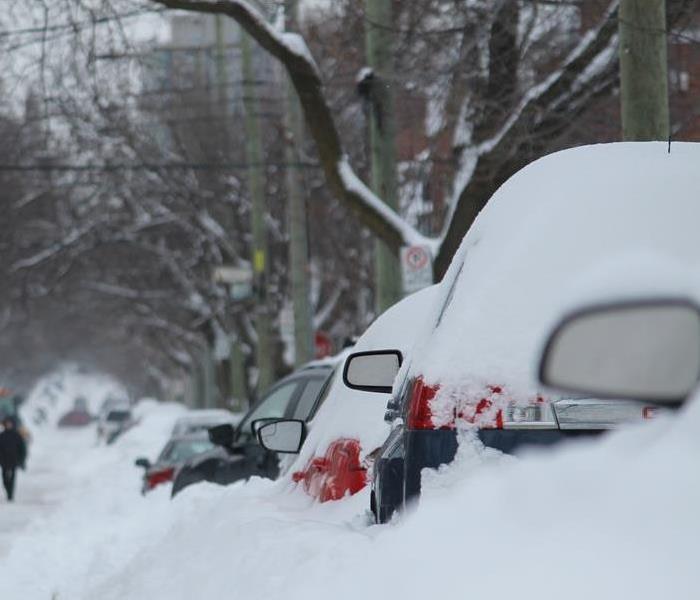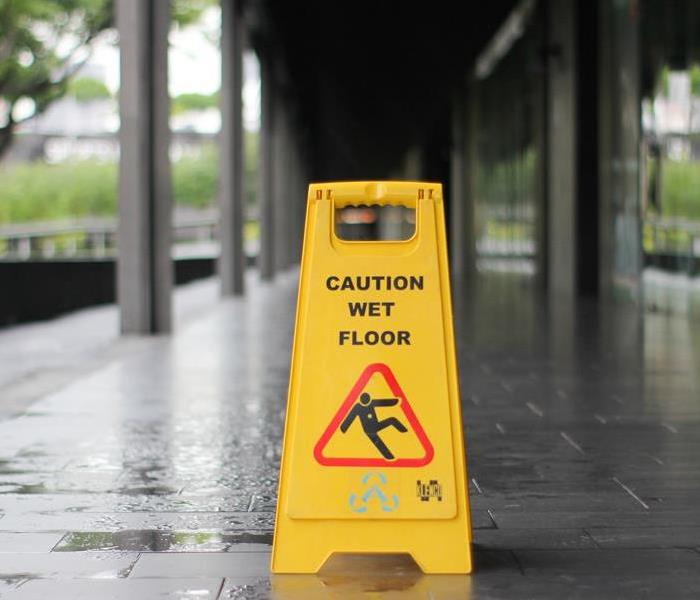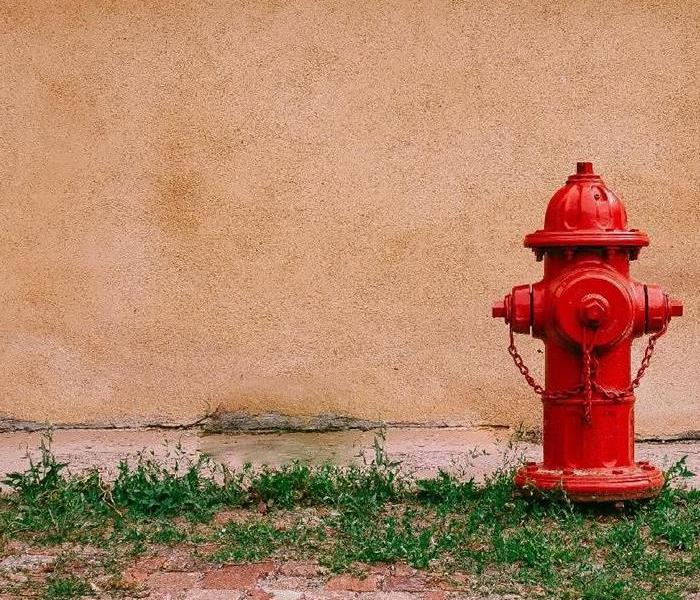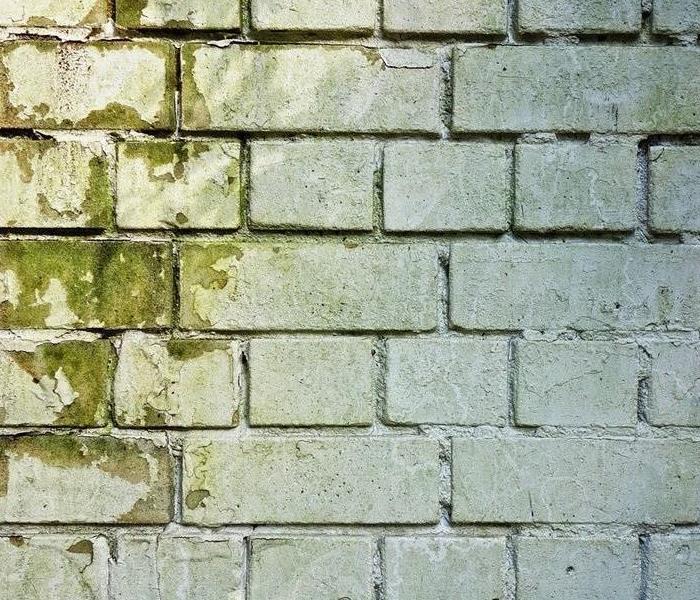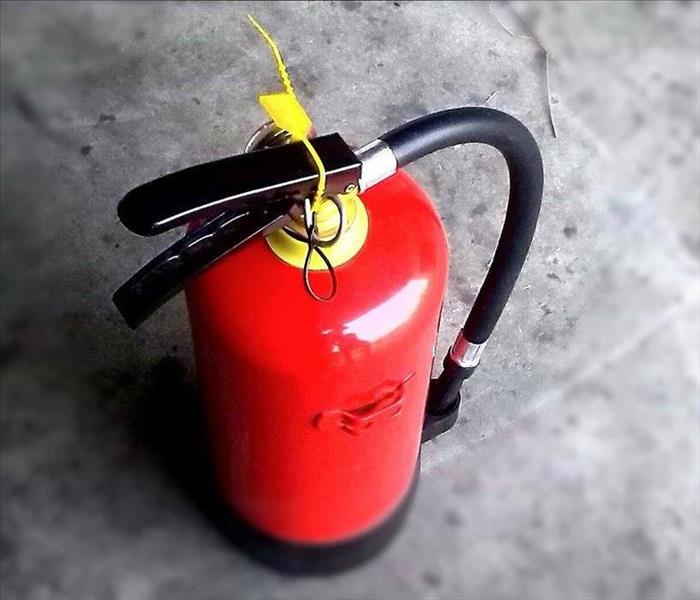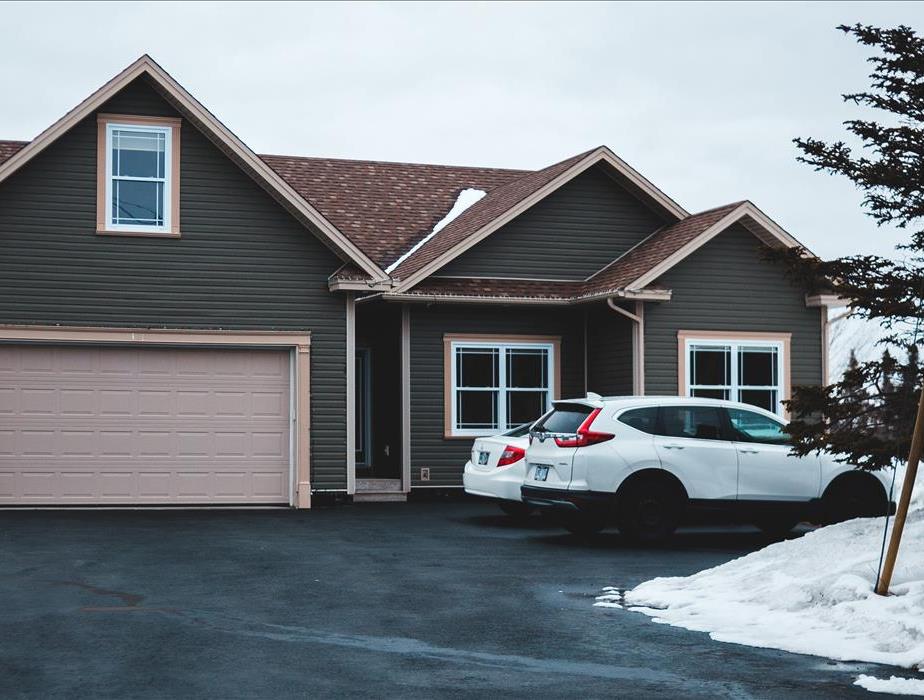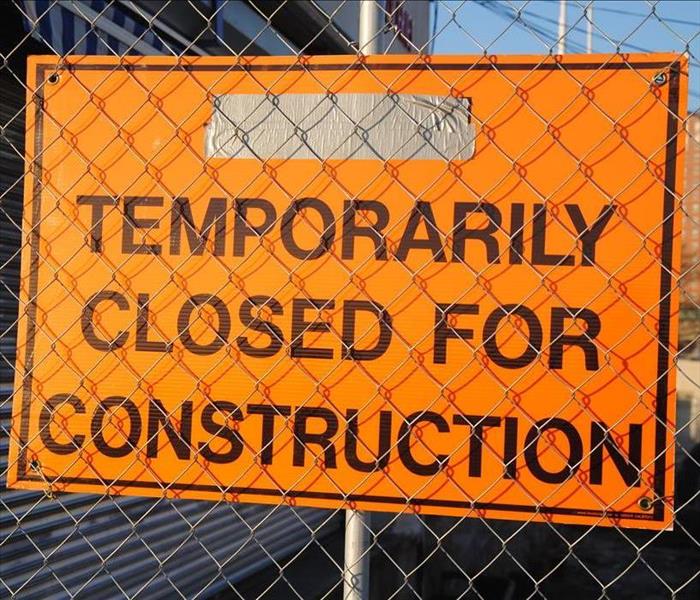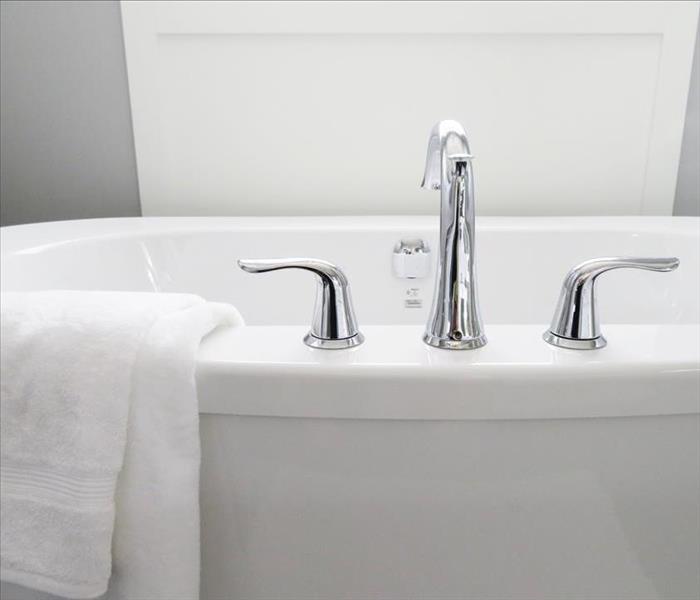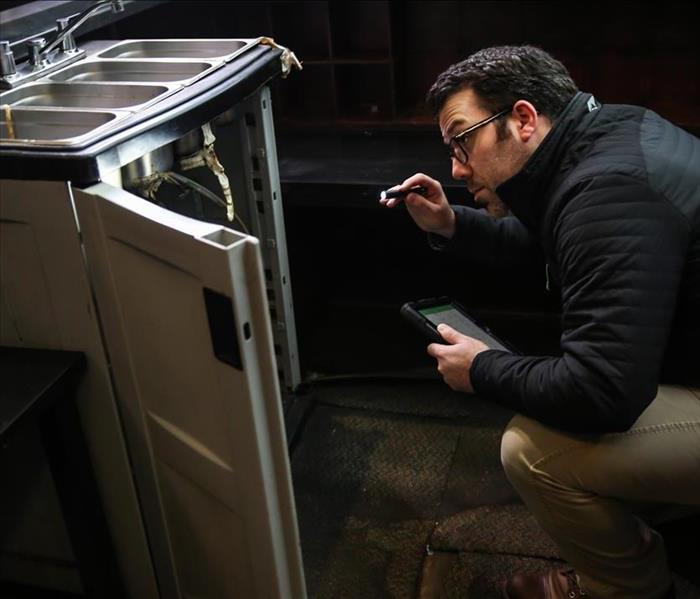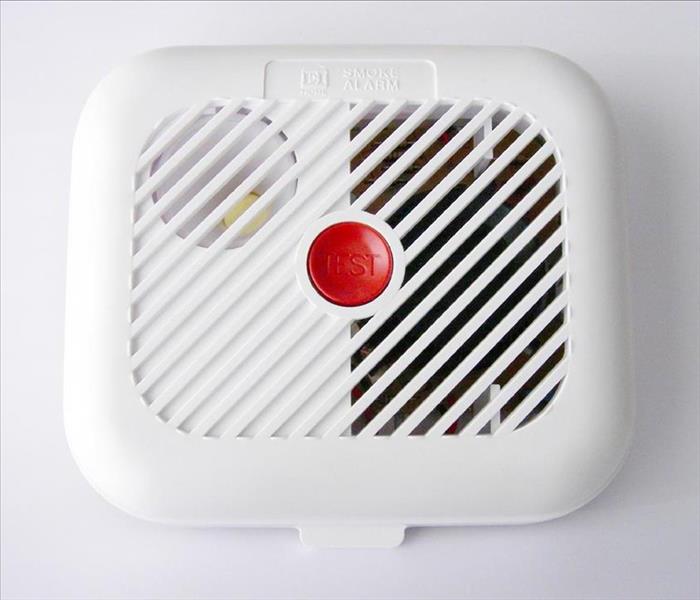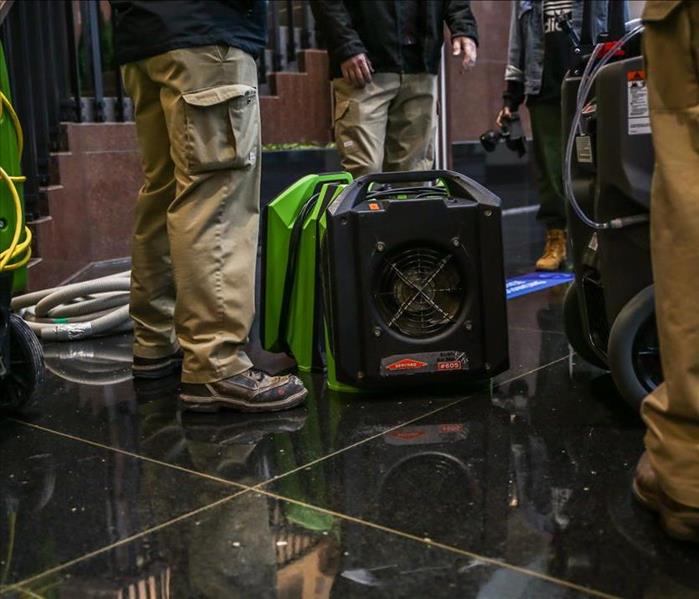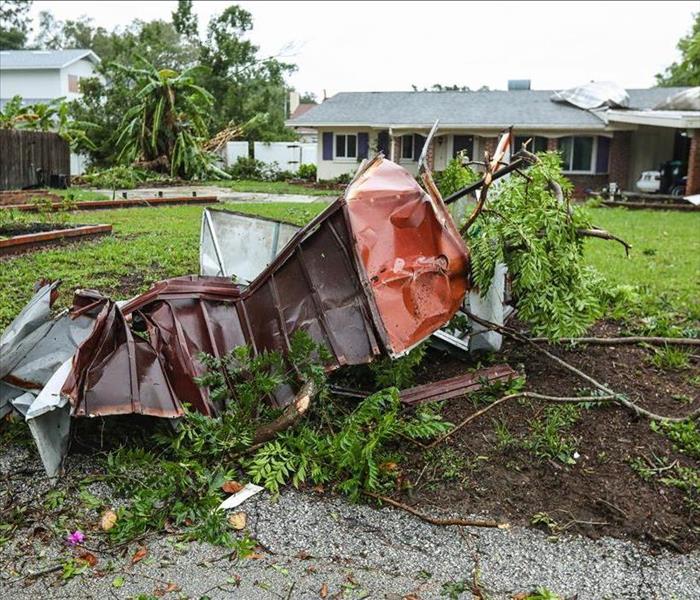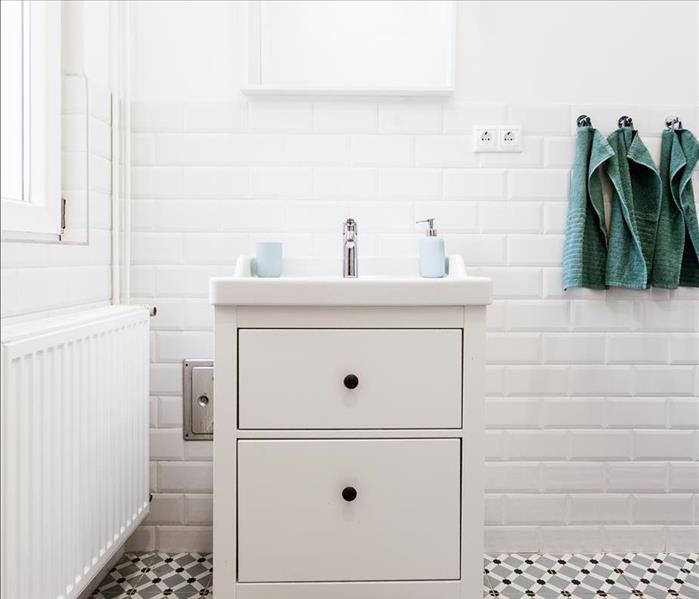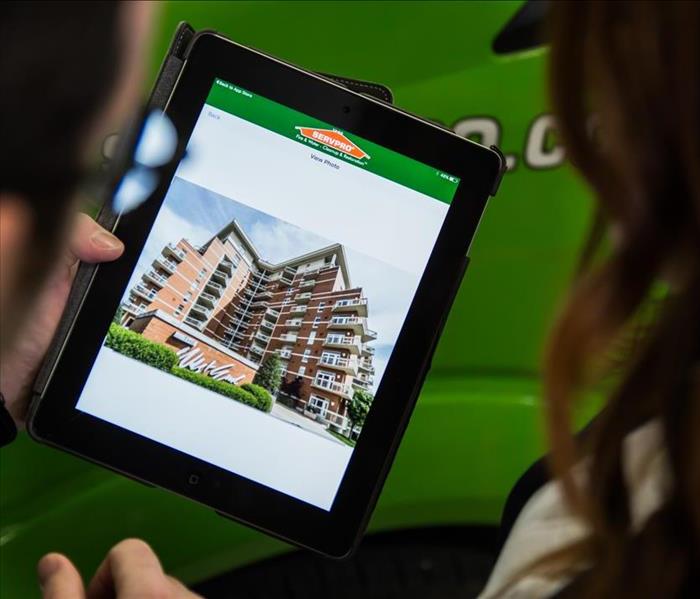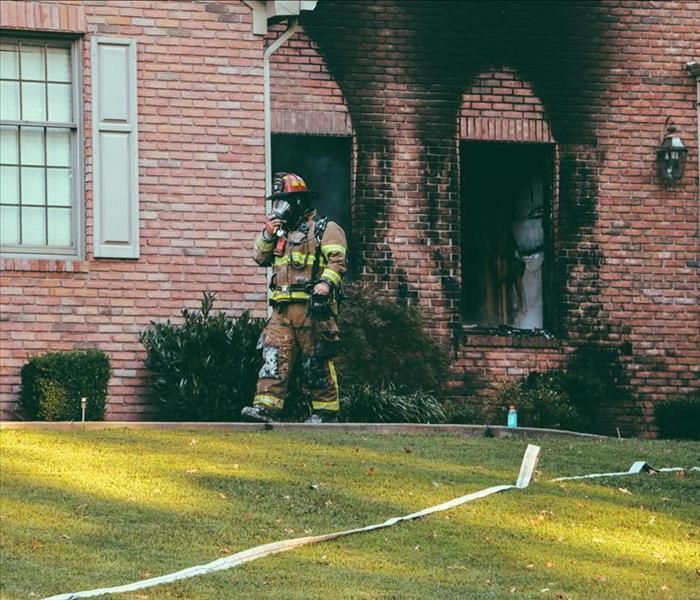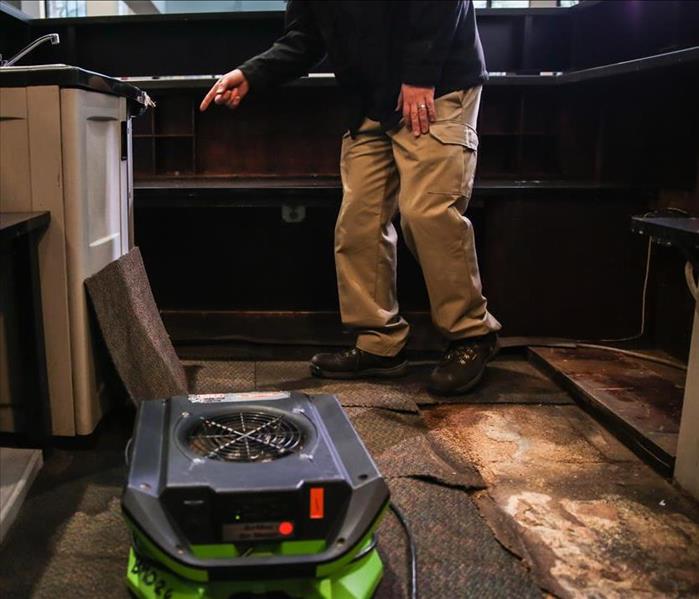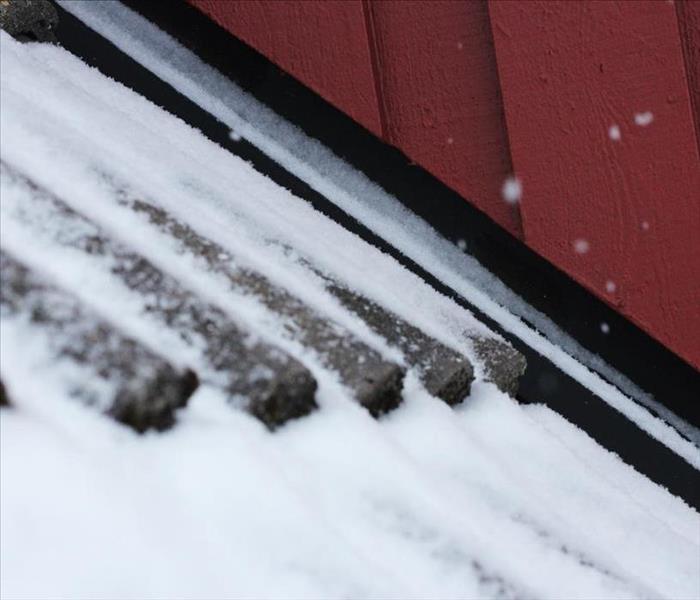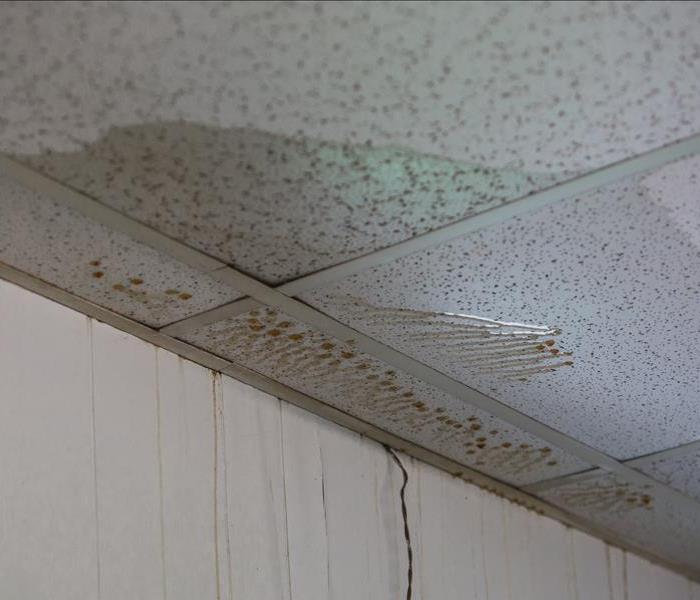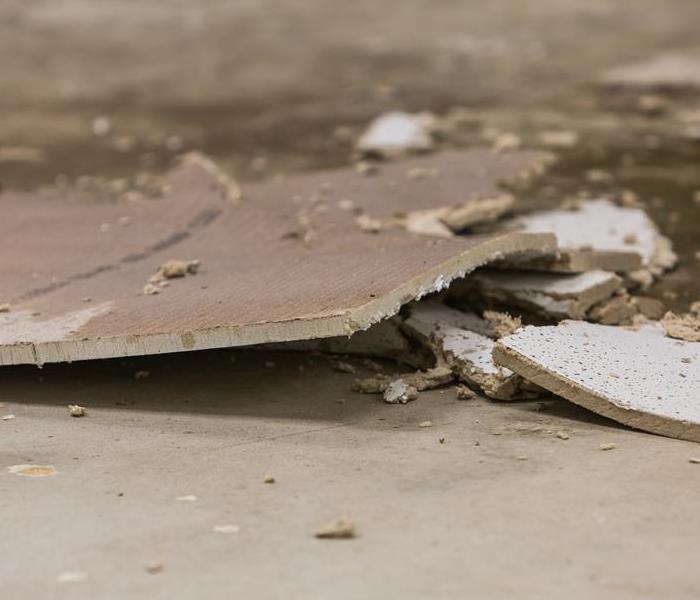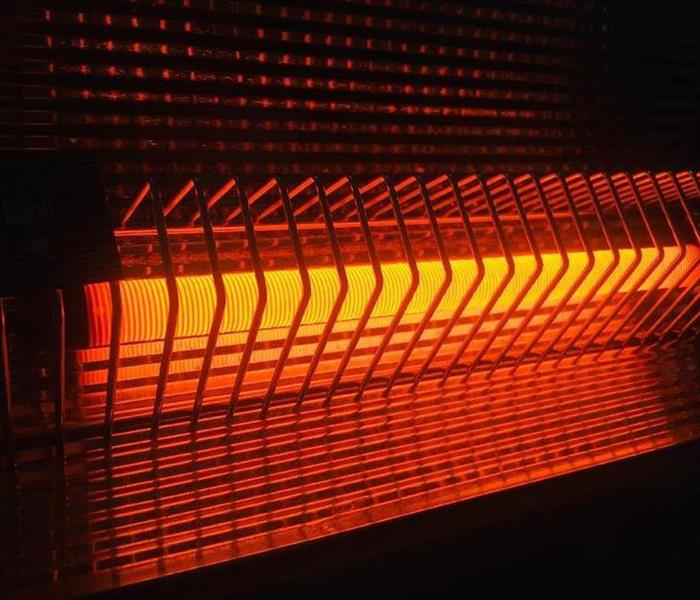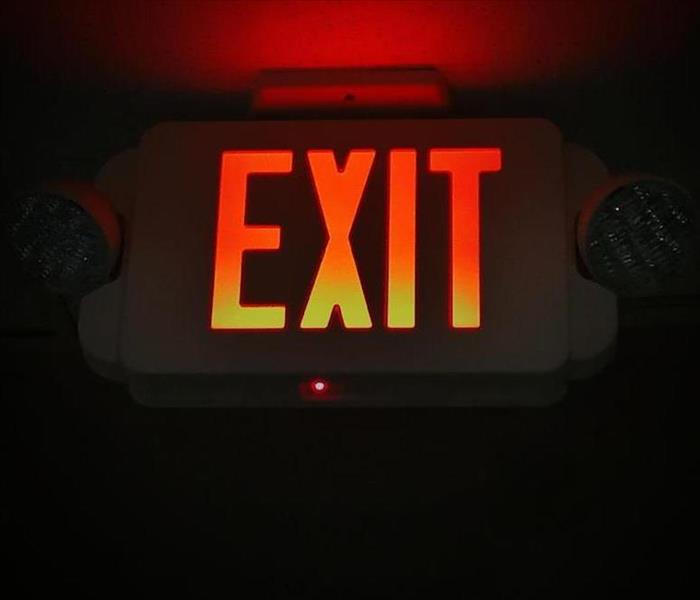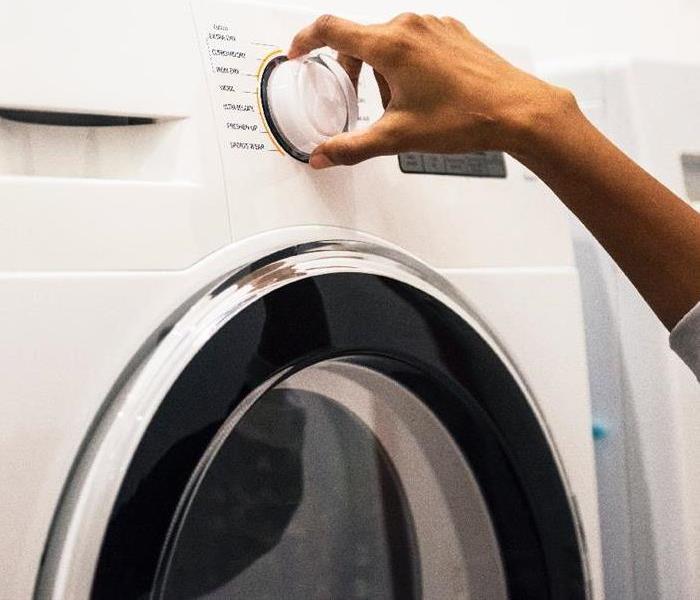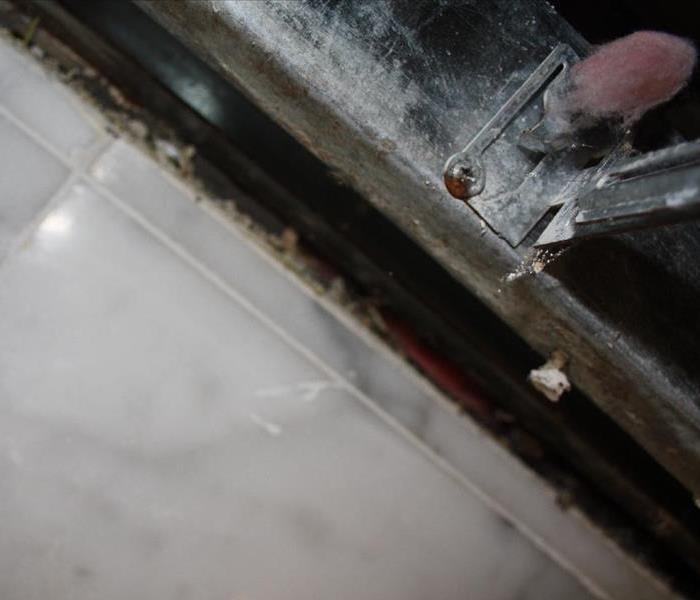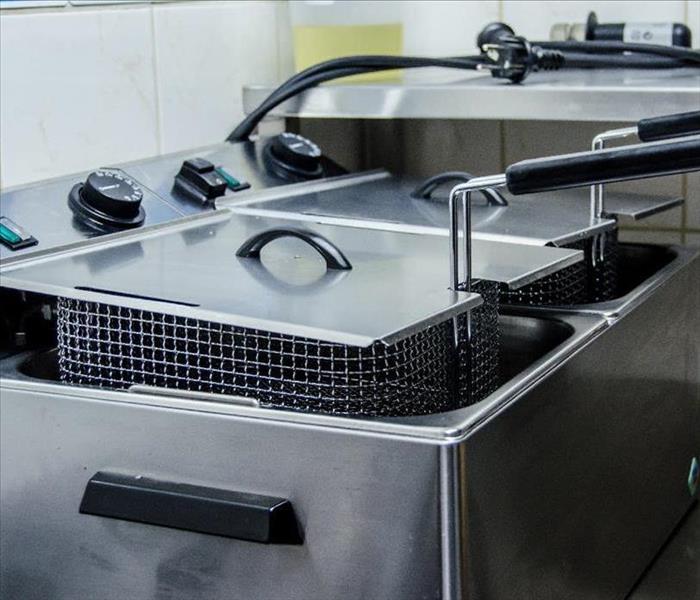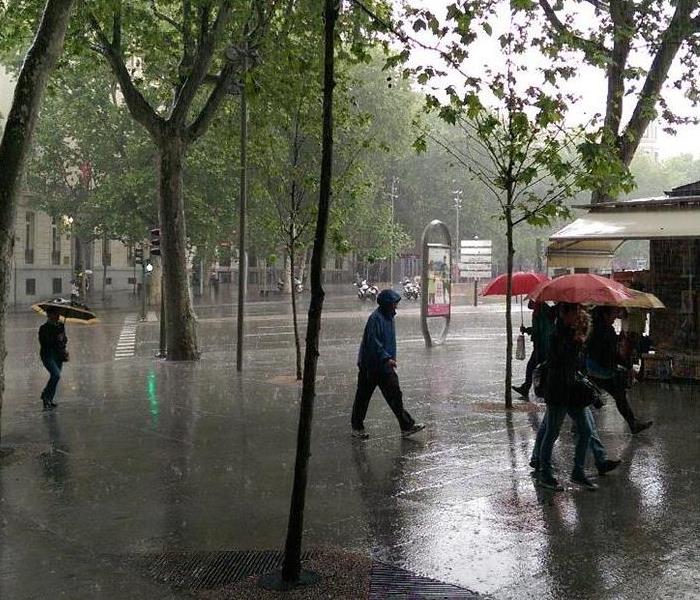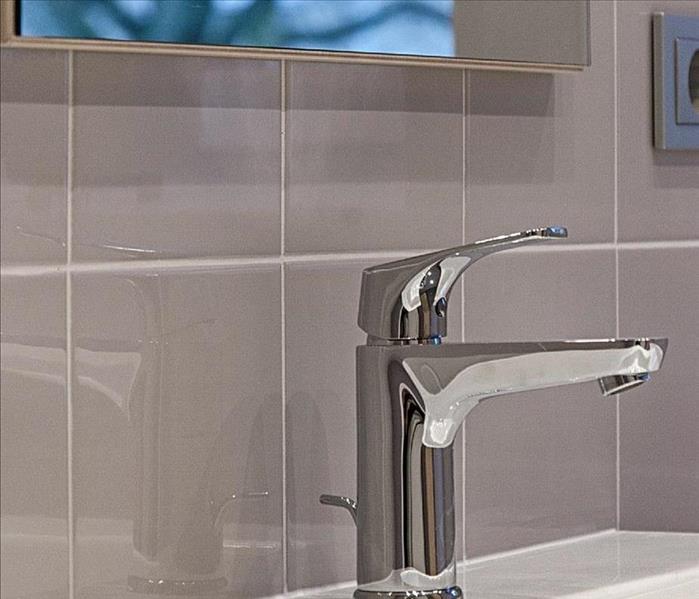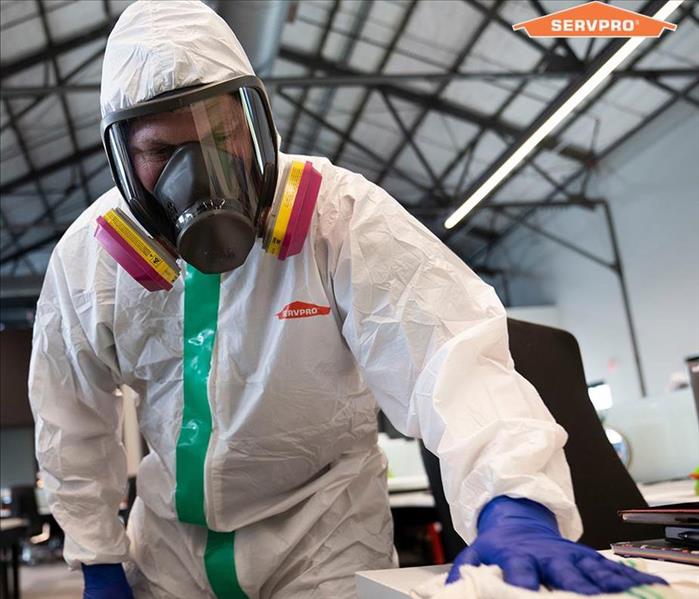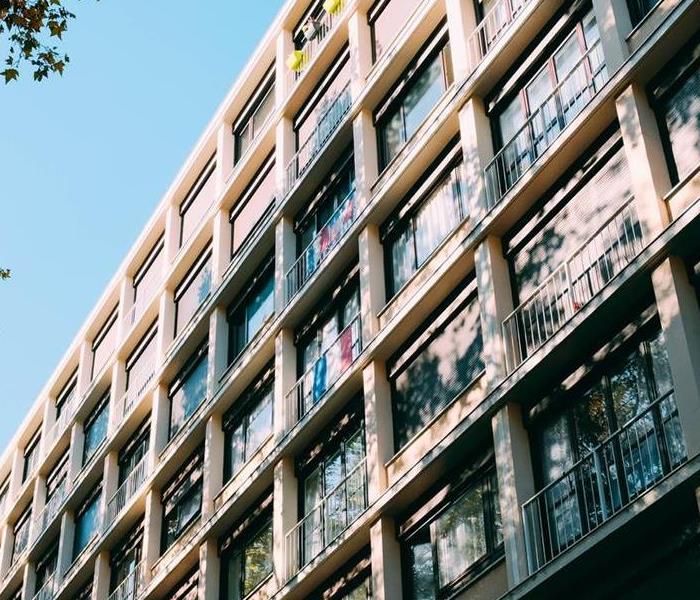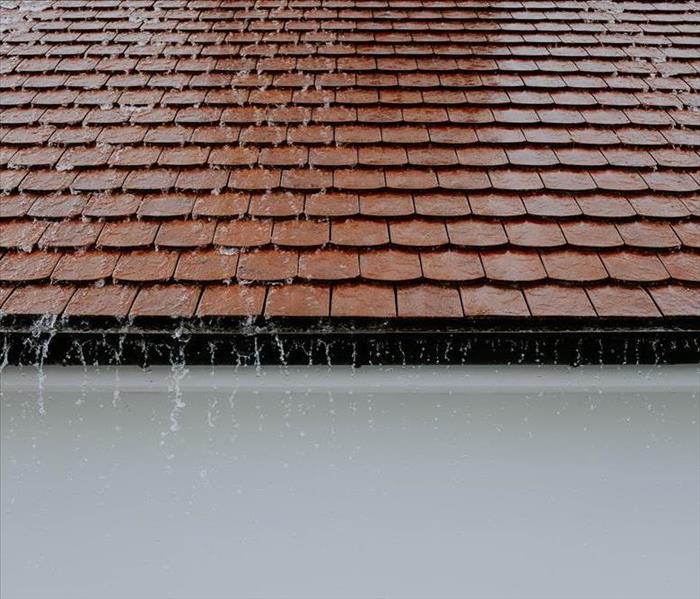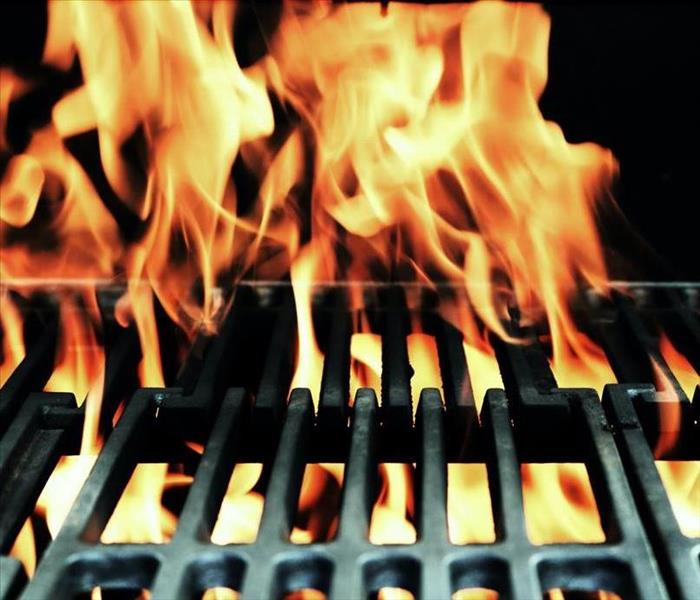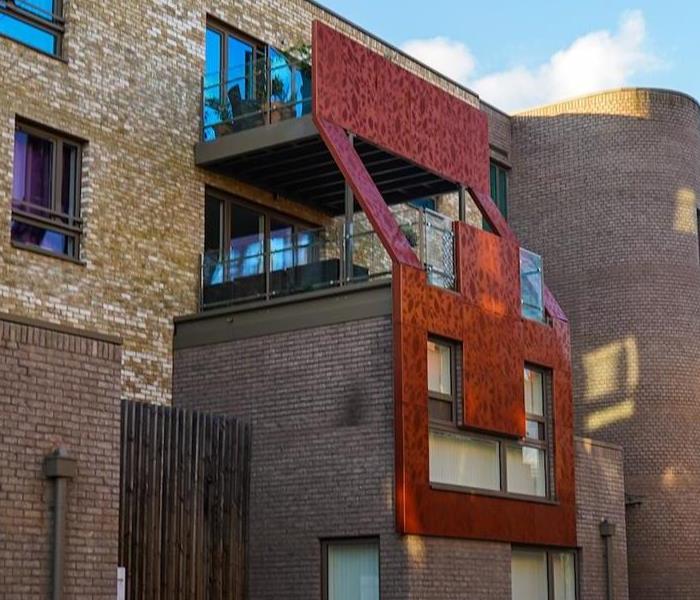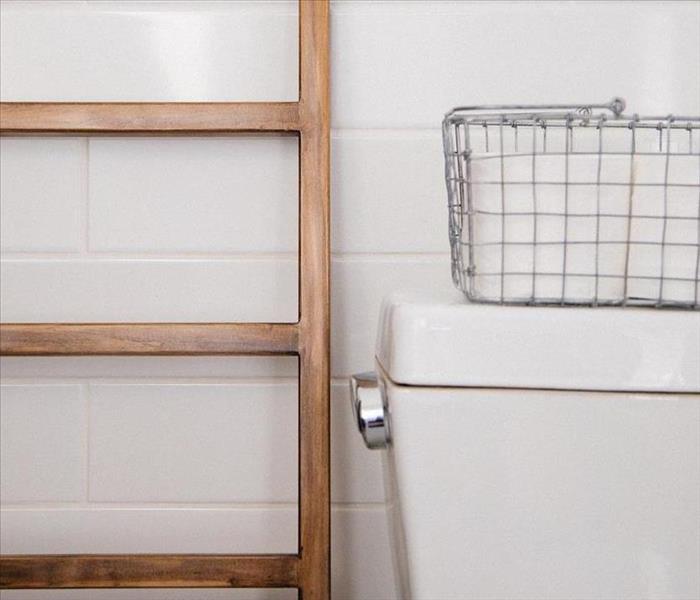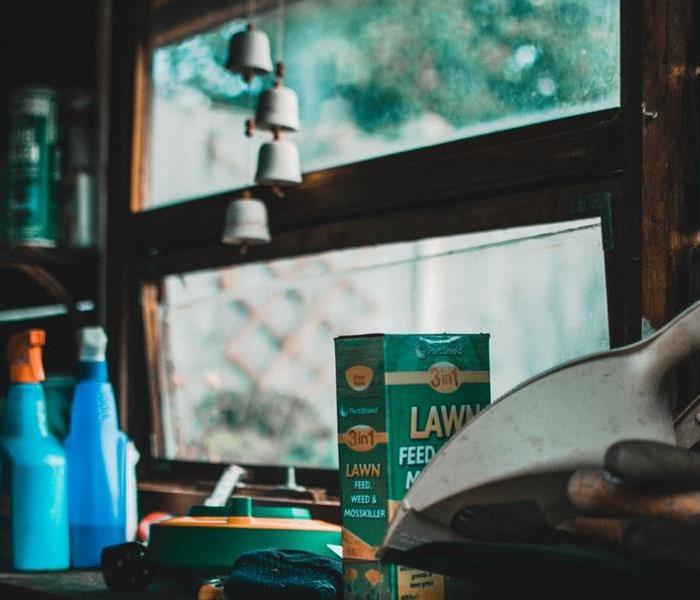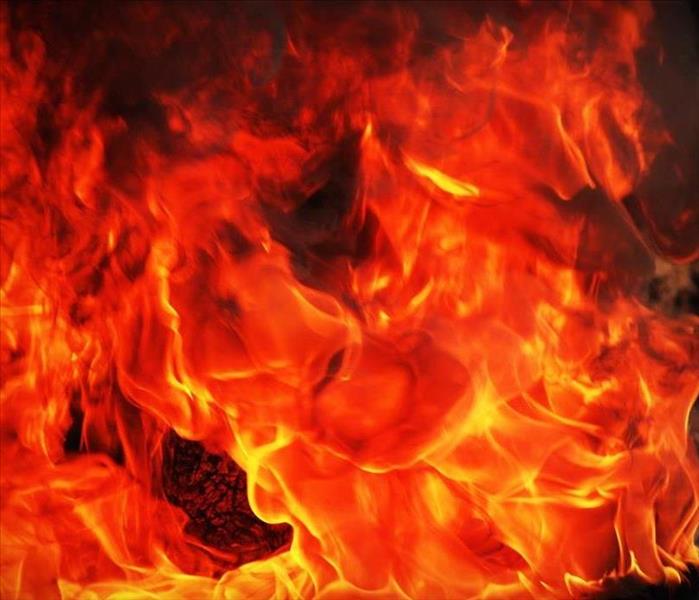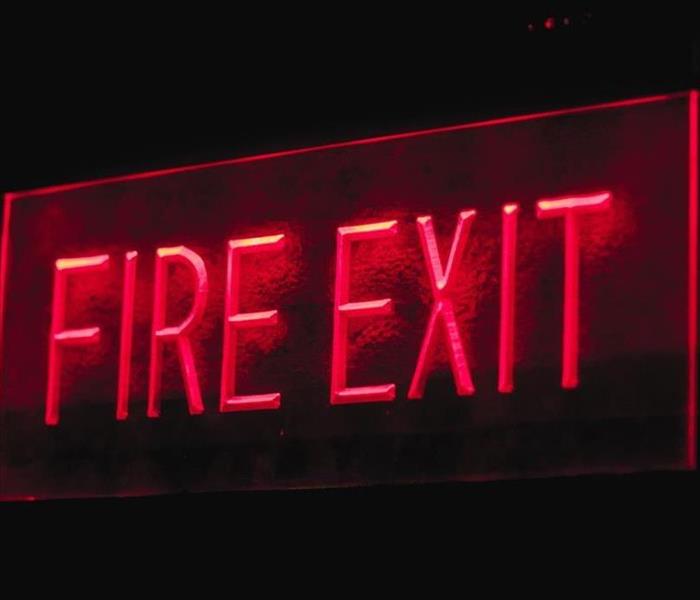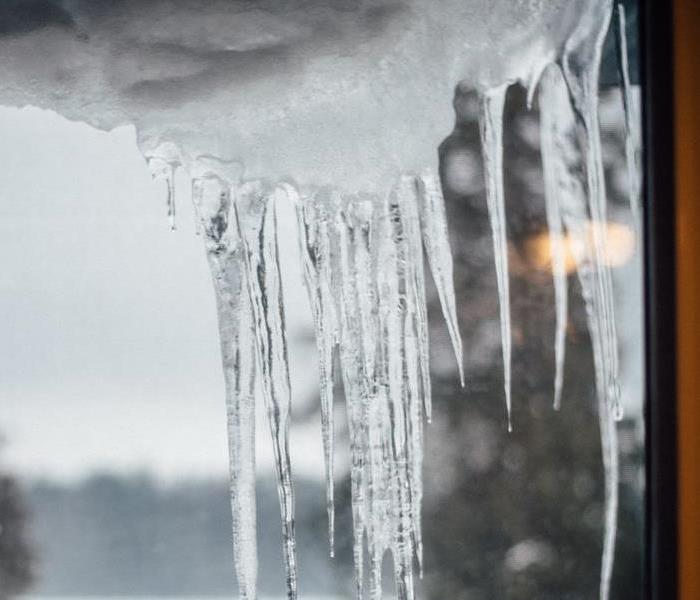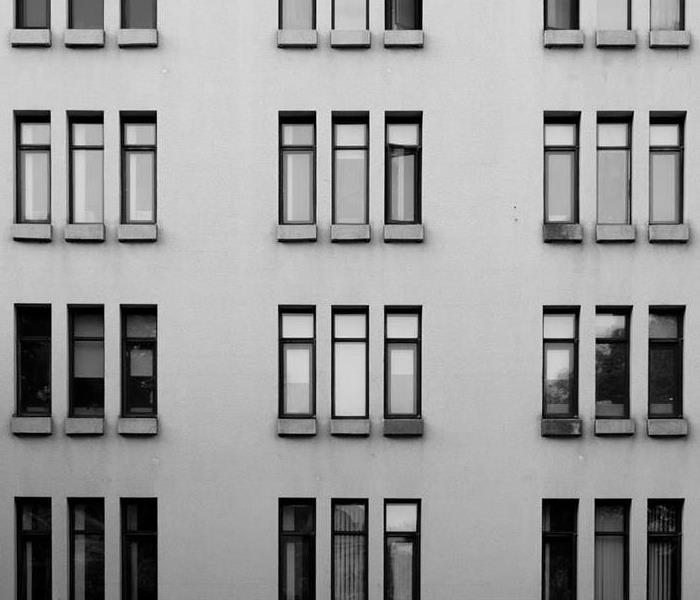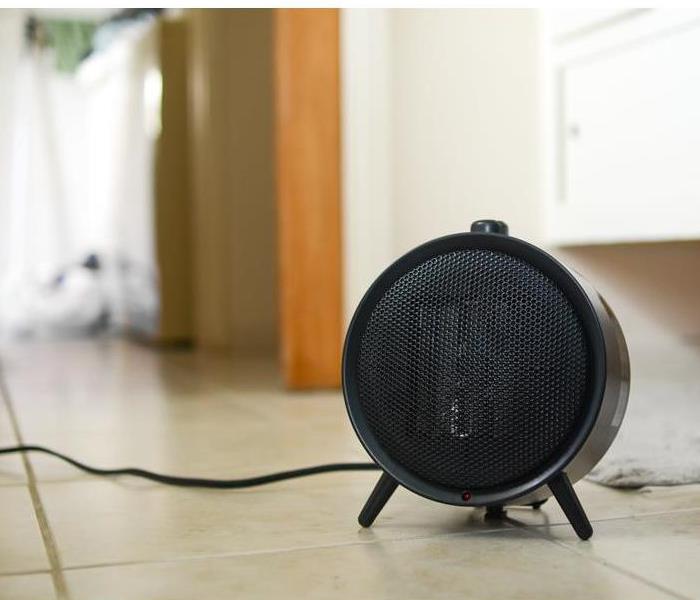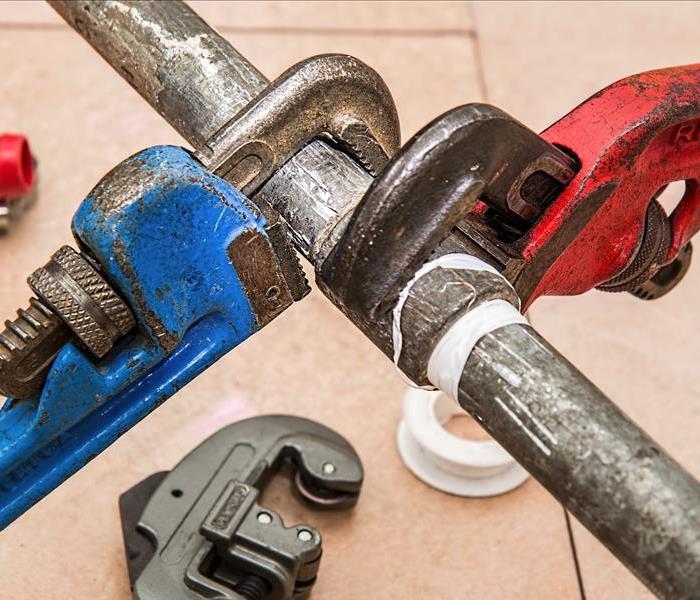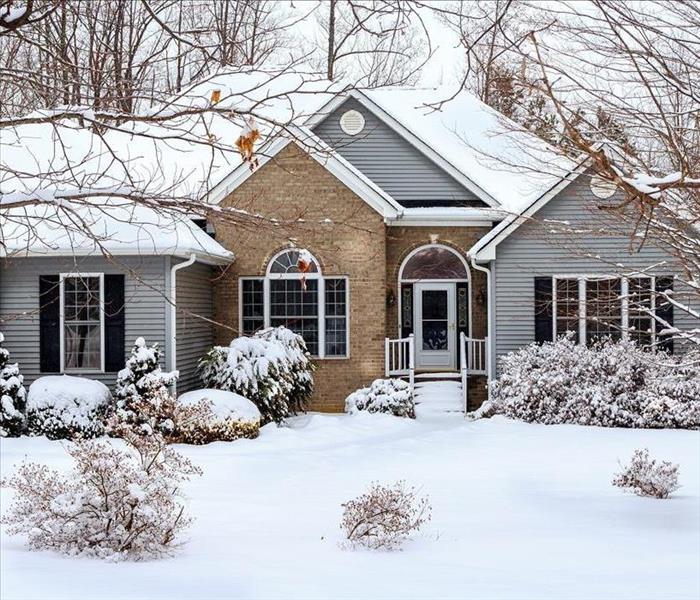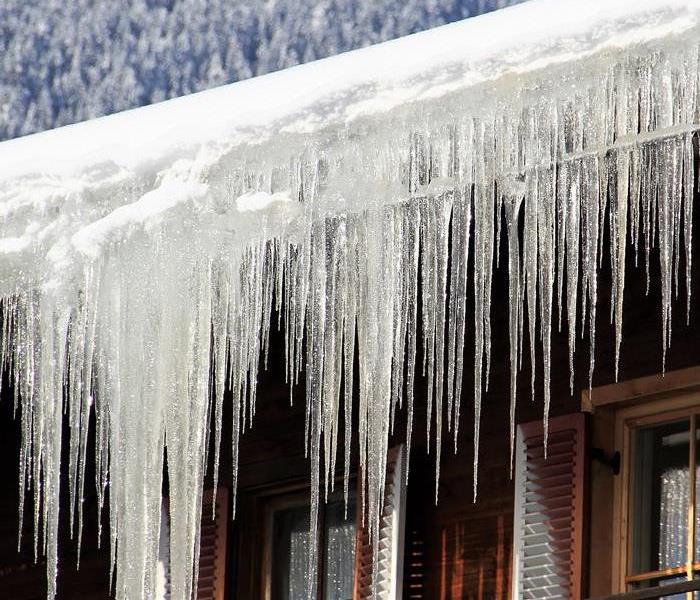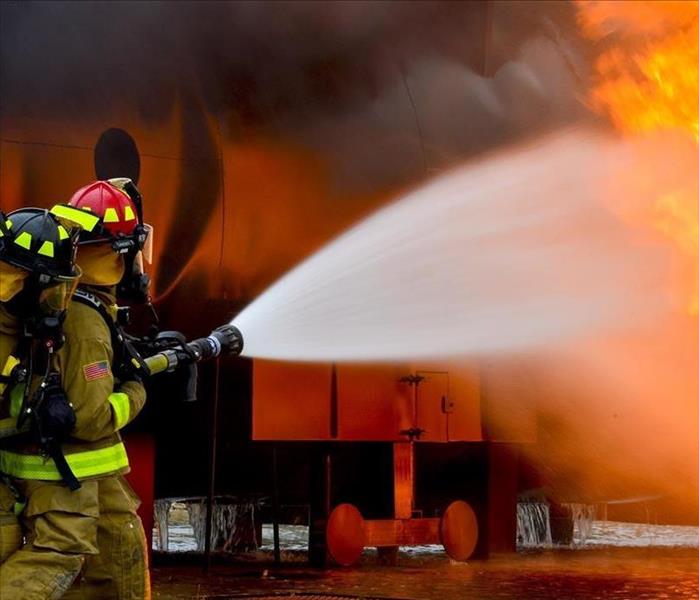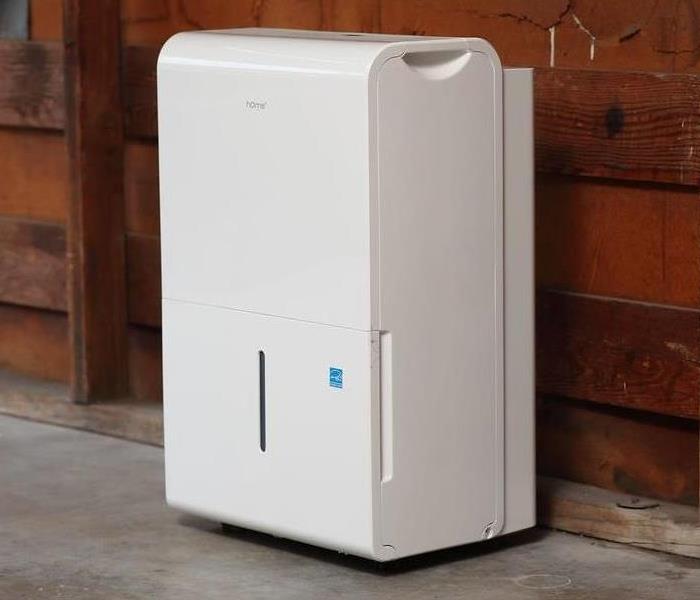Archived Blog Posts
7 Essential Tips for Emergency Water Damage Repair
5/28/2024 (Permalink)
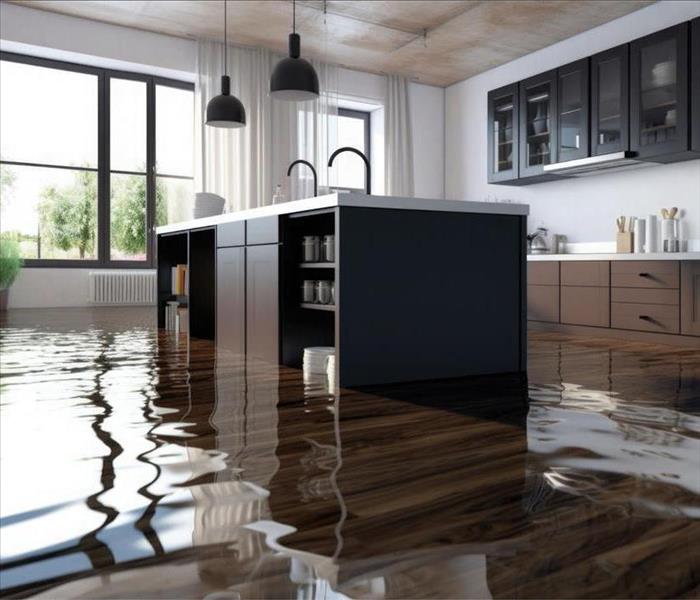 A kitchen with standing water on the floors.
A kitchen with standing water on the floors.
When facing emergency water damage repair, here are the seven essential tips: Assess all affected areas thoroughly. Stop the water source promptly to prevent more damage. Remove standing water within 48 hours to avoid mold growth. Dry out affected areas completely with proper ventilation. Salvage valuable items carefully to prevent further damage. Prevent mold growth by thorough drying and cleaning. Consider hiring professional restoration services for expert assistance. Following these steps can help you save time and costs and ensure a successful restoration process. Each tip is vital for effective recovery and protection of your property.
Key Takeaways
- Assess the extent of water damage promptly.
- Extract standing water within 48 hours to prevent mold.
- Dry affected areas thoroughly to avoid structural issues.
- Salvage valuables using proper drying techniques.
- Prioritize professional restoration services for efficient repair.
Assessing the Damage
When examining the damage from water emergencies, carefully inspect all affected areas for signs of water infiltration. Evaluating the importance of the damage is essential to determine the necessary steps for restoration. Check walls, ceilings, and floors for any visible water stains, discoloration, or warping. Pay close attention to areas where water will likely accumulate, such as basements, bathrooms, and around appliances like water heaters or dishwashers. Look for any soft spots on walls or ceilings, as these could indicate water saturation.
Prioritizing safety is paramount during the assessment process. Before entering any water-damaged areas, ensure the electricity is turned off to prevent the risk of electrical shocks. Wear protective gear such as gloves, rubber boots, and a mask to avoid contact with contaminated water or mold. Be cautious when moving around the affected areas, as wet surfaces can be slippery and pose a falling hazard.
Note any furniture, belongings, or structural elements affected by the water damage. Document the damage with photographs or videos for insurance purposes. Assess the condition of carpets, insulation, and drywall to determine what can be salvaged and what needs to be replaced. By thoroughly evaluating the importance of the water damage and prioritizing safety, you can effectively plan the next steps for restoration.
Stopping the Water Source
To effectively mitigate water damage, promptly halt the source of water infiltration to prevent further escalation of the emergency. The first step is to identify leaks in your home. Check common areas such as under sinks, around water heaters, and near appliances like dishwashers and washing machines. Look for water stains, mold growth, or any unusual dampness that could indicate a leak. Pay close attention to areas with visible pipes or where water is regularly used.
Once you've identified a leak, the next vital step is to shut off the water source. Locate your main water shut-off valve; this is usually found near the water meter where the main water line enters your home. Turn the valve clockwise to close it and stop the flow of water into your house. In case of localized leaks, like under a sink or behind an appliance, there are usually individual shut-off valves that you can use to stop the water supply to that specific area.
Removing Standing Water
Begin by using a wet vacuum or pump to extract the standing water from the affected area efficiently. This initial step is important in preventing further damage and mold growth. Water extraction should be done promptly to minimize the risk of structural issues and health hazards.
Here are some essential tips to guide you through the process:
- Move Quickly: Act fast to remove standing water within the first 48 hours to prevent mold growth and additional damage.
- Focus on Hidden Areas: Ensure thorough water extraction from hidden spots like under furniture, carpets, and within wall cavities to prevent moisture pockets.
- Monitor Humidity Levels: Use dehumidifiers to maintain ideal humidity levels below 60% to discourage mold growth.
Effective water extraction is crucial in mitigating the impact of water damage. By promptly removing standing water, you can prevent mold proliferation and structural deterioration. Remember to be thorough in your extraction efforts, paying attention to both visible and concealed areas where water might accumulate. Stay vigilant in monitoring humidity levels post-extraction to create an environment inhospitable to mold.
Drying Out Affected Areas
Maximize air circulation in the affected areas to expedite the drying process efficiently and effectively. Proper airflow is vital for drying out water-damaged spaces. Make sure windows and doors are open to promote ventilation. Position fans strategically to create cross-ventilation, aiding in the evaporation of moisture. Place dehumidifiers in key locations to extract excess moisture from the air, accelerating the drying process greatly.
Utilize a wet/dry vacuum to remove any remaining water that may be trapped in carpets, rugs, or upholstery. These versatile tools can help extract water efficiently, preventing further damage and mold growth. Remember to empty the vacuum regularly to maintain its effectiveness.
For areas that are damp but not saturated, use absorbent towels to soak up excess moisture. Press the towels firmly against the wet surface to absorb as much water as possible. Replace the towels as needed to continue drawing out moisture until the area is dry.
Salvaging Belongings
Open windows and doors to facilitate ventilation and create a conducive environment for salvaging belongings affected by water damage. Salvaging valuables after a water-related disaster is essential to minimize losses and preserve items with sentimental or monetary value.
Here are some essential steps to help you salvage your belongings effectively:
- Prioritize Items: Begin by salvaging items that are most valuable or have significant sentimental value. This may include important documents, photographs, jewelry, and electronics.
- Documenting Losses: Keep a detailed inventory of the items that have been damaged by water. Take photographs or videos of the affected belongings as part of the documentation process. This will be helpful for insurance claims and assessment of the overall damage.
- Proper Drying Techniques: Ensure that salvaged items are dried properly to prevent further damage and mold growth. Use dehumidifiers, fans, and air dryers to expedite the drying process. Avoid using heat sources that may cause damage to delicate items.
Preventing Mold Growth
To prevent mold growth after water damage, promptly initiate thorough drying procedures on all affected surfaces and items. Mold prevention is essential in ensuring the safety of your home and belongings. Begin by opening windows and using fans to increase air circulation. Dehumidifiers are also effective in removing excess moisture from the air. Focus on drying out carpets, furniture, and walls as they're prone to mold growth in damp conditions.
Moisture control is key in preventing mold from spreading. Check hidden areas like behind walls and under flooring for any trapped moisture. Use towels and mops to soak up standing water, and consider removing baseboards to allow for better airflow. Inspect for any leaks in plumbing or roofing that could be the source of moisture accumulation.
Remember to clean and disinfect all surfaces after drying to prevent mold spores from taking hold. A solution of water and detergent can help remove dirt and grime that mold feeds on. For porous materials like wood or drywall that may have absorbed water, it's best to consult with professionals on whether they can be salvaged or need replacement.
Hiring Professional Restoration Services
Consider reaching out to professional restoration services for effective and thorough water damage repair. When faced with water damage in your home, hiring experts can make a significant difference in the restoration process. Here are some reasons why opting for professional services is the best choice:
- Expertise and Experience: Professional restoration services have the knowledge and experience to assess the extent of the water damage accurately. They can provide a detailed plan to restore your property efficiently, minimizing further damage.
- Specialized Equipment: Restoration companies use specialized tools to extract water, dry affected areas, and restore your home to its pre-damaged condition. These devices are essential for thorough water damage repair and aren't typically available for DIY use.
- Insurance Assistance: Many professional restoration companies work directly with insurance providers, simplifying the claims process for you. They can help document the damage, provide necessary evidence for your claim, and ensure that you receive fair coverage according to your policy.
While there are DIY options for water damage repair, the expertise, equipment, and insurance assistance provided by professional restoration services can streamline the process and guarantee a successful restoration of your home. When dealing with water damage, entrusting the job to trained professionals can save you time, effort, and potentially reduce overall costs in the long run.
Recap
Heeding these crucial tips for emergency water damage repair can help minimize the damage to your property and belongings.
By promptly evaluating the damage, halting the water source, eliminating standing water, drying out impacted areas, salvaging belongings, preventing mold growth, and enlisting professional restoration services, you can effectively address the situation and restore your home back to its original condition.
Remember, acting swiftly and methodically is key in handling water damage emergencies.
Effective Mold Remediation for Storm Damage Recovery
5/27/2024 (Permalink)
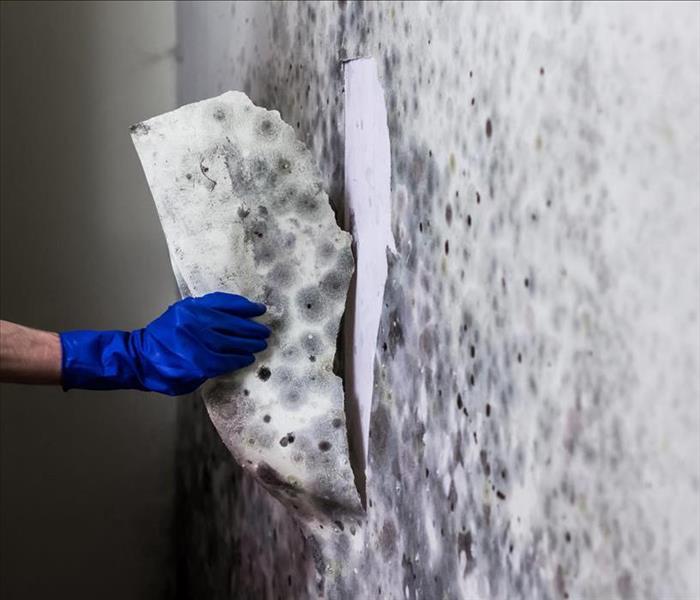 An interior wall with peeling paint due to mold damage.
An interior wall with peeling paint due to mold damage.
When faced with storm damage, swift mold assessment is vital. Mold can start growing rapidly within 24-48 hours after water intrusion, so act promptly. Focus on storm-impacted areas and hidden moisture sources. Use proper protective gear during the assessment. Contain mold to prevent spread with physical barriers and negative air pressure systems. Guarantee safety with protective equipment during removal. Thoroughly disinfect and scrub affected areas. Properly ventilate the work area and wear suitable protective equipment. Dispose of contaminated materials following local regulations. Verify the effectiveness of remediation efforts through post-remediation inspection. Further insight into mold remediation awaits.
Key Takeaways
- Swift assessment is crucial to prevent mold growth post-storm.
- Use containment measures to stop mold spread.
- Wear proper protective gear during remediation.
- Dispose of contaminated materials following safety guidelines.
- Conduct thorough post-remediation inspections for effectiveness.
Importance of Quick Mold Assessment
Swiftly evaluating mold growth after a storm is essential to prevent additional damage and guarantee the safety of the affected area. A quick response is key to identifying and addressing mold growth promptly. Mold can develop within 24-48 hours after a water intrusion event, such as a storm, making rapid evaluation important. By promptly evaluating the extent of mold growth, you can implement effective prevention strategies to mitigate further damage.
When conducting a quick mold evaluation, make sure you wear appropriate personal protective equipment, such as gloves and a mask, to safeguard your health. Start by visually inspecting the area for any visible signs of mold, including discoloration or musty odors. Use a flashlight to check dark or hidden spaces where mold commonly thrives, such as behind walls or under flooring. Take note of any areas with excessive moisture or water damage, as these are prime locations for mold growth.
In your evaluation, pay close attention to areas that were directly impacted by the storm, such as flooded basements or leaky roofs. Utilize moisture meters to detect any hidden water sources that could be fostering mold growth. By acting swiftly and thoroughly evaluating mold growth after a storm, you can implement effective prevention strategies to halt further spread and damage.
Steps for Containment and Removal
To effectively address mold growth after storm damage, it's important to implement thorough steps for containment and removal. Containment techniques play a vital role in preventing the spread of mold spores to unaffected areas. One effective method is setting up physical barriers like plastic sheeting to isolate the contaminated space. Seal off vents, doors, and any other openings that could allow mold spores to escape. Consider using negative air pressure systems with HEPA filters to contain the mold further.
Regarding removal procedures, it's essential to prioritize safety. Wear appropriate personal protective equipment such as gloves, goggles, and N95 respirators. Begin by gently misting the affected areas to suppress the mold spores before removal. Use HEPA vacuum cleaners to capture any loose spores and debris. Dispose of any contaminated materials in sealed bags to prevent further contamination.
For thorough mold removal, scrub surfaces with a detergent solution and dry completely. Porous materials like drywall and insulation may need to be removed if mold growth is extensive. After removal, thoroughly clean and disinfect the area to inhibit future mold growth. Regularly monitor the space for any signs of recurring mold to guarantee effective containment and removal procedures.
Utilizing Proper Protective Equipment
When preparing for mold remediation in storm-damaged areas, make sure you equip yourself with proper protective equipment to safeguard against potential health risks. Proper ventilation is essential during mold removal to prevent the spread of spores and contaminants to other areas of the property. Guarantee that the work area is well-ventilated by opening windows and using fans to promote air circulation. This step will help in minimizing your exposure to mold particles and maintaining a safe environment for the remediation process.
Respirator usage is a key component of personal protective equipment when dealing with mold. Choose a respirator that's rated for mold spore protection, such as an N95 mask or higher, to filter out tiny particles that can be harmful if inhaled. The respirator should fit snugly over your nose and mouth to provide maximum protection. Remember to perform a seal check before starting remediation work to ensure that no air is leaking in from the sides.
Additionally, wearing gloves, goggles, and protective clothing can further reduce the risk of exposure to mold and its byproducts. Gloves will protect your skin from direct contact with mold, while goggles prevent spores from entering your eyes. Proper protective clothing, such as coveralls, will help prevent mold from sticking to your clothes and skin, reducing the chances of contamination in unaffected areas. By utilizing the appropriate protective equipment, you can effectively mitigate health risks during mold remediation in storm-damaged locations.
Implementing Safe Disposal Practices
Properly disposing of contaminated materials after mold remediation is essential to prevent the spread of mold spores and guarantee a safe environment for all occupants. When it comes to safe handling and waste management practices, here are three key points to take into account:
- Segregation: Separate contaminated materials from non-contaminated ones to avoid cross-contamination. Use impermeable bags or containers to isolate the mold-infested items before removal. This step is vital in preventing the further spread of mold spores during disposal.
- Disposal Regulations: Familiarize yourself with local regulations regarding the disposal of mold-contaminated materials. Different areas may have specific guidelines for handling and disposing of hazardous waste. Ensure compliance with these regulations to safeguard both the environment and public health.
- Professional Disposal Services: For large-scale mold remediation projects or significant contamination, consider hiring professional disposal services. These experts have the necessary equipment and expertise to handle hazardous materials safely. By entrusting the disposal to professionals, you can rest assured that the waste will be managed following the highest safety standards.
Ensuring Thorough Post-Remediation Inspection
After finishing the mold remediation process, carrying out a thorough post-remediation inspection is essential to validate the effectiveness of the remediation efforts and the safety of the environment. Inspection protocols play a significant role in guaranteeing that all areas affected by mold have been properly treated. These protocols involve a detailed examination of the remediated areas to confirm that the mold has been successfully removed and that there are no signs of regrowth.
Moisture detection is a pivotal component of post-remediation inspections. Even after the visible mold has been removed, any remaining moisture can lead to future mold problems. Using specialized equipment such as moisture meters and thermal imaging cameras can help identify hidden sources of moisture that may promote mold growth. By thoroughly checking moisture levels in building materials and the air, inspectors can ensure that the environment is dry and inhospitable to mold.
Following established inspection protocols and conducting thorough moisture detection are crucial steps in guaranteeing that the mold remediation process has been effective. By adhering to these procedures, you can have confidence in the safety and cleanliness of your environment post-remediation. Remember, a meticulous post-remediation inspection is the final step toward a successful mold remediation process.
Final Thoughts
Effective mold remediation is essential for storm damage recovery.
You can ensure a successful recovery process by conducting a quick mold assessment, implementing proper containment and removal steps, utilizing protective equipment, practicing safe disposal methods, and conducting thorough post-remediation inspections.
Remember to prioritize safety and thoroughness in every step of the remediation process to prevent further damage and health risks.
Stay vigilant and proactive in addressing mold issues to restore your property to a safe and healthy condition.
Top 10 Fire Damage Cleanup Tips for You
5/26/2024 (Permalink)
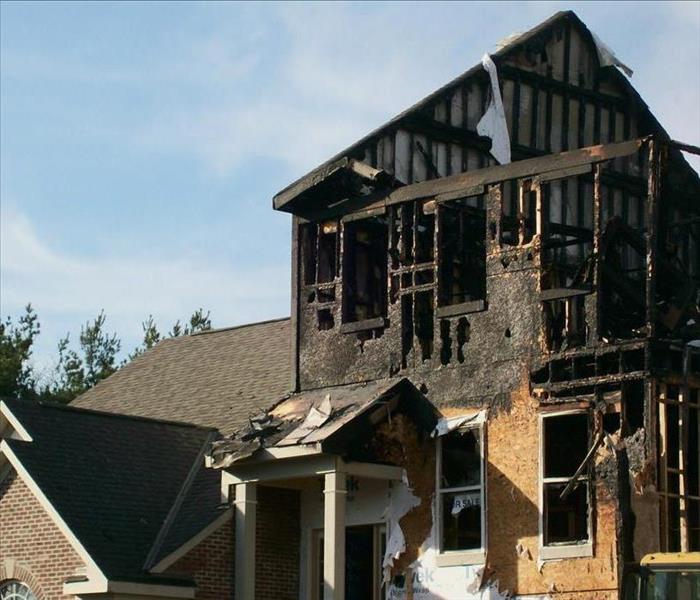 A two-story house that has been damaged by a fire.
A two-story house that has been damaged by a fire.
When dealing with fire damage cleanup, evaluate all areas for destruction, structural integrity, and safety hazards. Secure your property by reinforcing vulnerable points and clearing debris. Address smoke odor by assessing penetration levels and using specialized cleaning methods. Focus on thorough soot removal and proper ventilation to prevent health risks. Swiftly extract water, dehumidify, and apply antimicrobial treatments to prevent mold growth. Inspect diligently for mold and act promptly if found. Consider hiring professionals for efficient and effective cleanup. These tips lay a solid foundation for your fire damage restoration journey.
Key Takeaways
- Document damage thoroughly with photographs and detailed notes.
- Secure the property by identifying vulnerable areas and installing temporary fencing.
- Use specialized cleaning techniques and deodorization methods for smoke odor removal.
- Swift water extraction and dehumidification are essential for water-damaged areas.
- Hire professional cleanup services for efficient and effective fire damage restoration.
Assessing the Extent of Damage
To assess the extent of fire damage in your home, carefully inspect all affected areas for visible signs of destruction. Start by evaluating structural elements such as walls, ceilings, and floors for any signs of charring, warping, or weakening. Pay special attention to load-bearing walls and beams to ensure the safety and integrity of your home.
Next, prioritize safety by checking for any electrical hazards. Look for exposed wires, charred outlets, or any other signs of electrical damage. If you suspect any electrical issues, refrain from touching any electrical components and immediately shut off the power supply to the affected areas.
Additionally, assess the damage to any plumbing systems in your home. Check for leaks, burst pipes, or water damage resulting from firefighting efforts. It's essential to address any water-related issues promptly to prevent further damage and mold growth.
As you evaluate the extent of the fire damage, make a detailed list of all affected areas and items. Take photographs or videos to document the damage for insurance purposes. This documentation will also help you keep track of the restoration process and make sure that all necessary repairs are completed.
Securing the Property
Inspect the perimeter of your property to identify any vulnerable points that may require securing in the aftermath of a fire incident. Property protection is essential to prevent further damage or unauthorized access. Start by securing doors, windows, and any openings to deter potential intruders and safeguard your belongings. Guarantee that all entry points are properly locked and boarded up if necessary.
Implement safety measures to prevent accidents or injuries on the property. Clear any debris, fallen branches, or unstable structures that could pose a risk to individuals entering the premises. Place warning signs to alert people of potential hazards and restrict access to dangerous areas. Taking these precautions can help avoid additional harm and ensure the safety of anyone visiting the site.
Consider installing temporary fencing around the property to establish clear boundaries and enhance security. This can also prevent unwanted entry and protect the area from further damage. Additionally, consult with local authorities or fire department officials for guidance on securing the property effectively.
Contacting Insurance Company
When reaching out to your insurance company after a fire incident, promptly provide detailed information about the damages incurred for a smoother claims process. Start by contacting your insurance agent or the claims department as soon as possible. Be prepared to provide specific details about the fire damage, including the extent of the destruction, any personal belongings affected, and any injuries sustained. This information will help expedite the claims process and ensure that you receive the assistance you need.
Make sure you understand your coverage details before speaking with your insurance company. Familiarize yourself with your policy limitations, deductible amount, and any exclusions that may apply to fire damage. Knowing this information will help you have a more informed discussion with your insurer and set realistic expectations for the reimbursement options available to you.
During your conversation with the insurance company, take notes on important details such as the claim number, the name of the representative assisting you, and any instructions provided. Keep all communication documented for future reference. Remember to ask about the timeline for processing your claim and what steps you need to take to move the process forward efficiently.
Documenting the Damage
Start by carefully photographing and documenting the damage caused by the fire to provide thorough evidence for your insurance claim. When capturing images, make sure they're clear, focusing on all affected areas of your property. Take close-up shots to highlight specific damage, such as charred walls, smoke-stained ceilings, or soot-covered belongings. These visual records will be essential when filing your insurance claims, as they serve as tangible proof of the extent of the fire's impact.
In addition to photographs, make detailed written notes describing the damage. Include information about the date of the fire, the areas affected, and any valuable items that have been destroyed or damaged. This documentation will help support your insurance claim by providing a detailed overview of the losses incurred.
Organize all your evidence systematically, keeping it in a safe and easily accessible location. Consider creating both physical and digital copies to ensure redundancy and easy sharing with your insurance company. Remember that thorough and well-organized documentation can expedite the claims process and increase the likelihood of a successful outcome.
Implementing Smoke Odor Removal
To effectively eliminate smoke odors from your property, begin by evaluating the extent of the odor penetration in various surfaces and materials. Soot removal is essential in this process. Use specialized cleaning techniques to address soot residue on walls, ceilings, and other surfaces. For effective odor elimination, employ deodorization methods such as ozone treatment, thermal fogging, or using odor neutralizers. These methods can penetrate deep into materials to combat stubborn smoke odors.
After soot removal, focus on air purification. Implementing air purification systems like HEPA filters or activated charcoal filters can help in removing lingering smoke particles from the air. Additionally, improving ventilation in your property aids in dissipating odors. Consider opening windows and using fans to facilitate air circulation.
For localized smoke odor, spot-cleaning with vinegar solutions or baking soda can be effective. These household items can help neutralize odors in specific areas. Upholstery and carpets are common places where smoke odors linger; consider steam cleaning or professional cleaning services for these items.
Regularly clean HVAC systems and air ducts to prevent smoke odor particles from circulating. Maintain cleanliness in your property to prevent odors from settling into fabrics and surfaces. By diligently applying odor elimination techniques and air purification methods, you can effectively rid your property of persistent smoke odors.
Salvaging Personal Belongings
For salvaging personal belongings after a fire, prioritize items with sentimental value or indispensable importance. These possessions hold special memories that can't be bought or replicated.
Here are some tips to help salvage your belongings effectively:
- Use salvage techniques: Start by carefully sorting through the items in the affected area. Look for things like family photos, heirlooms, or handmade gifts that hold sentimental value. Use gloves to handle items to prevent further damage from oils on your skin. Place salvaged items in a safe, dry space to prevent additional harm.
- Consider restoration options: Delicate possessions like artwork, antiques, or vintage textiles may require professional restoration services. Research reputable restoration companies in your area that specialize in fire-damaged items. They have the expertise and tools needed to salvage and restore these delicate items to their former glory.
- Protect documents and valuables: Important documents such as passports, birth certificates, and financial records are indispensable to salvage. Use airtight containers or plastic sleeves to protect these items from further damage. Valuables like jewelry should be carefully inspected for soot or residue and cleaned by professionals if necessary.
Cleaning Soot and Residue
When addressing the aftermath of a fire, tackling the cleaning of soot and residue is vital to restoring your home and belongings. Soot removal techniques are essential in ensuring that your property is thoroughly cleaned. Begin by ventilating the area well to reduce inhalation risks. Use a high-efficiency particulate air (HEPA) vacuum to remove loose soot from surfaces carefully. Wipe down surfaces gently with a dry chemical sponge to lift off the remaining soot particles without smearing.
For residue cleaning methods, start by evaluating the type of residue left behind. Different residues require specific cleaning solutions for effective removal. For greasy residues, dish soap mixed with warm water can be a good starting point. Apply the solution with a sponge or cloth, ensuring that it does not spread the residue further. Rinse the area with clean water and dry it thoroughly. Enzymatic cleaners can be highly effective for protein-based residues.
Remember to wear appropriate protective gear, such as gloves and masks, when dealing with soot and residue. Avoid using water-based solutions on materials sensitive to moisture, like wood or paper. If in doubt, consult with professionals for guidance on the best cleaning approaches to prevent further damage to your belongings.
Restoring Water-damaged Areas
Restoration of water-damaged areas requires swift action to prevent further structural damage and mold growth. When facing water damage, following proper restoration techniques is essential. Here are three essential steps to help you effectively restore water-damaged areas:
- Water Extraction: The first step in restoring water-damaged areas is removing standing water promptly. Utilize pumps and specialized vacuums to extract water from the affected areas. Thorough water extraction is important to prevent additional damage to the structure and minimize the risk of mold growth.
- Dehumidification Process: After extracting the water, the next step is to dehumidify the space thoroughly. High humidity levels can prolong drying times and create an environment conducive to mold growth. Employ dehumidifiers and air movers to reduce moisture levels in the air and accelerate the drying process. Ensure proper ventilation to aid in the dehumidification process and prevent musty odors.
- Mold Prevention: Mold can start growing within 24 to 48 hours of water exposure, making mold prevention an important aspect of water damage restoration. Apply antimicrobial treatments to inhibit mold growth and thoroughly dry all affected areas. Inspect hidden spaces like wall cavities and under flooring to make sure no moisture is trapped, as these spots can become breeding grounds for mold.
Inspecting for Mold Growth
Inspecting for Mold Growth begins by thoroughly examining all water-damaged areas for any signs of mold presence, ensuring prompt detection and mitigation to prevent further damage. Mold can start growing within 24 to 48 hours after water exposure, making it vital to act swiftly. Look for visible mold, musty odors, and any discoloration on walls, ceilings, or floors. To prevent future mold growth, make sure all affected materials are completely dry. Use dehumidifiers, fans, and open windows to increase ventilation and aid in the drying process.
When dealing with mold removal, wear protective gear such as gloves, masks, and goggles to prevent exposure to mold spores. Scrub hard surfaces with a mixture of detergent and water, then thoroughly dry. Porous materials like carpets and insulation may need to be removed if heavily affected. HEPA vacuuming can help remove any remaining mold spores. After cleaning, apply mold inhibitors to prevent regrowth.
Inspecting for mold growth is essential to safeguard your health and property. By following proper mold removal techniques and taking preventive measures, you can ensure a clean and safe environment post-fire damage cleanup. Remember, quick action and thorough inspection are key to effectively managing mold growth in water-damaged areas.
Hiring Professional Cleanup Services
Consider outsourcing professional cleanup services to ensure thorough and efficient restoration of your property after fire damage. Hiring experts can save you time and ensure that the cleanup process is done effectively, helping you get back to your normal routine sooner.
Here are three reasons why professional cleanup services might be the best choice for you:
- Expertise and Experience: Professional cleanup services have the knowledge and experience to handle fire damage efficiently. They know how to assess the extent of the damage, which areas need priority attention, and the best methods to restore your property. Their expertise can help prevent further damage and ensure thorough cleanup.
- Specialized Equipment: Professional cleanup companies have access to specialized equipment and tools that are necessary for effective fire damage cleanup. From industrial-strength cleaners to advanced drying equipment, they've everything needed to remove soot, smoke odor, and water damage. This equipment is often expensive to rent or buy for a one-time cleanup job, making professional services a cost-effective choice.
- Cost Comparison: While DIY cleanup might seem like a more budget-friendly option at first, considering the overall cost is crucial. Professional cleanup services can provide a holistic solution that addresses all aspects of fire damage restoration, potentially saving you money in the long run by preventing future issues and ensuring thorough cleanup.
Wrap-Up
Following these top 10 fire damage cleanup tips will help you effectively and efficiently restore your property. By evaluating the damage, securing the property, contacting your insurance company, documenting the damage, implementing smoke odor removal, cleaning soot and residue, restoring water-damaged areas, inspecting for mold growth, and hiring professional cleanup services, you can ensure a thorough and successful cleanup process.
Don't hesitate to take action and get your property back to its pre-fire condition.
What Is Involved in Crime Scene Biohazard Cleanup?
5/25/2024 (Permalink)
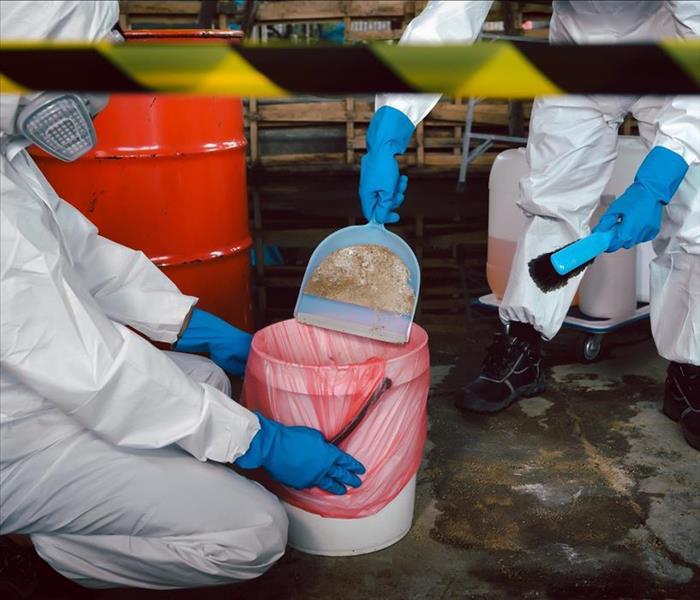 People in full-suit PPE cleaning up a crime scene.
People in full-suit PPE cleaning up a crime scene.
Conduct a thorough assessment to identify risks when addressing crime scene biohazard cleanup. Wear gloves, masks, and other personal protective equipment to stay safe. Follow designated cleanup protocols and decontaminate thoroughly. Dispose of biohazardous waste properly to minimize risks. Utilize specialized cleaning agents and equipment for sanitization. These steps are crucial for creating a secure and hazard-free environment.
Key Takeaways
- Conduct a thorough risk assessment to identify potential dangers and hazards.
- Wear appropriate PPE like gloves, masks, and protective suits to minimize exposure.
- Use suitable cleaning agents and methods to decontaminate the area effectively.
- Dispose of biohazardous waste following regulations to prevent risks.
- Utilize specialized equipment for decontamination and sanitization to ensure safety.
Initial Assessment and Planning
When commencing the initial assessment and planning for crime scene biohazard cleanup, make sure you meticulously survey the area for potential risks and hazards. Conduct a thorough risk assessment to identify any dangers present at the scene. Look out for sharp objects, bloodborne pathogens, chemicals, or any other biohazards that may pose a threat to your safety and wellbeing. It's important to prioritize safety during this phase to prevent any accidents or contamination.
After completing the risk assessment, implement appropriate containment measures to isolate the biohazardous materials. Containment is essential to prevent the spread of contaminants to unaffected areas and individuals. Use barriers such as caution tape, cones, or signs to cordon off the crime scene and restrict access to unauthorized personnel. Ensure that the containment measures are secure and clearly marked to avoid accidental exposure.
Remember that proper risk assessment and containment measures are crucial steps in ensuring a thorough and safe crime scene biohazard cleanup process. By meticulously evaluating the risks and implementing effective containment strategies, you're actively safeguarding yourself and others from potential harm. Your attention to detail and commitment to safety are important in providing a secure environment for everyone involved in the cleanup operation.
Personal Protective Equipment (PPE) Requirements
To ensure the safety and well-being of individuals involved in crime scene biohazard cleanup, appropriate Personal Protective Equipment (PPE) must be worn at all times. The selection of PPE is vital in minimizing the risk of exposure to biohazards present at the crime scene. When selecting PPE, factors such as the type of biohazard, the extent of contamination, and the specific cleanup tasks to be performed should be considered.
For biohazard exposure, PPE requirements typically include gloves, masks, goggles or face shields, protective suits, and shoe covers. Gloves are essential to protect your hands from direct contact with potentially infectious materials. Masks help prevent inhalation of harmful airborne particles, while goggles or face shields protect your eyes from splashes of blood or other bodily fluids. Protective suits are designed to cover your clothing and skin, reducing the risk of contamination, and shoe covers prevent the spread of biohazards to other areas.
It is important to ensure that the PPE fits properly and is in good condition before starting the cleanup process. Inspect the equipment for any damages or defects that could compromise its effectiveness. Remember, wearing the appropriate PPE isn't only for your safety but also for the safety of others who may come into contact with the biohazardous materials. By following PPE guidelines, you contribute to creating a safer environment for everyone involved in the crime scene biohazard cleanup process.
Biohazard Cleanup Procedures
To guarantee a thorough and safe biohazard cleanup process, meticulous adherence to established procedures is essential. When dealing with biohazard contamination, following specific cleanup techniques is vital to minimize health risks and ensure effective decontamination. Here are some key steps to contemplate:
- Assessment of the Scene: Before commencing the cleanup, assess the extent of biohazard contamination to determine the resources and cleaning protocols needed.
- Use of Appropriate Cleaning Agents: Select the correct cleaning agents and disinfectants suitable for the type of biohazard present to secure effective removal of contaminants.
- Methodical Cleaning Approach: Adopt a systematic approach to cleaning, starting from the outer areas towards the center, to prevent spreading contaminants to clean areas.
- Personal Protective Equipment (PPE) Compliance: Ensure all individuals involved in the cleanup wear appropriate PPE, including gloves, masks, and suits, to minimize exposure to harmful substances.
- Verification of Cleanup: After completing the cleanup, perform a thorough inspection to confirm that all biohazardous materials have been adequately removed and the area is safe for habitation.
Disposal of Biohazardous Waste
Assess the biohazardous waste materials for proper disposal to guarantee the safety and containment of potential risks. When dealing with biohazard waste disposal, it's essential to adhere to biohazard waste disposal regulations to ensure the protection of both individuals and the environment. These regulations dictate the specific protocols for handling, transporting, and disposing of biohazardous materials safely.
Biohazard removal techniques play a significant role in properly disposing of biohazardous waste. Utilizing specialized equipment and following established procedures are necessary for effectively removing these hazardous materials. It's important to segregate the biohazard waste based on its classification and characteristics to prevent cross-contamination and facilitate appropriate disposal methods.
In addition to following regulations and employing the correct removal techniques, it's crucial to work with a licensed biohazard cleanup company that understands the intricacies of biohazard waste disposal. These professionals have the expertise to handle biohazardous materials safely and ensure that the disposal process is conducted in compliance with all relevant regulations and guidelines.
Decontamination and Sanitization
For effective biohazard cleanup, guarantee thorough decontamination and sanitization of the crime scene to eliminate any remaining hazards and promote safety. This critical step involves meticulous attention to detail to make certain that all traces of biohazards are removed, minimizing health risks and preventing contamination. Proper decontamination and sanitization procedures are crucial to restoring the affected area to a safe and habitable condition.
- Biohazard Removal Techniques: Utilize specialized cleaning agents and equipment designed to eliminate biohazards from surfaces and materials effectively.
- Proper Disposal Methods: Ensure that all biohazardous waste is carefully collected, packaged, and disposed of following local regulations and guidelines.
- Health Risks: Understand the potential health hazards associated with exposure to biohazards, including pathogens and toxins that can pose serious risks to human health.
- Prevention Measures: Implement proactive measures to prevent contamination and the spread of biohazards during the cleanup process.
- Safety Protocols: Follow strict safety protocols, including wearing appropriate personal protective equipment (PPE) to minimize the risk of exposure to biohazards.
Summary
Crime scene biohazard cleanup involves a detailed process of evaluating, planning, and carrying out cleanup procedures while ensuring the safety of all individuals involved. Proper personal protective equipment is vital for minimizing risks during the cleanup process.
Disposal of biohazardous waste must be done in accordance with regulations to prevent further contamination. Decontamination and sanitization are vital steps to restore the affected area to a safe and habitable condition.
Overall, attention to detail and compassion are essential in this systematic process.
Why Hire Professional Storm Damage Restoration Contractors?
5/20/2024 (Permalink)
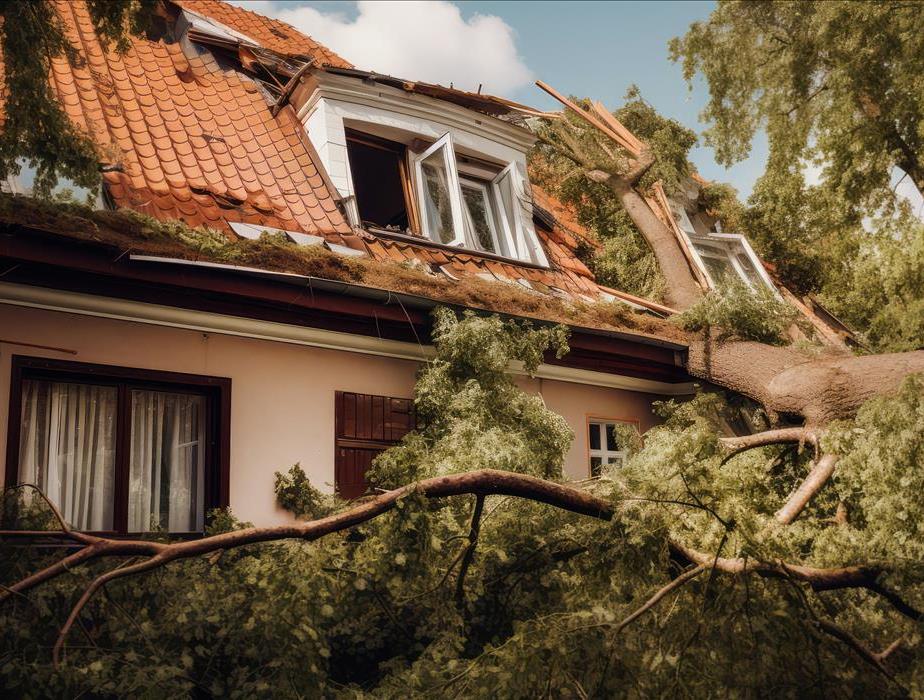 A tree falling on a house.
A tree falling on a house.
When facing storm damage, hiring professional restoration contractors is essential. You benefit from their expert skills, quick emergency response, specialized equipment, insurance knowledge, and safe restoration methods. They bring high expertise, prompt assistance, proper tools, insurance claim proficiency, and guarantee safety. Want to discover more about the advantages of working with professional storm damage restoration contractors?
Key Takeaways
- Expertise in industry standards and specialized training ensures accurate damage assessment.
- Quick response time minimizes damage with emergency preparedness and immediate dispatch protocols.
- Proper equipment and advanced technology ensure efficient and precise restoration results.
- Knowledge of insurance processes maximizes reimbursement and handles claims professionally.
- Safe restoration is ensured through industry-approved techniques, proper equipment use, and thorough damage assessment.
Expertise in Storm Damage Restoration
When hiring professional storm damage restoration contractors, make sure they possess a high level of expertise in handling the intricate challenges of restoring properties after a storm. These experts should be well-versed in industry standards to guarantee that your property is restored to its pre-storm condition efficiently and effectively. Look for contractors who've undergone specialized training in storm damage restoration, as this will equip them with the necessary skills and knowledge to tackle the complexities that may arise during the restoration process.
Professional contractors who adhere to industry standards are better equipped to assess the extent of the damage accurately and develop a thorough restoration plan tailored to your specific needs. Their specialized training enables them to employ advanced techniques and technologies that are essential for restoring properties damaged by storms. By entrusting your property to experts with the right expertise, you can have peace of mind knowing that the restoration process will be carried out professionally and in line with the highest industry standards.
In the storm damage restoration industry, specialized training plays a significant role in ensuring that contractors can deliver exceptional results in restoring properties. By choosing contractors with expertise in industry standards and specialized training, you're making a wise investment in the future of your property's restoration.
Quick Response Time for Emergencies
In emergency situations, a prompt response time from storm damage restoration contractors is essential to mitigate further property damage and guarantee a swift restoration process. When facing the aftermath of a storm, timely assistance is critical in preventing additional issues such as water damage, mold growth, or structural deterioration. Professional contractors focusing on emergency preparedness understand the situation's urgency and are equipped to act swiftly.
Storm damage restoration contractors who prioritize quick response times have protocols in place to make sure they can be on-site promptly. They've systems that allow for immediate dispatch upon receiving your call for help. This rapid reaction is key in containing the damage and starting the restoration process without delay.
Proper Equipment and Tools
Proper equipment and tools play a pivotal role in the effective and efficient restoration of storm-damaged properties. When hiring professional storm damage restoration contractors, it's important to make sure they've access to the necessary resources. Here's why:
- Advanced Technology: Utilizing cutting-edge equipment such as moisture meters, infrared cameras, and industrial-grade dehumidifiers allows contractors to accurately assess the extent of damage and implement targeted restoration efforts promptly.
- Specialized Training: Contractors with specialized training in handling advanced restoration equipment can efficiently mitigate storm damage. This expertise ensures that the restoration process is conducted effectively, preventing further issues like mold growth or structural damage.
- Efficiency and Precision: Equipped with the right tools and technology, professionals can work swiftly and with precision. This not only speeds up the restoration process but also ensures that every step is carried out meticulously, providing high-quality results.
- Safety and Compliance: Professional contractors are well-versed in safety protocols and industry standards. They use specialized tools that not only aid in restoration but also guarantee the safety of both the property and its occupants. Compliance with regulations is important in delivering a secure and reliable restoration service.
Knowledge of Insurance Processes
Having the knowledge of insurance processes is essential for professional storm damage restoration contractors to effectively navigate and assist clients through the claims and reimbursement procedures. Understanding insurance claims is vital in ensuring that the restoration process is smooth and that clients receive the coverage they're entitled to. Professional contractors are well-versed in the documentation process required by insurance companies. They can help you gather the necessary evidence, fill out paperwork correctly, and submit claims promptly.
Insurance claims can often be intricate and confusing, but with a contractor who understands the ins and outs of the process, you can have peace of mind knowing that your claim is being handled professionally. These experts can also help negotiate with the insurance company on your behalf to maximize your reimbursement. By entrusting the insurance process to skilled contractors, you can focus on other important matters while they work diligently to secure the compensation you deserve.
In times of distress after a storm, having a contractor who's knowledgeable about insurance processes can provide a sense of security and relief. Their expertise in handling insurance claims and the documentation process can make the restoration journey less challenging and more manageable for you.
Ensuring Safe and Effective Restoration
To guarantee a safe and effective restoration process, prioritize conducting a thorough assessment of the storm damage to determine the extent of repairs needed. This initial step is important in ensuring that all safety precautions are taken and that the restoration techniques employed will address the damage adequately. Here are some key points to keep in mind for ensuring safe and effective restoration:
- Safety Precautions: Before beginning any restoration work, make sure that the area is safe for both workers and inhabitants. This may involve turning off electricity in the affected areas, checking for structural damage that could pose a risk, and wearing appropriate safety gear throughout the restoration process.
- Thorough Assessment: Conduct a detailed evaluation of the damage, including hidden water damage, structural issues, and potential mold growth. This will help in creating a full restoration plan tailored to your specific needs.
- Utilize Proper Equipment: Ensure that the restoration team uses the right tools and equipment for the job. This includes dehumidifiers, industrial fans, moisture meters, and protective gear.
- Follow Restoration Techniques: Implement industry-approved restoration techniques to make sure that the damage is effectively addressed and that the risk of future issues such as mold growth is minimized.
Review
Hiring professional storm damage restoration contractors is crucial for a swift and efficient recovery process. Their expertise, prompt response time, appropriate equipment, understanding of insurance processes, and dedication to safety guarantee that your property is restored to its pre-storm condition in a timely manner.
Don't hesitate to contact experienced professionals to manage the restoration process effectively and carefully.
Advanced Technologies in Disaster Restoration: What's New in the Field?
4/3/2024 (Permalink)
Did you know that advanced technologies are revolutionizing the field of disaster restoration? With the increasing frequency and intensity of natural disasters, finding innovative solutions to aid recovery has become crucial.
These cutting-edge technologies are changing the game from drones for damage assessment to virtual reality for training and simulation.
But what exactly are these advancements, and how do they work? Let's explore the exciting world of advanced technologies in disaster restoration and discover what's new in the field.
Drones for Damage Assessment
Drones are a valuable tool for conducting damage assessments in disaster restoration. With advancements in drone technology, these unmanned aerial vehicles have become an essential asset in assessing and documenting the extent of damage caused by natural disasters. The use of drones for damage assessment provides a unique perspective and allows for more accurate and efficient data collection.
One of the main advantages of drone technology in damage assessment is its ability to access hard-to-reach areas. Drones can navigate through hazardous environments, such as collapsed buildings or flooded areas, where it may be unsafe or impractical for humans to go. By capturing high-resolution images and videos, drones provide a comprehensive view of the damage, enabling restoration teams to make informed decisions and prioritize their efforts.
Moreover, drones equipped with advanced sensors and imaging capabilities can detect structural weaknesses and identify potential hazards that may not be easily visible to the naked eye. Thermal imaging cameras, for example, can detect heat signatures that indicate hidden fires or areas of compromised insulation. This valuable information allows restoration teams to address these issues promptly, preventing further damage and ensuring the safety of both workers and residents.
In addition to their practicality, the use of drones for damage assessment also brings a sense of belonging to the affected communities. By utilizing cutting-edge technology, restoration efforts demonstrate a commitment to the well-being and recovery of the community. Furthermore, the use of drones enhances transparency and communication, as the collected data can be easily shared with stakeholders, insurance companies, and government agencies, fostering collaboration and trust.
Artificial Intelligence for Resource Allocation
With the advancements in technology, disaster restoration efforts can now benefit from the use of artificial intelligence for efficient resource allocation. Artificial intelligence, or AI, utilizes machine learning for predictive modeling, allowing for accurate analysis of data and forecasting of resource needs during disaster restoration efforts. This technology can greatly improve the allocation of resources, ensuring that the right tools, equipment, and personnel are deployed to the areas that need them the most.
Here are four ways AI can revolutionize resource allocation in disaster restoration:
- Optimized Deployment: AI algorithms can analyze historical data and patterns to determine the most effective deployment strategies. By considering factors such as the severity of damage, geographical location, and available resources, AI can allocate resources in a way that maximizes efficiency and minimizes response time.
- Real-Time Monitoring: AI-powered systems can continuously monitor the progress of restoration efforts and adjust resource allocation accordingly. By analyzing real-time data from sensors, drones, and other sources, AI can identify areas that require additional resources or adjust the distribution of resources based on changing conditions.
- Resource Forecasting: By leveraging machine learning algorithms, AI can accurately predict resource needs for future disaster events. This allows organizations to proactively allocate resources and plan for potential challenges, ensuring a more efficient and timely response.
- Secure Data Storage: Blockchain technology provides a secure and transparent platform for storing critical data related to resource allocation. By utilizing blockchain, organizations can ensure the integrity and accessibility of data, preventing unauthorized access or manipulation.
IoT Sensors for Early Warning Systems
IoT sensors play a crucial role in early warning systems for disaster prevention and response. These smart sensors for structural monitoring are revolutionizing the field of disaster restoration by providing real-time data and predictive analytics for disaster risk assessment. By incorporating these advanced technologies, we can enhance our ability to detect and respond to potential disasters, ensuring the safety and well-being of communities.
Imagine living in a world where disasters can be predicted and prevented before they even occur. With IoT sensors, this vision becomes a reality. These sensors are embedded in buildings, bridges, and other structures, constantly monitoring their condition and sending data to a central system. This data is then analyzed using predictive analytics, allowing us to assess the risk of potential disasters such as earthquakes, floods, or hurricanes.
By analyzing data from these sensors, we can identify early warning signs of structural damage or instability. This enables us to take proactive measures to prevent disasters, such as evacuating residents or reinforcing vulnerable structures. In addition, IoT sensors can also be used to monitor environmental conditions, such as temperature, humidity, and air quality, providing valuable insights into potential risks.
The integration of IoT sensors with early warning systems not only improves our ability to prevent disasters but also enhances our response capabilities. For example, in the event of an earthquake, these sensors can detect the intensity and location of the tremors, allowing emergency responders to assess the impact and allocate resources accordingly quickly.
Robotics for Debris Removal
Robotic technology is transforming the process of debris removal in disaster restoration. With the advancements in automated machinery for reconstruction and remote-controlled vehicles for hazardous waste disposal, the cleanup process has become more efficient and safe. Here are some ways in which robotics is revolutionizing debris removal:
- Increased speed and efficiency: Robots are equipped with advanced sensors and algorithms that allow them to navigate through debris-filled areas quickly and efficiently. They can identify and remove debris much faster than manual labor, saving valuable time during the restoration process.
- Improved safety: Debris removal can be a dangerous task, especially in hazardous environments. Robots can be remotely controlled from a safe distance, eliminating the risk to human lives. They can handle heavy objects and navigate through unstable structures without endangering themselves or others.
- Enhanced accuracy: Robots are programmed to identify and differentiate between various types of debris, allowing for targeted removal. They can precisely pick up and sort different materials, separating recyclables from non-recyclables, which promotes sustainable waste management.
- Cost-effectiveness: While the initial investment in robotic technology may be high, it can lead to long-term cost savings. Robots are durable and require minimal maintenance compared to human labor. Additionally, their ability to work continuously without fatigue improves overall productivity.
Virtual Reality for Training and Simulation
The next innovative technology in disaster restoration builds upon the advancements of robotics by utilizing virtual reality for training and simulation purposes.
Virtual reality (VR) is a cutting-edge technology that creates immersive experiences by simulating real-world environments. It offers a unique opportunity for disaster restoration professionals to enhance their training effectiveness.
With virtual reality, individuals can be placed in virtual disaster scenarios where they can practice their skills and decision-making abilities in a safe and controlled environment. This allows them to gain valuable experience and knowledge without the risk of actual harm. By immersing themselves in these virtual environments, they can develop a better understanding of the challenges they may face during disaster restoration efforts.
The immersive experiences provided by virtual reality training have been proven to enhance learning retention and engagement. Studies have shown that individuals who receive training through virtual reality retain information better compared to traditional training methods. This is because virtual reality provides a more realistic and interactive learning experience that stimulates multiple senses, making the information more memorable.
Furthermore, virtual reality training allows for repeated practice and feedback, which is crucial for skill development. Disaster restoration professionals can repeat training scenarios multiple times, refining their techniques and decision-making skills. They can also receive immediate feedback on their performance, allowing them to identify areas for improvement and make adjustments accordingly.
Recap
So there you have it, folks! With advanced technologies like drones, artificial intelligence, IoT sensors, robotics, and virtual reality, disaster restoration has reached a whole new level of efficiency and innovation.
Picture a swarm of drones assessing damage, AI intelligently allocating resources, sensors giving early warnings, robots clearing debris, and people training in virtual reality. It's like a futuristic blockbuster movie, except it's real life.
The future of disaster restoration is here, and it's nothing short of mind-blowing!
The Science Behind Effective Smoke Odor Removal
4/1/2024 (Permalink)
Imagine walking into a room that has been enveloped by the lingering scent of smoke, like a thick fog that refuses to dissipate. You long for a solution, a way to rid the air of this stubborn odor and restore freshness to your space.
But how exactly does one go about achieving effective smoke odor removal? What is the science behind it? In this discussion, we will explore the fascinating world of smoke odor elimination, uncovering the chemistry behind it, the factors that influence its persistence, and the innovative techniques and products that hold the promise of a smoke-free environment.
Get ready to dive into the science of banishing smoke odors for good.
The Basics of Smoke Odor
To understand smoke odor, you need to know what causes it and how it permeates various surfaces. The burning of materials such as tobacco, wood, or synthetic substances typically causes smoke odor. Common sources of smoke odor include cigarette smoke, cooking odors, and fire damage. When these materials burn, they release particles and gases into the air, which can cling to surfaces in your home and create an unpleasant odor.
Exposure to smoke odor can have negative health effects.
Fortunately, there are ways to remove smoke odor from your home effectively. Cleaning and deodorizing surfaces is important, as smoke particles can settle on furniture, walls, and other objects. Vacuuming, washing, and using odor-neutralizing sprays can help eliminate smoke odor from these surfaces. It's also essential to improve the ventilation in your home to remove lingering smoke particles from the air. Opening windows, using fans, or installing air purifiers can help circulate fresh air and reduce the concentration of smoke odor.
The Chemistry of Smoke Odor
Understanding the chemistry behind smoke odor can provide valuable insights into how it lingers and affects your home. When smoke is produced, it undergoes various chemical reactions that contribute to the formation of odor-causing compounds. These chemical reactions involve the interaction of different molecules present in smoke, such as carbon monoxide, volatile organic compounds (VOCs), and nitrogen oxides.
The molecular structure of smoke particles also plays a crucial role in the persistence of smoke odor. Smoke particles are tiny, with sizes ranging from 0.01 to 1 micron, and they can easily penetrate porous materials in your home, such as carpets, upholstery, and walls. This ability to infiltrate various surfaces allows the smoke particles to become trapped within the material's fibers, making it difficult to eliminate the odor completely.
Additionally, the molecular structure of smoke particles determines their volatility, which refers to how easily they evaporate into the air. Some odor-causing compounds in smoke have low volatility and tend to stick to surfaces, while others have high volatility and can easily become airborne, spreading the smoke odor throughout your home.
To effectively remove smoke odor, it's important to address both the chemical reactions involved and the molecular structure of smoke particles. This can be achieved through a combination of techniques, including proper ventilation to remove airborne particles, thorough cleaning of surfaces to remove trapped smoke particles, and the use of specialized odor neutralizers that target the specific compounds responsible for the smoke odor.
Factors Affecting Smoke Odor
The persistence and intensity of smoke odor can be influenced by several factors.
One important factor is the effectiveness of air purification. Poor ventilation and inadequate air circulation can contribute to the lingering smell of smoke in your home. Investing in a high-quality air purifier can help to filter out smoke particles and reduce the odor in the air. It's also important to regularly clean and replace the filters in your air purifier to ensure optimal performance.
Additionally, the type of material that burns can affect the persistence of smoke odor. Different materials release different chemicals when burned, and some of these chemicals can be more stubborn and difficult to remove. For example, synthetic materials like plastics and fabrics can produce a strong, long-lasting odor compared to natural materials such as wood or paper.
Lastly, the length of exposure to smoke can also impact the intensity and persistence of the odor. The longer the exposure, the deeper the smoke particles can penetrate into surfaces, making them harder to eliminate. It's crucial to address smoke odor as soon as possible to prevent it from becoming deeply ingrained in your home.
Effective Techniques for Smoke Odor Removal
One effective technique for removing smoke odor is utilizing ozone generators. Ozone generators work by producing ozone, a gas that helps eliminate smoke odor by breaking down and neutralizing the odor molecules in the air. These generators are often used in professional cleaning techniques to effectively remove smoke odor from homes, cars, and other spaces.
Another technique for smoke odor removal is the use of air purifiers. Air purifiers with activated carbon filters are particularly effective in removing smoke particles and odor from the air. These filters have a large surface area that can trap and absorb smoke odor molecules, providing clean and fresh air.
Professional cleaning techniques also play a crucial role in smoke odor removal. Trained professionals use specialized equipment and cleaning solutions to thoroughly clean and deodorize the affected areas. This includes deep cleaning carpets, upholstery, and other surfaces where smoke particles and odor may have settled.
In addition to these techniques, it's important to address the source of the smoke odor. This may involve repairing or replacing damaged materials, such as carpets or furniture, that have absorbed the odor. Proper ventilation is also essential to remove lingering smoke particles and odors from the space.
To effectively remove smoke odor, it's recommended to combine multiple techniques, such as ozone generators, air purifiers, and professional cleaning, for the best results. By utilizing these methods, you can eliminate smoke odor and create a fresh and inviting environment.
Innovative Products for Smoke Odor Elimination
If you're looking for innovative products to eliminate smoke odor, there are several options available on the market today. These products incorporate advanced odor-eliminating technology to effectively neutralize smoke odors and create a fresh and clean environment in your home or office.
Here are three options that you might find helpful:
- Smoke Odor Eliminator Spray: This convenient spray is designed to target and eliminate smoke odors on contact. It uses powerful odor-eliminating technology to break down the smoke molecules and neutralize their smell. Simply spray the affected areas, such as furniture, curtains, or carpets, and let the spray work its magic. The spray leaves behind a pleasant scent that helps to mask any remaining odors.
- Smoke Odor Eliminating Candles: These specially formulated candles are made with natural smoke odor neutralizers. When lit, they release a subtle fragrance that helps to eliminate smoke odors from the air. The candles burn cleanly and evenly, providing hours of continuous odor elimination. They're perfect for creating a cozy and inviting atmosphere while effectively eliminating smoke odors.
- Smoke Odor Absorbing Bags: These innovative bags are filled with activated charcoal, which is known for its ability to absorb and trap odors. Simply place the bags in the areas affected by smoke odor, such as closets, cars, or basements, and let them work their magic. The charcoal inside the bags will naturally neutralize the smoke odor, leaving behind a fresh and clean scent.
These innovative products are designed to effectively eliminate smoke odors and create a space that feels fresh and inviting. Whether you prefer a spray, a candle, or an odor-absorbing bag, there's an option available to suit your needs. Say goodbye to the lingering smell of smoke and enjoy a clean and odor-free environment.
Final Thoughts
So there you have it, folks!
The science behind smoke odor removal is complex, but with the right techniques and innovative products, you can say goodbye to that pesky smell.
It's time to reclaim your space and breathe in fresh, clean air.
Don't let smoke odor linger like an unwelcome guest at a party.
Kick it to the curb and enjoy the sweet scent of victory!
Emergency Preparedness: How to Protect Your Home From Storm Damage
3/31/2024 (Permalink)
Are you tired of feeling like a fish out of water when protecting your home from storm damage? Well, fear not because we've got you covered.
In this discussion, we will discuss the essential steps you need to take to safeguard your home against Mother Nature's wrath. From storm-proofing your windows and doors to developing an evacuation plan, we will provide you with the knowledge and tools necessary to weather any storm that comes your way.
So, let's not waste any more time and jump right in, shall we?
Storm-Proofing Your Windows and Doors
To protect your home from storm damage, you must take steps to storm-proof your windows and doors. Sealing vulnerabilities is crucial in ensuring that your home remains safe during extreme weather conditions.
Start by inspecting your windows and doors for any cracks or gaps that could allow water, wind, or debris to enter your home. Use weatherstripping or caulk to seal these openings, ensuring a tight and secure fit.
In addition to sealing vulnerabilities, consider upgrading your windows and doors with impact resistant glass options. These specially designed windows and doors are built to withstand the force of strong winds and flying debris. They're made with multiple layers of glass, bonded together with a strong interlayer, which helps to prevent shattering upon impact.
By installing impact-resistant windows and doors, you can significantly reduce the risk of damage to your home during storms. When choosing impact-resistant glass options, look for products that meet industry standards for hurricane protection. These products are rigorously tested to ensure their resistance to wind-borne debris and high-speed winds. They're labeled with a certification that indicates their level of impact resistance.
By selecting certified products, you can have peace of mind knowing that your windows and doors are built to withstand the toughest storms. Storm-proofing your windows and doors is a crucial step in protecting your home from storm damage. By sealing vulnerabilities and investing in impact-resistant glass options, you can create a secure and resilient barrier against extreme weather conditions.
Securing Outdoor Furniture and Objects
Secure your outdoor furniture and objects to prevent them from becoming dangerous projectiles during a storm. When strong winds and heavy rain hit, unsecured items can easily get picked up and thrown around, causing damage to your property and posing a threat to your safety. To protect your belongings and ensure a sense of belonging in your outdoor space, taking the necessary precautions and properly securing everything in place is crucial.
One effective way to secure your outdoor furniture is by using anchoring equipment. This includes heavy-duty straps, bungee cords, or ropes that can be used to tie down larger items such as patio tables, chairs, and umbrellas. Make sure to attach the straps or cords to a secure anchor point, like a tree or a fixed structure, ensuring that they're tightly fastened to prevent any movement. Consider using stakes or weights to keep them firmly in place for smaller objects like planters or decorative items.
In addition to securing your furniture, it's important to pay attention to outdoor structures such as sheds, gazebos, or playsets. If not properly secured, these structures can easily be damaged or destroyed during a storm. Use anchoring kits specifically designed for outdoor structures to secure them to the ground. These kits typically include strong, durable anchors that are driven into the ground and attached to the structure using sturdy cables or chains.
Reinforcing Your Roof and Gutters
Reinforce your roof and gutters to protect your home from storm damage. Your roof is the first line of defense against heavy rains, strong winds, and flying debris during a storm. Conduct a thorough roof inspection before the storm season begins to identify any weak spots or areas that may need reinforcing. Look for missing or damaged shingles, loose flashing, and signs of water damage. It's also important to check the gutters and downspouts for any blockages or damage. Clear out any debris, such as leaves or branches, and make sure the gutters are securely fastened to the roof.
If you notice any issues during the roof inspection, it's crucial to address them promptly. Hire a professional roofing contractor, if needed, to ensure that the repairs or reinforcements are done correctly. Reinforcing your roof may involve replacing damaged shingles, strengthening the flashing, or adding additional support in vulnerable areas. It's a worthwhile investment that will enhance the resilience of your home during storms.
Regular gutter maintenance is equally important for protecting your home during storms. Clogged or damaged gutters can lead to water overflow, which can cause significant damage to your roof, walls, and foundation. Clean your gutters at least twice a year or more frequently if you live in an area with many trees. Remove any leaves, twigs, or debris that may be blocking the flow of water. Check for leaks or loose connections and repair them promptly.
Creating an Emergency Preparedness Kit
Before the storm season begins, it's important to make sure you're prepared by creating an emergency preparedness kit. Stocking essentials and having a plan for emergency communication are crucial for keeping yourself and your loved ones safe during a storm.
Here are three items to include in your emergency preparedness kit:
- Water and Non-perishable Food: Make sure to have an ample supply of bottled water to last at least three days. Additionally, stock up on non-perishable food items like canned goods, granola bars, and dried fruits. These will provide nourishment in case of power outages or limited access to groceries.
- First Aid Kit: It's essential to have a well-stocked first aid kit to address any injuries that may occur during a storm. Include items such as adhesive bandages, antiseptic wipes, pain relievers, and any necessary prescription medications. Also, consider adding a manual for basic first aid procedures.
- Emergency Communication Devices: During a storm, communication can become difficult. It's important to have reliable devices for emergency communication. Include a battery-powered or hand-crank radio to stay updated on weather conditions and any official announcements. Additionally, keep a fully charged mobile phone with a backup battery pack to ensure you can reach out for help if needed.
Developing an Evacuation Plan
To ensure your safety during a storm, it's important to develop an evacuation plan. Having a well-thought-out plan in place will give you peace of mind and help you stay organized in case of an emergency.
The first step in creating your evacuation plan is to identify the safest evacuation routes in your area. Take the time to familiarize yourself with these routes and map out the quickest and safest way to get to a designated shelter or a safe location.
It's also crucial to have the necessary emergency contact information readily available. Make a list of important phone numbers, such as local authorities, emergency services, and family members, and keep it in a visible and easily accessible place. In addition to phone numbers, include any special instructions or procedures provided by your local emergency management agency. Remember to update this information regularly to ensure its accuracy.
When developing your evacuation plan, involve your family or household members. Make sure everyone understands the plan and their roles during an evacuation. Assign specific tasks to each individual, such as grabbing important documents, packing essential supplies, or securing the house.
Practice your evacuation plan regularly to ensure that everyone knows what to do in case of an emergency. This will help build confidence and reduce anxiety during a real evacuation.
Wrap-Up
To ensure the safety of your home during a storm, it's crucial to take proactive measures.
Storm-proofing your windows and doors, securing outdoor furniture, reinforcing your roof and gutters, and creating an emergency preparedness kit can minimize storm damage.
Having an evacuation plan in place is essential.
Taking these steps can help protect your home and save you from costly repairs.
Fire Restoration Costs: What to Expect
3/26/2024 (Permalink)
When disaster strikes and your home is damaged by fire, the road to recovery can be overwhelming. The flames may have been extinguished, but the aftermath brings with it a series of challenges that must be addressed.
One of the biggest concerns is the cost of fire restoration. The expenses can quickly add up from initial assessment and cleanup to structural repairs and smoke removal.
But what exactly should you expect when it comes to fire restoration costs? How can you navigate the process and ensure you get a fair deal?
In this discussion, we will explore the various aspects of fire restoration costs and provide you with the information you need to make informed decisions.
Initial Assessment and Cleanup
When assessing and cleaning up after a fire, it's crucial to take immediate action to minimize further damage and ensure the safety of all individuals involved. The initial assessment is a critical step in this process, as it allows professionals to evaluate the extent of the damage and create a plan for effective cleanup.
During the initial assessment, trained experts will carefully examine the affected areas to determine the level of damage caused by the fire. They'll assess the structural integrity of the building and identify any potential hazards, such as weakened walls or electrical issues. This assessment plays a vital role in determining the scope of the cleanup and restoration efforts.
Once the initial assessment is complete, the cleanup can begin. This process involves removing debris, soot, and smoke residue from the affected areas. Professionals will use specialized equipment and cleaning agents to ensure thorough and safe removal. The goal is to eliminate any lingering traces of fire damage and restore the space to its pre-fire condition.
Cleanup after a fire also involves addressing water damage caused by firefighting efforts. Water extraction and drying techniques are employed to prevent mold growth and further structural damage. This step is crucial to prevent secondary issues that can arise from the presence of excess moisture.
Structural Repairs and Reconstruction
To restore the building after a fire, structural repairs and reconstruction are necessary. This process involves making the necessary repairs to damaged structural elements and rebuilding any parts of the building that were completely destroyed. Here are the key steps involved in structural repairs and reconstruction:
- Assessment and Planning: A thorough assessment is conducted to determine the extent of the damage and identify the areas that require structural reinforcement. This helps in creating a detailed plan for the repairs and reconstruction process.
- Obtaining Building Permits: Before starting any major structural repairs or reconstruction, building permits need to be obtained from the local authorities. These permits ensure that the work is done in compliance with the building codes and regulations.
- Structural Repairs and Reconstruction: Once the necessary permits are obtained, the structural repairs and reconstruction can begin. This involves repairing or replacing damaged beams, columns, walls, floors, and roofs. In cases where the damage is extensive, entire sections of the building may need to be reconstructed.
During this process, it's important to work with experienced contractors and engineers who specialize in fire restoration. They have the knowledge and expertise to ensure that the structural repairs and reconstruction are done correctly and safely.
It is worth noting that the cost of structural repairs and reconstruction can vary significantly depending on the extent of the damage and the size of the building. It's advisable to get multiple quotes from different contractors to ensure you're getting a fair price.
Smoke and Odor Removal
Smoke and odor removal is an essential step in the fire restoration process. After a fire, the lingering smell of smoke can be overwhelming and can make you feel like your space is no longer your own. But fear not because there are effective ways to eliminate these odors and restore a sense of belonging in your home.
One of the first steps in smoke and odor removal is air purification. This involves using specialized equipment to filter and clean the air, removing any lingering smoke particles and odorous molecules. Professional cleaning companies often have access to high-quality air purifiers that can effectively eliminate these unwanted smells. By investing in air purification, you can ensure that the air in your home is fresh and clean once again.
In addition to air purification, professional cleaning is another important aspect of smoke and odor removal. Trained professionals have the knowledge and expertise to thoroughly clean all affected surfaces, including walls, floors, and furniture. They use specialized cleaning products and techniques to remove smoke residue and eliminate any remaining odors. By hiring professionals for this task, you can have peace of mind knowing that your home is being cleaned to the highest standards.
Smoke and odor removal is crucial for creating a space that feels like your own again after a fire. By investing in air purification and professional cleaning, you can effectively eliminate smoke particles and odors, restoring a sense of belonging in your home. So don't let the aftermath of a fire make you feel disconnected from your space - take the necessary steps to remove smoke and odors and reclaim your home.
Content Restoration and Replacement
Content restoration and replacement is an essential part of the fire restoration process, ensuring that your belongings are restored or replaced after a fire.
When it comes to content restoration, there are several factors to consider, including the extent of the damage, the type of items involved, and the cost of restoration. Here's what you need to know:
- Assessment: The first step in content restoration is the assessment of your belongings. Trained professionals will evaluate the damage and determine what can be salvaged and restored. They'll take into account factors such as the type of material, the level of smoke or water damage, and the overall condition of the items.
- Restoration: Once the assessment is complete, the restoration process begins. This may involve specialized cleaning techniques, such as dry cleaning for clothing or ultrasonic cleaning for delicate items. Restoration professionals will use industry-approved methods and equipment to restore your belongings to their pre-fire condition.
- Replacement Costs: In some cases, restoration may not be possible, especially if the damage is severe. In such instances, replacement becomes necessary. Replacement costs can vary depending on the type and value of the items. It's important to work with your insurance company to determine the coverage for content replacement and ensure that you receive fair compensation for your losses.
Content restoration and replacement can be a time-consuming and costly process, but it's crucial to restore your sense of belonging and comfort after a fire. By entrusting the task to professionals and understanding the costs involved, you can navigate this aspect of fire restoration with confidence.
Insurance Coverage and Claims Process
If you have experienced a fire, understanding your insurance coverage and navigating the claims process is crucial for recovering your losses. Dealing with the aftermath of a fire can be overwhelming and stressful, but having the right insurance coverage can provide you with the financial support you need to rebuild and recover. However, it's important to keep in mind that there may be coverage limitations and requirements that you need to be aware of.
When it comes to insurance coverage for fire restoration, it's essential to review your policy carefully to understand what's covered and what's not. Most standard homeowners insurance policies cover fire damage, but there may be limitations on the extent of coverage. For example, your policy may have a cap on the amount of coverage for certain items or types of damages. It's crucial to be aware of these limitations so that you can set realistic expectations for the claims process.
Documenting the damages caused by the fire is a critical step in the insurance claims process. Take photos or videos of the affected areas and make a detailed list of all damaged items. This documentation will help support your claim and ensure you receive the appropriate compensation for your losses. Keeping receipts or proof of purchase for items destroyed in the fire is also a good idea.
When filing an insurance claim for fire restoration, it's important to notify your insurance company immediately. They'll guide you through the claims process and provide the necessary forms and information. Be prepared to provide documentation, such as the fire report, estimates from restoration professionals, and any other relevant information requested by your insurance company.
Review
So there you have it.
It's important to be prepared for the various stages of fire restoration costs. The expenses can add up quickly, from the initial assessment and cleanup to structural repairs and content restoration.
Common Mold Remediation Mistakes to Avoid
3/25/2024 (Permalink)
So, you've discovered a little mold in your home. No big deal, right? Just grab some cleaning supplies, scrub it away, and you're good to go.
Well, hold on just a minute. Mold remediation is a serious matter that requires careful attention and expertise. There are some common mistakes that many people make when it comes to dealing with mold, and you definitely want to avoid them.
In this discussion, we'll explore these mistakes and provide you with valuable insights on how to tackle mold remediation effectively. You won't believe the number one mistake people make – it's a real eye-opener.
Stay tuned!
Inadequate Mold Assessment
Don't make the mistake of conducting an inadequate mold assessment - it could lead to costly and time-consuming remediation efforts down the line. When it comes to dealing with mold, it's crucial to start with a thorough mold inspection. This is where the professionals come in.
Hiring a professional remediation team is essential to ensure a proper assessment of the mold situation in your home. A professional mold inspection involves a detailed examination of your property to identify any areas affected by mold growth. These experts have the knowledge and tools to detect hidden mold, which may not be visible to the naked eye. They'll assess the extent of the mold problem, determining the type of mold present and the potential risks it poses to your health and property.
Attempting to conduct a mold assessment on your own can be risky. Without the proper training and equipment, you may miss hidden mold colonies, leading to incomplete remediation. Inadequate assessment can result in the incomplete removal of mold, allowing it to continue spreading and causing further damage. It can also lead to health issues for you and your family, as certain types of mold can release harmful spores into the air.
By hiring professionals for mold inspection, you ensure a comprehensive assessment that leaves no room for oversight. They'll provide you with a detailed report of their findings, outlining the necessary steps for remediation. This report will serve as a roadmap for the professional remediation team, guiding them in the effective removal of mold and preventing its recurrence.
Don't put yourself at risk or waste time and money on insufficient mold assessments. Trust the professionals to conduct a thorough mold inspection and pave the way for successful mold remediation.
DIY Mold Removal
If you're considering tackling mold removal on your own, be prepared for potential risks and challenges. While DIY mold removal may seem like a cost-effective option, it's important to understand the limitations and potential dangers involved. Here are some key points to consider:
- Lack of expertise: Professional mold removal experts have the necessary training and experience to identify and effectively remove mold. Without this expertise, you may not be able to fully eliminate the mold problem, leading to its recurrence and potential health risks.
- Inadequate equipment: DIY mold removal often relies on household cleaning products and tools that may not be effective in completely eradicating mold. Professional mold removal companies have access to specialized equipment that can effectively remove mold and prevent its spread.
- Health risks: Mold can release harmful spores into the air, which can cause allergic reactions, respiratory issues, and other health problems. Without proper protective gear and containment measures, DIY mold removal can expose you and your family to these health risks.
While it may be tempting to try and save money by taking on mold removal yourself, it's essential to consider the potential risks and challenges involved. DIY mold prevention measures, such as reducing moisture and improving ventilation, can help prevent mold growth. However, if you already have a mold problem, it's best to seek professional mold removal services to ensure the safety and effectiveness of the remediation process.
Ignoring the Source of Moisture
Ignoring the source of moisture can lead to recurring mold problems and potential health risks. It's important to address the underlying cause of moisture in your home to prevent mold from coming back. Mold thrives in damp environments, so if you don't eliminate the source of moisture, you're just treating the symptoms and not the root of the problem.
Moisture prevention is key to preventing mold growth. Identify any leaks or areas of excess moisture in your home and take immediate action to fix them. This could include repairing a leaking pipe, fixing a roof leak, or improving ventilation in areas prone to high humidity, such as bathrooms and basements. By addressing these issues, you can minimize the chances of mold growth in your home.
In some cases, it may be necessary to seek professional help to identify and fix the source of moisture. A professional mold remediation specialist can conduct a thorough inspection of your home, identify any hidden sources of moisture, and provide expert guidance on how to address them. They have the knowledge and experience to tackle complex moisture problems that may be difficult for homeowners to identify and fix on their own.
Improper Containment Measures
To effectively address mold growth, it's crucial to implement proper containment measures. When it comes to mold remediation, containing the affected area is essential to prevent the spread of mold spores and minimize the risk of cross-contamination. Here are some common mistakes to avoid when implementing containment protocols:
- Insufficient barrier installation: One of the mistakes often made during mold remediation is failing to install barriers properly. Inadequate barriers can allow mold spores to escape into unaffected areas, leading to further contamination. Ensure that all entryways, vents, and ducts are properly sealed to prevent the spread of mold spores.
- Inadequate negative air pressure: Another common mistake isn't maintaining negative air pressure in the contained area. A negative air pressure system helps to contain mold spores and prevent them from spreading to other areas. It's essential to monitor and maintain the correct pressure throughout the remediation process.
- Improper disposal of contaminated materials: Proper disposal of contaminated materials is crucial to prevent the recontamination of the cleaned area. Failure to follow proper disposal protocols can lead to the spread of mold spores and the reoccurrence of mold growth. Make sure to bag and seal all contaminated materials before disposing of them according to local regulations.
Failing to Address the Underlying Cause
Failing to address the underlying cause of mold growth can result in recurring mold issues and ongoing contamination problems. It's crucial to accurately diagnose the root cause of mold growth and implement effective treatment methods to prevent its recurrence.
Misdiagnosing mold can happen when you assume that visible mold is the only problem and fail to investigate further. Mold can often be a symptom of a larger issue, such as water leakage, high humidity levels, or poor ventilation. By solely focusing on removing the visible mold without addressing the underlying cause, you may be inadvertently allowing the mold to grow back and continue to pose a threat to your health and property.
Similarly, using ineffective treatment methods can be a waste of your resources. Simply applying bleach or other household cleaners to the affected areas may temporarily remove the mold, but it won't eliminate the source of the problem. Mold spores can easily spread to other areas of your home, leading to further contamination and more extensive mold growth.
To avoid these mistakes, it's important to consult a professional mold remediation specialist who can accurately diagnose the cause of the mold growth and recommend appropriate treatment methods. They have the knowledge and experience to identify hidden sources of moisture and implement effective strategies to prevent mold from recurring.
Summary
Don't let mold be the silent invader in your home. Avoid the common mold remediation mistakes that can leave you trapped in a never-ending battle.
Take the time for a thorough mold assessment and seek professional help when necessary.
Don't underestimate the power of moisture - address the source before it spreads its dark tendrils. Proper containment and tackling the underlying cause will ensure you can bid farewell to mold, leaving your home a fresh and clean sanctuary.
Common Fire Damage Restoration Mistakes to Avoid
3/8/2024 (Permalink)
Did you know that fire damage restoration can be a complex and challenging process? It's true, and there are several common mistakes that homeowners often make when dealing with the aftermath of a fire.
By avoiding these mistakes, you can ensure a smoother and more effective restoration process. So, what are these mistakes, and how can you avoid them?
Let's uncover the secrets to successful fire damage restoration and ensure that your home is restored to its pre-fire condition.
Delaying Professional Help
Don't make the mistake of delaying professional help when it comes to fire damage restoration. The importance of immediate action can't be stressed enough in such situations. When a fire occurs, it can cause significant damage to your property, leaving behind soot, smoke, and residue that can further deteriorate if not treated promptly. By delaying professional assistance, you risk facing potential long-term consequences that could have been avoided.
One of the main reasons why immediate action is crucial is because of the potential for further damage. After a fire, the affected areas can become vulnerable to structural issues, such as weakened walls or ceilings. Without proper restoration, these damages can worsen over time and compromise the safety of your home. Additionally, the longer you wait, the more difficult it becomes to remove the smoke odor and restore your property to its pre-fire condition.
Another important aspect to consider is the health risks associated with fire damage. Smoke and soot particles can penetrate into the air ducts and settle on surfaces, leading to respiratory issues, allergies, and other health problems. By delaying professional help, you expose yourself and your loved ones to these harmful pollutants for a longer period.
Furthermore, delaying fire damage restoration can also impact your insurance claim. Insurance companies require timely action and documentation to process your claim efficiently. If you delay seeking professional help, it may be challenging to provide the necessary evidence and documentation required for a successful claim.
Ignoring Hidden Damage
When you fail to address hidden damage, you risk exacerbating the long-term consequences that could have been avoided by seeking immediate professional help for fire damage restoration. It's crucial to thoroughly inspect your property after a fire to ensure that no hidden damage is left untreated. Ignoring hidden damage can lead to structural issues, compromised air quality, and increased costs for repairs in the long run.
Here's what you need to know about assessing structural integrity and evaluating air quality:
- Assessing structural integrity: Hidden fire damage can weaken the structural integrity of your property. It's essential to have a professional evaluate the extent of the damage and determine if any repairs or reinforcements are necessary. Ignoring this step can put you and your loved ones at risk of accidents or collapses.
- Evaluating air quality: Fires release toxic fumes and chemicals that can permeate your property, even in areas not directly affected by the flames. Failing to evaluate the air quality can result in respiratory issues and health problems. It's crucial to have professionals conduct air quality tests and implement appropriate ventilation and filtration systems if needed.
- Professional expertise: Ignoring hidden damage can lead to costly repairs down the line. By seeking immediate professional help, you can identify and address any hidden damage promptly and efficiently. Professionals have the knowledge, experience, and tools to accurately assess the extent of the damage and provide effective restoration solutions.
- Peace of mind: By addressing hidden damage, you can have peace of mind knowing that your property is safe and secure. Taking the necessary steps to restore your property after a fire ensures that you and your family can feel comfortable and protected in your home once again.
Don't underestimate the importance of addressing hidden damage after a fire. Seeking immediate professional help for fire damage restoration will help prevent further problems and ensure a safe and healthy environment for you and your loved ones.
Failing to Document the Damage
Make sure to document the damage caused by the fire to ensure accurate assessment and effective restoration. When your home or business is affected by a fire, it's crucial to thoroughly document the extent of the damage. Failing to do so can lead to difficulties when filing an insurance claim or seeking compensation for the restoration process.
To ensure that you receive the appropriate coverage and compensation, it's important to hire a public adjuster who specializes in fire damage. Hiring a public adjuster can be a game-changer when it comes to documenting fire damage. These professionals have the expertise and knowledge to accurately assess the extent of the damage and ensure that every detail is properly documented. They can assist you in navigating the complex process of filing an insurance claim, ensuring that you receive the maximum coverage for your fire damage restoration.
Insurance coverage for fire damage documentation is an essential aspect of the restoration process. Many insurance policies include coverage for documenting the damage caused by a fire. This coverage can help cover the costs associated with hiring a public adjuster and other professionals who'll assist in documenting the damage accurately. By taking advantage of this coverage, you can ensure that you have the necessary resources to properly assess the damage and restore your property.
Attempting DIY Cleanup
You should be cautious before attempting to clean up the fire damage on your own. While it may seem like a cost-effective and empowering solution, DIY cleanup can lead to potential health risks and ineffective restoration methods. Here are a few reasons why you should reconsider taking on the task yourself:
- Lack of expertise: Fire damage restoration requires specialized knowledge and skills. Without proper training, you may inadvertently cause further damage to your property or fail to address hidden issues such as smoke and soot residue.
- Safety hazards: Cleaning up after a fire involves handling hazardous materials, such as chemicals, asbestos, or mold. Without proper protective gear and knowledge of safety protocols, you risk exposing yourself to harmful substances and exacerbating the health risks associated with fire damage.
- Incomplete restoration: Fire damage goes beyond what's visible to the naked eye. Without professional equipment and techniques, you may fail to thoroughly clean and deodorize affected areas, leaving behind lingering odors and potential health hazards.
- Time and effort: Restoring a property after fire damage is a time-consuming and labor-intensive process. Taking on the task yourself can be overwhelming, especially if you have other responsibilities or lack the necessary tools and resources.
Neglecting to Address Smoke and Soot Residue
Before attempting DIY cleanup, it's important to address the smoke and soot residue left behind by the fire. Neglecting to address this residue can lead to serious health risks and hinder the restoration process.
Smoke and soot contain harmful chemicals and particles that can be detrimental to your health if inhaled or come into contact with your skin. Smoke residue can contain toxic substances such as carbon monoxide, formaldehyde, and volatile organic compounds (VOCs). These chemicals can cause respiratory problems, eye irritation, and skin allergies. Soot residue, on the other hand, contains fine particles that can easily become airborne and circulate throughout your home. Breathing in these particles can aggravate existing respiratory conditions and lead to long-term health issues.
In addition to the health risks, neglecting to address smoke and soot residue can also affect the effectiveness of the restoration process. These residues can penetrate walls, furniture, and other porous materials, leaving behind a strong odor and discoloration. Without proper cleaning and removal, this residue can continue to cause damage and impact the air quality in your home.
Proper ventilation plays a crucial role in fire damage restoration. It helps to remove smoke and soot particles from the air, allowing for a healthier and safer environment. By opening windows and using fans, you can increase air circulation and aid in the removal of harmful residues. It's important to consult with professionals who have the expertise and equipment to ensure proper ventilation during the restoration process.
Review
Don't underestimate the importance of professional fire damage restoration. Ignoring hidden damage, failing to document the extent of the destruction, attempting DIY cleanup, and neglecting smoke and soot residue can all lead to long-term consequences.
Don't risk it. Call the experts and ensure your home's full recovery.
Restoration Vs. Replacement: Making Cost-Effective Decisions After Property Damage
3/7/2024 (Permalink)
Imagine this: you come home after a long day, only to find your beloved living room flooded with water due to a burst pipe. The damage seems catastrophic, and you're left wondering: should you restore what you have or completely replace it?
This is a common dilemma faced by property owners after experiencing damage. The decision you make can have a significant impact on your finances and the overall value of your property.
In this discussion, we will explore the factors to consider when making cost-effective decisions between restoration and replacement, helping you navigate through the murky waters of post-damage choices.
And trust us, the choices you make can make all the difference.
Evaluating the Extent of Damage
To accurately assess the cost-effectiveness of your decisions after property damage, it's crucial to thoroughly evaluate the extent of the damage. When faced with the aftermath of a disaster, it's natural to feel overwhelmed and unsure of where to begin. However, taking the time to assess the impact and understanding the scope of the damage is essential for making informed decisions.
Start by conducting a thorough inspection of your property. Look for visible signs of damage, such as cracks, leaks, or structural issues. Take photographs and make detailed notes to document the extent of the damage. This won't only help you understand the scope of the problem but also provide evidence for insurance claims and potential repairs.
Next, consider the hidden damage that may not be immediately visible. Water damage, for example, can lead to mold growth and structural weakening over time. It's important to assess the potential long-term effects of the damage to make well-informed decisions about repairs and replacements.
Consult with professionals, such as contractors or restoration experts, to get a comprehensive understanding of the damage. They have the knowledge and expertise to identify hidden issues and provide accurate estimates for repairs. By involving experts in the assessment process, you can ensure that no damage goes unnoticed and that you have a clear understanding of the scope of the problem.
Considering the Cost of Restoration
Now that you have evaluated the extent of the damage, it's time to consider the cost of restoration. When it comes to repairing your property after damage, it's important to weigh the options and make a cost comparison between restoration and replacement. Restoration offers a more affordable solution, as it focuses on repairing and salvaging the existing structure rather than starting from scratch.
The restoration process involves a thorough assessment of the damage and the development of a detailed plan to restore the property to its pre-damage condition. Skilled professionals will use specialized techniques and equipment to clean, repair, and restore the affected areas. This approach not only saves you money but also reduces the time and inconvenience associated with replacement.
By choosing restoration, you can avoid the high costs of purchasing new materials and hiring contractors for extensive reconstruction. Instead, restoration experts will work diligently to restore your property, ensuring that it retains its original charm and functionality. This not only saves you money but also helps preserve the character and history of your home or business.
Furthermore, restoration is a sustainable option that aligns with the growing desire for environmental responsibility. By opting for restoration, you contribute to reducing waste and minimizing the carbon footprint associated with manufacturing new materials.
When considering the cost of restoration, it's important to consult with experienced professionals who can provide you with an accurate estimate. They'll assess the damage, determine the required repairs, and provide you with a detailed breakdown of the costs involved. This will enable you to make an informed decision that balances cost-effectiveness with quality restoration.
Assessing the Value of Replacement
Consider the value of replacement when evaluating the cost-effectiveness of restoring your property after damage. While restoration may seem like the obvious choice, it's essential to compare alternatives and assess the financial implications. Here are four factors to consider:
- Long-term durability: Replacement offers the opportunity to upgrade your property with modern materials and technologies. This not only enhances the aesthetic appeal but also increases the durability of your property, ensuring it withstands future challenges. Imagine the sense of security and pride that comes with knowing your home is built to last.
- Energy efficiency: With rising energy costs and growing environmental concerns, it's crucial to consider the energy efficiency of your property. Replacement allows you to install energy-efficient windows, insulation, and appliances, reducing your carbon footprint and saving you money in the long run. Picture the peace of mind that comes with contributing to a sustainable future.
- Personalization: Restoring your property may bring it back to its original condition, but replacement allows you to personalize your space to suit your unique preferences and lifestyle. From choosing the perfect flooring to designing your dream kitchen, the possibilities are endless. Imagine the joy of creating a home that truly reflects who you are.
- Increased property value: Replacement can significantly enhance the value of your property. By investing in high-quality materials and modern design, you not only create a space that you love but also increase its market appeal. Picture the sense of belonging that comes with owning a valuable asset in your community.
When assessing the value of replacement, it's crucial to consider these factors and evaluate the long-term benefits they offer. While restoration may seem like the more cost-effective option upfront, replacement can provide you with a home that meets your needs, exceeds your expectations, and offers a sense of belonging that's truly priceless.
Weighing the Long-Term Benefits
When evaluating the cost-effectiveness of restoring your property after damage, it's important to carefully weigh the long-term benefits. It's natural to prioritize short-term costs, but taking into account the financial implications and considering the potential risks can help you make a more informed decision that aligns with your long-term goals.
Restoration can often be a more cost-effective option compared to replacement. While the upfront costs of restoration may be higher, it can save you money in the long run. By addressing the damage promptly and effectively, you can prevent further deterioration and mitigate potential risks. This can help you avoid more expensive repairs or replacements down the line.
In addition to saving money, restoration can also preserve the value of your property. When damage is left unaddressed, it can decrease the overall worth of your property. By restoring it, you can maintain its aesthetic appeal and functionality, ensuring its value remains intact. This is particularly important if you plan on selling your property in the future or if you simply want to create a welcoming and comfortable environment for yourself and your family.
Furthermore, restoration can provide a sense of stability and security. Living in a damaged property can be stressful and unsettling. Restoring your property not only improves its physical condition but also enhances your emotional well-being. It allows you to regain a sense of belonging and pride in your home, which is essential for creating a nurturing and supportive environment.
Making Informed Decisions
To make informed decisions regarding property restoration, it's crucial to evaluate the long-term benefits and consider the financial implications, potential risks, and desired outcomes. When faced with property damage, it can be overwhelming to determine the best course of action. However, by following these steps and seeking professional advice, you can make the right decisions for your home and your budget.
Here are four key factors to consider when making informed decisions about property restoration:
- Insurance Coverage: Before proceeding with any restoration work, it's essential to review your insurance policy and understand what's covered. Contact your insurance provider to discuss the extent of coverage and any limitations that may apply. Knowing what expenses will be covered can help you allocate your budget more effectively.
- Financial Implications: Restoration work can incur significant costs, and it's essential to evaluate how much you can afford to invest in the repairs. Consider your current financial situation, including any savings or emergency funds, and determine a realistic budget for the restoration project. It's crucial to strike a balance between restoring your property to its previous condition and managing your finances responsibly.
- Potential Risks: Assess the potential risks associated with different restoration options. Consider factors such as the structural integrity of the property, the likelihood of future damage, and any potential health or safety hazards. Understanding these risks will enable you to make informed choices that prioritize the well-being of your family and your property.
- Desired Outcomes: Consider your desired outcomes for the restoration project. Do you want to restore your property to its pre-damage condition, or are you looking for an opportunity to make improvements and upgrades? Clarifying your goals will help you make decisions that align with your vision for your home.
Final Thoughts
In the end, when faced with property damage, it's all about making smart choices that balance cost and benefit.
By evaluating the extent of the damage and considering the cost of restoration, you can weigh the value of replacement and make informed decisions.
Remember, it's not just about fixing what's broken but also about finding long-term solutions that bring back the beauty and functionality of your property.
So, be savvy and choose wisely for a cost-effective recovery.
Storm Damage Restoration: Everything You Need to Know
3/5/2024 (Permalink)
Has your home recently been hit by a powerful storm, leaving behind a trail of destruction? Storm damage can be overwhelming, but understanding the restoration process can help ease your worries.
From assessing the extent of the damage to preventing future storms from wreaking havoc on your property, this comprehensive guide will provide you with everything you need to know about storm damage restoration.
So, let's dive in and explore the steps you can take to restore your home to its former glory.
Assessing the Damage
Now that the storm has passed, it's time for you to assess the damage. It can be overwhelming to see the aftermath of a storm, but evaluating the extent of the damage is crucial in order to start the restoration process. Take a deep breath, and let's begin.
First, walk around your property and carefully inspect all areas that have been affected by the storm. Look for any visible signs of damage, such as fallen trees, broken windows, damaged roofs, or water leaks. Make a list of all the areas that require immediate attention.
Once you have assessed the damage, it's important to contact professionals who specialize in storm damage restoration. These experts have the knowledge and experience to handle the repairs and ensure that your property is restored to its pre-storm condition. They'll be able to give you a detailed assessment of the damage and provide you with an estimate of the costs involved.
When contacting professionals, be sure to provide them with accurate information about the extent of the damage. This will help them determine the resources and equipment needed to restore your property. It's also important to ask for references and check their credentials to ensure that you're hiring reliable and trustworthy professionals.
Hiring a Storm Damage Restoration Company
Consider hiring a storm damage restoration company to restore your property efficiently and effectively. Dealing with the aftermath of a storm can be overwhelming, but with the help of professionals, you can navigate the storm damage restoration process smoothly.
Finding reputable contractors is crucial to ensure that your property is restored to its pre-storm condition. When searching for a storm damage restoration company, start by asking for recommendations from friends, family, or neighbors who've gone through similar experiences. Their firsthand experiences can provide valuable insights into the quality of work and customer service provided by different contractors. Additionally, you can also check online review platforms and local business directories to find reputable companies in your area.
Once you have a list of potential contractors, it's important to do some research to further evaluate their credibility. Look for companies that are licensed, insured, and bonded, as this ensures that they meet the necessary requirements and have the expertise to handle your restoration needs. You can also check if they're affiliated with any professional organizations, as this reflects their commitment to industry standards and continuous improvement.
When contacting potential contractors, ask for references and examples of their previous work. This will give you an idea of their capabilities and the quality of their craftsmanship. It's also beneficial to inquire about their experience with insurance claims, as navigating the claims process can be complex.
Insurance Claims and Documentation
To ensure a smooth insurance claims process, it's important to gather and document all necessary information related to the storm damage. This will help you navigate through the filing process and ensure a fair claim settlement.
Here are three key steps to help you with your insurance claims and documentation:
- Document the damage: Take photos or videos of the damage caused by the storm. Make sure to capture both the overall view and close-ups of any specific areas affected. This visual evidence will be crucial when filing your claim and can help support your case during the claim settlement process.
- Keep records of all expenses: It's important to document any expenses incurred as a result of the storm damage. This includes receipts for repairs, temporary accommodations, and any other costs related to the restoration process. These records will be necessary when filing your claim and can help ensure you're properly compensated for your losses.
- Review your insurance policy: Familiarize yourself with the details of your insurance policy, including coverage limits and deductibles. Understanding your policy will help you navigate the filing process more effectively and ensure you receive the maximum claim settlement you're entitled to.
Restoring Your Property's Structure
After documenting the storm damage and gathering all necessary information for your insurance claim, the next step is to focus on restoring your property's structure. This is an important part of the recovery process, as it ensures the safety and stability of your home, making it feel like a place where you truly belong.
One crucial aspect of restoring your property's structure is repairing the foundation. The foundation is the base upon which your home stands, providing support and stability. Storms can cause significant damage to the foundation, such as cracks or shifts. It's essential to hire a professional contractor who specializes in foundation repair to assess the damage and develop a plan for restoration. They'll use techniques like underpinning or slabjacking to stabilize and repair the foundation, ensuring the structural integrity of your home.
Another vital area to address is fixing the roof. Storms can cause extensive damage to roofs, including missing shingles, leaks, or even structural damage. A damaged roof not only compromises the safety of your home but also affects its overall appearance. It's crucial to have a qualified roofing contractor inspect the roof and make the necessary repairs. They'll replace missing shingles, repair leaks, and address any underlying structural issues. By fixing the roof, you not only prevent further damage but also restore the aesthetics and functionality of your home.
Restoring your property's structure is a significant step towards making your house feel like home again. By repairing the foundation and fixing the roof, you ensure the safety, stability, and visual appeal of your property. Remember to work with professionals who specialize in these areas to ensure high-quality restoration and a seamless recovery process.
Preventing Future Storm Damage
To protect your property from future storm damage, take proactive measures to strengthen its defenses. By implementing storm damage prevention strategies, you can ensure the safety and security of your home. Here are three key steps to help you fortify your property and minimize the risk of storm damage:
- Maintain your roof:
Your roof is your home's first line of defense against the elements. Regularly inspect it for any signs of damage, such as missing shingles or cracks. Repair or replace damaged roofing materials promptly to prevent water leaks and structural issues during storms. Consider reinforcing your roof with hurricane straps or clips for added protection. - Secure doors and windows:
Strong winds can easily breach weak points in your home's exterior. Install impact-resistant windows and doors that can withstand high winds and flying debris. Reinforce them with storm shutters or plywood covers during severe weather events. Don't forget to seal any gaps or cracks around doors and windows to prevent water intrusion. - Maintain your landscape:
Proper landscaping can help mitigate storm damage. Trim trees and remove dead branches to prevent them from falling on your home during strong winds. Clear gutters and downspouts regularly to ensure proper drainage and prevent water damage. Consider installing a French drain or a rain garden to redirect excess water away from your property.
Wrap-Up
So there you have it, folks! Now, you're equipped with everything you need to know about storm damage restoration.
Remember, when it comes to assessing the damage, hiring a reliable restoration company, and dealing with insurance claims, it's always better to be prepared.
Don't forget to restore your property's structure properly and take preventive measures for the future. After all, an ounce of prevention is worth a pound of cure, or in this case, a storm-free sanctuary!
Stay safe and storm-ready, my friends.
The Essential Checklist for Post-Flood Recovery
3/4/2024 (Permalink)
When life throws you a curveball and floods come crashing into your world, it can feel like the calm after the storm is just as chaotic. But fear not, for amidst the wreckage lies a roadmap to recovery, a checklist that will help you navigate the muddy waters of post-flood restoration.
From assessing the damage to salvaging your precious belongings, from drying and cleaning the affected area to documenting the restoration process, each step is crucial.
So, grab a pen and paper, for we are about to embark on a journey that will lead you from the depths of despair to the shores of recovery.
Assessing the Damage
Assess the extent of the damage caused by the flood by thoroughly inspecting your property. After a devastating flood, it's crucial to evaluate the damage to determine the next steps in your recovery process. Begin by carefully examining each area of your property, paying close attention to walls, floors, and furniture. Take photographs or videos to document the destruction, as this evidence will be essential for filing insurance claims. Remember, you aren't alone in this journey. Many others have faced similar challenges and have successfully navigated through the recovery process.
When assessing the damage, be on the lookout for signs of mold growth. Floodwaters create a breeding ground for mold, which can be hazardous to your health. Mold can cause respiratory problems, allergies, and other health issues. To prevent the growth of mold, remove any wet or damp materials immediately. Dry out the affected areas as soon as possible using fans, dehumidifiers, and open windows. Thoroughly clean and disinfect all surfaces, including furniture and personal belongings. It may be necessary to consult with professionals who specialize in mold remediation to ensure a thorough and safe cleanup.
In addition to documenting the damage and taking measures to prevent mold growth, it's vital to contact your insurance company promptly. Notify them about the flood and initiate the claims process. Provide them with the necessary evidence, such as photographs, videos, and a detailed inventory of the damaged items. Keep records of all communication with your insurance company, including names, dates, and any agreements made. This documentation will help expedite the claims process and ensure a fair resolution.
Contacting Professionals
To ensure a thorough and safe cleanup, it's essential to reach out to professionals who specialize in mold remediation. Mold can quickly spread and cause health hazards if not properly addressed. By contacting experts, you can rely on their knowledge and experience to handle the situation effectively.
Here are some key reasons why reaching out to professionals is crucial:
- Expertise and Experience: Mold remediation professionals have the necessary skills and expertise to assess the extent of the damage accurately. They know how to identify hidden mold growth and develop a comprehensive plan to eliminate it. Their experience allows them to handle the process efficiently, minimizing any further damage to your property.
- Finding Resources: Professionals have access to specialized tools and equipment that are needed for effective mold remediation. They can also recommend trusted contractors for repairs and restoration, ensuring that your property is restored to its pre-flood condition. By utilizing their resources, you can save time and effort in finding and coordinating with different service providers.
- Insurance Coverage: Mold remediation can be costly, but many homeowners' insurance policies cover such damages. Professionals can help guide you through the insurance claims process, ensuring that you receive the maximum coverage you're entitled to. They can provide documentation and evidence required by your insurance company, making the entire process smoother and less overwhelming.
Salvaging Belongings
Now that you have reached out to professionals for mold remediation, it's time to focus on salvaging your belongings after the flood. It's understandable that you might feel overwhelmed, but with the right salvage techniques, you can restore your belongings and bring a sense of normalcy back to your life.
When it comes to restoring belongings, the first step is to prioritize. Start with the items that hold the most sentimental value or are essential for your daily life. These could be family heirlooms, photographs, or important documents. Use caution when handling wet items, as they can easily tear or become damaged. Gently remove excess water and lay them out to dry in a well-ventilated area. Avoid direct sunlight, as it can cause further damage.
For furniture and larger items, it's best to consult a professional restoration service. They have the expertise and equipment to properly clean and dry these items to prevent mold growth and further deterioration. Remember to document any damages for insurance purposes.
Clothing and textiles can be salvaged through washing and disinfecting. Use a mild detergent and hot water to remove dirt and bacteria. Air-dry them outside or use a dryer on a low heat setting. Consider discarding items that are heavily soiled or have been in contact with sewage.
Electronics and appliances should be inspected by a professional before attempting to salvage them. Water damage can cause irreparable harm, so it's crucial to have them thoroughly assessed.
Drying and Cleaning the Affected Area
To effectively restore your home after a flood, it's crucial to thoroughly dry and clean the affected area. This step is essential to prevent further damage and ensure a safe living environment. Here are three important tasks you should focus on when drying and cleaning the affected area:
- Remove standing water: Start by removing any standing water in your home. Use pumps, wet vacuums, or buckets to extract the water. Make sure to wear protective gear such as rubber boots and gloves to avoid contact with contaminated water. Dispose of the water properly to prevent it from re-entering your home.
- Dry out the area: Once the standing water is removed, it's important to thoroughly dry out the affected area. Open windows and doors to promote air circulation. Use fans and dehumidifiers to accelerate the drying process. Remove any wet materials, such as carpets, furniture, and drywall, that can't be salvaged. This will help prevent mold growth and further damage to your home.
- Clean and disinfect: After the area is dry, it's time to clean and disinfect. Use a mild detergent and warm water to clean all surfaces. Pay special attention to areas that were directly affected by the floodwater. Use a bleach solution to disinfect and kill any remaining bacteria or mold spores. Make sure to wear protective clothing and ventilate the area properly while cleaning.
During the drying and cleaning process, it's important to keep in mind the need for mold prevention and structural repairs. Mold can grow rapidly in damp environments, so it's crucial to address any signs of mold growth immediately. Additionally, assess the structural integrity of your home and make necessary repairs to prevent further damage.
Documenting the Restoration Process
Start by taking detailed photographs and videos of the restoration process to document the progress and any damages that need to be addressed. This step is crucial for insurance claims and assessing the long-term effects of the flood. By documenting the restoration process, you can provide evidence of the work that has been done and the challenges that have been faced.
When taking photographs, make sure to capture the affected areas from different angles. Focus on any visible damages, such as structural issues, water damage, or mold growth. Take close-up shots to highlight specific details and wider shots to provide an overall view of the restoration site. Additionally, record videos to capture the restoration process in action. This can include footage of the cleaning and drying process, the repair work being done, and any necessary replacements or installations.
Ensure that the photographs and videos are clear and well-lit so they can be easily understood and analyzed later on. Label each file with a descriptive name and organize them in a systematic manner. This will make it easier to locate specific images when needed.
Remember to document any changes or improvements that are made throughout the restoration process. This will help demonstrate the progress being made and provide a timeline of events. It's also important to note any challenges or setbacks encountered, as these may have an impact on insurance claims or future repairs.
Review
Recovering from a flood requires a systematic approach.
Assess the damage, contact professionals, salvage belongings, dry and clean the affected area, and document the restoration process.
For example, imagine a family whose basement was flooded. They quickly contacted a professional restoration company that assessed the damage, salvaged their valuable possessions, thoroughly cleaned and dried the area and documented the entire process for insurance purposes.
With a checklist like this, flood recovery can be more manageable and efficient.
Top 5 Myths About Mold Remediation Debunked
2/28/2024 (Permalink)
Imagine a dark, damp corner of your home where mold silently thrives, hidden from plain sight. You may think you know all there is to know about mold remediation but think again.
This discussion will unravel the top 5 myths surrounding mold remediation and reveal the truth behind them. Brace yourself because what you're about to discover may surprise you.
Mold Can Be Effectively Removed With Bleach
Can bleach effectively remove mold?
It's a common belief among homeowners that bleach is a miracle solution for getting rid of mold. However, the truth is that using bleach as a mold remover may not be as effective as you think, and it can even pose dangers to your health.
While bleach has the ability to kill mold on non-porous surfaces, such as tiles or glass, it may not be as effective on porous materials like wood or drywall. Mold can easily penetrate into these materials, making it difficult for bleach to reach and eliminate all the mold spores.
As a result, the mold may grow and spread, leading to recurring mold problems in your home. Moreover, using bleach for mold removal can be hazardous to your health. When bleach is mixed with other household cleaners or ammonia, it can produce toxic fumes that can cause respiratory problems, eye irritation, and even damage to your skin.
In addition, bleach is a harsh chemical that can damage surfaces and materials, especially if used in high concentrations. To ensure safe and effective mold removal, it's recommended to seek professional help. Mold remediation experts have the knowledge, experience, and proper equipment to identify the source of the mold, remove it completely, and prevent its future growth. They use specialized techniques and eco-friendly products specifically designed for mold removal, ensuring a thorough and long-lasting solution.
Mold Only Grows in Humid Climates
Mold growth isn't limited to just humid climates. Contrary to popular belief, mold can thrive in various environments, including those with lower humidity levels. It's important to understand that mold can be a problem in any home, regardless of your climate.
Here are some key points to debunk the myth that mold only grows in humid climates:
- Mold prevention methods are essential: Regardless of the climate, it's important to implement mold prevention methods in your home. Regularly clean and dry areas prone to moisture, such as bathrooms and kitchens, to prevent mold growth. Proper ventilation and using dehumidifiers can also help control moisture levels.
- Leaks and water damage: One of the common causes of mold growth in homes is water damage. Whether from a leaky pipe, roof leak, or flooding, any water intrusion can create the perfect conditions for mold to thrive. It's crucial to address these issues promptly to prevent mold growth.
- Poor ventilation: Inadequate ventilation can lead to moisture buildup, which can contribute to mold growth. Make sure your home is properly ventilated, especially in areas prone to moisture, such as bathrooms and laundry rooms.
- Condensation: Even in drier climates, condensation can occur on surfaces that are cooler than the surrounding air. This can create a moist environment that promotes mold growth. Be mindful of areas with condensation, such as windows or cold walls, and take steps to reduce it.
- High indoor humidity: While it may be true that humid climates are more prone to mold growth, homes in any climate can experience high indoor humidity levels. This can be caused by activities such as cooking, showering, or drying clothes indoors. Using exhaust fans and opening windows can help reduce humidity levels.
Mold Is Harmless and Doesn't Pose Any Health Risks
Many people mistakenly believe that mold poses no health risks, but this myth is far from the truth. Mold can actually have a significant impact on your health and well-being. Exposure to mold can lead to a variety of health effects, ranging from mild allergic reactions to more severe respiratory problems.
One of the most common health effects of mold exposure is allergic reactions. If you're sensitive or allergic to mold, you may experience symptoms such as sneezing, coughing, itchy eyes, and a runny nose. These symptoms can be particularly bothersome for individuals with asthma or other respiratory conditions.
In addition to allergic reactions, mold can also cause more serious health problems. Prolonged exposure to mold can lead to respiratory issues such as bronchitis and pneumonia. It can also exacerbate existing respiratory conditions, making it harder to breathe and increasing the risk of asthma attacks. Some studies have even linked mold exposure to the development of chronic lung diseases.
To protect yourself and your loved ones from the health risks associated with mold, it's important to take preventive measures. Here are some mold prevention tips to keep in mind:
- Keep your home well-ventilated: Proper ventilation helps prevent excess moisture, which is a breeding ground for mold. Open windows, use exhaust fans and consider using a dehumidifier if necessary.
- Fix water leaks promptly: Moisture is one of the main factors that contribute to mold growth. If you notice any water leaks or signs of moisture in your home, address them immediately to prevent mold from forming.
- Control humidity levels: Ideally, indoor humidity should be kept below 50%. Use a hygrometer to monitor humidity levels and take steps to reduce moisture if necessary.
DIY Mold Remediation Is as Effective as Professional Services
If you're considering tackling mold remediation on your own, you may be under the impression that it's just as effective as hiring professional services. However, this is a common misconception that can lead to costly mistakes and potential risks. Here are some important points to consider when comparing DIY mold remediation to professional services:
- Expertise: Professional mold remediation companies have the experience and knowledge to properly identify the extent of the mold problem and the best methods to eliminate it. They're trained to handle different types of mold and have access to specialized equipment that ensures thorough removal.
- Time: DIY mold remediation may seem like a cost-effective option, but it can be time-consuming. Professionals have the resources to complete the job efficiently, saving you valuable time and allowing you to focus on other priorities.
- Safety: Mold remediation involves handling potentially harmful substances. Professionals are equipped with the necessary protective gear and follow strict safety protocols to minimize the risks associated with exposure to mold spores.
- Cost: While DIY mold remediation may appear cheaper at first, the costs can quickly add up if the problem isn't properly addressed. Inadequate removal methods can lead to recurring mold growth, resulting in additional expenses for future remediation and potential property damage.
- Long-term results: Professional mold remediation services provide a thorough and lasting solution. They not only remove the visible mold but also address the underlying causes and take preventive measures to inhibit future mold growth.
Once Mold Is Removed, It Won't Come Back
Once mold has been successfully removed, it's important to understand that there's still a possibility of its return if the underlying causes aren't addressed. Preventing mold regrowth is crucial to maintaining a safe and healthy living environment.
Mold spores are microscopic and can easily travel through the air, settling on surfaces and multiplying under the right conditions. If these conditions persist, mold can quickly reappear, causing potential health issues and damage to your property.
To prevent mold from coming back, it's vital to identify and address the source of moisture that initially led to its growth. Moisture can accumulate from various sources, such as leaks, high humidity levels, or inadequate ventilation. By fixing the underlying moisture problem, you can significantly reduce the likelihood of mold regrowth. This may involve repairing plumbing leaks, improving ventilation, using dehumidifiers, or properly insulating your home.
Ignoring the potential return of mold can have long-term effects on your health. Prolonged exposure to mold can cause a range of health problems, including allergic reactions, respiratory issues, and even neurological symptoms. Children, the elderly, and individuals with compromised immune systems are particularly susceptible to the long-term effects of mold exposure.
Therefore, it's crucial to take proactive measures to prevent mold regrowth and ensure a safe living environment for you and your loved ones.
Summary
So, now that you know the truth about mold remediation, it's time to say goodbye to those mold myths. Don't rely on bleach alone because mold can be stubborn.
And remember, mold can thrive in any climate, not just humid ones. Don't underestimate the health risks it poses.
While DIY methods may seem tempting, professional services ensure a thorough and effective removal.
And don't be naive; mold can return if the underlying causes aren't addressed.
Stay informed and keep your home mold-free.
Understanding Biohazard Cleanup: What You Need to Know
1/30/2024 (Permalink)
So, you've stumbled upon the term 'biohazard cleanup,' which piqued your curiosity. Well, let's face it: we all want to be in the know regarding something as important as our safety and well-being.
This article will unravel biohazard cleanup's mysteries and shed light on what you need to know. From the significance of professional assistance to the proper cleaning procedures and safety precautions, we will dive into the depths of this crucial subject.
But before we dive in, picture this: a situation where quick action is essential, the stakes are high, and the consequences of ignorance can be dire. Intrigued? Then, let's unravel the world of biohazard cleanup together.
Importance of Professional Assistance
When it comes to biohazard cleanup, professional assistance is crucial. Hiring professionals for such tasks comes with a range of benefits that you don't want to miss out on. These experts possess specialized equipment and techniques that ensure safe and effective biohazard cleanup.
One key benefit of hiring professionals is their expertise in handling biohazards. They've received extensive training and certification in dealing with hazardous materials, ensuring they know how to handle them safely and minimize risks. Their knowledge and experience allow them to assess the situation accurately and develop a comprehensive plan to clean up the biohazard.
In addition to their expertise, professionals have access to specialized equipment and techniques essential for biohazard cleanup. They use high-quality personal protective equipment (PPE) to protect themselves from potential health risks. This includes gloves, masks, goggles, and hazmat suits. They also have advanced tools and cleaning agents designed to remove and disinfect biohazards effectively. This level of specialized equipment ensures that the cleanup process is thorough and reduces the risk of cross-contamination or further spreading of the biohazard.
Furthermore, hiring professionals for biohazard cleanup provides you with peace of mind. Knowing that trained experts handle the situation lets you focus on other aspects of your life. It reduces the emotional and physical burden that comes with cleaning up biohazards yourself.
Common Types of Biohazards
There are several common types of biohazards that you should be aware of. Biohazardous materials can pose serious health risks, so understanding these types is important for your safety and the safety of others.
One common type of biohazard is bloodborne pathogens, which include viruses such as HIV and hepatitis B. These pathogens can be present in blood, body fluids, and other bodily substances and transmitted through contact with broken skin or mucous membranes.
Another type of biohazard is sharps waste, which refers to used needles, syringes, and other sharp objects that may be contaminated with infectious materials. Proper handling and disposal of sharps waste is crucial to prevent accidental needlesticks and potential infections.
Additionally, biohazardous chemicals are substances that can cause harm to living organisms, such as certain cleaning agents, pesticides, and laboratory chemicals. These chemicals can have detrimental effects on human health if not handled properly.
Furthermore, biohazardous waste, such as tissues, organs, and body parts, can also pose health risks. Handling and disposing of these materials according to strict guidelines to prevent the spreading of infections and diseases is important.
Lastly, microbiological waste, which includes cultures, specimens, and laboratory materials, can contain bacteria, viruses, and other microorganisms that can harm humans.
Understanding the common types of biohazards is essential for protecting yourself and others from potential health risks. If you encounter any biohazardous materials, you must seek professional assistance for proper cleanup and disposal. Remember, your safety and the well-being of others should always be a priority when dealing with biohazards.
Proper Cleaning Procedures
Following proper cleaning procedures is crucial to ensure effective and safe biohazard cleanup. Using the correct cleaning techniques and the necessary equipment, you can efficiently handle biohazardous situations and maintain a clean and safe environment.
Here are four important steps to consider:
- Assessment: Before starting the cleanup process, it's important to assess the extent of the biohazard contamination. This will help you determine the appropriate cleaning techniques and equipment needed for the task at hand. Conduct a thorough inspection to identify any potential risks and create a plan accordingly.
- Preparation: Proper preparation is key to a successful cleanup. Make sure to wear personal protective equipment (PPE), such as gloves, masks, and goggles, to protect yourself from potential exposure to harmful substances. Additionally, gather the necessary cleaning supplies, including disinfectants, absorbent materials, and biohazard waste bags, to effectively clean and dispose of the biohazardous materials.
- Cleaning: When cleaning biohazardous areas, it's important to use the appropriate cleaning techniques to ensure thorough decontamination. Start by removing any visible biohazardous materials using disposable towels or absorbent materials. Then, apply a suitable disinfectant to kill any remaining pathogens. Finally, clean all surfaces and objects in the area, paying special attention to high-touch surfaces.
- Disposal: Proper disposal of biohazardous waste is crucial to prevent the spread of contamination. Place all biohazardous materials, such as used cleaning supplies and contaminated materials, into biohazard waste bags. Seal the bags securely and label them appropriately. Dispose of the waste according to local regulations and guidelines.
Disposal of Biohazardous Waste
Proper disposal of biohazardous waste is essential for preventing the spread of contamination and maintaining a safe environment. Disposing of such waste requires adherence to specific disposal regulations to ensure that it's done in a way that minimizes the environmental impact. Following these regulations can contribute to a cleaner and healthier world.
Biohazardous waste includes items such as blood-soaked bandages, used needles, and bodily fluids. These materials can carry infectious pathogens that risk human health and the environment if not disposed of properly. Disposal regulations help safeguard against these risks by providing guidelines on handling, packaging, and transporting biohazardous waste.
One important aspect of proper disposal is using biohazard bags or containers specifically designed to contain and prevent waste leakage. These containers are usually labeled with biohazard symbols to alert others of the potential danger. Sealing these containers securely is crucial to prevent any leakage during transportation.
When disposing of biohazardous waste, it's important to understand the environmental impact. Improper disposal can lead to soil, water, and air contamination, which can have serious consequences for ecosystems and public health. Following disposal regulations can help prevent these negative effects and contribute to a healthier planet.
Safety Precautions for Biohazard Cleanup
When performing biohazard cleanup, prioritize your safety by following proper precautions. Taking the necessary steps to protect yourself is crucial in minimizing the health risks of handling biohazardous materials. Here are four essential safety precautions you should always take:
- Wear Personal Protective Equipment (PPE):
Personal protective equipment is your first line of defense against biohazards. Make sure to wear gloves, masks, goggles, and protective clothing to prevent direct contact with potentially infectious materials. PPE acts as a barrier, reducing the risk of exposure and contamination. - Use Proper Disinfectants:
Choosing the right disinfectants is essential for effective biohazard cleanup. Select disinfectants specifically designed to eliminate the particular pathogens you're dealing with. Follow the instructions on the label and ensure thorough cleaning and disinfection of the affected area. - Handle Sharps Safely:
Biohazardous materials may include sharps such as needles and broken glass. Always use puncture-resistant containers for disposal and handle sharps with extreme caution. Never recap needles and dispose of them properly to prevent accidental injuries and the spread of infections. - Dispose of Waste Correctly:
Proper disposal of biohazardous waste is crucial to prevent further contamination. Use designated biohazard waste bags or containers that are leak-proof and clearly labeled. Follow local regulations and guidelines when waste disposal to ensure compliance with safety standards.
Review
In the intricate dance of life, biohazard cleanup is vital in restoring balance and purity to our surroundings.
Like a skilled conductor, professional assistance ensures that the symphony of proper cleaning procedures and disposal of biohazardous waste harmonizes seamlessly.
This delicate choreography, performed with utmost safety precautions, protects both individuals and the environment.
So, let's embrace the symbolism of biohazard cleanup, for it's the guardian that shields us from the discordant notes of potential harm.
The Hidden Dangers of Smoke Damage After a Fire
1/18/2024 (Permalink)
Imagine you've just survived a wildfire and finally returned to what's left of your home. The sight is devastating, with charred walls and a lingering smell of smoke. But you may not realize that the hidden dangers of smoke damage extend far beyond what meets the eye.
This article will explore the potential health risks, structural damage, long-term effects, and electrical hazards associated with smoke damage after a fire. Brace yourself because the aftermath of a fire is more complex and treacherous than you might think.
Health Risks Associated With Smoke Damage
Exposure to smoke damage from a fire can pose significant health risks to individuals. When a fire occurs, the burning materials release hazardous particles into the air. These particles can be inhaled, leading to a range of respiratory issues. Breathing in smoke can irritate the lungs and throat, making breathing difficult. It can also trigger or worsen respiratory conditions such as asthma or bronchitis.
The hazardous particles present in smoke can penetrate deep into the lungs, causing long-term damage. Prolonged exposure to smoke can lead to chronic respiratory diseases, including chronic obstructive pulmonary disease (COPD). This can result in a decreased quality of life and even premature death.
Furthermore, smoke damage can also affect the cardiovascular system. The toxic chemicals released during a fire can enter the bloodstream and increase the risk of heart attacks and strokes. Individuals with pre-existing heart conditions are particularly vulnerable in such situations.
It is important to note that the health risks associated with smoke damage can extend beyond immediate physical health. The emotional and psychological impact of experiencing a fire and its aftermath can be significant. The loss of personal belongings and the disruption of daily life can lead to stress, anxiety, and feelings of insecurity.
To protect yourself from the health risks of smoke damage, avoiding exposure as much as possible is crucial. If you find yourself in a fire-affected area, wearing a mask or using a respirator to filter out hazardous particles is recommended. It's also essential to seek medical attention if you experience any respiratory issues after being exposed to smoke.
Structural Damage Caused by Smoke
Smoke damage can cause significant structural damage to buildings and their contents. After a fire, it's important to assess the extent of the damage to determine the necessary structural repairs. Smoke can penetrate the structure, affecting the walls, ceilings, floors, and the foundation. This can weaken the overall integrity of the building and compromise its safety.
Structural repairs are crucial to restore the building to its pre-fire condition. Smoke damage can lead to corrosion and deterioration of structural materials like wood, metal, and concrete. The longer the smoke lingers, the more damage it can cause. It's important to address the structural damage promptly to prevent further deterioration and potential collapse.
Insurance coverage is an essential consideration when dealing with smoke damage. Most standard homeowner's insurance policies cover smoke damage, including the cost of structural repairs. However, reviewing your policy and understanding the specific coverage limits and exclusions is important. Some policies may restrict smoke damage caused by certain events, such as wildfires.
When filing an insurance claim for smoke damage, it's important to document the extent of the structural damage. Take photographs and make a detailed inventory of the affected areas and items. This documentation will help support your claim and ensure you receive adequate compensation for the necessary repairs.
Long-term Effects of Smoke Residue
To fully understand the impact of smoke damage on a building, it's crucial to consider the long-term effects of the residue left behind. While the immediate aftermath of a fire may seem devastating enough, the long-term health and property damage caused by smoke residue can be equally concerning.
One of the main long-term health concerns associated with smoke residue is the potential for respiratory issues. The particles and chemicals in the smoke can linger in the air and settle on surfaces, posing a risk to those in the building. Breathing in these particles over time can lead to respiratory problems such as asthma, bronchitis, and even lung cancer. It's important to thoroughly clean and remove all traces of smoke residue to protect the health of occupants.
In addition to the health risks, smoke residue can also cause significant property damage over time. The acidic nature of the residue can corrode and deteriorate various surfaces and materials in the building. This can damage walls, ceilings, furniture, and electrical systems, leading to costly repairs and replacements. Ignoring the presence of smoke residue can further deteriorate the building's structure, compromising its safety and value.
To minimize the long-term effects of smoke residue, seeking professional help for proper cleaning and restoration is essential. Experts can assess the extent of the damage and employ specialized techniques and products to remove the residue effectively. Regular maintenance and cleaning can also help prevent the accumulation of smoke residue and protect the long-term health and integrity of the building.
Electrical Hazards From Smoke Damage
After a fire, it's important to be aware of the potential electrical hazards from smoke damage. Smoke damage can have long-lasting effects on your home's electrical system, posing serious risks to your safety and your property's integrity.
Here are four key electrical hazards to watch out for during smoke damage cleanup and restoration:
- Damaged Wiring: Smoke residue can corrode electrical wiring, causing it to become brittle and prone to failure. This can lead to electrical shorts, sparks, and even electrical fires. It's crucial to have a professional electrician inspect and replace any damaged wiring to prevent further hazards.
- Overloaded Circuits: Smoke damage may compromise the capacity of your electrical circuits. When circuits are overloaded, they can overheat and potentially cause electrical fires. Assess the electrical load in your home and redistribute it as needed to avoid putting too much strain on any one circuit.
- Malfunctioning Appliances: Smoke residue can infiltrate appliances and cause them to malfunction. Faulty appliances pose a safety risk and can further damage your home's electrical system. Thoroughly clean and inspect all appliances affected by smoke damage before using them again.
- Hidden Damage: Smoke damage can be deceptive, lurking behind walls and in hard-to-reach areas. Conducting a comprehensive assessment of your home's electrical system is crucial to identify any hidden damage caused by smoke. This will ensure that all necessary repairs are made and that your electrical system is restored to a safe and functional state.
Importance of Professional Smoke Damage Restoration
To ensure the safety and integrity of your home's electrical system after smoke damage from a fire, you must prioritize professional smoke damage restoration services. While it may be tempting to try and handle the cleanup and restoration on your own, it's important to understand the potential risks and the benefits of hiring professionals.
One of the main reasons professional smoke damage restoration is crucial is that it can help prevent costly restoration processes down the line. Smoke damage can be deceptive, as it can seep into areas that aren't immediately visible, such as behind walls or air ducts. If not properly addressed, this hidden damage can lead to more severe problems in the future, including structural damage and mold growth. Hiring professionals can thoroughly assess the extent of the smoke damage and ensure that all affected areas are properly cleaned and restored, ultimately saving you from expensive repairs in the long run.
Another important aspect to consider is insurance coverage. Most insurance policies cover smoke damage and its restoration, but they often require professional services to be used. Hiring professionals guarantees that the restoration is done correctly and ensures that you can make a successful claim with your insurance company. They'll provide detailed documentation of the restoration process, which is crucial for insurance purposes.
Wrap-Up
The hidden dangers of smoke damage after a fire aren't to be underestimated. The consequences can be severe, from health risks and structural damage to long-term effects and electrical hazards.
Remember, 'an ounce of prevention is worth a pound of cure.' So, seeking professional smoke damage restoration is crucial to ensure your safety and protect your property.
Don't wait until it's too late – take action now and prioritize your well-being.
Commercial Property Maintenance: Preventing Common Water Damage Issues
1/13/2024 (Permalink)
Are you prepared for the potential havoc water damage can wreak on your commercial property? Water-related issues can be costly and disruptive, from leaks and floods to mold growth and structural damage.
But fear not, as there are proactive steps you can take to prevent these common water damage issues. By implementing effective commercial property maintenance practices, you can safeguard your investment and ensure the smooth operation of your business.
So, what are these preventive measures, and how can you implement them? Let's explore the key strategies and techniques that will help you keep water damage at bay.
Importance of Commercial Property Maintenance
Maintaining your commercial property is essential to prevent potential water damage issues. Regular commercial property inspections are key to identifying any early signs of water damage and taking prompt action to prevent further damage. By conducting routine inspections, you can identify leaks, plumbing issues, and other potential sources of water damage before they become major problems.
Water damage restoration is a time-consuming and costly process. It can disrupt your business operations and cause significant financial loss. By investing in regular inspections and timely repairs, you can minimize the risk of water damage and avoid the need for extensive restoration work.
Commercial property inspections should be conducted by qualified professionals specializing in identifying potential water damage issues. These experts have the knowledge and experience to assess your property's condition thoroughly. They'll inspect the roof, plumbing systems, windows, and other areas prone to water damage.
In addition to inspections, it's important to implement preventive measures to protect your commercial property from water damage. This can include installing proper drainage systems, maintaining gutters and downspouts, and ensuring all plumbing fixtures are in good working condition. Regular maintenance and repairs can go a long way in preventing water damage and preserving the integrity of your property.
Identifying Potential Water Damage Risks
Conduct regular inspections of your commercial property to identify potential water damage risks. By being proactive and vigilant, you can prevent costly damage and ensure the longevity of your property.
Here are some key areas to focus on during your inspections:
- Roof: Check for any signs of leaks, such as water stains, mold growth, or soft spots. Inspect the flashing and seals around vents, chimneys, and skylights to ensure they're intact and properly sealed.
- Plumbing: Look for signs of leaks or water damage around sinks, toilets, and water heaters. Check for dripping faucets or running toilets, which can indicate hidden leaks. Inspect pipes for any signs of corrosion or damage.
- Foundation: Examine the foundation for any cracks or gaps where water can seep in. Pay attention to any signs of water pooling or moisture intrusion in the basement or crawl spaces. Ensure the building's grading is sloped away from the foundation to prevent water accumulation.
- Windows and Doors: Inspect the seals around windows and doors for gaps or cracks. Check for signs of water stains or mold growth around these areas. Ensure that windows and doors are properly weather-stripped to prevent water intrusion.
- Gutters and Downspouts: Clean and inspect gutters regularly to prevent clogs and ensure proper water drainage. Make sure that downspouts are directed away from the building's foundation to prevent water pooling.
Early detection is crucial in water damage prevention. By conducting regular inspections and addressing any issues promptly, you can mitigate the risk of water damage and protect your commercial property.
Roof and Gutter Maintenance Tips
Regular roof and gutter maintenance is essential to prevent water damage and ensure the longevity of your commercial property.
Taking the time to inspect your roof and clean your gutters can save you from costly repairs and potential disruptions to your business operations.
First and foremost, regular roof inspections are crucial in identifying any issues that may lead to water damage. A thorough inspection should be conducted at least twice a year and after any severe weather events. Look for signs of damage, such as cracked or missing shingles, sagging areas, or signs of leaks on the ceiling inside your building. If you notice any of these issues, it's important to address them promptly to prevent further damage.
In addition to roof inspections, gutter cleaning is another important aspect of maintaining your commercial property. Gutters play a vital role in directing rainwater away from your building, preventing it from seeping into the foundation or causing damage to the walls. Over time, gutters can become clogged with leaves, debris, and dirt, obstructing water flow. Regularly cleaning your gutters will ensure that they function properly and protect your property from water damage.
When it comes to roof and gutter maintenance, hiring a professional roofing contractor is advisable. They have the expertise and equipment to safely inspect your roof, identify issues, and perform necessary repairs or replacements. They can also clean your gutters thoroughly, removing debris and ensuring proper water flow.
Preventing Plumbing Issues and Leaks
Implement preventative measures to keep your commercial property free from plumbing issues and leaks. Regular plumbing maintenance is crucial for avoiding costly repairs and ensuring the smooth operation of your property.
Here are some tips to help you prevent plumbing issues and leaks:
- Maintain Proper Drainage:
- Clear debris and sediment from drains regularly to prevent clogs.
- Install drain screens to catch hair, food particles, and other debris.
- Inspect Pipes and Fixtures:
- Regularly check exposed pipes and fixtures for signs of leaks or corrosion.
- Repair or replace any damaged or worn-out pipes and fixtures promptly.
- High water pressure can strain your plumbing system and cause leaks.
- Install pressure-reducing valves to maintain optimal water pressure.
- Insulate pipes in unheated areas to prevent freezing during colder months.
- Keep the property properly heated to avoid frozen pipes.
- Train your staff on proper plumbing practices, such as not flushing non-flushable items.
- Encourage them to report any signs of leaks or plumbing issues promptly.
- Schedule Regular Inspections:
- Hire professional plumbers to conduct routine inspections and maintenance.
- They can identify potential issues before they become major problems.
Effective Moisture Control Strategies
Effective moisture control strategies are essential for preventing water damage issues and maintaining the integrity of your commercial property. You can create a safe and comfortable environment for your employees and customers by implementing proper moisture control techniques and regular building envelope maintenance.
One of the most important moisture control techniques is ensuring your building's envelope is properly sealed. This includes inspecting and repairing any cracks, gaps, or leaks in the walls, windows, doors, and roof. A well-maintained building envelope acts as a barrier against moisture intrusion, preventing water damage and potential mold growth.
Another effective strategy is to control the indoor humidity levels. High humidity can lead to surface condensation, mold growth and structural damage. To maintain optimal humidity levels, consider installing dehumidifiers in areas prone to excess moisture, such as basements or storage rooms. Also, proper ventilation systems should be in place to allow fresh air circulation and moisture removal.
Regular inspections and maintenance are crucial for identifying and addressing potential moisture issues early on. Schedule routine inspections of your property to check for signs of leaks, water stains, or musty odors. Promptly address any issues discovered to prevent further damage and ensure the longevity of your property.
Incorporating moisture control strategies into your commercial property maintenance routine prevents water damage and promotes a sense of belonging for your employees and customers. A well-maintained and comfortable environment fosters a positive atmosphere, enhancing productivity and customer satisfaction. So, invest in moisture control techniques and prioritize building envelope maintenance to protect your commercial property and create a space where everyone feels welcome and safe.
Summary
Don't let water damage bring your commercial property to its knees! Stay on top of maintenance to prevent costly issues.
Keep your roof and gutters tip-top, and don't ignore plumbing leaks.
Implement effective moisture control strategies to avoid mold and structural damage.
Remember, a little prevention goes a long way in saving you from a flood of troubles!
Seasonal Safety: Winterizing Your Home to Prevent Water Damage
1/8/2024 (Permalink)
Are you ready for winter?
Protecting your home from potential water damage is important as the temperature drops and snow starts to fall. You may not realize it, but your home is vulnerable to leaks and floods during this time of year.
But fear not because there are simple steps you can take to winterize your home and keep it safe and dry.
So, let's dive into seasonal safety and discover how to safeguard your home from water damage this winter.
Insulating Pipes
To prevent pipes from freezing and potentially bursting, you need to insulate them using foam or pipe sleeves. Preventing freezing is crucial to avoid costly repairs and water damage to your home. The good news is that various pipe insulation options are available to you.
Foam insulation is a popular choice for insulating pipes. It's easy to install and provides excellent protection against freezing temperatures. You can find foam insulation in the form of tubes or self-adhesive strips. Simply wrap the foam around the pipes, ensuring a snug fit, and secure it with tape. Foam insulation is affordable and readily available at most hardware stores.
Another option is pipe sleeves, which are specifically designed to insulate pipes. These sleeves are made of rubber or fiberglass and provide effective insulation against freezing. Pipe sleeves come in different sizes and can be easily cut to fit your pipes. They're also simple to install, usually requiring only adhesive or zip ties to hold them in place.
When insulating your pipes, covering all exposed areas, including those in unheated spaces like basements, crawl spaces, and attics, is essential. Pay close attention to pipes near exterior walls or areas with minimal insulation.
Sealing Gaps and Cracks
Now that you have insulated your pipes, it's time to address another important aspect of winterizing your home: sealing gaps and cracks.
Weather stripping and caulking prevent cold air from seeping into your cozy abode. By sealing these gaps, you keep the cold air out and ensure that warm air stays inside, saving you on heating costs and creating a more comfortable living environment.
One of the areas where gaps and cracks often occur is around windows and doors. Weatherstripping is a simple yet effective solution to seal these openings. It involves applying a strip of material, such as foam or rubber, along the edges of windows and doors. This creates an airtight seal, preventing drafts and reducing heat loss. Weatherstripping is easy to install and can be found at your local hardware store.
Caulking is another technique that helps seal gaps and cracks in your home. It involves using a waterproof sealant to fill in cracks around windows, doors, and other areas where air may enter. Caulking not only keeps the cold air out but also prevents water from seeping in, which can lead to water damage and mold growth. Make sure to choose a high-quality caulk suitable for your specific needs, such as silicone-based caulk for areas exposed to moisture.
When applying weather stripping and caulking, properly preparing the surfaces is important. Clean the areas thoroughly and remove any old caulk or peeling paint. Apply the weather stripping or caulk in a continuous, even line, filling in all gaps and cracks. For a neat finish, smooth the surface with your finger or a caulking tool.
Clearing Gutters and Downspouts
Start by inspecting your gutters and downspouts for any debris or blockages. Clearing your gutters and downspouts is essential in winterizing your home to prevent water damage. Neglecting this task can lead to clogged gutters, which can cause water to overflow and damage your roof, walls, and foundation.
To ensure your gutters and downspouts are clear and functioning properly, follow these steps:
- Remove leaves and debris: Use a sturdy ladder to reach your gutters and remove any leaves, twigs, or other debris that may have accumulated. You can use a small trowel or scoop to make the job easier.
- Check for blockages: Look for any blockages in your gutters and downspouts. Pay special attention to areas where the downspouts connect to the gutters. Use a garden hose to flush out debris or a plumber's snake to clear any stubborn clogs.
- Inspect for damage: While you're clearing the gutters, take the opportunity to inspect them for any signs of damage. Look for loose or sagging gutters and any cracks or holes. Repair or replace any damaged sections to ensure proper water flow.
- Consider gutter guards: Installing gutter guards can help prevent debris from accumulating in your gutters, reducing the need for frequent cleaning. They can also help prevent ice dams from forming, which can cause water to back up and seep into your home.
Protecting Outdoor Faucets
Inspecting and protecting your outdoor faucets is another crucial step in winterizing your home to prevent water damage. Taking the necessary precautions to ensure your faucets are ready for the colder months ahead is important.
One of the first things you should do is disconnect and winterize any hoses connected to your outdoor faucets. This will help prevent any water from freezing inside the hoses and potentially causing damage to your faucets.
Once you have disconnected your hoses, covering your outdoor faucets is a good idea. You can easily find faucet covers at your local hardware store or online. These covers are designed to insulate and protect your faucets from freezing temperatures. They're usually made of foam or insulation material and can easily be installed over your faucets. Make sure to secure them tightly to ensure a snug fit.
Covering your outdoor faucets won't only prevent freezing but also help protect them from any debris or ice that may accumulate during the winter. This extra layer of protection will go a long way in preventing any potential damage and costly repairs.
Checking and Maintaining Your Sump Pump
To ensure the proper functioning of your sump pump during the winter months, it's crucial to check and maintain it regularly. Taking the time to maintain your sump pump can save you from potential water damage and costly repairs. Here are some important steps to keep in mind:
- Inspect the sump pump: Regularly check the sump pump for any signs of damage or wear. Look for cracks in the pump housing, loose or damaged wires, or any debris blocking the pump.
- Test the sump pump: To ensure that your sump pump is working properly, test it by pouring a bucket of water into the sump pit. The pump should automatically turn on and drain the water. If it doesn't, there may be a problem with the float switch or the motor.
- Clean the sump pit: Over time, debris and sediment can accumulate in the sump pit, affecting the pump's performance. Regularly clean the sump pit to remove any dirt, rocks, or other debris that may be present.
- Check the discharge pipe: Make sure the discharge pipe is free from any obstructions and is properly attached to the pump. A clogged or disconnected discharge pipe can prevent the water from being pumped out effectively.
Summary
Winterizing your home is like wrapping it in a warm embrace, shielding it from the icy grip of water damage.
By insulating pipes, sealing gaps, clearing gutters, protecting outdoor faucets, and checking your sump pump, you're ensuring a safe haven for your home.
So, don't let winter's cold touch leave your home vulnerable – take the necessary steps to keep it snug and secure.
Storm Damage Restoration: Everything You Need to Know
1/8/2024 (Permalink)
Has your home recently been hit by a powerful storm, leaving behind a trail of destruction? Storm damage can be overwhelming, but understanding the restoration process can help ease your worries.
From assessing the extent of the damage to preventing future storms from wreaking havoc on your property, this comprehensive guide will provide you with everything you need to know about storm damage restoration.
So, let's dive in and explore the steps you can take to restore your home to its former glory.
Assessing the Damage
Now that the storm has passed, it's time for you to assess the damage. It can be overwhelming to see the aftermath of a storm, but evaluating the extent of the damage is crucial to start the restoration process. Take a deep breath, and let's begin.
First, walk around your property and carefully inspect all storm-affected areas. Look for any visible signs of damage, such as fallen trees, broken windows, damaged roofs, or water leaks. Make a list of all the areas that require immediate attention.
Once you have assessed the damage, contacting professionals specializing in storm damage restoration is important. These experts have the knowledge and experience to handle the repairs and ensure your property is restored to its pre-storm condition. They'll be able to give you a detailed assessment of the damage and provide you with an estimate of the costs involved.
When contacting professionals, be sure to provide them with accurate information about the extent of the damage. This will help them determine the resources and equipment needed to restore your property. It's also important to ask for references and check their credentials to ensure you hire reliable and trustworthy professionals.
Hiring a Storm Damage Restoration Company
Consider hiring a storm damage restoration company to restore your property efficiently and effectively. Dealing with the aftermath of a storm can be overwhelming, but with the help of professionals, you can navigate the storm damage restoration process smoothly.
Finding reputable contractors is crucial to restore your property to its pre-storm condition. When searching for a storm damage restoration company, ask for recommendations from friends, family, or neighbors who've gone through similar experiences. Their firsthand experiences can provide valuable insights into the quality of work and customer service of different contractors. You can also check online review platforms and local business directories to find reputable companies in your area.
Once you have a list of potential contractors, it's important to do some research to evaluate their credibility further. Look for licensed, insured, and bonded companies, as this ensures that they meet the necessary requirements and have the expertise to handle your restoration needs. You can also check if they're affiliated with any professional organizations, as this reflects their commitment to industry standards and continuous improvement.
When contacting potential contractors, ask for references and examples of their previous work. This will give you an idea of their capabilities and the quality of their craftsmanship. It's also beneficial to inquire about their experience with insurance claims, as navigating the claims process can be complex.
Insurance Claims and Documentation
To ensure a smooth insurance claims process, gathering and documenting all necessary information related to the storm damage is important. This will help you navigate filing and ensure a fair claim settlement.
Here are three key steps to help you with your insurance claims and documentation:
- Document the damage: Take photos or videos of the damage caused by the storm. Make sure to capture both the overall view and close-ups of any specific areas affected. This visual evidence will be crucial when filing your claim and can help support your case during the claim settlement process.
- Keep records of all expenses: It's important to document any expenses incurred due to the storm damage. This includes receipts for repairs, temporary accommodations, and any other costs related to the restoration process. These records will be necessary when filing your claim and can help ensure you're properly compensated for your losses.
- Review your insurance policy: Familiarize yourself with the details of your insurance policy, including coverage limits and deductibles. Understanding your policy will help you navigate the filing process more effectively and ensure you receive the maximum claim settlement you're entitled to.
Restoring Your Property's Structure
After documenting the storm damage and gathering all necessary information for your insurance claim, the next step is restoring your property's structure. This is an important part of the recovery process, as it ensures the safety and stability of your home, making it feel like a place where you truly belong.
One crucial aspect of restoring your property's structure is repairing the foundation. The foundation is the base upon which your home stands, providing support and stability. Storms can cause significant damage to the foundation, such as cracks or shifts. It's essential to hire a professional contractor specializing in foundation repair to assess the damage and develop a restoration plan. They'll use techniques like underpinning or slabjacking to stabilize and repair the foundation, ensuring the structural integrity of your home.
Another vital area to address is fixing the roof. Storms can cause extensive damage to roofs, including missing shingles, leaks, or even structural damage. A damaged roof not only compromises the safety of your home but also affects its overall appearance. It's crucial to have a qualified roofing contractor inspect the roof and make the necessary repairs. They'll replace missing shingles, repair leaks, and address any underlying structural issues. By fixing the roof, you not only prevent further damage but also restore the aesthetics and functionality of your home.
Restoring your property's structure is a significant step towards making your house feel like home again. By repairing the foundation and fixing the roof, you ensure your property's safety, stability, and visual appeal. Remember to work with professionals in these areas to ensure high-quality restoration and a seamless recovery process.
Preventing Future Storm Damage
To protect your property from future storm damage, take proactive measures to strengthen its defenses. By implementing storm damage prevention strategies, you can ensure the safety and security of your home. Here are three key steps to help you fortify your property and minimize the risk of storm damage:
- Maintain your roof:
Your roof is your home's first line of defense against the elements. Regularly inspect it for any signs of damage, such as missing shingles or cracks. Repair or replace damaged roofing materials promptly to prevent water leaks and structural issues during storms. Consider reinforcing your roof with hurricane straps or clips for added protection. - Secure doors and windows:
Strong winds can easily breach weak points in your home's exterior. Install impact-resistant windows and doors that can withstand high winds and flying debris. Reinforce them with storm shutters or plywood covers during severe weather events. Don't forget to seal any gaps or cracks around doors and windows to prevent water intrusion. - Maintain your landscape:
Proper landscaping can help mitigate storm damage. Trim trees and remove dead branches to prevent them from falling on your home during strong winds. Clear gutters and downspouts regularly to ensure proper drainage and prevent water damage. Consider installing a French drain or a rain garden to redirect excess water away from your property.
Review
So there you have it, folks! Now, you're equipped with everything you need to know about storm damage restoration.
Remember, when it comes to assessing the damage, hiring a reliable restoration company, and dealing with insurance claims, it's always better to be prepared.
Don't forget to restore your property's structure properly and take preventive measures for the future. After all, an ounce of prevention is worth a pound of cure, or in this case, a storm-free sanctuary!
Stay safe and storm-ready, my friends.
How to Choose the Right Property Damage Restoration Company
12/26/2023 (Permalink)
Are you in need of a property damage restoration company? Look no further! You'll want to choose a company with industry experience, a wide range of services, and fast response times.
That's where SERVPRO South and Northwest Grand Rapids can help. With our expertise and commitment to customer satisfaction, we'll have your property looking as good as new in no time.
Don't worry; we're fully certified, so you can trust us to handle any restoration job.
Key Takeaways
- Choose a property damage restoration company with extensive industry experience and highly qualified technicians.
- Ensure that the company offers various services, including water damage restoration, mold remediation, and fire damage restoration.
- Look for a company that prioritizes quick response time and is available 24/7 to address property damage promptly.
- Consider customer reviews and testimonials to gauge the company's track record of exceeding expectations and delivering exceptional results.
Industry Experience and Expertise
When choosing a property damage restoration company, it's important to consider our industry experience and expertise, as this will greatly impact the quality of our services. You want a company with a proven track record of success and can handle any restoration job. One way to determine our experience is by looking at our case studies and success stories. These provide real-life examples of our work and the positive outcomes we've achieved.
Another important factor to consider is the training and qualifications of the company's technicians. Property damage restoration requires specialized skills and knowledge, so you want to ensure that the company you choose has well-trained professionals equipped to handle any situation.
By choosing a property damage restoration company with extensive industry experience and highly qualified technicians, you can feel confident that you're getting the best possible service. Whether it's water damage, fire damage, or mold remediation, you want a company that has seen it all and knows how to restore your property effectively.
SERVPRO South and Northwest Grand Rapids is a company that meets all of these criteria. With years of experience in the industry and a team of highly trained technicians, we have a proven track record of success. Their case studies and success stories showcase our ability to handle even the most challenging restoration projects. Additionally, our technicians undergo regular training to stay up-to-date with the industry's latest techniques and best practices.
Range of Services Offered
SERVPRO South and Northwest Grand Rapids offers a wide range of services to ensure that all of your property damage restoration needs are met. We understand that emergencies can strike at any time, so we provide a 24/7 emergency response service. Our team is always ready to respond to your call and assess the situation quickly.
Regarding water damage restoration, we have the expertise and equipment to handle any scale of water damage. Our technicians are trained to efficiently extract water, dry affected areas, and restore your property to its pre-damage condition. We also offer mold remediation services, as mold can often result from water damage. Our team is skilled in identifying and eliminating mold growth, ensuring a safe and healthy environment for you and your family.
In addition to water damage restoration, we offer fire damage restoration services. Our experienced professionals are equipped to handle the aftermath of a fire, including smoke and soot damage cleanup, odor removal, and property restoration. We understand the emotional toll a fire can have on homeowners and strive to provide efficient and compassionate service during this difficult time.
SERVPRO South and Northwest Grand Rapids also provides general property damage restoration services. Whether your property has been affected by a storm, a burst pipe, or any other damage, our team has the knowledge and resources to restore it. We work closely with you to develop a tailored restoration plan that meets your specific needs and ensures the best possible outcome.
- 24/7 emergency response service
- Water damage restoration
- Mold remediation
- Fire damage restoration
With our comprehensive range of services, you can trust SERVPRO South and Northwest Grand Rapids to handle your property damage restoration needs. We're committed to restoring your property and helping you get back to normal as quickly as possible.
Response Time and Availability
To ensure prompt assistance and availability, SERVPRO South and Northwest Grand Rapids is committed to providing a quick response time for all property damage restoration needs. We understand that emergencies can strike at any time, and our team is ready to respond to your call 24/7. When disaster strikes, we know you need immediate help to minimize further damage and restore your property as quickly as possible.
Our emergency response team is always on standby, ready to spring into action at a moment's notice. We pride ourselves on our swift response time, as we understand the importance of addressing property damage promptly. Whether it's a burst pipe, a fire, or a severe storm, we have the expertise and resources to handle any restoration job.
With our 24/7 availability, you can have peace of mind knowing that help is just a phone call away, no matter the time of day or night. We prioritize your needs and understand the urgency of the situation. Our dedicated team will arrive promptly at your property, equipped with state-of-the-art tools and equipment to begin the restoration process immediately.
We believe that belonging to a community means being there for one another in times of need. That's why we're committed to providing fast and reliable property damage restoration services to our South and Northwest Grand Rapids community. We aim to restore your property to its pre-damage condition efficiently and effectively, allowing you to get back to your normal life as soon as possible.
Customer Reviews and Testimonials
Check out the customer reviews and testimonials for SERVPRO South and Northwest Grand Rapids to hear firsthand experiences of our exceptional property damage restoration services. We understand the importance of customer feedback in deciding which company to trust with your property restoration needs. Positive testimonials can significantly impact your decision-making process, and we're proud to share some of the positive feedback we've received from our satisfied customers.
Here are some examples of the positive testimonials we've received:
- 'WOW! What a great company to work with. We had a major flooding incident at our house a week before my son's graduation open house and SERVPRO made it look like nothing ever happened, including no smell!.' - Scott R.
- 'Nate, Sandy and SERVPRO were WONDERFUL to work with and did a FANTASTIC job on our Basement Ceiling/Wall Water Damage/Repair! I’ve used them twice and both times they were timely, professional and excellent with communication!' - Mike D.
- 'Mike and team at SERVPRO are wonderful. They helped us clean out a vacant commercial property; did it very quickly (and on short notice), and did a great job.' - Jennifer B.
- 'Personal service and a pleasure to work with. We had damage to the wall in our office and the repairs were handled very nicely. The crew and office was responsive and friendly. Highly recommend, they can do it all.' - Jill B.
These testimonials demonstrate our services' positive impact on our customers and properties. We take pride in delivering outstanding results and providing peace of mind during stressful situations. When choosing a property damage restoration company, customer reviews, and testimonials can give you insight into the quality of service you can expect.
At SERVPRO South and Northwest Grand Rapids, we strive to exceed your expectations and restore your property to its pre-damage condition.
Summary
So, when choosing the right property damage restoration company, consider our industry experience, range of services offered, response time, and customer reviews.
When you choose SERVPRO South and Northwest Grand Rapids, you can rest assured knowing that we have the expertise, services, and customer satisfaction to handle any property damage restoration needs.
Property Damage Restoration: What to Expect
12/20/2023 (Permalink)
Are you dealing with property damage and not sure what to expect? Look no further!
SERVPRO South and Northwest Grand Rapids is here to help you through the restoration process. Our team of experts will assess the damage, provide emergency mitigation, and create a detailed restoration plan just for you.
With our professional and efficient services, you can rest easy knowing your property is in good hands. Let us take care of the damage, so you can focus on returning to feeling at home.
Key Takeaways
- Thorough inspection and assessment of the property to determine the extent of damage and potential hazards.
- Development of a tailored restoration plan and timeline, including necessary repairs and coordination with insurance providers.
- Prompt mitigation and restoration process, including water extraction, drying, cleaning, and repair work.
- Importance of a final inspection to ensure comprehensive restoration, verify property readiness, and address any homeowner concerns or issues.
Initial Assessment
During the initial assessment, our team will thoroughly inspect your property to determine the extent of the damage and develop a restoration plan. We understand that your property isn't just a building but a place where you feel a sense of belonging and security. That's why we take our property inspection and damage assessment seriously.
Our trained professionals will carefully examine every inch of your property, from the foundation to the roof, to identify structural damage or potential hazards. We'll assess the damage caused by water, fire, mold, or any other disaster that may have affected your property. By conducting a thorough inspection, we can accurately determine the scope of the damage and provide you with an honest and detailed report.
This assessment aims to develop a restoration plan that meets your specific needs. We understand that every property is unique, and we consider factors such as the size, layout, and materials used in your property. Our team will work closely with you to understand your concerns and priorities, ensuring that the restoration plan addresses all your requirements.
We believe in transparent communication and will keep you informed throughout the assessment process. We want you to feel confident and included in every step of the restoration journey. Our team is here to answer any questions and provide the support and guidance you need.
At SERVPRO South and Northwest Grand Rapids, we prioritize your satisfaction and strive to restore your property to its pre-damage condition. Trust us to handle the property inspection and damage assessment with utmost care and expertise, so you can regain a sense of belonging in your restored property.
Emergency Mitigation
Our SERVPRO South and Northwest Grand Rapids team will promptly begin emergency mitigation to minimize further damage to your property. When you experience a property damage emergency, such as a flood or fire, it's crucial to act quickly to prevent additional harm. Here's what you can expect from our emergency response:
- Immediate Arrival: We understand the situation's urgency, and our team will arrive at your property promptly to assess the damage and start the mitigation process. Our goal is to minimize the extent of the damage as much as possible.
- Thorough Assessment: Our trained professionals will thoroughly assess the affected areas to determine the best course of action. This assessment will help us identify any potential hazards and develop a comprehensive restoration plan.
- Water Extraction: If your property has suffered water damage, we'll begin the water extraction process immediately. Our state-of-the-art equipment allows us to efficiently remove standing water from your property, preventing further damage and mold growth.
- Damage Mitigation: Our team will work quickly to mitigate any additional damage to your property. This may involve boarding up windows, tarping roofs, or taking other necessary steps to protect your belongings and prevent further deterioration.
Restoration Plan
To begin the restoration process, you can expect our SERVPRO South and Northwest Grand Rapids team to create a detailed plan tailored to your property's specific needs. We understand that your property is more than just a building; it's a place where you feel a sense of belonging and security. That's why we take the time to conduct a thorough property assessment to identify all areas that require restoration. Our experienced technicians will carefully inspect your property, assess the extent of the damage, and determine the best course of action to restore it to its pre-damaged condition.
Once we've completed the property assessment, we'll develop a restoration timeline that outlines the necessary steps and estimated time frames for each phase of the restoration process. We understand that time is of the essence, and we strive to complete the restoration as efficiently as possible while maintaining the highest quality standards.
Our restoration plan will include a detailed breakdown of the necessary repairs, materials needed, and any additional services that may be required, such as mold remediation or odor removal. We'll also coordinate with your insurance provider to ensure a smooth and hassle-free claims process.
Throughout the restoration process, our team will keep you informed and involved every step of the way. We believe open and transparent communication is essential in building trust and ensuring your satisfaction. Our goal is to restore your property and provide you with peace of mind and a sense of belonging.
Trust SERVPRO South and Northwest Grand Rapids to handle your property damage restoration needs with care, professionalism, and expertise.
Restoration Process
Experience a seamless restoration process with SERVPRO South and Northwest Grand Rapids as we guide you through your property's efficient and thorough restoration. We understand that dealing with property damage can be overwhelming, but our team is here to support you every step of the way.
Here's what you can expect during the restoration process:
- Initial Assessment: Our experienced technicians will thoroughly inspect your property to assess the extent of the damage. This includes identifying areas affected by water damage and determining the best course of action for restoration.
- Water Extraction and Drying: Our team will promptly extract the water using specialized equipment if your property has suffered from water damage. We'll then proceed with drying the affected areas to prevent further damage and mold or mildew growth.
- Cleaning and Sanitization: Once the water is removed and the property is thoroughly dried, we'll clean and sanitize all affected surfaces. This includes removing debris, disinfecting, and deodorizing to ensure a safe and healthy environment.
- Restoration and Repairs: Our skilled team will begin the restoration and repair work after the cleaning and sanitization process. This may involve repairing structural damage, replacing damaged materials, and restoring your property to its pre-damage condition.
Throughout the restoration process, we understand the importance of insurance coverage. Our team can work closely with your insurance company to streamline the claims process and ensure you receive the coverage you're entitled to.
At SERVPRO South and Northwest Grand Rapids, we strive to provide exceptional restoration services and peace of mind during a challenging time. Trust us to handle your property damage with care, efficiency, and expertise.
Final Inspection
Once the restoration and repair work is complete, it's important to schedule a final inspection to ensure that all the necessary steps have been taken to restore your property to its pre-damage condition. The final inspection is a crucial step in the property assessment process, as it allows you to have peace of mind knowing that the restoration work has been thorough and comprehensive.
During the final inspection, a team of professionals will carefully evaluate every aspect of your property to ensure that no detail has been overlooked. They'll inspect the structural integrity of your property, checking for any signs of damage or weakness. Additionally, they'll assess the quality of the repair work, ensuring that it meets the highest standards.
The final inspection isn't only about assessing the physical condition of your property but also about ensuring your satisfaction as a homeowner. The team will listen to your concerns and address any questions or issues you may have. They understand that your home isn't just a structure but a place where you find comfort and belonging.
By scheduling a final inspection, you're taking an active role in the restoration process and ensuring your property is restored to its pre-damage condition. It's an opportunity to verify that all the necessary steps have been taken and that your property is safe, secure, and ready for you to return to.
Summary
So, if you find yourself dealing with property damage, you can expect SERVPRO South and Northwest Grand Rapids to provide the necessary help.
Our team will guide you through the restoration process from the initial assessment to the final inspection.
With our expertise and emergency mitigation services, we will work towards restoring your property and ensuring your peace of mind.
Don't hesitate to reach out for professional property damage restoration assistance.
John Docter awarded Community Volunteer of the Year
12/18/2023 (Permalink)
 John Docter and his wife Dawn attended the 2023 Byron Center Chamber of Commerce where he was the recipient of the Community Volunteer of the Year.
John Docter and his wife Dawn attended the 2023 Byron Center Chamber of Commerce where he was the recipient of the Community Volunteer of the Year.
This year’s Byron Center Chamber of Commerce Volunteer of the Year recipient is our very own John Docter. John is an active member of the Byron Center Chamber of Commerce and has been a consistent volunteer at chamber and community events in Byron Center over the several past years. A board member of the Byron Center stated that “if you don’t like John Doctor, you don’t like anyone. He is a very caring person, invests in the community and is well respected by everyone.”
John serves as the southwest Grand Rapids account representative for SERVPRO of South and Northwest Grand Rapids. He has been with SERVPRO for almost 15 years.
John is a beacon in the community he represents. We are very proud of John’s accomplishment, and we celebrate with him receiving this honor. Congratulations John!
Mold Remediation: a Guide to Removing Mold From Your Home
12/15/2023 (Permalink)
Are you dealing with mold in your home? Don't worry; we've got you covered.
In this guide, we'll show you the dangers of mold and the signs to look out for.
We'll also walk you through the steps to safely remove mold from your home.
And when it comes to mold remediation, SERVPRO South and Northwest Grand Rapids is here to help.
Say goodbye to mold and hello to a healthier home.
Key Takeaways
- Mold can pose serious health risks, including allergies, asthma, and respiratory infections, if left untreated.
- Signs of mold infestation include a musty odor, visible mold growth, and symptoms like coughing and skin irritation.
- Steps to take for safe mold removal include identifying and fixing the source of moisture, wearing protective gear, isolating the affected area, using appropriate cleaning solutions, and disposing of contaminated materials properly.
- SERVPRO South and Northwest Grand Rapids offers comprehensive mold remediation services, quick response to mold emergencies, and provides mold prevention tips for effective moisture control.
Understanding the Dangers of Mold
You need to understand the dangers of mold in your home. Mold is a common problem that many homeowners face, and it can pose serious health risks if left untreated. Mold spores are microscopic particles that can easily become airborne and enter your respiratory system. Once inside your body, these spores can cause various health issues, including allergies, asthma, and respiratory infections.
One of the main health risks associated with mold exposure is allergic reactions. Breathing in mold spores can trigger symptoms such as sneezing, coughing, and watery eyes if you're allergic to mold. These symptoms can be particularly problematic for individuals with compromised immune systems or pre-existing respiratory conditions.
In addition to allergies, mold spores can also worsen asthma symptoms. If you have asthma, inhaling mold spores can trigger asthma attacks, leading to difficulty breathing, wheezing, and chest tightness. It's important to keep your home mold-free to prevent these asthma exacerbations.
Furthermore, mold spores can also cause respiratory infections. When mold spores are inhaled, they can settle in your lungs and cause infections such as bronchitis or pneumonia. These infections can be particularly dangerous for individuals with weakened immune systems or underlying health conditions.
To protect your health and the health of your loved ones, it's crucial to address any mold issues in your home promptly. Regularly inspecting your home for mold and addressing any moisture problems can help prevent the growth of mold spores. If you find mold in your home, it's recommended to seek professional help for proper remediation to ensure the thorough removal of mold and prevent its reoccurrence.
Signs and Symptoms of Mold Infestation
Several telltale signs and symptoms indicate a mold infestation in your home. Identifying these signs early on is important, as mold can pose serious health risks to you and your family.
One of the most common signs of mold is a musty odor. If you notice a strong, unpleasant smell in certain areas of your home, it could be a sign that mold is present.
Additionally, you may notice visible signs of mold growth, such as black or green spots on walls, ceilings, or other surfaces. These spots can range in size and may appear fuzzy or slimy.
Another symptom of mold infestation is water damage or excessive moisture in your home. Mold thrives in damp environments, so if you have had a recent water leak or flood, it's important to inspect your home for mold growth thoroughly.
In some cases, mold may not be visible but can still cause health problems. If you or your family members are experiencing symptoms such as coughing, sneezing, wheezing, or skin irritation, it could be a sign of mold exposure. It's important to seek medical attention if you suspect mold-related health issues.
Steps to Take for Safe Mold Removal
To ensure safe mold removal, following a step-by-step process is essential. Taking the necessary precautions is crucial to protect yourself and your home from the harmful effects of mold. While homeowners can handle some minor mold problems, seeking professional mold remediation for larger or more severe cases is recommended.
The first step in safe mold removal is identifying the moisture source causing the mold growth. This could be due to a leaky pipe, a roof leak, or poor ventilation. Fixing the source of moisture is vital to prevent further mold growth.
Next, wearing protective gear before starting the mold removal process is important. This includes gloves, goggles, and a mask to avoid inhaling mold spores. Mold spores can cause allergic reactions and respiratory issues, so taking these precautions is essential.
Before starting the removal, it's advisable to isolate the affected area to prevent the mold spores from spreading to other parts of your home. This can be done by sealing off the area with plastic sheets and using negative air pressure to ensure any airborne mold spores are drawn out of the room.
Using appropriate cleaning solutions and techniques is crucial for effective mold removal. Various commercial mold cleaners are available, but it's important to choose one specifically designed for mold removal. Scrubbing the affected surfaces thoroughly and drying them completely is necessary to ensure the mold doesn't return.
Lastly, it's essential to dispose of any contaminated materials properly. This includes removing and discarding mold-infested materials, such as drywall or carpet, in sealed bags to prevent contamination.
Following these steps and taking the necessary precautions will help ensure safe mold removal. However, if the mold problem is extensive or recurring, seeking professional mold remediation services is highly recommended. Professionals have the expertise and tools to handle mold removal effectively and safely, giving you peace of mind and a mold-free home.
The Role of SERVPRO South and Northwest Grand Rapids
SERVPRO South and Northwest Grand Rapids plays a crucial role in providing professional mold remediation services and ensuring the safe removal of mold from your home. With their experienced mold removal team and efficient mold removal process, they're dedicated to helping you restore your home to a safe and healthy environment.
Here are some of the ways SERVPRO South and Northwest Grand Rapids can assist you:
- Comprehensive Mold Remediation Services: SERVPRO South and Northwest Grand Rapids offers a wide range of mold remediation services, including thorough mold inspection, containment of affected areas, proper removal and disposal of mold-infested materials, and thorough cleaning and sanitization of your home.
- Benefits of Hiring SERVPRO: By hiring SERVPRO South and Northwest Grand Rapids for your mold remediation needs, you can benefit from their expertise and experience in dealing with mold-related issues. They've received positive customer testimonials for their prompt and efficient services, and their commitment to customer satisfaction is evident in every project they undertake.
- Mold Prevention Tips: In addition to mold remediation services, SERVPRO South and Northwest Grand Rapids also provides valuable tips for preventing mold growth in your home. They can advise you on effective moisture control measures, proper ventilation, and regular inspections to identify and address any mold issues before they become major problems.
- Importance of Quick Mold Removal: SERVPRO South and Northwest Grand Rapids understand the urgency of mold removal. They're equipped to respond quickly to mold emergencies, as delaying the removal process can further damage your property and potentially pose health risks for you and your family.
With their professional mold remediation services, experienced team, and commitment to customer satisfaction, SERVPRO South and Northwest Grand Rapids are your trusted partners in ensuring the safe and efficient removal of mold from your home. Contact them today to schedule a mold inspection and take the necessary steps to protect your home and your loved ones.
Preventing Future Mold Growth
To prevent future mold growth in your home, it's important to maintain proper ventilation and keep moisture levels under control. Moisture control is crucial in preventing mold from growing and spreading. Excess moisture can create an ideal environment for mold to thrive, so it's important to address any sources of moisture in your home.
One of the key ways to control moisture is by ensuring that your home has adequate ventilation systems in place. Ventilation systems play a crucial role in maintaining a healthy indoor environment. They help to circulate fresh air and remove stale or damp air, reducing the moisture levels in your home. Proper ventilation can help prevent condensation, a major contributor to mold growth. By allowing fresh air to enter and stale air to exit, ventilation systems can help maintain a balanced humidity level, making it less likely for mold to develop.
In addition to ventilation systems, it's also important to promptly address any water leaks or damage. Whether it's a leaking pipe or a roof leak, any source of water intrusion should be fixed immediately to prevent moisture buildup. Regularly inspecting your home for signs of water damage and addressing them promptly can help prevent mold growth.
Furthermore, it's important to keep your home well-ventilated daily. Open windows and use fans to improve air circulation, especially in moist areas like bathrooms and kitchens. Using exhaust fans when cooking or showering can also help remove excess moisture from the air.
Summary
Mold infestation poses serious health risks and should be addressed promptly.
You can effectively eliminate mold from your home by recognizing the signs and symptoms of mold, taking necessary precautions for safe removal, and seeking professional assistance from SERVPRO South and Northwest Grand Rapids.
Remember to practice preventive measures to avoid future mold growth and ensure a healthy living environment for you and your family.
24/7 Emergency Services: We're Here When You Need Us
12/10/2023 (Permalink)
Are you facing an emergency? Don't worry; we've got your back!
At SERVPRO South and Northwest Grand Rapids, we're here for you 24/7. Our team of experts is ready to respond rapidly to emergencies, whether it's water damage, fire and smoke damage, or mold remediation.
We offer comprehensive cleaning and disinfection solutions to ensure your safety and peace of mind. Trust us to be there when you need us the most.
Key Takeaways
- SERVPRO South and Northwest Grand Rapids provides 24/7 emergency services, ensuring rapid response and support during times of crisis.
- They specialize in disaster recovery, including emergency board-up, water extraction, smoke and soot cleanup, odor removal, and structural repairs.
- SERVPRO South and Northwest Grand Rapids offers expert water damage restoration services, including water extraction, drying, and sanitization.
- They also provide comprehensive cleaning and disinfection solutions, using professional-grade products and techniques to create a safe and healthy living environment.
Rapid Response to Emergencies
When facing a crisis, you can count on SERVPRO South and Northwest Grand Rapids to respond swiftly and efficiently to your emergency needs. We understand that emergencies can be overwhelming, so our team is dedicated to providing rapid response and support during times of crisis.
Emergency preparedness is crucial in ensuring the safety and well-being of your home or business. With SERVPRO South and Northwest Grand Rapids, you can know that we're always ready to assist you in times of need. Our team is trained to handle various emergencies, from water and fire damage to mold remediation and biohazard cleanup.
When disaster strikes, we prioritize responding quickly and efficiently to minimize the damage and restore your property to its preloss condition. Our highly skilled professionals are available 24/7, ready to mobilize and take immediate action. We understand the importance of a rapid response in preventing further damage and reducing the impact of the crisis on your life.
In addition to our rapid response, we also specialize in disaster recovery. Our comprehensive services include emergency board-up and tarping, water extraction and drying, smoke, and soot cleanup, odor removal, and structural repairs. We work closely with insurance companies to ensure a smooth and hassle-free claims process, allowing you to focus on what matters most – getting your life back on track.
At SERVPRO South and Northwest Grand Rapids, we believe everyone deserves a sense of belonging, especially during times of crisis. We're here to support you every step of the way, providing compassionate and professional service that you can rely on. Trust us to be your partner in emergency preparedness and disaster recovery.
Water Damage Restoration Services
You can trust SERVPRO South and Northwest Grand Rapids to provide expert water damage restoration services. When it comes to water damage, prevention is crucial. However, accidents happen; when they do, prompt action is necessary to minimize the damage. That's where SERVPRO comes in. Our professionals are trained and equipped to handle all types of water damage situations, from burst pipes to flooding caused by severe weather.
Water damage prevention starts with regular maintenance of your home's plumbing system. Inspecting pipes for leaks and addressing any issues immediately can help prevent costly repairs. Additionally, installing a sump pump and maintaining proper drainage around your home can help prevent water from seeping into your basement or crawl space.
In the unfortunate event that you do experience water damage, our team is here to help. We offer comprehensive water damage cleanup services, which include water extraction, drying and dehumidification, and sanitization. Our state-of-the-art equipment lets us quickly remove excess water and moisture from your property, preventing further damage and the growth of mold and mildew.
At SERVPRO, we understand that dealing with water damage can be stressful. That's why we strive to provide exceptional customer service and support throughout restoration. Our team will work closely with you to assess the extent of the damage, develop a customized restoration plan, and keep you informed every step of the way.
Don't let water damage disrupt your life. Trust SERVPRO South and Northwest Grand Rapids to restore your property to its pre-damage condition. Contact us today for expert water damage restoration services.
Fire and Smoke Damage Restoration Services
Trust SERVPRO South and Northwest Grand Rapids for expertly restoring fire and smoke-damaged properties. When faced with the aftermath of a fire, it can be overwhelming to imagine your home or business returning to its pre-fire condition. But with SERVPRO by your side, you can rest assured that we have the expertise and experience to effectively handle the fire damage cleanup and soot removal process.
Here is how we can help you restore your property:
- Specialized Equipment: Our team utilizes state-of-the-art equipment designed specifically for fire and smoke damage restoration. From industrial-grade air scrubbers to thermal foggers, we have the tools necessary to eliminate smoke odor and remove soot particles from every surface.
- Thorough Assessment: Our trained technicians will conduct a comprehensive assessment of your property to identify all areas affected by fire and smoke damage. This ensures that no hidden damage is left unattended, providing peace of mind and a thorough restoration process.
- Professional Cleaning Techniques: We employ proven cleaning techniques tailored to the unique challenges of fire and smoke damage. Using specialized cleaning agents and equipment, our team will meticulously clean and restore your belongings, including furniture, carpets, and upholstery.
At SERVPRO South and Northwest Grand Rapids, we understand that your home or business is more than just a building. It's a place where memories are made and cherished. That's why we strive to provide exceptional fire and smoke damage restoration services, giving you the confidence to rebuild and reclaim your space.
Don't let fire and smoke damage disrupt your life. Trust SERVPRO South and Northwest Grand Rapids to restore your property efficiently and effectively. We're here for you every step of the way.
Mold Remediation and Prevention
To effectively address the consequences of fire and smoke damage, SERVPRO South and Northwest Grand Rapids also offers reliable mold remediation and prevention services.
Mold can be a common problem in homes and can cause various health issues if not properly addressed. That's why we're here to help you with our mold prevention and remediation expertise.
Mold is a type of fungus that thrives in damp and humid environments. It can grow on surfaces such as walls, ceilings, and even furniture. Mold not only damages the structural integrity of your home but can also have serious health implications. Mold exposure can cause respiratory problems, allergies, and even infections. It's essential to take immediate action to prevent the growth and spread of mold in your home.
SERVPRO South and Northwest Grand Rapids has a team of professionals trained in mold prevention and remediation techniques. We use state-of-the-art equipment and specialized cleaning agents to remove mold and restore your home to a safe and healthy environment. Our experts will thoroughly assess your property to identify the source of moisture and provide solutions to prevent future mold growth.
In addition to mold removal, we also offer preventative measures to minimize the risk of mold in your home. Our team will educate you on the importance of humidity control, proper ventilation, and regular inspections to detect and address mold growth early on. By implementing these mold prevention techniques, you can ensure your family's well-being and your home's longevity.
Don't let mold become a health hazard in your home. Contact SERVPRO South and Northwest Grand Rapids today for reliable mold remediation and prevention services. We're here to help you create a safe and healthy living environment for you and your loved ones.
Comprehensive Cleaning and Disinfection Solutions
SERVPRO South and Northwest Grand Rapids offers a range of comprehensive cleaning and disinfection solutions to ensure a safe and healthy environment for your home or business. With our professional sanitization methods and specialized equipment for deep cleaning, we're committed to providing you with the highest quality of service.
Here are three ways we can help create a clean and disinfected space:
- Thorough Cleaning: Our team of experts uses professional-grade cleaning products to remove dirt, dust, and grime from every surface. We pay attention to the smallest details, ensuring your space looks and feels fresh.
- Disinfection: We understand the importance of eliminating harmful bacteria and viruses. We thoroughly disinfect high-touch areas such as doorknobs, light switches, and countertops using approved sanitization methods. We aim to create a safe environment that gives you peace of mind.
- Deep Cleaning: Sometimes, regular cleaning isn't enough to remove stubborn stains or odors. That's where our specialized equipment comes in. We have the tools and expertise to tackle deep cleaning tasks, ensuring that your space isn't only clean and free from any lingering smells.
At SERVPRO South and Northwest Grand Rapids, we prioritize your well-being and strive to provide a sense of belonging to our community. We understand the importance of a clean and healthy environment, especially during these challenging times. Trust us to deliver exceptional cleaning and disinfection solutions that meet your needs and exceed your expectations.
Summary
So, next time you're faced with an emergency, remember that SERVPRO South and Northwest Grand Rapids is here for you 24/7.
Our rapid response team is ready to handle water, fire and smoke damage, mold remediation, and comprehensive cleaning and disinfection solutions.
Don't panic; just give us a call, and let's take care of it.
We're here when you need us.
Water Damage Restoration: How to Recover From a Flood
12/5/2023 (Permalink)
Are you facing the aftermath of a flood? Don't worry - you can recover! Learn how to restore your home and belongings after water damage with the help of SERVPRO South and Northwest Grand Rapids.
We specialize in professional water extraction, drying, and restoration services. This article will guide you through the steps to assess the damage and take immediate action.
Don't let a flood keep you down - let SERVPRO help you get back to feeling at home.
Key Takeaways
- Inspect your home's affected areas thoroughly and assess the damage.
- Contact your insurance company and report the incident.
- Reach out to SERVPRO South and Northwest Grand Rapids for professional cleaning and restoration services.
- SERVPRO specializes in water extraction, drying, mold remediation, odor removal, and home renovation, ensuring timely and comprehensive restoration.
Assessing the Damage
To assess the damage to your property after a flood, you should thoroughly examine your home's affected areas. This is crucial in determining the extent of the damage and documenting it for insurance coverage.
Begin by inspecting the exterior of your home and checking for any visible signs of damage, such as cracks in the foundation, water stains, or warped siding. Take note of any debris or mud that may have accumulated, as this can indicate the level of water intrusion.
Next, move indoors and carefully assess each room. Look for signs of water damage, such as wet or discolored walls, ceiling stains, or a musty odor. Pay close attention to the flooring, checking for any warping, buckling, or delamination. Inspect electrical outlets, switches, and appliances for signs of water exposure, as this can pose a significant safety risk.
When assessing the extent of the damage, it's important to take detailed photographs and list all affected items. This documentation will be essential when filing an insurance claim. Contact your insurance provider as soon as possible to report the damage and ensure you understand the coverage and claims process.
Immediate Steps to Take
Start by contacting SERVPRO South and Northwest Grand Rapids for immediate assistance with water damage restoration. When faced with a flood, taking immediate action is crucial to minimize further damage and ensure a swift recovery. Here are the immediate steps you should take to begin the cleaning process and streamline your insurance claims.
First and foremost, ensure your safety by turning off all electrical sources in the affected areas. Water and electricity are a dangerous combination, so it's essential to prioritize your well-being. Once you've secured your safety, remove any valuable items or furniture from the affected area to prevent further damage. Be cautious while doing this, and wear protective gear like gloves and boots to avoid any potential harm.
Next, take photos or videos of the damage for documentation purposes. This evidence will be valuable when filing your insurance claims. It's crucial to document the extent of the damage and the items affected to ensure you receive adequate compensation.
After documenting the damage, contact your insurance company to report the incident and initiate the claims process. Provide them with all the necessary information, including the documentation you captured earlier. They'll guide you through the next steps and help you understand the coverage you have for water damage restoration.
Finally, reach out to SERVPRO South and Northwest Grand Rapids to begin the professional cleaning process. Our trained technicians will assess the damage, develop a comprehensive restoration plan, and execute it efficiently and effectively. We have the expertise, equipment, and experience to handle any water damage situation, ensuring a thorough and successful restoration.
Professional Water Extraction and Drying
Begin by contacting SERVPRO South and Northwest Grand Rapids for professional water extraction and drying services. Regarding water damage repair and cleanup, our team of experts is here to help you recover and restore your home after a flood. Here are three reasons why our services are essential:
- State-of-the-art equipment: SERVPRO South and Northwest Grand Rapids utilize advanced water extraction and drying equipment to efficiently remove standing water and moisture from your property. Our powerful machines can extract water from carpets, furniture, and even hard-to-reach areas, ensuring thorough cleanup and preventing further damage.
- Expertise and experience: Dealing with water damage can be overwhelming, especially if you're unsure of the proper steps to take. The professionals at SERVPRO South and Northwest Grand Rapids have years of experience handling various types of water damage situations. We understand the complexities involved and can provide the necessary expertise to ensure effective water extraction and drying, minimizing the risk of mold growth and structural damage.
- Quick response and efficiency: Time is of the essence when it comes to water damage cleanup. The longer water sits in your home, the greater the risk of secondary damage. SERVPRO South and Northwest Grand Rapids prioritize swift response times, arriving promptly to assess the situation and begin the extraction and drying process. Our efficient approach minimizes the disruption to your daily life, allowing you to return to a clean and safe living environment as soon as possible.
Restoring Your Home and Belongings
After completing the professional water extraction and drying process with SERVPRO South and Northwest Grand Rapids, you can now move on to restoring your home and belongings with their assistance.
Restoring your home after a flood can be daunting, but with the right team by your side, it can become a smooth and efficient process.
SERVPRO South and Northwest Grand Rapids has a team of experts who specialize in home renovation and will help you bring your home back to its pre-flood condition. We understand the importance of creating a space that feels like home, where you can feel safe and comfortable. Whether repairing damaged walls, replacing flooring, or rebuilding entire rooms, our skilled technicians will work diligently to restore your home to its former glory.
Regarding insurance coverage, SERVPRO South and Northwest Grand Rapids can assist you in navigating the process. We have experience working with insurance companies and can help you document the damage, file the necessary paperwork, and communicate with your insurance provider. This ensures that you receive the coverage you deserve and helps ease the financial burden of the restoration process.
Restoring your belongings is also a crucial part of the recovery process. SERVPRO South and Northwest Grand Rapids offer professional cleaning and restoration services for your items. From furniture and electronics to clothing and sentimental items, our team will carefully clean, deodorize, and restore your belongings, saving you the replacement cost.
With SERVPRO South and Northwest Grand Rapids by your side, you can trust that your home and belongings will be restored with expertise and care. We understand the importance of creating a space where you can feel a sense of belonging again and will work tirelessly to make that a reality.
Benefits of Hiring SERVPRO South and Northwest Grand Rapids
To fully reap the benefits of hiring SERVPRO South and Northwest Grand Rapids, entrust the restoration of your home and belongings to their experienced team. When you choose SERVPRO, you can expect to receive several advantages that will help you regain a sense of belonging and security in your home:
- Prompt and Efficient Service: With SERVPRO's quick response time, you can rest assured that your home will be restored in a timely manner. Our experienced technicians will assess the damage, develop a comprehensive restoration plan, and work diligently to restore your home to its pre-flood condition. This efficient service ensures you can return to your normal routine as soon as possible.
- Expertise and Professionalism: SERVPRO South and Northwest Grand Rapids has been in the restoration industry for years, and their team of experts has the knowledge and skills to handle any water damage situation. We are well-versed in the latest restoration techniques and use state-of-the-art equipment to ensure the best results. By hiring SERVPRO, you can trust that your home and belongings are in capable hands.
- Comprehensive Restoration Services: SERVPRO offers a wide range of restoration services to address all aspects of water damage. Our team can handle everything from water extraction and drying to mold remediation and odor removal. This comprehensive approach ensures that every aspect of your home is restored, leaving you with a clean and healthy living environment.
Wrap Up
When faced with water damage from a flood, it's crucial to assess the damage, take immediate steps, and seek professional help for water extraction and drying.
Restoring your home and belongings can be a daunting task, but with the assistance of SERVPRO South and Northwest Grand Rapids, you can have peace of mind knowing that experienced professionals are by your side.
Don't hesitate to reach out to us for efficient and reliable water damage restoration services.
Fire Damage Restoration: Everything You Need to Know
11/30/2023 (Permalink)
The charred aftermath of a fire can be devastating, leaving property owners with an overwhelming sense of loss and despair. Understanding the nuances of fire damage restoration is paramount in such trying times. SERVPRO of South and Northwest Grand Rapids aims to provide you with a comprehensive guide on the subject, shedding light on the intricacies of the restoration process and helping you navigate the tumultuous aftermath of a fire.
Understanding the Types of Fire Damage
Structural Damage
Fire can wreak havoc on a building's structural integrity, weakening supports, beams, and foundations. Understanding the extent of this damage is crucial, as it dictates the complexity and scope of the restoration process.
Soot and Smoke Residue
The insidious aftermath of a fire often lingers in the form of soot and smoke residue. This fine particulate matter can infiltrate every nook and cranny, posing health risks and requiring meticulous removal.
Water Damage from Firefighting Efforts
While water may be an ally in extinguishing flames, it can become an enemy when it seeps into the structure. Understanding how to deal with this secondary damage is integral to a successful restoration.
The Restoration Process
Assessment and Damage Categorization
Upon arrival, a professional restoration team assesses the extent and nature of the damage. This categorization is vital in formulating a precise plan of action.
Safety Measures and Hazard Mitigation
Ensuring the safety of all involved is a top priority. Hazards, such as weakened structures and electrical issues, must be addressed before commencing restoration.
Securing the Property
A fire-damaged property is vulnerable to further damage and looting. Discover how experts secure the site to prevent additional losses.
Smoke and Soot Removal
The meticulous process of removing smoke and soot is a vital step. Learn about advanced techniques and equipment used to eliminate these contaminants.
Dealing with Water Damage
Effective water damage restoration involves thorough extraction, drying, and dehumidification to prevent long-term issues like mold growth.
Structural Repairs and Reconstruction
Discover the intricacies of rebuilding a fire-damaged structure, from repairing weakened foundations to restoring the property's aesthetic appeal.
Odor Elimination
Smoke odors can persist long after the flames are gone. Explore innovative methods used by restoration experts to eliminate these stubborn odors.
Costs and Budgeting
Initial Assessment Costs
Discover the costs associated with the initial assessment, which is the foundation for your restoration budget.
Restoration Budgeting
Effectively budgeting for restoration is essential. Explore the factors that influence your budget and how to prepare for unexpected expenses.
Hidden Costs to Consider
Beyond the visible expenses, there are hidden costs to be mindful of. We unveil these potential financial burdens and how to account for them.
Timelines and Project Management
Setting Realistic Timelines
Restoration is a time-sensitive endeavor. Learn how to set realistic timelines and what factors can impact the project's duration.
Project Monitoring and Communication
Effective communication with your restoration team is crucial for keeping the project on track. Discover best practices for maintaining a transparent and productive dialogue.
Potential Delays and Setbacks
Unforeseen delays and setbacks can occur during restoration. Understanding these possibilities and how to mitigate them is essential for a smoother process.
Preventing Future Fire Damage
Fire-Resistant Materials and Design
Proactive measures to prevent future fires include using fire-resistant materials and implementing fire-safe architectural designs.
Safety and Evacuation Plans
Developing comprehensive safety and evacuation plans can be the difference between life and death during a fire emergency.
Maintenance and Inspections
Regular maintenance and inspections are essential for identifying and addressing potential fire hazards before they escalate.
Summary
In the aftermath of a fire, fire damage restoration is the beacon of hope. It is the path to recovery and restoration. By understanding the process, hiring the right professionals, and being prepared, you can confidently navigate this challenging journey and, ultimately, rebuild what was lost.
For any questions or to schedule an appointment, please reach out to SERVPRO of South and Northwest Grand Rapids.
Common Property Damage Myths Debunked
11/24/2023 (Permalink)
Property damage is a common occurrence that can disrupt lives and finances. Understanding the realities of property damage is crucial, whether it's your home or business affected. In this article, SERVPRO will debunk common myths surrounding property damage and shed light on the importance of accurate information.
Myth 1: Insurance Covers All Property Damage
The Misconception of Full Coverage
Many believe that having insurance means they are fully protected from property damage. However, this is far from the truth. Insurance policies come with limits and exclusions that must be understood.
The Reality of Insurance Policies
Insurance policies often have specific coverage limits and deductibles, and not all types of damage may be covered. For instance, damage from floods, earthquakes, or wear and tear is typically not included in standard policies. To avoid unpleasant surprises, it's essential to review your policy carefully and consider additional coverage if necessary.
The Importance of Understanding Policy Limits
Understanding your policy's limits and exclusions is vital to make informed decisions. It helps you assess your vulnerability to various types of property damage and plan accordingly. Relying on insurance alone without understanding its nuances can lead to financial strain when damage occurs.
Myth 2: DIY Repairs Are Always Cost-Effective
The Allure of Do-It-Yourself Solutions
The DIY approach is often seen as a cost-effective way to handle property damage. It's enticing to believe that one can save money on repairs with a bit of effort. However, there's more to this myth than meets the eye.
The Hidden Costs of DIY Repairs
While DIY solutions may save money in some cases, they can also lead to costly mistakes. Inexperienced individuals may inadvertently exacerbate the damage or fail to address underlying issues. This can result in higher repair bills when professionals are finally called in.
The Value of Professional Expertise
Professionals like SERVPRO bring expertise, tools, and experience to the table. They can diagnose problems accurately, provide lasting solutions, and ensure the safety of your property. Considering the long-term cost, hiring experts is often the more cost-effective choice.
Myth 3: Natural Disasters Are Unpredictable
The Myth of Unpredictability
Many believe natural disasters are unpredictable, making preparation seem unnecessary. While the exact timing and intensity of such events can be uncertain, there is a science behind predicting and understanding them.
The Role of Science and Forecasting
Meteorologists and seismologists use advanced technology to monitor weather patterns and seismic activities. Through their research, we can make informed predictions about the likelihood of natural disasters in specific regions. This knowledge allows us to prepare and mitigate damage.
The Importance of Preparedness
Understanding the potential risks in your area and having an emergency plan can significantly reduce the impact of natural disasters. Being prepared is not a sign of paranoia; it's a responsible approach to safeguarding your property and well-being.
Myth 4: Home Inspections Are Unnecessary
The Misconception About Inspections
Some homeowners think that regular property inspections are an unnecessary expense or a hassle. However, home inspections are a vital aspect of property maintenance.
The Benefits of Routine Inspections
Regular inspections can identify issues before they escalate into costly problems. Inspectors can uncover hidden damage, structural issues, and safety concerns. This proactive approach can save you money and prevent potential hazards.
Safeguarding Against Hidden Issues
Hidden problems, like water leaks or termite infestations, can silently erode your property's value and safety. Regular inspections ensure these issues are detected early, allowing you to address them promptly and effectively.
Myth 5: Neglecting Maintenance Saves Money
The Fallacy of Neglect
Some property owners believe that by neglecting maintenance, they can save money. However, neglect can lead to far more significant expenses down the road.
The Long-Term Cost of Neglect
Neglected maintenance can cause damage to escalate, resulting in costly repairs. Additionally, it can reduce the lifespan and value of your property. On the other hand, regular maintenance preserves your property's integrity and can increase its value over time.
The Proactive Approach to Maintenance
Regular maintenance is an investment in the longevity of your property. It helps you avoid surprise expenses and ensures your property remains a safe and comfortable space.
Myth 6: All Contractors Are Trustworthy
The Assumption of Trustworthiness
Assuming that all contractors are trustworthy can lead to financial and property damage risks. Not all contractors have the same level of professionalism and integrity.
The Risks of Hiring Unscrupulous Contractors
Unscrupulous contractors may overcharge, provide subpar work, or even disappear before completing a project. Such experiences can be frustrating and costly. To avoid these risks, it's essential to research and hire reputable contractors.
How to Find Reliable Contractors
Research, references, and a thorough vetting are key to finding reliable contractors. A reputable contractor can make all the difference in property repairs and renovations.
Myth 7: Property Damage Is Always Immediately Apparent
The Misconception of Instant Visibility
Not all property damage is immediately visible. Sometimes, underlying problems can fester undetected until they become severe.
The Hidden and Gradual Damage
Issues like water leaks or foundation problems may not manifest visibly until they've caused significant harm. Regular property checks and inspections can help uncover these hidden and gradual forms of damage before they become catastrophic.
The Importance of Regular Property Checks
Frequent property checks can detect issues early, minimizing damage and repair costs. Additionally, they contribute to the long-term health and value of your property.
Myth 8: Landlords Are Always Responsible for Tenant Damage
The Misunderstanding of Landlord Liability
It's a common misconception that landlords are always responsible for any damage caused by tenants. However, the extent of landlord liability varies depending on lease agreements and local laws.
Lease Agreements and Tenant Responsibilities
Lease agreements should clearly outline tenant responsibilities for property upkeep and repairs. Understanding these terms is essential for both landlords and tenants. In many cases, tenants are accountable for damages caused by their actions or negligence.
Clarifying Property Damage Responsibility
Landlords and tenants should establish open communication and document the property's condition at the beginning of a lease. This can help prevent disputes and ensure that responsibility for damages is clearly defined.
Summary
Debunking property damage myths is not just about dispelling false beliefs; it's about empowering individuals to make informed decisions about their properties. Understanding the nuances of insurance, the value of professional expertise, and the necessity of preparedness can safeguard against costly surprises. Regular inspections, maintenance, and hiring trustworthy contractors are essential practices, and clarifying property damage responsibility can lead to fair and transparent agreements. By dispelling these myths, we pave the way for better property management and financial security.
How to Recover from Storm Damage
11/17/2023 (Permalink)
The Devastating Impact of Storm Damage
Storms, in their various forms, can leave a trail of destruction in their wake, causing damage to homes, properties, and infrastructure. From the relentless fury of hurricanes to the sudden fury of tornadoes, the aftermath of a storm can be daunting. Understanding how to recover from storm damage is essential for homeowners and property owners amid nature's fury.
Importance of Swift Recovery
Recovery from storm damage is not just about restoring your property; it's about regaining a sense of normalcy. Swift and efficient recovery can significantly reduce the emotional and financial toll of the aftermath. This article from SERVPRO will explore the essential steps to help you recover from storm damage and rebuild your life.
Assessing the Damage
Conducting a Safety Check
Before diving into the property damage assessment, ensuring personal safety is crucial. Before proceeding, check for any immediate dangers, such as downed power lines or unstable structures. Your safety and your family's safety should always be the top priority.
Documenting the Damage
Once you've ensured safety, begin documenting the extent of the damage. Take photographs and videos of the affected areas. Detailed documentation will be crucial when dealing with insurance claims and contractors. Make a list of damaged items and structures.
Contacting Insurance Providers
Promptly inform your insurance provider about the damage. Contact your insurance company to initiate the claims process. Be prepared to provide all the necessary information and documentation to support your claim.
III. Emergency Repairs and Safety Measures
Securing Your Home
If your home is structurally compromised, it's essential to secure it to prevent further damage. This may involve covering holes in the roof or walls, bracing unstable structures, or boarding up broken windows. Temporary fixes can prevent additional issues while you plan for more extensive repairs.
Addressing Electrical and Gas Issues
Storms can damage utility lines, posing a severe risk. If you suspect electrical or gas issues, shut off the main power and gas supplies. Contact a professional to assess and repair any damage to these systems.
Dealing with Water Damage
Water damage is common in storm-ravaged properties. Swift action to remove water and dry affected areas can prevent mold growth and further structural damage. Consider enlisting the help of professionals with the necessary equipment for water extraction and drying.
Seeking Professional Assistance
Hiring Certified Contractors
Engaging qualified contractors is crucial for the restoration process. Look for professionals experienced in storm damage repair, like SERVPRO.
Government Assistance Programs
In the case of large-scale disasters, government assistance programs may be available to provide financial aid for recovery efforts. Check with local and federal agencies for information on available programs and eligibility requirements.
Navigating the Insurance Claim Process
Filing a Claim Promptly
Time is of the essence when dealing with insurance claims. File your claim as soon as possible to expedite the process. Most policies have specific timeframes for reporting storm damage.
Understanding Policy Coverage
Thoroughly review your insurance policy to understand what is covered and what is not. Knowing the limitations of your coverage can prevent surprises during the claims process. If you have questions, consult your insurance agent.
Providing Evidence and Documentation
Submit all the evidence and documentation you collected during your damage assessment. Proper documentation can streamline the claims process and help you receive a fair settlement.
Restoration and Rebuilding
Creating a Recovery Plan
Work with contractors to create a detailed recovery plan. This plan should outline the scope of work, a timeline, and the estimated costs. Having a clear plan will help you stay organized and on budget.
Selecting Materials and Contractors
Carefully choose the materials and contractors for your restoration project. Opt for durable, storm-resistant materials to prevent future damage. Select reputable contractors with a track record of quality work, such as SERVPRO.
Keeping an Eye on the Budget
Restoration projects can be costly. Keep a close eye on your budget to avoid overspending. Consider seeking competitive bids and exploring financing options if needed.
Preventive Measures for Future Storms
Reinforcing Your Property
Invest in measures to reinforce your property against future storms. This may include strengthening the roof, installing impact-resistant windows, or securing outdoor structures.
Investing in Storm-Resistant Features
Consider incorporating storm-resistant features into your property's design. These may include hurricane straps, wind-resistant garage doors, and elevated electrical systems.
Having an Emergency Preparedness Plan
Develop an emergency preparedness plan for your family. Ensure everyone knows what to do and where to go in a storm. Stock up on essential supplies, including non-perishable food, water, and first-aid kits.
In the aftermath of a storm, the path to recovery may seem daunting, but with careful planning and decisive action, you can rebuild your life and property. By following these steps and seeking professional assistance when needed, you can navigate the challenges of storm damage and emerge stronger on the other side.
The Importance of Air Quality Testing in Mold Remediation
11/10/2023 (Permalink)
Key Takeaways:
- Indoor air quality testing is important in mold remediation.
- Testing ensures complete removal of mold and improves indoor air.
- Proper air quality testing can prevent further mold issues.
- Property managers and homeowners should invest in air quality testing.
Indoor air quality is essential to the health and well-being of people living in a home or working in an office. Unfortunately, mold growth can often cause poor indoor air quality. Mold is a common problem in homes and buildings, and it can cause a variety of health problems, including respiratory issues, allergies, and asthma. If you suspect mold growth in your property, it’s important to act quickly and hire a professional remediation company, such as SERVPRO of South and Northwest Grand Rapids, to address the issue. In this article, we’ll explore the importance of air quality testing in mold remediation.
What is Mold Remediation?
Mold remediation is removing mold from a building to prevent further growth and protect the health of its occupants. The process involves identifying the source of the mold growth, containing the area to prevent spores from spreading, removing the mold, and cleaning and disinfecting the affected surfaces. If not handled properly, mold can quickly spread and cause significant damage to the property and the health of the occupants.
Why is Air Quality Testing Important in Mold Remediation?
Air quality testing is an essential aspect of mold remediation. While it may seem like the mold has been completely removed, spores can still be present in the air and cause health problems for the occupants. Air quality testing can identify any remaining mold spores in the air and ensure that the remediation process was successful in eliminating all traces of mold. Air quality testing can help identify other potential issues with the indoor air quality, such as high humidity levels or poor ventilation, which can lead to future mold growth.
The Air Quality Testing Process
Air quality testing involves taking samples of the air and analyzing them for mold spores. The samples can be taken from the affected area or throughout the entire property, depending on the situation. The samples are sent to a laboratory for analysis, and the results are typically available within a few days. The analysis will provide information on the type and concentration of mold spores present in the air. If the results indicate that mold spores are still present, further remediation may be necessary.
Preventing Future Mold Growth
Air quality testing can also help identify potential issues that can lead to future mold growth. For example, high humidity levels can create a breeding ground for mold, so it’s important to maintain proper humidity levels in the property. Poor ventilation can also contribute to mold growth, so it’s important to ensure that the property has proper airflow. Identifying and addressing these issues can help prevent future mold growth and improve the overall indoor air quality of the property.
Final Thoughts
Air quality testing is a critical component of the mold remediation process. It ensures that all mold has been properly removed and provides valuable information on the indoor air quality of the property. By investing in proper air quality testing, property managers and homeowners can protect the health of the occupants and prevent future mold growth. If you suspect mold growth in your property, contact a professional remediation company like SERVPRO of South and Northwest Grand Rapids to address the issue promptly and efficiently.
How Does SERVPRO Restore Home Water Damage?
11/1/2023 (Permalink)
Key Takeaways:
- SERVPRO uses specialized equipment to restore water-damaged properties.
- The water removal process involves several steps, including drying and dehumidifying.
- SERVPRO professionals are trained to handle water damage in commercial properties.
- Fast response times are critical in preventing further damage.
When water damage affects your business, it isn’t just a physical burden but an emotional and financial one as well. Water can be detrimental to your property’s structure, contents, and can even pose a threat to the health of your employees or customers. That’s why it’s essential to hire a professional water damage restoration company like SERVPRO of South and Northwest Grand Rapids to help restore and repair the damage to your property due to a leak or flooding incident. In this article, we will be discussing the process and tools used by SERVPRO to restore your home or business after water damage.
The Restoration Process
Step 1: Emergency Contact
The first step in the restoration process is to contact SERVPRO of South and Northwest Grand Rapids. Our customer service representatives are available 24/7, every day of the year, to answer your call and dispatch our team of professionals to your property. We understand that water damage can happen, and that’s why we prioritize fast response times.
Step 2: Inspection and Damage Assessment
Once our team arrives at your property, we will begin the inspection and damage assessment process. This step is critical to determine the scope and extent of the damage, which will inform our restoration plan. Our professionals use specialized tools such as moisture meters, infrared cameras, and hygrometers to detect water damage that is not visible to the naked eye.
Step 3: Water Removal/Water Extraction
The next step is to remove any standing water or excess moisture from your property. Our team uses powerful pumps and vacuums to remove water quickly and effectively. The faster we remove the water, the less damage your property will suffer.
Step 4: Drying and Dehumidification
After removing the standing water, we begin the drying process. Our team uses specialized equipment, including air movers and dehumidifiers, to dry out your property thoroughly. We monitor the drying process closely, ensuring that we eliminate all moisture, which can cause further damage.
Step 5: Cleaning and Sanitizing
Once your property is dry, we begin the cleaning and sanitizing process. We use specialized cleaning solutions and equipment to clean and sanitize all surfaces affected by the water damage, including carpets, furniture, and other belongings. Our goal is to restore your property to its pre-damaged state.
Step 6: Restoration
The final step is to restore your property to its pre-damaged state. Restoration may include minor repairs, such as replacing drywall or painting, or more extensive repairs, such as rebuilding damaged structures. Our team works closely with you and your insurance company throughout the restoration process to ensure that the repairs are done correctly and within your budget.
Final Thoughts
Dealing with water damage can be a daunting and challenging task for homeowners and property managers alike. It is important to know how to spot and prevent water damage in order to protect your property’s value, as well as the health and safety of your occupants. When faced with water damage, the best course of action is to act quickly and seek professional help. SERVPRO of South and Northwest Grand Rapids is a reputable company that offers water damage restoration services for both residential and commercial properties.
5 Most Common Causes of Water Damage on Commercial Properties
10/24/2023 (Permalink)
Key Takeaways:
- Water damage can occur due to various reasons in commercial properties.
- Regular maintenance and inspections can help prevent water damage.
- Prompt action is crucial in case of water damage to prevent further damage.
- Hiring a professional water damage restoration company can save costs.
Every property manager knows that it’s important to keep your commercial property in top shape, but water damage can be a big nuisance. Whether it’s coming from a broken pipe or an unexpected storm, water damage can cause serious decline in the value of your investment. Here are the 5 most common causes of water damage in commercial properties and how small changes now can save costly headaches later.
1. Leaky Pipes and Plumbing
One of the most common causes of water damage in commercial properties is leaky pipes and plumbing. Over time, pipes can become corroded or damaged, leading to small leaks that can quickly turn into major problems. Plumbing fixtures like toilets and sinks can also leak if not properly maintained.
2. Roof Leaks
Roof leaks are another common cause of water damage in commercial properties. Heavy rain, snow, or hail can cause damage to the roof, allowing water to seep into the building. This can cause damage to the ceiling, walls, and even the structure of the building itself.
3. Natural Disasters
Natural disasters like floods, hurricanes, and tornadoes can cause significant water damage to commercial properties. When these events occur, water can quickly fill the building, causing damage to floors, walls, and furnishings. SERVPRO of South and Northwest Grand Rapids offers professional water damage restoration services to help businesses recover after a natural disaster.
4. HVAC System Issues
Problems with the heating, ventilation, and air conditioning (HVAC) system can also cause water damage in commercial properties. HVAC units that are not properly maintained can develop leaks, which can cause water damage to the building. Condensation can build up in the ductwork and cause water damage to the ceiling and walls.
5. Faulty Appliances
Faulty appliances like water heaters, dishwashers, and washing machines can also cause water damage in commercial properties. These appliances can leak or overflow, causing water damage to floors, walls, and furnishings. It’s important to regularly inspect and maintain these appliances to prevent potential water damage.
How to Prevent Water Damage in Commercial Properties
Preventing water damage in commercial properties starts with regular maintenance and inspections. Here are some tips to prevent water damage:
- Regularly inspect and maintain plumbing fixtures and appliances
- Check for leaks in pipes and plumbing
- Keep gutters and downspouts clean and free of debris
- Inspect the roof for damage after severe weather
- Properly maintain the HVAC system
The Importance of Professional Water Damage Restoration
While taking preventive measures can help minimize the risk of water damage in commercial properties, accidents can still happen. That’s why it’s important to have a plan in place and a professional restoration company like SERVPRO of South and Northwest Grand Rapids on your side. Our team of experts can quickly respond to any water damage emergency and provide comprehensive restoration services to get your business back up and running as soon as possible.
Final Thoughts
Water damage is a serious problem that can have long-lasting effects on commercial properties. By understanding the most common causes of water damage and taking steps to prevent it, property managers can protect their investment and avoid costly headaches down the road. When water damage does occur, the professionals at SERVPRO of South and Northwest Grand Rapids are here to help with fast and reliable water damage restoration services.
Is Mold Really in Every Property?
10/17/2023 (Permalink)
Key Takeaways
- Mold is present in many homes, but not all are dangerous.
- Mold infestation can cause health issues and costly damage.
- Professional mold remediation services can effectively address mold infestations.
- Protect your health and home by taking steps to prevent mold growth.
As a homeowner, you may have heard the alarming claim that mold is present in every property. This can be quite concerning, especially if you are already dealing with a mold infestation or considering mold remediation services. In this article, we will explore the truth behind this claim and help you better understand mold types, mold infestation, and the importance of mold remediation.
Understanding Mold Types
Mold is a type of fungus that thrives in moist environments. There are many types of mold, and they can appear in a variety of colors, including black, green, and white. Some molds are harmless and do not pose any health risks, while others can be quite dangerous and cause respiratory problems, allergies, and other health issues.
One of the most common types of mold found in homes is Aspergillus. This mold is often found in damp areas such as basements, bathrooms, and kitchens. While Aspergillus is generally harmless, it can cause health issues for people with weakened immune systems.
Another common type of mold is Stachybotrys, which is also known as “black mold.” This mold can be quite dangerous and is often found in areas with high humidity and moisture, such as bathrooms and basements. Exposure to black mold can cause respiratory problems, allergies, and other health issues.
Mold Infestation: What You Need to Know
Mold infestation occurs when mold begins to grow and spread in your home. This can happen for a variety of reasons, including high humidity levels, water damage, and poor ventilation. If left untreated, mold can spread quickly and cause extensive damage to your home.
Some signs of mold infestation include a musty odor, visible mold growth, and water stains on walls or ceilings. If you suspect that you have a mold infestation, it’s important to address it immediately. Not only can mold cause health issues, but it can also weaken the structure of your home and cause costly damage.
The Importance of Mold Remediation
If you have a mold infestation in your home, it’s important to seek professional mold remediation services. SERVPRO of South and Northwest Grand Rapids offers comprehensive mold remediation services that can help you address the issue quickly and effectively.
During the mold remediation process, our team will first identify the source of the mold growth and eliminate it. We will then remove any visible mold and clean and sanitize the affected areas. Finally, we will take steps to prevent future mold growth, such as improving ventilation and reducing humidity levels.
By addressing mold infestations quickly and effectively, you can protect your health and the health of your family, as well as prevent costly damage to your home. Contact SERVPRO of South and Northwest Grand Rapids if you suspect that you have a mold infestation in your home.
Final Thoughts
While it’s true that mold is present in many homes, not all molds are dangerous, and not all need to be addressed immediately. However, if you suspect that you have a mold infestation, it’s important to seek professional mold remediation services to address the issue quickly and effectively. By understanding mold types, mold infestation, and the importance of mold remediation, you can take steps to protect your home and your health.
Can You Live In a Home With Mold In the Walls?
10/13/2023 (Permalink)
Key Takeaways:
- Mold growth in homes is common but can be controlled.
- Early detection of mold can help prevent further damage.
- It’s important to properly address mold to prevent health risks.
- Professional mold remediation may be necessary for severe cases.
Mold can be a daunting issue for homeowners and renters alike, especially if it’s growing in the walls. If you suspect that you have mold in your home, it’s important to take action to protect your health and your property.
In this article, we’ll explore the signs of mold growth, the damage it can cause, and how to deal with it.
Signs of Mold Growth
Mold can grow in any damp environment. If you notice any of the following signs in your home, you may have mold growth:
- Discoloration on walls or ceilings
- Musty or earthy odors
- Condensation or moisture buildup
- Peeling or bubbling paint or wallpaper
- Visible mold growth on surfaces
If you notice any of these signs, it’s important to address the issue promptly to prevent further damage and potential health risks.
Mold Damage
Mold growth can cause a variety of problems for your home and health. Here are some of how mold can damage your property:
- Structural damage: Mold can weaken walls, ceilings, and other structural elements in your home.
- Health risks: Mold exposure can cause a variety of health issues, including respiratory problems, headaches, and fatigue.
- Decreased home value: Mold growth can lower the value of your home and make it difficult to sell.
Dealing with Mold
If you suspect that you have mold in your home, it’s important to take action promptly. Here are some steps you can take to address the issue:
- Identify the source of the moisture: Mold needs moisture to grow, so it’s important to identify and fix the source of the moisture to prevent further mold growth.
- Assess the extent of the damage: If the mold growth is extensive or if it’s located in an area that’s difficult to access, it’s best to hire a professional mold remediation company like SERVPRO of South and Northwest Grand Rapids to handle the job.
- Remove the mold: If the mold growth is limited, you can remove it yourself using a solution of bleach and water or a commercial mold removal product. Be sure to wear protective gear, including gloves and a mask, to protect yourself from exposure to mold spores.
- Monitor the area: After the mold has been removed, monitor the area to ensure that it doesn’t return. Keep the area clean and dry to prevent further mold growth.
Final Thoughts
It’s possible to live in a home with mold in the walls, but it’s not advisable. Mold growth can cause a variety of health issues and can damage your property. If you suspect that you have mold in your home, it’s important to take action promptly to prevent further damage and potential health risks. Be sure to identify the source of the moisture, assess the extent of the damage, and remove the mold promptly to keep your home clean and healthy.
Proper Drying Techniques in Commercial Property Damage Restoration
10/10/2023 (Permalink)
Key Takeaways:
- Proper drying techniques are essential in commercial property damage restoration
- Quick action is necessary to minimize the damage caused by water
- Using professional services like SERVPRO can ensure proper restoration
- Document restoration is a critical aspect of commercial damage restoration
Water damage is a common problem that can affect any commercial property, regardless of size or location. From burst pipes to natural disasters, water damage can occur suddenly and without warning, leading to costly and time-consuming repairs. Proper drying techniques are crucial in commercial property damage restoration to prevent further damage and minimize costs. In this article, we’ll discuss the best practices for efficient dry-out processes from experienced property managers and commercial contractors.
Identify the Cause of Water Damage
The first step in properly drying out a commercial property is to identify the source of the water damage. Whether it’s a burst pipe, a leaking roof, or a natural disaster, it’s crucial to address the cause of the damage before beginning the dry-out process. If the source of the damage is not fixed, the problem will continue to worsen, leading to more extensive and expensive repairs. Experienced commercial contractors like SERVPRO of South and Northwest Grand Rapids can help you identify and fix the source of the water damage before beginning the drying process.
Remove Standing Water
The next step in properly drying out a commercial property is to remove any standing water. The longer water is left standing, the more damage it can cause. Standing water can seep into carpets, walls, and other building materials, leading to structural damage and mold growth. Commercial contractors will use specialized equipment, such as pumps and vacuums, to remove standing water quickly and efficiently.
Dry Out Affected Areas
Once standing water has been removed, the affected areas must be dried out. This process involves removing any moisture from carpets, walls, and other building materials to prevent mold growth and structural damage. Commercial contractors use specialized equipment, such as dehumidifiers and air movers, to dry out affected areas quickly and efficiently.
Monitor Drying Progress
It’s essential to monitor the drying progress regularly to ensure that the affected areas are drying out properly. Commercial contractors use specialized moisture meters to measure the moisture content of carpets, walls, and other building materials. This process helps them determine if the affected areas are drying out as expected and make adjustments to the drying process if necessary.
Document Restoration
In addition to structural damage, water damage can also affect important documents, such as contracts, invoices, and legal documents. Commercial contractors can help you with document restoration by using specialized techniques, such as freeze-drying and vacuum-freeze-drying. These techniques can help salvage damaged documents and prevent further damage.
Final Thoughts
Proper drying techniques are crucial in commercial property damage restoration to prevent further damage and minimize costs. By following best practices for efficient dry-out processes from experienced property managers and commercial contractors, you can restore both property and profits. If you need help with water damage restoration, contact SERVPRO of South and Northwest Grand Rapids today. Our experienced team is available 24/7 to provide emergency services and help you get back to business as usual.
The Importance of Fast Action in Water Damage Restoration
10/1/2023 (Permalink)
Key Takeaways:
- Quick action can prevent more severe damage and costly repairs.
- Water damage restoration requires professional expertise and equipment.
- Regular maintenance and inspection can prevent water damage.
- Homeowners and property managers should have a plan in place for emergencies.
Water damage can be a costly and stressful experience for property owners. Whether it is caused by a burst pipe, a leaking roof, or a natural disaster, water damage can wreak havoc on your property and disrupt your daily life. The longer you wait to address the problem, the more extensive and costly the damage can become. In this article, we will discuss the importance of fast action in water damage restoration and provide tips on how to prevent water damage from occurring.
What Are the Consequences of Delaying Water Damage Restoration?
Water damage is a serious issue that requires immediate attention. When left untreated, even a small amount of water can cause significant damage to your property. Delayed water damage restoration can lead to a variety of problems, including:
- Structural Damage: Water can weaken the structural integrity of your property, causing floors, walls, and ceilings to collapse.
- Mold Growth: Mold can start growing in as little as 24-48 hours after water damage occurs. Mold can cause health problems and damage your property.
- Electrical Damage: Water can damage your electrical systems and create a fire hazard.
- Decreased Property Value: Water damage can significantly decrease the value of your property.
Tips for Preventing Water Damage
Prevention is the key to avoiding water damage. Here are some tips for preventing water damage:
- Regular Maintenance: Regularly inspect your property for signs of water damage, such as water stains, musty odors, and dampness.
- Clean Gutters: Clean your gutters regularly to prevent water from accumulating on your roof.
- Install Water Detection Devices: Water detection devices can alert you to leaks before they cause significant damage.
- Insulate Pipes: Insulate your pipes to prevent them from freezing and bursting in cold weather.
Fast Action is Key
If you do experience water damage, it is essential to act quickly. The longer you wait, the more damage can occur. Here are the steps you should take if you experience water damage:
- Turn off the Water: Turn off the main water supply to your property to prevent further damage.
- Call SERVPRO of South and Northwest Grand Rapids: Contact a professional water damage restoration company like SERVPRO of South and Northwest Grand Rapids as soon as possible.
- Document the Damage: Take pictures and videos of the damage for insurance.
- Dry the Area: Remove any standing water and dry the affected area as soon as possible to prevent mold growth.
- Repair the Damage: Repair any damage as soon as possible to prevent further damage and restore your property to its pre-damage condition.
The Cost of Water Damage
Water damage can be expensive to repair. The cost of water damage restoration depends on the extent of the damage and the type of water involved. Water damage caused by clean water (such as a burst pipe) is typically less expensive to repair than water damage caused by contaminated water (such as sewage backup).
In general, the cost of water damage restoration can range from a few hundred dollars to several thousand dollars. The cost can be even higher if you delay taking action and the damage becomes more extensive.
Final Thoughts
Water damage restoration is a daunting task for property managers and homeowners alike. However, fast action is crucial to prevent further damage and keep costs low. By following the prevention tips outlined in this article and taking fast action if you experience water damage, you can minimize the damage and get your property back to its pre-damage condition quickly and efficiently. Remember to call SERVPRO of South and Northwest Grand Rapids for professional water damage restoration services.
How to Spot Hidden Water Damage
9/24/2023 (Permalink)
Key Takeaways:
- Spotting and preventing water damage is essential to property preservation.
- Hidden water damage can be identified by musty odors and discolored walls.
- Regular maintenance and inspections can help prevent water damage.
- SERVPRO of South and Northwest Grand Rapids can assist with water damage restoration.
Water damage is a serious issue that can affect both residential and commercial properties, causing significant damage to the structure of your building, your belongings, and even your health. While some water damage is obvious and easy to spot, such as when a pipe bursts or a roof leaks, other types of water damage can remain hidden and undetected for an extended period, causing mold growth and structural damage that can be costly to repair.
By knowing what to look out for, you can take proactive steps to prevent water damage and keep your property in excellent condition.
Signs of Hidden Water Damage
Water damage can occur and it is not always immediately apparent. Here are some signs that you may have hidden water damage:
Musty Odors
If you notice a musty smell in your home or office, this could be a sign of hidden water damage. Mold and mildew often produce a musty odor, and these fungi thrive in damp environments. If you cannot locate the source of the odor, you may have a hidden leak somewhere.
Discoloration or Stains
Discoloration or stains on your walls or ceilings can also indicate hidden water damage. If you see any yellow or brown stains, this may be a sign of a leak behind the walls or in the ceiling. You may also notice peeling or bubbling paint or wallpaper.
Warping or Buckling Floors
Warping or buckling floors can also be a sign of water damage. If your floors are uneven or feel spongy, this could indicate a hidden leak. Water can seep into the subfloor and cause it to warp or buckle, leading to expensive repairs.
High Water Bill
If your water bill suddenly spikes with no explanation, you may have a hidden leak. Even a small leak can waste a significant amount of water over time, leading to higher bills.
Tips for Preventing Water Damage
Preventing water damage is always easier and less costly than repairing it. Here are some tips for preventing water damage in your property:
Regular Maintenance
Regular maintenance is key to preventing water damage. Inspect your property regularly, including your roof, gutters, and plumbing. Look for any signs of damage or wear and tear and address these issues immediately.
Proper Insulation
Proper insulation can also help prevent water damage. Insulate your pipes to prevent them from freezing and bursting during the colder months. Also, make sure that your property is well-insulated to prevent moisture from entering and causing mold growth.
Clean Gutters
Clean your gutters regularly to prevent clogs and blockages. This will help prevent water from backing up and overflowing, causing damage to your roof and foundation.
Professional Water Damage Restoration
In the event of water damage, it is crucial to act quickly. Contact SERVPRO of South and Northwest Grand Rapids immediately for professional water damage restoration services. Our team of experts will quickly assess the damage, remove any standing water, dry and dehumidify the affected areas, and restore your property to its preloss condition.
Final Thoughts
Hidden water damage can cause significant damage to your property and health, and it is essential to know how to spot it before it becomes a major problem. By following these tips for preventing water damage and knowing what signs to look out for, you can keep your property in excellent condition and avoid costly repairs. If you suspect water damage in your property, contact SERVPRO of South and Northwest Grand Rapids for expert assistance.
Use Your Senses to Spot Mold
9/20/2023 (Permalink)
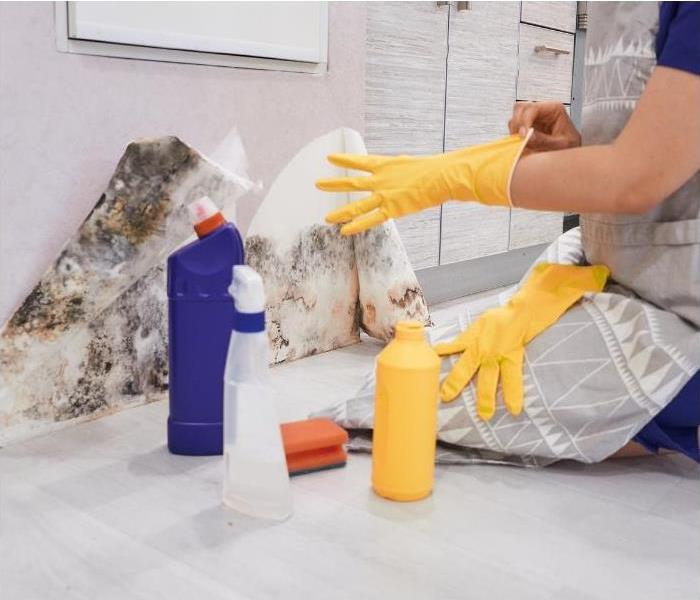 Mold is a common problem found in many households and can be a health hazard if left untreated.
Mold is a common problem found in many households and can be a health hazard if left untreated.
Key Takeaways:
- Mold can be detected using your five senses
- Musty odors and visible growth are common signs
- Moisture, humidity, and leaks can lead to mold growth
- Regular cleaning and maintenance can prevent mold issues
How Can I Spot Mold?
Mold is a common problem found in many households and can be a health hazard if left untreated. One of the most important things you can do to prevent mold growth in your home is to be aware of its presence.
While professional services like SERVPRO of South and Northwest Grand Rapids can help detect and remove potential dangers from hidden sources like air ducts and crawlspaces, mold is not always tucked away in difficult-to-reach places. In fact, you can use your senses to spot signs of a potential issue before it becomes more serious. Here’s how you can use sight, smell, touch, hearing, and taste to identify if there is an existing problem or if conditions are ripe for one down the line.
Sight
One of the most common ways to spot mold is to use your sense of sight. Mold can be black, white, green, or even pink in color, and it often appears as a fuzzy or slimy growth on surfaces like walls, ceilings, and floors. Look out for stains or discoloration on walls or ceilings, especially in damp or poorly ventilated areas. If you see any signs of mold growth, it’s important to act quickly and call a professional mold damage restoration company like SERVPRO of South and Northwest Grand Rapids to prevent further damage.
Smell
Another way to detect mold growth is to use your sense of smell. Mold has a distinct musty odor, described as earthy, damp, or even rotten. If you notice an unusual smell in your home, especially in areas with moisture or humidity, it could be a sign of mold growth. Pay attention to the scent and its intensity, as it can help you determine the extent of the problem. If you suspect mold is present, having it inspected and removed promptly is important.
Touch
You can also use your sense of touch to identify mold growth. If you notice any dampness or moisture on surfaces like walls, ceilings, or floors, it’s important to investigate further. Touch the surface to see if it feels slimy or fuzzy, as this can indicate mold. If you notice any unusual textures or growths on surfaces, it’s important to call a professional mold remediation company like SERVPRO of South and Northwest Grand Rapids to inspect and remove the problem. After touching these surfaces, please wash your hands thoroughly.
Hearing
While mold doesn’t make noise, you can use your sense of hearing to detect water leaks or other issues that can lead to mold growth. It could be a sign of a leak if you hear running water, dripping, or any other unusual noises coming from pipes or appliances. Water leaks are one of the most common causes of mold growth, so it’s important to address them promptly. By fixing leaks and addressing any water damage, you can prevent mold growth before it becomes a serious problem.
Taste
While you can’t actually taste mold, you can use your sense of taste to identify other potential sources of moisture. If you notice a musty or earthy taste in the air, it could be a sign of high humidity or moisture in the room. If you taste metallic or bitter flavors in your drinking water, it could be a sign of contaminants that can lead to mold growth. Identifying and addressing these issues early on can prevent mold growth and keep your home safe and healthy.
Final Thoughts
You can prevent potential health hazards and property damage by using your senses to spot mold growth. If you suspect that mold is present in your home, it’s important to take action immediately by calling a professional mold damage restoration company like SERVPRO of South and Northwest Grand Rapids.
How to Handle Workplace Fire Hazards
9/13/2023 (Permalink)
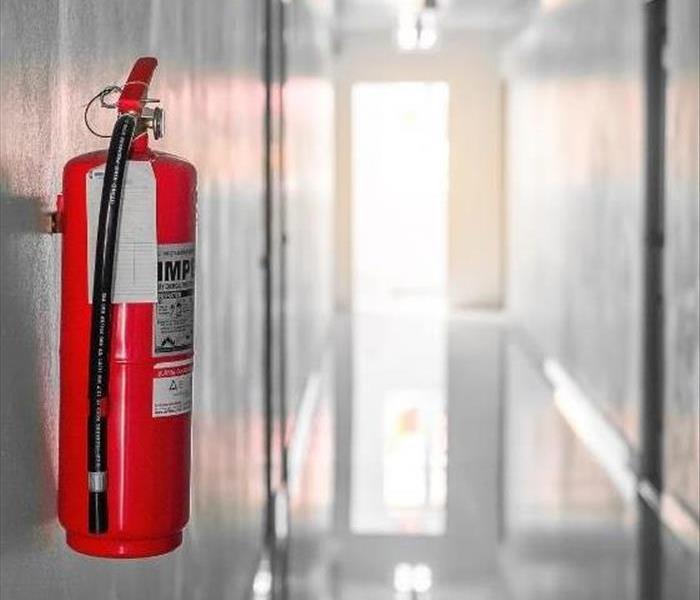 Fire hazards in the workplace are a significant concern for business owners and managers.
Fire hazards in the workplace are a significant concern for business owners and managers.
Key Takeaways:
- Identify and address potential fire hazards in the workplace
- Train employees on fire safety and evacuation procedures
- Regularly inspect and maintain fire safety equipment
- Develop a fire emergency plan and review it periodically
Workplace fire hazards are a significant concern for business owners and managers. Not only can a fire result in devastating property loss, but it can also put employees and customers at risk of injury or death. It is essential to take proactive measures to identify and address potential fire hazards before they become a serious problem.
In this article, we’ll discuss some of the most common workplace fire hazards and provide tips on how to prevent them from causing harm. We’ll also explain what to do in case of a fire and how to get your business back on track after a fire has occurred.
Common Workplace Fire Hazards
There are several workplace fire hazards that property managers should know, including:
Electrical Hazards
Electrical hazards are one of the most common causes of workplace fires. Faulty wiring, overloaded outlets, and damaged equipment can all pose a significant risk. To prevent electrical fires, it’s essential to have regular electrical inspections and ensure that all equipment is properly maintained.
Combustible Materials
Combustible materials such as paper, cardboard, and chemicals can easily catch fire and spread flames. To prevent fires caused by combustible materials, ensure that these items are stored away from heat sources, and properly disposed of when no longer needed.
Cooking Equipment
Kitchens and break rooms that contain cooking equipment pose a significant fire hazard. It’s important to ensure that cooking equipment is well-maintained, and that employees are trained in proper kitchen safety procedures.
Smoking
Smoking is a common cause of workplace fires, particularly in outdoor areas where smoking is allowed. To prevent fires caused by smoking, establish designated smoking areas away from buildings and provide ashtrays for employees to dispose of cigarette butts safely.
Preventing Workplace Fires
Preventing workplace fires is crucial to protecting your business and employees. Here are some tips to help you prevent fires in the workplace:
Conduct Regular Inspections
Regular inspections can help identify potential fire hazards before they become a serious problem. Electrical systems, heating and cooling systems, and cooking equipment should all be inspected regularly to ensure that they are in good working condition.
Establish Fire Safety Procedures
Establish fire safety procedures and ensure that all employees are trained in them. This includes knowing how to use fire extinguishers, where to go in case of a fire, and how to evacuate the building safely.
Store Flammable Materials Safely
Store flammable materials such as gasoline, chemicals, and cleaning products in a secure location away from heat sources. Properly label all containers and ensure that they are tightly sealed.
Install Smoke Detectors
Smoke detectors are an essential safety feature in any workplace. Install smoke detectors throughout the building and check them regularly to ensure they are working correctly.
Responding to a Workplace Fire
Despite best efforts to prevent workplace fires, sometimes they can still occur. If a fire breaks out in your workplace, it’s important to remain calm and follow these steps:
- Evacuate the Building: Immediately evacuate the building and ensure that all employees are accounted for.
- Call for Help: Call 911 and inform the emergency operator of the location of the fire.
- Do Not Attempt to Put Out the Fire: Unless you are trained to do so, do not attempt to put out the fire. Leave it to the professionals.
- Contact SERVPRO of South and Northwest Grand Rapids: Contact a professional fire damage restoration company like SERVPRO of South and Northwest Grand Rapids to assess the damage and begin the restoration process.
Final Thoughts
Workplace fires are a serious threat that every business owner and manager must take seriously. You can protect your workplace from disaster by identifying potential fire hazards, establishing fire safety procedures, and responding quickly in the event of a fire.
What’s Worse, a Slow Persistent Leak or a Burst Pipe?
9/10/2023 (Permalink)
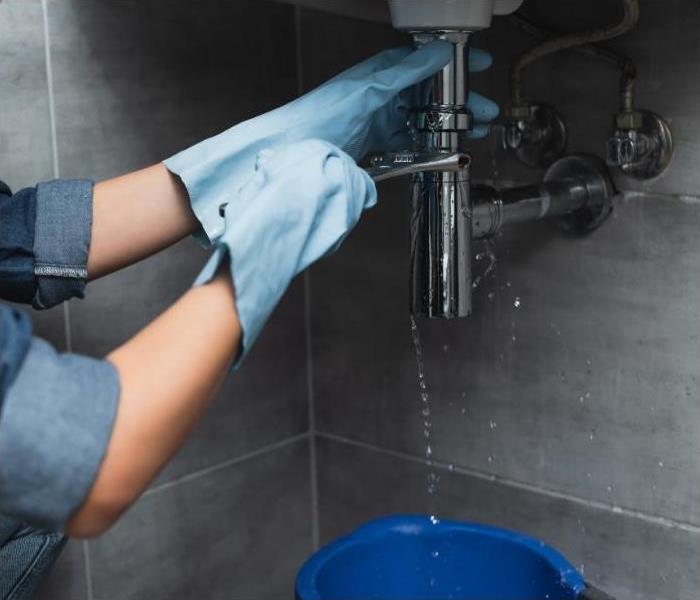 Two common types of water damage are slow persistent leaks and burst pipes.
Two common types of water damage are slow persistent leaks and burst pipes.
Key Takeaways:
- Slow leaks can cause hidden damage over time
- Burst pipes cause immediate and visible damage
- Quick action is necessary for both types of leaks
- Professional restoration can prevent long-term damage and mold growth
When it comes to water damage, prevention is key. Unfortunately, even with the best of intentions, water damage can still occur. When it does, the type of damage and severity can vary. Two common types of water damage are slow persistent leaks and burst pipes. While both can cause significant damage, the severity and urgency of the situation can differ. In this article, we’ll take a closer look at these two types of water damage and discuss how to minimize damage and the importance of calling professional water damage specialists like SERVPRO of South and Northwest Grand Rapids.
Slow Persistent Leaks
Slow persistent leaks are often the result of a small but consistent drip from a faucet, appliance, or pipe. They can also be caused by a faulty seal or a crack in a pipe. While the amount of water may seem minimal, it can add up over time and cause significant damage. The most significant risk of slow persistent leaks is the potential for mold growth. Mold can grow in as little as 24-48 hours and can cause respiratory problems and allergic reactions.
Signs of Slow Persistent Leaks
- Musty odors or visible mold growth
- Stains on walls, floors, or ceilings
- Warping or buckling of floors or walls
- Increased water bill
Minimizing Damage from Slow Persistent Leaks
- Regularly inspect pipes and appliances for leaks
- Fix leaks immediately
- Clean up any water immediately
- Monitor humidity levels and use a dehumidifier if necessary
Burst Pipes
Burst pipes are a much more urgent situation than slow persistent leaks. Burst pipes are typically caused by freezing temperatures or excessive pressure within the pipe. Burst pipes can cause significant damage in a short amount of time and can lead to flooding, which can be dangerous and expensive to repair.
Signs of Burst Pipes
- No water or reduced water pressure
- Water stains or discoloration on ceilings or walls
- Strange noises coming from pipes
- Visible damage to pipes or fittings
Minimizing Damage from Burst Pipes
- Shut off water supply to the affected area
- Call SERVPRO of South and Northwest Grand Rapids immediately for professional water damage restoration
- Turn off electricity to the affected area
- Move valuables and furniture to a dry area
Importance of Calling Professional Water Damage Specialists
Water damage can be devastating, and it’s crucial to call a professional water damage restoration company like SERVPRO of South and Northwest Grand Rapids. Attempting to clean up water damage yourself can be dangerous and lead to further damage. Professional water damage specialists have the knowledge and equipment necessary to minimize damage and prevent mold growth. They can also work with your insurance company to make the restoration process as smooth as possible.
Final Thoughts
Whether it’s a slow persistent leak or a burst pipe, water damage can cause significant damage to your home or business. It’s crucial to take proactive steps to prevent water damage and address any concerns as soon as possible. With water damage, time is of the essence. The longer water damage is left untreated, the more damage it can cause. Call SERVPRO of South and Northwest Grand Rapids for professional water damage restoration.
How SERVPRO Cleans Up a House Fire
9/1/2023 (Permalink)
Key Takeaways:
- Smoke and fire damage require different cleaning methods.
- SERVPRO conducts a thorough assessment to create an action plan.
- SERVPRO utilizes specialized equipment and techniques for cleaning.
- SERVPRO can restore your home to its pre-fire condition.
Experiencing a house fire is a traumatic event that can leave lasting damage and stress on both residential homeowners and commercial property managers. Smoke and fire damage can be overwhelming to deal with, but with the help of a professional restoration company, you can get your property back to its pre-fire condition. SERVPRO of South and Northwest Grand Rapids is a national leader in fire and smoke restoration services, providing comprehensive and effective solutions for homeowners and commercial property managers.
Understanding the Difference Between Fire and Smoke Damage
Before discussing how SERVPRO cleans up a house fire, it is important to understand the difference between fire and smoke damage. Fire damage refers to the physical damage that occurs because of the flames, such as burned walls, floors, and ceilings. Smoke damage refers to the damage caused by the smoke that can spread throughout the property, leaving behind soot and odor.
Both fire and smoke damage require immediate attention to prevent further damage from occurring. SERVPRO of South and Northwest Grand Rapids offers 24-hour emergency service to respond quickly to the scene and assess the damage.
The SERVPRO Cleaning Process
After responding to the scene, SERVPRO of South and Northwest Grand Rapids develops a detailed action plan for restorative cleaning. This plan outlines the steps required to restore the property to its pre-fire condition.
Step 1: Assessment
The first step in the cleaning process is to assess the damage. SERVPRO technicians thoroughly inspect the property to determine the extent of the damage caused by the fire and smoke. This assessment allows them to develop an effective action plan that is tailored to the specific needs of the property.
Step 2: Mitigation
Once the assessment is complete, the next step is mitigation. SERVPRO technicians take steps to prevent further damage from occurring. This includes boarding up windows and doors, tarping the roof, and removing excess water caused by firefighting efforts.
Step 3: Restoration
The restoration process is where SERVPRO technicians begin to clean and restore the property. This includes removing debris, soot, and smoke damage from all affected areas. SERVPRO utilizes specialized equipment and techniques to remove soot and odor from furniture, walls, floors, and ceilings. They also use air scrubbers and dehumidifiers to remove any remaining smoke odor from the property.
Step 4: Reconstruction
The final step in the SERVPRO cleaning process is reconstruction. This step involves repairing any structural damage caused by the fire. SERVPRO works with licensed contractors to ensure that all repairs are done correctly and up to code.
Why Choose SERVPRO of South and Northwest Grand Rapids?
SERVPRO of South and Northwest Grand Rapids is a nationally recognized leader in fire and smoke restoration services. Their team of trained professionals has the knowledge and experience to provide comprehensive solutions for both residential and commercial properties. They use the latest equipment and techniques to ensure that each room is restored to its pre-fire condition, leaving no trace of smoke or fire damage.
Choosing SERVPRO of South and Northwest Grand Rapids for your fire restoration needs ensures that your property is in the hands of experts who understand the urgency and stress of the situation. They work efficiently and effectively to restore your property, providing you with peace of mind during a difficult time.
Final Thoughts
Experiencing a house fire is a traumatic event that can leave lasting damage and stress on both residential homeowners and commercial property managers. However, with the help of a professional restoration company like SERVPRO of South and Northwest Grand Rapids, you can get your property back to its pre-fire condition quickly and efficiently.
How Does SERVPRO Handle Large-Scale Cleanup?
8/24/2023 (Permalink)
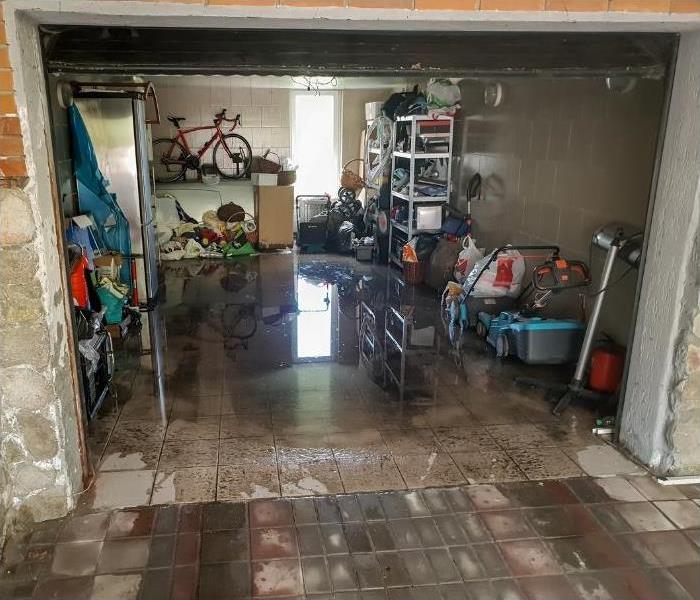 Large-scale disasters like fires, floods, and storms can wreak havoc on commercial properties.
Large-scale disasters like fires, floods, and storms can wreak havoc on commercial properties.
Key Takeaways
- Large-scale cleanup requires a unique approach and specialized expertise.
- SERVPRO of South and Northwest Grand Rapids has a comprehensive process for handling all types of disasters.
- Experience matters when it comes to large-scale cleanup, as it allows for greater efficiency, expertise, and safety.
- It’s important to have experienced professionals on your side to handle large-scale disasters safely and effectively.
Our Approach to Large-Scale Cleanup
At SERVPRO, we understand that large-scale cleanup requires a unique approach. That’s why we’ve developed a comprehensive process to handle all types of disasters, big or small. Here’s a breakdown of our approach to large-scale cleanup:
1. Emergency Response
When disaster strikes, acting quickly to prevent further damage is essential. Our team is available 24/7 to respond to emergencies and provide immediate assistance. We’ll arrive on-site as quickly as possible to assess the situation and create a plan of action.
2. Damage Assessment
After an emergency response, we’ll conduct a thorough damage assessment to determine the extent of the damage. We use advanced technology and equipment to identify all areas that have been affected, including hidden moisture, soot, and other contaminants.
3. Mitigation
Once we’ve identified the extent of the damage, we’ll begin the mitigation process. This may involve water extraction, drying and dehumidification, debris removal, and other measures to prevent further damage.
4. Restoration
Once mitigation is complete, we’ll begin the restoration process. This may involve rebuilding damaged structures, replacing damaged equipment or furnishings, and restoring the property to its original condition. We aim to restore your property as quickly as possible while minimizing disruptions to your business operations.
Why Experience Matters
Handling large-scale cleanup requires experience, expertise, and specialized equipment. At SERVPRO, we have all three. We’ve handled some of the largest disasters in the country, and we know how to navigate complex restoration projects. Here are some of the reasons why experience matters when it comes to large-scale cleanup:
1. Efficiency
Experienced professionals know how to handle large-scale cleanup efficiently. We have the equipment and human resources to handle any size disaster and know how to work quickly without sacrificing quality.
2. Expertise
Large-scale disasters often require specialized expertise. At SERVPRO, we have a team of experts trained to handle all types of disasters, from fires to floods and more. We know how to identify and mitigate risks and prevent further damage.
3. Safety
Large-scale disasters can pose safety risks to your employees and customers. That’s why it’s essential to have experienced professionals on your side who know how to handle these risks safely. We follow all safety protocols and use specialized equipment to keep everyone safe.
Final Thoughts
Disasters happen when you least expect them, and the damage they leave behind can be overwhelming. Large-scale disasters like fires, floods, and storms can wreak havoc on commercial properties and leave businesses struggling to get back on their feet. Our team of experienced professionals is here to handle large-scale cleanup with efficiency, expertise, and care.
Help, The Office Breakroom Has Mold!
8/17/2023 (Permalink)
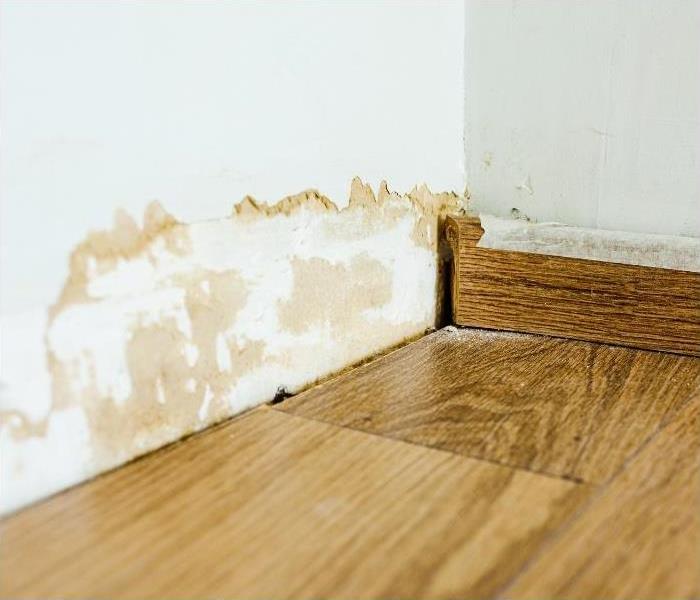 Mold can grow anywhere with moisture and warmth, and the breakroom is one of the most common areas where it can develop.
Mold can grow anywhere with moisture and warmth, and the breakroom is one of the most common areas where it can develop.
Key Takeaways:
- Mold can grow in any office and has serious health implications.
- Leaky pipes, high humidity, and poor ventilation are common causes of mold.
- Proper cleaning and maintenance are key to preventing and removing mold.
- Don’t ignore or underestimate mold in the office.
Mold in the office can be a serious problem that affects your employees' health and damages your company’s reputation. It can grow anywhere with moisture and warmth, and the breakroom is one of the most common areas where it can develop. Mold is not only unsightly, but it can also have severe health implications if left untreated. It is crucial to understand the sources of mold in the office, how to prevent it, and how to handle mold remediation in case of an outbreak. In this article, we will guide you through everything you need to know about mold in the office breakroom.
What Causes Mold in the Office Breakroom?
Mold in the office breakroom can occur due to several reasons. Some of the most common sources of mold include:
- Leaks and Water Damage: One of the primary causes of mold growth in the office breakroom is water damage. Water leaks from plumbing or the roof can create an ideal environment for mold growth.
- Poor Ventilation: Without proper ventilation, moisture can build up in the air, creating a humid environment that encourages mold growth.
- Dirty Appliances and Surfaces: If breakroom appliances such as coffee machines, refrigerators, or microwaves are not cleaned properly, they can become breeding grounds for mold.
- Improper Food Storage: Storing food for too long or not sealing it correctly can cause mold to grow on the food and eventually spread to other areas.
How to Prevent Mold in the Office Breakroom?
Preventing mold growth in the office breakroom is essential for maintaining a healthy and safe environment for employees. Here are some tips on how to prevent mold:
- Regular Cleaning: Regularly cleaning the breakroom, including all appliances, surfaces, and floors, can prevent moisture accumulation and mold growth.
- Proper Ventilation: Make sure the breakroom has adequate ventilation to keep the air circulating and prevent moisture buildup.
- Fix Leaks Immediately: Water leaks must be fixed promptly to prevent mold growth. If you notice any signs of leaks, such as water stains or discoloration, contact a professional for assistance.
- Proper Food Storage: Encourage employees to store food properly, discard expired food, and clean up spills promptly to prevent mold growth.
How to Handle Mold Remediation in the Office Breakroom?
If you notice mold growth in the office breakroom, it is crucial to address it immediately to prevent further spread and potential health risks. Here are the steps to take for mold remediation:
- Contact Professionals: Contact SERVPRO of South and Northwest Grand Rapids for professional mold inspection and remediation services. Mold can be hazardous to your health, and professional expertise is necessary to handle it properly.
- Identify the Source: Determine the source of the mold outbreak to prevent future growth. Fix any leaks or other sources of moisture and improve ventilation.
- Contain the Area: Isolate the affected area to prevent the spread of mold spores and protect employees.
- Remediate the Mold: Professional remediation involves removing the mold and any affected materials and cleaning the area with specialized equipment and solutions.
Final Thoughts
Mold growth in the office breakroom can be a significant health hazard for your employees and damage your company’s reputation. Preventing mold growth in the office breakroom requires regular cleaning, proper ventilation, fixing leaks, and proper food storage. If you notice mold growth in the office breakroom, contact SERVPRO of South and Northwest Grand Rapids for professional mold remediation services. Ignoring mold growth can lead to severe health consequences, so act immediately.
Is a Leaking Washing Machine Rotting Your Floor?
8/13/2023 (Permalink)
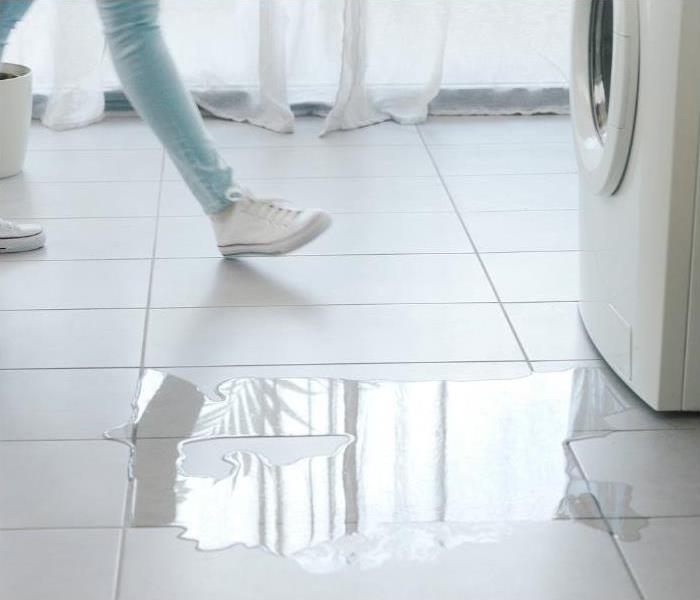 If a washing machine is leaking, how can you tell if your floor is being damaged?
If a washing machine is leaking, how can you tell if your floor is being damaged?
Key Takeaways
- Regularly check for leaks around your washing machine.
- Take proactive steps to prevent water damage.
- Act quickly and call SERVPRO of South and Northwest Grand Rapids water specialists.
- Don’t let water damage cause long-term structural problems.
When it comes to water damage, prevention is key. But when that spigot keeps dripping, or worse yet – a washing machine is leaking, how can you tell if your floor is being damaged? Not only does this type of problem affect your day-to-day convenience, but it can also indicate long-term structural problems requiring expensive repairs.
In this article, we’ll show you how to spot leaks, prevent water damage, and call in SERVPRO of South and Northwest Grand Rapids water specialists to restore your home to its pre-damage condition.
Spotting Leaks
One of the easiest ways to spot leaks is to check for water accumulation around your washing machine regularly. If you notice water on the floor after running your washing machine, it’s time to investigate further.
Another common sign of a leak is a musty odor. When water gets trapped in your floor, it can create a moist environment that promotes mold growth. Mold can cause respiratory issues and further structural damage to your home.
If you notice discoloration on your flooring or walls, this could also indicate water damage. Dark spots or stains are signs of long-term water damage and could be hiding rotting wood or weakened subfloors.
Preventing Water Damage
Preventing water damage starts with taking proactive steps to avoid leaks. Here are some tips to help keep your home safe from water damage:
- Inspect your washing machine regularly. Check hoses and connections for wear and tear, and replace them as needed.
- Make sure your washing machine is level. An unbalanced machine can cause excess vibration, which can loosen hoses and cause leaks.
- Don’t overload your washing machine. Overloading can put a strain on your machine and increase the risk of leaks.
- Monitor your water bill. A sudden spike in your water bill could indicate a leak.
In addition to these preventative measures, it’s a good idea to have SERVPRO of South and Northwest Grand Rapids water specialists inspect your home for potential water damage. They can identify problem areas and offer solutions to help prevent future leaks.
Restoring Water Damage
If you experience water damage, it’s important to act quickly to minimize it. The longer you wait, the more extensive the damage will be.
SERVPRO of South and Northwest Grand Rapids water specialists are trained to handle all types of water damage, from minor leaks to major floods. They use advanced technology and techniques to extract water, dry out affected areas, and restore your home to its pre-damage condition.
They also work closely with your insurance company to ensure you get the coverage you need to repair your home. And they provide 24/7 emergency service, so you can get help when you need it most.
Final Thoughts
Water damage is a serious problem that requires immediate attention. You can avoid expensive repairs and keep your home safe and dry by spotting leaks early, taking preventative measures, and calling in SERVPRO of South and Northwest Grand Rapids water specialists.
Don’t let a leaking washing machine rot your floor. Take action today to prevent water damage and protect your home.
The Benefits of Professional Fire Damage Restoration
8/10/2023 (Permalink)
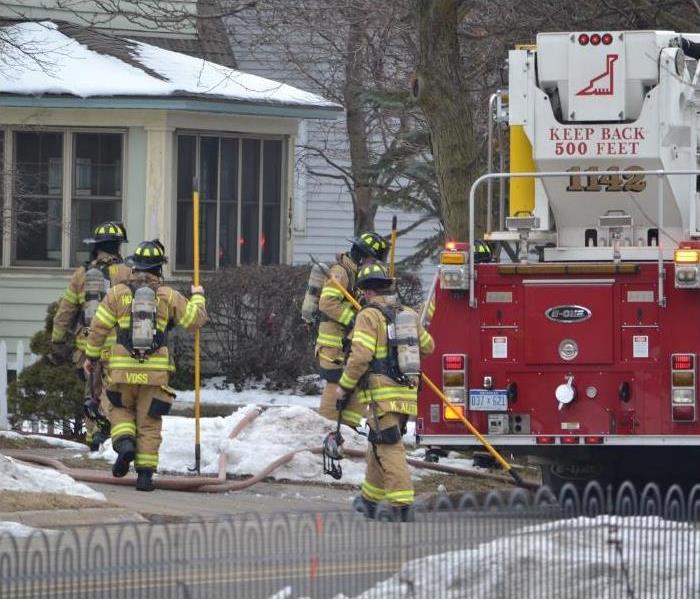 Experiencing a house fire can be a traumatic and devastating event that can cause significant damage to your property and belongings.
Experiencing a house fire can be a traumatic and devastating event that can cause significant damage to your property and belongings.
Key Takeaways:
- Professional fire damage restoration is essential to ensure safety.
- Restoration companies have the expertise, tools, and experience to restore homes.
- Quick restoration can save time, money, and prevent further damage.
- Professional restoration can help homeowners cope with the aftermath.
Experiencing a house fire can be a traumatic and devastating event that can cause significant damage to your property and belongings. The aftermath of a fire can be overwhelming, leaving you with many questions and concerns. Fortunately, professional fire damage restoration services like SERVPRO of South and Northwest Grand Rapids are available to help you navigate the restoration process and provide you with the answers and peace of mind you need to put your life back together.
This article will explore the benefits of professional fire damage restoration services and how they can help you get back on your feet after a fire.
Comprehensive Restoration Services
One of the main benefits of hiring a professional fire damage restoration company is that they offer comprehensive restoration services that cover all aspects of the restoration process. This includes everything from initial assessment and cleanup to repairs and reconstruction. Utilizing a single company for all your restoration needs can streamline the process and ensure that your property is restored quickly and efficiently.
Knowledge and Expertise
Professional fire damage restoration companies like SERVPRO of South and Northwest Grand Rapids have abundant knowledge and expertise in handling fire damage. They understand the complexities of the restoration process and have the experience and training necessary to handle even the most severe cases. This means you can trust them to assess the damage properly, develop a restoration plan, and execute it with precision and efficiency.
Quick Response Time
Time is of the essence when it comes to fire damage restoration. The longer you wait to address the damage, the more extensive and costly the repairs will be. Professional restoration companies understand this and are equipped to respond quickly to your needs. They have the tools and resources necessary to start the restoration process immediately, helping to minimize the damage and get your property back to pre-fire condition as quickly as possible.
Insurance Claims Assistance
Dealing with insurance companies can be a daunting task, especially after experiencing a fire. Professional fire damage restoration companies like SERVPRO of South and Northwest Grand Rapids can assist you with the insurance claims process by providing detailed documentation of the damage and the restoration process. This can help expedite the claims process and ensure that you receive the maximum coverage available under your policy.
Final Thoughts
Experiencing a house fire can be a traumatic and overwhelming experience, but it doesn’t have to be. Professional fire damage restoration services can provide you with the expertise, resources, and peace of mind to put your life back together. Utilizing a single company for all your restoration needs can streamline the process and ensure that your property is restored quickly and efficiently. So, if you’re dealing with the aftermath of a fire, contact the professionals at SERVPRO of South and Northwest Grand Rapids to help you get back on your feet.
The Different Types of Mold and Their Health Effects
8/9/2023 (Permalink)
Key Takeaways:
- Mold is a common problem that can have serious health effects.
- Different types of mold have different health impacts.
- Preventative measures can be taken to avoid mold growth.
- Professional mold remediation can effectively remove mold from your home.
Mold is a common problem that many homeowners face. It is not just unsightly, but can also be hazardous to our health. Knowing how to identify and prevent different types of mold can help protect our homes and loved ones from its harmful effects.
Understanding Mold
Mold is a type of fungus that thrives in warm, humid environments. It grows on organic matter, such as wood, paper, and fabric, and can cause a range of health issues. Mold reproduces by releasing spores into the air, which can be inhaled, ingested or come into contact with the skin. These spores can trigger allergic reactions, respiratory problems, and other health issues.
What Are the Common Types of Mold?
There are several types of mold, each with its own unique characteristics and health effects.
Cladosporium
Cladosporium is a common type of mold found both indoors and outdoors. It is often found in areas with high moisture, such as bathrooms and basements. Exposure to Cladosporium can cause allergic reactions, asthma attacks, and other respiratory problems.
Aspergillus
Aspergillus is a type of mold that can grow on walls, floors, and other surfaces. It is commonly found in homes with water damage, and can cause respiratory problems, allergic reactions, and even infections.
Stachybotrys
Stachybotrys, also known as black mold, is a type of mold that is commonly found in homes with water damage. It is known for its dark green or black color and slimy texture. Exposure to Stachybotrys can cause serious health problems, including respiratory problems, allergic reactions, and even neurological issues.
Penicillium
Penicillium is a type of mold that can grow on food, wallpaper, and other surfaces. While it is not as harmful as other types of mold, it can still cause allergic reactions, respiratory problems, and other health issues.
Preventing Mold
Preventing mold growth is essential for maintaining a healthy home environment. Here are some tips to prevent mold from growing in your home:
- Keep your home dry: Address any leaks or moisture problems immediately, and make sure that your home is properly ventilated.
- Clean regularly: Regularly cleaning your home can help prevent mold growth by removing any potential food sources for mold, such as dust and dirt.
- Control humidity levels: Keep your home’s humidity levels below 60 percent to prevent mold growth.
- Address water damage: If your home has experienced water damage, it’s important to address it as soon as possible to prevent mold growth.
Mold Remediation
If you suspect that you have mold in your home, it’s important to take action immediately. Mold can spread quickly and cause serious health issues if left untreated. SERVPRO of South and Northwest Grand Rapids can help identify and remove mold from your home safely and effectively.
Final Thoughts
Understanding the different types of mold and their health effects is essential for protecting your home and family. By following these preventative measures and taking action if you suspect mold growth in your home, you can keep your home healthy and safe.
Can Fireplaces Damage Other Areas of My House?
8/1/2023 (Permalink)
 Fireplaces are a popular addition to many homes, providing warmth and comfort during the cold winter months.
Fireplaces are a popular addition to many homes, providing warmth and comfort during the cold winter months.
Key Takeaways:
- Fireplaces can damage homes without proper maintenance and operation
- Risks include creosote buildup, incorrect installation, and human error
- Prevent fires with regular maintenance and safe operation practices
- In case of a fire, evacuate and seek professional assistance.
Fireplaces are a popular addition to many homes, providing warmth and comfort during the cold winter months. However, these cozy features can pose a risk to your property if not properly maintained. The question remains, can fireplaces damage other areas of your house? The short answer is yes. In this article, we’ll explore the dangers of fireplace house fires and what you can do to prevent them.
What Are the Risks of Fireplace House Fires?
When a fireplace is not properly maintained or operated, it can start a fire that can quickly spread throughout your home, causing extensive damage. This can be due to a variety of factors, including:
Lack of Maintenance
Fireplaces require regular maintenance to ensure they are safe and efficient. When left unmaintained, creosote (a highly flammable substance that builds up in the chimney) can accumulate and ignite, causing a chimney fire that can quickly spread to other areas of the house.
Incorrect Installation
A poorly installed or malfunctioning fireplace can also pose a risk. For example, if the chimney is too close to combustible materials or if there is a blockage in the chimney, a house fire can occur.
Human Error
Improper use of the fireplace can also lead to a fire. For example, using improper fuel sources, failing to use a screen or glass doors, and leaving the fire unattended can all lead to a dangerous situation.
Preventing Fireplace House Fires
Preventing fireplace house fires requires a combination of regular maintenance and safe operation. Here are some tips to help prevent a house fire caused by your fireplace:
Regular Maintenance
- Have your chimney inspected and cleaned by a professional chimney sweep at least once a year.
- Make sure your chimney is properly lined and in good condition.
- Install a chimney cap to prevent debris from entering the chimney and causing a blockage.
- Only burn dry, seasoned wood to reduce the buildup of creosote.
Safe Operation
- Always use a screen or glass doors to prevent sparks from escaping the fireplace.
- Never leave a fire unattended and make sure the fire is completely extinguished before leaving the room or going to bed.
- Use only approved fuel sources, such as dry wood or manufactured logs.
- Keep combustible materials at least three feet away from the fireplace.
What to Do in Case of a Fireplace House Fire
If a house fire does occur, it’s important to act quickly. Follow these steps:
- Get everyone out of the house and call 911 immediately.
- Do not attempt to put out the fire yourself.
- Contact SERVPRO of South and Northwest Grand Rapids for professional fire restoration services.
Final Thoughts
Fireplaces can and will pose a significant risk to your home if not properly maintained and operated. However, with regular maintenance and safe operation, you can enjoy the warmth and comfort of your fireplace without the risk of a house fire. And in the event of a fire, remember to act quickly and contact the professionals at SERVPRO of South and Northwest Grand Rapids for expert fire restoration services.
3 Spots Mold Loves To Hide In Your Home
8/1/2023 (Permalink)
Key Takeaways
- Mold loves dark, damp, and poorly ventilated areas like the attic and basement.
- Bathrooms are another common area for mold growth due to moisture and poor ventilation.
- Kitchens are also vulnerable to mold growth due to water leaks and food spills.
- Regular inspections and prompt remediation can prevent mold growth and keep your home safe and healthy.
Mold is a common problem that many homeowners face, and it can be quite challenging to get rid of once it grows. Not only can it cause health problems, but it can also lead to property damage if not addressed in time. The key to preventing mold growth and controlling its spread is to understand where it likes to hide. In this article, we’ll discuss the top 3 spots where mold loves to hide in your home and how to prevent and eradicate it.
1. Attic and Basement
Mold loves to grow in dark, damp, and poorly ventilated areas. That’s why the attic and basement are the perfect breeding grounds for mold. These areas often have poor air circulation, and if there’s a water leak, condensation, or high humidity, mold can quickly spread. It’s crucial to inspect your attic and basement regularly for any signs of mold growth. Look for black, green, or white spots on walls, ceilings, and floors. If you notice any musty smells or dampness, it’s a sign that mold is present.
Prevention is key when it comes to controlling mold growth in the attic and basement. Ensure proper ventilation in these areas by installing fans and vents. Keep the humidity level below 60% by using a dehumidifier. Also, fix any leaks or water damage as soon as possible. If you do find mold in your attic or basement, don’t try to tackle the problem yourself. Instead, call a professional mold remediation company like SERVPRO of South and Northwest Grand Rapids to handle the job.
2. Bathroom
Bathrooms are another common area where mold likes to grow. The combination of moisture, warmth, and poor ventilation creates an ideal environment for mold to thrive. Pay close attention to areas around the sink, shower, and bathtub, as these are the most likely spots for mold growth. Check for any discoloration on tiles, grout, or caulking, and if you notice any, it’s a sign that mold is present.
To prevent mold growth in your bathroom, keep the area well-ventilated by using an exhaust fan or opening a window. Wipe down wet surfaces after use and fix any leaks or water damage immediately. Also, regularly clean your bathroom with a mold-killing cleaner to prevent the growth of mold spores. If you do find mold in your bathroom, don’t try to remove it yourself, as it can release spores into the air. Instead, call a professional mold remediation company like SERVPRO of South and Northwest Grand Rapids to handle the job.
3. Kitchen
The kitchen is another area where mold can grow, especially around the sink, dishwasher, and refrigerator. Water leaks from these appliances can create damp environments that are perfect for mold growth. Also, food spills, crumbs, and debris can attract mold spores, leading to growth.
To prevent mold growth in your kitchen, keep the area clean and dry by wiping up spills and crumbs immediately. Fix any leaks or water damage as soon as possible, and ensure proper ventilation in the area by using an exhaust fan. Also, regularly check your appliances for leaks and mold growth. If you do find mold in your kitchen, don’t try to tackle the problem yourself. Instead, call a professional mold remediation company like SERVPRO of South and Northwest Grand Rapids to handle the job.
Final Thoughts
Mold growth can be a frustrating and dangerous problem to deal with. To prevent and control mold growth, it’s essential to understand where it likes to hide. Monitor your attic, basement, bathroom, and kitchen for any signs of mold growth.
Storm Damage Prevention: What Can We Do?
7/20/2023 (Permalink)
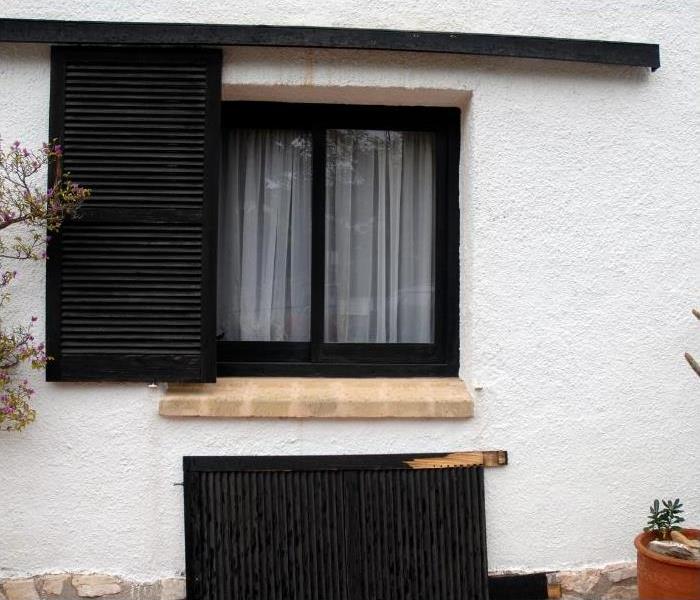 Preparing your property and staying on top of maintenance can help minimize the impact of severe weather.
Preparing your property and staying on top of maintenance can help minimize the impact of severe weather.
Key Takeaways:
- Regular property maintenance is essential to prevent storm damage
- Protecting windows and doors can reduce the risk of damage
- Proper tree maintenance and removal can prevent damage to property
- Having a plan in place and knowing what to do after a storm can help minimize damage and restoration costs
As a homeowner or property manager, storm damage can be a nightmare to deal with. From water damage to wind damage, storms can cause significant harm to your property, not to mention the added stress and expense of cleaning up and restoring your property to its former state. However, there are many steps you can take to prevent storm damage and minimize the impact of any severe weather that may come your way.
Inspect Your Property Regularly
One of the best things you can do to prevent storm damage is to inspect your property regularly. Check your gutters for debris and ensure they are properly installed and free of any leaks. Inspect your roof for missing shingles, cracks, or other signs of damage. Look for any signs of damage or wear on your doors, windows, and siding. Make sure your trees are trimmed and free from any dead or weak branches that could fall during a storm. These simple inspections can help you identify potential problem areas before they turn into costly repairs.
Prepare Your Property for Severe Weather
Another critical step in preventing storm damage is to prepare your property for severe weather. If you live in an area prone to high winds, it’s a good idea to install storm shutters or impact-resistant windows to protect your home’s windows. If you live in an area prone to flooding, make sure you have a sump pump and a backup generator to keep your basement dry in the event of a power outage. If you live in an area prone to hurricanes, make sure your roof is properly secured to your home’s frame and consider installing hurricane straps to prevent your roof from separating during high winds.
Keep Up with Maintenance
Regular maintenance is essential for preventing storm damage. Clean your gutters at least twice a year to prevent water damage from overflowing gutters. Trim your trees regularly to prevent dead branches from falling during a storm. Make sure your roof is inspected annually for signs of wear and tear. Keep your siding, windows, and doors in good repair to prevent water from entering your home. Regular maintenance may seem like a hassle, but it’s much easier and less expensive than dealing with storm damage after the fact.
Know When to Call in the Professionals
Despite your best efforts, sometimes storm damage is unavoidable. In these cases, it’s important to know when to call in the professionals. SERVPRO of South and Northwest Grand Rapids is always ready to help with storm damage restoration efforts. Our team of experts can help with everything from water extraction and mold remediation to repairing structural damage and restoring your property to its former state. Don’t try to tackle storm damage restoration on your own – call in the experts at SERVPRO of South and Northwest Grand Rapids for fast, reliable service.
Final Thoughts
While it’s impossible to prevent all storm damage, taking the time to prepare your property and stay on top of maintenance can help minimize the impact of severe weather. By following the tips outlined in this article, you can rest easy knowing that you’ve done everything possible to protect your property from storm damage. And if the worst does happen, SERVPRO of South and Northwest Grand Rapids is always here to help with storm damage restoration efforts. Contact us today to learn more about our services and how we can help protect your property.
3 Damage Myths You Can’t Ignore After a Storm
7/17/2023 (Permalink)
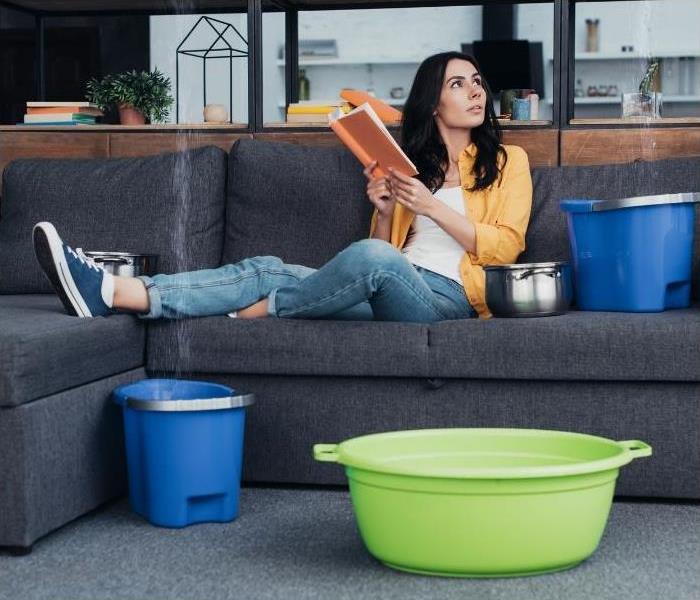 At SERVPRO of South and Northwest Grand Rapids, we understand the challenges of storm damage restoration.
At SERVPRO of South and Northwest Grand Rapids, we understand the challenges of storm damage restoration.
Key Takeaways:
- Don’t believe the myth that all storm damage is visible
- Beware of contractors offering “too good to be true” deals
- Understand the importance of proper storm damage assessment
- Work with a reputable restoration company for quality repairs
When a storm hits, it can leave behind a trail of destruction. From fallen trees to damaged roofs, it’s important to act quickly to mitigate further damage and begin the restoration process. However, it’s also important to separate fact from fiction when it comes to storm damage. Here are three common myths about storm damage you shouldn’t ignore.
Myth #1: If There’s No Visible Damage, There’s No Damage at All
Just because there’s no visible damage to your property doesn’t mean that there’s no damage at all. Many types of damage may not be immediately visible, but can cause long-term problems if left unchecked. For example, water damage from a leaky roof can lead to mold growth and compromise the structural integrity of your home. It’s important to have a professional inspection to ensure that your property is truly in good condition.
Myth #2: DIY Repairs Are Just as Effective as Professional Repairs
It may be tempting to save money by attempting to make repairs yourself, but DIY repairs can often lead to more problems down the line. Without the proper training and equipment, you may not identify all the damage that needs to be addressed, leading to incomplete repairs that leave your property vulnerable to future damage. Professional restoration companies like SERVPRO of South and Northwest Grand Rapids have the expertise and experience to properly assess and address storm damage.
Myth #3: Coverage for Storm Damage
While it's true that there are financial options available for the restoration of storm damage, it's important to note that not all forms of damage are included. For instance, if the damage is a result of insufficient maintenance or neglect, the costs of repairs may not be covered. To ensure clarity on what is covered, it is essential to carefully review your policy and consult with professionals in the field.
Final Thoughts
When it comes to storm damage restoration, it’s important to separate fact from fiction. Myths about damage can lead to improper repairs, additional damage, and unnecessary expenses. By understanding the truth about storm damage, you can make informed decisions about the restoration process and ensure that your property is fully restored to its pre-storm condition.
At SERVPRO of South and Northwest Grand Rapids, we understand the challenges of storm damage restoration. That’s why we offer comprehensive restoration services to help you get your property back to its pre-storm condition quickly and efficiently. Contact us today to learn more about our services.
Top 3 Things that Cause the Most Property Damage During Storms
7/13/2023 (Permalink)
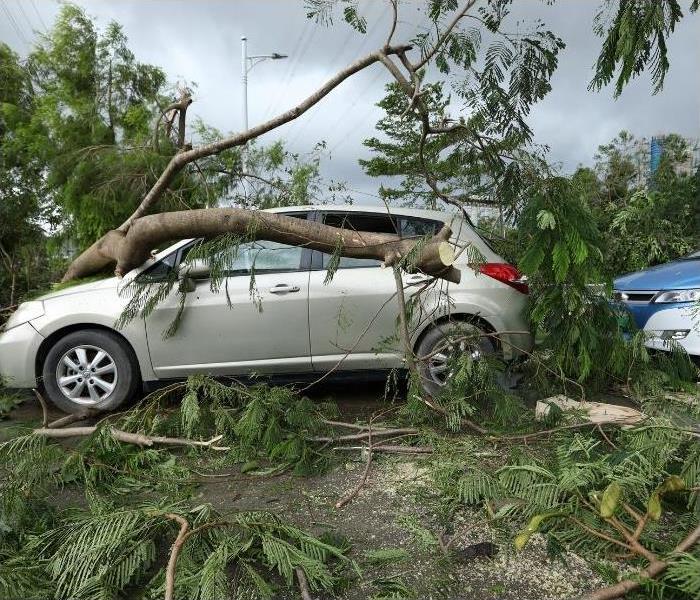 SERVPRO of South and Northwest Grand Rapids can provide storm cleanup services.
SERVPRO of South and Northwest Grand Rapids can provide storm cleanup services.
Key Takeaways:
- Water damage is the most common cause of storm-related property damage.
- Strong winds and fallen trees can cause severe structural damage to buildings.
- Power outages can lead to secondary damages such as mold growth.
- SERVPRO of South and Northwest Grand Rapids can provide storm cleanup services.
Storms can cause severe damage to properties, and the aftermath can be both time-consuming and expensive to fix. As a property manager or homeowner, it’s essential to be aware of the most common causes of storm-related property damage and what you can do to minimize the risks. Here are the top three things that cause the most property damage during storms and tips on how to prepare your property to withstand extreme weather conditions.
1. Strong Winds
Strong winds are one of the most destructive forces during a storm. They can cause significant damage to roofs, windows, and siding, leading to water damage and even structural damage. In extreme cases, strong winds can uproot trees and knock down power lines, resulting in power outages and fire hazards.
How to Prepare:
- Trim trees and remove dead branches before a storm hits.
- Secure outdoor furniture, decorations, and other items that can become projectiles in high winds.
- Make sure windows and doors are sealed and reinforced to withstand high winds.
What to Do After a Storm:
- Inspect your property for any damage caused by strong winds.
- Contact SERVPRO of South and Northwest Grand Rapids to assess the damage and start the restoration process.
2. Heavy Rain and Flooding
Heavy rain and flooding can cause significant water damage to a property, especially if the water is left standing for an extended period. Water can seep into walls, floors, and ceilings, causing mold growth and structural damage. In addition, flooding can lead to electrical hazards, as water can conduct electricity and pose a risk to people and pets.
How to Prepare:
- Clean gutters and downspouts to ensure water flows away from your property.
- Install a sump pump in the basement to remove excess water.
- Raise electrical components and appliances off the ground to prevent water damage.
What to Do After a Storm:
- Turn off the power and gas to your property to avoid electrical hazards and gas leaks.
- Remove standing water as soon as possible to prevent mold growth.
- Contact SERVPRO of South and Northwest Grand Rapids to remove water, dry out your property, and prevent further damage.
3. Hailstorms
Hailstorms can cause extensive damage to a property’s roof, siding, and windows. The force of the hail can create holes, dents, and cracks, which can lead to water damage and mold growth if not addressed promptly.
How to Prepare:
- Install impact-resistant roofing and siding materials.
- Keep trees trimmed to prevent branches from breaking off and damaging your property.
- Secure outdoor items that can become projectiles in a hailstorm.
What to Do After a Storm:
- Inspect your property for any damage caused by hail.
- Contact SERVPRO of South and Northwest Grand Rapids to assess the damage and start the restoration process.
Final Thoughts
Storms can cause significant damage to properties, but being aware of the most common causes of storm-related property damage can help you prepare and protect your property. Whether it’s strong winds, heavy rain and flooding, or hailstorms, taking steps to prepare your property before a storm and taking swift action after a storm can minimize the risks and help you avoid costly repairs. If your property has been affected by storm damage, contact SERVPRO of South and Northwest Grand Rapids to restore your property to its pre-storm condition.
Tree Removal Is a Routine Part of Storm Damage Restoration
7/10/2023 (Permalink)
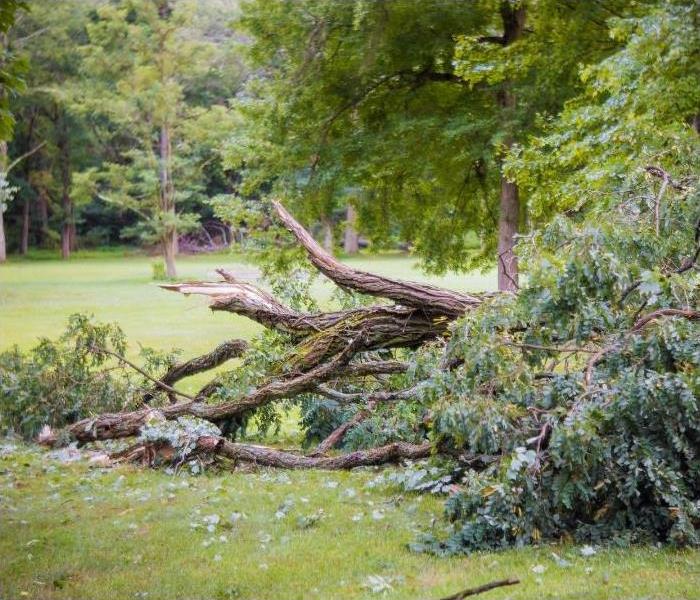 SERVPRO offers tree removal services as part of storm restoration.
SERVPRO offers tree removal services as part of storm restoration.
Key Takeaways:
- Tree removal is an important safety measure after storms.
- Hazardous trees should be removed before a storm hits.
- Professional tree removal is the safest option.
- SERVPRO offers tree removal services as part of storm restoration.
How Important Is Tree Removal?
Trees are essential parts of our landscapes and can provide shade, beauty, and a natural habitat for wildlife. However, after a storm, trees can become dangerous and need to be removed for safety reasons. Even seemingly healthy trees can become distressed after a storm, making them vulnerable to falling branches or complete collapse. A falling tree or branch can cause serious injury or even death. Damaged trees can fall on power lines, causing power outages and other issues.
Distressed trees can pose a serious hazard and should be removed promptly, regardless of visible damage.
Removing distressed trees from your property is a crucial step in ensuring the safety of your family, visitors, and neighbors. If you’re unsure if a tree needs to be removed, contact the professionals at SERVPRO of South and Northwest Grand Rapids for an evaluation.
How Tree Removal Works
Tree removal is a complex process that should only be handled by trained professionals. The process typically involves several steps:
1. Evaluation
The first step in the tree removal process is to evaluate the tree’s health and determine the best course of action. If the tree is in immediate danger of falling or causing harm, it may need to be removed as soon as possible.
2. Tree Cutting
Once the tree has been evaluated, the tree removal team will begin cutting the tree. They’ll start by removing any large branches, then work their way down the trunk until the tree is completely cut down.
3. Stump Removal
After the tree has been cut down, the stump will need to be removed. Depending on the size of the stump, this may involve grinding the stump down or excavating it.
4. Debris Removal
Once the tree and stump have been removed, the debris will need to be cleaned up. The tree removal team will typically chip the branches and haul away the wood and other debris.
How SERVPRO of South and Northwest Grand Rapids Can Help
If your property has been damaged by a storm, the professionals at SERVPRO of South and Northwest Grand Rapids can help with all aspects of storm damage restoration, including tree removal. We have the experience and equipment necessary to safely and efficiently remove damaged trees from your property. We’ll evaluate the tree’s health, determine the best course of action, and handle all aspects of the tree removal process, including stump removal and debris cleanup.
We understand how stressful and overwhelming it can be to deal with storm damage. That’s why we’re here to help. We’ll work with you every step of the way to ensure that your property is restored to its pre-storm condition quickly and safely.
Final Thoughts
Tree removal is an important part of storm damage restoration. Distressed trees can pose a serious hazard and should be removed promptly after a storm. The professionals at SERVPRO of South and Northwest Grand Rapids can help with all aspects of tree removal, from evaluation to debris cleanup. If your property has been damaged by a storm, contact us. We’re here to help you get back to normal.
The Importance of Cleanup and Sanitization After a Storm
7/3/2023 (Permalink)
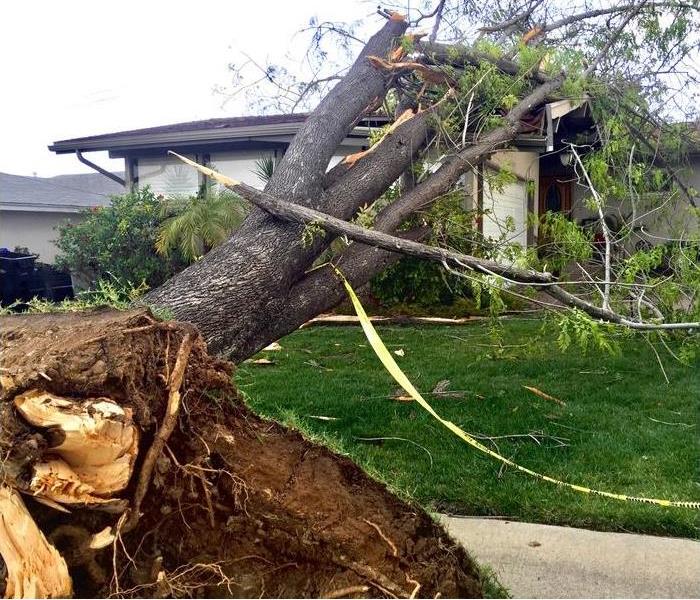 It is important to clean up after a storm, and SERVPRO of South and Northwest Grand Rapids can. help!
It is important to clean up after a storm, and SERVPRO of South and Northwest Grand Rapids can. help!
Key Takeaways
- Storm damage can cause health risks and long-term damage.
- Cleanup removes debris and hazards from the property.
- Sanitization eliminates harmful bacteria and viruses.
- Professional storm damage restoration services ensure a safe living environment.
When a storm hits, it can leave behind a path of destruction that can cause significant damage to homes and other properties. While most people are focused on the immediate aftermath of the storm, the importance of cleanup and sanitization can’t be overstated. In fact, it’s crucial to ensure that the property is thoroughly cleaned and sanitized after a storm event to avoid any potential health risks and long-term damage.
At SERVPRO of South and Northwest Grand Rapids, we understand the importance of storm damage cleanup and sanitization. That’s why we’ve put together this article to explain why it’s so important and how we can help you restore your property to its pre-storm condition.
The Lasting Effects of Storms
The aftermath of a storm can be devastating, both emotionally and physically. Not only can a storm damage your property, but it can also lead to health problems if not properly cleaned up. Storms can create conditions that are ideal for mold growth, which can lead to respiratory problems and other health issues. Standing water can create the perfect breeding ground for bacteria and viruses, which can cause serious illness.
The Importance of Cleanup
The first step in storm damage restoration is cleanup. When a storm strikes, it can leave behind debris, broken glass, and other hazards that can be dangerous if not removed quickly. SERVPRO of South and Northwest Grand Rapids has the experience and equipment necessary to safely and effectively remove debris from your property. Our team will also inspect your property for any hidden damage that may have been caused by the storm.
The Importance of Sanitization
In addition to cleanup, sanitization is also essential after a storm. Sanitization involves the use of specialized cleaning agents and equipment to eliminate any harmful bacteria and viruses that may be present. Our team of experts will thoroughly sanitize your property to ensure that it’s safe for you and your family to return.
How We Can Help
If you’ve experienced storm damage, it’s important to act quickly. At SERVPRO of South and Northwest Grand Rapids, we offer a wide range of storm damage restoration services to help you get your life back to normal as quickly as possible. Our team of professionals has the experience and expertise necessary to handle any storm damage restoration project, no matter how big or small.
Our services include:
- Emergency response 24/7
- Water extraction and drying
- Debris removal and cleanup
- Mold remediation
- Sanitization and disinfection
Final Thoughts
Storms can be incredibly powerful and destructive, but the aftermath of a storm can be just as dangerous if proper cleanup and sanitization aren’t carried out. At SERVPRO of South and Northwest Grand Rapids, we understand the importance of storm damage restoration and are committed to helping our clients get back on their feet after a storm event. Contact us today to learn more about our storm damage restoration services and how we can help you restore your property to its pre-storm condition.
Garage Fire Restoration in Grand Rapids
6/26/2023 (Permalink)
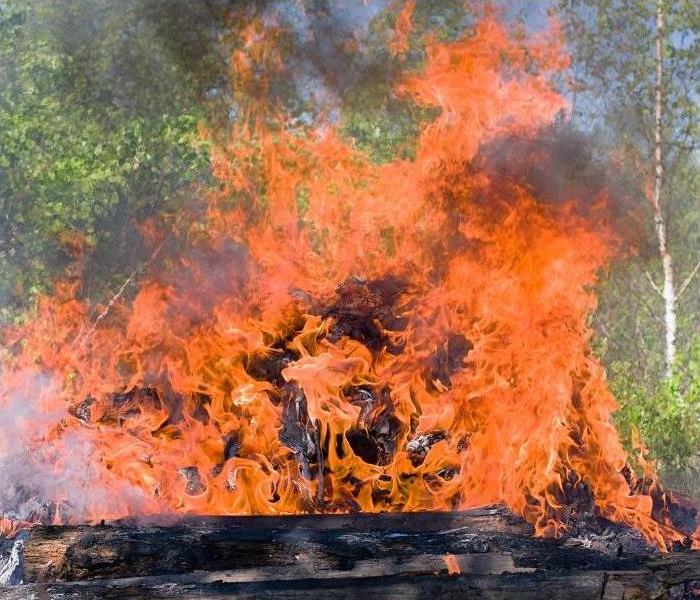 SERVPRO can help with garage fire restoration in Grand Rapids.
SERVPRO can help with garage fire restoration in Grand Rapids.
Key Takeaways
- Garage fires can cause extensive physical and emotional damage.
- Enlisting experts in fire damage restoration is crucial for recovery.
- The restoration process involves emergency contact, assessment, cleaning, and reconstruction.
- SERVPRO of South and Northwest Grand Rapids can help restore your garage after a fire.
If your property experiences a garage fire, it can cause physical damages to belongings, but also presents distressing consequences from the heavy financial toll upwards of thousands of dollars. Fortunately, there are strategies you can use to aid in recovery, beginning with enlisting experts who specialize in restoring properties after all types of fires. SERVPRO of South and Northwest Grand Rapids has the expertise and tools necessary to restore your garage after a fire, and get your property back to pre-fire condition.
The Effects of a Garage Fire
Garage fires can be particularly devastating because they often contain flammable materials, such as gasoline, propane, and other chemicals. When these materials ignite, they can quickly spread and cause extensive damage to the structure and contents of the garage. The high heat and flames from a garage fire can also cause damage to nearby structures, including your home.
In addition to physical damages, a garage fire can also cause emotional distress for homeowners. Losing belongings and sentimental items can be difficult to come to terms with. Fortunately, the process of garage fire damage restoration can help alleviate some of these emotional stressors.
Steps for Garage Fire Damage Restoration
The restoration process for a garage fire typically involves several steps:
1. Emergency Contact
The first step in garage fire damage restoration is to contact SERVPRO of South and Northwest Grand Rapids. We offer 24/7 emergency services and can quickly respond to your call. Our team will arrive on the scene and assess the damage, as well as provide an estimate for the restoration process.
2. Inspection and Assessment
Next, our team will thoroughly inspect the garage to assess the extent of the damage. This includes assessing both the structural and contents damage, as well as checking for any safety hazards. We will then create a plan for the restoration process, which may include cleaning, repairs, and replacement of damaged items.
3. Cleaning and Restoration
The cleaning and restoration process will involve removing any debris and damaged materials, as well as cleaning and disinfecting the garage. We may use specialized equipment to remove smoke and soot, as well as restore the structure and contents of the garage to pre-fire condition.
4. Reconstruction
Our team will also provide reconstruction services to restore the structure of the garage. This may include repairing walls, roofs, and flooring, as well as any necessary electrical or plumbing work.
5. Final Walk-Through
Finally, we will conduct a final walk-through with you to ensure that you are satisfied with the restoration process. We will also provide tips and recommendations for preventing future fires and maintaining the integrity of your garage.
Final Thoughts
Garage fires can be devastating, but with the help of SERVPRO of South and Northwest Grand Rapids, you can recover from the damages and get your property back to pre-fire condition. Our team of experts has the experience and tools necessary to handle all aspects of garage fire damage restoration, from inspection and assessment to cleaning and reconstruction. Contact us today to learn more about our services and how we can help you restore your property after a garage fire.
What Needs Replacing After Storm Damage?
6/19/2023 (Permalink)
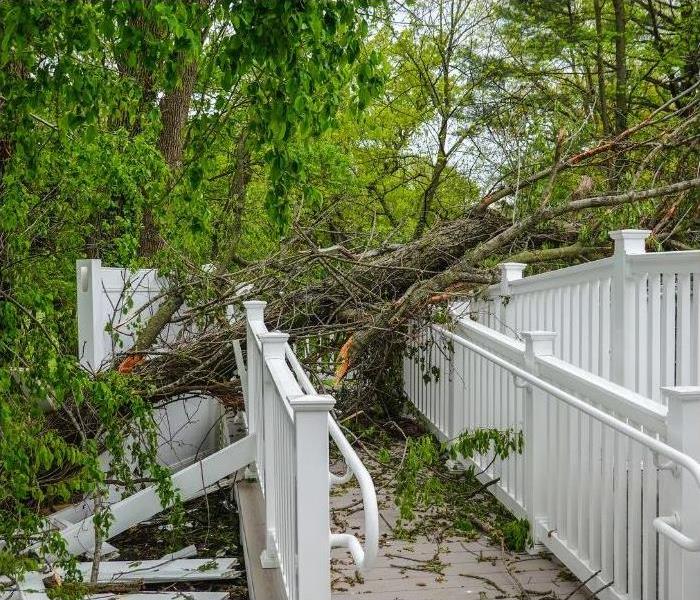 What needs replacing after storm damage? Allow SERVPRO to guide you through the process.
What needs replacing after storm damage? Allow SERVPRO to guide you through the process.
Key Takeaways
- Safety first, evacuate the area if necessary
- Salvageable items should be inspected before replacing
- Roof, water, and electrical damage are common issues
- Professional inspections and repairs are necessary for safety and restoration
Extreme weather can cause significant property damage, leaving homeowners and property managers scrambling to figure out what needs replacing after storm damage. Whether it’s heavy winds, torrential rains, or hail, these weather events can wreak havoc on your property and leave you with costly repairs. But fear not, with the help of SERVPRO of South and Northwest Grand Rapids, you can restore your property to its pre-storm condition and ensure that any necessary replacements are made quickly and efficiently.
First Steps After Storm Damage
The first step in any storm damage restoration process is to assess the damage and determine what needs replacing. When extreme weather occurs, it’s crucial to prioritize safety first. Assess the damage to your property and check for any hazards such as downed power lines or gas leaks. If there are any safety concerns, evacuate the area immediately and contact the appropriate authorities. Once the area is deemed safe, you can begin assessing the damage to your property.
What Can be Salvaged?
Not everything damaged by a storm will need to be replaced. Salvageable items should be inspected by professionals to ensure that they are safe and functional. For example, if a tree limb falls on your roof, you may need to replace the shingles but not the entire roof. SERVPRO of South and Northwest Grand Rapids will inspect all salvageable items and provide recommendations on whether they need to be replaced or repaired.
Roof Damage
Roof damage is one of the most common types of property damage caused by storms. High winds, hail, and falling debris can cause shingles to become dislodged or damaged, leaving your roof vulnerable to leaks and other issues. If you suspect that your roof has been damaged, it’s essential to have it inspected by professionals as soon as possible. Sometimes, a simple repair may be all that’s needed, but in severe cases, a full replacement may be necessary.
Water Damage
Water damage is another common issue that arises after storms. Heavy rains can cause flooding, leading to water damage to floors, walls, and furniture. When left untreated, water damage can lead to mold growth, which can cause health issues. It’s crucial to have water damage inspected by professionals to determine the extent of the damage and what needs replacing. Carpets, drywall, and furniture may need to be replaced if the damage is severe.
Electrical Damage
Storms can also cause electrical damage, leaving your property without power. If you suspect that your property has electrical damage, it’s crucial to have it inspected by professionals. Electrical damage can be dangerous, and attempting to fix it on your own can cause injury or death. SERVPRO of South and Northwest Grand Rapids has trained professionals who can safely inspect and repair any electrical damage to your property.
Final Thoughts
When extreme weather occurs, it can cause significant damage to your property. But with the help of SERVPRO of South and Northwest Grand Rapids, you can restore your property to its pre-storm condition. Understanding what needs replacing after storm damage is essential for making full repairs and restoring normalcy to your residence as quickly as possible. If you have experienced storm damage, contact us for assistance. Our professionals are available 24/7 to provide you with the help you need.
How Fast Is SERVPRO?
6/12/2023 (Permalink)
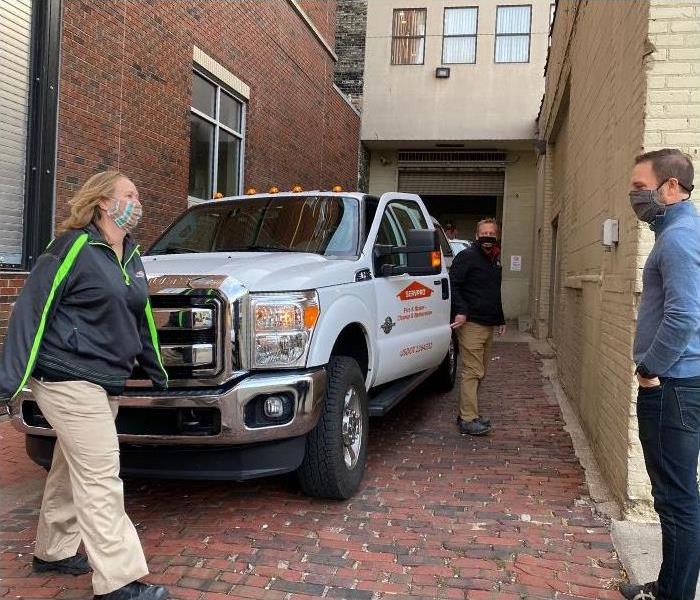 How fast is SERVPRO? We like to provide quality service fast to get your life back to normal.
How fast is SERVPRO? We like to provide quality service fast to get your life back to normal.
Key Takeaways:
- SERVPRO provides fast and efficient restoration services.
- Our experienced team prioritizes quick response times.
- Timely action can save money and prevent further damage.
- We use state-of-the-art equipment to expedite the restoration process.
Why Should SERVPRO Be Your First Call?
When it comes to damage restoration work, time is of the essence. Whether you’re a homeowner or a property manager, the longer your property is left in a state of disrepair, the greater the risk of further damage occurring. That’s why it’s so important to choose a professional restoration service that can respond quickly to your needs and get to work right away. At SERVPRO of South and Northwest Grand Rapids, we understand the importance of rapid response times and are proud to offer some of the fastest restoration services in the industry.
Fast Response Times
One of the biggest advantages of working with SERVPRO of South and Northwest Grand Rapids is our rapid response times. We understand disasters don’t wait for regular business hours to occur, which is why we offer 24/7 emergency services. No matter when disaster strikes, we will be there to help you get back on your feet. Our team is always on standby, ready to respond to your call at any time of the day or night.
Speedy Restoration Services
In addition to our fast response times, we’re also committed to providing speedy restoration services that minimize the disruption to your life. Our experienced technicians have the tools, training, and expertise to get the job done right the first time, ensuring that your property is restored to its preloss condition as quickly as possible. We understand that time is of the essence, and we’ll work quickly to get your property back to normal as soon as possible.
Professional Restoration Experience
At SERVPRO of South and Northwest Grand Rapids, we have decades of experience providing professional restoration services to homeowners and property managers in the Grand Rapids area. We understand the unique challenges that come with restoring properties after disasters, and we have the skills and knowledge necessary to handle even the most complex restoration projects with ease. When you work with us you’re getting the benefit of our extensive experience and expertise.
Latest Equipment
Another key factor in our ability to provide fast and effective restoration services is our state-of-the-art equipment. We use the latest technology and tools to ensure that we’re able to work quickly and efficiently, without sacrificing the quality of our work. From powerful air movers and dehumidifiers to advanced moisture detection tools, we have everything we need to restore your property to its preloss condition as quickly as possible.
Final Thoughts
When it comes to damage restoration work, time is of the essence. That’s why it’s so important to choose a restoration service that can respond quickly to your needs and provide fast, effective, and professional restoration services. At SERVPRO of South and Northwest Grand Rapids, we’re proud to offer some of the fastest restoration services in the industry, backed by decades of experience, latest equipment, and a commitment to excellence. So why wait? If you need fast, reliable restoration services, call us today.
Did You Find Mold In Your Commercial Building?
6/7/2023 (Permalink)
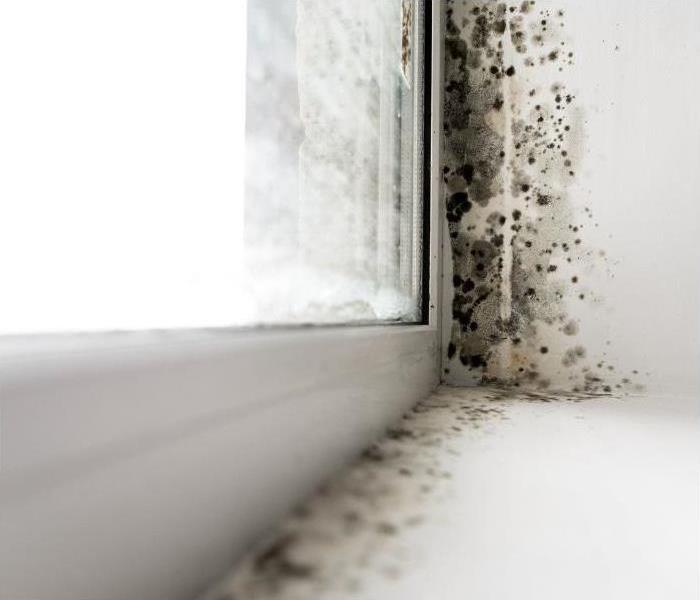 Did You Find Mold In Your Commercial Building? We can help! Call us today for an assement.
Did You Find Mold In Your Commercial Building? We can help! Call us today for an assement.
It's important to be aware that any presence of mold in a business can be extremely harmful to employees and customers. Molds produce allergens, mycotoxins, and other toxins that can cause serious health problems.
If you think you've found mold in your business, it's important to have it professionally removed as soon as possible. Do not try to remove the mold yourself - it's important to have a professional who knows how to properly remove the mold and clean up the area so there is no risk of exposure.
What are the signs of Mold?
The most telling sign of mold is the presence of visible mold growth. However, there are other signs that can indicate the presence of mold in a building, such as:
- A musty odor
- Water stains or water damage
- Peeling or bubbling paint
- Cracked or warped ceilings or floors
- Condensation on windows or walls
- Increase in asthma symptoms or other respiratory problems
How Does Mold Affect Your Staff?
As we stated, mold can cause a variety of adverse health effects, the most serious of which is an allergic reaction. People with mold allergies can have severe respiratory problems, including asthma attacks.
People with compromised immune systems are also at risk for infection from mold exposure. And finally, mold can produce harmful toxins that can cause serious health problems. These toxins are known as mycotoxins, and they can cause a wide range of symptoms, including respiratory problems, headaches, skin irritation, and damage to the liver or kidneys.
So it's important to keep your office clean and free of any mold growth. And if you do spot any signs of mold, don't touch it!
How Do You Test For Mold?
If you're a business owner and suspect that you may have a mold problem, it's best to call in the professionals. Mold can cause serious health problems, so it's important to identify and address any issues as quickly as possible.
SERVPRO is one of the leading providers of mold remediation services. They have extensive experience in identifying and removing mold from businesses of all sizes. They'll work with you to develop a plan tailored to your specific needs and will ensure that the problem is resolved quickly and safely.
Why Hire SERVPRO to Get Rid of Mold?
SERVPRO has been removing mold and restoring properties affected by mold for years. We have the experience and knowledge to do the job right, and we'll work tirelessly until your property is back to its original state.
Mold can be a serious health hazard, so it's important to hire a qualified professional to remove it from your property. Not only will SERVPRO get rid of all the mold, but we'll also treat the area to prevent future growth. Give us a call today and let us take care of everything for you.
We’re Built Upon a Legacy of Great Service
6/7/2023 (Permalink)
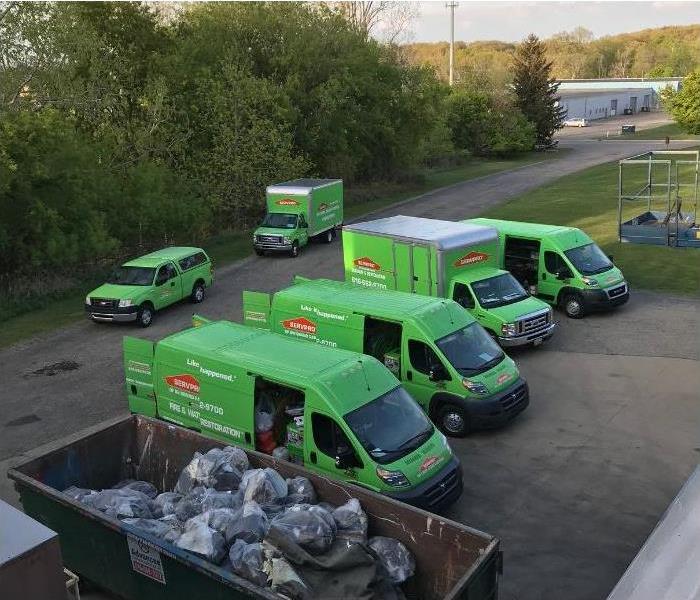 We’re built upon a legacy of great service and want to serve you well.
We’re built upon a legacy of great service and want to serve you well.
Key Takeaways:
- SERVPRO is a reliable provider of property management solutions.
- We prioritize excellent customer service and satisfaction.
- Our extensive experience sets us apart from other providers.
- We offer a range of services to meet every property management need.
Why Should You Use SERVPRO of South and Northwest Grand Rapids?
When you’re dealing with a property disaster or damage, finding a reliable and trustworthy restoration provider can be a daunting task. As a homeowner or property manager, you need to make sure that the restoration provider you choose has the experience and expertise necessary to ensure a thorough and efficient cleanup.
At SERVPRO of South and Northwest Grand Rapids, we understand this all too well. That’s why we’ve built our reputation on a legacy of great service that spans over 50 years.
Decades of Experience
With over 50 years of experience in the industry, we’ve seen it all. We know what works and what doesn’t when it comes to property damage restoration, and we’ve developed a suite of solutions that address even the most complex of issues. Our experienced technicians are certified by the Institute of Inspection, Cleaning and Restoration Certification (IICRC) and are equipped with the skills and knowledge necessary to provide a high-quality restoration service.
Comprehensive Restoration Services
At SERVPRO of South and Northwest Grand Rapids, we offer a full range of restoration services to meet your needs. From fire and smoke damage restoration to water damage restoration, mold remediation, and biohazard cleanup, we’ve got you covered. Our team of experts uses specialized equipment and advanced techniques to ensure that your property is restored back to pre-damage condition quickly and efficiently.
24/7 Emergency Response
Property damage emergencies can happen, day or night. That’s why we offer 24/7 emergency response services. When you call us we’ll be there to help you get your life back on track as quickly as possible. Our team of professionals is always on standby, ready to respond to your call for help.
Commitment to Customer Satisfaction
At SERVPRO of South and Northwest Grand Rapids, we understand that our success depends on our ability to provide exceptional customer service. That’s why we always go above and beyond to ensure that our clients are completely satisfied with the services we provide. We work closely with property managers and homeowners to develop customized restoration plans that are tailored to their specific needs.
Final Thoughts
At SERVPRO of South and Northwest Grand Rapids, we take great pride in the legacy of great service we’ve built over the years. We’re committed to continuing this legacy by providing our clients with the best possible property management solutions and damage restoration services. If you need our services, contact us. We’re here to help you get your life back on track quickly and efficiently.
Why Should I Call SERVPRO First?
5/24/2023 (Permalink)
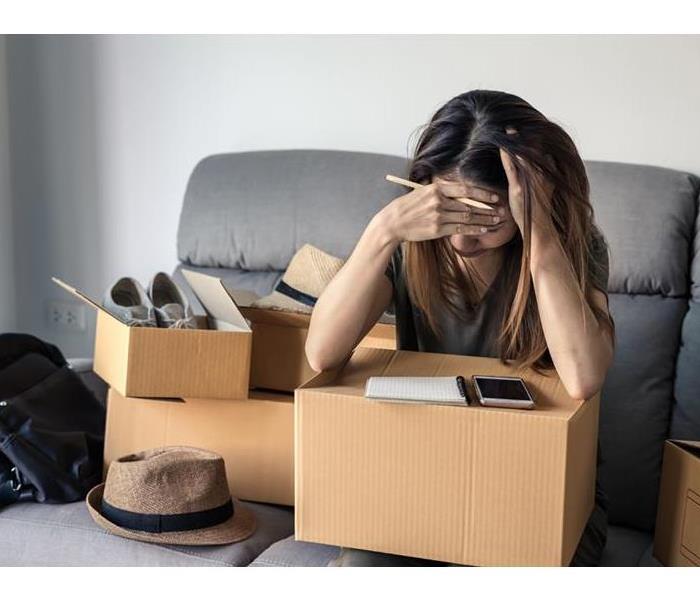 Contacting SERVPRO of South and Northwest Grand Rapids first can reduce property damage and headaches.
Contacting SERVPRO of South and Northwest Grand Rapids first can reduce property damage and headaches.
Key Takeaways:
- Contacting SERVPRO of South and Northwest Grand Rapids first can reduce property damage.
- SERVPRO provides prompt emergency response, 24/7.
- Professional restoration services are offered by certified technicians.
- SERVPRO uses advanced technology and specialized equipment to ensure thorough cleaning.
As a homeowner or property manager, dealing with unexpected disasters can be a challenging and stressful experience. In the aftermath of a disaster, it’s critical to act quickly and contact a reliable and professional restoration company to help minimize damage and start the recovery process as soon as possible. SERVPRO of South and Northwest Grand Rapids is here to help, providing expert disaster recovery and restoration services to residential and commercial customers. Here are some reasons why you should consider calling SERVPRO first in the event of a disaster.
Quick Response Time
In the event of a disaster, time is of the essence. The longer you wait, the more extensive the damage can become, and the more costly it can be to repair. SERVPRO of South and Northwest Grand Rapids is available 24/7 to provide emergency services and ensure a quick response time. Our team of trained professionals will be on the scene promptly, ready to assess the situation and start the restoration process.
Experience and Expertise
SERVPRO of South and Northwest Grand Rapids has years of experience in disaster recovery and restoration, making us experts in the field. Our team of professionals has the knowledge and expertise needed to handle any type of disaster, including water damage, fire damage, mold remediation, and more. Our extensive training programs ensure our technicians are up-to-date on the latest restoration techniques and technology, allowing us to provide the best possible service to our customers.
Advanced Equipment and Techniques
At SERVPRO of South and Northwest Grand Rapids, we use the latest equipment and techniques to provide efficient and effective disaster recovery and restoration services. Our specialized equipment allows us to quickly remove water, dry out structures, and detect hidden moisture, preventing secondary damage from occurring. We use advanced techniques to clean and deodorize affected areas, ensuring a thorough and complete restoration.
Comprehensive Services
SERVPRO of South and Northwest Grand Rapids provides a wide range of disaster recovery and restoration services, including water damage restoration, fire damage restoration, mold remediation, and more. Our comprehensive services ensure we can handle any type of disaster, no matter how big or small. We work closely with our customers to develop a customized restoration plan, ensuring that their needs are met and their property is restored to pre-disaster condition.
Final Thoughts
If you’re dealing with a property disaster, it’s important to know the steps for handling disaster recovery and repairs. SERVPRO of South and Northwest Grand Rapids should be your first call, as we offer quick responses, experience and expertise, advanced equipment and techniques, and comprehensive services. With our help, you can minimize damage and start the recovery process as soon as possible, getting back to normal life quickly and efficiently. Contact us today to learn more about our services and how we can help you in the event of a disaster.
Garage Fire Restoration in Grand Rapids
5/24/2023 (Permalink)
 One spark landing on the wrong thing could cause a garage fire.
One spark landing on the wrong thing could cause a garage fire.
Key Takeaways
- Garage fires can cause extensive physical and emotional damage.
- Enlisting experts in fire damage restoration is crucial for recovery.
- The restoration process involves emergency contact, assessment, cleaning, and reconstruction.
- SERVPRO of South and Northwest Grand Rapids can help restore your garage after a fire.
If your property experiences a garage fire, it can cause physical damages to belongings, but also presents distressing consequences from the heavy financial toll upwards of thousands of dollars. Fortunately, there are strategies you can use to aid in recovery, beginning with enlisting experts who specialize in restoring properties after all types of fires. SERVPRO of South and Northwest Grand Rapids has the expertise and tools necessary to restore your garage after a fire, and get your property back to pre-fire condition.
The Effects of a Garage Fire
Garage fires can be particularly devastating because they often contain flammable materials, such as gasoline, propane, and other chemicals. When these materials ignite, they can quickly spread and cause extensive damage to the structure and contents of the garage. The high heat and flames from a garage fire can also cause damage to nearby structures, including your home.
In addition to physical damages, a garage fire can also cause emotional distress for homeowners. Losing belongings and sentimental items can be difficult to come to terms with. Fortunately, the process of garage fire damage restoration can help alleviate some of these emotional stressors.
Steps for Garage Fire Damage Restoration
The restoration process for a garage fire typically involves several steps:
1. Emergency Contact
The first step in garage fire damage restoration is to contact SERVPRO of South and Northwest Grand Rapids. We offer 24/7 emergency services and can quickly respond to your call. Our team will arrive on the scene and assess the damage, as well as provide an estimate for the restoration process.
2. Inspection and Assessment
Next, our team will thoroughly inspect the garage to assess the extent of the damage. This includes assessing both the structural and contents damage, as well as checking for any safety hazards. We will then create a plan for the restoration process, which may include cleaning, repairs, and replacement of damaged items.
3. Cleaning and Restoration
The cleaning and restoration process will involve removing any debris and damaged materials, as well as cleaning and disinfecting the garage. We may use specialized equipment to remove smoke and soot, as well as restore the structure and contents of the garage to pre-fire condition.
4. Reconstruction
Our team will also provide reconstruction services to restore the structure of the garage. This may include repairing walls, roofs, and flooring, as well as any necessary electrical or plumbing work.
5. Final Walk-Through
Finally, we will conduct a final walk-through with you to ensure that you are satisfied with the restoration process. We will also provide tips and recommendations for preventing future fires and maintaining the integrity of your garage.
Why Call SERVPRO?
Garage fires can be devastating, but with the help of SERVPRO of South and Northwest Grand Rapids, you can recover from the damages and get your property back to pre-fire condition. Our team of experts has the experience and tools necessary to handle all aspects of garage fire damage restoration, from inspection and assessment to cleaning and reconstruction. Contact us today to learn more about our services and how we can help you restore your property after a garage fire.
3 Damage Myths You Can’t Ignore After a Storm
5/24/2023 (Permalink)
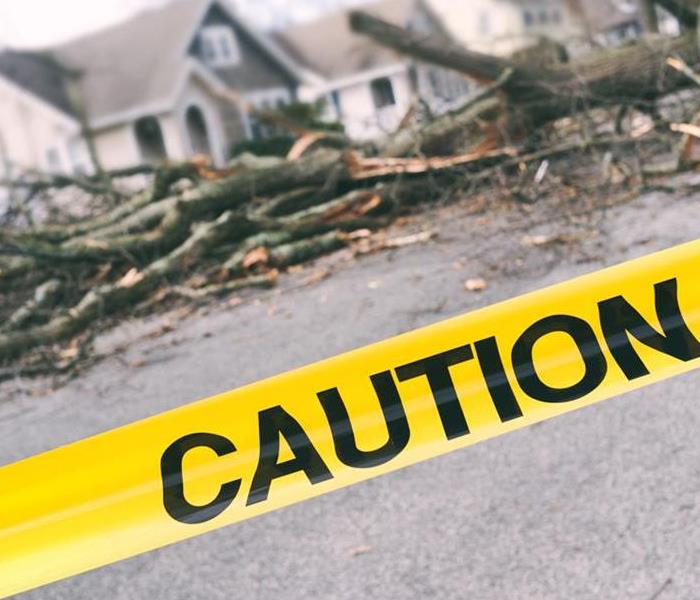 Storm damage is never expected, it's a good idea to make sure you're covered where possible.
Storm damage is never expected, it's a good idea to make sure you're covered where possible.
Key Takeaways:
- Don’t believe the myth that all storm damage is visible
- Beware of contractors offering “too good to be true” deals
- Understand the importance of proper storm damage assessment
- Work with a reputable restoration company for quality repairs
When a storm hits, it can leave behind a trail of destruction. From fallen trees to damaged roofs, it’s important to act quickly to mitigate further damage and begin the restoration process. However, it’s also important to separate fact from fiction when it comes to storm damage. Here are three common myths about storm damage you shouldn’t ignore.
Myth #1: If There’s No Visible Damage, There’s No Damage at All
Just because there’s no visible damage to your property doesn’t mean that there’s no damage at all. Many types of damage may not be immediately visible, but can cause long-term problems if left unchecked. For example, water damage from a leaky roof can lead to mold growth and compromise the structural integrity of your home. It’s important to have a professional inspection to ensure that your property is truly in good condition.
Myth #2: DIY Repairs Are Just as Effective as Professional Repairs
It may be tempting to save money by attempting to make repairs yourself, but DIY repairs can often lead to more problems down the line. Without the proper training and equipment, you may not identify all the damage that needs to be addressed, leading to incomplete repairs that leave your property vulnerable to future damage. Professional restoration companies like SERVPRO of South and Northwest Grand Rapids have the expertise and experience to properly assess and address storm damage.
Myth #3: Coverage for Storm Damage
While it's true that there are financial options available for the restoration of storm damage, it's important to note that not all forms of damage are included. For instance, if the damage is a result of insufficient maintenance or neglect, the costs of repairs may not be covered. To ensure clarity on what is covered, it is essential to carefully review your policy and consult with professionals in the field.
Are you ready?
When it comes to storm damage restoration, it’s important to separate fact from fiction. Myths about damage can lead to improper repairs, additional damage, and unnecessary expenses. By understanding the truth about storm damage, you can make informed decisions about the restoration process and ensure that your property is fully restored to its pre-storm condition.
At SERVPRO of South and Northwest Grand Rapids, we understand the challenges of storm damage restoration. That’s why we offer comprehensive restoration services to help you get your property back to its pre-storm condition quickly and efficiently. Contact us today to learn more about our services.
Why is SERVPRO of South and Northwest Grand Rapids so Trustworthy?
5/15/2023 (Permalink)
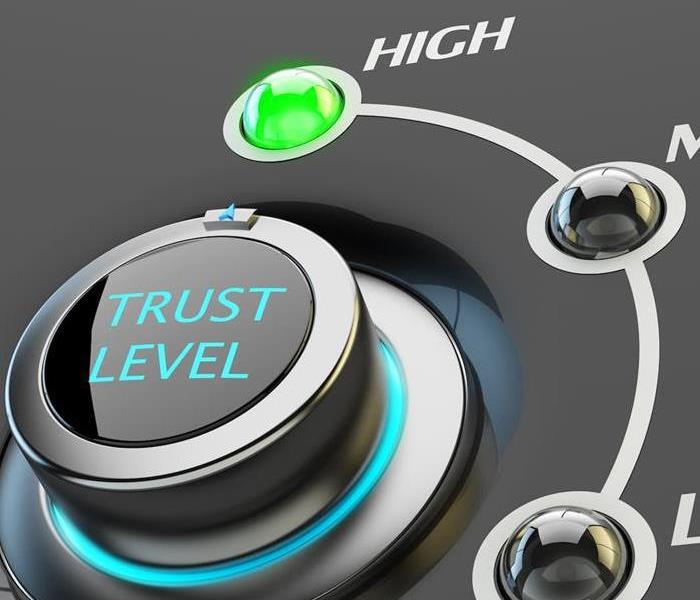 Whether it's your home or office, when you call SERVPRO, you know the experts are here to help.
Whether it's your home or office, when you call SERVPRO, you know the experts are here to help.
Key Takeaways:
- SERVPRO of South and Northwest Grand Rapids has a reputation for dependability
- We provide 24/7 emergency services for property disasters
- Our trained professionals use specialized equipment and techniques
- SERVPRO offers a range of services, including water damage restoration and mold remediation
When you’re dealing with a property emergency, like water damage, fire damage, or even mold containment and remediation issues, it is crucial that you have a reliable partner to help ensure the best outcome. SERVPRO of South and Northwest Grand Rapids has earned the trust of the community over time by consistently delivering dependable support in difficult times when they need it most!
But what makes SERVPRO so trustworthy? In this article, we’ll explore the reasons why our customers trust us to handle their property emergencies with care and expertise.
Expertise and Experience
SERVPRO of South and Northwest Grand Rapids has been serving the community for many years. Our team of experts has extensive experience in the restoration industry and is trained to handle any size restoration project. We understand the importance of acting quickly to minimize damage and get your home or business back to pre-damage condition as soon as possible.
Our team of experts is trained in the latest restoration techniques and uses state-of-the-art equipment to ensure a thorough cleanup. We also understand the stress and uncertainty that comes with a disaster. That’s why we work closely with our customers to provide guidance and support throughout the restoration process.
Quick Response Time
When a property emergency occurs, time is of the essence. That’s why SERVPRO of South and Northwest Grand Rapids offers a quick response time to all of our customers. We understand that every minute counts, and we’re committed to responding to your emergency within a few hours of your call.
Our team of experts is available 24/7 to provide assistance when you need it most. We’ll work quickly to assess the damage and develop a restoration plan that meets your specific needs. Our goal is to minimize the damage and get your home or business back to pre-damage condition as soon as possible.
Customer Satisfaction Guarantee
At SERVPRO of South and Northwest Grand Rapids, we’re committed to customer satisfaction. We understand that dealing with a property emergency can be stressful and overwhelming. That’s why we work closely with our customers to provide guidance and support throughout the restoration process.
We guarantee our work and are committed to ensuring our customers are satisfied with the results. Our guarantee ensures that if you’re not satisfied with the results, we’ll come back and make it right.
Community Involvement
SERVPRO of South and Northwest Grand Rapids is committed to giving back to the community. We understand the importance of supporting local organizations and initiatives that make a difference in the lives of those around us.
Final Thoughts
When you’re dealing with a property emergency, it’s important to have a partner you can trust. SERVPRO of South and Northwest Grand Rapids has earned the trust of the community by consistently delivering dependable support in difficult times.
Our expertise and experience, quick response time, customer satisfaction guarantee, and community involvement are just a few of the reasons why our customers trust us to handle their property emergencies with care and expertise. If you need restoration services, contact SERVPRO of South and Northwest Grand Rapids today to learn more about how we can help you.
Your Business Deserves More than DIY Damage Restoration Kits
5/8/2023 (Permalink)
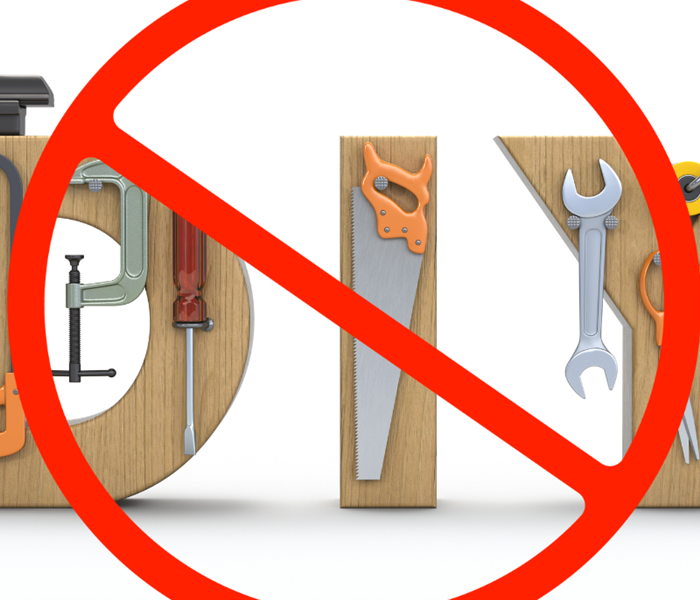 You may be handy with tools, but are they the right tools for the job?
You may be handy with tools, but are they the right tools for the job?
Key Takeaways
- DIY restoration kits can be dangerous and costly
- Professional restoration offers expertise and comprehensive services
- Quick response time and insurance support provided by professionals
- Long-term security and insurance against future damage offered by professionals
What Are DIY Restoration Kits?
Storms, pests, water leakage, and fire accidents can quickly threaten your bottom line if left unchecked. Swift restoration is vital to preserve the physical structure and underlying investments. While DIY damage restoration kits may seem like a budget-friendly solution at first glance, they ultimately don’t offer any long-term security or insurance against further damages down the road. Investing in professional help pays off–you get secure results that last and peace of mind knowing that you have taken every step to protect both human lives and financial resources.
At SERVPRO of South and Northwest Grand Rapids, we understand that a disaster can happen at any moment, causing damage and disrupting your business operations. That is why we offer professional damage restoration services that are tailored to meet your specific needs. Our team of experts is trained to handle all types of disasters, no matter how big or small they may be.
The Dangers of DIY Restoration Kits
DIY damage restoration kits may seem like a cost-effective solution to save money, but they can actually be quite dangerous. Damage from storms, pests, water leakage, and fire accidents can lead to significant health hazards if not handled correctly. For example, mold growth is a common issue after water damage, and if not remediated correctly, it can cause serious respiratory problems.
Many DIY restoration kits don’t provide adequate safety gear, which can lead to serious injuries. For example, using bleach without proper ventilation or safety gear can cause respiratory issues and skin irritation.
Why Choose Professional Damage Restoration Services
Investing in professional damage restoration services offers many benefits that DIY restoration kits cannot match. Here are some advantages of working with a professional restoration company like SERVPRO of South and Northwest Grand Rapids:
Expertise
Our team of experts has the necessary skills and experience to handle all types of disasters, no matter how big or small they may be. We use state-of-the-art equipment and techniques to restore your property quickly and efficiently, minimizing downtime and reducing the overall cost of the restoration process.
Comprehensive Services
We offer a wide range of restoration services, including water damage restoration, fire damage restoration, mold remediation, storm damage restoration, and more. Our comprehensive services mean you don’t need to waste time and resources finding a different company for each type of restoration work you need.
Quick Response Time
At SERVPRO of South and Northwest Grand Rapids, we understand that time is of the essence when it comes to damage restoration. That is why we offer 24/7 emergency services and a rapid response time, so we can start the restoration process as soon as possible, minimizing the damage and reducing the overall cost of the restoration process.
Insurance Support
Dealing with insurance companies can be stressful, especially when trying to navigate the claims process on your own. At SERVPRO of South and Northwest Grand Rapids, we work with insurance companies to ensure that the claims process is as smooth and stress-free as possible. We also provide comprehensive documentation and photos of the restoration process, which can help with insurance claims.
Long-term Security
Investing in professional damage restoration services provides long-term security and insurance against further damages down the road. Our team of experts uses state-of-the-art equipment and techniques to ensure that the restoration process is thorough and complete, minimizing the risk of future damage and ensuring that your property is restored to its pre-damage condition.
Final Thoughts
When it comes to damage restoration, investing in professional help is always the best choice. At SERVPRO of South and Northwest Grand Rapids, we offer comprehensive and tailored restoration services that meet your specific needs.
Garage Fire Restoration in Grand Rapids
5/7/2023 (Permalink)
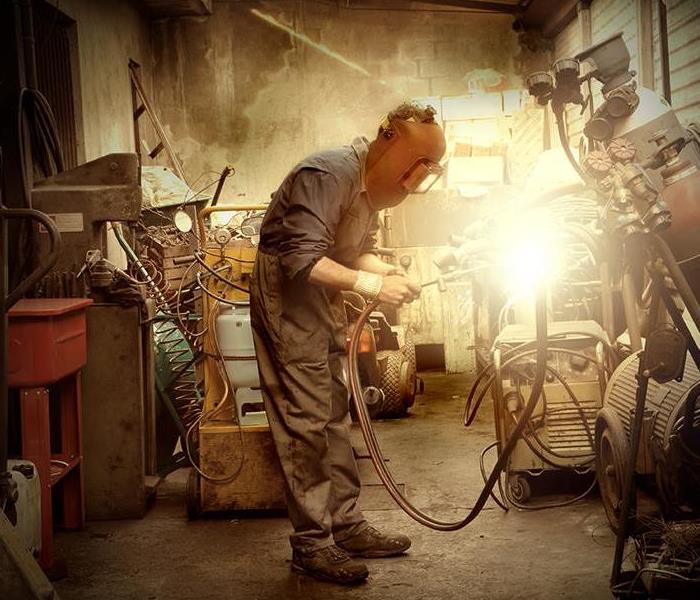 One never knows what may catch their garage on fire, but when it does, SERVPRO of South and Northwest Grand Rapids can help.
One never knows what may catch their garage on fire, but when it does, SERVPRO of South and Northwest Grand Rapids can help.
Key Takeaways
- Garage fires can cause extensive physical and emotional damage.
- Enlisting experts in fire damage restoration is crucial for recovery.
- The restoration process involves emergency contact, assessment, cleaning, and reconstruction.
- SERVPRO of South and Northwest Grand Rapids can help restore your garage after a fire.
If your property experiences a garage fire, it can cause physical damages to belongings, but also presents distressing consequences from the heavy financial toll upwards of thousands of dollars. Fortunately, there are strategies you can use to aid in recovery, beginning with enlisting experts who specialize in restoring properties after all types of fires. SERVPRO of South and Northwest Grand Rapids has the expertise and tools necessary to restore your garage after a fire, and get your property back to pre-fire condition.
The Effects of a Garage Fire
Garage fires can be particularly devastating because they often contain flammable materials, such as gasoline, propane, and other chemicals. When these materials ignite, they can quickly spread and cause extensive damage to the structure and contents of the garage. The high heat and flames from a garage fire can also cause damage to nearby structures, including your home.
In addition to physical damages, a garage fire can also cause emotional distress for homeowners. Losing belongings and sentimental items can be difficult to come to terms with. Fortunately, the process of garage fire damage restoration can help alleviate some of these emotional stressors.
Steps for Garage Fire Damage Restoration
The restoration process for a garage fire typically involves several steps:
1. Emergency Contact
The first step in garage fire damage restoration is to contact SERVPRO of South and Northwest Grand Rapids. We offer 24/7 emergency services and can quickly respond to your call. Our team will arrive on the scene and assess the damage, as well as provide an estimate for the restoration process.
2. Inspection and Assessment
Next, our team will thoroughly inspect the garage to assess the extent of the damage. This includes assessing both the structural and contents damage, as well as checking for any safety hazards. We will then create a plan for the restoration process, which may include cleaning, repairs, and replacement of damaged items.
3. Cleaning and Restoration
The cleaning and restoration process will involve removing any debris and damaged materials, as well as cleaning and disinfecting the garage. We may use specialized equipment to remove smoke and soot, as well as restore the structure and contents of the garage to pre-fire condition.
4. Reconstruction
Our team will also provide reconstruction services to restore the structure of the garage. This may include repairing walls, roofs, and flooring, as well as any necessary electrical or plumbing work.
5. Final Walk-Through
Finally, we will conduct a final walk-through with you to ensure that you are satisfied with the restoration process. We will also provide tips and recommendations for preventing future fires and maintaining the integrity of your garage.
Final Thoughts
Garage fires can be devastating, but with the help of SERVPRO of South and Northwest Grand Rapids, you can recover from the damages and get your property back to pre-fire condition. Our team of experts has the experience and tools necessary to handle all aspects of garage fire damage restoration, from inspection and assessment to cleaning and reconstruction. Contact us today to learn more about our services and how we can help you restore your property after a garage fire.
Does SERVPRO Guarantee Their Work?
5/2/2023 (Permalink)
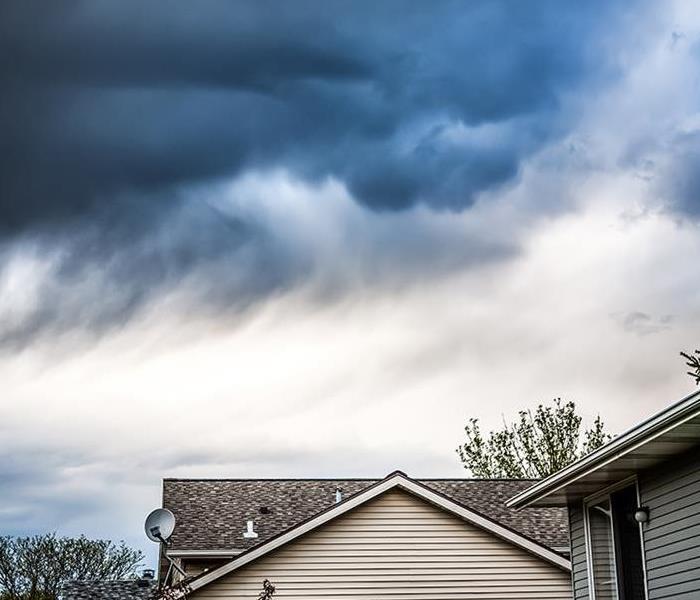 SERVPRO of South and Northwest Grand Rapids offers professional restoration services.
SERVPRO of South and Northwest Grand Rapids offers professional restoration services.
Key Takeaways
- SERVPRO of South and Northwest Grand Rapids offers professional restoration services.
- Our team of experts uses specialized equipment and advanced techniques.
- We guarantee our work and are committed to customer satisfaction.
- We have extensive experience in the restoration industry.
If you’ve experienced a disaster in your home or business, you know how stressful and overwhelming it can be. From the initial shock to the cleanup process, it’s important to have a team of professionals on your side to guide you through the restoration process.
That’s where SERVPRO of South and Northwest Grand Rapids comes in. We offer professional restoration services for commercial and residential properties that guarantee a thorough cleanup. Our dedicated team of experts uses specialized equipment and advanced techniques to make sure your home or business is restored back to pre-damage condition.
But does SERVPRO guarantee their work? The answer is yes. We stand behind our work and are committed to ensuring our customers are satisfied with the results.
Our Guarantee
At SERVPRO of South and Northwest Grand Rapids, we take pride in the quality of our work. That’s why we offer a guarantee on all of our restoration services. Our guarantee ensures that if you’re not satisfied with the results, we’ll come back and make it right.
We understand that each restoration project is unique and requires a customized approach. That’s why we work closely with our customers to develop a restoration plan that meets their specific needs. Our team of experts is committed to delivering exceptional results and providing the highest level of customer service.
Specialized Equipment and Advanced Techniques
At SERVPRO of South and Northwest Grand Rapids, we use specialized equipment and advanced techniques to ensure the best possible outcome for our customers. Our team of experts is trained in the latest restoration techniques and uses state-of-the-art equipment to ensure a thorough cleanup.
We use moisture detection equipment to identify areas of water damage that may not be visible to the naked eye. We also use specialized drying equipment to remove moisture from walls, floors, and ceilings to prevent further damage and mold growth.
Experience and Expertise
SERVPRO of South and Northwest Grand Rapids has been serving the community for many years. Our team of experts has extensive experience in the restoration industry and is trained to handle any size restoration project. We understand the importance of acting quickly to minimize damage and get your home or business back to pre-damage condition as soon as possible.
We also understand the stress and uncertainty that comes with a disaster. That’s why we work closely with our customers to provide guidance and support throughout the restoration process. Our team of experts is always available to answer any questions or concerns you may have.
Final Thoughts
If you need professional restoration services for your home or business, SERVPRO of South and Northwest Grand Rapids is here to help. We offer a guarantee on all of our restoration services and use specialized equipment and advanced techniques to ensure the best possible outcome for our customers.
Our team of experts has extensive experience in the restoration industry and is committed to providing the highest level of customer service. We understand the stress and uncertainty that comes with a disaster, and we’re here to guide you through the restoration process.
Don’t let a disaster take control of your life. Contact SERVPRO of South and Northwest Grand Rapids today to learn more about our professional restoration services and how we can help you get your life back to normal.
Why Ceiling Stains Are Signs of Water Damage
5/1/2023 (Permalink)
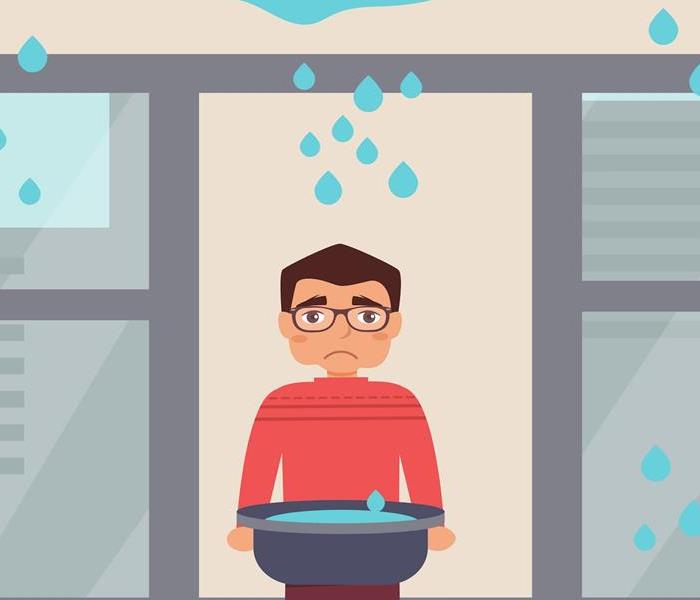 Don't wait until it's too late to investigate a ceiling stain.
Don't wait until it's too late to investigate a ceiling stain.
Key Takeaways:
- Ceiling stains are often a sign of water damage and should be addressed promptly.
- Water damage can lead to structural problems and health risks if left untreated.
- It’s important to identify the source of the water damage to prevent further harm.
- SERVPRO of South and Northwest Grand Rapids offers comprehensive water damage restoration services.
Ceiling stains are a common sight in many homes and buildings, but few people know they can indicate serious water damage. Often, property managers and homeowners ignore ceiling stains, thinking they are nothing more than an aesthetic issue. However, if left unaddressed, ceiling stains can lead to more significant and costly problems. In this article, we explore what causes ceiling stains and why they are signs of water damage.
What Are Ceiling Stains?
Ceiling stains are discolored patches that appear on the ceiling. They often have a yellowish-brown color, but they can also be gray or green. Ceiling stains can take on different shapes, ranging from small circles to large blotches that cover a significant part of the ceiling.
Ceiling stains are typically caused by water damage, but the severity of the damage can vary. Sometimes, ceiling stains are merely cosmetic blemishes, while in others, they can indicate a serious problem that requires immediate attention.
What Causes Ceiling Stains?
There are several potential causes of ceiling stains, including:
Roof Leaks
If your home or building has a roof leak, it can lead to water penetrating through the ceiling and causing stains. Roof leaks can be caused by many factors, including missing shingles, cracked flashing, or clogged gutters.
Plumbing Leaks
Plumbing leaks are another common cause of ceiling stains. If there is a water leak in a pipe that runs through the ceiling, it can cause water to seep through and leave stains. Plumbing leaks can be caused by corroded pipes, loose connections, or clogs.
Condensation
Condensation occurs when warm air meets a cold surface, such as a ceiling. When this happens, moisture can accumulate on the surface and cause stains. Condensation is more common in humid climates or in rooms with poor ventilation.
HVAC Issues
If your HVAC system is not working correctly, it can cause moisture to accumulate on the ceiling and create stains. HVAC issues can include faulty insulation, clogged air filters, or malfunctioning equipment.
Why Are Ceiling Stains Signs of Water Damage?
Ceiling stains are signs of water damage because they indicate that water has penetrated through the ceiling and made its way into the structure of the building. Water damage can be dangerous and costly to repair if left unaddressed. Here are some risks of water damage:
Structural Damage
Water damage can weaken the structural integrity of a building. Over time, water can cause wood to rot and metal to corrode, which can compromise the safety of the building. If water damage is severe, it can even cause the ceiling to collapse.
Mold Growth
Water damage can create a moist environment that is ideal for mold growth. Mold can cause health problems for occupants of the building, including respiratory issues and allergic reactions. Mold can also be challenging and costly to remove once it has taken hold.
Increased Repair Costs
If water damage is left unaddressed, it can lead to more extensive and expensive repairs down the line. Water damage can spread throughout a building, causing damage to walls, floors, and other areas.
What Should You Do If You Suspect Water Damage?
If you notice ceiling stains or suspect that you have water damage in your home or building, it is essential to take action right away.
Water damage can be difficult to assess and repair without the help of a professional restoration company like SERVPRO of South and Northwest Grand Rapids. It is essential to address ceiling stains immediately to prevent further damage and minimize the risk of health hazards.
Final Thoughts
Ceiling stains can indicate water damage, and it is crucial to address the issue promptly to prevent further damage and health hazards. Property managers and homeowners should contact a qualified water damage restoration company, such as SERVPRO of South and Northwest Grand Rapids, for prompt and professional assistance in addressing water damage.
The Importance of Air Quality Testing in Mold Remediation
4/30/2023 (Permalink)
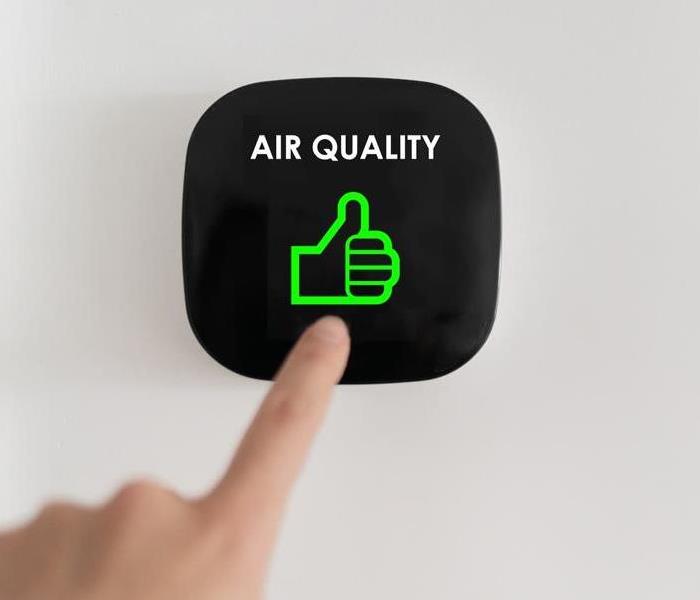 In order to improve your air quality, a mold remediation team is essential after damage.
In order to improve your air quality, a mold remediation team is essential after damage.
Mold is a pesky problem that can cause health issues and damage property, so it's essential to take the necessary steps for its complete removal. When it's time to remediate mold, the process requires more than simply wiping down surfaces – air quality testing is essential. That's why it's important to have a highly qualified mold remediation team on your side.
Air quality testing is a critical step in mold remediation to ensure all traces of the problem are eliminated and future growth is prevented.
What Is Air Quality Testing?
Air quality testing is the process of checking air samples to measure the levels of mold spores and other contaminants in a given space. This can tell us if the mold is still present, how much is present, and where it's located. It also allows experts to determine which areas need to be cleaned and what cleaning solution should be used to safely remove the mold.
Why Is Air Quality Testing So Important?
Air quality testing is essential for an effective and safe mold remediation process. Without it, the mold could spread to other parts of the property where it wasn't previously present. Air quality testing can help identify potential sources of mold and determine if the air quality in the contaminated area is safe.
The first step in a successful mold remediation process is to identify the source of the problem. Mold often comes from high humidity levels, poor ventilation, and water damage. Air quality testing can identify the type of mold present in the air and any other potential sources of contamination. Air quality testing also helps to determine the concentration of mold spores and other air contaminants.
Once the source of the mold has been identified and the air quality tested, the next step is to identify what type of mold it is. Different types of mold require different levels of remediation, and air quality testing will help to determine what type of remediation is needed.
Air sampling can also monitor the air quality during the remediation process. This helps ensure that no new mold spores are introduced or allowed to remain in the air after the remediation process is complete. This can also help determine if any remaining mold spores need to be removed before the area is deemed safe again.
Finally, air quality testing can help identify any health-related risks. Some types of mold can cause allergic reactions and other health issues in humans and animals. Testing the air quality ensures that your home or business is safe for all occupants.
The importance of air quality testing during a mold remediation process can't be overstated. It can also help to identify any potential health risks related to the presence of mold. If you suspect mold presence in your home or business, it's essential to contact a professional remediation team right away. They'll be able to assess the situation, identify the source of the problem, and take the necessary steps for its removal.
At SERVPRO of South and Northwest Grand Rapids, our experienced mold remediation team is here to help. We have the knowledge and expertise necessary to do the job and remove mold. Our team can also provide air quality testing to ensure all traces of the problem are eliminated and prevent its return. Contact SERVPRO of South and Northwest Grand Rapids at (616) 662-9700 with any questions, and our team will be happy to assist. We're here to help you restore your home or business to a safe and healthy environment.
Do you have any questions or concerns about air quality testing and mold remediation? If so, reach out to SERVPRO because we're here to help!
The Role of Tree Removal in Storm Damage Restoration
4/23/2023 (Permalink)
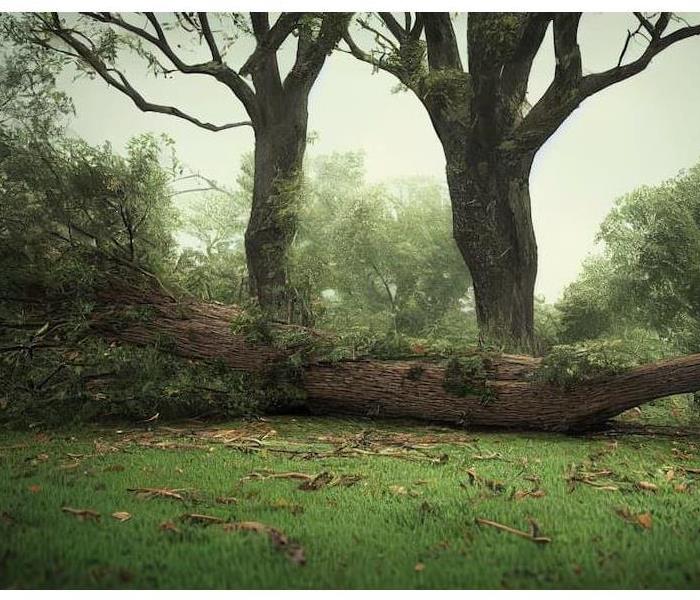 Large debris, like downed trees, should only be removed by those with expert knowledge and the right equipment.
Large debris, like downed trees, should only be removed by those with expert knowledge and the right equipment.
Trees are often seen as a form of protection and a natural asset to any home. Occasionally, their presence can cause more harm than good. Heavy storms can cause fallen tree branches and uprooted trees, which in turn can lead to structural damage or other more serious property damage. Removing these trees is essential if you want your home restored to its pre-storm condition. This is where tree removal becomes important in storm damage restoration.
How Storms Damage Trees
Heavy storms can damage trees in a variety of ways. From uprooting entire trees to breaking branches, the force of wind or hail can pose a serious risk to trees. When this happens, it is essential to consider the role of tree removal in storm damage restoration.
Removing Trees after Storms
When a tree is uprooted, it can cause damage to property, people, and other trees. It is important to promptly remove the trees to prevent additional damage.
Once the tree is removed, it is important to assess the damage and take steps to restore the area. This includes removing any debris as well as repairing damaged structures and trees. In some cases, the damage may be too extensive to repair, and it is necessary to replace sections of the landscape.
Tree Removal as Part of Storm Damage Restoration
Tree removal can be a critical part of storm damage restoration. Removing damaged trees and debris will help limit the damage to your property and ensure that the restoration process is efficient and successful.
Tree removal can be difficult, so it's important to work with an experienced team that knows what they're doing. A professional restoration will safely and efficiently remove damaged trees and debris and any additional debris that the storm may have created.
Tree Removal Services
When a storm strikes, having the right tree removal services on board can make all the difference in restoring your home. Tree removal experts have the necessary experience and equipment to safely remove trees that may have been uprooted or fallen due to strong winds or other storm-related issues.
This type of service helps minimize the damage caused by fallen trees and other debris, as well as helps to restore your home more quickly.
The Process of Tree Removal
The process of tree removal involves more than just cutting down trees. Professional tree removal companies will use various techniques to safely remove trees from any location. This includes using specialized equipment such as cranes, ladders, and rigging systems to reach areas where manual removal may not be possible. After being cut down, it is removed from the property in pieces.
The Benefits of Professionals
One key benefit of hiring a professional tree removal company is that they can safely remove trees and limbs from any location, even in tight spaces or hard-to-reach areas. Professional tree removal services also have the necessary insurance and certifications to operate in your area. This means you won't have to worry about potential liability costs if the job is done incorrectly.
Professionals have access to special equipment and tools that make removing trees and debris easier. Some of these tools include chainsaws, pulleys, winches, and ladders. This equipment can help to get the job done faster and more safely than attempting to do it yourself with basic tools.
A professional tree removal company can assess the damage caused by a storm and advise you on what needs to be done. They can provide you with a detailed plan of action to help minimize the damage.
These qualities help ensure that all work is done safely and efficiently, with minimal risk of further damage to your property. The aftermath of a storm can be overwhelming. To ensure that your restoration process goes as smoothly as possible, it is important to hire a professional tree removal company. They will have the right tools and knowledge necessary to remove trees safely and provide you with peace of mind.
Why Contact SERVPRO?
At SERVPRO of South and Northwest Grand Rapids, we have the experience and training to ensure that your storm damage restoration is done quickly and safely. We are a trusted source for professional tree removal services and can provide you with the guidance and support needed to restore your property. We provide the best services, from tree removal to clean-up and debris removal, so you can rest assured that your property is being taken care of.
If your home or business has been affected by a storm, contact SERVPRO of South and Northwest Grand Rapids at (616) 662-9700 with any questions. Our team of experts is available 24/7 and can help get your property back to normal in no time.
Is There Anything SERVPRO Can’t Do?
4/21/2023 (Permalink)
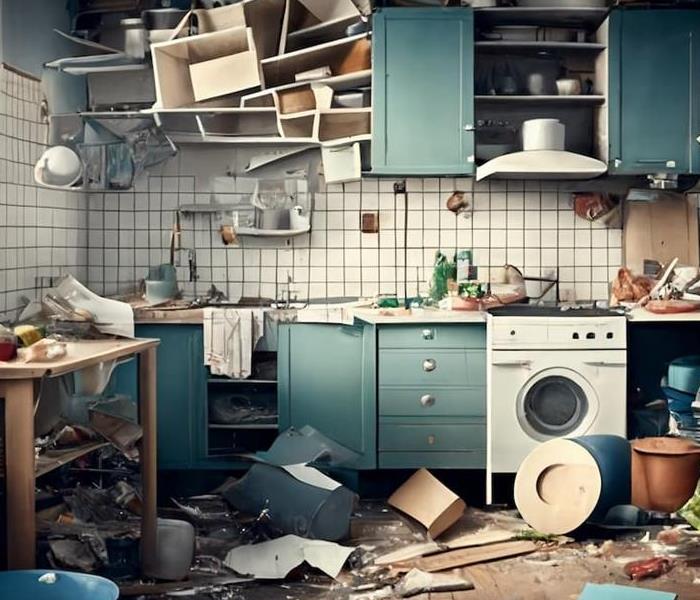 When disaster strikes, it's important to know who you can call to clean up what's left behind.
When disaster strikes, it's important to know who you can call to clean up what's left behind.
Key Takeaways:
- SERVPRO offers a wide range of restoration services for both residential and commercial properties
- Their emergency response teams are available 24/7 to provide quick and efficient service
- The company's extensive expertise and state-of-the-art equipment ensure high-quality restoration work
- Relying on SERVPRO can save property owners time and money in the long run.
When disaster strikes, property owners and managers need a reliable restoration company they can count on. SERVPRO of South and Northwest Grand Rapids has been providing professional damage restoration services for over 50 years. But is there anything they can’t do? Let’s explore the answer to that question and why SERVPRO is the right choice for your restoration needs.
The SERVPRO Advantage
SERVPRO is the preferred choice for property owners and managers across the country. There are several reasons why SERVPRO stands out from other restoration companies:
- Experience: SERVPRO has been in the business for over 50 years and has a proven track record of delivering quality restoration services.
- Expertise: SERVPRO’s team of professionals has extensive training and experience in all aspects of restoration, including water, fire, mold, and storm damage.
- Advanced Technology: SERVPRO uses state-of-the-art technology to quickly and efficiently restore your property to pre-damage condition.
- 24/7 Emergency Response: SERVPRO provides a rapid response to emergencies, no matter the time of day or night.
- Comprehensive Solutions: SERVPRO offers a full range of restoration services, including mitigation, cleanup, and reconstruction.
What SERVPRO Can Do
SERVPRO can handle a wide range of restoration needs. Here are just a few examples:
Water Damage Restoration
Water damage can occur for many reasons, including burst pipes, leaking roofs, and natural disasters. If left untreated, water damage can lead to mold growth, structural damage, and other issues. SERVPRO’s water damage restoration services include:
- Water extraction
- Drying and dehumidification
- Odor removal
- Mold remediation
SERVPRO’s team of experts uses advanced equipment, including moisture meters and thermal imaging cameras, to identify and address water damage quickly and efficiently.
Fire Damage Restoration
Fires can cause extensive damage to a property, even after the flames have been put out. Smoke and soot can lead to lingering odors and damage to your belongings. SERVPRO’s fire damage restoration services include:
- Structural cleaning
- Contents cleaning
- Deodorization
- Reconstruction
SERVPRO’s team of professionals uses specialized equipment and techniques to restore your property to its pre-fire condition.
Mold Remediation
Mold can cause health problems and structural damage if left untreated. SERVPRO’s mold remediation services include:
- Inspection and testing
- Containment
- Mold removal
- Cleaning and disinfecting
SERVPRO’s team of experts uses specialized equipment and techniques to safely and effectively remove mold from your property.
Final Thoughts
SERVPRO of South and Northwest Grand Rapids is the right choice for your restoration needs. With decades of experience, advanced technology, and a team of experts, SERVPRO can handle any restoration challenge. From water damage to fire damage to mold remediation, SERVPRO has you covered.
So, is there anything SERVPRO can’t do? When it comes to restoration services, the answer is no. Contact SERVPRO today to learn more about their comprehensive solutions and get your property on the road to recovery.
4 Most Common Causes of a Kitchen Fire
4/21/2023 (Permalink)
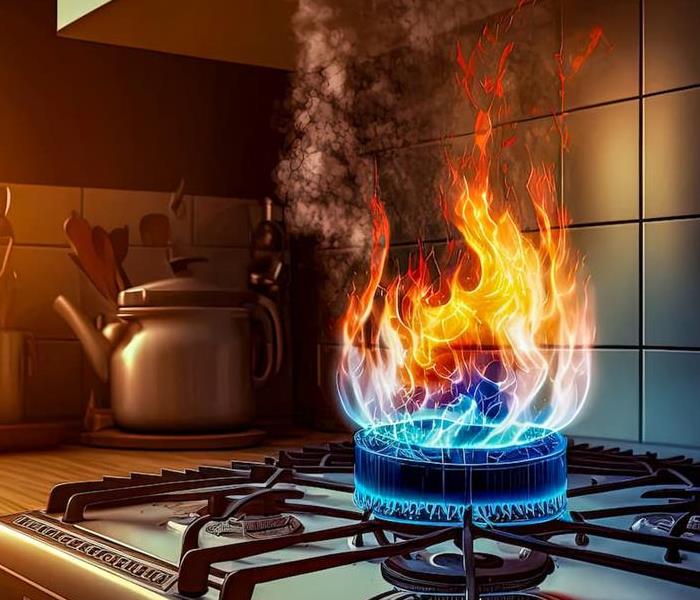 Leaving cooking equipment out too long on an open flame is one of the leading causes of kitchen fires.
Leaving cooking equipment out too long on an open flame is one of the leading causes of kitchen fires.
Key Takeaways
- Cooking equipment is the leading cause of kitchen fires.
- Electrical equipment and heating equipment can also cause fires.
- Carelessness with flames, such as candles and cigarettes, is dangerous.
- Prevention measures, such as staying alert and regular cleaning, are crucial.
What Makes a Kitchen Fire So Dangerous?
Kitchen fires are one of the most dangerous types of home fires and can be particularly devastating for property managers and homeowners. Unaddressed safety hazards in kitchens can put these spaces at an increased risk for fire, making it essential to understand what contributes to them and how they can be prevented.
At SERVPRO of South and Northwest Grand Rapids, we’ve seen the devastating effects of kitchen fires firsthand. In this article, we’ll discuss the four most common causes of kitchen fires, as well as provide tips on how to prevent them.
Cause #1: Cooking Equipment
Cooking equipment is the leading cause of kitchen fires. Pots and pans left unattended on the stove can easily overheat, causing a fire to ignite. Grease buildup on the stove or in the oven can also contribute to fires.
To prevent cooking equipment from causing a fire, always stay in the kitchen while cooking, and never leave the stove unattended. Keep flammable objects, such as towels and oven mitts, away from the stove. Clean the stove and oven regularly to remove any grease buildup.
Cause #2: Electrical Equipment
Electrical equipment, such as toasters, coffee makers, and microwaves, can also cause kitchen fires. Overloading outlets, using frayed cords, and leaving appliances plugged in when not in use can all contribute to electrical fires.
To prevent electrical equipment from causing a fire, make sure to never overload outlets or use frayed cords. Unplug appliances when not in use and keep them away from flammable materials.
Cause #3: Heating Equipment
Heating equipment, such as space heaters and portable heaters, can also cause kitchen fires. Placing these heaters too close to flammable materials or leaving them unattended can cause a fire to ignite.
To prevent heating equipment from causing a fire, always keep them away from flammable materials, and never leave them unattended. Use heaters that have an automatic shut-off feature, so they turn off if they tip over.
Cause #4: Carelessness with Flames
Finally, carelessness with flames, such as leaving candles or cigarettes unattended, can cause kitchen fires. Candles left burning can easily ignite nearby objects, while cigarettes can ignite flammable materials if not properly extinguished.
To prevent carelessness with flames from causing a fire, always keep candles away from flammable materials and never leave them burning unattended. Make sure to properly extinguish cigarettes and dispose of them in a metal container.
Final Thoughts
Kitchen fires can be devastating, but they’re also preventable. By understanding the common causes of kitchen fires and taking steps to prevent them, you can help protect your property and your loved ones. If you do experience a kitchen fire, contact SERVPRO of South and Northwest Grand Rapids for kitchen fire damage restoration. Our team of experts can help you get your home or property back to pre-fire condition.
The Different Types of Mold and How They Can Affect Health
4/16/2023 (Permalink)
 The only things growing in your home should be under your watchful eye.
The only things growing in your home should be under your watchful eye.
Mold, usually found in damp, dark places, can cause serious health problems when breathed in or touched. It's essential to know its various types and how they affect your health so you can take proper precautions to protect yourself and your family.
Types of Mold
Mold can range from a black slimy substance to a bright green fuzzy growth. While they may look different, all types of mold have the potential to cause adverse health effects. Knowing the types of mold and the potential health problems associated with them can help you make informed decisions about your home and environment.
The most common types of mold are:
Black Mold
Black mold is a sinister-sounding name for Stachybotrys chartarum, a type of fungus found in damp or wet areas. It is usually black or dark green and can be easily spotted in places with high humidity, such as washrooms, laundry areas, and basements. Not only does it cause unsightly discoloring, but it can also cause various health issues.
Black mold produces toxins known as mycotoxins that can cause various health problems if inhaled. Symptoms may include congestion, watery eyes, cough, irritability, sneezing, headaches, and difficulty in breathing. In some cases, it can even cause respiratory damage and neurological disorders. It's important to have the affected areas treated by a professional as soon as possible.
Mildew
Mildew is a type of fungi that often grows on fabrics, furniture, and other household items in warm and humid environments. These fungi are usually black or gray but can also be white or yellow, depending on their growing area. Mildew is a much less serious form of mold, but it can still cause unpleasant odors and damage to your home. Inhaling mildew spores can cause many health issues, including headaches, coughing, sneezing, and congestion. Additionally, long-term exposure can lead to more serious respiratory illnesses.
To prevent the spread of mildew, it's important to keep your home clean and dry. Make sure to clean any wet areas immediately, as mildew will often form in these places. Additionally, using a dehumidifier can help keep your home's environment dry and free of mold and mildew.
To remove mildew, use a cleaner specifically designed for mildew. This will help to eliminate the odor and prevent it from coming back. Also, make sure to ventilate any areas that have been affected.
White Mold
White mold is the most common type and is usually found in damp, humid places. It can cause various health symptoms, including allergic rhinitis, sinus inflammation, and asthma. White mold is also capable of producing mycotoxins, which can affect the respiratory system, skin, and eyes.
To prevent white mold from growing, it's important to keep your home dry and well-ventilated. Additionally, using a dehumidifier can help reduce the moisture levels in your home and make it less hospitable for mold growth.
Green Mold
Green mold is a type of mold that usually grows in damp, dark areas and is often found in bathrooms and basements. Exposure to green mold can cause allergies and asthma attacks, respiratory problems, skin irritation, and even increase the risk of developing cancer.
If you discover green mold in your home, it's important to act quickly. Call a certified mold specialist to assess the situation and create an action plan. To prevent green mold from spreading, open windows and run dehumidifiers. Additionally, clean and disinfect all non-porous surfaces in the area with a solution of water and bleach.
No matter what type of mold you encounter, it's important to take the proper steps to eliminate and prevent it from returning. If you're unclear about the situation or need assistance, contact SERVPRO of South and Northwest Grand Rapids at (616) 662-9700. We're here to help you eliminate mold and keep your home clean and safe.
So don't wait; call us today and let us help you eliminate mold and keep your family safe!
How Do Storms Damage Roofs?
4/9/2023 (Permalink)
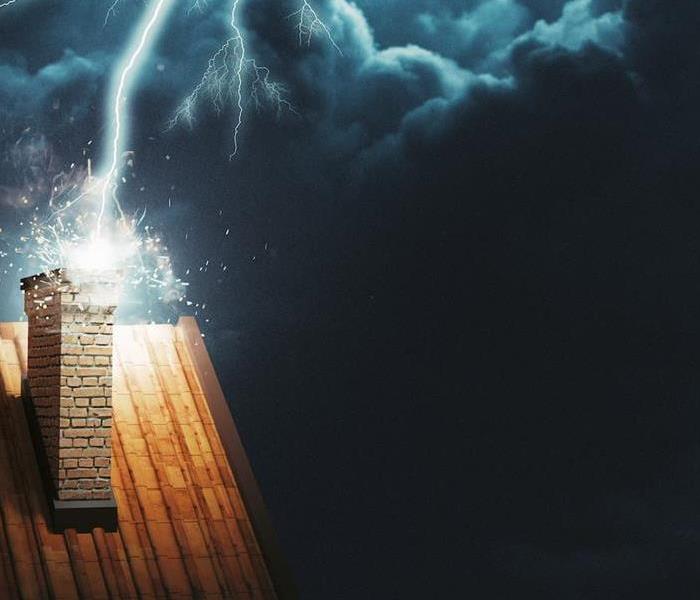 If a storm causes damage to your roof, it's important to act quickly.
If a storm causes damage to your roof, it's important to act quickly.
Storms can cause serious damage to a roof. From high winds to hail, these severe weather events can wreak havoc on well-maintained roofs. The most common types of storm damage are wind, hail, snow and ice, and lightning. Each type of storm presents a different risk to your roof and its own set of challenges when trying to repair the damage.
While roofs are designed to withstand strong weather, there is only so much they can do against the power of a storm. Knowing what to watch for and how to prepare before a storm hit can help you minimize the potential damage and keep your roof in great shape.
Different Types of Storms
The type of storm can have a huge impact on the damage it does to your roof.
Hail
Hail can cause a range of damage to your roof, depending on the size and speed of the hail. Smaller hail may just dent or scratch the surface of your roof, while larger hail can cause cracks and punctures. If your roof is made from asphalt shingles, hail can cause the granules on top to be knocked off. This reduces the protection of your roof and may lead to more serious issues down the line.
Heavy Rain
Hail storms can cause dents and holes, but heavy rain can be even more damaging. During a storm, rainfall increases the pressure on your roof, which can cause water to seep through the seams of your roof, resulting in water damage. Heavy rains can also overwhelm gutters, leading to water spilling over the sides of your roof and causing more damage.
High Winds
High winds during a storm can cause shingles to be torn away, leaving your roof exposed and vulnerable to water damage. The force of the wind can also break the branches from the trees, which can then crash through your roof. If there are any weak spots on your roof—such as missing or damaged shingles—the wind can take advantage of these and cause further damage.
What to Do to Prepare
To minimize the potential damage of storms, it's important to take steps before a storm hits. There are a few things you can do to help prevent storm damage and minimize the risk of a roof leak:
- Check your roof for weak spots, missing shingles, and other signs of damage before storms begin.
- Check your gutters to make sure they aren't clogged and can efficiently drain away water.
- Check missing or damaged shingles after a storm to see whether they can be replaced or patched.
- Ensure your attic is properly ventilated, and check for any signs of water leaks or damp spots.
- It's also important to trim any branches away from your home to reduce the risk of falling debris.
- Ensure that you have adequate and up-to-date insurance coverage on your home.
If a storm causes damage to your roof, it's important to act quickly. Remove any debris from your roof, and inspect the damage to determine if you need to call a professional. Ensure all the affected areas are properly sealed and covered to prevent further damage. If you're concerned that your roof may have been damaged in a storm, contact a professional roofer for an inspection. They can determine the extent of the damage and make recommendations for repairs or replacement.
No matter how severe the damage, it's important to take action quickly. Storms can cause extensive damage to your roof, so don't delay getting help. If you're unsure of how to proceed, contact SERVPRO of South and Northwest Grand Rapids at (616) 662-9700 with any questions, we're here to help!
We'll provide you with a thorough assessment and make sure your roof is as secure as possible. Don't let storm damage get the best of you: contact us today and put your mind at ease.
The Dangers of DIY Fire Damage Restoration
4/2/2023 (Permalink)
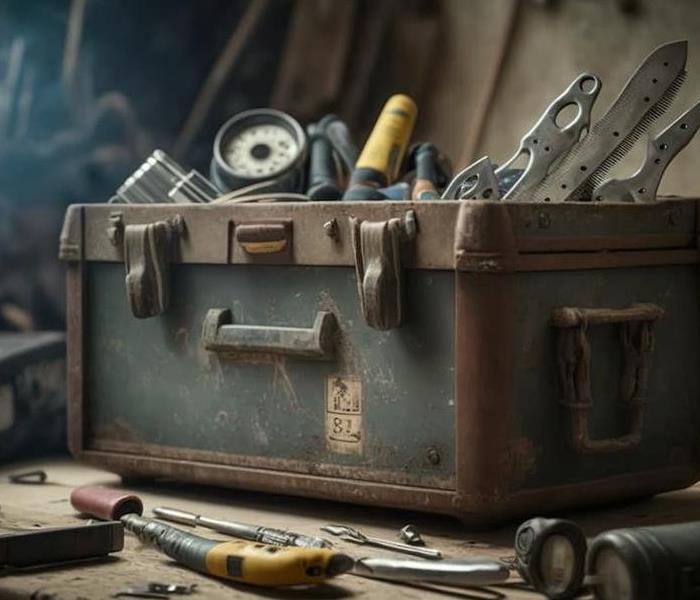 Attempting to use the tools at your own disposal are dangerous for large-scale cleanup efforts.
Attempting to use the tools at your own disposal are dangerous for large-scale cleanup efforts.
Capable of quickly spreading and causing structural damage, fire can be dangerous. When it occurs in your home or business, you are left with damage to property and lives. Even if firefighters put out the fire, the damages still remain. It's best to let the professional take care of the restoration. Here's everything that can go wrong with DIY fire damage restoration:
You May Cause Further Damage
Approaching your property after a fire, it is possible that you may see no structural damage. However, this doesn't mean the damage isn't present. It could be hidden under layers of soot and smoke. Removing these items yourself can cause further damage to the property or create an unsafe environment for those living in the home.
For example, if your kitchen caught on fire and burned down, some rooms in the house will likely remain unscathed. To ensure that all necessary steps have been taken to protect your home, you should board up the unburnt portion, cover broken windows and doors with plywood or other material, turn off water meters on that side of your house, and check for any damage to roofing or flooring due to smoke. A fire can be such an overwhelming and stressful experience for homeowners you may forget and overlook certain precautions. It's crucial to call in experts who know how to mitigate the damage further.
You May Overlook Certain Fire Restoration Practices
Complete restoration of a fire-damaged space requires more than a good scrub. You'll need to employ specific strategies and components unique to the fire restoration process.
For example, smoke and soot are typical by-products of fire damage. Vacuuming can help remove these, but this is simply a surface-level approach. You'll also need to go deeper and clean the air ducts and ventilation systems. There's also the need to remove any residual smoke odor. If left unchecked, both can cause extensive damage to wires and other materials in your home.
You May Create a Dangerous Environment
Fire damage is also a health hazard. You can't just clean up the mess and move on with life. Getting rid of any lingering smoke particles or soot that could trigger respiratory issues or other health problems later on down the road is imperative.
You Could Throw Away Salvageable Items
Go through your things without anyone else's input. Especially if that person is not a professional organizer or someone who can objectively judge whether something should be saved or thrown away—you may decide to get rid of furniture and other household items when it would have been better to repair them.
You should always have a professional inspect your items before making any decisions about whether or not to discard them. A pro can estimate the furniture's worth, how much it would cost to refurbish, and whether it's even worth your time and effort.
You May Be Liable for Damage
You must prove that such a thing occurred to get reimbursement for any losses or damage. Before you start a clean-up or remove any hazardous materials from your property, it is essential to have proof that the products were causing problems.
However, creating a list of your losses after such a traumatic incident can be an exhausting task. You may forget to document critical details, which can result in an inability to claim compensation for your losses.
Why Should You Hire Experts?
The damage caused by fire creates a large and complicated project. Working with professionals ensures that no detail is overlooked and every issue is addressed. Fire damage clean-up and restoration experts have the training, equipment, and experience necessary to clean up the fire's devastation so your home or business looks like it did before or even better.
SERVPRO of South and Northwest Grand Rapids knows fire damage. We have training and expertise in fire damage restoration, so when you call us after a fire, we'll know exactly how to handle your needs. Call us at (616) 662-9700 with any questions or concerns you may have regarding your property or if you would like more information about our services.
How Do Storms Damage Roofs?
3/28/2023 (Permalink)
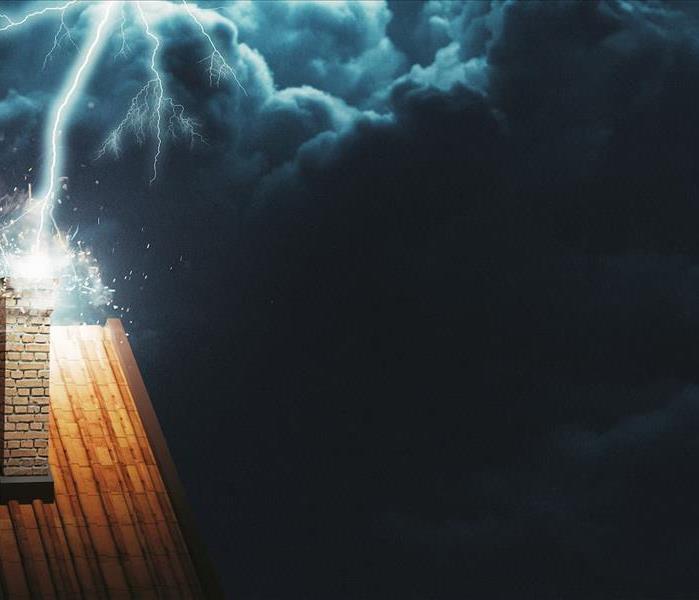 If a storm causes damage to your roof, it's important to act quickly.
If a storm causes damage to your roof, it's important to act quickly.
Storms can cause serious damage to a roof. From high winds to hail, these severe weather events can wreak havoc on well-maintained roofs. The most common types of storm damage are wind, hail, snow and ice, and lightning. Each type of storm presents a different risk to your roof and its own set of challenges when trying to repair the damage.
While roofs are designed to withstand strong weather, there is only so much they can do against the power of a storm. Knowing what to watch for and how to prepare before a storm hit can help you minimize the potential damage and keep your roof in great shape.
Different Types of Storms
The type of storm can have a huge impact on the damage it does to your roof.
Hail
Hail can cause a range of damage to your roof, depending on the size and speed of the hail. Smaller hail may just dent or scratch the surface of your roof, while larger hail can cause cracks and punctures. If your roof is made from asphalt shingles, hail can cause the granules on top to be knocked off. This reduces the protection of your roof and may lead to more serious issues down the line.
Heavy Rain
Hail storms can cause dents and holes, but heavy rain can be even more damaging. During a storm, rainfall increases the pressure on your roof, which can cause water to seep through the seams of your roof, resulting in water damage. Heavy rains can also overwhelm gutters, leading to water spilling over the sides of your roof and causing more damage.
High Winds
High winds during a storm can cause shingles to be torn away, leaving your roof exposed and vulnerable to water damage. The force of the wind can also break the branches from the trees, which can then crash through your roof. If there are any weak spots on your roof—such as missing or damaged shingles—the wind can take advantage of these and cause further damage.
What to Do to Prepare
To minimize the potential damage of storms, it's important to take steps before a storm hits. There are a few things you can do to help prevent storm damage and minimize the risk of a roof leak:
- Check your roof for weak spots, missing shingles, and other signs of damage before storms begin.
- Check your gutters to make sure they aren't clogged and can efficiently drain away water.
- Check missing or damaged shingles after a storm to see whether they can be replaced or patched.
- Ensure your attic is properly ventilated, and check for any signs of water leaks or damp spots.
- It's also important to trim any branches away from your home to reduce the risk of falling debris.
- Ensure that you have adequate and up-to-date insurance coverage on your home.
If a storm causes damage to your roof, it's important to act quickly. Remove any debris from your roof, and inspect the damage to determine if you need to call a professional. Ensure all the affected areas are properly sealed and covered to prevent further damage. If you're concerned that your roof may have been damaged in a storm, contact a professional roofer for an inspection. They can determine the extent of the damage and make recommendations for repairs or replacement.
No matter how severe the damage, it's important to take action quickly. Storms can cause extensive damage to your roof, so don't delay getting help. If you're unsure of how to proceed, contact SERVPRO of South and Northwest Grand Rapids at (616) 662-9700 with any questions, we're here to help!
We'll provide you with a thorough assessment and make sure your roof is as secure as possible. Don't let storm damage get the best of you: contact us today and put your mind at ease.
Rely On SERVPRO's Equipment & Expert Drying Techniques
3/27/2023 (Permalink)
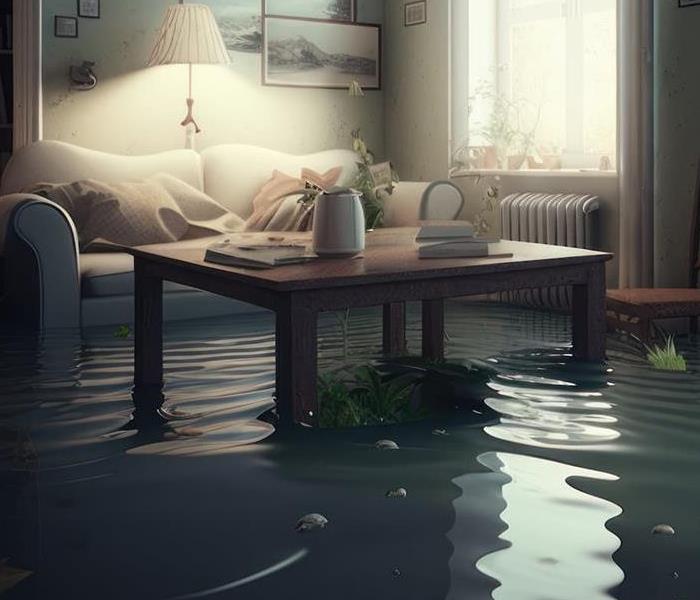 This is no time for a bucket and a mop. Call in the professionals!
This is no time for a bucket and a mop. Call in the professionals!
Water damage to property caused by natural disasters or home accidents can be effectively managed with the help of proper equipment and professionals.
Water damages include all physical damages that occur when water comes into contact with easily destroyed materials. Examples include steel rusting, wood rotting, short-circuiting of electrical devices, and soaking wood boards. This process can be gradual, like damage caused by a hole in a kitchen pipe or roof or immediate damage caused by flooding in your area.
Water can cause severe damage to property, like walls, doors, insulators, radiators, wood beams and boards, windows, ceramic tiles, building materials, documents, and electrical circuits.
How to Handle Water Damages
Water damage is frequently overlooked, which gives water more time to destroy. However, by hiring the experts at SERVPRO of South and Northwest Grand Rapids, you can reduce the likelihood that water will ruin your property.
If you want to avoid water damage, the first step should be to obtain insurance to cover unforeseeable events. Most insurance companies include this offer in general property insurance, but you must double-check to be sure. It is important to inquire about the type and extent of damage covered by the policy.
If you are already a victim of water damage, contact your insurance company and inform them of your situation. Give them a thorough explanation of the situation so they can work on assisting you.
After that, you can start dealing with the damages by following the steps outlined below:
Identify the Source of the Problem
This applies to damage caused by building leaks. Find the source of the water and try to stop it from leaking. Turn off the main water source to control water flow to the affected site.
Assess the Level of Damage to Your Property
Any material that has sustained significant water damage should be discarded because it will encourage mold growth.
Turn Off the Electricity
The last thing you want is to be electrocuted as a result of a water leak. So, turn off your power at the main switch.
Protect Yourself
You have no idea what's in the water and if there's any power nearby. Wear protective clothing, preferably ones made of rubber.
Salvage What You Can
Begin relocating your valuables to secure areas of your home. If the water results from flooding, remove all important papers, furniture, electrical appliances, jewelry, and other valuables from your home.
Enlist the Help of a Professional
Your best efforts to completely dry your home and property may not be sufficient as you may lack the necessary tools to remove humidity and moisture completely. Your home will become unfit for a living if appropriate water damage restoration steps are not taken. This is because it will harbor mold, cracks, and water stains from untreated water damage.
Don't Drain Stagnant Water By Yourself
If there is any standing water, use SERVPRO's expertise. Draining it yourself without proper equipment can be dangerous to your health. This isn't a good use of your bucket or mop. We have the tools necessary for every job.
SERVPRO is here to help restore your home. Contact us at (616) 662-9700. We're confident that our team is made up of the best experts in the business and that we will be able to get your property back in working order quickly while still protecting it from future damage.
Why You Can't Trust DIY Damage Restoration Kits
3/20/2023 (Permalink)
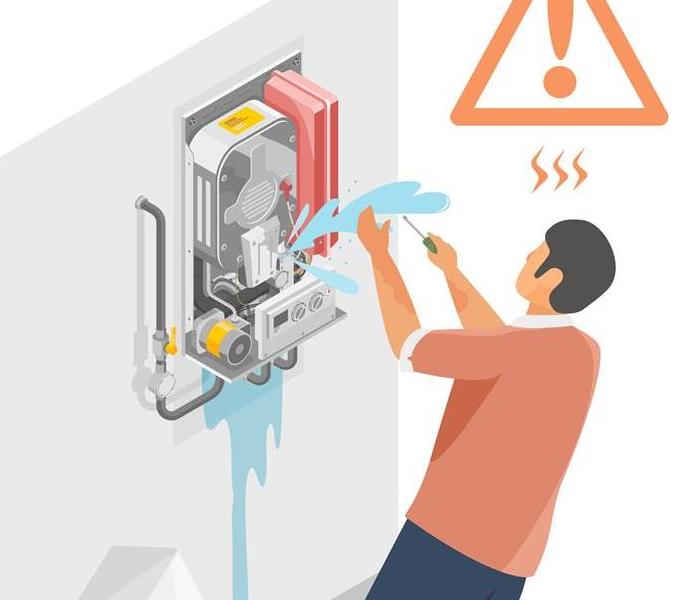 It's better to trust professionals before making the problem potentially much worse.
It's better to trust professionals before making the problem potentially much worse.
Do you live in a place that experiences extreme weather conditions? Are you dealing with the aftermath of a natural disaster, such as flood, fire, or tornado damage? If so, you may be tempted to try a DIY damage restoration kit to fix the problem. But before you do, it's important to understand why you can't trust these kits and the risks they present.
What Is a DIY Damage Restoration Kit?
A DIY damage restoration kit is a collection of supplies and instructions designed to help homeowners "do it yourself" when it comes to repairing their homes after a disaster. These kits typically include items like gloves, masks, plastic sheeting, and buckets. Many of them even include instructional videos and manuals that show homeowners how to repair items like drywall, electrical wiring, floors, and roofs. Unfortunately, these kits are not always sufficient to fix the problem.
When You May Need a Restoration Kit
If you have experienced a natural disaster like a flood, fire, or tornado, you may need to use a damage restoration kit to repair the physical structure of your home and prevent further damage. If you have water or mold damage or need to repair your home's structure after a storm, these kits can be helpful.
When Can a Restoration Kit Help?
A restoration kit can help repair minor damage, such as small cracks in drywall or cracks in the foundation. You may also be able to use the kit to clean up after a flood or other water damage. However, it's best to call in a professional when it comes to major repairs, like replacing drywall or repairing the roof.
When Do DIY Damage Restoration Kits Fail?
DIY damage restoration kits can fail in different ways. For instance, the instructions may be incomplete or not detailed enough for you to understand how to repair the damage. Additionally, these kits typically do not include more specialized items like drywall saws and safety equipment. This means that if you try to repair your home with a DIY damage restoration kit, you may make the problem worse.
Risks of DIY Damage Restoration Kits
DIY damage restoration kits are often touted as an easy and affordable way to repair any property damage. Unfortunately, this is not always the case. The products included in these kits are often of poor quality and may need help to handle the job. Furthermore, the instructions included are often inadequate, leaving you with a greater risk of making mistakes that could further damage your home or business.
Safety Concerns
Safety is of utmost importance when dealing with property damage. DIY kits are not regulated, so the products within them may contain hazardous chemicals that could be dangerous to your health. Some products may even worsen the damage, leading to more expensive repair bills. In addition, the instructions that come with these kits may not provide adequate guidance on the safe use and disposal of these materials.
Why You Should Use SERVPRO
DIY damage restoration kits may seem like an easy solution, but they can often do more harm than good. The best and safest way to repair your home or business after a disaster is to hire a professional restoration company. Professional restoration companies have the experience and knowledge to assess the damage and handle any repairs properly. Plus, they use high-quality products that are safe for your home or business.
When it comes to property damage, you should never trust a DIY restoration kit. Make sure you hire a professional restoration company like SERVPRO of South and Northwest Grand Rapids. They have the experience and expertise to handle any kind of property damage. Call (616) 662-9700 today with any questions, and rest assured that you're in safe hands. We're here to help!
The Importance of Fast Action in Water Damage Restoration
3/13/2023 (Permalink)
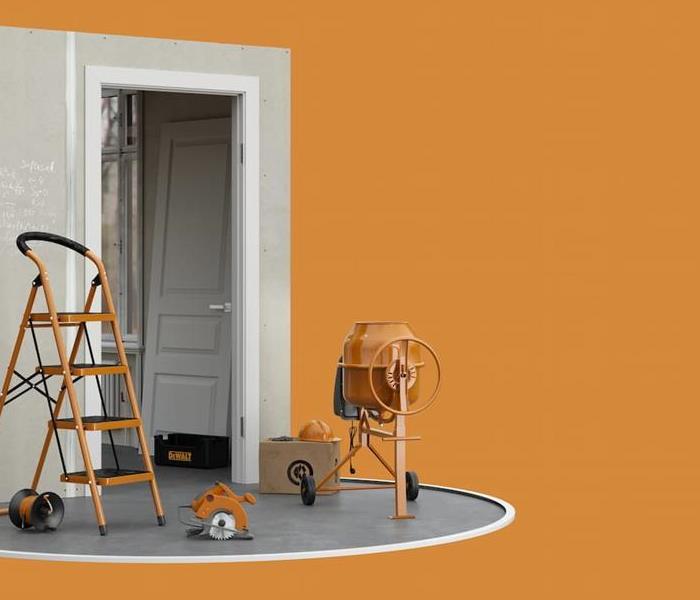 SERVPRO always uses the right tools for the right job.
SERVPRO always uses the right tools for the right job.
Whether from a burst pipe, flooding, leaking roof, or other water-related events, it is essential to take fast action when dealing with water damage to prevent further damage and long-term health risks. Prompt response and proper restoration by an experienced professional can help reduce the loss of property and personal items and the cost of repairs.
Understanding Water Damage
Water damage occurs when water seeps into areas where it isn't supposed to, such as walls, ceilings, floors, and furniture. If left unchecked, the water can cause considerable structural damage that is often expensive to repair or replace. In addition, moisture from water damage can lead to mold growth which can cause many health issues.
Importance of Quick Action
Time is of the essence when dealing with water. The longer water sits in a home or building, the more damage it will cause and the costlier the repairs.
Speed is critical for water damage restoration because water can quickly saturate materials and cause irreparable damage in a very short time. For instance, within minutes, carpets may begin to buckle or discolor, the drywall may start to swell and crumble, metal objects to rust and corrode, and wood furniture can warp or split.
Additionally, fast action when dealing with a water-related disaster helps prevent future damage. For example, if a pipe bursts, the water pressure can cause additional damage to pipes and fixtures. If the problem is not addressed quickly, repairs and replacement expenses can be astronomical.
As water seeps further into the structure of the building, it can cause mold growth which can be hazardous to human health. Acting quickly is essential to limit damages and reduce costs.
Restoration Services
The first step in a water damage restoration process is locating and stopping the leak or flood source. Once that's done, professionals can assess the damages, remove any standing water and dry wet materials, and restore the structure. The right restoration team will have access to specialized equipment such as pumps and extractors, dehumidifiers, and air movers to ensure the job is done quickly, safely, and effectively.
The Benefits of Professional Water Damage Restoration
Water damage restoration should be handled by a professional. A professional water restoration company has the training, knowledge, and tools to assess the extent of the damage and quickly begin the repair process. They can extract standing water, dry out structure materials, remove mold and mildew, and provide other services to bring your home or business to pre-damage condition.
How an Experienced Professional Can Help
When faced with water damage, it is important to hire an experienced professional to ensure everything is done properly and efficiently. An experienced professional will be able to assess the extent of the damage, identify areas that need immediate attention, clean up existing water and moisture, restore damaged items, and make sure all necessary repairs are made.
Furthermore, an experienced professional can help avoid costly mistakes such as not replacing insulation or failing to get rid of mold and mildew. They can also advise on preventing future water damage by suggesting improvements such as installing a sump pump or waterproofing basement walls.
At SERVPRO of South and Northwest Grand Rapids, we are committed to providing prompt and reliable water damage restoration services. Our experienced team of experts is available 24/7 to provide fast responses and quality service. We use specialized equipment to assess the damage, extract standing water, dry out structure materials, sterilize surfaces, remove mold and mildew, repair any items that can be salvaged, and restore your home or business back quickly and effectively to its original condition.
For fast action and quality service regarding water damage restoration, contact SERVPRO of South and Northwest Grand Rapids at (616) 662-9700 with any questions; we're here to help. Our experienced, certified technicians will provide the best service and results. So don't delay; contact us today for fast, reliable water damage restoration services.
Common Causes of Water Damage in Homes and Businesses
3/8/2023 (Permalink)
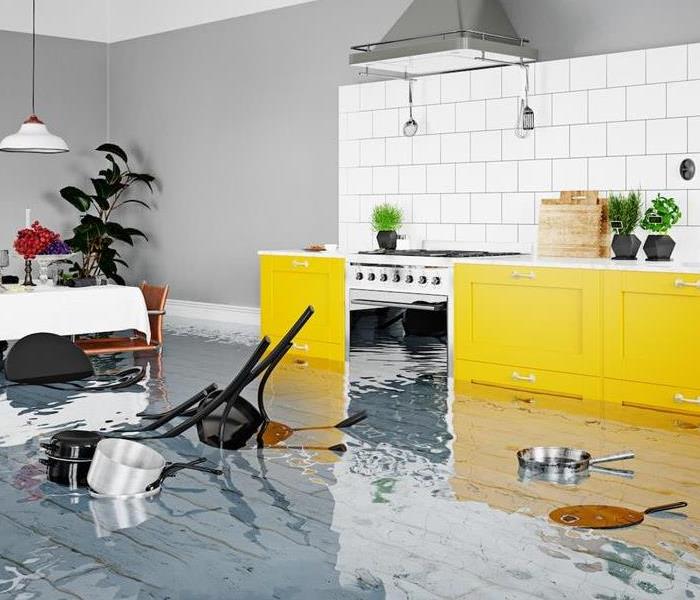 Whether it's your home or business, any water seeping through needs immediate and professional cleanup.
Whether it's your home or business, any water seeping through needs immediate and professional cleanup.
Water damage can occur both inside and outside of your home. You can also be affected by water damage in your business, no matter the industry. It is important to take preventive measures to avoid the risk of water damage. Here is a look at the top common reasons for water damage:
Leaky Roofs or Windows
If your roof is leaking or your windows are broken, water can trickle down and cause damage to the interior of your home or business. You may not even realize that you have a leak until it is too late.
You may have a leak if you notice water stains on the ceiling or walls or a musty smell coming from your home or office. In many cases, a leaky roof or broken window can be repaired quickly and easily. However, if left unattended for an extended period, it can cause serious damage to your property.
Damaged Water Heaters
If you have an old water heater, the chances of it developing a leak are high. When water heaters have not been adequately maintained or are improperly installed, the resulting leaks can cause flooding in basements. With an aging water heater, it is crucial to have it inspected by a professional at least once every two years.
Damaged or Faulty Plumbing
Water supplies run through every part of a home or business, so issues can arise in any location. If you notice that your water is discolored, has a foul smell or taste, or feels itchy after bathing—this may be caused by bacterial growth. Strange sounds coming from the pipes may signal damage to the system.
Appliances, sinks, washing machines, and sprinkler systems are just a few examples of where water damage can occur. Water can create substantial damage when left unchecked if the original installation is substandard.
Clogged Gutters and Drains
Gutter systems are designed to drain rainwater away from your home. Over time, however, gutter systems can become blocked by leaves or other types of debris. When rainwater is prevented from flowing away from your property, it can overflow the edges of gutters and damage ceilings, walls, and floors.
Severe Weather
Though natural disasters like thunderstorms and hurricanes happen infrequently, they can still damage your home. The water damage resulting from severe weather is often the result of roof damage caused by high winds or falling debris. These natural disasters can also result in flooding, which can cause water damage to your property.
The Dangers of Water Damage
Water damage can lead to severe problems in your home, including mold growth and structural damage. Mold is one of the most common types of water damage, as it occurs when moisture gets trapped inside your walls or attic. If left untreated, mold will spread quickly and cause respiratory issues for anyone who suffers from allergies or asthma.
Structural damage is another common by-product of water damage, as water can cause your home's foundation and walls to warp or crack. This can result in structural instability, which could lead to the collapse of your building. The longer you wait to address the issue, the harder it is to repair.
What should you do if you see signs of water damage in your home or business? You don't have to be a plumber or a sailor, but you can call a professional for help, like our friendly and certified technicians at SERVPRO of South and Northwest Grand Rapids. They can safely dry out your building without putting your property (or its residents) in danger! Get in touch with us today by calling (616) 662-9700 with any questions!
The Importance of Clean-up and Sanitization after a Grand Rapids Storm
3/8/2023 (Permalink)
 This area is no stranger to high winds, heavy snowfalls, and water events. When disaster strikes, call the professionals.
This area is no stranger to high winds, heavy snowfalls, and water events. When disaster strikes, call the professionals.
Natural disasters like blizzards, high winds, floods, and other extreme weather events can be incredibly destructive, leaving behind a trail of disaster in their wake. After the initial damage has been done, it can be difficult to know where to begin the clean-up process. Clean-up and sanitization after a lake-effect storm are essential to restore your property to its preloss condition.
Why Clean-up and Sanitization Matter
Destruction after one of our winter storms can be overwhelming. But getting your home back in order is more than just removing debris and replacing damaged items; it also requires a thorough process of clean-up and sanitization. This is because the aftermath of harsh weather can leave behind hazardous materials, such as mold and allergens, that may not be visible. Additionally, the water used for flooding can become contaminated with sewage or other pollutants, which can cause a host of health problems if not properly taken care of.
Sanitization is just as important, if not more so, than the clean-up process. Sanitization involves thorough cleaning and disinfecting any surfaces the storm may have contaminated. This can include furniture, carpets, walls, and other surfaces that may have come into contact with contaminated material. Sanitization helps eliminate potential health risks and ensure the safety of those working in and around the area.
Here are a few good reasons why it's important to prioritize clean-up and sanitization after a storm:
Safety: Clean-up and sanitization should be the first step in returning your property to a safe living or working environment. Flood water can contain bacteria, germs, and other pathogens that can put your health at risk. Without proper clean-up, these contaminants will linger in the air and on surfaces, making it difficult to create a safe and healthy living space.
Preservation: Natural disasters can be incredibly destructive, and the longer you wait to begin clean-up, the more damage can be done to your property and belongings. Removing debris, replacing damaged materials, and restoring structures can help protect your property from further damage.
Prevention: Sanitization helps prevent the spread of mold and mildew, which can cause additional damage to your property if left unchecked. Taking steps to sanitize any surfaces that may be contaminated can help prevent further damage and save you time and money in the long run.
Restoration: Clean-up and sanitization can help restore your property to its preloss condition. By addressing the damage quickly, you can prevent further deterioration and reduce the overall cost of restoring your property.
It's essential to be aware of the risks associated with flooding and other natural disasters and to know when clean-up is necessary. If you have been affected by a storm, it's important to contact a professional who can help assess the damage and begin the clean-up process.
Professional Clean-up Services
When it comes to storm clean-up, it is best to leave the job to professionals. SERVPRO teams are equipped with the necessary tools and experience to quickly and safely restore order after a storm. They can provide the assistance needed to ensure your property is thoroughly cleaned and sanitized and that any potential health risks are eliminated.
At SERVPRO of South and Northwest Grand Rapids, we are here to help. We specialize in storm damage restoration and have the experience and expertise to help you get your property back in order. We provide 24-hour emergency services to ensure the restoration of your property to its preloss condition.
If you have been affected by a storm, don't wait — contact SERVPRO of South and Northwest Grand Rapids at (616) 662-9700 with any questions, we're here to help! We have the experience and resources to help you get your property back in order quickly and safely. So don't wait, and contact us today!
The Steps Involved in Water Damage Restoration
3/6/2023 (Permalink)
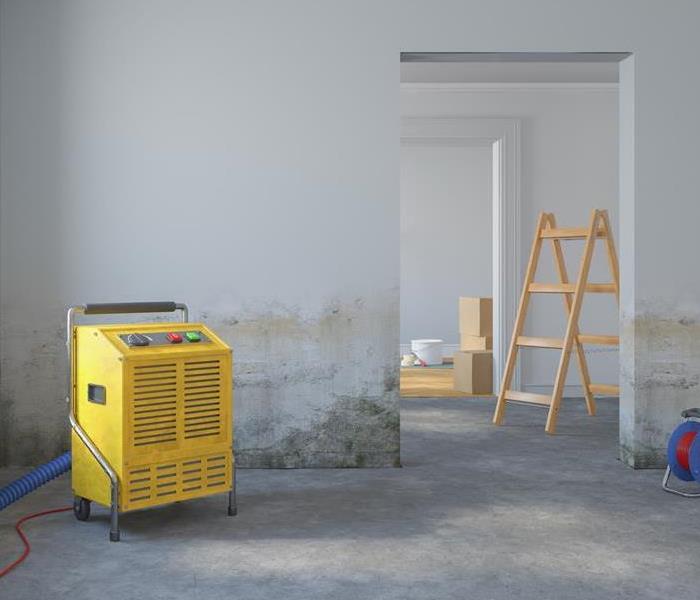 Follow these steps to better understand the scale of water damage restoration efforts.
Follow these steps to better understand the scale of water damage restoration efforts.
Having to deal with water damage is a terrible thing. Not only will you have to do some major clean-up, but you'll also be very frustrated over the costs of fixing your property and the time it takes to get things back to normal. Before you do anything else, you should understand the steps involved in water damage restoration so that all of your bases are covered.
Step 1: Immediate Safety Precautions
When you find water damage, your first step should be to ensure the safety of everyone in the household.
If the source of a water-damage problem is clear, like a pipe leak or flooding from rain or snowmelt, move your family and pets to safety before beginning any clean-up effort. Make arrangements for temporary housing (such as with friends or relatives) while you restore your home.
Before allowing anyone to return to the house, turn off any electric and gas services.
Step 2: Remove Any Excess Water from the Scene
When your home has been flooded, you need to immediately remove excess water. Flooded homes are prone to growing mold and other health issues—and preventing structural damage is essential too! There are several ways to eliminate standing water.
- Ventilating the room by opening windows to facilitate moisture-laden air leaving through evaporation
- Place towels on top of puddles to absorb excess liquid
- Use large commercial fans and dehumidifiers
- Mopping with towels or rags
Step 3: Dispose of Any Items That Cannot Be Restored Due to Extensive Water Damage
Remove any items that cannot be restored due to extensive water damage. This includes books, furniture, clothing, and other belongings. If you can't clean it thoroughly without damaging its quality, throw it away. It is crucial to properly dispose of items that are no longer used to prevent mold growth and illness.
If you are still determining whether an item can be restored or not, consult an expert. The professionals at a restoration company will have the tools and expertise necessary to determine whether your belongings can be saved or not.
Step 4: Drying and Dehumidification
The drying process is the most critical step in water removal. You must thoroughly dry your home to prevent mold growth and health issues. Use dehumidifiers and fans to dry out your property as quickly as possible. If you don't have access to the equipment, consider renting it. Drying times vary depending on your property's type, size, and location.
Step 5: Inspect for Mold
Mold is a common by-product of water damage. It can virtually grow on any surface in as little as 48 hours after a water leak. Mold growth can cause serious health issues and must be removed immediately. A trained professional should inspect your property for mold and other signs of damage, such as dry rot.
Step 6: Cleaning and Disinfecting
Your property will likely smell, especially if the water has been sitting for a few days. You can help eliminate the odor by cleaning your home thoroughly and airing it out.
The cleaning process should include removing all mold and mildew from your property. You should also disinfect all surfaces to kill any remaining mold spores. This will prevent mold growth from recurring.
Step 7: Repair and Restore Your Property
Once the water damage is under control, it's time to start repairs on your property. This may include replacing damaged drywall, furniture, or appliances.
Pro Tip: Hire Professional Restoration Services
If you're unsure how to proceed with cleaning up your water damage, consider hiring a restoration company. These professionals can quickly assess the situation and determine the best course of action. They'll also ensure that any repairs are done properly so as not to cause future issues with mold growth or structural damage.
When disaster strikes and your home is damaged by water, help is just a phone call away. SERVPRO of South and Northwest Grand Rapids will be there for you 24 hours a day, 7 days a week: Call us at (616) 662-9700 with any questions; we're here to help!
The Role of Dehumidification in Mold Remediation
2/27/2023 (Permalink)
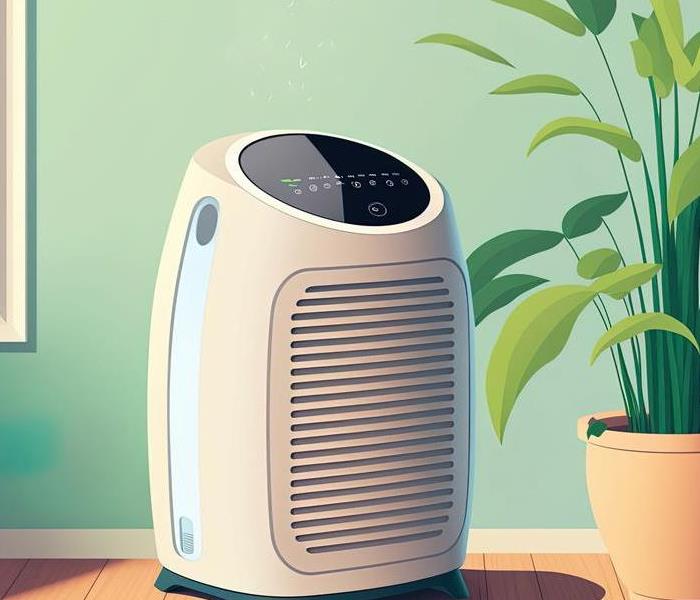 Even a small dehumidifier can be a great start if you want to reduce in-home mold growth.
Even a small dehumidifier can be a great start if you want to reduce in-home mold growth.
Mold is a serious problem that can cause health issues and damage your property. Fortunately, you can control the growth of mold and prevent it from spreading. One of these steps is dehumidification, which helps reduce humidity and moisture levels in an environment to control the growth of mold. In this article, we'll discuss the role of dehumidification in mold remediation and how it can help keep your home or business safe from mold.
What Is Dehumidification?
Dehumidification is an easy process of removing excess moisture from an indoor environment. This can be done through mechanical ventilation, air conditioning, or dehumidifiers. By reducing the humidity in the space, mold growth can be mitigated and even prevented.
How Does Dehumidification Help with Mold Remediation?
Moisture is a key factor that enables mold to form and flourish. Dehumidifiers can reduce the humidity, which can control the growth and spread of mold. It can also reduce the risk of future mold growth by reducing the number of spores in the air. A reduced spore count can help keep the area safe from future mold problems. The fewer spores in the air, the less likely they cause health problems such as allergies and asthma. Dehumidifiers can also help keep the air clean, reducing dust mites and other allergens known as triggers of allergies and asthma.
Dehumidification can reduce the visible signs of mold growth, such as discoloration on walls and ceilings. This can help speed up the remediation process as there will be less need to scrub off visible mold growth. Dehumidification aids in speeding up the drying process, which can help prevent mold growth and reduce the amount of time required for remediation.
If you're dealing with a mold issue, dehumidification can be a helpful tool in the remediation process.
What Other Steps Should Be Taken During Mold Remediation?
In addition to dehumidification, several other important steps should be taken during mold remediation. These steps include identifying the source of the mold, cleaning and sanitizing affected surfaces, and repairing any areas damaged by the mold.
Identify and Address the Source
The most important step in mold remediation is to identify and address the source of the problem. Often, this may involve finding and fixing a plumbing or water leak or finding and addressing any other factors contributing to mold growth.
Cleaning and Sanitizing Surfaces
Once the source of the mold has been addressed, it is important to clean and sanitize all affected surfaces. This should include any areas where the mold is growing and any surfaces that may have been exposed to the spores. It is important to use cleaning solutions specifically designed for mold removal and to follow all safety instructions when using them.
Fan and Venting
Using fans and ventilation systems can help reduce humidity in the space, which can help to inhibit mold growth. It is important to ensure that all fans and ventilation systems are kept in good working order. If any of the fans or systems are not working properly, this can increase the likelihood that mold will grow in the space.
Repair Damaged Areas
Finally, it is important to repair any areas damaged by the mold. This may include replacing drywall, insulation, or other materials compromised due to mold.
It is also important to take necessary precautions to prevent future mold growth. This can include things like making sure water sources are properly sealed and insulated, using air purifiers and dehumidifiers regularly, and ensuring that all areas of the home or business are properly ventilated.
If you're dealing with a mold issue, don't hesitate to contact the professionals at SERVPRO of South and Northwest Grand Rapids. Our experienced staff will help you through any mold remediation project. Call us at (616) 662-9700 with any questions, and our team will be there to help.
The Importance of Expertise in Damage Restoration
2/14/2023 (Permalink)
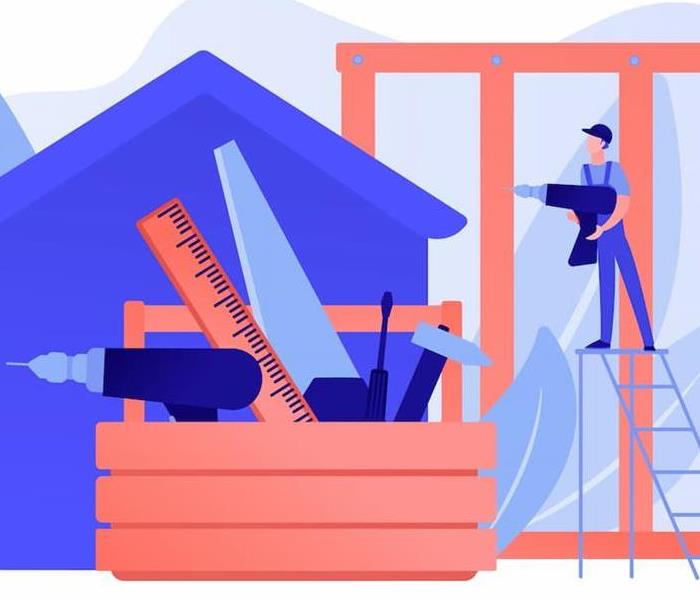 Restoration projects are BIG undertakings that require the right people for the job.
Restoration projects are BIG undertakings that require the right people for the job.
Nothing is more devastating than having your home or business damaged due to a flood, fire, or other unexpected disasters. It's a situation that can leave you feeling helpless and overwhelmed. What are your options? Do you try to take care of the problem yourself or seek professional help?
What is the most important factor when it comes to restoring your property? The answer is expertise. Having the right professionals on board with experience in damage restoration can make all the difference. Here's why hiring an experienced damage restoration company is so important.
The Benefits of Hiring Professionals
When it comes to damage restoration, expertise is essential. Repairing the damage from a disaster requires specialized knowledge and techniques and high-quality materials that can only be provided by a trained professional. A professional damage restoration company will have the right tools and expertise to handle the job properly, minimizing risks and preventing further damage. Furthermore, they will also be able to detect any underlying issues and ensure the job is done right, ensuring you don't have to worry about future problems.
Time Is of the Essence
When restoring damage, time is of the utmost importance, and only a professional can provide timely service. A skilled and experienced damage restoration company will have the resources to handle your project quickly and efficiently, getting you back in your home or business as soon as possible. This will save you time and money by avoiding additional costs that could arise from delays.
Peace of Mind
Hiring an experienced damage restoration company can give you peace of mind knowing that the job has been done properly. A professional team will have knowledge of all aspects of the process, including how to properly assess your property and determine the best approach for repair. They will also have the expertise to handle any unforeseen issues that might arise during the process.
Different Types of Damage That Require Expert Attention
As those intimately familiar with insurance-based damage restoration know, many different types of damages require the attention of an expert. These include flood and water damage, fire and smoke damage, mold remediation, storm and wind damage, sewage backups, biohazard clean-up services, and trauma scene clean-ups.
Finding a reliable professional when these situations cannot be overstated. Water or flooding can cause serious structural damage to your home or business if not handled properly and quickly. Similarly, fire and smoke can cause long-term health risks if not addressed rightly by certified professionals. Mold remediation requires special tools to detect the source and proper removal tools to prevent the further spread of spores. Sewage backups are highly dangerous and require specialized knowledge to properly handle hazardous elements.
Finally, when it comes to trauma scene clean-ups, it is important to find a company with experience in this field and compassion for those affected by the situation.
How to Identify an Experienced Professional for Your Project
It is important to do thorough research when finding the right professional for your project. Make sure the company you choose is experienced in damage restoration and is certified by a reputable organization. Ask them about their services, the process, and any special techniques they use to complete a job. Also, ask them for proof of insurance and references from past customers.
Tips on How to Maintain Your Property after It Has Been Restored
Once the job is done, and your property has been restored, there are some steps you can take to ensure that it remains in good condition. Continue to inspect your property for any signs of damage, such as water spots or mold growth. Make sure that you have regular maintenance done on your property, such as proper cleaning and sealing of surfaces.
Restoring damage can be difficult and overwhelming, but hiring an experienced professional can help you. Knowing that you have experts on the job who are knowledgeable and experienced in damage restoration will give you a sense of relief and peace of mind.
For any questions about the damage restoration process, don't hesitate to call SERVPRO of South and Northwest Grand Rapids at (616) 662-9700. We're here to help you restore your property to its original condition quickly and efficiently. And remember, it never hurts to have an expert on your side.
How to Prevent Mold Growth in Your Business
2/14/2023 (Permalink)
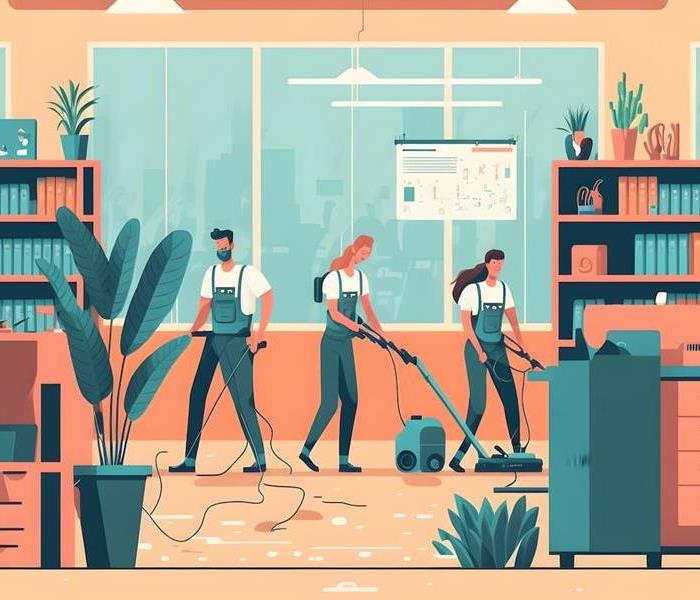 Clean practices and routine general maintenance can reduce mold in heavy-trafficked areas.
Clean practices and routine general maintenance can reduce mold in heavy-trafficked areas.
Mold is an unwelcome guest that can damage your home or business significantly. Not only does mold create an unpleasant smell and unsightly stains, but it can also cause respiratory problems and other serious health issues. To prevent mold from taking over your space, you can take these simple steps to create a less hospitable environment for this unwanted visitor.
Control Humidity Levels
High humidity levels in your business property can create an ideal environment for mold to thrive. To prevent this, check your humidity levels regularly and adjust accordingly. It's important to keep the humidity inside your business at no more than 50%. You can reduce humidity levels with dehumidifiers, air conditioners, and ventilation systems.
If the humidity levels are too high, use a dehumidifier and/or air conditioning to reduce it. If necessary, open windows to allow air to circulate. Additionally, inspect your plumbing system and fix any leaks or seepage that may have occurred.
Clean Up Spills and Leaks Promptly
Molds thrive in wet or damp environments, so it's important to immediately clean up any spilled liquids, such as water or food. Be sure to disinfect the area with a dry cloth and hot soapy water. If you have a large spill, it's best to call in professional cleaners. If you suspect your property may be leaking, call a plumber immediately to fix the leak and prevent further damage.
Maintain Good Ventilation
Good ventilation is key to preventing mold growth. Try to ensure that there is enough airflow going through the areas of your business. Open windows when possible and use fans to help circulate air when needed. Consider installing an air purifier or dehumidifier to help with ventilation. Doing this will help reduce the moisture levels in your home or business and make it less conducive to mold growth.
Keep Areas Dry and Clean
Mold loves dampness and dirt, so it's important to keep areas clean and dry where mold is likely to grow. This includes bathrooms, kitchens, basements, and other areas that are prone to humidity.
Make sure to mop up any spills or leaks quickly and thoroughly. Also, keep surfaces dry and clean by using anti-fungal solutions or bleach.
Replace Rugs and Carpets Regularly
Rugs and carpets are particularly vulnerable to mold growth. To prevent this from happening, it's important for them to do it regularly. If your carpets or rugs show signs of mold growth, dispose of them properly and replace them.
Use Mold-Resistant Paints
Mold can grow on walls, ceilings, and other surfaces if the conditions are right. To prevent this, it's a good idea to use mold-resistant paints when painting your home or business. These paints are designed to resist mold growth and make it less likely for mold to take hold of your property.
Disinfect Hard Surfaces
Hard surfaces, such as counters and floors, can be breeding grounds for mold if not disinfected regularly. To keep mold away, use an anti-fungal solution to clean and disinfect these surfaces. Doing this will help kill any existing mold and prevent new mold from growing.
Keep Gutters Clean
Clogged gutters can also create an ideal environment for mold to grow. To prevent this, clean your gutters regularly and check for any blockages that may have occurred due to debris or leaves. A blocked gutter can cause water to pool and create the perfect breeding ground for mold.
Preventing mold growth in your home or business is not easy, but with the right measures in place, you can make it less likely for mold to take hold. Check your humidity levels regularly and prevent moisture build-up in areas where mold is likely to grow. Also, use mold-resistant paints and disinfect hard surfaces regularly.
If your business suffers from a mold problem, it's best to call in a professional mold remediation service. This is especially important if you find that the mold is widespread or has been causing structural damage to your property. A professional company will be able to inspect the property and advise you on the best course of action.
If you have any questions or need help in preventing mold growth in your business, contact SERVPRO of South and Northwest Grand Rapids at (616) 662-9700. We're here to help!
The Benefits of Professional Fire Damage Restoration
2/10/2023 (Permalink)
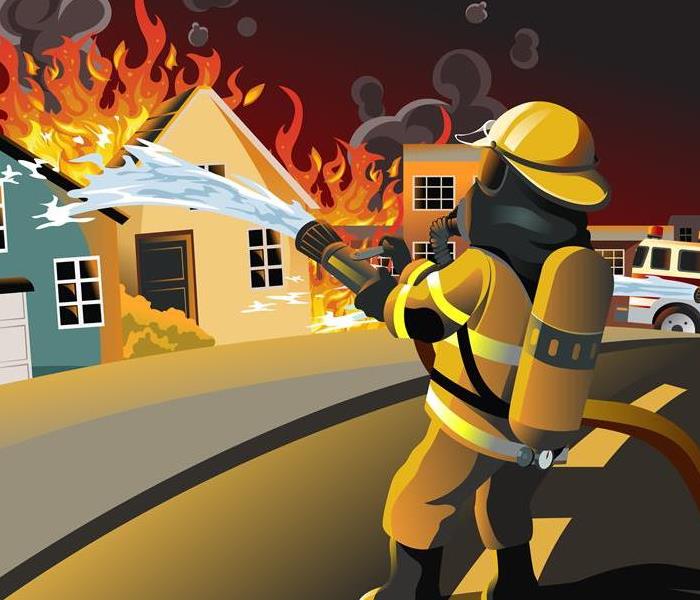 Fires attract two types of professionals. Firefighters and damage restoration experts.
Fires attract two types of professionals. Firefighters and damage restoration experts.
What goes through your head when you think of professional fire damage restoration? For most people, it's going to be negative thoughts. They are going to think about how much time and effort it will take, and many will overlook the benefits of hiring a professional fire damage restoration service.
The truth is that professional fire damage restoration services can be highly beneficial. They have the experience and equipment needed to handle the situation quickly and efficiently, so you don't have to worry about it as much. Here are a few benefits of hiring a professional fire damage restoration service.
Quick Response
Fire damage restoration professionals understand the situation's urgency and respond swiftly to your requests. They have the experience and equipment needed to handle the problem quickly, so you don't have to worry about it as much.
Expertise
Professionals know what to do in case of fire damage, so you don't need to spend hours researching how to handle it. They also understand the importance of following regulations and laws regarding smoke damage from fires, which means they'll also be able to guide you through the process.
After inspecting the damage, trained professionals will create a plan for cleaning and repairing.
Knowledge of Local Regulations
Many businesses have employees licensed in fire restoration techniques and know how to work within local regulations regarding cleaning up after fires caused by electrical or other types of fires. This knowledge can help keep your home compliant with local laws regarding clean-up after a fire has occurred in your home or office space.
They Can Help You Save Your Belongings
Professional fire damage restoration services understand what's essential in your home and can help you save those items. They have the equipment needed to dry out areas quickly without causing damage to the surrounding area. This means that they can help keep mold from spreading throughout your property.
Access to Specialized Equipment
Smoke damage from fires can cause severe damage to your home, including the air ducts. This means that you'll need specialized equipment to clean it up properly. Professionals will have access to this type of equipment, allowing them to get rid of smoke odors more quickly and thoroughly than if they had to rely on household items alone.
These companies have a network of professional cleaning technicians trained to provide high-quality fire damage clean-up services. They will be able to remove smoke, soot, and other debris from your home or business. You can also trust these professionals to dispose of any hazardous materials that may have been released during the fire, such as asbestos or petroleum products.
Help File an Insurance Claim
If your home or business has been damaged by fire, you may need to file an insurance claim. A professional cleaning company will be able to advise you on the steps you need to take when filing an insurance claim for damages caused by a fire.
A professional fire damage clean-up company can help ensure that your claim is processed quickly and efficiently so that you can begin rebuilding your home or business.
Thorough Post-Inspection
A fire damage clean-up company will thoroughly inspect your home or business for any remaining smoke or fire damage after completing the cleaning process. Post-fire clean-up is a complex process that requires specialized equipment, training, and knowledge.
Help Is Available Round the Clock
When disaster strikes, time is of the essence. The professionals at fire damage restoration companies are available 24 hours a day, 7 days a week. They can respond quickly to any situation and control things before the damage worsens.
We at SERVPRO of South and Northwest Grand Rapids share the same commitment to quick response times. We have a team of technicians who are ready to respond 24/7 to any type of fire damage emergency. We can get to your property quickly and start working on the restoration process. Give us a call at (616) 662-9700 with any questions!
Why Use Professional Equipment in Damage Restoration
2/3/2023 (Permalink)
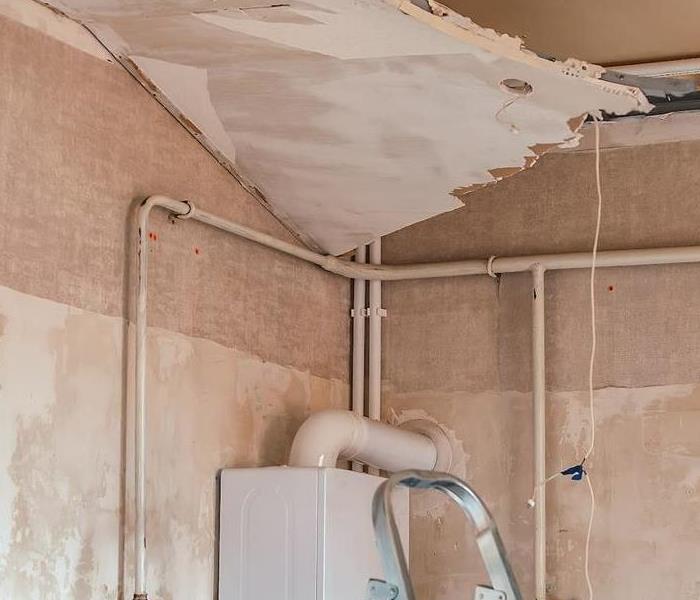 There are no shortcuts to repairing damaged walls, ceilings, and foundations after a disaster.
There are no shortcuts to repairing damaged walls, ceilings, and foundations after a disaster.
Cleaning up after property damage is time-consuming and labor-intensive. It takes significant effort to remove the flooring, clean it, and remove the rotten wood. If your home has minor water or fire damage, you can do the clean-up yourself. However, dealing with significant damage on your own is impossible without using professional equipment by technicians.
Property damage necessitates thorough clean-up. However, if the proper tools are not used, the process can cause more damage or take longer.
Professionally qualified experts with the necessary training, expertise, and equipment would ensure that the damages were properly restored. This will also ensure that the restoration process proceeds quickly and easily.
Professional Equipment Used for Damage Restoration
Repairing property damage requires a wide variety of specialized tools, some of which are listed below.
- LGR Dehumidifiers
Low Grain Refrigerant dehumidifiers use cutting-edge technology to achieve rapid drying. After a conventional dehumidifier has reduced humidity to about thirty percent, an LGR dehumidifier completes the task. These dehumidifiers yield dryer, breathable air by cooling the input air. They also speed up the restoration of damaged areas and use far less energy than other dehumidifiers.
- Air Movers
Air movers are the best way to dry wet flooring, including carpets. Unlike a fan, an air mover concentrates airflow at ground level. Air is immediately blown over the floor, allowing water molecules to evaporate quickly. Professionals use air movers for thirty-minute cycles. The majority of the water on the floor evaporates within a few hours.
Experts use additional tools for water removal, water damage assessment, soot, and debris removal, as well as deep cleaning.
- Equipment for Air Purification and Moisture Removal
Moisture removal is critical for fire recovery. Homes that have been burned may be prone to water damage, and the longer the moisture remains, the worse the damage. Restoration teams routinely use dehumidifiers to remove moisture from the air; they also have additional equipment to help with air quality on the job site. Air movers work to route air to dehumidifiers, while negative air machines remove impurities from the air.
- Vacuums
Another method used by restoration professionals is vacuuming soot and other hazardous materials. Most of the time, clean-up crews use properly graded shop vacs to remove smoke and other dangerous compounds from affected areas. However, these specialists also use vacuums to clear areas of moisture and water. In extreme cases, they could extract standing water with truck-mounted vacuums. This can sometimes include powerful shop vacs known as extractors, which can draw moisture from carpets and wood.
It is critical to be prepared when damages occur. Contact SERVPRO of South and Northwest Grand Rapids restoration specialists at (616) 662-9700. We have property damage experience and will help restore your home to its preloss condition.
Benefits of Damage Restoration
- It Saves Time and Money
It takes time and money to complete a home renovation project on your own. However, working with a professional who uses specialized equipment for damage restoration can save you time and money. Professionals stick to a schedule and use proper tools to help and speed up their work.
- It Keeps Your Belongings Safe
You have to do what you can to keep as much of your property's contents as possible. You must hire experienced damage restoration services to protect your valuable asset, the building. Because these experts work quickly, valuable items like important documents, jewelry, and family heirlooms can be saved.
Hire a Professional
Hiring a reputable restoration company will prevent long-term damage. They will help you remove damaged areas of your home so that you don't have to make as many repairs in the future.
If you live in the area, please call SERVPRO of South and Northwest Grand Rapids at (616) 662-9700. We are here to help you with the restoration process.
We have experienced specialists who are highly skilled and equipped with the tools to complete thorough property damage repair and restoration.
The Benefits of Professional Water Damage Restoration
1/30/2023 (Permalink)
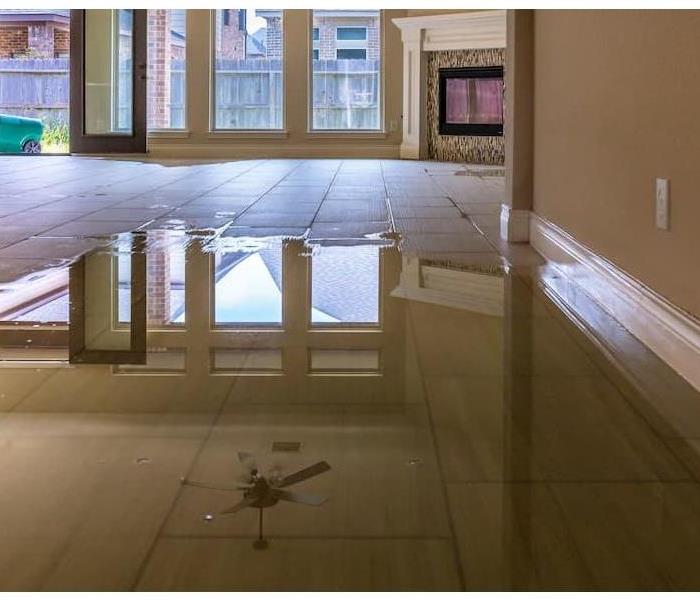 Call a professional any time you see standing water where it shouldn't be. There's likely a bigger problem than you realize.
Call a professional any time you see standing water where it shouldn't be. There's likely a bigger problem than you realize.
Water damage can be a real problem in your home. It can create mold growth, structural damage (wood rot, peeling paint, and other problems), and cause electrical shorts. These risks will lead to more expenditure in the long run — think drywall patches, diverting electrical wires, or even replacing furniture or appliances.
However, if you act quickly enough after experiencing water damage, you can avoid this added expense, not to mention the hassle of cleaning up the aftermath of water damage.
Quick Restoration
Professional water damage services can respond immediately in the event of a flood or other major water damage event. They can also help you restore your property to its original condition, helping to prevent further damage and costly repairs over time.
Professional water damage companies can help you assess the damage and determine the steps you need to take. They also offer preventative measures for future flooding events, so you know your property is protected from further damage.
Safe Mold Remediation
Once water finds its way into your home, mold can develop in as little as 24 to 48 hours. Mold can grow virtually anywhere, from the ceilings to beneath wooden siding. It would be risky for you to try removing mold by yourself since most molds are toxic or irritating allergens.
A professional water damage restoration service can eliminate mold and prevent a recurrence. Water restoration companies ensure that the surfaces are dried and dehumidified to avoid mold infestations. They also use air filtration equipment and employ treatment in an effort to keep growths from recurring.
Lower Structural Damage
Water damage can cause major structural damage to your home by weakening the foundations, damaging walls, and ceilings, and destroying electrical wiring. If your home has been flooded, you should not attempt the clean-up yourself. Not only is it dangerous, but you also run the risk of damaging your home further.
Professional restoration services use specialized equipment and training to safely remove water from your property without causing additional damage.
Prevent Electrical Shorts
The combination of water and electricity can create a dangerous situation. Water can cause electrical shorts by shorting out your home's electrical appliances, equipment, and wiring. This is extremely dangerous because it can lead to fires that can destroy your property and put you at risk of injury or death.
The best way to prevent this from happening is by calling professional restoration services after you experience a flooding incident. The restoration team will evaluate the damage and determine whether the items can be salvaged or must be replaced due to permanent damage caused by liquid exposure.
Help with Insurance Claims
Insurance companies are only sometimes willing to pay for all the repairs needed after a flood or burst pipe. This is where professional services come in handy.
They can provide an estimate of what it would cost to repair everything yourself, then compare it to what they'd charge for the same job if they did all the work themselves. If their estimate is lower than yours (and most likely, it will be), you'll have a better chance of getting your claim approved.
Unfortunately, no one is immune to water damage. Whether the problem is a burst pipe or a broken appliance, it's just one of those things that can happen to anyone. If you experience water damage, you can be sure that a professional restoration company will respond quickly and work around the clock to remedy the problem.
When your home is damaged by water, you need help fast. SERVPRO of South and Northwest Grand Rapids can help. We are available 24 hours a day, 7 days a week. Give us a call at (616) 662-9700 with any questions; we're here to help!
The Steps Involved in Fire Damage Restoration
1/26/2023 (Permalink)
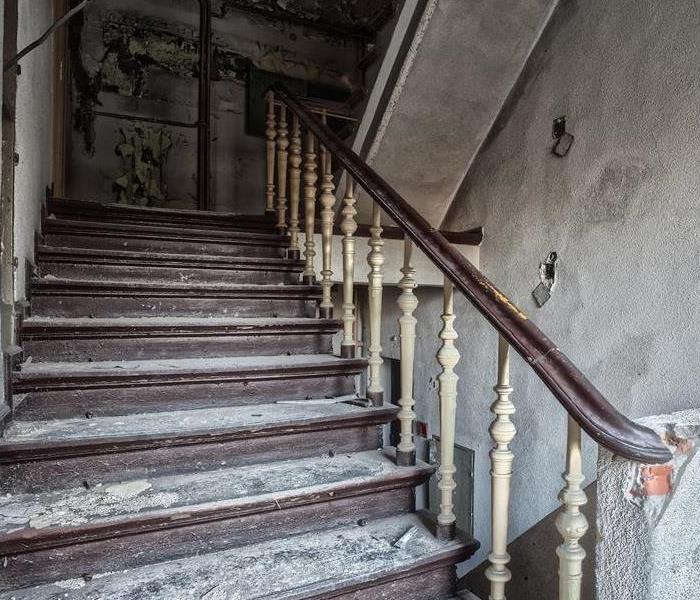 Fire damage cleanup isn't as simple as picking up debris. There's a process that's proven and effective.
Fire damage cleanup isn't as simple as picking up debris. There's a process that's proven and effective.
Fire damage restoration is a process that cannot be rushed. Although the damage caused by fire can be worked on directly, it requires a lot of patience and planning. When it comes to fire damage restoration, understanding the process is essential, which will allow you to decide when professional help should be sought. The following is a rough guide to the process of fire damage restoration.
Step 1: Assessment of Damage
The first step in the fire damage restoration process is to assess the damage. A technician will inspect your property and give an estimate of how much time it will take for the restoration process to be completed, as well as its cost.
Although some homeowners choose to do the renovation themselves, hiring a fire damage restoration company capable of catching problems you might not notice is smart.
Step 2: Isolation
A home should be secured before beginning any renovations to prevent additional damage that might occur due to holes, weakened beams, or other structural problems.
Home renovation experts may reinforce structures and secure open doors, windows, or roofing structures by tarping them. Depending on the property's size, this process may take a few days or extend over weeks.
Step 3: Water Assessment and Removal
In many cases, water is used to extinguish a fire during the course of putting it out. Inspection for water damage and drying the interior of a house may precede cleaning up debris. This can be a delicate process, as water can cause damage to the structure of a house. The home inspector will look for signs of flooding, like standing water in the basement or ground-level floors.
Fire damage restoration companies employ industrial-sized dehumidifiers and air movers to dry your premises. This lowers the chances of mold production and helps to prevent structural damage.
Step 4: Smoke Removal
The longer smoke is allowed to linger, the more damage it can cause. The smoke can cause severe respiratory problems and discoloration of walls and ceilings. Smoke damage restoration is a specialized service that requires special equipment, training, and experience.
It is important to remember that smoke damage restoration is not the same as smoke cleaning. Smoke cleaning involves removing soot from surfaces, while smoke damage restoration involves restoring the damaged areas to their pre-fire condition. It also involves removing odors, which can take some time and effort.
Step 5: Cleaning and Sanitation
After the smoke damage restoration process, it is crucial to thoroughly clean and sanitize the area. This step ensures that no bacteria or mold remains in your home or business. For this step, commercial-grade equipment and the knowledge and expertise to use it properly are required.
Step 6: Repairing and Renovations
After the smoke damage restoration process is complete, it is essential to repair and renovate the damaged areas. This step ensures that your home or business looks as good as new after a fire. You may need help from a professional contractor with this step if the damage is extensive.
Step 7: Preventative Measures
In addition to the above steps, it is essential to take preventative measures to avoid future fires in your home or business. This step can be done on your own by checking smoke detectors and updating any faulty wiring or equipment.
You can also help prevent fires by keeping an eye on your heating system, ensuring that it is properly maintained and inspected by a professional.
Step 8: Claiming Insurance
You should contact your insurance company as soon as possible to file a claim. They will send an adjuster to review the damage and determine how much you are due for reimbursement.
Sometimes, fire damage is hard to spot. Often the people most affected by fire damage are distracted by other things. That's why it's always essential to have a professional look over your property after a fire to help you understand what you're dealing with and what your next step should be. SERVPRO of South and Northwest Grand Rapids is ready to help with any fire damage needs that you may have. To speak with one of our professionals, call us at (616) 662-9700 today.
What Is Considered Storm Damage to a Roof?
1/13/2023 (Permalink)
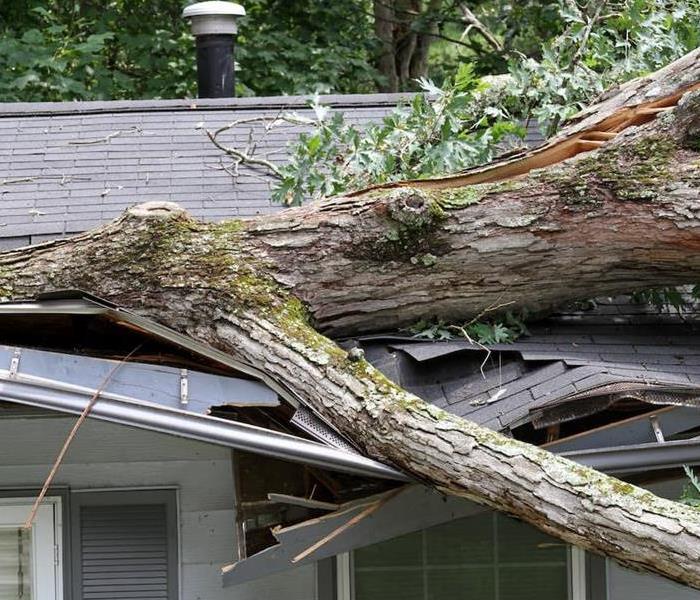 Some signs of storm damage are more apparent than others.
Some signs of storm damage are more apparent than others.
When severe weather strikes, the damage to your house can be extensive. Without a proper assessment, it's impossible to know the extent of the damage. One area that is particularly vulnerable to storm damage is the roof. Knowing what constitutes storm damage to your roof can help you understand what kind of repairs you need to make and how urgent the situation is.
What Are the Signs of Storm Damage?
When assessing storm damage to your roof, several indicators should be considered. Hail damage is one of the most common indicators of roof damage, as hail can cause dents or punctures in shingles. Wind damage can also be a sign, as strong winds can easily tear off or lift shingles. Additionally, look for signs of water damage, such as water stains or water leaking inside your home.
It's also important to inspect the interior of your home for signs of roof damage, such as cracked or bubbled paint, stained ceilings and walls, and musty smells. If you notice any of these signs, it's important to call for help as soon as possible.
Some signs to look out for include:
- Missing or broken shingles
- Evidence of water infiltration
- Visible dents or gouges in the roof
- Exposed nails or other hardware on the roof surface
- Loose or missing seals around vents, chimneys, and skylights
- Trees or other debris that have fallen on the roof
- Flashing that has become loose or detached.
Remember that some of these indicators may not be immediately apparent. That is why it's important to have a trained professional evaluate your roof after a storm event.
What to Do after Storm Damage
If you suspect that your roof has suffered storm damage, it's essential to take action immediately. Even if you think the damage is minor, waiting too long can lead to more costly repairs.
The first step is to contact a qualified roofing contractor who can assess the damage and provide an estimate for repairs. Make sure the contractor has experience in dealing with storm-damaged roofs, as they will be able to recognize potential issues that are not always obvious.
Once the damage has been assessed, the contractor can recommend repairs or replacement of the affected areas. If repair is necessary, they can estimate the cost of the repairs.
In some cases, however, a full roof replacement may be necessary. If this is the case, getting several estimates from different contractors is crucial to ensure you get the best deal.
Repercussions of Unrepaired Storm Damage
If left unaddressed, storm damage can further damage your home's roof. Fallen trees and debris can cause holes in the roof, allowing water to seep in and accumulate, which can increase the risk of mold growth. Mold can spread quickly and cause health issues such as respiratory and allergen problems to those living in the home, even if they are not directly exposed to the mold.
In addition to health issues, mold can cause further structural damage leading to costly repairs down the line. Strong storm winds can cause shingles to erode, leading to water damage in the attic and other areas. Water damage can also cause roof deterioration, leading to additional repairs and even replacement if not taken care of promptly.
It's important to contact a professional roofing company as soon as possible after a storm to inspect and assess the damage and make any necessary repairs.
At SERVPRO of South and Northwest Grand Rapids, we're experienced in helping homeowners assess and repair storm damage. We use the latest technology to quickly and efficiently inspect your roof, evaluate the damage and recommend a course of action. If repairs are necessary, our team of professionals will get the job done quickly and affordably.
Don't let storm damage go unchecked; contact SERVPRO of South and Northwest Grand Rapids at (616) 662-9700 with any questions; we're here to help!
Common Causes of Fire Damage in Business Spaces
1/13/2023 (Permalink)
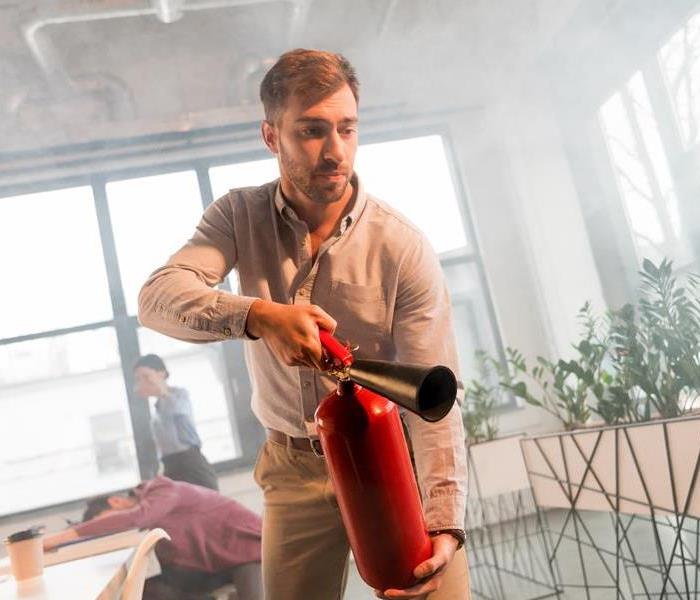 Watch out for various fire or smoke hazards, especially in office settings where not everyone is trained on how to handle a scary situation.
Watch out for various fire or smoke hazards, especially in office settings where not everyone is trained on how to handle a scary situation.
Fire is a destructive force that can cause irreparable damage to homes, businesses, and lives. While the causes of fires vary across different settings, understanding common fire risks in your business can help you protect against them. This article will look at some of the most common causes of fire damage in commercial buildings.
Electrical Hazards
Electrical hazards are the most common cause of fire damage in homes and businesses. This includes faulty wiring, overloaded outlets, faulty or outdated appliances, frayed cords, and exposed wires.
These issues can cause an electrical fire that can quickly spread if not addressed immediately. Electrical fires are often hard to detect and can do significant damage without being noticed. It's important to regularly inspect your business wiring, appliances, and cords to ensure everything is in good condition and up to code.
Cooking Fires
Another common cause of fire damage is cooking fires. These are often caused by unattended appliances, grease build-up, combustible items being too close to the stove or oven, and faulty thermostats or wiring. It's important to ensure all of your cooking appliances are in good working order and that you never leave them unattended. Grease build-up should also be regularly cleaned to reduce the risk of fire.
To reduce the risk of cooking fires, never leave food unattended while cooking. It's also important to keep combustible items, like paper towels and cooking utensils, at least three feet away from the stove or oven. Finally, ensure your thermostats and wiring are routinely inspected.
If you experience a cooking fire, it's important to evacuate the house immediately and call your local fire department. If you have fire extinguishers in the home, they can help put out small fires. Otherwise, it's best to leave the house and call for help.
Heating Systems
One of the most common causes of fire damage in businesses is heating systems. Inadequate or poor maintenance can lead to fires due to the build-up of lint and other debris in dryer vents, chimneys, and furnace ducts. These combustible materials can easily ignite and cause a dangerous fire if left unchecked; therefore, cleaning them is important to reduce the fire risk.
Additionally, space heaters can also be a major cause of fire safety concerns. Space heaters that are not regularly maintained and inspected and placed too close to combustible materials such as furniture, curtains, or bedding can easily cause a fire. It is important to keep an eye on the placement of space heaters and regularly maintain and inspect them for any signs of damage or malfunction.
Irresponsible Use of Candles
Candles are often used for decoration and to set the mood, but they can also be a major source of fire damage in businesses. Candles should only be lit when a responsible adult is in the room and must be extinguished before leaving the area. Additionally, never place candles near combustible materials as they can easily catch fire.
Smoking
Smoking is one of the most common causes of fire damage in businesses. It's important to never smoke indoors as the ashes, cigarette butts, and lighters can easily start a fire. It's also important to ensure that smoking materials are always disposed of properly and never left unattended.
It's imperative to be aware of the common causes of fire damage in businesses and to take the necessary steps to prevent them. Regularly inspect your wiring, appliances, heating systems, and smoking materials, and practice responsible candle use.
If you experience fire or smoke damage, contact SERVPRO of South and Northwest Grand Rapids at (616) 662-9700 for help. We are here to help you get back on your feet after a fire and ensure that your business returns to how it was before. Our experienced professionals are available 24/7, so do not hesitate to call us with any questions.
Save Your Documents after Water Damage
12/27/2022 (Permalink)
 Certain documents can be replaced, but keepsakes require special care.
Certain documents can be replaced, but keepsakes require special care.
It is possible to save and restore water-damaged documents by using various techniques. When faced with a disaster like water damage, it's absolutely necessary to recover any physical documents you own first.
Documents that have been damaged by water need specific drying procedures. Some of the techniques that can be applied are air-drying, freeze-drying, desiccant dehumidifying, and even hand-dry cleaning. These techniques are able to restore photos, business records, and other vital documents not easily replaced. So don't be discouraged if you find your documents wet and soggy. Here are a few tips and techniques to help you save documents after water damage.
How to Dry Loose Sheets
If your papers are wet, you must gently remove them from the water as soon as possible. Be extremely careful while removing them since the papers can easily tear. If the papers have become dirty, clean them using wet tissue paper. Place the individual papers on a plain paper towel - the paper towel must be thick and plain. The wet papers might absorb the print from the paper towel if it isn't plain and could stick to them. Place the documents near an air source such as a fan.
You can also place them under direct sunlight to speed up the process but make sure there isn't any wind. You could also use blotting paper to dry damp spots. Another option is to place them in a freeze dryer to fast-track the drying. Keep changing the drying paper beneath to prevent the papers from sticking together, and hang them up after substantial drying to treat the backside. You can also keep the documents or books in the freezer after placing them in plastic zip locks; this preserves the pages and prevents mold growth.
How to Dry Books
Drying books is a little harder than drying individual sheets of paper, especially if the book is hardbound. Place paper towels between the wet pages and lay the book flat or upside down to facilitate airflow. You can't put paper towels between every page, so place them continuously wherever the pages are most wet. For the other pages, place paper towels between every 20 pages or so. Use a fan to speed up the drying process.
Do not use hot air since it can lead to tearing. Do not keep your book outside since it might curl due to the wind. You can place paper weights on the edges to prevent curling or folding edges. Replace the wet paper towels regularly. If the book smells unpleasant after drying, place it in a closed container with baking soda or odor absorbents. But ensure the powder doesn't touch the book or papers directly.
How to Dry Photos
When drying wet photos, gently remove the photos from the wet area. Clean them using wet tissue paper dipped in cold water. Be careful not to smudge the photos. Place them on a plain paper towel and away from direct sunlight. You can use a fan or desiccant dehumidifier to speed up the process. Once the pictures have dried a little, hang them up to dry the backside. If you're unable to dry them yourself or want to preserve them for longer, consider professional drying that will help with complete restoration.
Drying water-damaged papers, books, documents, and photos is a fairly simple process. Handling the papers with care and taking immediate action will make it easier to restore them. If you ever find yourself in a situation needing to recover water-damaged papers, keep the tips we've given in mind.
When you notice something out of the ordinary, call SERVPRO of South and Northwest Grand Rapids at 616-662-9700. Our professional team will help you with your document recovery.
Benefits of Installing a Dehumidifier
12/20/2022 (Permalink)
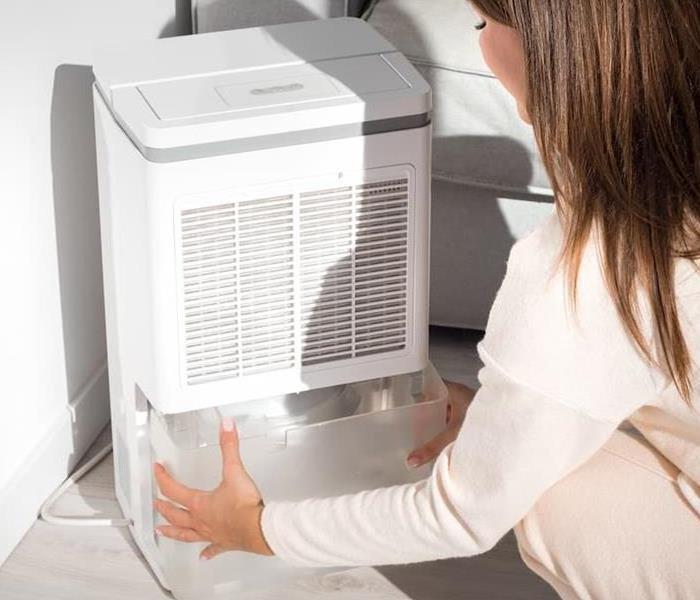 Dehumidifiers can be great proactive solutions against the buildup of mold and mildew.
Dehumidifiers can be great proactive solutions against the buildup of mold and mildew.
When you think of a dehumidifier, you probably think of an appliance that helps remove excess moisture from the air to prevent mold and mildew growth. But did you know installing a dehumidifier in your home has many benefits? Let's look at some of the benefits of dehumidifiers:
Reduces Allergens in the Air
One of the benefits of dehumidifiers is they help reduce allergens in the air. If you suffer from allergies, installing a dehumidifier in your home reduces the number of allergens in the air, making it easier for you to breathe.
Reduced Condensation
One of the most common problems caused by high humidity is condensation on windows and walls. When the air is saturated with moisture, it condenses on surfaces cooler than the air, such as glass or metal. This condensation can lead to water damage and mold growth.
A dehumidifier reduces condensation by removing moisture from the air, creating a drier environment less likely to cause condensation.
Improved Air Quality
High humidity also leads to musty odors and dust mite infestations. Musty odors are caused by mold and mildew growth, which thrive in humid environments. Mold and dust mites can cause respiratory problems, like asthma.
It's essential to keep the air quality high, especially if you have infants or elderly family members living in your home.
Installing a dehumidifier helps remove musty odors and reduces dust mite populations, improving air quality.
Reduced Energy Costs
Running a dehumidifier reduces your energy costs. Since humid air feels warmer than dry air, you might be tempted to turn down your thermostat to compensate. However, this will only lead to higher energy bills.
Dehumidifiers help remove the extra moisture from the air, making it feel cooler and reducing the need to lower the temperature.
Extended Life for Your Home
Your home can also be damaged by high humidity. Wood materials, like flooring, furniture, and trim, can swell and warp when exposed to excessive moisture. Paint and wallpaper peel and blister in humid conditions, and drywall can weaken, sag, and crumble. These problems can be expensive to repair and even require completely replacing certain materials in your home.
A dehumidifier can help protect your home by reducing the moisture in the air. Keeping humidity levels at a comfortable level, you help extend your home's life and avoid costly repairs.
Fewer Pests
Pests like cockroaches, ants, termites, and rodents are attracted to moisture. If your home is humid, you will more likely have an infestation. Reducing the humidity in your home makes it less inviting for these pests. In addition, if you do have pests, they are easier to get rid of if your home isn't as humid.
Reduced Risk of Mold and Mildew
Mold and mildew thrive in humid environments and cause several problems, including respiratory issues, skin irritation, and allergic reactions. In addition, mold and mildew can damage your home, causing peeling paint, warped wood, and crumbling drywall.
A dehumidifier creates an inhospitable environment for mold and mildew, reducing the risks.
Healtheir Plants
Too much moisture can be harmful to your plants. While they need water to survive, they can suffocate and drown in too much of it. Excess moisture in the air encourages mold and mildew growth, harming your plants. Using a dehumidifier helps create the perfect balance of moisture in the air for your plants, keeping them healthy and happy.
Installing a dehumidifier provides many benefits for your home and your health. By reducing the amount of moisture in the air, you create a more comfortable environment and avoid problems like water damage, mold and mildew growth, and pest infestations.
If you struggle with high humidity levels, consider investing in a dehumidifier. For professional help with your indoor air quality, contact SERVPRO of South and Northwest Grand Rapids at 616-622-9700. We're always here to help.
4 Most Common Causes of a Kitchen Fire
11/28/2022 (Permalink)
 There are many causes of kitchen fires, including burning food, poor electrical outlets, and inattentiveness.
There are many causes of kitchen fires, including burning food, poor electrical outlets, and inattentiveness.
A kitchen can be a dangerous place if you are not cautious. Most of us cook every day in the kitchen and deal with various electrical appliances near a water source and heating elements.
Kitchen fires are usually how a home fire starts, so it can be very alarming when something catches on fire while you just want to fix yourself a meal. Here are the most common causes of kitchen fires so that you're prepared to avoid them.
Most Likely to Cause a Kitchen Fire
Cooking Accidents
Taking your eyes off your food while cooking is not a good idea. Unattended cooking is the leading cause of kitchen fires, accounting for more than half of all home fires.
So, it is important to always stay in the kitchen when you're cooking. If you feel tired or out of it, this is one case when ordering takeout is not only the healthier option but the most responsible one, too.
Electrical Problems
Malfunctioning appliances or faulty wiring are the second leading cause of kitchen fires. Be especially careful with old appliances, as wires can become loose and break.
Electrical fires are especially dangerous because everyone's first instinct when dealing with a fire is to pour water over it. This is a big mistake because water conducts electricity!
The first thing you should do is unplug the appliance if it's plugged in. Then smother the flames with fistfuls of baking soda. If this didn't put out the fire, call emergency services immediately.
Make sure to properly maintain your electrical appliances so that this doesn't happen. A good habit to get into is not to overload circuits with too many appliances plugged in at once.
Candles
Candles are one of the leading causes of house fires, usually because people underestimate the damage they can cause. Lit candles, especially when left unattended, can set fire to the whole house.
Exercise caution with lit candles, especially near flammable materials like curtains or towels. It's also not advisable to put a candle in a drafty spot, like by a vent or a window, on a windy day.
Don't burn a candle for longer than 4 hours, and never leave it unattended. This is especially important if you have children or pets in the house.
Kids Playing with Fire
Adding to the last point, kids often start kitchen fires by playing with matches or lighters they find around the house. A child's natural curiosity can put them at risk.
They're too young to know any better, so it's on the adults to supervise them and teach them about fire safety. Children are usually fascinated by fire, so they won't immediately call out for help if they accidentally cause one.
They associate fire with birthday candles and fireworks and don't realize how scary they can be until they potentially get hurt. They also tend to play with fire in hidden, enclosed places because they may have been told it's wrong. You can see how this can be disastrous.
If you have a child in the house, educate them about fire safety as soon as possible. Teach them about the dangers of fire, and that matches, lighters, and heating elements in the kitchen aren't toys.
Call Fire Damage Professionals
Kitchen fires are scary, but once the damage is done, you'll want your old kitchen back. After all, a kitchen is one of the most useful rooms in a house.
We at SERVPRO have been doing fire damage restoration for years. Call us, and we'll make sure that not the slightest trace of smoke or soot is left in your home. We're available 24/7 to restore your home back to its unblemished state.
Don't Mask Bad Odors, Stop Them at the Source
11/21/2022 (Permalink)
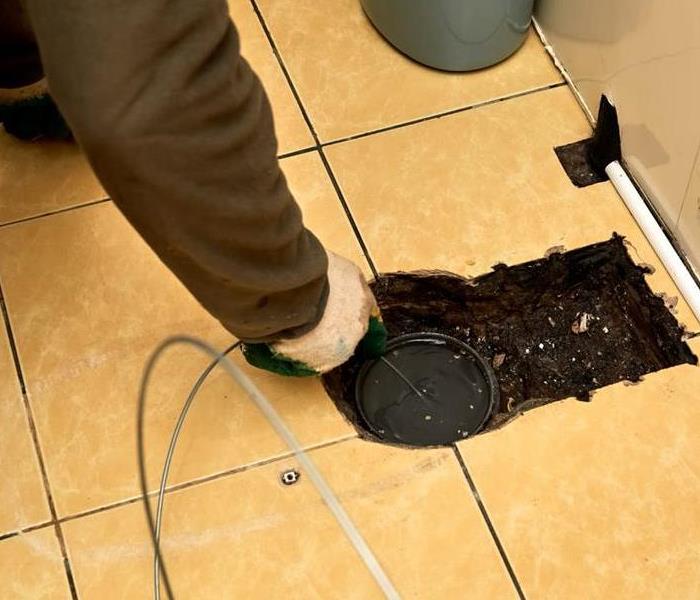 Sewer line inspections can help prevent disaster, and stops bad smells from permeating in your home.
Sewer line inspections can help prevent disaster, and stops bad smells from permeating in your home.
Maybe you just moved into a new place and can't figure out where the weird smell is coming from. Or, maybe you've lived in your home for years, and it's time to do some deep cleaning. Either way, removing foul odors can be tricky. But don't worry - we're here to help. We'll give you some tips and tricks for getting rid of offensive smells in your home, so you can feel confident about inviting friends and family over.
Get Rid of Sewer Smells
When you notice a foul odor in your home, it's important to figure out where it's coming from and how to get rid of it. Sewer smells are one of the most common unpleasant odors and can be tricky to dispose of. You can do a few things to eliminate the smell if you think it is coming from your sewer line. First, check all your drains and ensure they're clear. If that doesn't solve it, pour a cup of bleach down the affected drain. If the odor persists, call a plumber to inspect your sewer line. Getting rid of foul odors in your home is important for your comfort and health, so immediately taking care of smells will keep your home smelling fresh and clean.
Clean Your Pet
When your pet has a bad odor, cleaning them as soon as possible is important. Not only will this remove the foul odor, but it will also prevent your pet from becoming sick. The odor from your pet will cling to household objects and furniture if not removed immediately. Give your pet a good shampooing with a mild soap. You could also rinse them with diluted vinegar or hydrogen peroxide if the odor is very intense.
Eliminate Mold and Mildew Odor
No one likes a smelly home. When trying to get rid of foul odors, it's important to deal with mold and mildew. These fungi love damp, dark places, so check any areas that might be prone to moisture buildup. Clean the tub, shower, sink, and toilet in the bathroom regularly. The kitchen is another place mold and mildew thrives, so don't forget to clean under the sink, behind the fridge, and in any other nooks and crannies where water might collect.
If you have a major mold odor problem, it is best to call professional services like SERVPRO of the South and Northwest Grand Rapids at 616-662-9700. Our skilled professionals are trained to identify and eliminate offensive odors, whether from an inside or outside source. We won't merely mask odors but use professional odor removal techniques to deal with the cause of the problem.
Change Your Garbage Disposal
No one likes smelly garbage disposal. If your disposal is stinking, it's time to take action. The first step is to determine the cause of the smell. If you notice your disposal is smelling after you've put certain foods down, the food is likely to blame. Use running hot water and dish soap and pour it down the disposal to clear the smell. If the food is left at the disposal for too long, it will rot and produce a nauseating smell. You might need to remove the food with a pair of tongs or a plunger. If your garbage disposal still smells even after you've cleaned it, maybe your drain needs to be cleaned.
Clean any spills or messes immediately, as they are often the source of bad smells. Open the windows and doors regularly to let fresh air in and circulate. Consider using air fresheners or scented candles to help mask any lingering odors. Following these tips, you will keep your home smelling fresh and clean.
Is Mold Really in Every Home?
11/10/2022 (Permalink)
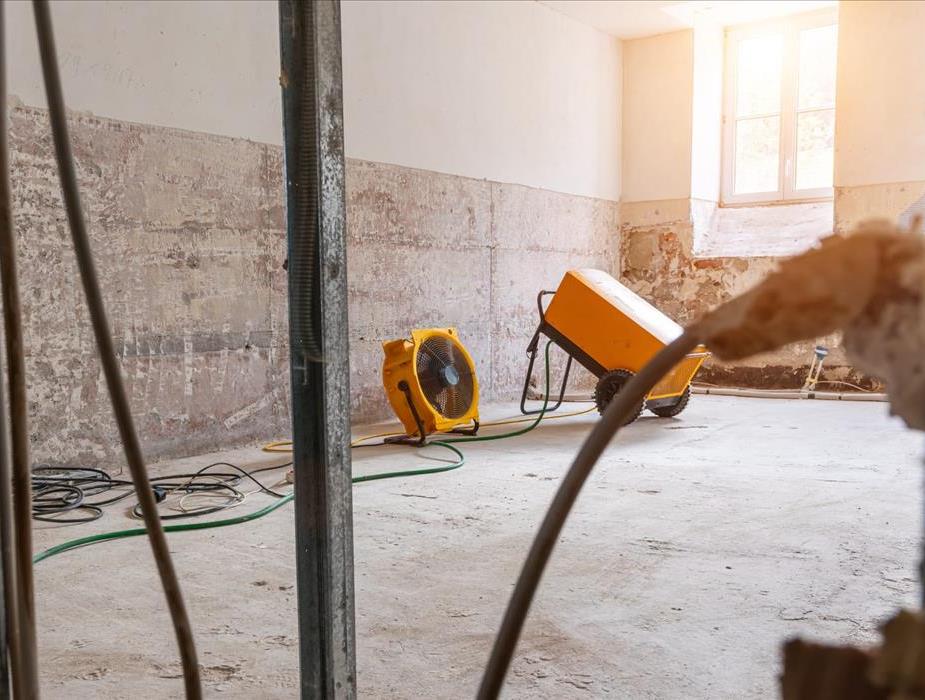 Mold removal can be a tough task, taking repairs down to the studs, only to be built back up.
Mold removal can be a tough task, taking repairs down to the studs, only to be built back up.
Of the many pests that can plague a house, mold is one of the most common. This is large because it requires very little for mold to grow and being the resilient pest that it is, and it can be very difficult to get rid of it. Ideally, you should go for a deep clean of the property to really get rid of the mold.
Mold spreads through spores. The spores are tiny and light, so they have easily carried around in the air. Mold might seem like a minor problem, but it can be a very destructive pest if it is left untreated. Here is how you can manage the situation.
Where Can I Find Mold?
Certain areas of the house are more likely to develop a mold infestation. Like any other living organism, water is a basic requirement for mold to live. Any place that has water or even a high level of humidity can be a breeding ground for mold.
Places such as the crawl space, near a pool, a damp basement, or any area that has been recently affected by flooding can be good places for mold to grow. If you have indoor plants, then there will be more humidity in the house, which can also attract mold.
Mold can latch onto nearly any surface and feed off it. Things like cardboard, drywall, paint, rugs, leather, wood, upholstery, and even insulation are places where mold can start growing if there is enough moisture in the environment for it to survive.
How Did I Get Mold?
You might clean your house regularly, but that doesn't mean you can get rid of all the mold spores. These little spores can get in through your ventilation system, windows, and doors, or they can latch on to clothing and belongings and enter the house when you come in with them. Once inside, the spores may stay dormant for weeks or months until they get the right conditions to develop.
They can easily be moved around the house through people and pets. If you recently had something that was affected by mold and you threw that item away, the spores from that item may have spread to other parts of the home. Spores can also distribute themselves through dust, so any contaminated dust in the home can also start a mold infestation.
Signs Of Mold
The best solution is to detect mold before it becomes a major problem. In the right conditions, mold can grow extremely quickly and can easily eat away at the surface that it grows on. If this happens to be a valuable item or the structure of your home, it could lead to a lot of problems.
One of the biggest signs is the odor that mold creates. Sometimes, this could smell like rotten eggs; in other cases, it might just smell like rubbish or like something is decaying. The odor depends on the surface that the mold is on. If anything smells off, get it inspected.
The other major sign is fungus growth. Usually, you can spot fungus growth on carpets, furniture, clothing, or walls and floors. It can range from white to green to black, depending on the particular mold.
Another sign is an increase in allergies and, specifically, breathing-related problems. If you have anyone in the house with asthma or a similar breathing condition, the allergy will flare up and won't go away because the mold spores are still in the air.
Conclusion
The best solution is to get a professional team, such as the mold removal experts at SERVPRO, to help you with this situation. They will help you remove the mold properly and disinfect the area, so there is no possibility of the mold returning. The SERVPRO team has plenty of experience working with mold infestations, and they can help you get the issue resolved and prevent it from spreading.
How $5 Can Save You Thousands!
9/23/2022 (Permalink)
 Just place the loop around the faucet handle, stretch the cord away from the house. Slide the cord lock until the cover is firmly against the house.
Just place the loop around the faucet handle, stretch the cord away from the house. Slide the cord lock until the cover is firmly against the house.
Every winter we see it, a client calls because they have a frozen pipe that has burst, and their basement is full of water. The most vulnerable water pipe to freezing and bursting is the one that goes to the outside faucet of your home. Clients always ask, how can this be prevented? There are several things that we can recommend doing to prepare your home for the winter months, but the easiest and most overlooked are the most important.
First, make sure all your hoses are disconnected from your home. If water remains in your hose, and freezes and expands, it will work up into the faucet and waterline, and cause water damage in the home.
Second, if you have a zone shut off to your exterior water sources, turn them off. Most newer homes are plumbed with a shut off to the exterior water, usually within 10 feet from the outside water source, and is usually easily accessible when you have a broken pipe. A zone shut off is more convenient than shutting the water to the entire home.
Third, you can purchase a foam insulated faucet cover to install on the exterior water sources to your home. They are cheap, usually right around $5, and simple to install. The cover is an easy way to protect outdoor faucets from freezing temperatures. Just place the loop around the faucet handle, stretch the cord by pulling away from the house. Slide the cord lock until the cover is firmly against the house.
The foam cover protects outdoor faucets against freeze damage, provides peace of mind when the temperatures drop, and they installation is quick and easy
SERVPRO of Grand Rapids South and Northwest Grand Rapids is always available when you experience water damage, a flooded basement or ice damming. Winter is rough enough, having to worry about who to call when an emergency happens shouldn’t be.
Our local contact number is 616.662.9700, we are always local and available 24/7.
Severe Weather Should Not Take You by Surprise
9/22/2022 (Permalink)
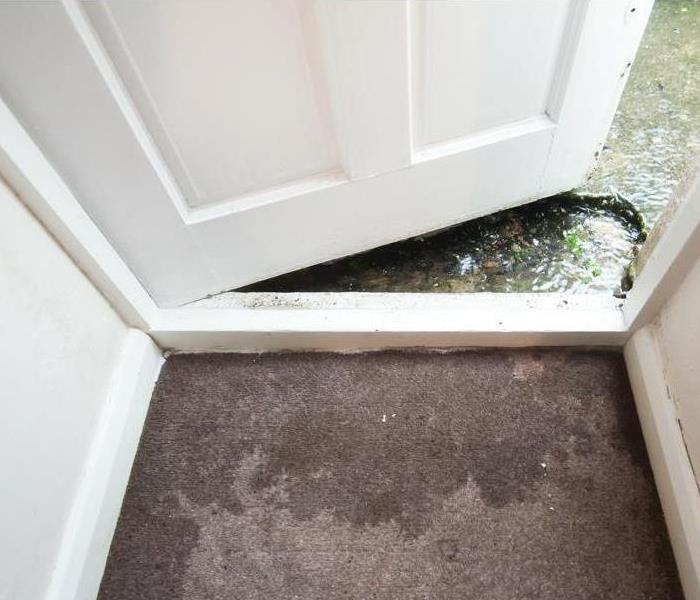 Heavy rains can do more than flood streets. Some waters can meet you at your front door.
Heavy rains can do more than flood streets. Some waters can meet you at your front door.
During severe weather, your house will endure brutal conditions like high winds, heavy rain, and mountains of snow. Take the time to equip your home with accessories to survive a storm. Don't wait until the forecast calls for severe weather because you might not have enough time to make the necessary preparations
Home Architecture
If you're building a new home, ensure it complies with your city's structural regulations. If you live in an area prone to harsh weather, ensure you follow all the building guidelines, making it easier to withstand any weather disasters. For instance, some common rules include a driveway of a certain length and width, building your home on an elevated platform (for floods), a fixed number of rooms and corridors, installing safety devices like fire alarms and smoke detectors, and maintaining your lawn. A clear lawn and backyard with fewer obstructions make evacuation easier.
General Tips
Prepare an emergency evacuation plan to help you get out of the house if under threat. Understand the layout of your home, and mark all doors, corridors, windows, etc., for easier evacuation - practice escape drills every few months to develop route memory of the plan. Build an emergency kit with canned food, water, and disaster control supplies to last at least two days. Create this kit a few days before the weather changes. It is advisable to keep the kit assembled at all times and place it in an easily accessible place since you may not have much time to evacuate. Also, develop a plan to communicate and meet up with your family at a specific spot if everybody isn't together.
House Inspections
Conducting regular home inspections is crucial to withstand severe weather conditions. These inspections should include roof, piping, electric line, and property evaluations. If you find any problems, get them fixed immediately. Delaying the repair will only burden you in bad weather circumstances. For instance, suppose your area experiences a flood. You risk pipelines breaking and cutting off your clean water supply with faulty plumbing.
If you have any issues with electrical lines and a fire breaks out, open or live electricity lines pose a serious threat that can hinder your chances of escape. Property inspections will also help you know if your home's structure follows all disaster management guidelines, and if anything requires changing, you can do it with ease.
When you notice something out of the ordinary, call SERVPRO of South and Northwest Grand Rapids at 616-662-9700. A professional inspection will help you thoroughly prepare your home for any natural disaster.
Preparing for a Tornado, Hurricane, Wildfire, and Thunderstorm
If you live in a tornado-prone zone, your home must have a basement or underground bunker where you can stay until the tornado passes. Ensure your house surroundings don't have fixtures that can be uprooted, like fences.
For hurricane zones, have your home built at the right elevation. If the hurricane is approaching, secure your home by covering windows with storm shutters and installing straps to stabilize your roof.
For areas that experience frequent wildfires, it is essential that your home has a comprehensive fire alarm and smoke detector system. Have many fire extinguishers on hand and learn the fire evacuation procedure in your area.
For thunderstorms, prepare your home well ahead of time by removing any tree branches that could collapse onto your roof. Stabilize your roof and cover all windows with storm shutters. Understand your city's evacuation strategy and storm signals.
Preparing your home to withstand severe weather conditions reduces the damage it endures. Don't be thrown off guard at the last moment by bad weather. These tips will help you thoroughly prepare yourself and your home for any weather conditions.
Prevent Power Surges from Causing Severe Damage
9/22/2022 (Permalink)
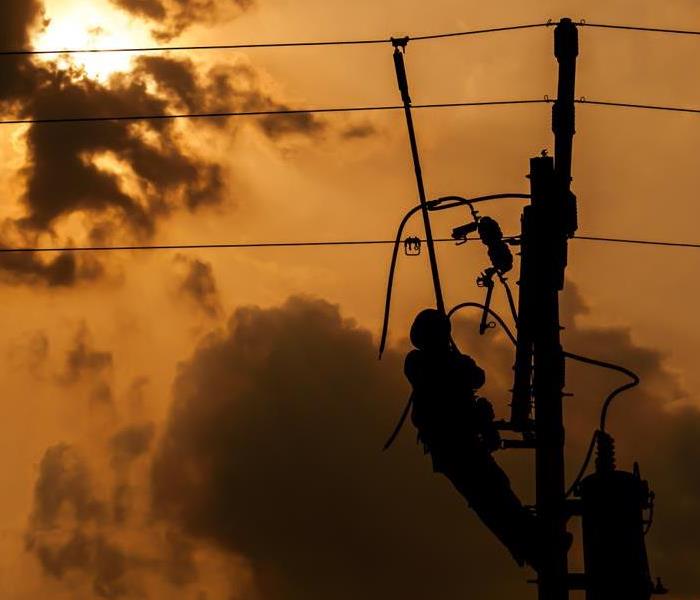 Power surges often happen when transformers are hit by lightning, or when severe storms interfere with power lines.
Power surges often happen when transformers are hit by lightning, or when severe storms interfere with power lines.
We all know power surges can be a pain. They cause our electronics to malfunction, lights to flicker, and appliances to make strange noises. But did you know that power surges also cause severe damage to your home?
What Is a Power Surge?
In electrical terms, a power surge is a sudden surge of power for a brief period. It can occur when lightning strikes, a power line is knocked down, or an appliance is turned on or off. Power surges range from a few volts to thousands of volts and can last for a fraction of a second or several minutes.
While power surges are generally not harmful to people, they can cause serious damage to your home and electronic equipment. In extreme cases, power surges can cause fires. Therefore, it's crucial to take steps to prevent power surges from damaging your home.
How to Prevent Power Surges from Causing Severe Damage
You can do a few things to prevent power surges from causing severe damage to your home:
Install Surge Protectors
Surge protectors are devices that absorb or redirect excess electricity. They can be plugged into outlets and are often used to protect computers, TVs, and other electronics.
They're relatively inexpensive, easy to install and provide peace of mind from a power surge.
Unplug Appliances during a Storm
If thunderstorms are in the forecast, unplug appliances that could be damaged by a power surge, including computers, TVs, stereos, and small appliances.
You can also disconnect your home's main breaker to prevent power surges from occurring in your home.
Storms often knock down power lines, so it's important to be prepared.
Install a Whole-House Surge Protector
A whole-house surge protector is installed on your electrical panel. It protects your entire home from power surges.
A whole-house surge protector is the best option if you live in an area with frequent lightning strikes. Whole-house surge protectors are expensive, but they're worth the investment if you want to protect your home from severe damage.
Use Circuit Breakers
Circuit breakers are devices that shut off power to an electrical circuit when there's too much current. They're usually located in your home's electrical panel.
The circuit breaker will trip and shut off the power before the surge can damage your home when a power surge occurs. It is an effective way to prevent power surges from causing severe damage.
Have a Backup Plan
Even if you take all the precautions listed above, there's still a chance a power surge could damage your home. Therefore, a backup plan is always recommended.
One option is to purchase a UPS (uninterruptible power supply). UPS units come in different sizes, so you'll need to choose one appropriate for your needs.
It's also a good idea to have a backup generator on hand. Generators are used to power all or part of your home during a power outage. Again, you'll need to select a generator according to your needs.
You can always create an emergency power outage kit if you don't want to purchase a UPS or generator. This outage kit should include the essentials you'll need in the event of a power outage, such as flashlights, batteries, non-perishable food, and water.
By taking the time to create a backup plan, you can rest assured knowing you'll be prepared when a power outage occurs.
For professional assistance with your backup plan or other home electrical system issues, contact SERVPRO of South and Northwest Grand Rapids at 616-662-9700. We are vastly experienced in power surge issues. Our professional team will advise you on the best solution. We're always here to help.
Did You Find Mold in Your Commercial Building
9/22/2022 (Permalink)
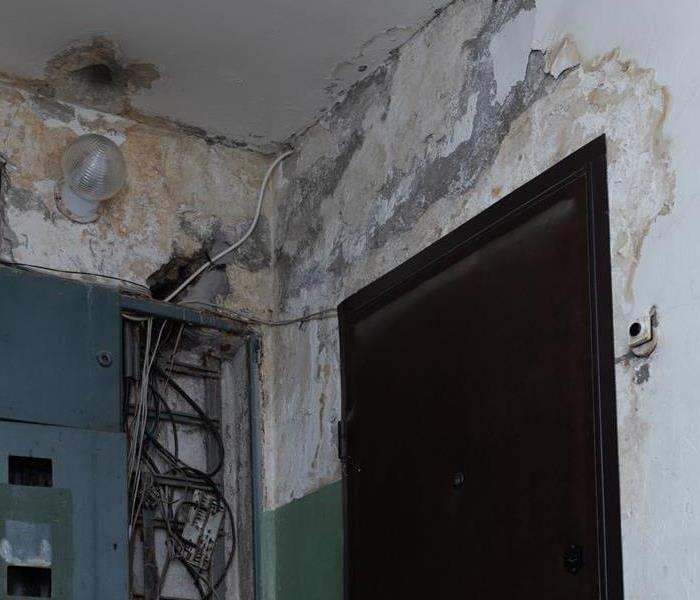 There are many signs of mold before it becomes visible to the naked eye.
There are many signs of mold before it becomes visible to the naked eye.
It's important to be aware that any presence of mold in a business can be extremely harmful to employees and customers. Molds produce allergens, mycotoxins, and other toxins that can cause serious health problems.
If you think you've found mold in your business, it's important to have it professionally removed as soon as possible. Do not try to remove the mold yourself - it's important to have a professional who knows how to properly remove the mold and clean up the area so there is no risk of exposure.
What are the signs of Mold?
The most telling sign of mold is the presence of visible mold growth. However, there are other signs that can indicate the presence of mold in a building, such as:
- A musty odor
- Water stains or water damage
- Peeling or bubbling paint
- Cracked or warped ceilings or floors
- Condensation on windows or walls
- Increase in asthma symptoms or other respiratory problems
How Does Mold Affect Your Staff?
As we stated, mold can cause a variety of adverse health effects, the most serious of which is an allergic reaction. People with mold allergies can have severe respiratory problems, including asthma attacks.
People with compromised immune systems are also at risk for infection from mold exposure. And finally, mold can produce harmful toxins that can cause serious health problems. These toxins are known as mycotoxins, and they can cause a wide range of symptoms, including respiratory problems, headaches, skin irritation, and damage to the liver or kidneys.
So it's important to keep your office clean and free of any mold growth. And if you do spot any signs of mold, don't touch it!
How Do You Test For Mold?
If you're a business owner and suspect that you may have a mold problem, it's best to call in the professionals. Mold can cause serious health problems, so it's important to identify and address any issues as quickly as possible.
SERVPRO is one of the leading providers of mold remediation services. They have extensive experience in identifying and removing mold from businesses of all sizes. They'll work with you to develop a plan tailored to your specific needs and will ensure that the problem is resolved quickly and safely.
Why Hire SERVPRO to Get Rid of Mold?
SERVPRO has been removing mold and restoring properties affected by mold for years. We have the experience and knowledge to do the job right, and we'll work tirelessly until your property is back to its original state.
Mold can be a serious health hazard, so it's important to hire a qualified professional to remove it from your property. Not only will SERVPRO get rid of all the mold, but we'll also treat the area to prevent future growth. Give us a call today and let us take care of everything for you.
Dealing With Bursts Pipes in Your Business
9/22/2022 (Permalink)
 A burst pipe can cause extreme damage, both during leakage and its aftermath.
A burst pipe can cause extreme damage, both during leakage and its aftermath.
There are a few telltale signs that can indicate a burst water pipe in a commercial building. If you notice any of the following, be sure to contact a professional as soon as possible:
- Water leaking from walls or ceilings
- Sudden increase in water bills for no obvious reason
- Damp spots on walls or ceilings
- Mold growth
- Noises coming from the pipes, such as gurgling or hissing sounds
- Turn Off the Water
Water can be turned off to a commercial building in a variety of ways, but the most common way is to turn off the main water line. This can be done by finding the main water shut-off valve and turning it either clockwise or counter-clockwise (depending on the make and model of your valve).
If you can't find the main water shut-off valve, then you'll need to go to each individual floor and find the stop valves for each set of bathrooms, kitchens, etc. Each stop valve has a specific purpose (e.g., hot water, cold water, sprinkler system) so be sure to turn off the right one!
Be Sure to Remove Electronics
Water and electronics don't mix, so it's important to remove all electronic equipment from the vicinity of a burst pipe. If water gets into the circuitry, it can cause short-circuiting and serious damage. In addition, if the power is still on while water is present, you could be risking an electrical fire.
That's why we recommend removing all computers and other electronics away from the vicinity of a burst pipe - to protect both the equipment and the building.
How To Help Staff Know to Stay Away
If you are an employee and see water spilling out from under a door or see puddles near an outlet, do not enter the area. You may think it's just a little water, but there could be electrical current running through it. If you see sparks or any other evidence of electricity, do not enter the area and immediately report the situation to your supervisor. Even if it doesn't look like there is any danger, always assume that there is and avoid the area. Water and electricity don't mix!
Contact Your Insurance Company for Damages
It's important to contact your commercial insurance company as soon as possible after a pipe burst in order to minimize the damage and ensure you are covered. A burst pipe can lead to serious water damage, costing thousands of dollars in repairs. By contacting your insurer as soon as possible, you can speed up the process of getting your claim approved and start repairs quickly.
How To Help Dry the Area Quickly
There are a few key things you can do to help dry the area out quickly and minimize the damage. First, try to remove any excess water or moisture as quickly as possible. Use a wet vac or towels to soak up any standing water. If the area is carpeted, use a shop vac to suck up any moisture in the padding and under the carpet.
Then, if possible, open all of the windows and doors in the area to allow it to air out. Turn on fans or heaters to help speed up the drying process. You can also use a dehumidifier to remove moisture from the air. Finally, if you have access to them, use industrial-strength fans or heaters to help dry the area out.
Call SERVPRO ASAP
If you suffer from burst pipes, it's important to call a professional water damage restoration company like SERVPRO. They have the experience and expertise to handle the aftermath of a burst pipe, including extracting any water, drying out the area, and repairing any damage that's been done. Plus, they can help you with insurance claims and get your home back to normal as quickly as possible.
Restoring Your Garage after a Fire
9/22/2022 (Permalink)
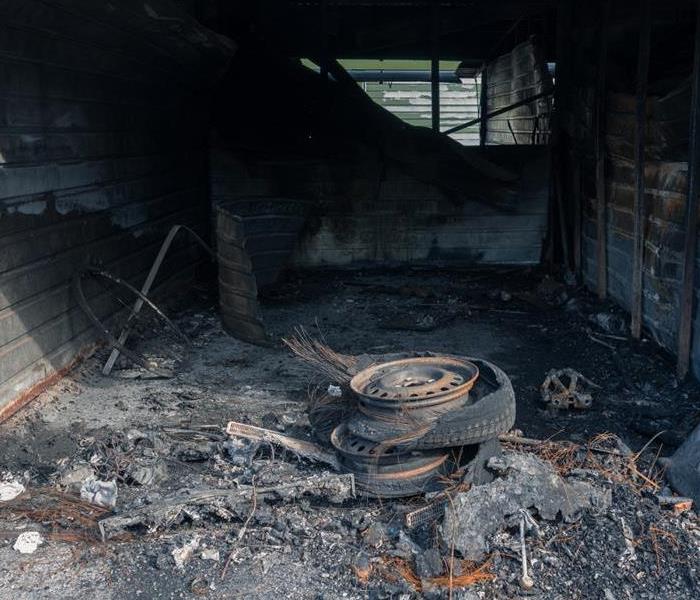 A fire damaged garage can burn everything it the confined space.
A fire damaged garage can burn everything it the confined space.
If your garage catches on fire and is put out, your first steps should be to contact your insurance company and a professional restoration company, like SERVPRO. They can help you assess the damage and begin the process of cleaning and repairing your garage.
Fire damage can be very extensive and can cause a lot of damage in a short period of time. It's important to have a professional assessment done as soon as possible so that the right steps can be taken to restore your garage to its original condition.
How Do You Clean Up Smoke After a Fire?
If your garage has been damaged by a fire, it's important to take the necessary steps to clean up the smoke and soot residue. Smoke and soot can cause a number of respiratory problems and can also damage your belongings.
SERVPRO is a professional cleaning company that specializes in fire and water damage restoration. We can help you clean up the smoke and soot residue from your garage and can also investigate to see if we can restore other damaged parts of the building.
How Do You Clean Fire Damaged Concrete?
If your garage has been damaged by a fire, it's important to clean the concrete as soon as possible. The soot and ashes from the fire can cause the concrete to become stained and discolored.
If you're dealing with a small area of damage, you can clean it yourself using a vacuum cleaner and some detergent. For larger areas, it's best to call in professionals. SERVPRO is a company that specializes in cleaning up after fires and other disasters. They have the equipment and experience necessary to get your garage back to its original condition.
What’s Salvageable After a Garage Fire?
In many cases, items that appear to be destroyed can often be restored with the right techniques and equipment. The professionals at SERVPRO have years of experience in fire damage restoration, and they will work tirelessly to get your garage back to working condition.
How Do You Seal Wood After a Fire?
If your garage has been damaged by a fire, it's important to take action quickly to prevent further damage. One way to do this is by sealing the wood. SERVPRO can help by providing the necessary equipment and expertise to seal the wood and protect your home.
Fire can cause significant damage to wooden surfaces, and in some cases, the fire may have even reached the inside of the wall studs. In order to prevent water damage and additional decay, it's important to seal the wood as soon as possible. SERVPRO can provide a variety of services including content cleaning, pack-out services, and air scrubbing. We also have specialized equipment that can be used to dry out walls and floors quickly.
How Can SERVPRO Help You After a Garage Fire?
Fire can cause significant damage to wooden surfaces, and in some cases, the fire may have even reached the inside of the wall studs. To prevent water damage and additional decay, it's important to seal the wood as soon as possible. SERVPRO can provide a variety of services including content cleaning, pack-out services, and air scrubbing. We also have specialized equipment that can be used to dry out walls and floors quickly. Contact us today to see if we can help.
Cleaning Your Chimney Will Lower a Chance for a Fire
9/22/2022 (Permalink)
Cleaning your chimney annually can help to prevent a fire from happening in your home. By removing the soot and creosote build-up from your chimney, you can help to create a safe environment for yourself and your family. Soot and creosote are highly flammable and can easily ignite, causing a dangerous fire in your home.
Signs of a Chimney Fire
When you see any of the following signs, it means you have a chimney fire and should call your local chimney sweep or fire department immediately.
- There is excessive smoke coming from the chimney.
- You can smell something burning in the house.
- You can see flames or sparks coming from the top of the chimney.
- The bricks around the top of the chimney are cracked or missing.
- The metal liner inside the chimney is damaged or corroded.
Roof Damage Because of a Chimney Fire?
Chimney fires can cause significant damage to a roof. The heat from the fire can warp and melt the roofing material, and the smoke and soot can discolor and corrode the metal flashing around the chimney. In extreme cases, the fire may even cause the chimney to collapse.
If you have a chimney fire, it's important to take steps to prevent further damage to your home. Be sure to call a professional restoration company to assess the damage and help you get your home back to normal.
Puff Back Through the Chimney?
Puff Back is a condition where flammable creosote deposits in a chimney or furnace explode, sending soot and ash spewing into the air. The name comes from the sound of the explosion, which is similar to that of a cannon.
Creosote is a black, tarry substance that forms when wood or coal is burned incompletely. It can accumulate in chimneys and ductwork over time, and if it's heated to the point of combustion, it can cause a Puff Back.
Are Soot and Smoke Inhalation the Same?
The short answer is no, they are not the same. Soot is a black or brown powder that is produced when something burns, such as coal, wood, or oil. Smoke is made up of soot and other particles that are created when something burns. Inhalation of soot can cause health problems such as coughing, difficulty breathing, and chest pain. Inhalation of smoke can also cause health problems, including coughing, difficulty breathing, chest pain, and asthma attacks.
What Happens After a Chimney Fire?
If you experience a chimney fire, the best thing to do is call your insurance company and SERVPRO for fire damage restoration. A professional will come in and assess the damage, clean up the soot and ash, and repair any damages caused by the fire. It's important to act quickly after a chimney fire because the longer the soot and ash sit in your home, the more damage they can cause.
Why Call SERVPRO to Help?
If your home has suffered a chimney fire, it's important to call in the professionals to help get your property back to normal. SERVPRO is one of the leading restoration companies in the country, and they have the experience and expertise necessary to properly deal with the aftermath of a chimney fire.
Chimney fires can cause a lot of damage, not just to your chimney but also to your roof and home interior. The soot and ash from the fire can be extremely corrosive, and can quickly eat away at metal, wood, and other materials. SERVPRO's team of experts will work quickly to clean up the mess and restore your home to its former glory!
The Benefits of Working with SERVPRO
9/22/2022 (Permalink)
Why Use SERVPRO for Mold Removal?
Mold spores can cause a variety of reactions in people, including sneezing, watery eyes, a runny nose, and skin irritation. In some cases, mold can also cause more serious health problems. For this reason, it's important to have any mold removed as soon as possible.
SERVPRO is a reliable and experienced company that specializes in mold removal. They have the knowledge and equipment necessary to safely remove all traces of mold from your home or office. Additionally, SERVPRO can help you take steps to prevent future mold growth.
How We Help with Water Damage Restoration
If you've experienced water damage in your home or business, it's important to take action as soon as possible to minimize the damage. SERVPRO can help with water damage restoration, from extracting the water to drying and restoring your property. We have the experience and training necessary to get the job done quickly and efficiently.
To start the process, just call us! We'll send someone out right away to assess the situation and create a plan of action. We'll work quickly to get your property back to normal, so you can get back to your life.
Fire Damage Restoration is Our Specialty
If you have experienced fire damage in your home or business, it is important to call a professional restoration company as soon as possible. Fire damage can be severe and can cause lasting damage if not addressed quickly.
At our company, we specialize in fire damage restoration. We will work quickly to assess the damage and begin the restoration process. We will also work with your insurance company to ensure that you receive the maximum reimbursement for your damages.
We’re Known for Our Commercial Building Restoration
Our team has the experience and expertise to handle any restoration project, no matter the size or complexity. We understand the importance of restoring a property back to its original condition as quickly as possible, so that business can resume as usual.
If you're looking for a reliable commercial building restoration company, contact us today. We'll be happy to discuss your specific needs and provide a proposal for the work that needs to be done. We're always available to answer any questions you may have, so don't hesitate to call us anytime.
Our team of experienced and qualified professionals understands the devastation a fire or water event can cause. That is why our focus is always on providing excellent customer service and returning your property to its preloss condition as quickly as possible.
We have the largest fleet of certified restoration vehicles and equipment in the industry, so we are prepared for any size disaster. We also offer a wide range of services, including water damage restoration, fire damage restoration, storm damage restoration, and more.
For reliable and professional restoration services, call SERVPRO today!
Ways to Prepare for a Home Fire
9/20/2022 (Permalink)
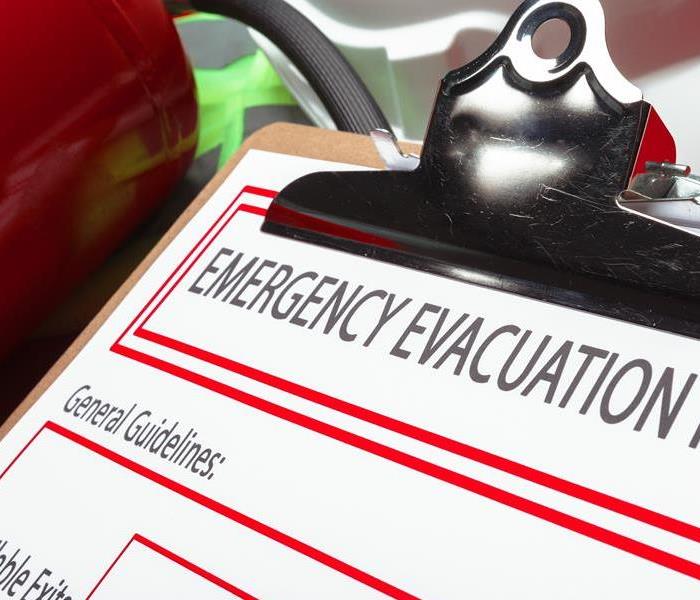 A fire evacuation plan checklist adorned by a fire extinguisher.
A fire evacuation plan checklist adorned by a fire extinguisher.
It is always a good idea to prepare for any home disaster. Compared to other home accidents, fires are the most common. If you aren't well prepared to handle a home fire, you will experience detrimental losses. Develop a concrete plan to deal with a sudden fire breakout to increase your chances of survival. Here is a comprehensive list to prepare your home for fire.
Make an Escape Plan
The foremost aspect of home fires you should address is creating a detailed escape plan. Start with your house or apartment's blueprint. Familiarize yourself with the layout and make a note of all fire escapes, building entrances and exits, doors, corridors, and windows. Understand the fire alarm system of your home and thoroughly understand your building's fire emergency procedures. If you have children and pets, practice fire drills to ensure they aren't lost if a fire breaks. Your escape plan should include a meeting point after exiting the house or building and ensure to stop anyone from entering the building until the fire department comes and extinguishes the fire.
Remember, every second counts in a fire. Escape plans help you get out of your home quickly, so practice your home fire escape plan twice a year at least. A fire can become life-threatening in merely two minutes. A residence can be engulfed in flames in five minutes. When you notice something out of the ordinary, call SERVPRO of South and Northwest Grand Rapids at 616-662-9700.
Understand the Basics of How to Deal with a Fire
Even if you have a comprehensive plan on how to escape a fire, without knowing how to protect yourself, you won't make it far. The fire isn't the only hazard; flames, smoke, collapsed building structures, open electrical circuits, etc., will also get in the way of your escape and can severely harm you. If your clothes catch fire while escaping, stop, drop and roll to put out the flames. Cover your nose and mouth to prevent smoke inhalation if you need to go through smoke-filled corridors. Always stay close to the ground and never run. Navigating spaces with the smoke clouding your vision becomes hard, so staying close to the ground will stop you from tripping or running into things.
Fire Alarms and Smoke Detectors
Fire alarms and smoke detectors are life-saving devices that should always be operational. Install smoke alarms on every floor and in every bedroom of the house. Smoke alarms are meant to be installed onto ceilings since they detect rising smoke. Regularly get them inspected and change the batteries frequently. Do not switch off the low battery alarm. You might forget to change batteries, and the alarms won't go off if a fire happens. If you stay in an apartment, you must know what the fire and evacuation alarms sound like. A home equipped with smoke detectors and fire alarms is more likely to survive a fire than one without.
Fire Extinguishers
Most commercial buildings and apartments have fire extinguishers. If you live in a house, invest in a good fire extinguisher or two. Keep one in your kitchen and have one for each floor if possible. Different class fire extinguishers are available, so familiarize yourself with each rating system. Class A ratings are effective against paper, wood, textiles, and plastics. Class B is effective against flammable liquid fires, and class C is against live electrical fires. Learn to properly operate an extinguisher, including knowing how to remove the pin lock, aim, and release.
A comprehensive plan can determine the outcome of a life-threatening situation. It is never too late to prepare your home for a fire accident, so keep our detailed information at hand when preparing your home for a fire.
Commercial Building Fire Damage Restoration
9/20/2022 (Permalink)
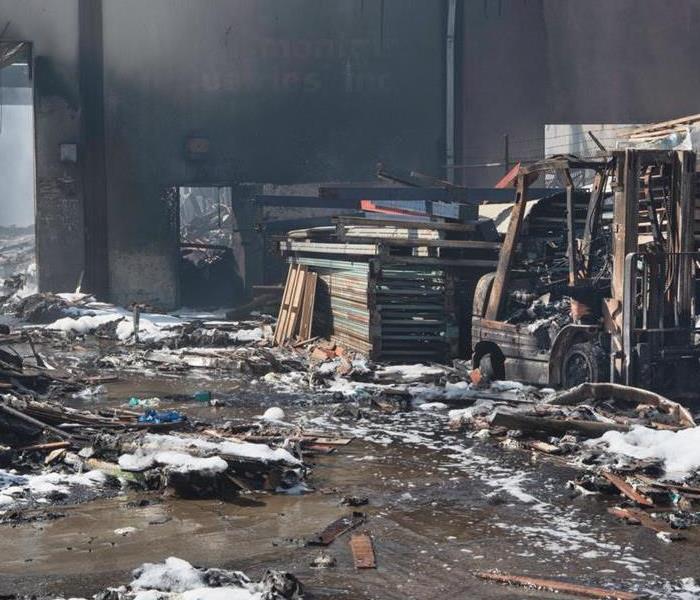 Fire can damage the sturdiest of commercial properties, including warehouse equipment.
Fire can damage the sturdiest of commercial properties, including warehouse equipment.
How Do You Restore a Commercial Building after a Fire?
A fire in a commercial building can cause extensive damage and can be a very stressful experience. You may have a lot of questions going through your head, such as "How do I restore my property?" and "How do I get my business back up and running?" Let's break down some of the big questions you may be facing after a commercial building fire.
How Do You Clean Up Commercial Fire Damage?
The first step in the cleanup process is assessing the damage and determines what can be saved and what needs to be replaced. Once that's been determined, they'll start working on cleaning up soot and smoke damage from surfaces like walls, ceilings, and floors. This is a delicate process because surfaces can be easily damaged if not treated correctly.
How Do You Get Smoke Damage Off Painted Walls?
At SERVPRO, our professional teams have the training and equipment to properly clean your painted walls and return them to their pre-damage condition. We start by assessing the extent of the damage and determining what cleaning methods will be most effective. We then use advanced cleaning techniques and equipment to remove pungent odors caused by smoke damage. Finally, we finish by sealing or repainting the affected areas, depending on the severity of the damage.
Can Smoke Damaged Furniture Be Cleaned?
If your office furniture has been damaged by smoke, you may be wondering if it can be cleaned and restored. The answer depends on the type of damage and the materials involved. If the damage is superficial, such as soot staining, then it may be possible to clean the furniture with mild detergent and water. However, if the damage is more serious, such as burning or melting, then it will likely not be possible to restore the furniture to its original condition. In this case, you may need to replace the damaged pieces.
If you are unsure of the extent of the damage, it is best to consult with a professional who can assess the situation and advise you on the best course of action
What Is the Timeline for Full Restoration after a Commercial Building Is Damaged?
After a commercial building is damaged by fire, the timeline for full restoration depends on the extent of the damage and the insurance policy. Generally, most insurance companies will have a set time frame in which they expect the business to be up and running again. Otherwise, they may not cover any additional damages that occur after that time frame.
In terms of the restoration process itself, it typically takes anywhere from several weeks to a few months to fully rebuild a commercial building. This timeframe can vary depending on the contractor you hire, the severity of the damage, and other factors. However, it is important to keep in mind that safety should always be prioritized over speed, so make sure to hire a reputable contractor who will take their time.
Who Is the Best Commercial Restoration Company?
SERVPRO is a professional restoration company that provides restoration services for both commercial and residential properties. They have a team of experienced and certified professionals who are available 24/7 to respond to emergency situations. SERVPRO also offers a wide range of services, including fire and water damage restoration, mold remediation, and construction services.
How to Protect Your Business in a Flood Zone
9/19/2022 (Permalink)
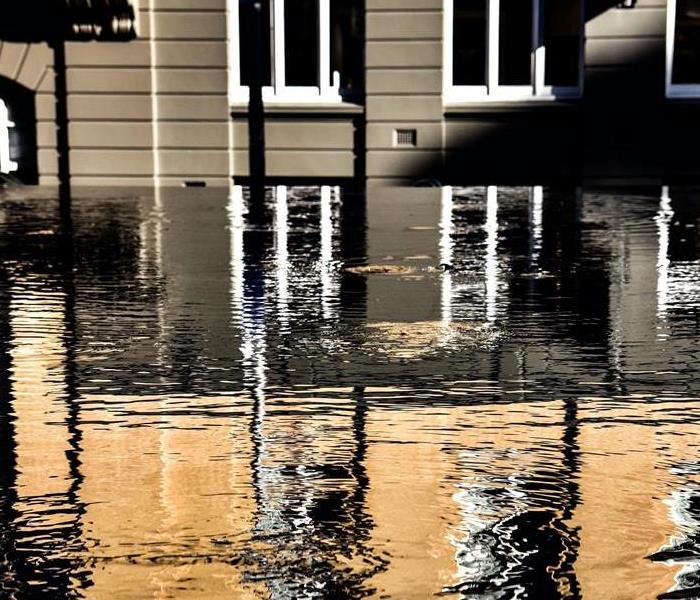 The foundation of a building is flooded because of rising waters in an urban environment.
The foundation of a building is flooded because of rising waters in an urban environment.
You may not think your business is at risk of flooding, but if you operate in a flood zone, it's important to be prepared. Flooding can occur suddenly and without warning and cause extensive damage to your property. Here are some tips to help protect your business in a flood zone
Elevate Your Business Using Piers or Stilts
If you own property in a flood zone, it's important to take steps to protect it from flooding. One way is to elevate using piers or stilts. Elevating reduces the risk of flood damage by keeping your commercial property above the water line. Additionally, elevated property is less likely to be severely damaged by flooding because the water has less impact on the structure. It's essential to consult with a professional to ensure it is properly constructed if you are contemplating elevating your property.
Install Sump Pump and Vents
You know flooding is a real danger if you operate in a flood zone. You can do a few things to protect your home, like installing vents and a sump pump. Vents help prevent water from building up in your crawl space, and the sump pump will help remove any water that accumulates. These devices can be installed relatively easily and could save you from serious damage. So, if you're looking for a way to protect your property, consider installing vents and a sump pump.
Apply Dry Flood Coating
No one wants to think about the possibility of their business being flooded. An option is to apply dry flood coatings and sealants. These products create a barrier against water, helping to keep your commercial goods dry in the event of a flood. They're relatively inexpensive and easy to apply, so there's no excuse not to take this simple step to protect your home.
Install Check Valves
If you do business in a flood zone, you must protect your home, and installing check valves on your pipes is a viable choice. Check valves are designed to prevent water from flowing back into your piping system, which helps prevent a sewage system backup during floods. While most homes have some type of check valve installed, it's always a good idea to double-check that all your pipes have them. If you're unsure how to do this or have other questions about protecting your home during a flood, you can always call SERVPRO of South and Northwest Grand Rapids. We are a highly experienced firm providing 24/7 restoration services. So, call us on 616-662-9700. We're always happy to help.
Slope Your Lawn Away from the Property
Slope your lawn away from the property to protect it from flooding. Sloping the lawn redirects water building up near your foundation, reducing the risk of flooding. You should also ensure your gutters and downspouts are clear so they can properly redirect water.
Protecting your commercial property from flooding doesn't have to be complicated or expensive. Following these simple steps can help keep your business safe during a flood. Having a flood insurance policy is vital if you live in a flood zone. Stay informed with the weather forecast via the many phone apps and be prepared to evacuate if necessary.
SERVPRO specializes in flood prevention and damage. We have many years of experience with a team of professional experts to assess and resolve your flood damage issues.
What Does That Water Stain Indicate?
9/19/2022 (Permalink)
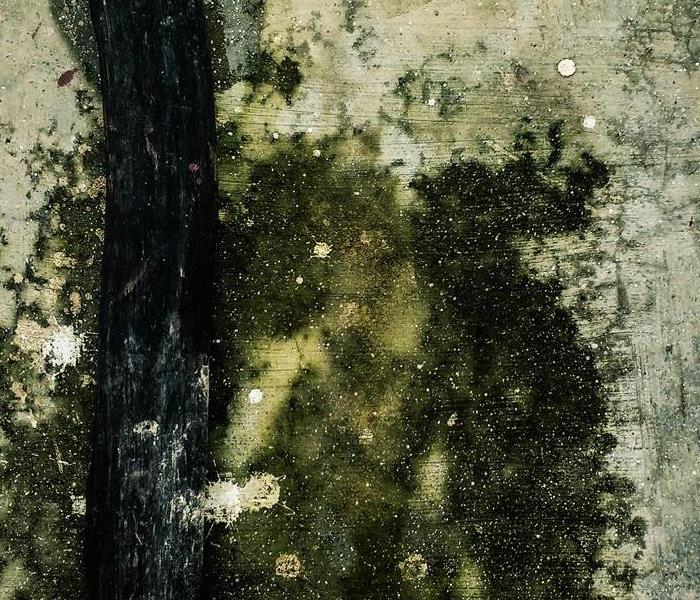 Water, particularly carrying sewage or other liquids, can stain the toughest of surfaces. can stain
Water, particularly carrying sewage or other liquids, can stain the toughest of surfaces. can stain
Water stains can be puzzling. Is that stain from a leaky pipe or just a drop of water that seeped in from the rain? Either way, it's important to get to the bottom of the matter quickly. After all, water damage is one of the most common and costly problems homeowners face.
Here are some of the most common water stains and what they might indicate:
Stains on the Ceiling
You likely have a leaking roof or an issue with your gutters if you notice a water stain on your ceiling. When gutters become clogged with leaves and debris, they can't properly funnel water away from your home. Clogged or broken gutters cause water to back up and seep into your home, leading to water stains on the ceiling.
This leakage can also occur around roof vents, chimneys, and skylights. If you have a water stain on your ceiling, it's imperative to call a professional to diagnose the problem and make the necessary repairs.
Stains on the Walls
Water stains on your walls could be caused by several issues, including leaks in your pipes or roof. If you have a water stain on your wall, it's important to determine the source of the leak, fix it, and prevent further damage.
Stains could also result from condensation, often in homes with poor insulation or ventilation. This water damage is most common in bathrooms, kitchens, and laundry rooms. If you have condensation on your walls, you'll need to improve the home's airflow.
You might also see wall-stains after heavy rains or storms. If water is seeping into your home from the outside, you must waterproof your walls to prevent further damage.
Stains on the Floor
Leaks in pipes or appliances usually cause water stains on your floors. If you have a water heater, washing machine, or dishwasher, frequently check for leaks around these appliances. You should also check the area around your toilets and sinks for leaks.
If you have hardwood floors, water stains can form due to leaks in the roof or windows. If you have tile floors, water stains are usually caused by leaks in the grout or caulking.
Your flooring material is also significant in its susceptibility to water damage. For example, hardwood floors can warp and buckle when exposed to too much water. Tile and linoleum floors are more resistant to water damage, but they can still be stained by water.
Water can seep through cracks in tile or wooden floors, causing the material to swell and discolor. If you have water stains on your floor, it's important to determine the source of the leak and fix it immediately to prevent further damage.
Stains around Windows
If you notice water stains around your windows, it's likely due to condensation. When warm air inside your home hits a cold windowpane, it causes water to condense and form a stain.
You'll need to improve the insulation in your home to prevent condensation stains. This can be done by adding weather-stripping around your windows and doors. You should also open your curtains and blinds during the day to allow sunlight and improve air circulation.
Brown or Yellow Stains
If you notice brown or yellow stains on your walls, ceiling, or floors, it's likely due to rust. These stains are most commonly seen in homes with metal pipes. If you have galvanized steel or iron pipes, they could be rusting on the inside and causing these stains.
It's imperative to have rusty pipes replaced as soon as possible, as rust can cause your pipes to leak and lead to expensive repairs.
It's important to determine the source of the leak when you notice any water stains in your home and make the necessary repairs. Water stains are caused by several issues, including leaks in your roof, windows, or pipes.
These leakages can be devastating if not fixed immediately, so it's crucial to call a professional. For more information or to schedule a consultation, call SERVPRO of South and Northwest Grand Rapids at 616-622-9700 and let them help you get your home back to normal.
September Is National Preparedness Month
9/9/2022 (Permalink)
 Flashlights, batteries, and other lights sit on a shelf, key ingredients to keep your home alight in case of emergency power outage.
Flashlights, batteries, and other lights sit on a shelf, key ingredients to keep your home alight in case of emergency power outage.
Every year, a month is set aside to raise awareness of the importance of being prepared for crises and natural disasters that could occur at any time. Every year has a theme highlighting the year's major objectives. In addition, activities and planned schedules for each week of September help with achieving these objectives.
The government details a plan for national readiness and creates a list of the most important skills required to make it happen. This plan has five parts: prevention, security, mitigation, response, and recovery. National Preparedness Month is when people, organizations, and communities are encouraged to evaluate and improve their ability to deal with crises and disasters.
How It All Began
The word disaster derives from an Ancient Greek phrase meaning “bad star.” It refers to the idea that bad things happen as a result of planetary alignment. A disaster, crisis, or catastrophe is an event that causes severe damage to people, property, the economy, or the environment. A disaster, whether long-term or short-term, can destabilize society and alter people's perceptions of life. As a result, planning for these events is necessary to avoid helplessness when disasters occur.
The Federal Emergency Management Agency (FEMA) established National Preparedness Month (NPM) three years after the September 11, 2001, attacks to encourage all Americans to make emergency plans. They chose September because of its historical significance and because the Atlantic hurricane season peaks in the middle of this month.
How to Prepare
National Preparedness Month, observed in September, encourages and reminds Americans to be prepared for crises or disasters in their homes, workplaces, and communities. Homeowners, families, neighborhoods, and businesses can use this opportunity to learn more about disaster preparedness, reduce risks to human health and the environment, and educate others.
Here are some simple tips to help you get ready:
Create a Pack
Gather supplies to last a few days after a disaster for everyone in your home. Remember to consider the specific needs of each person or animal if you need to flee quickly.
You should consider a few essential items: plenty of water, snacks like cookies or health bars, portable batteries for cellphones (ensure they are fully charged), and warm clothing like a sweater or rain jacket. Also, any chronic medication that is essential to maintaining your daily health. For your pets, water and food are essential.
Arrange and update your kit according to SERVPRO of South and Northwest Grand Rapids' recommendations.
Plan Ahead
It is important to consider how to avoid these dangers and deal with them if they arise. You and your loved ones should talk about communication during and after a disaster. Check your strategy with SERVPRO of South and Northwest Grand Rapids, whose team is committed to providing services that go above and beyond industry standards.
Contact Professionals
Take steps to minimize the impact of natural disasters on you and your loved ones. Call SERVPRO of South and Northwest Grand Rapids at 616-622-9700 for immediate assistance in the event of an emergency or major disaster. For residential and commercial property, SERVPRO of South and Northwest Grand Rapids has extensive experience restoring properties in the aftermath of a disaster. We prioritize getting you back to normal as quickly as possible with minimum cost.
Recognize the potential for disasters in your area and learn how to fortify your home to withstand storms and other common threats.
Also, check your insurance coverage to ensure it is up to date. We have all had instances where we were unprepared for emergencies. Fortunately, regular preparation for unforeseen circumstances has been shown to save lives and improve corporate results. This is why National Preparedness Month is celebrated.
Watch Out for Heavy Rains and Sewage Backup
8/8/2022 (Permalink)
If you live in an urban area, you probably have a network of underground sewers carrying wastewater away from your home. These sewers are designed to handle a certain volume of water but can become overwhelmed during heavy rains. As a result, sewage can back up into your home through drains or toilets, creating a messy and potentially dangerous situation. You can do a few things to help prevent sewer backups.
Install Check Valves
No one wants to deal with a sewage backup, so it's important to take steps to prevent one from happening in your basement. Check valves are important in flood prevention because they close when water starts flowing backward. It prevents sewage and stormwater from coming back up through your drains and into your home. You can get check valves installed by a professional or purchase them at most hardware stores. By taking this simple step, you keep your basement dry and free of potential sewage backups.
Install Sump Pump
When sewage backs up in your home, it is usually a nightmare. Not only is it a gross mess, but it can also pose a serious health risk to you and your family. Fortunately, there is a way to protect your home from sewer backups: by installing a sump pump. A sump pump is a small pump installed in the lowest point of your basement or crawlspace. When water accumulates in the sump pit, the pump automatically turns on and removes the water; this helps prevent the water from rising and flooding your home. In addition, sump pumps can also help protect your home from foundation damage by preventing water from seeping into the soil around your foundation. So, install a sump pump if you want to keep your home safe from sewage backups and floods.
Install Rain Gutters and Downspouts
Installing rain gutters and downspouts can help prevent sewage backups during heavy rains. Gutters collect rainwater from your roof and channel it away from your foundation, while downspouts direct the water even further away from your home. They help reduce the water that saturates the ground around your sewer line, making it less likely to back up. In addition, you should also consider installing a backflow valve in your sewer line. This device prevents sewage and wastewater from flowing back into your home, even if the main sewer line has overflowed.
Call a Professional
Sewage systems are designed to handle a certain amount of water; when they are overloaded, they can back up into your home or business. Heavy rains are often the cause, as the rainwater can overwhelm the sewers, causing a backup. It's important to call a professional if you live in an area prone to heavy rains to help prevent this from happening. If you notice sewage backup call a professional service like SERVPRO of South and Northwest Grand Rapids. We have the training and experience to safely clean and restore your property. We are available 24 hours a day to help. Call us at 616-662-9700 to get your cleanup started.
SERVPRO will inspect your system and ensure it is in good working condition. We might also recommend some changes you can make to help reduce the risk of sewage backup.
Sewage backups can be a messy and smelly problem, but more importantly, they pose severe health risks for you, your family, and your pets. Moreover, the damage to your home could be equally disastrous and very costly. However, by following these simple tips, you can tackle the issue quickly and effectively and keep your home clean and free of sewage backups.
Pipe Bursts Can Still Cause Damage in the Summer
8/8/2022 (Permalink)
It is not a novelty that water pipes burst when affected by cold temperatures. Whenever a pipe is frozen, it is highly probable to crack and cause a significant problem. When water expands, it freezes, and the extra pressure applied breaks the pipes.
However, it might come as a surprise to know that burst pipes also happen during the summer months. Even if your pipes endured the harsh winter without a scratch, you might find they barely resist the first weeks of summer.
The reasons are many, and here we'll discuss them.
Weakened Pipes
Worn-out pipes are useless. After all, there is a high chance they can burst at any moment. This occurs because old and wasted pipes are weak since they've lost their capacity for resisting normal water pressure levels. It could be partly due to the heavy damage received during the winter season. However, it could only be because they are too old to function any longer.
High Water Demand
Unsurprisingly, the summer season brings with it some unbearable heat waves. Our way to fight the heat is with fresh water. Naturally, this leads to a greater demand for water in an entire neighborhood or city.
Watering the plants, drinking water more regularly, and filling up the swimming pool all cause the pipes to work excessively. Eventually, this pressure leads to leaks in the pipes.
Clogging
It is tiresome to deal with a clogged pipe. Not to mention, it is also problematic. After all, clogged pipes are prone to bursting.
The reasons for it are plenty. It could be that the pipe gathered too much hair or soap, creating a filthy “wall” obstructing water movement.
Of course, this phenomenon occurs not only in summer but throughout the year.
Also, clogging is a product of “hard water.” Hard water contains high mineral levels that gradually build up inside the pipes, restricting the flow of water and, once again, causing them to burst.
It is a silent enemy that grows stronger as time passes. Unfortunately, sometimes it is already too late to discover, but never to solve.
The Heat
Cold temperatures drastically affect the pipes. However, heat also worsens the situation. Actually, hot temperatures cause more problems than cold because of a few particular reasons.
When the weather is too hot, the soil dries. As a result, water pipes could shift and burst. Not to mention, heat expands metal. If pipes are made of metal, it means the probability of them expanding during summer is elevated.
Going back to the soil, it is worth mentioning that tree roots also affect underground pipes. If they grow too much, they could reach the pipes and wrap them around, causing them to burst due to the high pressure applied.
It is an unfortunate event when pipes burst and cause damage to your house or living area. The water leaking through the pipes permanently damages walls, ceilings, floors, and interiors. In the worst-case scenario, it floods your home, causing extensive damage to every area.
In addition, mold could grow, leading to illnesses and other health issues. Once mold sets in, it becomes a difficult and very costly situation to rectify.
Therefore, we encourage you to be attentive to any of the warning signs mentioned. In other words, consider that the summer season is not a safe season for your pipes. Always have professionals check and deal with these occurrences immediately.
When you notice something out of the ordinary, call SERVPRO of South and Northwest Grand Rapids at 616-662-9700 without delay. Our professionals have many years of experience dealing with burst pipes and sewage issues. We are here for your convenience.
Preparing Your Home for When You Go on Vacation
7/19/2022 (Permalink)
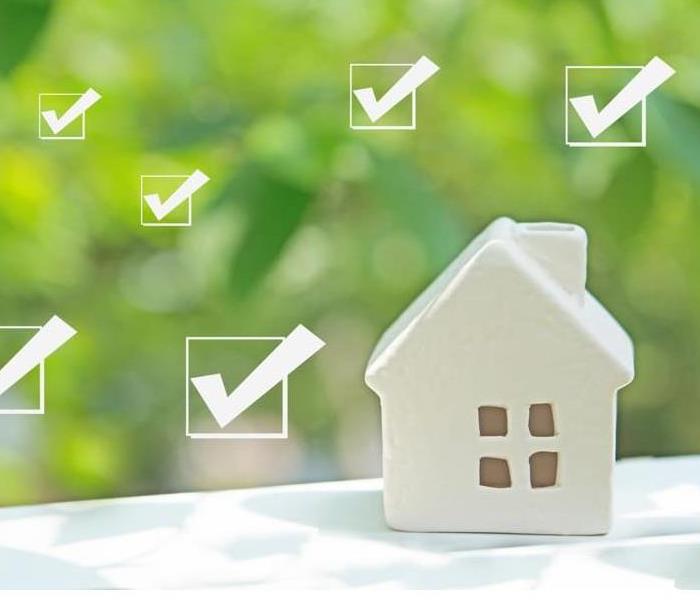 Making a checklist of ways to protect your home is just as important as planning your vacation.
Making a checklist of ways to protect your home is just as important as planning your vacation.
A vacation is the best time to relax and stay worry-free. After getting your luggage ready and checking you have everything you need, it is important to ensure your home is taken care of before leaving. No one wants to come back from vacation to find problems like break-ins, rotten food, or leaking water. While on vacation, you will keep worrying if you didn't prepare your home properly before you left.
Here are some things you should do for peace of mind while on vacation.
Make It Look Like Someone Is There
An unoccupied house is an invitation for burglars to break in and steal your valuables. Even if you are not home, you can still make it look like someone is there, preventing anyone from thinking about breaking in. You can set the lights to turn on and off at specific times, control the TV remotely, and ask a friend to collect your mail while you are on vacation. You can also hire a home sitter to stay at your home, take care of plants, and keep it occupied.
Take Plumbing and Electrical Precautions
You never know when an appliance will break down, and the worst time will be on your vacation. Keeping appliances running while you're not home is an expense and can cause costly problems. So unplug all your small appliances and electronic devices except the TV if you use it remotely. Turn off water valves and electric switches to non-essential rooms. Program your thermostat to save on energy by raising the temperature in the summer for cooling and lowering it in the winter for heating. A smart thermostat can be remotely controlled, giving you full control over it.
Tidy Up
No one wants to come back from a vacation to clean the house. You don't have to deep-clean everything before you leave, but you should tidy the house to sustain the relaxation mode when you return. Make your bed, vacuum, scrub the sinks and toilets, and tidy up each room, so it looks easy on the eye.
Clean Out Your Refrigerator
Before going on vacation, open your fridge and look at what foods are in it. Some foods will spoil after a while, even in the fridge. Freeze foods that can be frozen; eat what you can and toss what you don't want. It would be a good time to wipe the surfaces clean. If you leave for an extended time, you might want to throw out everything and unplug your fridge, as most foods will expire before you return.
Check All Doors and Windows
Right before you open the door to go on vacation, take a tour around your house and check if all entry points are sealed. Go over every door and window to check they are closed tightly and can't be opened easily. If you don't use a door or a window often, check them first as you might forget to lock them.
Take Out the Trash
One of the worst things to forget before going on vacation is taking out the trash. You will return home to awful smells and pest infestations. Ensure you take the trash with you as you go out of the door and run your garbage disposal with water and half a cup of vinegar to keep the stinking smells away.
Preparing your home before leaving on vacation is necessary to avoid unpleasant incidents or serious accidents like flooding or electrical fires. You need to relax and have fun while on vacation, but it can be ruined if you keep worrying about your home. Use these tips to make your home safe and prepared and enjoy your vacation.
Effects of Standing Water in and around the House
7/6/2022 (Permalink)
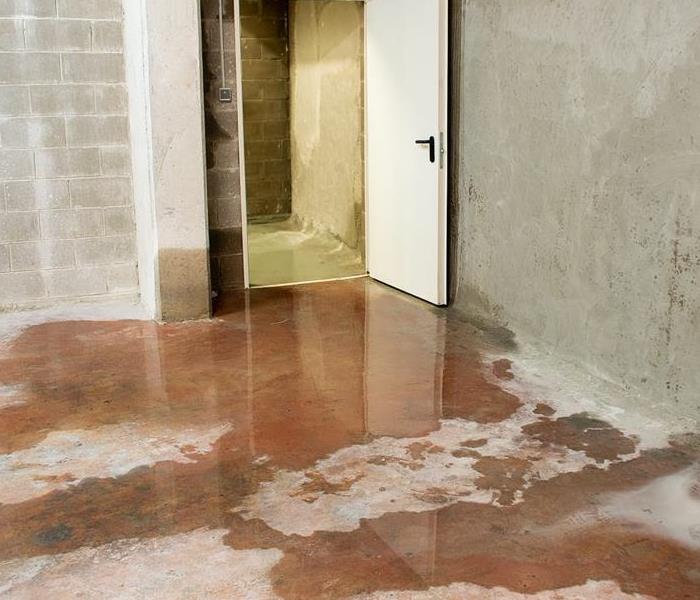 Standing water in the most sturdy of structures is still cause for alarm.
Standing water in the most sturdy of structures is still cause for alarm.
Water is life for all living beings, but stagnant or standing water is a sign for Michigan homeowners that there are issues with drainage and water management on their property. If you see standing water in or around your house, you shouldn't ignore it or think it will go away by itself. Ignoring standing water can cause various dangers to you and your family. Additionally, standing water is a symptom of a bigger underlying problem or problems that must be addressed as soon as possible.
Here are some effects of standing water you must be aware of.
Attracts Insects and Pests
Standing water is ideal for insect breeding as they need wet conditions to thrive. Insects like mosquitoes, ants, cockroaches, termites, and ticks reproduce in wet conditions. Insect infestation in or around your house is dangerous as it carries various diseases. Vermin, like mice, rats, and possums, also look for wet places and cause severe problems and inconveniences, such as spreading diseases, biting, and leaving waste.
Mold Growth
Mold and mildew grow in standing water. Wet conditions in your house allow mold to produce poor air quality and ruin furniture, clothes, and other items with porous surfaces. Mold makes your house smell unpleasant and causes a wide range of diseases, some critical. Removing mold is a complicated process that takes a lot of time and money while putting your health at risk, so it's better to prevent it from spreading by immediately getting rid of standing water.
Causes Foundation Damage
Standing water will seep into your house foundation if left unattended for a long period and cause shifting and bowing of your home structure. Whether the standing water is in your house or around it, it can lead to the breakdown of your home's foundation. Structural collapse can happen if the problem is ignored for a long time. Signs that your house has foundation problems include stuck doors and windows, concrete cracks, squeaking floorboards, tilting chimneys, and uneven floors.
Electrical Hazard
It is known that water and electricity don't mix well. Therefore, standing water in your house is an electrical hazard as any electronic system can cause an electric shock to anyone touching the water. Water will damage various home systems, such as the furnace, air-conditioning units, and water heater, and react with their electrical parts. It will be expensive to repair these systems, and the structural damage caused by standing water and the electrical hazard is too dangerous to ignore.
How to Prevent Standing Water
Homeowners in Michigan need to prevent water leakage in or around their houses. Ensure your roof drainage is unobstructed; the downspout will drain water away from your home foundation. If you have sprinklers, ensure that they are working properly and make them run less than usual if there is standing water around them.
If water is leaking inside your house, find the source of the leak and fix it as soon as possible. Shut off the water valves once you have located the source and clean up the water as much as possible. If you don't know how to fix the water leak, call a professional soonest.
Standing water causes a wide range of problems, such as health risks, structural damage, and unpleasant living conditions. It attracts insects, vermin, and bacteria that carry life-threatening diseases like E.coli, Zika virus, and more. Tackling the problem in its early stages to prevent these problems is crucial. Ensure your drainage inside and outside your house is working properly and nothing leaks water.
Keep your family safe by preventing standing water from forming in or around your house. And when you notice something out of the ordinary, call SERVPRO of South and Northwest Grand Rapids at 616-662-9700.
Save Your Restaurant From Becoming a Nightmare
6/28/2022 (Permalink)
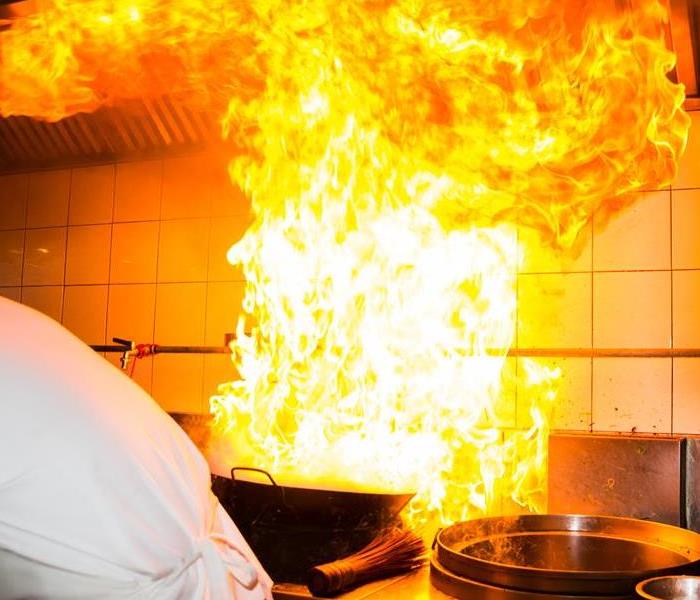 A chef ducks away from a large fireball in a grill pan.
A chef ducks away from a large fireball in a grill pan.
A restaurant must have delicious food and drinks, but it should also provide excellent customer service. Your goal is to make every customer so happy that they can’t wait to come back. Unfortunately, disasters such as fires and floods can occur, which can force a restaurant to close down for a while. To save your restaurant from this nightmare, you may need the help of a restaurant fire damage restoration company like SERVPRO.
Fires in restaurants are unfortunately more common than you might think. If you're a restaurant owner, this is a nightmare scenario. You work so hard to build your business and create a fantastic dining experience for your customers, but a fire can destroy everything in moments. What's worse is that even if your restaurant doesn't burn down completely, smoke and water damage can be just as devastating.
Your restaurant will not be able to serve guests after a fire until it is cleaned and restored. Time is of the essence when it comes to restaurant fire damage restoration. Every day your doors are closed you lose money. This is where a professional fire restoration company comes in. To save your restaurant from turning into a nightmare, you need the help of professionals that know how to restore a commercial kitchen and restaurant after a fire, flood, or other disaster.
When your restaurant is hit with a nightmare, SERVPRO of South and Northwest Grand Rapids is here to help. We respond 24/7 to help you clean up the disaster, restore the damages, and get your restaurant doors open again as quickly as possible.
What happens during a restaurant fire damage restoration?
In the wake of a fire, how do you proceed? First, an inspection is conducted to understand the impact and damage to your restaurant, and then a plan is implemented to get your restaurant back to normal. Our restoration team will inspect your entire building to find out how much damage the fire has caused and which parts of the restaurant are salvageable and which must be replaced.
After a complete evaluation is done, we will help you clean your restaurant and get your restaurant operational again. Most times, kitchen equipment will need to be replaced. While it may be possible to repair some of your restaurant equipment and appliances, it’s often more efficient and affordable to replace equipment.
Restaurants are susceptible to fire damage. When a fire occurs, the building and everything in it is usually covered in soot and smoke. The restaurant will need to be fully cleaned from top to bottom in order to return it to its original state. Special chemicals will need to be used to clean the kitchen and cooking equipment, as well as appliances and counters. We provide complete restaurant fire damage restoration services.
We are trained professionals in the restoration industry. Our team is IICRC certified, which means we have specialized training from the Institute of Inspection Cleaning and Restoration, Our team knows the best practices for water and fire restoration including carpet and upholstery cleaning, and cleaning counters and other surfaces in your restaurant. This means once we’ve done our job, you can bring back your customers and resume business as usual.
If you’re facing a restaurant disaster, call SERVPRO of South and Northwest Grand Rapids today at (616) 662-9700. At SERVPRO of South and Northwest Grand Rapids, we will get your restaurant up and running again, no matter what the problem is. Whether it's fire damage or water damage, we can get to business quickly and save your restaurant from becoming a nightmare.
SERVPRO of South and Northwest: Investing in local business
6/22/2022 (Permalink)
 Proud members of our local chambers in West Michigan
Proud members of our local chambers in West Michigan
SERVPRO of South and Northwest Grand Rapids is investing in the communities and local businesses throughout our area. We are proud active members of the Hudsonville Chamber of Commerce, Grandville Jenison Chamber of Commerce, Sparta Chamber of Commerce, Byron Center Chamber of Commerce, Wyoming Kentwood Chamber of Commerce, Caledonia Chamber of Commerce, Ada Business Association and the Gaines Township Chamber of Commerce. It's a privilege to invest into local businesses and these chambers, to offer our water damage, fire damage, mold remediation, storm damage clean up services to the community and businesses. Our team also sit on the Board of Directors, Ambassadors groups and event development teams on many of these chambers. West Michigan and Grand Rapids is a great place to serve! Follow our Facebook page to see what else is going on in our community.
Problems a Power Outage Can Cause in Your Home
6/13/2022 (Permalink)
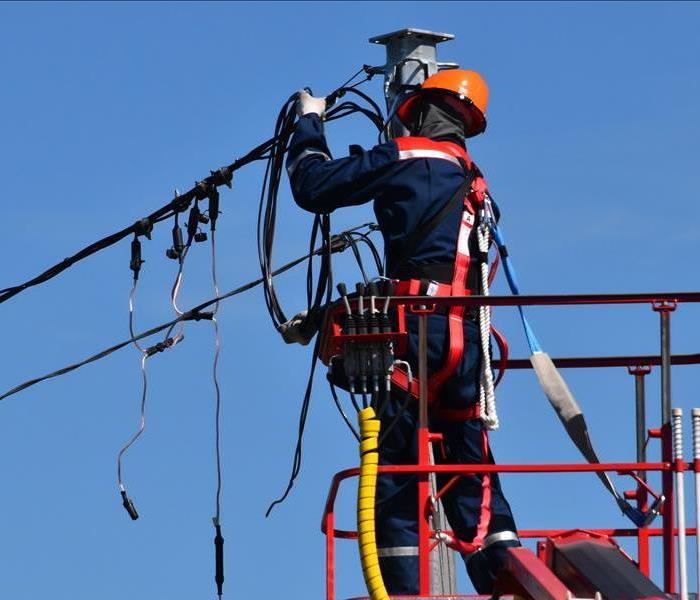 When storms hit, manual fixes are usually the only option, and that takes time. A line worker repairs a wire after a power outage.
When storms hit, manual fixes are usually the only option, and that takes time. A line worker repairs a wire after a power outage.
One thing we often take for granted is the electricity that powers everything in our home. But, when an extreme weather event occurs, you have to be prepared for power outages. A power outage can cause a myriad of problems in your home.
When a storm hits, it may cause trees to fall down, unusual wind, or other damage to your home. But most people don’t think about power outage problems that can occur when the electricity goes out and stays out for a long period.
When the power goes out, it can cause serious problems not just during the outage but when the power comes back on. For example, the food in the fridge may go bad. You will have no heat, no lights, and no way to cook meals. While this is inconvenient, when the power comes back on, you may have an even bigger problem than you’re prepared for. Here are a few reasons why.
Here are a couple of power outage problems that you might not expect.
A flooded basement
Aside from issues with your fridge, stove, and other electrical appliances not working during an outage, another important thing that doesn’t work during a power outage is your basement’s sump pump.
Sump pumps run on electricity. While your power is out, they stop working. This is not a big deal in short outages, but if it rains heavily and your sump pump isn’t working, you could end up with a lot of water in your basement. This can cause serious damage to your home. Any items that are stored in your basement may be destroyed, and the moisture can cause mold to grow even after the water has been cleaned up.
Unfortunately, sump pumps are one of those things that are easy to forget about. When you’re in the middle of a power outage, it may not even occur to check your basement for flooding. In addition to that, many people choose to stay in a hotel if their power stays out for more than a few hours. And, when they come back home they may come home to a big mess they weren’t prepared for.
Water pipes may freeze or burst
Burst pipes are an unfortunate problem during the winter months here in Michigan, and they can cause a lot of water damage to your home. This is especially true if a pipe bursts while you’re not home. When it’s cold, the heat from your home helps to keep your pipes from freezing. However, during a power outage, you lose heat, which can cause frozen pipes or a pipe that bursts.
A great preventative measure to keep them from freezing is to have a trickle of water running through the pipes. This will keep water slowly circulating through your pipes and keep them from freezing. You should also open cabinet doors to allow heat to circulate and prevent pipes from freezing.
What should you do if there is water damage after a power outage?
The first thing to do is to clean up as much of the water as you can by mopping and wiping up as much of the water as you. Move any items from your basement to a dry location if possible and then call for help.
Call SERVPRO of South and Northwest Grand Rapids today at (616) 662-9700. At SERVPRO of South and Northwest Grand Rapids, we can help you after a disaster strikes. Whether it's water damage or storm damage, we can get to your home quickly. If you do notice mold, we can help with that too. We are specialists at mold and mildew remediation and much more.
Preventing Mold Growth in Your Attic
5/18/2022 (Permalink)
Mold will almost always grow in areas where the conditions allow. This means in hot or humid areas like your attic, where it also has an abundance of wood sheathing as a food source. Attic mold can go for a long time being unnoticed. Removing that mold quickly becomes paramount.
Many homeowners rarely go up to their attic, meaning that mold could be growing up, unseen for months or even years. What can also be frightening is that mold in the attic could suggest other areas in your home with high levels of moisture, and mold growth in more than one location. Mold can be a deal breaker if you are trying to sell your home.
Even if you cannot initially see the mold, you may notice some signs that it could be present. Just popping into your attic can give you an indication of mold if you find that it is hot and stuffy. That usually means that there is not enough air circulation or proper ventilation. You could also quickly notice the smell of mildew or see that there are dark stains on wood surfaces.
During the winter, if you spot frost building up on the underside of the roof, that shows that poor ventilation in the attic has allowed water vapor to freeze. That moisture will linger as the seasons change, again creating an ideal environment for mold growth.
Removing mold can be a hassle and costly experience, so the best thing you can do as a homeowner is take all the necessary steps to prevent mold from growing in the first place. The best thing you can do for your attic is to create a space that has proper airflow and ventilation to help remove moisture and discourage mold growth.
Your home may already have the right vents, but there could be a blockage. Inspect the soffit vents and the ridge vents that give air a clear path to flow through the attic. Exhaust fans also need to be in working condition, as they are there to help pump moisture out of your kitchen or bathroom. Insulation is another key component to fight mold growth, as the insulation prevents warmer air from entering cold attics, causing condensation and the buildup of moisture.
Mold can cause serious damage to your home. For mold prevention and removal, SERVPRO of South and Northwest Grand Rapids is here to help you recover as quickly as possible. For more information on removing mold from your home’s attic, call SERVPRO of South and Northwest Grand Rapids today at (616) 662-9700. Our specialties include fire, water, and storm damage restoration for residential and commercial clients. We also do mold and mildew remediation and much more.
Deep Cleaning Your House to Prevent Disaster
5/11/2022 (Permalink)
No matter what the state of your house looks like, when you set out to clean up, you know you’re in for more work than you bargained for. Exceptional presentation standards are great if you’re having people over, transitioning from winter to spring, or staging your house for a sale, but your home being free of what lies beneath — mold, mildew, foundation, or wall damage, etc. is something else.
After all, people have expectations of walking into a clean house. One of the most effective things you can do is to remove clutter. Not only will this let you evaluate what needs to stay and what can go, but it helps you see into neglected spaces that cover damaged areas.
With the clutter out of the way, you can then inspect and clean spaces that need to be well organized. Deep cleaning can be more complex than the routine you are used to, and it is important to get your home in the best shape possible.
A deep clean creates the most appealing living space possible. There might be some things you can live with, such as smudges on the appliances or a tiny stain on the rug, but you should inspect further. What’s under the appliances? Are the gas lines secure? Are the floors stained beneath the carpet?
In the worst-case scenarios, a deep cleaning session will identify areas in need of professional help. There might be mold or another serious issue behind the walls, and a remediation team can assess the problem before guests come knocking.
SERVPRO of South and Northwest Grand Rapids offers emergency fire, water, and storm damage restoration for residential and commercial clients. Call us at (616) 662-9700.
Investing in a Commercial Fire Suppression System
4/26/2022 (Permalink)
Fire suppression systems can come in a variety of shapes and sizes, but they are all designed for the same task. Quickly extinguishing a fire is essential to protect and save lives and property. Whereas most homes are equipped only with a smoke alarm, commercial fire protection involves much, much more. The method of fire detection and suppression will differ in each building, so it is important to learn about the types available.
To get started, you should know that there are two categories of fire alarms: automatic fire alarms and manual fire alarms. Every commercial building is required to have at least one fire alarm. An automatic fire alarm works when it detects heat or smoke, and once it does it will send an alert throughout the building to warn those inside. The typical manual fire alarm is the pull station on the wall, where the alarm requires an employee to pull the lever in order to alert the occupants.
Buildings can be equipped with both automatic and manual fire alarms, but the types of suppression systems might vary. One of the most common systems is the commercial fire sprinkler system, which controls and extinguishes flames rapidly by discharging water when the fire’s heat is detected. These are found in commercial buildings like grocery stores, restaurants, retail chains, and distribution centers.
There are a couple different types of sprinkler system, each with a slightly different function, but a similar purpose. A wet-pipe sprinkler system holds water constantly and is ready to spray at any time. Dry powder systems will fill with water only when the system is activated. Deluge systems keep the heads open at all times and will fill with water when activated. Pre-action systems require a supplemental fire detection system to avoid accidental discharge.
However, water and sprinkler systems may not always be the best option. Sprinkler systems should not be used where water cannot put out a fire, like in kitchens, or when water might cause irreparable damage to the building’s contents, like computer rooms or file storage. These areas need a non-water-based system.
Commercial fire suppression systems will suffocate a fire by using chemical, gaseous or foam agents, rather than using water. These systems typically cause minimal damage to expensive equipment, and will even stop chemical-based or grease fires quickly.
To determine whether your commercial buildings need a sprinkler system or a fire suppression system, you need to know what it is inside your building and if a sprinkler system could be harmful in its own way. If you need to be able to protect computers, expensive equipment, important files, or irreplaceable items, it would be wise to install a fire suppression system over a sprinkler system.
Regardless of the type of fire suppression system you choose for your commercial building, know that it is better than nothing at all. Commercial fire suppression systems are important to not only protect your property, but to also save lives.
For more information on commercial fire suppression systems, call SERVPRO of South and Northwest Grand Rapids today at (616) 662-9700. Our specialties include fire, water, and storm damage restoration for residential and commercial clients. We also do mold and mildew remediation and much more.
Spring Cleaning Can Make Your Home Healtheir
4/14/2022 (Permalink)
When it comes to tidying up around the house, spring cleaning can be a time to really overhaul both inside and outside your home. This annual chore does more than just encourage you to declutter your house, but it gives you a chance to give your home better protection from the elements, as well as providing a boost to your indoor air quality.
The first item on your spring cleaning checklist is to fortify your home against April showers. Water damage is the biggest threat that your home will face between the melting snow and the heavy rains ahead. In order to make sure water stays out of your space, you need to make sure that it can properly and freely flow away from your home. This requires you to work both inside and outside.
Months ago, the leaves were falling from the trees. While you may have thought that raking them from the lawn was the only thing you had to do, you missed the leaves that did not make it all the way to the ground. Those leaves most likely ended up in your gutters, and if they are to remain there, you might be faced with an avoidable problem. When leaves and other debris clog the gutters, rain cannot drain away from the house properly, and can end up getting inside.
You need to check both the top and the bottom of the gutter system, ensuring that the downspouts are also free of clogs. Also important is to make sure that the downspouts are positioned to direct water away from your home’s foundation.
Not only do you want to keep the water out, but you want to keep allergens out of your home, too. A hardcore cleaning session is a good start to improving your home’s indoor air quality, but there are other steps you should take to maintain it. Proper ventilation is key for improving indoor air quality, especially when working with household cleaning products that contain volatile organic compounds.
Prepare for the days ahead by changing your air filters. This should already be a routine task, as air filters also help keep your HVAC system running more efficiently. As for your indoor air quality, a new air filter is more capable of trapping allergens, preventing them from recirculating throughout the house.
Air purifiers are helpful tools for reducing pollutants, and an air purifier in the bedroom can even improve your sleep habits. These work great in living rooms, but if you want to protect the entire house, you can install a whole-home air purification system.
Lastly, controlling your home’s humidity will not only make it more comfortable as the temperatures climb higher, but will help prevent mold growth. Remember those tips for keeping water out of the home? If water finds its way inside, it creates an environment for mold growth to thrive.
Spring cleaning should be seen as more than just an annual chore. Use this time to build a strong routine of protecting your home from the elements, and keep your family safe. SERVPRO of South and Northwest Grand Rapids is here to help you recover as quickly as possible.
For more information on protecting your home from water damage, call SERVPRO of South and Northwest Grand Rapids today at (616) 662-9700. Our specialties include fire, water, and storm damage restoration for residential and commercial clients. We also do mold and mildew remediation and much more.
Dealing With Trees Before and After a Storm
4/6/2022 (Permalink)
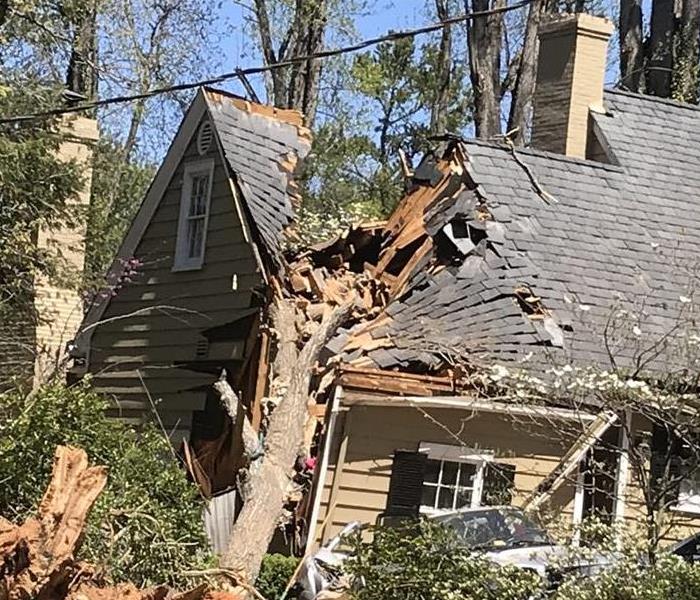 Storm Damaged Trees
Storm Damaged Trees
You know the phrase, “The bigger they are, the harder they fall”? In a literal sense, that is especially true for trees. During harsh storms, trees take a massive hit, and extreme winds can topple trees, which then cause damage to your home and property. To better protect your home, you need to start by protecting your trees.
Tree damage can cost homeowners thousands of dollars, and insurance will likely cover only a fraction of that damage. Taking the first steps to preventing that damage involves understanding the types of trees that surround your house, and the reasons why they might fall.
Unfortunately, all trees have the potential to fall over. This may be caused by wind, snow or ice, or a combination of those factors. Taller trees are more likely to get thrown down by winds, as more force is applied to the trunk with the increase in height. Also, roots can extend more than two times the radius of the branches, and not all environments allow this type of growth or development.
Also, trees with visible signs of damage or decay are even more likely to fall. If there is a tree leaning on your property, have you been able to notice an increase in its lean recently? Perhaps there are cracks in the stem. Maybe the roots are showing signs of decay. Some species of mushroom growing in the soil near trees also might indicate signs of decay.
Addressing these issues, as well as others, will help keep your tree standing. Protecting your trees also means keeping them healthy. You can help strengthen your trees by providing them with enough water and fertilizer. This becomes even more effective when you start these routines while the tree is still young.
Seasonal maintenance to your trees is essential, from the bottom to the top. Ensuring that the roots system is protected means that the tree has a solid anchor to the ground. Avoid construction or excavation around the tree and laying mulch will also help preserve nutrients and discourage weed growth.
Trimming the tree and pruning damages will not hurt the tree if done properly. In fact, with the right care you will help the tree fare much better in storms. Removing dead or weak branches ultimately boosts the growth of the tree and helps strengthen its structure. When shaping the tree correctly, it becomes more resistant to all types of weather damage.
However, once a storm passes and leaves a trail of tree damage in its wake, you will need to know a couple cleanup tips to keep the damage from getting worse. The most important thing to know is that if a tree has caused damage to power lines, you need to leave it be. In these cases, rely on the professionals to assess the severity of the damage, and allow them to repair or remove branches that put power lines in jeopardy.
Injured trees may also require the work of climbing or a chainsaw. Again, these situations need to be handled by licensed arborists, who are tree care professionals with the experience needed to remove or repair a tree.
Finally, you need to know what type of insurance coverage you have for your property, for both your home and your car. Not all insurances cover the same things, and the compensation might be different based on each circumstance.
When it comes to cleaning up the aftermath of a heavy storm, SERVPRO of South and Northwest Grand Rapids is here to help you recover as quickly as possible. For more information on protecting your home from tree damage, call SERVPRO of South and Northwest Grand Rapids today at (616) 662-9700. Our specialties include fire, water, and storm damage restoration for residential and commercial clients. We also do mold and mildew remediation and much more.
Prepare Your Home Before Heading Out of Town
4/1/2022 (Permalink)
 Mike Nitz with SERVPRO South and Northwest Grand Rapids.
Mike Nitz with SERVPRO South and Northwest Grand Rapids.
VIDEO - How To Prepare Your Home Before Leaving on Vacation
Many people are heading out of town soon for spring break or vacation. Here are a few helpful tips we recommend you do before you leave.
1. Leave a ‘lived in’ home. Set timers on lamps and place a hold on packages.
2. Lock more than just the doors. Don't forget to lock all garage entry doors, back doors, and windows. Also, if you have any pet doors, cover them from the inside.
3. Unplug all of your appliances. Mixers, coffee makers, other daily use countertop items. It's amazing how things can short out with minimal interference.
4. Inform your most trusted neighbors. Let them know how long you’ll be away and ask them to check the house and maybe pull your mail.
5. Contact the alarm company and let them know that you'll be gone. Activity from certain dates will be treated as legitimate.
6. Remove outdoor spare or hidden keys.
7. Turn off your water. Shutting the water off, whether it’s the main line, under the toilet or the kitchen sink, will mitigate water damage loss should disaster strike.
If you do come home after a spring break and find a problem, our number is 616-662-9700. SERVPRO of South and Northwest Grand Rapids is locally owned and operated, and we are always glad to take care of you when the unexpected happens.
Have a great vacation and stay safe!
How to Prepare for Snowmelt
3/30/2022 (Permalink)
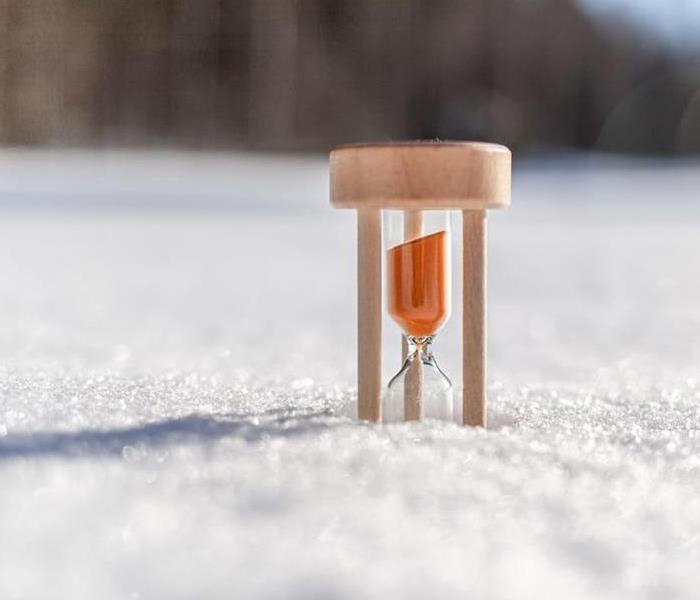 Spring snow melt can cause water damage.
Spring snow melt can cause water damage.
This recent Michigan winter has seen some interesting fluctuations in weather, both in terms of the temperature and the precipitation. Snowstorms have been followed by warmer, sunny days, which quickly eliminate the snow that had piled up. Then, it all happened again with another couple inches of snow falling just days later. Even though the weather may be a tad unpredictable, there are plenty of things you can do when it comes to snowmelt preparation and protecting your home.
Believe it or not, the earliest prep you can do for melting snow can come way before the first snowflakes drop. During the fall, you will want to be sure that your gutters are clean and clear from leaves and other debris. Melting snow can end up refreezing in the gutters, which can cause roof ice dams and damage your home.
Ice dams will form when the temperature in your attic or higher levels in the house are above freezing, and the snow on the roof melts and flows down the roof. Once the melted snow hits colder areas, like overhangs or gutters, it refreezes. Ice dams will cause water to pool, and if given enough time, that water can back up into your home through the roof shingles, leading to water damage to ceilings and walls.
Along with making sure your gutters are clear, preventing ice dams requires more snow removal and maintenance than normal. Keeping the amount of snow on your roof to a minimum can be tricky, but by using a roof rake, or a long-handled shovel, can pull heavy loads of snow off the roof. Inside your home, improving the insulation and ventilation in your attic can also help limit or prevent the occurrence of roof ice dams.
Throughout the winter, you will need to be ready to prepare both the inside and outside of your home. Michigan homeowners know the routine when it comes to clearing snow from their driveways and sidewalks, but the last thing you want to do is pile snow against the side of your home. As that snow melts, the water can go straight to the foundation.
Other areas that need to stay clear of snow include stairwells, window wells and egress exits. Drains near these areas also need to be kept clear so water can be redirected away from your home and not into the basement. Also, your sump pump discharge lines need to lead to a slope and not to an area where the water can accumulate and freeze.
Start with the sump pump when you do your indoor preparation, and perform any maintenance that it may require before a winter emergency can arrive. Next, as you inspect areas in the walls and flooring, repair any cracks and fill joints or other spaces before they can get worse. Any waterproofing that can be done should be done.
Lastly, as the temperatures steadily get higher and we move into spring, you will want to do an inspection of those areas that could have been affected by the snow melt. The gutters are the most likely victims to have been hurt by snow and ice, and repairs to the gutters should happen before the rain comes. Your landscaping also may need to be refreshed, and fixes to the grading should be done to help direct water away from your home.
No matter what you might be facing this season, SERVPRO of South and Northwest Grand Rapids is here to help you recover as quickly as possible. For more information on protecting your home from melting snow, call SERVPRO of South and Northwest Grand Rapids today at (616) 662-9700. Our specialties include fire, water, and storm damage restoration for residential and commercial clients. We also do mold and mildew remediation and much more.
Leadership and Culture: The SERVPRO Difference
3/30/2022 (Permalink)
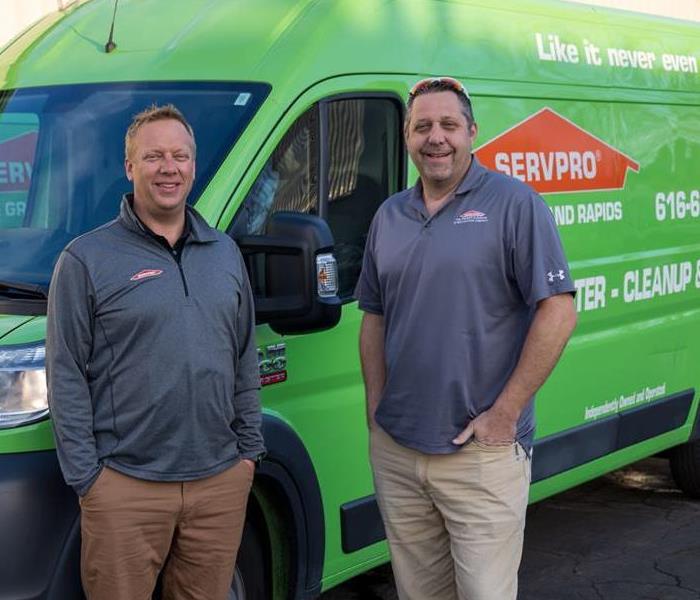 Ted Brummel and Randy Oosterheert have built a culture of making customer service a priority.
Ted Brummel and Randy Oosterheert have built a culture of making customer service a priority.
Water and fire damage to a home or business in Grand Rapids Michigan can, to some, be a major set back. The first thing that comes to many peoples mind is mold. Understanding the science about how to attack a home or business that has been affected by water damage or fire damage is important. SERVPRO of South and Northwest Grand Rapids Michigan has trained technicians and crew that put our neighbors concerns first. Our owners, Ted Brummel and Randy Oosterheert have created a culture at SERVPRO of South and Northwest Grand Rapids that "we are in the business to help people." That's what makes SERVPRO of South and Northwest Grand Rapids different. We are grateful for this culture statement. It's always the right thing to do, take care of our client, and make them whole again. Water damage, Fire damage clean up, mold and mold remediation, biohazard clean up and reconstruction in Grand Rapids Michigan, you have a company that is here for you!
A Servants Heart. One of our own serving abroad
3/23/2022 (Permalink)
 Charlie Brouwer and his friend are serving in Mexico City with YWAM.
Charlie Brouwer and his friend are serving in Mexico City with YWAM.
Charlie Brouwer, one of our production team here at SERVPRO of South and NW Grand Rapids is currently serving with YWAM (Youth With A Mission). He is spending three months in Mexico City in their Discipleship Training and from there will go serve in an effort to end Bible poverty. We are so thankful for Charlie, and his servant heart. He is a true example of a servant leader, and his work family here at SERVPRO of South and NW Grand Rapids are lifting him and his family daily.
How Can SERVPRO Of South And Northwest Grand Rapids Help Me With Odor Removal?
3/22/2022 (Permalink)
After water or fire-related disaster to your Grand Rapids home or business, you may find yourself dealing with unpleasant odors. Such odors are not anything any of us want to live with, and they can adversely affect your business, too. SERVPRO of South and Northwest Grand Rapids is equipped to deal with situations of this kind.
What Odor Removal Services Does SERVPRO Offer?
As experts in deodorization, SERVPRO of South and Northwest Grand Rapids is trained to:
- Identify and eliminate offensive odors. These odors can come from several sources, both internal and external. By identifying the cause of the odor and determining the conditions where it contacts surfaces, the odor can be removed over time without a trace.
- Our technicians have access to several odor removal products capable of thoroughly penetrating surfaces to neutralize an unpleasant odor. The science of identifying and eliminating odors can be a tricky thing, so give us a call, and leave the restoration to us.
- SERVPRO uses advanced technology for all our restoration services, including odor removal and deodorization. OSHA-approved cleaning agents may be needed to clean and remove odors and contaminants on your property. Deodorization products control odors from excessive moisture. Disinfection products stop the growth of bacteria, fungi, mildew, and other harmful microorganisms.
- Water and fire damage often causes powerful odors. The machines we use will remove airborne contaminants and control the air quality during the restoration and cleanup process. We use:
- Air scrubbers
- Thermal foggers and deodorization agents
Why Should I Trust SERVPRO To Help Me Recover From A Disaster In My Grand Rapids Home Or Business?
Simply put, our team here at SERVPRO are your industry experts!
No matter where your home or business lies in the Grand Rapids area, SERVPRO of South and Northwest Grand Rapids is here to help. We handle every type of disaster, large or small, including water damage, fire damage, storm damage, and much more. You can read testimonials from our Grand Rapids friends and neighbors here.
This franchise is independently owned and operated.
What Are Some DIY Tips To Mitigate Water Damage To Your Ada Home Until Help Arrives?
3/8/2022 (Permalink)
Water damage to your home is never fun. It can cause severe problems and unsafe conditions and sometimes compromise your health due to unclean water or mold infestation. When a flooding event of any size occurs in your Ada home, you will want to take immediate steps to manage it, even if you plan on getting help from a professional water damage restoration company like SERVPRO.
Keep reading to learn more about some things you can do yourself to mitigate water damage to your Ada home while you wait for the restoration professionals to arrive!
What Should I Do First When My Ada Home Experiences Water Damage?
After any water damage situation, your primary focus should be safety first:
- Ask yourself if it is safe to stay in the house; if you are unsure, clear the premises of anyone who could be injured.
- Electrical and "slip and fall" hazards are the most prevalent concerns you will face.
- Only do activities that are safe for you to perform, and be sure to avoid plugging in any tools in wet conditions.
- Wet materials can be weighty, so you will want to exercise caution when attempting to move items that have been affected.
What Are Some Do's and Don't’s For Me To Keep In Mind While I Am Handling Water Damage Aftermath?
What To Do After Flooding:
- Remove excess water by mopping and blotting.
- Wipe excess water from wood furniture after removal of lamps and tabletop items.
- Remove and prop wet upholstery and cushions.
- Place aluminum foil or wood blocks between furniture legs and wet carpeting.
- Turn air conditioning on for maximum drying in summer.
- Remove colored rugs from wet carpeting.
- Remove art objects to a safe, dry place.
- Gather loose items from floors.
What NOT To Do After Flooding:
- Don't leave wet fabrics in place; hang furs and leather goods.
- Don't leave books, magazines, or other colored items on wet carpet or floors.
- Don't use your household vacuum to remove water.
- Don't use television or other household appliances.
- Don't turn on ceiling fixtures if the ceiling is wet, and keep out of rooms where ceilings are sagging.
Here at SERVPRO of South and Northwest Grand Rapids, we can be onsite at your Ada home right away to help you get started on your recovery. In addition to water damage, we handle storm damage, mold remediation, odor removal, and much more.
When you hire SERVPRO to handle any disaster at your Ada residence, large or small, you can count on our 24-Hour Emergency Service. We are Highly Trained Water Restoration Technicians and trusted leaders in the water restoration industry. We employ advanced water inspection, extraction, and drying equipment, and our franchise is independently owned and operated.
Why Should You Choose SERVPRO Of South And Northwest Grand Rapids For Your Caledonia Commercial Property?
2/22/2022 (Permalink)
The aftermath of a fire, flood, or storm can be tough to deal with, especially when you are a commercial business owner/manager! Your goal will be to get back to normal as soon as possible so that you can avoid the loss of time and money that comes from a disruption of your operation. If the worst should happen to your Caledonia commercial property, SERVPRO of South and Northwest Grand Rapids are the ones to call!
What Are Some Of Our Guarantees For Your Caledonia Commercial Property’s Restoration Process?
- Our highly trained technicians provide 24-hour emergency service. We know that there is no optimal time for disaster to strike.
- Our response times are quick and timely to ensure that further damage won’t be a byproduct of the current damage.
- We are locally owned and operated, which means we know every nook and cranny of the Caledonia area, further ensuring quick response times.
- Our professional team undergoes a series of courses and training materials that provides them with the most updated knowledge on property restoration. The Employee Training modules include Fire and Water Restoration, Carpet and Upholstery Cleaning, and Crew Training.
What Are Some Things That Make SERVPRO Of South and Northwest Grand Rapids Different From Other Restoration Companies?
- We are a trusted leader in the restoration industry! With over 1,700 franchises in the U.S. and Canada, we are committed to providing quality service.
- Whether you need storm damage restoration or you need your upholstery cleaned, SERVPRO of South and Northwest Grand Rapids has the advanced technology and techniques to restore your Caledonia commercial property. This includes water extraction equipment, drying equipment, odor removal and deodorization equipment, moisture detection and measurement equipment, and more. This makes for a reliable and prompt restoration journey.
- We work with your insurance. We can even help manage the paperwork to secure a steady, stress-free recovery process.
- We are a Better Business Bureau Accredited Business and the recipient of the Angie’s List Super Service Award!
No matter what you might be facing, SERVPRO of South and Northwest Grand Rapids is here to help you recover as quickly as possible. Our specialties include fire, water, and storm damage restoration for residential and commercial clients. We also do mold and mildew remediation and much more.
This franchise is independently owned and operated.
What Are Some Important Things You Should Know About Cleaning Up Fire Damage In Your Cascade Home?
2/11/2022 (Permalink)
After a fire in your Cascade home, you will want to contact fire damage cleaning professionals to help you recover from its effects. Fire will affect everything in your home or business through the flames, heat, soot, and smoke. The assistance of professionals who have the required expertise and equipment will be vital in getting your living spaces back to normal as soon as possible.
How Will A Fire Restoration Company Like SERVPRO Help Restore My Cascade Location From Fire Damage?
SERVPRO specializes in restoring the contents of a home or business that has suffered from fire damage. The team will assess all your belongings carefully to determine which items can be restored to their “pre-fire” condition and will use several cleaning methods to restore your property to its original condition. These can include:
- Foam. This is used for upholstery. If you use water, upholstery can shrink, and the colors may bleed.
- Dry. This method is used to get rid of light residue.
- Wet. This is a very effective cleaning method that removes moderate to heavy residues.
- Immersion. In this method, items are dipped into a bath of cleaning products for a thorough cleaning that removes heavy residues and overwhelming odors.
What Are Some Ways Smoke Residue Can Affect My Cascade Home And Belongings?
- Fire-damaged electronics and the accompanying smoke often present a serious hazard, so never turn your electronics on after they have been damaged by fire, just to be safe. Smoke residue contains acids that corrode metal and can cause electronic failure in a device. Computers, televisions, and CD/DVD players should be assessed and cleaned by a professional before they are used again.
- Inhaling smoke can immediately negatively affect you, even if it’s only for a short time. With that in mind, don’t enter your home or business until all the smoke is cleared from the premises. Hiring a professional fire and smoke damage restoration contractor will ensure that your property is free from the after-effects of a fire quickly and thoroughly.
- Smoke comprises a complex mixture of gases and fine particles produced when wood and other organic materials burn. Getting smoke residue cleaned up right away after a fire in your Cascade home will be an essential part of protecting your health and safety and that of your loved ones.
If your home or business has suffered damage from fire, water, or mold, here at SERVPRO of South and Northwest Grand Rapids, we have all the training and equipment needed to get your Cascade property back to normal as soon as possible. We are your cleanup and restoration professionals from water damage to odor removal and everything in between. Call us today at (616) 217-3354!
This franchise is independently owned and operated.
What Kind Of Commercial Restoration Services Can SERVPRO Offer To Your Byron Center Business?
1/25/2022 (Permalink)
It's vital to the success of your Byron Center commercial business to be ready for anything. Accidents can happen without notice, such as spills and mechanical failures to bad weather and flooding, leaving you with repairs and cleanup projects that have to be completed for you to get back to work. Many small businesses never open again after a disastrous event, so being prepared can keep you going. Always remember that the trained technicians on the SERVPRO team are ready any time to help you do just that!
How Can SERVPRO Of South and Northwest Grand Rapids Assist Me In Commercial Damage Recovery At Your Byron Center Location?
Many different damage situations can occur at your commercial property, and SERVPRO has the necessary expertise to help you with each of them. Learn more about each of our commercial services here:
What Types Of Commercial Cleanup Projects Does SERVPRO Provide?
Messy accidents occur regularly in the busy commercial business world, and the result is often a big cleanup job. Enlisting the help of a professional restoration company like SERVPRO will be helpful for the busy business owner. SERVPRO of South and Northwest Grand Rapids offers cleaning services ranging from cleaning restaurant hoods to removing biohazard contaminants. We have the specialized training and products you need to get back to work right away. Our commercial cleaning services include the following:
When the worst happens, just knowing that SERVPRO of South and Northwest Grand Rapids is available to help you 24 hours a day and seven days a week will give you the peace of mind you need. We are faster to any size disaster, and our highly-trained technicians bring with them all the tools and equipment necessary to get you back to normal as soon as possible. In addition to our commercial restoration services, we offer other helpful assistance for your Grand Rapids area home.
This franchise is independently owned and operated.
What To Do If You Experience Winter Storm Damage To Your Comstock Park Home?
1/11/2022 (Permalink)
Cold weather poses a severe challenge to Comstock Park property owners. Ice, snow, and sleet can wreak havoc on your roof, siding, driveways, and walkways, while the frequent freeze and thaw cycles can lead to frozen pipes, leaks, and other emergencies. Winter storm damage is nothing to treat lightly, and quick action in dealing with the damage is essential to protecting your home and loved ones.
At SERVPRO, we have helped many Comstock Park area homeowners deal with disasters related to winter storms. Years of managing storm restoration projects have shown us that when property owners plan and know how to handle winter storm damage quickly, it will lessen the effects of the disaster.
Whether you’re facing winter storm damage right now or you want to be ready for the worst, the following steps will help you keep disasters to a minimum and get your property back to normal.
What Are Some Common Winter Storm-Related Issues You Need To Plan For?
Comstock Park residents know that it’s always possible they may get snowed in or deal with icy, slippery surfaces, but there are many other potential emergencies caused by winter storms to think about, such as:
- Flooding. Cold snaps and freezes can damage pipes and cause them to burst, leaving you with water damage and flooded areas in your home that need emergency restoration.
- Fire. Improperly cleaned chimneys or space heaters plugged into overloaded outlets or left too near flammable objects can cause fires during a winter storm.
- Leaking Roof. Ice dams that block drainage pipes, heavy snow and ice breaking through shingles, hail, and high winds from winter storms can all be harsh on your roof, leaving your Comstock Park property exposed to moisture damage.
What Are Some Winter Storm Damage Best Practices For My Comstock Park Location?
Once a winter storm occurs, you can be left facing damages that need fixing right away; if you don’t know what to do next, the situation can feel overwhelming. To help you get quick and effective storm damage restoration for your property, call SERVPRO right away at (616) 662 9700!
While you wait for the professionals to arrive:
- Remain Calm. It will be best if you make good decisions quickly, so slow down, take a deep breath, and make careful assessments of what you’re facing.
- Safety First. When your property has suffered damage, it may put the people on the premises at risk. So you will want to ensure that family and loved ones are safe. Make sure you know where everyone is and move them out of unsafe locations. If the area is severely damaged, you may need to arrange for a temporary place for people to stay while the restoration is completed.
- Power And Water. Winter storms can often lead to leaks or floods from damaged roofs or burst pipes. Keeping the water running may worsen flooding while leaving electricity on could cause a fire. Shut off the flow to damaged areas, and call your utility companies if you need their assistance.
- Insurance. Make detailed notes and take photos of anything affected by the storm damage; this might include everything from furniture and business equipment to personal documents, valuables, and more. This step is essential for the insurance claim process. Once the storm is over and any immediate danger is gone, it’s time to reach out to your insurance company. Call your agent to get the process of filing a claim started.
Knowing what to do is essential to handling winter storm damage, and other emergency restoration needs swiftly and smoothly for your property. SERVPRO of South and Northwest Grand Rapids is here to help you should the worst happen. We will work with your insurance claims adjuster, too.
We offer many other services for your Comstock Park home in addition to storm damage, such as water damage restoration, fire and smoke damage restoration, mold remediation, and much more! Contact us for a free consultation.
This franchise is independently owned and operated.
What Are Some Dos And Don’ts If You Experience Water Damage In Your Walker Business?
12/28/2021 (Permalink)
After any water damage situation, your primary focus should always be safety first. If the flooding is extensive, you need to ensure it's safe for everyone to stay in the building; water damage can create dangerous structural issues. As everyone knows, electricity and water are a bad combination, so that's another thing to watch out for. When moving about the premises, you will want to guard against slip and fall accidents.
You may decide to begin cleaning up the mess yourself, but please keep in mind that wet materials can be far heavier than they are when they are dry. Know your limits, and only do what you know you can do safely. Engaging the help of a restoration specialist like SERVPRO can be a wise choice that will allow you to avoid unfortunate accidents. We can be onsite at your Walker commercial location right away to start your water damage recovery process.
What Are Some Steps I Can Take If My Walker Business Is Affected By Water Damage?
Some "dos" when handling water damage to your commercial location:
- Do remove excess water by mopping and blotting.
- Do wipe excess water from wood furniture after removal of lamps and tabletop items.
- Do remove and prop wet upholstery and cushions.
- Do place aluminum foil or wood blocks between furniture legs and wet carpeting.
- Do turn air conditioning on for maximum drying in summer.
- Do remove colored rugs from wet carpeting.
- Do remove art objects to a safe, dry place.
- Do gather up loose items from floors.
What Are Some Tasks I Need To Avoid When Managing Water Damage At My Commercial Location In Walker?
Here are some definite "don'ts" to be mindful of while recovering your property from a water damage event:
- Don't leave wet fabrics in place.
- Don't leave books, magazines, or other colored items on wet carpet or floors.
- Don't use a regular vacuum to remove water.
- Don't use computers or other appliances.
- Don't turn on ceiling fixtures if the ceiling is wet, and keep out of rooms where ceilings are sagging.
SERVPRO of South and Northwest Grand Rapids is here to help you with emergencies and disasters of all types and sizes. In addition to water damage, we handle fire damage, mold remediation, odor removal and deodorization, biohazards, and more!
This franchise is independently owned and operated.
What Makes SERVPRO of South And Northwest Grand Rapids Different From Other Restoration Companies Near Me?
12/14/2021 (Permalink)
It can be challenging to get back to normal after experiencing the aftermath of a fire, water, mold, or storm damage to your Alpine Township home or business. SERVPRO of South and Northwest Grand Rapids is here to help you recover from emergencies and disasters of all types and sizes, and we’re proud to serve our community. Let’s talk about a few ways that SERVPRO is different from other area restoration companies:
Why Should I Choose SERVPRO of South And Northwest Grand Rapids?
- Our record response times mean that we can be onsite right away in case the worst happens. With over 1,700 franchise locations in the US and Canada, SERVPRO is strategically positioned to be faster to any size emergency. We know time waits for no one, and we make it to take immediate action when a disaster occurs.
- Our highly trained technicians have experience with property damage restoration. We believe in ongoing training and education. This ensures that our staff is well-prepared with IICRC industry certifications and knowledge of all the latest trends in the restoration industry.
- We employ all the current technological advancements to ensure that SERVPRO of South and Northwest Grand Rapids can restore your Alpine Township home or commercial business to its preloss condition quickly and reliably. Our specialized equipment includes water extraction, drying, moisture detection, and measurement equipment, as well as anti-microbial treatments.
What Types Of Services Does SERVPRO Of South And Northwest Grand Rapids Offer?
No matter what you’re facing, we’ve got you covered. We handle all types of emergencies and disasters, including:
And much more!
We know how tough it is to see your home or business affected by a catastrophe, so here at SERVPRO of South and Northwest Grand Rapids, we are committed to getting you back to normal as quickly as possible. Don’t hesitate to contact us any time you need help.
This franchise is independently owned and operated.
How Do I Properly Clean My Sparta Home After A Fire?
11/30/2021 (Permalink)
Contacting a cleaning professional may be the best decision you can make if a fire occurs in your Sparta home. The flames, heat, soot, and smoke will affect every room in your house, and your structure can even be adversely affected. Recovery from a fire event is a tremendous job, so you will need the assistance of professionals who have the expertise and equipment required to get your work or personal space back to normal as soon as possible. Our SERVPRO of South and Northwest Grand Rapids team can be onsite right away to help you begin the recovery process.
What Steps Can I Take While Waiting For SERVPRO of South and Northwest Grand Rapids To Arrive At My Sparta Home?
While you are waiting for SERVPRO of South and Northwest Grand Rapids to arrive, there are some things you can do to begin the cleaning and recovery process:
- Be sure to limit movement in the home to prevent soot particles from being embedded into upholstery and carpets.
- Keep hands clean so as not to further soil upholstery, walls, and woodwork.
- Place clean towels or old linens on rugs, upholstery, and carpet traffic areas.
- If electricity is off, empty freezer and refrigerator and prop doors open.
- Clean and protect chrome with a light coating of petroleum jelly or oil.
- Wash houseplants on both sides of the leaves.
- Change HVAC filter.
- Tape double layers of cheesecloth over air registers.
What Types Of Fire-Related Cleaning and Restoration Services Does SERVPRO of South and Northwest Grand Rapids Offer?
Cleaning Process. SERVPRO specializes in restoring the contents of a home or business that has suffered from fire damage or water damage. The team will assess all your belongings carefully to determine which items can be restored to their “pre-fire” condition and will use several cleaning methods to restore your property to its original condition. These can include:
- Foam. The foam method is used for upholstery since upholstery can shrink, or the colors may bleed in water.
- Dry. This method gets rid of light residue.
- Wet. This technique is a very effective cleaning method used to remove moderate to heavy residues.
- Immersion. In this method, items are dipped into a bath of cleaning products for a thorough cleaning that removes heavy residues and overwhelming odors.
- Electronics. Electronics damaged by fire and the accompanying smoke often present a serious hazard, so never turn on fire-damaged electrical devices. The smoke residue contains acids that corrode metal and can cause electronic failure in an electrical component. Computers, televisions, and CD/DVD players should be assessed and cleaned by a professional before being used.
- Odor Removal. Inhaling smoke can have an immediate negative effect on you, even if it’s only for a short time, so managing lingering soot and smoke is important. Hiring a professional fire and smoke damage restoration contractor will ensure that your property is free from the after-effects of a fire quickly and thoroughly.
- Reconstruction. If the smoke and fire damage to your home or business is such that it will need extensive restoration or rebuilding, SERVPRO can organize your move-out process. Removing your items from designated areas will help any remodeling process go a lot faster and protect them from any further damage. Once that is complete, we can then coordinate and organize your move back into your premises to get back to normal.
If your Sparta home or business has suffered damage from fire, water, or mold, SERVPRO of South & Northwest Grand Rapids team is fire damage and water damage experts, and we handle mold remediation, too. As part of our fire restoration services, we remove all unpleasant fire-related odors, as well.
We can get your home or business Certified: SERVPRO Cleaned. This franchise is independently owned and operated.
What Are The Most Common Places For Mold Growth In Your Grand Rapids Business?
11/16/2021 (Permalink)
There are many familiar places in your Grand Rapids business that are highly susceptible to mold growth. It’s wise to regularly inspect the most commonly found areas to avoid mold colonization in your commercial business location. Doing so will help you avoid the damage and effects to health that mold can pose.
What Areas Should I Put On My Mold Inspection List For My Grand Rapids Commercial Enterprise?
We recommend that you assess your property and compile a list of places where mold is most likely to be found. Dark or poorly lit and damp areas are always susceptible to the establishment of a mold colony, such as:
- Crawl spaces
- Ductwork
- Closets
- Attics
- Sinks
- Toilets
- Faucets
- Drains
- Plumbing fixtures
A professional mold remediation company like SERVPRO can inspect the most vulnerable areas of your Grand Rapids business and schedule cleaning and remediation services to keep your commercial enterprise mold-free.
What Are Some Important Things To Know About Mold?
- Mold is present almost everywhere, indoors and outdoors.
- Mold spores are microscopic, float along in the air, and may enter your home through windows, doors, or AC/heating systems or even hitch a ride indoors on your clothing.
- Mold spores thrive on moisture. Mold spores can quickly grow into colonies when exposed to water. These colonies may produce allergens and irritants.
- Before mold remediation can begin, you must address any sources of water or moisture. Otherwise, the mold may return.
- Mold often produces a strong, musty odor, and that odor can lead you to possible mold problem areas.
- Even higher-than-normal indoor humidity can support mold growth. Keep indoor humidity below 45 percent.
The SERVPRO of South & Northwest Grand Rapids team is specifically trained to handle mold remediation, and we’re available 24 hours a day, seven days a week to help. You can contact us at (616) 662 9700 for a mold inspection and restoration of your property back to its mold-free condition. In addition to our mold remediation services, we handle biohazard cleaning, odor removal, deodorization, and more!
We can get your home or business Certified: SERVPRO Cleaned, too. This franchise is independently owned and operated.
How Can SERVPRO Help Me With My Cascade Insurance Claim?
10/5/2021 (Permalink)
Filing an insurance claim after a disaster can be frustrating and confusing, even if the damage you experienced is small. There are many different rules to follow, forms to fill out, and timelines to follow. Mistakes in any one of these areas could cause the denial of your claim, and we know that's not something you want to experience.
Our SERVPRO team is here to help you file your insurance claim for your Cascade home or business. We have experience in all the areas necessary to ensure that your claim is filed correctly and on time.
What Are The Steps I Need To Take When Filing An Insurance Claim For My Cascade Property?
According to FEMA, insurance is generally the best source of funds to recover from a disaster. If you have insurance covering all or part of your losses:
- File your claim immediately. Get the process started as quickly as possible. The faster you file your insurance claim, the quicker you can move ahead with your recovery. If your insurance doesn't cover all your disaster-related severe expenses, you may be eligible for FEMA assistance to help fill the gap.
- You can make temporary repairs, but you will want to talk with a professional restoration company before doing so.
- Take photographs or videos of the damage and keep all receipts related to clearing smoke, home repair, or other disaster-related needs.
- If you have to relocate during repairs, keep all receipts for reimbursement, as well.
- You may be eligible for FEMA assistance, and you can learn more here: www.disasterassistance.gov.
How Can SERVPRO Assist Me In Filing My Cascade Insurance Claim?
- We can be on-site right away to begin assessing the damage and making recommendations for recovery.
- We help determine unsafe conditions and structural issues.
- We work with your insurance representative to start the restoration process according to your policy.
- SERVPRO will work alongside you to go over all the forms needed when completing your claim, help to ensure everything is filled out completely and submitted on time.
It's our job to help you recover from any disaster, and that includes managing the insurance claim process. We will make sure you are reimbursed fully according to your policy so that you can get back to normal right away.
SERVPRO of South and Northwest Grand Rapids can handle disasters of all kinds, including storm damage, fire damage, and much more! Visit our website to find out more about all the ways we can help you manage a disaster in your Cascade home or business.
We can get your home or business Certified: SERVPRO Cleaned, too. Ask us how!
This franchise is Independently Owned and Operated.
What Is The Proper Way To Use A Fire Extinguisher?
9/21/2021 (Permalink)
You may never have used a fire extinguisher before, and it can be a little daunting even to consider. When it comes to fire safety, it’s better to be safe than sorry, however! The time to learn how to handle a fire extinguisher is when there is no emergency, giving you time to think about what you are doing and practice the steps. Being proactive by learning this critical skill in advance of a fire emergency is one smart way to guard the safety of your Byron Center home or business.
Below you will find the steps to follow for the proper use of a fire extinguisher, as well as some further information to help you:
What Are The Correct Steps To Take When Using My Fire Extinguisher To Protect My Byron Center Property?
The P.A.S.S. method is the most highly recommended method to use when handling a fire extinguisher:
- Pull the pin on the extinguisher.
- Aim the hose nozzle low toward the base of the fire.
- Squeeze the handle to release the extinguishing agent.
- Sweep the nozzle from side to side at the base of the flames until extinguished.
What More Do I Need To Know About Handling A Fire At My Byron Center Property?
Knowing how to operate the extinguisher is not all you need to understand. Responders to fire also should be able to adhere to the following protocol:
- Sound the fire alarm or call the fire department immediately.
- Before approaching the fire, determine an evacuation route away from flames, excessive heat, and smoke, and keep this evacuation route from being blocked.
- Use the P.A.S.S. technique for discharging an extinguisher and back away from the area if the fire flares up again.
- If the extinguisher is empty and the fire is not out, evacuate immediately.
- If the fire grows beyond what you can handle safely, evacuate immediately.
According to O.S.H.A., the most common emergency small businesses need to plan for is fire. O.S.H.A. requires employers to thoroughly train workers on an annual basis at minimum how to use an extinguisher properly and assess a situation accurately to determine when evacuation is the safest course of action.
You can find more fire extinguisher information here.
When it comes to damage from fire, water, or any other disaster of any size SERVPRO of South and Northwest Grand Rapids is here to help! In addition to fire damage, we handle many other kinds of issues, such as mold remediation and commercial cleaning.
We can get your home or business Certified: SERVPRO Cleaned!
This franchise is Independently Owned and Operated.
What Are The Top Three Places To Check For Water Damage In My Caledonia Home?
9/17/2021 (Permalink)
Conducting regular inspections of areas in your Caledonia, Michigan home or business most likely to experience water damage will allow you to take care of issues before they become serious. Some spaces are more likely to be affected than others, of course, so these are the places you need to direct your focus. Water damage can occur with little-to-no warning, creating damp conditions that are just right for a mold colony, and leaving you with an unsafe and unhealthy environment.
Which Areas Are Most Prone To Water Damage In My Caledonia Home?
The bathroom. Most bathrooms get cleaned thoroughly at least once a week, and this is the perfect time to check for leaks and damp areas. Look in the least-traveled spots, such as corners of the linen closet, behind the toilet, under the sink. If you find leaks, they will need to be fully dried out and the water source determined so that repairs can be made. You can invest in a dehumidifier, which will be very helpful in reducing humidity.
The kitchen. This area of the home is used more than any other area in homes. Watch for spills and leaks and clean them up immediately to ensure that wet conditions are not attracting mold spores, which are always in our air. Under the sink or refrigerator you may find areas damaged by water without you noticing, so get out your flashlight to be sure you can see every corner.
The laundry room. An unnoticed leak behind the washing machine can create huge issues over time. Pull the washer and dryer out from the wall regularly, and make sure the areas behind them are clean, dry, and disinfected.
Other areas you may want to inspect regularly for water damage: hall closets, garage, and basement.
What Other Water Damage-Related Services Does SERVPRO of South and Northwest Grand Rapids Offer?
Other related issues may evolve from a water damage episode, such as structural deterioration, mold infestation, unhealthy conditions, or unpleasant odors. In addition to water damage restoration, our company also help manage such related services as:
SERVPRO of South and Northwest Grand Rapids is always here to help you with any issues related to water damage in your Caledonia home or business. Large-scale cleanups after storm damage and fire damage are our specialties, and we are commercial restoration experts, too.
We can get your home or business Certified: SERVPRO Cleaned, as well. This franchise is independently owned and operated.
What Are Some Smart Ways To Storm-proof My Ada Garage?
9/17/2021 (Permalink)
It is crucial to storm-proof your garage. If the garage is left unprotected, it is much more likely that there will be expensive damages even in your Ada, Michigan home itself. According to BobVila.com, "failure of the garage door ... leaves a breach in the house envelope that can be as big as 300 square feet. Experts conclude that the resulting change in pressure can blow the roof off a house or create other tears and fissures in the home that allow rains and water to invade and damage or ruin drywall."
How Can I Best Protect My Home By Storm-proofing My Ada Garage?
It is important to consistently inspect your garage door for holes and cracks and seal them when they are found. Install a bracing system to the door. Braces anchor the door to the floor, walls, and hinges, adding support and wind resistance. When it’s time to replace the garage door, look into purchasing a wind-resistant door. Install a garage door with a high wind-resistance rating. Storms that bring with them extreme levels of wind will cause the most damage, and when a garage is breached the winds will batter the rest of your home.
You can remove windows in the garage if you are concerned about heavy storms, but that may not always be an option. If you have any windows in your garage, you want to make sure the glass is impact-resistant. Installing outside window protection that can be locked and protected from impact and storm remnants is another way to provide storm protection for your garage and home.
Install a trench drain around your garage and down the sides of your driveway to divert water. Flood vents inside the garage can drain any water coming inside quickly before levels rise and cause water damage or mold growth down the line, preventing the need for mold removal.
How Can SERVPRO of South and Northwest Grand Rapids Help Me Recover From Storm Damage To My Home in Ada, MI?
If your home has experienced storm damage, we are here to help. The SERVPRO of South and Northwest Grand Rapids has the skills, training, and equipment needed to restore your property from all the destruction such an event can bring. You can count on us to handle such water damage issues as:
We can get your home or business Certified: SERVPRO Cleaned, too. This franchise is independently owned and operated.
How Can Water Damage Be Prevented During Construction In Grand Rapids?
9/6/2021 (Permalink)
During your Comstock Park commercial property construction, its foundation, and base structures are exposed to elements, including wind, rain, heat, and cold. These weather conditions can cause water damage during construction if no steps are taken to prevent moisture from finding its way through unsecured building openings like windows, doors, and more. This, in turn, may lead to mold growth, which is dangerous for your health and safety, can negatively affect the integrity of the building. Proper water damage prevention can quickly help avoid this type of situation.
What Are Some Ways To Avoid Water Damage On My Comstock Park Construction Project?
We have established that prevention is the best way to avoid water damage. Take such steps as:
- Monitor For Water Leaks. Most pressurized potable fire and water systems can have monitoring devices attached, enabling their mains to be monitored for any signs of water leakage. You can set up these devices to signal you by an alarm, alerting you when a leak is detected and allowing you to catch leaks early so remediation can occur immediately.
- Regular Maintenance. Another part of prevention is to maintain items at risk carefully. You can inspect all pipes and related equipment regularly to catch issues before they start. As soon as a weak or damaged piece of equipment is identified, be sure to take steps to repair or replace it.
What Are Other Ways To Ensure Water Damage To My Grand Rapids Construction Project Does Not Occur?
Everyone on the site needs to be experienced and qualified so that unnecessary accidents don't happen.
- Employ Qualified Contractors. Any contractors you are working with are fully qualified to complete the construction components they are responsible for safely and professionally.
- QA/QC. Having a Quality Assurance/Quality Control Plan in place is key to preventing water damage during construction; planning is the best way to prevent damage from happening. This plan will help you know what to do if a natural disaster or severe weather is heading your way. A QA/QC plan will include:
- Planned evacuation routes
- A plan for leading water away from your construction project
- An assessment of water infiltration susceptibility enabling you to account for vulnerabilities
SERVPRO of South and Northwest Grand Rapids is here to help when the worst happens. From water damage to commercial restoration, we have the skill and equipment to get you back to work as soon as possible.
We can get your home or business Certified: SERVPRO Cleaned.
This franchise is Independently Owned and Operated.
What Are The Benefits Of Having Commercial Storm Damage Insurance For My Grand Rapids Business?
8/27/2021 (Permalink)
When a severe weather system hits the Grand Rapids area, local businesses may experience damage and devastation. According to the NOAA National Centers For Environmental Information, storm damage to companies can be significant. Storm insurance is a vital part of keeping any enterprise safe from the often devastating costs associated with storms. A business owner may not have the available cash to pay for expensive restoration and reconstruction projects, so this type of insurance policy will be an important part of any smart business strategy.
How Can A Storm Damage Insurance Policy Help My Grand Rapids Business Recover?
Two of the most important areas in which a storm damage insurance policy can help you get back to normal after damage from bad weather are:
Property Loss. Such insurance coverage will usually handle payment to replace or restore lost valuables and possessions - also referred to as property loss. Heavy rainfall and flooding may have ruined items essential to what you do. A storm damage policy for your business can ensure that you receive the correct compensation that will allow you to replace the items and get back to business.
The following are typically listed as covered items:
- Electronics
- Technology
- Fixtures
- Documents
- Furniture
- Inventory
Structural Damage. The most significant expense is often from the repair of the facility itself. Storm insurance will provide funding for the remediation and restoration of the business structure, with the owner usually paying a deductible amount upfront. The insurer then provides payment for the balance; maximums may apply here, so you will want to check with your insurance representative.
What Are Some Other Advantages Of Purchasing Storm Damage Insurance Coverage For My Grand Rapids Business?
Best Coverage. Private insurance options can give you better coverage than a government policy, such as FEMA. Private storm insurance policies can be stand-alone, meaning they provide your primary or base flood insurance. Or they can be 'excess', which means they provide additional coverage on top of a base policy, such as a FEMA policy.
Peace Of Mind. Storm insurance is a business owner's safety net, giving financial support during hard times, as well as the peace of mind that comes with knowing your enterprise is safe, no matter what comes.
The restoration team here at SERVPRO of South and Northwest Grand Rapids is available 24 hours a day, 7 days a week to assist you if the worst happens. In addition to storm damage and commercial restoration, we handle fire damage, mold remediation, and more.
We can get your home or business Certified: SERVPRO Cleaned, too. Ask us how!
This franchise is Independently Owned and Operated.
How Do I Inspect My Water Heater In Grand Rapids?
8/10/2021 (Permalink)
No one likes going without hot water, especially when it happens unexpectedly. Your water heater can stop working with little notice, leaving you with an uncomfortable situation!
One of the best ways to avoid this kind of experience is to inspect your water heater regularly. This practice will help you stay on top of any maintenance issues and make replacements or repairs ahead of time, allowing you to avoid leaks, drips, and water damage.
What Should I Look For When I Inspect My Water Heater?
- Find the age of your unit by looking for the serial number on the manufacturer sticker on the upper portion of the water heater. Each manufacturer has a similar date code, and they can vary, so check the manufacturer's website to date your machine. If your water heater is more than ten years old, you may want to consider replacing it, especially if its location means a leak will cause you water damage.
- If you see rusty water coming from the hot side piping in your home, this is a sign that your water heater is rusting away on the inside and may begin to leak soon. Test first to see if it is coming from galvanized pipes, if you have those, by draining a few buckets of hot water from the water heater. If the water gradually clears, it isn't your water heater.
- Sediment will build up at the bottom of your water heater tank over time. As the sediment is heated and reheated, it eventually will harden and cause rumbling noises to develop; that is another sign that your water heater needs to be replaced soon to avoid water damage from leaks.
- If you notice moisture around your water heater, you may have a small leak or a fracture in the tank.
What Do I Do If I Find An Issue During The Inspection Of My Grand Rapids Water Heater?
If you are concerned about the failure of your water heater or if you discover any signs of trouble:
- Try not to panic
- Make sure you know exactly where the leak originates
- Turn off the water to your water heater unit
- Drain the tank if you are confident you can do this safely:
- Open some of your hot water taps around the house, preferably those located on floor levels above the heater
- Locate the drain valve near the bottom of your water heater
- Attach a garden hose to the drain valve and run the hose to a place it can drain safely, like a floor drain or your driveway
- Open the drain valve and let the water start flowing. Generally, this step takes 10 minutes or less
- Once the tank is empty, disconnect the hose and close both the drain valve and the hot water taps you opened in the first step
- Call a plumber
- Call your restoration specialist if you have experienced water damage
We are always ready to help you if water damage occurs in your home or business. Our SERVPRO of South and Northwest Grand Rapids technicians are highly trained and skilled in all types of restoration and cleanup projects, including mold remediation - which is often an unfortunate and unpleasant side-effect of water leaks.
We can get your home or business Certified: SERVPRO Cleaned, as well. Ask us how!
This franchise is Independently Owned and Operated.
How Do SERVPRO Technicians Make All The Difference
7/27/2021 (Permalink)
Having our SERVPRO of South and Northwest Grand Rapids technicians onsite when the worst happens can make all the difference. They are a team of professional, dedicated, and highly skilled people who are committed to helping you manage disasters of any size. They are ready 24 hours a day, seven days a week if the worst happens, and their primary goal is always to get you back to normal as soon as possible.
What Types Of Training Do SERVPRO Of South And Northwest Grand Rapids Technicians Maintain?
Since 1967, SERVPRO Industries, Inc. has been redefining the mitigation and restoration industries. In addition to training at the regional level, SERVPRO developed the National Training Center in 1992 to teach restoration and mitigation skills to Franchise Owners and insurance industry employees. Our technicians receive and maintain ongoing training on both local and regional levels in the following areas:
Employee Certification Training
Employee Certification Training is a self-paced program designed for franchise employees. Certification is awarded after the successful completion of course materials and an examination. Modules include:
- Crew Training
- Fire Restoration
- Water Restoration
- Carpet and Upholstery Cleaning
New Franchise Training
A 15 day in-house, hands-on training program at our corporate training facility. Designed primarily for new franchise owners but also a valuable course for franchise employees. The program covers all aspects of:
- Fire Restoration
- Water Restoration
- Carpet and Upholstery Cleaning
- Mold Mitigation
e-Learning
Our e-learning program is web-based and designed to be an ongoing self-paced training program. Video presentations and support materials are followed by a knowledge test at the end of each module.
IICRC Training Program
SERVPRO is an approved IICRC Training School that offers year-round classes in the following categories:
- Fire Restoration
- Water Restoration
- Carpet Cleaning
- Upholstery Cleaning
- Applied Structural Drying
- (in our purpose-built ASD facility)
Continuing Education
SERVPRO offers credit and non-credit courses for insurance agents, insurance adjusters, real estate professionals, and franchise staff. These programs are designed to improve knowledge of emergency mitigation. Courses include:
- Water Damage Restoration
- Fire Damage Restoration
- Understanding Mold in the Restoration Industry
- Restorative Drying for Loss Control
- Mitigation Awareness Response Seminar
- (non-credit courses)
How Can The Ongoing Training Of SERVPRO Of South And Northwest Grand Rapids Technicians Benefit Me?
When you work with a SERVPRO of South and Northwest Grand Rapids technician, you can be sure that:
- your restoration will be completed in a timely and professional manner
- all recovery will be made using the correct techniques for every material and situation
- your safety will be the foremost concern
- your technician will be equipped to work with any insurance representatives
- dangerous chemicals and substances will be managed and disposed of properly and safely
- unsafe structural elements will be assessed and repaired or removed accordingly
When it comes to safety and restoration, the team here at SERVPRO of South and Northwest Grand Rapids is ready to go, day or night. If the worst happens, you can count on us to be there right away to help you get back to normal as soon as possible. We have the right training, equipment, and skills to help you manage disasters of any size, including water damage, biohazards, and more.
We can get your home or business Certified: SERVPRO Cleaned, too.
This franchise is Independently Owned and Operated.
Maintaining Your Smoke Detectors
7/13/2021 (Permalink)
Smoke detectors are not something we pay much attention to during our day-to-day living, but they immediately become essential if a fire happens! Make it a priority to maintain your smoke detectors regularly so that they are always ready to alert you in the event of a fire.
Making Sure Your Smoke Detectors Work As They Should
- Make sure you know how old your alarms are, and test them monthly using the provided test button.
- Keep them clean and free of greasy build-up and dust, which could affect their performance. A scheduled cleaning will make sure your smoke detectors stay in good working order.
- Ensure that your smoke detectors are powered up and ready to go at all times and schedule battery changes so that they are always prepared to alert you whenever you need them.
- Your smoke detectors should all go off simultaneously in the event of a fire, so contact a professional to make sure they are all synced.
- Replace all smoke detectors, including those using 10-year batteries and hard-wired alarms, before turning ten years old. If they don’t respond correctly during a routine check, it’s definitely time for new units.
- Save and follow the manufacturer’s instructions for testing and maintenance of your units.
- A certified inspection entity should mark your smoke detectors.
Install Smoke Detectors In All The Right Places
- Every room in your home or business needs a smoke detector, any place where people will be, and where a product is stored, as well.
- Each unit should be securely fastened to its surface, whether it is a wall or a ceiling.
- Ensure that smoke detectors are in all areas where people spend time, from the bathroom to the warehouse of your business, and remember that customer waiting areas and public restrooms need to be outfitted, as well.
We care about your safety here at SERVPRO of South/Northwest Grand Rapids, so don’t hesitate to contact us for all your large-scale cleanup projects. We’re experts at handling water and fire damage, mold prevention and remediation, vandalism, and biohazards. Ask us how we can get your home or business Certified: SERVPRO Cleaned. This franchise is independently owned and operated.
Someone Vandalized my Commercial Property, Now What?
6/29/2021 (Permalink)
You’ve worked hard to build your commercial business, investing time, effort, and money into your enterprise over time to achieve your goals. Setbacks happen, economic conditions fluctuate, and challenges arise every day, and as a wise business owner, you meet them all head-on, managing every adverse circumstance, large or small. Building a business is hard, so choosing to partner with a professional restoration business can be a wise business decision when situations arise.
How To Manage Vandalism To Your Commercial Property
A restoration company like SERVPRO can be there right away if you experience the damage that comes from vandalism. Our team will help you get back to work as soon as possible if your operations are disturbed.
Vandalism can be damaged property from a break-in, such as broken windows, doors, or other entry points. It can also be more severe and malicious, involving dangerous substances, unsafe conditions, or a biohazard. No matter what you are facing, trained SERVPRO professionals can help you manage it safely.
SERVPRO Is Here To Get You Back To Normal
Depending on the type of damage you have experienced, a vandalism event can stop you from working. We are here to do whatever is needed to ensure you can return to normal as soon as possible with minimum loss. If your location is unsightly due to the work of a vandal, we can complete that kind of restoration project right away. At the same time, if there are unsafe conditions in your business, we will assess the situation first to ensure that your location is safe for anyone who needs to be there. We will complete all repairs and restoration so that your commercial property is as good as new!
In addition to vandalism, SERVPRO of South /Northwest Grand Rapids specializes in cleanup projects of all types and sizes. From flooding and spills that cause water damage to soot and smoke removal and all the other issues that occur after a fire, we are the folks to call for help. We have the equipment and experience necessary for mold prevention and remediation, too, and we can get your home or business Certified: SERVPRO Cleaned, as well. This franchise is independently owned and operated.
What To Do After A Tornado
6/15/2021 (Permalink)
A tornado can pop up with little-to-no warning, and while you want to be as prepared as possible ahead of time, such an event will cause a lot of damage. Do your due diligence when it comes to preparedness, always, and let’s talk about what to do afterwards, as well, so you can be as safe as possible.
What to do after a tornado:
MAKE SURE EVERYONE IS SAFE.
Take stock of everyone who is with you, whether that is family members, friends, co-workers, fellow shoppers, even pets. See if anyone needs medical attention, and if so, can you help them using first aid, or will you need to contact emergency health professionals? If there are any children with you, make sure they are connected with parents or guardians.
ASSESS DAMAGE.
Take inventory of the damage to the building you’re in. Notice any exposed wires, broken glass, sharp objects, or chemical spills, and take precautions. Do not touch or move anything without protecting yourself with personal protective equipment. Do you smell smoke or see any sparks? Do you see any unstable fixtures, walls, roofing, or other items? Move people away from areas that are possibly dangerous if it can be done safely.
CONTACT HELP.
Call emergency personnel right away. Let them know if there is anyone who is injured, and how badly. If your building has been damaged by a tornado, describe the damage and whether anything seems to be unsafe or dangerous.
SCHEDULE RESTORATION AND RECOVERY.
Once people are safe, you can begin to consider recovery, if you are the owner or resident of the building that has been affected. A professional restoration company like SERVPRO can be onsite immediately to help you begin the restoration process. They can assess the damage, note any danger, and start to clean up the after-effects of the tornado.
When it comes to dangerous weather events, it’s good to know who’s on your side. You can always count on SERVPRO of South and Northwest Grand Rapids to help you manage when you experience a disaster of any kind. We handle fire damage, water damage, mold remediation, chemical spills, and more. We can get your home or business Certified: SERVPRO Cleaned, too. This franchise is independently owned and operated.
How To Prevent Water Damage In Your Bathroom
6/1/2021 (Permalink)
Your bathroom is probably the most vulnerable area in your home or business when it comes to damage from water, and that only makes sense. To prevent such damage from occurring, you will want to do regular assessments of pipes, faucets and fixtures, caulking, and more. If you can identify aging equipment and replace it before it fails, you will avoid the most common causes of water damage in your bathroom.
Here is a great list of things to look for:
- You may notice wallpaper or paint peeling away or appearing discolored in your bath area. Check for bowing in the walls, which can be a result of long-term seepage. If the flooring is swollen or removed from the subfloor, that is another indicator of water seepage. If any of these signs appear, it’s important to find the source of the leak.
- Look for cracks in window seals and door panes, as well.
- Odors are a powerful indicator that there is an excess water problem. Oftentimes, it’s mold or mildew that causes those smells, so look in those hard-to-see places, such as under the sink, behind the toilet, and in the closet.
- Make a regular inspection of pipes and hoses; if you see one that is getting old, replace it BEFORE it fails. Waiting until it breaks will mean a water damage event, which you want to avoid.
- If you do experience flooding in your bathroom, such as from a toilet backing up or a bathtub overflowing, make sure you remove the standing water right away. Employ fans if you can (be sure not to plug them in until you know that there is no dampness in the wall); these will help to speed up the drying process.
Call the professionals at SERVPRO if the worst happens; we’re experienced and trained to remediate and repair areas that have extensive damage from excess water due to leaky pipes, flooding, etc. Our team here at SERVPRO of South and Northwest Grand Rapids is here to help with cleanups after water damage or fire damage, and we handle mold invasions, biohazards, vandalism, and more. We can get your home or business Certified: SERVPRO Cleaned, too! This franchise is independently owned and operated.
Preparing Your Home For A Major Storm
5/12/2021 (Permalink)
When the warmer air of Spring collides with the last of winter cold, major storms can be the result. Preparing your home for a major storm will help you and your loved ones stay safe and can prevent damages in many cases. Here are tips to help you prepare your home for a major storm:
BE PROACTIVE
Conduct an inspection of your home and yard before stormy weather hits to determine if your home has a leaky roof or windows - these can of course cause big problems during the heavy rains and strong winds of a major storm. Ensure that all your exterior doors, windows, and shutters fit correctly and are weather-stripped appropriately. Be proactive by inspecting roofing and repairing issues ahead of storms so that your home will withstand high winds.
TREES AND BUSHES
Unstable large trees and bushes will be a danger in the high winds of a major storm. To avoid severe damages to your home, trim back trees and bushes with large heavy branches so that windows and vehicles are not in danger of being destroyed by flying debris. If vegetation is unhealthy and dying, it should be removed from your property as a proactive measure.
PROPER DRAINAGE
Your property may have drainage ditches or creeks that are meant to handle excess water during storms. Take time to inspect these areas and remove debris or dirt that might obstruct the flow of water from heavy rain, since a major storm will very often cause flooding of all waterways. A clogged drainage ditch or creek bed can be the source of damage to your property during such an event. Proper drainage can be an issue in parking areas as well, so you will want to make a thorough inspection of your walkways, parking areas, and entrances to your home, garage, and any outbuildings to ensure that they can all be accessed even in the event that you experience flooding on your property.
EMERGENCY COMMUNICATION
In the case of a major storm, your cell phone service could be at risk, so you might want to consider installing a landline in case area cell phone towers are damaged or go down. Having an emergency radio and a supply of batteries on hand is another proactive way to prepare. Make sure that everyone who drives in your family knows safe routes home and that they should never drive into flowing water. Even the smallest creek can become a huge danger during a major storm that involves heavy rainfall. Establish a safe place to stay for those who may be out during bad weather in case they get caught behind floodwaters. Stock up on drinking water and foods that can be prepared without heat, and be sure to have sources of light. Those who are on regular medication need to have adequate amounts on hand as a proactive step.
The professionals here SERVPRO of South and Northwest Grand Rapids are always available in the event of damage to your home from a major storm, as well as fire damage, mold issues, biological contamination, vandalism, and more, and we are faster to disasters of any size. We can get your home or business Certified: SERVPRO Cleaned, as well - ask us how. This franchise is independently owned and operated.
Creating An Emergency-Ready Plan For Your Business
5/12/2021 (Permalink)
The structures and equipment of your business can be negatively affected by an emergency and these are most often completely unexpected. Staff can be injured or find themselves in dangerous situations so you will want to be able to prevent this kind of situation whenever possible. You should have an emergency preparedness plan in place, and if you do it needs to be kept up-to-date. If you do not have such a plan in place, now is the perfect time to create an emergency-ready plan for your business.
You want to be prepared for any emergency event, such as:
- Pandemic
- Fire/Wildfire
- Earthquake
- Hurricane
- Tornado
- Flood
- Hazardous material spill
- Blizzard
PROACTIVE MAINTENANCE
Establish a regular maintenance plan to ensure that all areas around your buildings are kept free from flammable materials and that landscaping is trimmed well on a regular basis to prevent fires from spreading if they occur; this is a vital first step to any emergency ready plan. Doors or windows need to be properly sealed, parking and entrance/exit areas should always be clear and safe, and the roofing of your structures should be kept in good repair, as a start.
EVACUATION INFORMATION
State law requires that you post an evacuation plan in a visible place for your staff and customers, and this needs to be current at all times. Make sure that your employees know where it can be found and that it is clear to them, and practice evacuation procedures so that they can be followed easily should the worst happen.
CURRENT CONTACT INFORMATION
Update your phone and email contact information regularly so that all employees can be effectively alerted to important information whether they are at work or at home, should an emergency occur. Contacts for utilities, fire departments, law enforcement, and other government agencies should be listed in a specific location and each employee should have easy access to this information at all times.
RESOURCES
There are some great resources available for you to use when you are creating your emergency ready plan, and some examples are:
Our team here at SERVPRO of South and Northwest Grand Rapids is ready to help when your home or business is affected by water damage, fire damage, mold infestations, biological contamination, vandalism, and more. Our professional damage restoration company is an important resource during tough times; we are able to complete all necessary repairs in a timely and efficient manner to keep you, your workforce, or your loved ones out of harm’s way. Ask us how we can get your home or business Certified: SERVPRO Cleaned! This franchise is independently owned and operated.
Top 3 Fire Hazards In Your Home
5/12/2021 (Permalink)
House fires cause injury, property damage, and death throughout the nation every year. Being aware of the biggest hazards could help you keep your loved ones safe from the results of a house fire, and help you avoid the costs associated with recovering from that kind of disastrous event.
Here are the top 3 fire hazards in your home to be aware of (plus some safety tips to help you manage them):
CANDLES
It’s never wise to light a candle and leave the room. Research has found that there is an average of 10,000-plus fires in the U.S. started by candles every year; that’s an average of 29 candle fires per day! Additionally, one-third of these fires were found to have started in bedrooms, and half of those incidents were due to fires from candles that were left too close to flammable items.
SERVPRO Safety tips:
- Never leave a candle burning near flammable items, and extinguish all candles before leaving the room.
- Never leave a candle burning in a child’s room or an unoccupied room.
- Make sure candles fit securely into candle holders to avoid accidents from tipping.
SMOKING
The number of fires caused by smoking is trending downward, but The National Fire Protection Association reports that there are still currently an average of over 17,000 smoking-related fires per year! This agency also shares that even though the number of smoking-material-related fires has dropped in the last few years due to a decline in smoking, it is still a major culprit. Especially among older people, who are at higher risk.
SERVPRO Safety tips:
- Smoke outside whenever possible.
- Look for cigarette butts under furniture and between seat cushions for those that might not have been extinguished.
- Never smoke when you’re tired or around medical oxygen, or in bed.
ELECTRICAL/LIGHTING
Electrical fires can be caused by an equipment malfunction due to an overloaded circuit, a bad extension cord, an overheated light bulb, or various types of home appliances.
SERVPRO Safety tips:
- Don’t overload outlets or electrical cords.
- Ensure you use the right cord for the job; use inside cords for inside and heavy-duty/outside cords outdoors.
- Don’t leave Christmas lights, Christmas trees, or halogen lights on overnight or when gone from your home.
- Schedule an electrician to come and perform an annual checkup of your home’s wiring.
These are the top three fire hazards you need to be aware of in your home, but there are other fire hazards to guard against, as well. SERVPRO of South and Northwest Grand Rapids is always available to come to your home and conduct an assessment of your fire safety practices. We are proud to serve our community in the restoration of homes and businesses when damage happens from fire, water, accidents, vandalism, biohazards, and more. We can get your home or business Certified: SERVPRO Cleaned, too. This franchise is independently owned and operated.
3 Ways SERVPRO Can Help Your Business After A Disaster
5/12/2021 (Permalink)
SERVPRO of South and Northwest Grand Rapids is your trusted leader when it comes to disasters in your business, and our highly trained restoration industry technicians are standing ready 24-hours a day to bring you emergency service. When fire damage or water damage affects your business, you can count on us.
Here are three ways SERVPRO can help your business after a disaster:
MOISTURE MANAGEMENT
We can help you dry up!
SERVPRO has all the skills and equipment necessary to dry damp areas and restore items that have been negatively affected by moisture; these items can be textiles, structure-related, documents, and more. If you have experienced a fire, the fire-fighting efforts will include a lot of water, or you may have undergone a flooding event. Each of these situations will involve moisture and that can be very damaging to your business. We will help you pack up what is salvageable so that it can be cleaned and inventory every piece. We remove sheetrock, carpet, and insulation and remediate the building.
MANAGEMENT OF UNHEALTHY ENVIRONMENTS
Your belongings and structure will be compromised and damaged by fire, no matter what size the blaze may have been, or you may have experienced a chemical spill, a biohazard, or a mold infestation. Each of these scenarios can create unhealthy - and even dangerous - environments that can cause severe illness and injury. SERVPRO is a professional company that can manage unhealthy odors, air quality issues, dangerous substances, and more, ensuring that your business premises are safe and accessible.
MANAGEMENT OF STRUCTURAL SAFETY
If your business experiences an event that compromises your premises, such as a fire, a flood, or a large accident, we are here to inspect and assess your buildings and grounds, prepare a thorough evaluation with recommendations, and complete all the necessary recovery procedures needed to get you back to work as soon as possible. We are experienced in working together with insurance claim adjusters and are happy to help you make those processes as smooth as possible.
These are just three of the many ways we are here to help you recover your business after a disaster. Visit our website for more information!
Here at SERVPRO of South and Northwest Grand Rapids, we can be on-site with all the experience and equipment necessary to get you back to normal quickly if you experience a disaster of any size. We handle cleanup projects of all types, including after water damage, fire damage, mold infestation, vandalism, and more. We can get your home or business Certified: SERVPRO Cleaned. This franchise is independently owned and operated.
What To Do If Your Basement Floods
3/23/2021 (Permalink)
Since your basement is often used for storage, vulnerable items such as electronics, textiles, and items made with paper will be damaged if they become water-logged from a flooding event. Once that happens, you may find yourself with a lot of personal belongings that could be lost forever, and employing the help of a professional restoration can keep that from happening. They can also assist with mold and mildew remediation, water removal, structure repair, and other flooding-related issues.
Today we have some tips that can help you know what to do if your basement floods.
Call The Professionals
First, make sure anyone who is involved is safe, and being careful in navigating the situation. If you have a large amount of standing water in your basement, call your power company, electrician, and/or your professional water damage cleanup team immediately. These professionals have the tools and training to handle the situation properly and will be able to determine the safest steps to take in beginning the cleanup process without increasing the risk of fire damage exposed wiring, etc.
Increase and Sustain Air Flow
You can use your shop-vac to clean up smaller amounts of standing water while you are waiting for the professionals to arrive. Once the water is removed, a dehumidifier or fans can be used to circulate air to discourage mold growth and mildew. Make sure to keep any machinery at least eight inches away from walls to allow for the best circulation possible. Your air conditioning can be a big help here; keep it running throughout the building for further help in discouraging a mold colony from starting.
Use Cleaning Solution
Another way to keep mold from taking advantage of damp surfaces is by scrubbing them with a solution of one cup bleach to one gallon of water; be sure to wear gloves and protective eyewear during this process, and don’t forget to keep the room ventilated while you are using cleaning solutions.
You don’t have space anywhere else in your home or business to store excess items, so using air- and water-tight plastic bins will protect your items against a future flooding event.
Here at SERVPRO of South and Northwest Grand Rapids, we have all the skills necessary to be able to help whenever you experience water damage or fire damage, and we are mold and mildew remediation specialists, too. We handle large cleanup projects for commercial business owners and smaller projects for area homeowners, and we can get your premises Certified: SERVPRO Cleaned! This franchise is independently owned and operated.
Commercial Cleaning Services For Your Business
3/9/2021 (Permalink)
Our highly-trained technicians here at SERVPRO of South and Northwest Grand Rapids team are always dedicated to responding quickly to disasters of any size, and that includes those that involve cleanup after fire damage or water damage in your business. Our team consists of professionals who are from the Grand Rapids area and we know our community inside and out. We can be onsite to help you with your commercial cleaning needs right away so that we can get you back to work as soon as possible.
In the case of a health-related issue, our Certified: SERVPRO Cleaned defensive cleaning program will give your business a way forward to provide your employees and customers with ongoing safety as you operate during such an event and afterward. As America’s #1 cleanup and restoration brand, we have developed a program that is grounded in our 3 C’s – Consult, Clean, and Certify:
Consult
We start by consulting the client about the unique needs of each space.
Clean
An expert deep clean is then initiated using our proprietary EPA-approved, hospital-grade cleaning solutions. We always adhere to CDC standards.
Certify
You’ll know a business is Certified: SERVPRO Cleaned by the shield posted on their front window. Along with digital emblems and other collateral, this beacon represents their commitment to the comfort and security of their employees, customers, and community.
We are trusted leaders in the disaster restoration industry, and mold remediation is one of our specialties. We provide 24-hour emergency service, and our team’s intensive, ongoing training ensures that we have the expertise to handle all your restoration and cleaning projects. We also handle specialty cleaning projects, such as:
Every hour you have to spend cleaning up is an hour of lost revenue and productivity, so SERVPRO of South and Northwest Grand Rapids provides professional cleaning or emergency restoration services to get your business running smoothly again as soon as possible. We have the training, equipment, and resources to handle commercial cleaning projects of any size.
Whether your need is removing an odor problem or deep cleaning flooring or carpets, you can depend on SERVPRO of South and Northwest Grand Rapids to get the job done right the first time. They’ll respond promptly and make your workspace look its very best. This franchise is independently owned and operated.
Bonfire Safety Tips
2/23/2021 (Permalink)
Cold weather is ideal for bonfires, and it is an activity that many people enjoy during the colder months. You may be planning a barbecue or a bonfire party, and we know you and your guests will have an awesome time, but we also know that accidents can happen if good safety practices are not observed at these types of events. With that in mind, we are going to share some bonfire safety tips with you today so that you can be sure that your event is memorable for all the right reasons.
Never Leave Bonfire Unattended
Most bonfire accidents happen quickly, so don’t step away from the fire for even a few minutes. Keep a bucket of dirt or a hose nearby to deal with any incidents immediately. Being vigilant will let you address any problems before severe fire damage happens. We recommend that you wear hard-soled shoes around the fire, too, for protection from flying sparks.
Build In A Safe Location
Choose a location well removed from any flammable materials. Prepare a patch of bare dirt, dig a small depression, and surround the perimeter of your fire with stones; these steps will prevent your bonfire from spreading unexpectedly. Make sure there are no dry grasses, trees, shrubs, fences, sheds, cables, or wires around or above the bonfire.
Choose Proper Materials
An ideal bonfire should be built only from wood, charcoal, paper, sticks, and other organic materials, and you should never use accelerants like lighter fluid or gasoline on the fire. These can cause the bonfire to quickly spread and even to explode. Once the fire is going, avoid throwing batteries, fireworks, and other combustible materials into the fire, and don’t burn items such as tires, furniture, or other things that are man-made, since the materials used in their construction can be toxic when burned.
Extinguish Fire Properly
Even when a bonfire burns down, it still contains a lot of heat. Many fire damage incidents happen because a smoldering bonfire reignites long after everyone is gone. To put a fire out properly, spread the ashes out with a rake or shovel to let them cool, and gently pour water over the ashes until no burning or hot areas are left. If the fire is properly put out, you will not feel any heat if you extend your hand over the area above it.
If you experience damage from fire, water, or a weather event, keep in mind that the team here at SERVPRO of South and Northwest Grand Rapids is ready to help at a moment’s notice. We are disaster restoration experts, and we have all the skills and tools necessary for mold prevention and remediation, too.
This SERVPRO franchise is independently owned and operated.
HVAC Maintenance This Winter
2/10/2021 (Permalink)
One of the most important home or business maintenance projects during the winter months is maintaining your HVAC unit. Neglecting this most important piece of equipment can lead to extremely bothersome situations, but regular maintenance practices can help you avoid that altogether. You can choose to do it yourself or to hire a professional to oversee your HVAC.
A professional will inspect and clean the wiring and mechanisms for your HVAC unit and determine if you have any outstanding operational issues that need to be addressed immediately. You can also maintain your HVAC yourself to increase its efficiency between professional inspections and maintenance visits through these practices found below:
- Check thermostat and controls for proper measurement and regulations
- Inspect fan motors, blowers, vents, and ductwork and lubricate all moving parts
- Replace worn-out belts and pulleys
- Inspect electrical components and connections as well as replacing batteries
- Check for gas leaks and flue gas passageways
- Install high-efficiency, pleated air filters and be sure to change regularly
- Keep your heating units and AC free of pollen, leaves, and grass
- Maintain a clear two feet of space around your outdoor AC and heating units
- Inspect refrigerant lines every month and clean drain lines and pans
- Inspecting the heat exchanger, heating elements, heat pump, burner, and the ignition system
Inspection, preparation, and maintenance of your HVAC throughout this will keep your unit in top form and that means your interior living and working environments will be comfortable through all kinds of freezing conditions and will help you avoid going out into such conditions to handle any HVAC issues.
At SERVPRO of South and Northwest Grand Rapids, our team continually maintains the skill and equipment necessary to keep your HVAC working perfectly during even the coldest winter weather. We are also experienced in large cleanup projects that can help you to recover from fire damage or water damage, and we are mold remediation experts. We can get your home or business Certified: SERVPRO Cleaned, as well. Ask us how!
This SERVPRO franchise is independently owned and operated.
5 Tips for Home Owners
2/1/2021 (Permalink)
 If you love your home, take steps to proactively protect it.
If you love your home, take steps to proactively protect it.
Your home is likely the largest asset you will ever own. So what are a few things that you can do to ensure that your investment is protected? We are glad you asked! Here are a few tips from your local SERVPRO professionals right here in Grand Rapids, MI.
Know where your main water valve is located
It is incredible how many people think that they can shut the water off to the entire house by closing the valve located under the sink in the kitchen or behind the toilet. These are not the only water valves in the house. In fact, they are only meant to cut water supply to that specific unit. Look for the water meter in your home. There should be a valve located next to that water meter; that is the valve you want to tag as the primary shut-off point. Make certain that each member of the family knows what this is and where it is located. Properly shutting the water down quickly can save you a lot of money and spare your home from a lot of damage. If you do need water damage restoration, your team at SERVPRO of South and Northwest Grand Rapids can be there quickly and get your home on the road to recovery in a flash.
Inspect your home
At the time of purchase, many people choose to have the home inspected. This is a good precaution to take, but what about years down the road? Keep an eye on your appliances and the integrity of the general structure of your home; especially areas that grant some sort of access to the outside. If you are not sure what to look for to determine the current areas that could pose an issue in the future, hire an inspector to evaluate your home. Licensed home inspectors are a knowledgeable resource that could help you prevent an expensive repair down the road.
Change your locks
This tip applies mostly to those who have recently purchased a home. It is quite standard for the previous home owner to leave a couple of sets of keys on the counter, which is great. However, those keys are usually the sets that the homeowner utilized, but what about family and friends that may have house sat on occasion? There is no telling how many copies of that key are floating around the neighborhood. If there is a keyless entry system set up for your home or the garage be sure to clear the current code and update it.
Emergency Contact List
Working with a person or company you trust is SO important. Especially if you are working with a service provider such as a local plumber, electrician, or restoration partner that would likely need access to your home for a period of time. Having a list of those trusted contacts will empower the entire household to be proactive when a situation occurs. Making the emergency list easily accessible could also significantly reduce response time and limit the damage or danger of an unexpected event.
Proper Insurances
This is a two for one!
Home insurance - As your most valuable asset, you want to be sure that it is properly insured with a local home insurance agent. Your local agent will have a good idea of what costs are involved when it comes to rebuilding a structure and can advise you on your policy limits accordingly. In addition to risks involving physical repairs, your agent can advise you on what type of liability coverage should accompany that homeowners policy. Lastly, be sure to elect to have sewer and drain coverage included on your policy. SERVPRO of South and Northwest Grand Rapids has helped countless households recover from water damage that happened as a result of sewer and drain backup.
Life Insurance - Most families do not have enough cash in their back pocket to pay off their home if the primary bread winner were to pass unexpectedly. Life insurance is commonly overlooked by younger adults because they do not feel a sense of urgency and often do not have hefty financial obligations depending upon them. However, as a homeowner, a lot rides on the income and expertise you provide to maintaining the structure and financial well-being of any dependents. Knowing what type of life insurance policy to purchase and how much coverage is appropriate is something that a local life insurance expert can talk though with you. Consultations are typically free and you will have a better understanding of your options.
As a homeowner, you likely have some of these measures in place, but we hope that you were able to glean a valuable nugget of information that will set you up for long term success. If you have any questions involving fire, water, or mold, please give us a call at 616-662-9700. SERVPRO of South and Northwest Grand Rapids is here for you 24/7/365.
What Happens After Water Damage?
1/25/2021 (Permalink)
Water damage of any kind can be devastating to your home or business. Structures, tools, documents, and household items can be compromised or lost this way, and depending on the extent of the water involved, your losses can be significant.
If your water damage is relatively small - such as a small leak under a sink or appliance - you can handle that fairly easily. You can expect to have some water to remove and some repairs to pipes or water lines to complete; you can do this yourself in most situations. If the water leak has been going on for some time, you may have a mold colony growing. This will almost certainly require the services of a professional mold remediation company since once mold gets established, it can never be completely eradicated. Choose a company that has the training and equipment needed to get your mold remediation project done right.
If your water damage is extensive your building structures may be compromised and even unsafe. You can inspect your premises yourself, but it would be wise to engage a professional construction company to come and do a thorough inspection. There may be some small repairs that you can do yourself, but keep in mind that this may affect any insurance claims. Know your policy and requirements before the worst happens so that you can ensure your coverage is not affected by any actions you may decide to take.
Documents that are stored where water can reach them will be adversely affected by damp conditions as well as the water itself. Storage for your paper documents needs to be properly addressed before a flooding event or damp conditions present themselves, and if you have already experienced such an event and you are faced with damaged documents, you can connect with a professional document restoration service to recover them if at all possible.
Many different situations can arise after water damage, but no matter what you are experiencing, you can always depend on SERVPRO of South and Northwest Grand Rapids to help you clean up and recover. We can get your home or business Certified: SERVPRO Cleaned, too - ask us how. This franchise is independently owned and operated.
What To Do After Storm Damage To Your Home
1/25/2021 (Permalink)
The very first thing you will want to do after a storm is to make sure everyone is safe. A storm can create dangerous situations both for you and for your loved ones, so you’ll want to assess your home and outside premises to see what has been affected by heavy rains and high winds.
As you check your yard, keep an eye out for debris that may be loose or hanging; branches from trees can sometimes be caught in lower branches and fall eventually - someone may be under the tree when that happens. Take stock of broken branches that will need to be removed, and if you find a tree that is down completely then you will need to contact a professional arborist to come and remove it. This type of business can take care of all your vegetation, so point out to them any issues you have found during your inspection.
If your roof has been affected by the storm this can cause you trouble in the days ahead, and you’ll only know when you have sustained water damage from the next storm. If you can safely view your roof, take the closest look that you can to see if any damage is apparent, such as gutters that have fallen, loose shingles, or even holes. If anything looks like it is wrong, connect with a professional construction company to come and handle that right away. Keep in mind that any projects you do yourself can affect your insurance claim, so be sure to educate yourself in that area.
The seals on doors and windows in your home can be affected by stormy conditions, so inspect these areas after a storm to see if they have sustained damage. You may discover that some spots will need to be re-caulked, or you may determine that it’s time for new windows if the damage to them is severe.
If you have experienced damage to your home from area storms, SERVPRO of South and Northwest Grand Rapids is here to help. We specialize in clean up and restoration projects involving water damage and fire damage, and we’re mold remediation and prevention experts, too. We can get your home or business Certified: SERVPRO Cleaned, as well; give us a call and we’ll tell you how. This franchise is independently owned and operated.
When your home gives you a "Surprise Party"
1/22/2021 (Permalink)
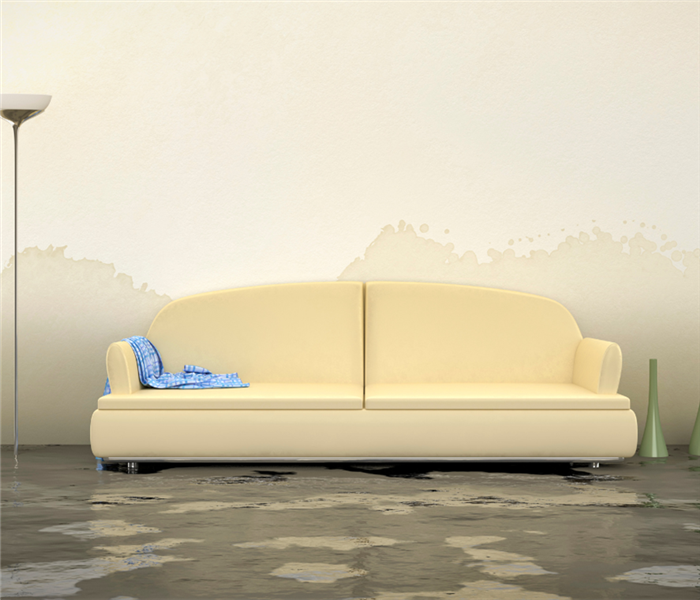 Your SERVPRO team has tackled circumstances like this one, and much worse. We will be there for you when you need us.
Your SERVPRO team has tackled circumstances like this one, and much worse. We will be there for you when you need us.
Imagine…
It’s 8:00 p.m. on a Sunday, and you walk into your home after a relaxing vacation expecting to switch on the lights, put the kids to bed then get some rest yourself. Much to your dismay, a water pipe burst over the weekend, dumping thousands of gallons of water over your hardwood kitchen floor, your carpeted living room, and it is raining water in your basement. SURPRISE!!! The problem is far beyond handling on your own. What do you do now?
Here to help 24/7
When it is your home or business that is underwater, time is of the essence. You need professional water damage restoration to begin immediately. Since SERVPRO of South and Northwest Grand Rapids has someone on call for emergencies 24/7/365, you can call us any time at 616-662-9700.
The cost of water damages can increase exponentially with time. Wood Floors warp, dry wall soaks in moisture and mold develops in hard-to-reach areas of your home or business. The team members at SERVPRO of South and Northwest Grand Rapids are experts at assessing what measures need to be taken to minimize damage and get you back to normal asap.
If the unthinkable happens to your home or business, allow SERVPRO of South and Northwest Grand Rapids to help quickly turn your “before” into a “happily ever after.”
Fire Damage Restoration - It Takes A Tribe...
12/29/2020 (Permalink)
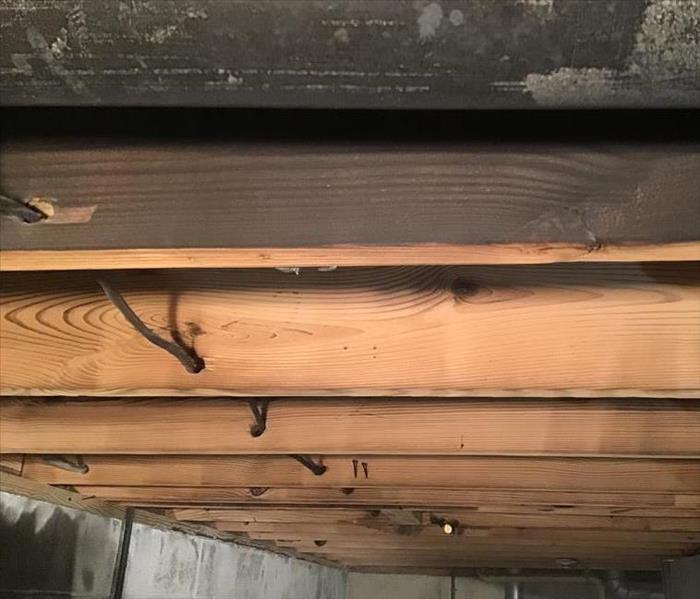 Our SERVPRO crew members were able to make this Grand Rapids basement like new. Fire damage clean up is something we know and do well.
Our SERVPRO crew members were able to make this Grand Rapids basement like new. Fire damage clean up is something we know and do well.
A flood of questions and emotions can overwhelm those that experience a fire at their home or business. Most people do not have extensive experience with fire damage clean up. So it is no surprise that questions such as these create stress and anxiety:
What items are going to be replaced?What irreplaceable heirlooms can be restored?Is the structure safe to enter?Should I submit an insurance claim?What will my insurance cover?How long will all of this take?It takes a team, or tribe, of professionals to properly advise on questions such as those above. The answers (or lack thereof) to these questions are what fuel the emotions. Stress, sadness, and concern will likely all be present but with the right team on your side hope, relief and confidence will come through as well.
Key Players
Insurance Agent -
Insurance agents are often underestimated and underutilized. Developing a relationship with a local agent begins with tailoring a policy that fits your needs and understanding what makes it special for your circumstances. If your agent is not detail oriented when the policy is being developed, they will not likely be a good advisor when something happens.
Your local agent should also have a wealth of information on what types of rulings the local adjusters tend to be more lenient or stringent on and what vendors do good work. When in doubt, call your insurance agent before putting in a claim. They can save you a lot of money by advising a course of action based on how your policy is constructed.
Restoration Team -
It is crucial that you are working with a company that restores, as opposed to a company that just tosses and rebuilds. As mentioned earlier, a good restoration company knows that certain things simply cannot be replaced, items that hold significant sentimental value. Like anything else in life, experience hones skill; choose a company like SERVPRO of South and Northwest Grand Rapids that has daily experience bringing cherished possessions back to life.
Another major point to take into consideration is that every insurance policy has limits. Restoring (if possible) often costs less and takes less time than tearing out structural materials and replacing them. See the picture for an excellent example of this very point. The structure is solid, will be cleaned, and no smoke odor will be present once the job is completed; all in less time that rebuilding.
If you or someone you know experiences a fire, help is available and a team is ready to come to your aid. Work with your insurance agent and SERVPRO of South and Northwest Grand Rapids.
Top 3 Winter Roof Saver Tips
12/17/2020 (Permalink)
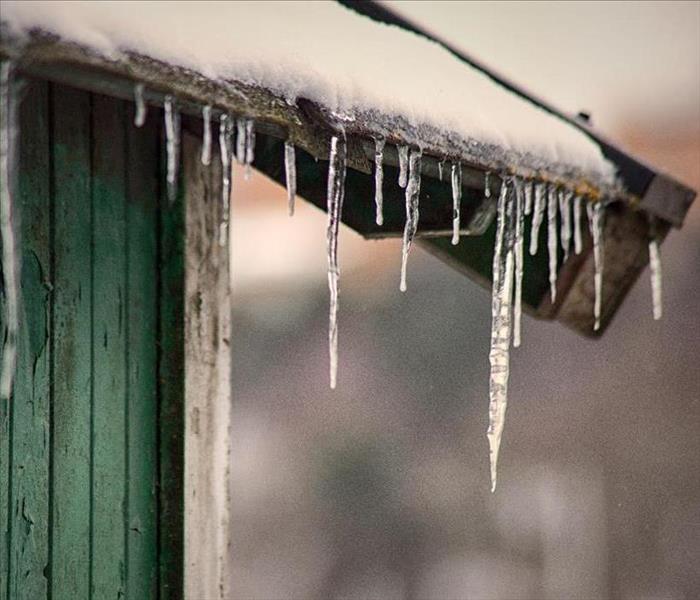 It all starts with a little snow build up and a few innocent icicles.
It all starts with a little snow build up and a few innocent icicles.
When temperatures drop and snow begins to fall, you’ll want to be confident that your roof is ready for winter weather. Your roof is one of the most important elements of your home when it comes to protecting your property from the elements all year round, and it becomes especially important in the winter.
To help you get ready for Grand Rapids snowfall, we have some tips on how to take care of your roof this winter:
Prevent and Remove Debris
Before the first significant snows ever fall, make sure to remove any fallen branches or other debris from your roof. If you see that there are tree branches hanging above your home, just know that these branches, twigs, and leaves may fall onto your roof and collect in gutters and overhangs, especially under the weight of snowfall, so a trim of trees and tall bushes may be in order. Gutters that are clogged with leaves and debris will stop melted snow from draining away properly, and you may experience water backing up into walls and attics.
Keep Snow Build Up at Bay
While snow on a roof is a lovely sight, it can actually weaken your roofing if you let it sit there too long. Snow is actually pretty heavy, depending on how much has fallen, and if your structure has any weaknesses, that weight can be a problem. It also has the potential of creating an ice dam when it melts. (An ice dam is an ice build-up on the eaves of a sloping roof that happens when melting snow under a snowpack reaches the eave and freezes there.)
Clear Your Gutters
Your gutters are one of the places where freezing precipitation will accumulate right away. They should also be checked regularly to make sure that they are not filled with leaves, branches, and other debris. One of the main causes of ice dams that we just mentioned is when gutters are clogged; they are often unable to hold the added weight when they fill up with ice and can tear away from your home, causing a lot of damage and even affecting the structure.
If you are planning on maintaining your roof yourself, please remember that climbing up on a snowy and icy roof can be dangerous. You may want to hire professional roofing contractors to clear it for you.
Our team here at SERVPRO of North and Southwest Grand Rapids is here to help you any time your home or business experiences damage from weather conditions, fire, or a mold infestation. When disaster strikes, we are there for you.
What are some of your roof saving tips?
What To Do If An Appliance Is Leaking
12/1/2020 (Permalink)
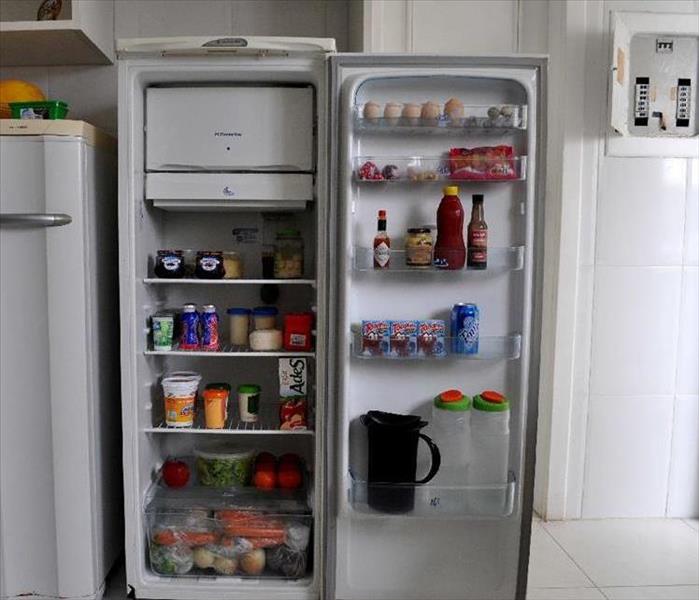 While refrigerators and dishwashers are fixtures in almost every kitchen in Grand Rapids, they are frequently the cause of water damage.
While refrigerators and dishwashers are fixtures in almost every kitchen in Grand Rapids, they are frequently the cause of water damage.
Your household or business kitchen appliances can spring a leak and go undetected for quite a while. If the leak has been slowly developing over time with small amounts of water dripping, you may also find yourself with a mold infestation, as well. Mold requires a food source, moisture, and time to grow. Therefore a slow leak can create the perfect conditions for mold growth.
If this happens to you and you find yourself asking what you should do if an appliance is leaking, we’ve got a few answers and tips for you below.
Minor Leak - Dripping/Puddle
If a small leak has been detected, follow these simple steps to protect your flooring and any items around the leak that could be negatively affected:
- Turn off the water supply to the appliance. A small issue can quickly become a big deal if circumstances should change.
- Soak up any access water on the floor and surrounding areas with a towel.
- If the appliance can easily be repaired, feel free to fix the issue, otherwise call your appliance repair professional right away for their expertise.
- Lastly have a trusted restoration company send a trained technician to evaluate if there is any remaining moisture below the surface of the floor and walls. In most circumstances, charges do not come into play until remediation begins.
Major Leak - Standing Water
- Turn off the water supply to the appliance immediately. If you are not sure where the water originally came from shut off water to the entire house/business and locate the source.
- Call your appliance repair professional right away for their expertise on whether the appliance should be repaired or replaced, as well as gauging the likelihood of a similar loss in the future.
- Call your local restoration company as quickly as possible. Time is money. If water has been standing for any period of time you will likely have some damage to flooring, walls, or personal belongings.
Your cleanup and repair professionals can be onsite in no time to get your home or business back to normal. If you find that paper files and documents have been affected, a professional restoration company will have the equipment and training to be able to save them in most cases, for example.
SERVPRO of South and Northwest Grand Rapids is ready and waiting to help you 24/7 with any kind of water-related issues, and we handle repairs and renovations related to fire damage, as well. Mold remediation and prevention is another one of the areas where we excel by maintaining the training and skills necessary to properly manage this particular kind of cleanup project.
Certified: SERVPRO Cleaned – a defensive cleaning program
11/25/2020 (Permalink)
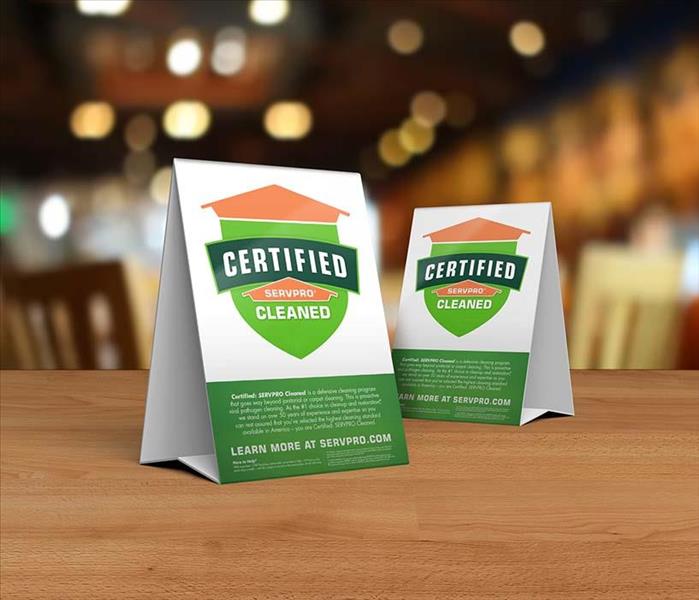 Our defensive cleaning program gives your business a way forward by providing your employees and customers ongoing safety and assuredness.
Our defensive cleaning program gives your business a way forward by providing your employees and customers ongoing safety and assuredness.
Let us help you get back to business
As our communities re-open, we’re all moving back toward a new kind of normal. The expectations of visitors, customers, and employees who come into our establishments have evolved, and staying safe and well is a top concern. The global COVID-19 pandemic has changed what it means to be clean, and we’ve developed a program to help your business meet the new higher standard of clean that is now expected.
Certified: SERVPRO Cleaned is a defensive cleaning program we’re offering to businesses and commercial locations to address the current COVID-19 pandemic. This proactive viral pathogen cleaning program goes well beyond janitorial or carpet cleaning. By choosing Certified: SERVPRO Cleaned, you, your employees, your customers, and your community can rest assured that you’ve selected a higher cleaning standard – you are Certified: SERVPRO Cleaned.
Extensive training and specialized products
As the #1 choice in cleanup and restoration*, we stand on more than 50 years of experience and expertise to help your business become Certified: SERVPRO Cleaned. Beyond fire & water, SERVPRO professionals are trained and experienced in biohazard decontamination and chemical spills – always adhering to the cleaning and decontamination standards set by the Centers for Disease Control and Prevention and local authorities.
From formulating and creating our proprietary cleaning products, like SERVPROXIDE, at our headquarters in Gallatin, TN, to taking the utmost care while disinfecting, we will ensure you and your business are set up to inspire consumer confidence as the economy continues to reopen.
3 C’s – Consult, Clean, and Certify
When the stakes are this high, you want a partner who has developed an industry leading, proprietary training program, cleaning solutions, and remediation processes over decades. We’ve cleaned up some of the most challenging biohazards imaginable. Certified: SERVPRO Cleaned reflects our unique experiences and capabilities. The program is grounded with our unique 3 C’s: Consult, Clean, and Certify.
- Consult – Every business is different, which is why you’ll be assigned a Cleaning Protocol Consultant who understands your business and will create a cleaning program to meet your specific needs. This program will be developed based on your business type, size of space, amount of high frequency touchpoints, foot traffic and congestion points.
- Clean – Based on your specific business needs, your location will undergo a thorough, deep clean, using exclusive cleaning products, according to protocols set forth by the CDC. Our employees have years of experience, and we will go beyond the scope of work that regular janitorial staff perform. Cleanup procedures generally include cleaning of porous and non-porous surfaces, disinfecting of non-porous surfaces, cleaning and disinfecting of equipment, tools, and/or supplies used for cleanup process, and disposal of hazardous materials. In the event of a suspected or confirmed COVID-19 event, we will be there cleaning within 24 hours to ensure you get back to business as quickly as possible.
- Certify - Once your business location has been Certified: SERVPRO Cleaned, you will gain access to proprietary signage, digital emblems, and other collateral that communicates that you’ve selected a higher standard of clean available to help protect your employees and customers. And because we add the day, month, and year to that proprietary stamp of clean, your guests will know that not only did you choose Certified: SERVPRO Cleaned, but that your location is being cleaned regularly at this standard.
Call today for a Certified: SERVPRO Cleaned consultation
We’re Here to Help – 24 hours a day, seven days a week – until life is back to normal in the communities we all call home.
Call SERVPRO of South and Northwest Grand Rapids today at 616-662-9700 for your Certified: SERVPRO Cleaned consultation.
* #1 Choice in cleanup & restoration based Commercial Attitude & Usage Tracking study. Polling 816 commercial business decision makers on first choice for future needs related to cleanup & restoration work. Study conducted by C&R Research: October 2019
Certified: SERVPRO Cleaned means professionally trained SERVPRO franchises perform the requested cleaning, sanitizing and disinfection services according to proprietary SERVPRO protocols and recognized industry and CDC standards with EPA approved cleaning products to deliver a SERVPRO certified cleaning experience. Each SERVPRO franchise is independently owned and operated.
SERVPRO Professional Disinfecting Services
11/23/2020 (Permalink)
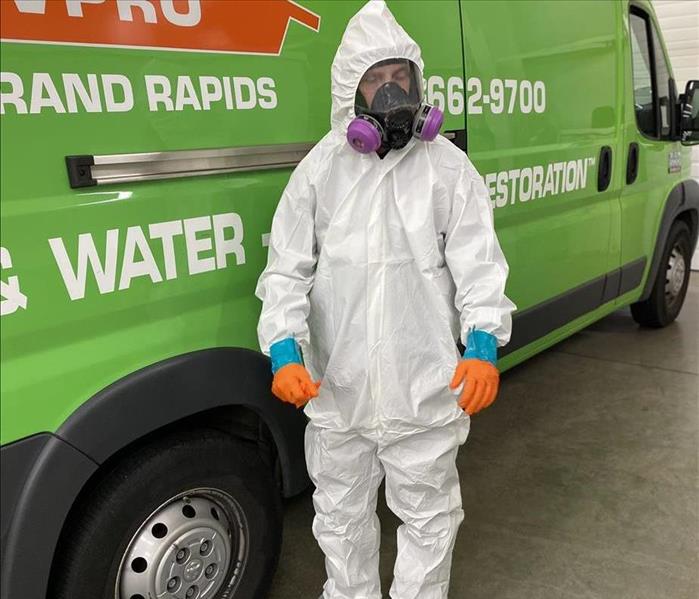 Our COVID disinfecting services are aimed at getting your Grand Rapids business up and running as close to the next business day as possible.
Our COVID disinfecting services are aimed at getting your Grand Rapids business up and running as close to the next business day as possible.
During the 2020 coronavirus pandemic, we have increased our focus and commitment to our commercial cleaning services so that we can provide you with the highest quality disinfection processes possible for your manufacturing and food processing facilities.
As our communities get back to business, we all have gained a new sense of what it means to be clean. Many consumers and employees are uneasy about going back to brick-and-mortar locations, especially when a confirmed case of COVID-19 has been discovered. Our facility disinfection practices utilize EPA-registered disinfectants to support consumer and employee confidence.
Getting you back in business, quickly!
SERVPRO is able to sanitize spaces of up to 200,000 square feet in just one day, allowing your business to experience minimal downtime and loss of production. Our facility disinfecting services can be done either as an emergency measure, such as if a staff member has been diagnosed with COVID-19, or you can contract our professional disinfecting services on a monthly basis, as well, to ensure that your sanitation standards are exceptional.
The Process
Our defensive pathogen cleaning program, Certified: SERVPRO Cleaned, goes above and beyond standard janitorial cleaning practices; it is proactive viral pathogen cleaning. Certified: SERVPRO Clean is grounded in our unique 3 C’s:
- Consult: Not all businesses are the same, so we tailor a bespoke cleaning program based on the unique needs of each facility.
- Clean: Based on the agreed plan, an expert deep clean is initiated using our proprietary EPA-Approved Hospital-Grade cleaning solutions while always adhering to the leading level of cleaning and decontamination standards set by the CDC.
- Certify: You’ll know a business is Certified: SERVPRO Cleaned by the shield posted on their front window. Along with digital emblems and other collateral, this beacon represents their commitment to the comfort and security of their employees, customers, and community.
With over 50 years of experience in biochemical spill remediation and decontamination, you can trust the professionals at SERVPRO of South and Northwest Grand Rapids to bring a higher standard of clean to the places we gather. For more information on our Certified: SERVPRO Cleaned proactive viral pathogen cleaning, give us a call at (616) 662-9700 or visit our website today.
Space Heater Safety Tips
11/18/2020 (Permalink)
Many of us will be using space heaters to help keep our homes or businesses warm in those hard-to-heat corners and drafty areas. These units can be dangerous, however. Space heaters are high-wattage appliances and do have the potential to cause fires if they are not used correctly. We would like to share some space heater safety tips today to help keep you and those you care about safe:
If you are purchasing a new space heater:
- Make sure that any heater you consider is listed by a qualified testing laboratory.
- Only purchase one with a sensor that will shut it off automatically if it overheats or gets tipped over if at all possible.
- Inspect heaters and their cords and plugs. Do not purchase one if you think it could be defective.
Setting up your space heater:
- Ensure your heater is settled on a solid flat surface, and that it’s at least 3 feet from anything flammable. If it is being used in a garage or workshop, keep it away from any paint, oil, and gas cans.
- Never place the heater on furniture or cover it up, and be careful of high-traffic areas and doorways; someone could trip over it or the cord and get burned. Never run a power cord under carpets, rugs, or furniture.
- Plug your heater into an outlet directly rather than using an extension cord or power strip, and ensure that the plug fits well and is the only plug in the outlet.
- Always keep your heater away from water, and if you’re wet, stay away.
When your space heater is in use:
- Check your heater regularly during its use to make sure that the plug, cord, outlet, or faceplate isn’t hot. If it is, turn it off immediately; a hot cord may mean it is defective and could ignite a fire.
- Don’t run your heater 24/7. These units aren’t made to work for long periods of time.
- Never leave a space heater unattended or in a child’s room, and turn it off while you are sleeping.
- Install smoke detectors in your home, as well as carbon monoxide alarms and ensure they are tested monthly.
We hope these best practice tips will help you to use your space heater properly. Here at SERVPRO of South and Northwest Grand Rapids, we want you, your family, and your friends to be safe this winter. If you do experience damage to your home or property, we’re here to help, We are also specialists when it comes to fire damage or water damage, and mold remediation is one of our specialties. We can get your home or business Certified: SERVPRO Cleaned if you need it, so ask us how.
Do You Have An Emergency Exit Plan For Your Business?
11/4/2020 (Permalink)
The threat of an emergency, such as a fire or a flood, can be compounded by panic and chaos if you aren’t prepared, and injuries and even more damage can be the unfortunate result. You can prevent this kind of thing by putting in place a detailed emergency evacuation plan. A high-quality evacuation plan will help prepare you and your workforce in the event of any kind of emergency that could happen on your business premises.
Do you have an emergency evacuation plan for your business? The law requires you to have a plan in place, so if the answer is no, or if you need to revisit the one you have, we have some things to share today for you to think about while you are creating a fire evacuation plan.
Location. It has been reported that an average of 3,000 fires occur in office properties per year, and most of those fires were caused by faulty cooking equipment, intentional acts, or electrical malfunctions. Your business may be located near a river or other body of water or perhaps on a flood plain, so you will want to factor possible flooding into your exit plan. It may be that you live in an area prone to tornadoes and violent weather, so take this into consideration when you are designing your plan. These are some of the areas to pay special attention to in your business; make sure you understand all the specific threats in your area and on your particular premises.
Leadership. Your employees will need people to look to for guidance and reassurance during an evacuation. Choose those you believe you can rely on to be responsible and create a chain of command. These leaders will be the ones who lead everyone to safety, handling communications, and ensuring that even the most vulnerable on your team are safe. Designate volunteers who are willing to learn about and operate fire extinguishers correctly, should the need arise.
Communication. Designate someone to handle the job of calling the fire department and getting information to employees, customers, news media, and any other entities such as the community, organizational management, suppliers, transportation partners, and government officials. Whoever you choose will need a robust, multi-channel communication system, as the chaos of a disaster can mean people will not necessarily be thinking clearly and may miss important information. Being able to communicate through email, phone, text, and mobile app will ensure your communication gets to everyone in a timely manner.
Route. A good emergency evacuation plan for your business will use primary and secondary escape routes, and clear signage should mark all the exit routes. Make multiple maps and post them so all your employees know the evacuation routes to the safe spot(s) you have designated.
Tools. With respect to a fire, it is recommended that you refill reusable fire extinguishers every 10 years and replace disposable ones every 12 years. Also, make sure your employees know where the fire extinguishers are located in the workplace. While you’re at it, make sure all tools, such as fire alarms, emergency lighting, escape ladders, and crowd control tools, are up-to-date and operational at all times wherever applicable. Create and maintain a first aid kit that is well and adequately stocked for the size and makeup of your workforce, and ensure that it is inspected regularly for expired or used medicines.
Drills. Regular fire drills will minimize confusion through repetition, giving your employees a clear idea of how a real evacuation should work. A safe outcome is more likely when everyone knows what is happening.
Here at SERVPRO of South and Northwest Grand Rapids, we care about you and your business, and we care about the safety of your workforce, too. If you need help with cleanup after any emergency, such as a fire or flood. If you have experienced fire damage or water damage, we are here to help. We can get your home and business Certified: SERVPRO Cleaned, too! Ask us how.
Top Places To Look For Mold In Your Home
10/26/2020 (Permalink)
Mold is odorous, unsightly, and can have health effects, and it can show up very quickly. Knowing where to look and what areas are most vulnerable can help keep you a step ahead of a mold issue.
Here are the top places to look for mold in your home:
Sinks. Underneath any sink, whether it’s in the kitchen, the bathroom, or the garage/workshop, is the number one place to look for mold, and we don’t need to tell you why! Make a routine visit to every sink and look for a possible mold infestation on a regular basis to ensure that you aren’t caught off guard. Once mold gets started it can’t ever really be eradicated, only controlled.
Bathroom. Most of us clean our bathrooms thoroughly at least once a week, and this is the perfect time to check for mold. Look in the least traveled areas, such as corners of the linen or storage closet, behind the toilet, and - of course - under the sink. If there have been any leaks in these places in the past, these areas are in danger until they are fully dry. If you detect a brand new leak or drip, have it corrected immediately. You can invest in a dehumidifier for your bathroom, too, and that can be a great tool in the fight against mold.
Kitchen. This room, known as the “heart of the home,” is going to be busy throughout the day, and water is in almost constant usage here. Keep an eye out for spills and leaks and clean them up immediately to ensure that they are not attracting mold spores, which are always in our air and cannot be removed. After dishes and cooking utensils are washed and put away, make sure all counter space and flooring are completely dry as added protection against mold.
Laundry room. This room in your home has nooks and crannies that are not cleaned as often as other areas in your home. Add to that the humidity in the air and possible unseen leaks or drips, and you have all the elements present that can encourage the possible establishment of a mold colony. Enlist help to pull the washer and dryer out from the wall regularly and make sure the areas behind them are clean, dry, and disinfected.
Other areas to keep an eye on in your home and business: hall closets, garages, storage units, warehouses, and basement areas.
SERVPRO of South and Northwest Grand Rapids is always here to help you with any issues related to mold; we are experts in its prevention and its remediation. Large-scale cleanups after flooding and fire are also our specialties, and we can get your home or business Certified: SERVPRO Cleaned, too. Ask us how!
Preparing For Fall Storms
10/6/2020 (Permalink)
Fall weather in the Grand Rapids area is beautiful, and the cooler temperatures are always welcome after the heat of summer. While you are enjoying the fall leaves, harvest decorations, and other fall-related fun, remember that stormy weather conditions are just around the corner. Whether you are a homeowner, a business owner, or both, we know you want to be prepared. Weather may be unpredictable during the fall, but you won’t have to worry about it if you prepare now.
Here are some fall storm preparation projects to consider:
While early fall is not the prime time to heavily prune back trees and bushes, it is a great time to remove any branches that are dead or look like they could become dangerous during a fall storm. If you have a tree that is dead or dying, contact an arborist to come and do a professional assessment. He or she may recommend that you have it removed before anything happens during a fall storm.
Take care of leaves and debris in your gutters and drainpipes; this will help prevent clogging during wetter weather. Clogged drains and gutters mean that rainwater will find an alternative route to the ground and it may back up into your attic or walls.
Drain all outdoor faucets ahead of freezing weather now, too.
Assess all your windows and doors for cracks; if you find issues, have them sealed now so that you can stay warm and save energy this fall and winter. You’ll be saving both time and money here!
A roof inspection ahead of colder weather will be helpful in letting you know if your roofing needs any attention before fall storms. Loose shingles can be replaced more easily when it’s done during warm and dry weather. If you have siding on your home, inspect it carefully for any loose sections. Fall storms often bring high winds that can create problems here.
Make sure your entrance walkways are in good shape, and be sure to take care of any buckling or crumbling. If earth has eroded away underneath walkways this can become a much bigger issue when heavy rains move into the area, and this can compromise the cement, causing it to crack and split. That’s an accident just waiting to happen.
If you need help preparing your home for the upcoming fall storms, call our professionals here at SERVPRO of South and Northwest Grand Rapids. We have the experience and skills necessary to take care of your property and belongings to keep them safe. We can get your home or business Certified: SERVPRO Cleaned, too!
How Long Does It Take For Mold To Grow After Water Damage?
9/22/2020 (Permalink)
You may have experienced a flooding event in the past due to bad weather or equipment failure of some kind. There are many issues that can result from this kind of damage that can last well into the future if the cleanup is not done correctly.
All belongings must be thoroughly dried and restored. This will often require the assistance of a professional cleanup and restoration company. Here at SERVPRO, we are experienced in assisting our customers with situations of this kind. We can help to recover your possessions if they have been damaged by water. This includes furniture, technological equipment, and even documents.
Another concern is mold, of course. After a flooding event, mold can establish a colony in the darkest, damp corners before you even know it has happened. If you don’t know much about mold, you may be asking yourself how long it takes for mold to grow after water damage. The answer? Not very long at all.
After a flood in your home or business, a mold colony can establish itself within 24 to 48 hours, and once a colony has been established, it can never be completely eradicated. Therefore, it is extremely important for you to make sure your premises are dried and restored completely as soon as possible after a flooding event.
Here at SERVPRO of South and Northwest Grand Rapids, we care about you, your family, and your business. When the worst happens, we can be there right away to handle any kind of disaster you may have experienced. Mold prevention/remediation is one of our specialities, and we handle water damage and fire damage, as well. We can get your home or business Certified: SERVPRO Cleaned!
Fire Prevention In Your Commercial Kitchen
9/8/2020 (Permalink)
As the owner or manager of a restaurant and commercial kitchen, you know that fire is one of the worst things imaginable. It will greatly endanger the lives of your staff and your guests and destroy your property, putting you out of business for who knows how long.
Here are some essential fire damage prevention tips for your commercial kitchen:
Faulty cooking equipment is often responsible for restaurant building fires. All your equipment must be maintained in top condition, from ovens to fryers, and your staff should be following established cleaning practices daily, and to the letter, so that everything is in the best shape possible. Regular professional inspections will also ensure that repairs are made before a fire event takes place.
Grease buildup in stove-hoods and grease traps can be a dangerous thing in your commercial kitchen. These equipment components operate under high heat constantly, so they can easily become a fire hazard; kitchen ductwork is at risk, as well. Contact an experienced cleaning and restoration professional to address these issues and help you to maintain healthy indoor air quality.
A critical component of your commercial kitchen fire safety is your fire sprinkler system. Have them regularly inspected as a best safety practice in preventing fire damage; corrosion will definitely affect their performance.
If you don’t know how old your kitchen UL suppression system is, make sure you verify that information during your next inspection. You may want to consider an upgrade to UL 300 compliance to help support your commercial kitchen’s safety.
The very best equipment and the most top quality maintenance can never completely prevent restaurant fires, and the most effective weapon in your arsenal is going to be your employees. Train them to always be ready for restaurant fire emergencies through monthly meetings and drills, and always encourage their input when addressing safety issues. Make sure everyone that is comfortable with fire extinguishers knows how to use them, and ensure that everyone knows how to safely evacuate your building.
Getting you back to business soon is our primary focus. We are always ready here at SERVPRO of South and Northwest Grand Rapids, so call us if you experience fire damage, water damage, or mold issues. We can get your home or business Certified: SERVPRO Cleaned, too.
Maintaining Your HVAC This Summer
8/25/2020 (Permalink)
HVAC maintenance will help your air conditioner perform at its best throughout the warmest season. Scheduling a preventative maintenance tune-up at the beginning of every change in weather will help to alleviate wear and tear and other issues that hinder the performance of your system performance. It is recommended that you have your HVAC serviced every year, before the hotter summer months set in.
In the middle of the summer, there are some steps you can take to maintain your HVAC, as well:
Air Filter
Check your air filter; during heavy use, your filter should be inspected every month to make sure it hasn’t gotten full of contaminants. It may need to be replaced even sooner than the recommended 3-month mark during times when use is heavy, so make sure you have the proper replacement handy.
Air Grilles
Look over all registers and air return grilles in your home or business to make sure they haven’t become blocked or shut; this will restrict the airflow throughout your HVAC systems and this will negatively affect its performance, possibly even causing overheating.
Vents
Keep all carpets, rugs, and furniture away from vents. Take steps to ensure that vent louvers are open in the appropriate rooms; if you do decide to shut off cooling to unused areas of your home or building, never close more than 20 percent of the structure’s HVAC vents. When you find that you have several unused areas that you don’t need to cool, consider investing in a zoning system that will allow you to reduce energy waste while facilitating your HVAC system performance.
Exterior
Inspect your cooling equipment outside. Remove grass clippings and other debris that may have collected on the unit, and trim vegetation that has grown up around it. Make sure the area around your HVAC is not used for storage of outdoor furniture and other items.
Drainage
Ensure that the drip pan and the condensate drain lines are clear. If these components of your HVAC system become clogged with mold or algae, condensation will not exit your home or business premises, and that can cause the cooling system to malfunction or water to back up indoors, causing water damage. Clear any clogs within the drip pan or condensate drain lines as soon as you find them, and be sure to turn off power to the system for safety before doing so. You can use a wet/dry vacuum to remove water from the drip pan or use rags to soak it up, and then follow this with cleaning the drip pan using a mild soap.
Whenever you need help with HVAC maintenance, or if your home or business has experienced fire damage, water damage, or a mold infestation, remember that your friends here at SERVPRO of South and Northwest Grand Rapids are here to get you back to normal right away. We are able to get your premises Certified: SERVPRO Cleaned anytime!
Preventing Flooding In Your Basement
8/11/2020 (Permalink)
The best way to prevent water damage in your basement is to stay aware of the condition of this low-lying area in your home. You will want to make sure you take a look around and check for signs of potential issues regularly, and most especially after wet weather. Damage to the basement and foundation areas of a home are extremely important to repair as soon as possible in order to avoid larger structural and property damages in the future, and taking the steps to prevent flooding in the first place is imperative, and here at SERVPRO of South and Northwest Grand Rapids, we have some tips to help.
Here are some things to look for:
- Changes in the color or texture of surfaces. In a finished basement, wallpaper or paint might be peeling away or appear discolored; look for bowing in the walls, which can be a result of long-term seepage. When the basement is unfinished, you will want to keep an eye out for a white, salty substance known as “efflorescence”, which appears on foundational walls. This will tell you how high water has risen. If the basement flooring is swollen or removed from the subfloor, that is another indicator of water damages.
- Cracking can occur in the foundation and/or the floor, and it is often due to water damage. Look for cracks in window seals and door panes, as well, and if you see anything that needs attention, don’t wait for the flooding to happen to get this taken care of!
- Odors are an indicator that there is an excess water problem. Oftentimes, it’s mold or mildew that causes those smells, which means you have water damage on your hands, so any preventive measures you take are going to definitely keep your space and belongings safe from this flooding side-effect.
- Keep drainage areas well-maintained in expectation of summer storms. Directing water away from your buildings will stop any problems before they even start!
Whether you have found that you have water damage or you see that you need to take some preventive measures ahead of wetter weather, it’s time to call a professional general contractor. These companies are experienced and trained to repair and renovate spaces that have extensive damage from excess water due to leaky pipes, flooding, etc.
Our team here at SERVPRO of South and Northwest Grand Rapids is the team to call if you need help in taking steps to prevent flooding in your basement, as well as for cleanups after water damage or fire damage, whether small or large. We are also mold-remediation experts, restoration specialists, and skilled in large scale commercial cleaning projects, and more.
What To Do In Case Of A Water Leak In Your Bathroom
7/28/2020 (Permalink)
A leak in the bathroom can happen quietly, over time, or they can show up suddenly with no warning. Either way, these leaks can cause a lot of water damage to any home or business owner. You will want to determine where the leak is coming from right away so that you can prevent as much damage as possible, and here at SERVPRO of South and Northwest Grand Rapids, we have some tips for you.
Today we are sharing some things you can do in case of a water leak in your bathroom:
The first step is to find the bathroom leak, so you will need to inspect your bathroom for those telltale signs. Check the areas around your tub, the tub drain and overflow, your shower door, and the toilet. Inspect all drywall for water damage, looking for buckling, discoloration, and warping. Pay attention to any unpleasant odors; this can mean that you will also need to handle a mold infestation.
If you find signs of water leaking from the base of either your tub or toilet, you can use a utility knife or grout saw to scratch out old grout and add new caulking from the joint between the floor and the tub or toilet. You will also want to apply a bead of clear silicone caulk to the joint between the floor and the affected fixture.
If you discover that your shower is the source of the trouble, take steps to determine exactly where the issue is coming from. It’s not uncommon to find that the seal at the base of the shower door needs to be replaced. That’s an easy fix, and you should be able do it yourself with no trouble. If your shower is older and needs to be replaced, call the professionals and get that taken care of.
We don’t often look under our sinks to check on the condition of the plumbing, and it can sometimes turn out that there is an issue developing. One telltale sign is corrosion on pipes, while puddles and warped cabinet bases are another. Determine where the water is coming from, and then decide if this is a do-it-yourself project or if it might be time to call in the professionals.
Whether your water damage is minor or major, the team here at SERVPRO of South and Northwest Grand Rapids is happy to help. We handle fire damage, water damage, and restoration projects of all sizes. We’re experts in the areas of mold prevention and remediation, as well.
SERVPRO of South and Northwest Grand Rapids Offers Commercial Cleaning Services
7/14/2020 (Permalink)
Taking your business to the next level will require you to create a fantastic first impression, and keeping your building clean is the absolute best thing that you can do. Consider the points below to learn why working with SERVPRO of South and Northwest Grand Rapids for your commercial cleaning decision is going to be a smart one; there are a number of benefits you will enjoy when you decide to hire us to make your space Certified: SERVPRO Cleaned.
Quality Work. You will get the highest quality of cleaning possible because we use commercial-grade cleaning products which will make your floors shine, your carpets fresh, and your surfaces gleam. We maintain high-quality training standards for all our team members, so each and every person who works with us is equipped to complete your commercial cleaning to the highest level of quality possible. Our machinery is top-level, as well, so that we can provide you with all the cleaning solutions and services that you might need, no matter what kind of business you operate.
Time Saved. By working with SERVPRO of South and Northwest Grand Rapids to clean your commercial enterprise, you will give yourself the opportunity to have peace of mind every time that you enter your office, and you will save time, too. Cleaning any business is a big job, and as a business owner, your time is always precious. Letting us help you here will enable you to keep doing what you do best.
Great Customer Service. In terms of customer service, what our company provides is unparalleled in the industry. Here at SERVPRO of South and Northwest Grand Rapids, we only staff the best professionals around, and we are ready to provide cleaning services for you on a one-time or on a regular basis, depending on whatever your needs may be.
Regular Services. We can schedule commercial cleaning services for you that are formulated precisely to provide you the cleaning services that you need, and our services can be customized to handle any unforeseen situations such as damage or accidents. Our team members will customize the services that you need on an individual basis.
We are available 24/7 to handle all of your commercial needs, whether it is large-scale cleanup, a small restoration project, or help to handle water damage, fire damage, or mold remediation. Contact us here at SERVPRO of South and Northwest Grand Rapids and let’s get started on making your space Certified: SERVPRO Cleaned!
Fireworks Safety
7/2/2020 (Permalink)
Everyone loves the Fourth of July, and there are so many different reasons to love this holiday: the fireworks, the food and drink, the friends, the fun, and the celebration of our freedom as Americans. This year will be even more special as we move into the months following a tough time for our country, too.
Here at SERVPRO of South and Northwest Grand Rapids, we want to make sure that you enjoy your Independence Day festivities to the fullest, so we wanted to take this opportunity to share some safety tips with you to help ensure you and your loved ones are safe during all the fun.
Here are some best practices for your fireworks safety:
- Obey all local laws regarding the use of fireworks.
- Read the cautionary labels on all your fireworks, and make sure you understand all the performance descriptions before igniting.
- A responsible adult should supervise all firework activities, and he or she should make sure no one gives fireworks to children.
- Alcohol and fireworks do not mix, so please save your alcohol for after the show.
- Wear safety glasses when shooting off your fireworks.
- Light only one firework at a time and then quickly move away from them.
- Use fireworks outside in a clear area and far away from buildings and vehicles.
- Always have a bucket of water or properly functioning water hose nearby during the time that you are firing off your fireworks.
- Never relight a firework that didn’t fire properly, and wait for about 20 minutes for it to cool off, then soak in your bucket of water.
- Never carry fireworks in your pocket or shoot them into any containers made of metal or glass; they could explode and send dangerous shards into your audience.
- Never experiment with homemade fireworks.
- Dispose of spent fireworks by wetting them down and placing them a metal trash can away from any building or combustible materials until the next day.
- FAA regulations prohibit the possession and transportation of fireworks in your checked baggage or carry-on luggage, so don’t try to fly with them.
- Report illegal explosives, like M-80s and quarter sticks, to the fire or police department.
It’s important that you and all your loved ones are safe while you are having fun. If you do experience a fire, call us here at SERVPRO of South and Northwest Grand Rapids for help with any damage that may occur. We also handle water damage, large and small-scale cleanup, and mold prevention/remediation. We are your go-to restoration resource.
You Can Run, But You Can't Hide - Smoke and Soot
7/1/2020 (Permalink)
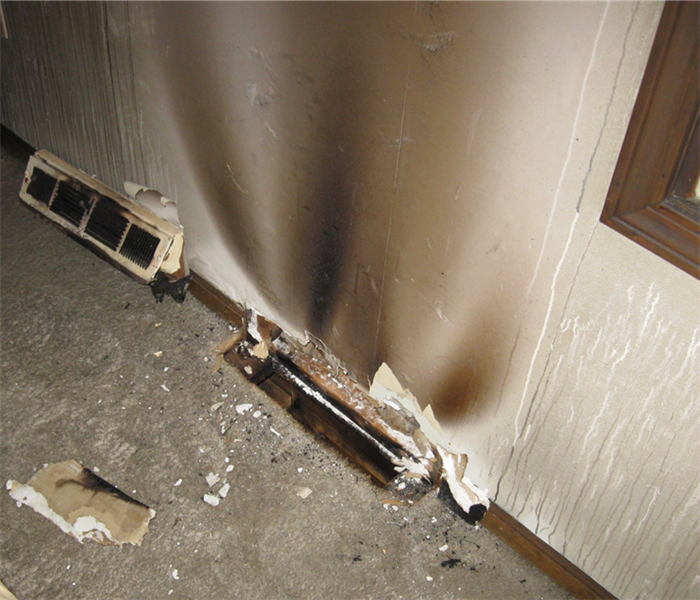 The fire itself remained primarily in the basement, however it is easy to see how smoke and soot will find the path of least resistance to spread
The fire itself remained primarily in the basement, however it is easy to see how smoke and soot will find the path of least resistance to spread
Smoke and soot are very invasive and can affect areas within your home or business that you never imagined would be affected, causing hidden damage and odor. Our extensive knowledge of smoke damage allows us to inspect and accurately assess the extent of the damage to develop a comprehensive plan of action.
Here are the facts:
- Hot smoke migrates to cooler areas and upper levels of a structure.
- Smoke flows around plumbing systems, seeping through the holes used by pipes to go from floor to floor.
- Smoke can make its way into a closed drawer in a room with a closed door on the other side of a home.
- The type of smoke may greatly affect the restoration process.
Different Types of Smoke
There are two different types of smoke–wet and dry. As a result, there are different types of soot residue after a fire. Before restoration begins, SERVPRO of South and Northwest Grand Rapids, will test the soot to determine which type of smoke damage occurred. The cleaning procedures will then be based on the information identified during pretesting.
Wet Smoke – Plastic and Rubber
- Low heat, smoldering, pungent odor, sticky, smeary. Smoke webs are more difficult to clean.
Dry Smoke – Paper and Wood
- Fast burning, high temperatures, heat rises therefore smoke rises.
Protein Fire Residue – Produced by evaporation of material rather than from a fire
- Virtually invisible, discolors paints and varnishes, extreme pungent odor.
Our Fire Damage Restoration Services
Every fire and associated soot situation is different; each one requires a unique solution tailored for the specific conditions. We have the equipment, expertise, and experience to address your fire and smoke damage to effectively restore you home or business. Our trained crews will treat you with empathy and respect and your property with care.
Have Questions about Fire, Smoke, or Soot Damage?
Call Us Today – 616-662-9700
Commercial Business Ready
6/29/2020 (Permalink)
 This facility, and its loss, was large enough that we drove our vehicles inside the building to address the situation.
This facility, and its loss, was large enough that we drove our vehicles inside the building to address the situation.
Businesses in the Grand Rapids, MI area have unique needs. Some industries have significant restrictions on what products can be used for cleanup, while others are simply very large and may require significant manpower to help them with a loss that is too large for their in house team to handle. Where can they turn? SERVPRO!
SERVPRO has a national network of locations that is unparalleled. Whether a natural disaster strikes a community or a large commercial facility/complex experiences a major loss of magnificent proportion, SERVPRO has it covered. Teams across the United States go through the same corporate training, use the same type of equipment and are familiar with the same processes that are scientifically engineered to provide significant results in a short amount of time. When a loss occurs that is too large for a single location, a command center is established and crews from every part of the country unit as one, cohesive team to form the largest restoration force available.
With SERVPRO's scalability, combined with the vast array of proprietary cleaning solutions designed to address every industry from food handling facilities to tool and die, the choice is clear; businesses that need restoration, need SERVPRO of South and Northwest Grand Rapids.
Odor Removal In Your Apartment Complex
6/16/2020 (Permalink)
As the owner of an apartment complex, you are very familiar with the unpleasant existence of odor issues. It’s just reality that there are bound to be situations that arise to create unpleasant, and sometimes overpowering, odors when large numbers of people are living in close proximity to one another. There are lots of reasons issues of this kind arise; keep in mind that if it is a serious situation, your friends here at SERVPRO are here to help, 24/7.
Bad odors can often be dealt with by simply opening doors and windows to air out the units when those odors are caused by unpleasant cooking smells. If a tenant has had a leak or small flood in their unit and their wet carpeting is emitting an unpleasant smell, the carpet should be professionally dried and cleaned. It could require the removal and replacement of the carpeting after more extensive flooding, however - and this might inspire you to renovate the flooring in your units to faux wood or linoleum! Whatever you decide, you’ll need to get carpeting completely and thoroughly dried as soon as possible, because mold may very well appear in a damp environment.
Sometimes an odor event is serious, and you know it is going to require professional help; that’s where SERVPRO comes in. We are experts in deodorization, and our team receives technical training that is specifically designed to enable them to quickly identify and eliminate offensive odors by determining the conditions that are causing the issue. Many times, the problem can be removed without a trace. Our highly-trained team members are also very aware that simply masking odors or using shortcuts is not going to be sufficient when it comes to handling a serious and persistent problem.
The science of identifying and eliminating odors can be complex, so give us a call here at SERVPRO of South and Northwest Grand Rapids and let us handle it for you. We are experts when it comes to mold prevention and remediation and damage from fire or water, as well, and we’re proud to serve the homeowners and entrepreneurs of the Grand Rapids area.
How Often Should You Be Cleaning Your Gutters?
6/2/2020 (Permalink)
Rain gutters that are clogged with debris from storms, high winds, or falling leaves during the Fall season are often the cause of water damage to your home or business. If you are wondering how often you should be cleaning your gutters, the answer to that can be found in thinking about the seasons. If you know we are heading into a season that may involve falling leaves, flying debris, or heavy downpours, that is the perfect time to schedule a rain gutter cleaning. A good rule of thumb would probably be to make sure your gutters are in good shape at least four times a year, as each new season is starting. That way you will always be ready for whatever comes.
This task is actually a fairly simple one that you can do yourself, but if you are not comfortable on a ladder or if the areas you need to reach are not easily accessible, it may be time to call a professional service in Grand Rapids, MI to help you with the cleaning and the unclogging of your gutters, and that will protect you from having to deal with water-related damages.
If you do decide to do the job on your own, make sure you stay safe. You will want to use step ladders on solid level ground and try to complete cleaning when the weather has been dry for a few days. If you do this, you can be confident that the debris, leaves, and pine needles will be much easier to remove. Once the larger debris is gone, follow that up with a powerful hose that is able to wash the residuals down the downspout. You will also want to clean the gutter filter screens and make sure there are no clogs in your downspout. Above all safety is key.
Contact us here at SERVPRO of South and Northwest Grand Rapids if your home or business experiences any water damage due to overflowing rain gutters, as well as damage from storms and floods. We are mold prevention and remediation experts, too. We are proud to serve our Grand Rapids neighbors!
Your Commercial Water Loss Solution
5/29/2020 (Permalink)
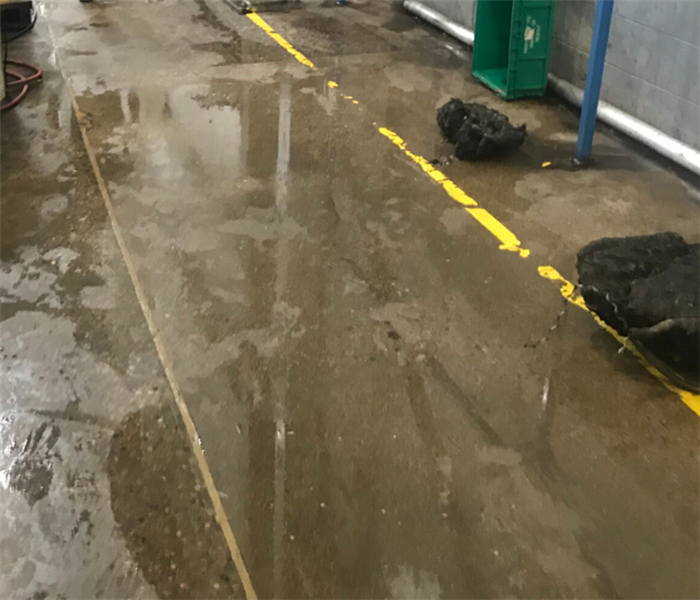 This water loss needed to be addressed quickly to allow production to resume.
This water loss needed to be addressed quickly to allow production to resume.
Commercial flooding and water damage events at properties in the Grand Rapids, MI area are often complex with numerous issues that require a knowledgeable and flexible response. Whether we’re dealing with a relatively small water cleanup scenario or a large scale event, we work quickly to assess each unique situation and isolate the damaged area. Additionally, fast service is crucial as a matter of employee and client safety. In many instances, normal operations can continue in a temporary space while we restore your facility.
Restoring Commercial Properties Presents Unique Challenges
Our professionals are trained to be mindful of legal and environmental concerns and strive to fully restore the damaged area while working within your budgetary constraints. We understand that every hour spent cleaning up is an hour of lost revenue and productivity. So when an emergency situation arises in your business, give us a call and we’ll be onsite quickly with the help you need.
About your local SERVPRO
SERVPRO of South and Northwest Grand Rapids specializes in the cleanup and restoration of commercial and residential property after a water damage event. Our staff is highly trained in property damage restoration. From initial and ongoing training at SERVPRO’s corporate training facility to regular IICRC-industry certification, rest assured our staff is equipped with the knowledge to restore your property.
Storms Come Unexpectedly; prepare now
5/29/2020 (Permalink)
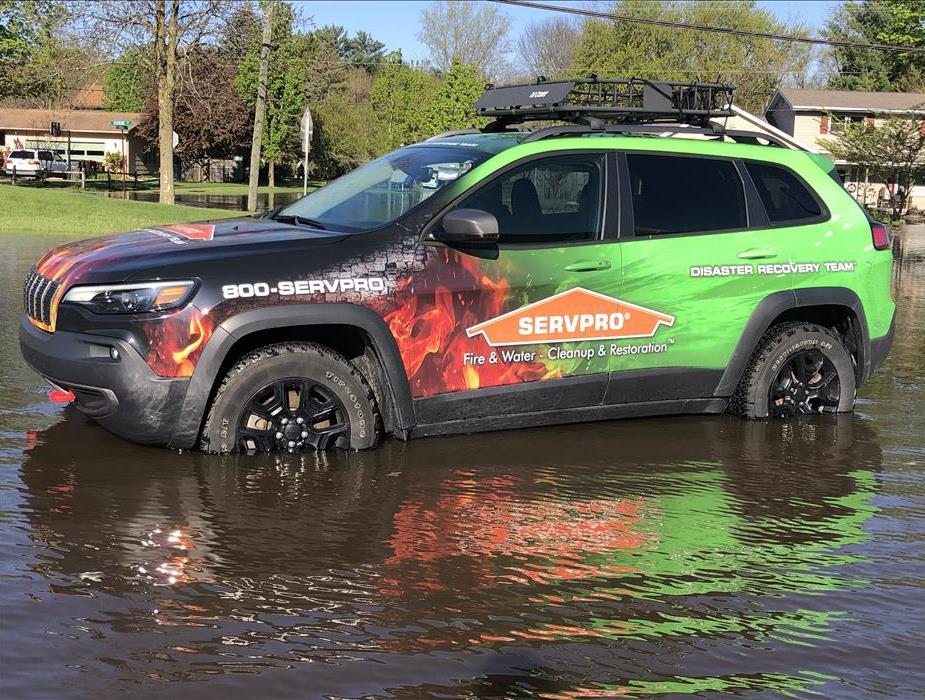 Most of the streets in this town were completely flooded. SERVPRO answered the call for help.
Most of the streets in this town were completely flooded. SERVPRO answered the call for help.
The dam failures not too far from us in Grand Rapids, MI serve as a harsh reminder that nature is an unpredictable force to be reckoned with. Tornado outbreaks, river floods, flash floods, historic earthquakes, and even water main breaks and power outages in U.S. cities are more examples that affect millions of people for days at a time.
Now is the time to think about the basics, things you will need in advance of an emergency: how you will communicate, what supplies you will need to keep in your home, car or office. Use the list provided here to build an emergency supply kit to ensure your family is equipped and ready for any type of disaster.
The more you know about what to do in an emergency, the more confident and secure you will feel in your abilities to manage through a disaster.
Preparation is the key to making it through any size disaster, whether it is a small water leak, a large fire, or an area flood. The best time to plan for such events is not when the event happens, but well before it happens. No one plans on a disaster, but now, you can plan for it.
Build An Emergency Supply Kit:
- Water, gallon per person per day
- Food, non-perishable 3-day supply
- Manual can opener
- Battery operated radio and extra batteries
- Flashlight and extra batteries
- First aid kit
- Whistle to signal for help
- Wrench or pliers to turn off utilities, if necessary
- Dust masks or bandannas
- Plastic sheeting, garbage bags and duct tape
- Local maps
- Hygiene items
- Clothing
- Fire extinguisher
- Matches in waterproof container
- Cash
- Important documents such as:
- Copies of insurance
- Policies, identification and
- Bank account information
Contact your local professionals at SERVPRO of South and Northwest Grand Rapids for more information and tools to help you be “Ready for whatever happens.”
How To Reduce Fire Hazards As We Head Into Summer
5/19/2020 (Permalink)
As we head into the summer season, we want to talk about possible fire hazards that you may face during the warmer months. You’ll be outdoors more often, and between all the cookouts and the heavier use of your HVAC system, in addition to using your landscaping machinery, your home and business property are both at a higher risk for damage from fires.
Here are a few tips to help you reduce fire hazards in the months to come:
- Care For Your HVAC. Dust can settle on electrical components of these units, and this can cause tracking faults which may lead to a fire. Keeping your HVAC clean from dusty conditions is one way to prevent a fire as we head into summer. Having it inspected by a professional to ensure that all moving parts and wiring are in good working order is also a good idea.
- Clean Exhaust Fans. Clean out exhaust fans regularly and take all debris out of the vents. Try to avoid running these fans for long periods of time on a consistent basis, as well, to avoid burning out moving parts.
- Service You Lawn Mower. Follow the manufacturer’s recommended maintenance and care schedule on your mowing equipment, and remember to remove debris and grass clippings from the cutting units, mufflers, and engines on a routine basis. Also, remember to never refuel your mower when it is overheated.
- Store Fuel Properly. You will be using fuel for mowers and grills during the warmer months and may have to store propane or gasoline. The risk from fire is heightened by high ambient temperatures and relief valves that open at pressures that are too low. Always store your gas cylinders upright and always out of doors.
- Be Safe While Grilling. Make sure your grill is stored away from your buildings, as well as overhanging branches. Always maintain a safe zone of at least three feet around the grill, and regularly remove any grease or gas buildup from the grills and trays. Never leave your grill unattended under any circumstances.
- Perform Alarm Audits. Fire prevention should always include fire alarm tests. Be sure to replace any old or burned out batteries regularly.
Here at SERVPRO of South and Northwest Grand Rapids, we care about your safety and the safety of those you love. If you have experienced damages from a fire, or from water or flooding, we’re here to help and can be there right away! We are experts in cleanups from all kinds of disasters, both large and small, and we are mold prevention and remediation specialists, too.
What To Do If Your Sprinkler System Goes Off
5/19/2020 (Permalink)
The overhead sprinkler system in your home or business is there to keep occupants safe from injuries during a fire. However, when they do go off, there is going to be a mess to clean up, which is usually time-consuming and labor-intensive. You know that it is important to handle any sort of water issues immediately in order to avoid the costly problems that can arise from your damp property, such as mold and mildew. Today we wanted to share a few tips to help make cleanup a bit easier.
- Prompt Assistance. Prompt professional assistance following a sprinkler discharge could be vital in saving your property and your belongings from permanent damage. Your actions in the first 24-48 hours can save you significant time and money and eliminate subsequent mold growth.
- Professional Followup. Professional followup will also be a big help when it comes to odors, and professionals can accurately evaluate the water damage and potential for mold growth in hidden areas, as well as ensure that any affected building materials are dry prior to work area rebuilding. We recommend that you hire an independent water damage and mold remediation expert to represent you during planning, response, and closeout, and work together with your insurance carrier.
- Piping. Water within the sprinkler system is stagnant and non-potable, and the water picks up and absorbs oils and other contaminants within the piping, resulting in discoloration and odors from sediments. Cleanup actions typically not only involve moisture remediation but also involve surface cleaning from these types of stains as well as additional measures to alleviate odors.
- Prompt Action. Prompt action in cleaning will be essential when it comes to fabric and textile items that have been affected to minimize permanent staining and damage.
- Prevention. Keep in mind that any intense heat will cause your sprinklers to discharge, and the sprinkler heads contain a temperature-sensitive mechanism that can only be activated when the temperature at the sprinkler head exceeds the allowable range, so make sure to be careful with heating. You will also want to make sure that your family or other occupants know never to hang items from the sprinkler heads, as this can damage them, as well as cause them to go off unexpectedly.
If your home or business has been affected by water damage, whether from an overhead sprinkler system, flooding, or leaks both large and small, here at SERVPRO of South and Northwest Grand Rapids we are ready to help. We are also mold prevention and remediation specialists!
Steps To Take After A Flood In Your Apartment Complex
4/21/2020 (Permalink)
If your apartment complex experiences a flood, the damage from that flooding can have serious consequences. It can make affected units impossible to live in and possibly ruin the personal property of your residents permanently. Even the smallest of floods can have long-lasting consequences.
Here are some important steps for you to take if your apartment complex floods:
- Safety should always be the very first consideration in any emergency situation. Even the most minor flooding event can create unsafe conditions, such as washing out walkways or causing potholes in the parking lot, so you will want to inspect your grounds thoroughly to identify any unsafe situations that have become an issue, and then take the necessary steps to restrict people from going near them. Log these observations by taking pictures and videos, as well.
- Visit each and every affected unit to ascertain what damage has been experienced, and pay special attention to the presence of mold. Wet surfaces and damp environments are the perfect conditions for mold, and a colony can further damage the apartment and create substantial health hazards.
- You will be responsible for the repair of the damage, but be aware of your tenants’ rights, as well. Always do the right thing, keeping in mind that this is actually great advertising. Some of your residents may be under the impression that the owner is liable for the replacement of personal property in every case, so make sure you know the laws. The principles that support basic tenants’ rights are the same throughout the U.S., while each state will vary in detail. You or your residents can consult the local housing authority or a tenants’ rights organization for clarification if needed.
- If a resident has to leave their unit due to severe water damage, they may not be required to pay rent for that particular month, nor until their apartment is completely repaired, depending on state law. If the apartment is totally destroyed, they may be able to lawfully request to cancel their lease.
- After you have ensured that the safety of all involved is secured and ascertained which repairs need to be made, call in a professional repair company with the expertise and equipment needed to get you back to normal as soon as possible. You are required by law to get these repairs completed in a timely manner, ensuring that the units are fit to live in, so make sure you use a company that has a great reputation for thorough and timely completion of all projects.
Here at SERVPRO of South and North West Grand Rapids, we have the experience and skill you need to get your apartment complex back to pre-flood condition as soon as possible. Call us for help if you experience flooding in your home, business, or apartment complex.
How To Prevent Mold Growth In Your Bathroom
4/7/2020 (Permalink)
There is water in use in your bathroom all throughout the day, every day, so you’ll need to practice preventive measures to ensure that you don’t develop serious mold growth in this most important, and wet, room in your home.
Your bathing area has a higher moisture level than that of most of the other rooms in your home, of course, and surfaces can easily become moldy quickly if they are damp for too long. Once mold has established a hold on an area, it will then re-establish itself even more quickly every time the humidity rises and is impossible to completely eradicate.
To prevent mold in the first place:
- Mold-resistant products are readily accessible at your local hardware or home goods store, and are a good choice when refreshing your bathroom, and using these products - such as paint - is a great idea for your kitchen, as well.
- When doing any type of major repair or renovation in the bathroom area, check with your professional to see if they can use products that contain mold-resistant ingredients, such as flooring and drywall, for example.
- Take care of standing water in this area of the home immediately. When cleaning the flooring, use less water than you might otherwise, and always dry countertops completely, paying special attention to cracks and crevasses.
- When it comes to the windows in both your bath and your home, ensure that all frames and weather stripping are in good repair in advance of wet and humid weather.
- Check on the cabinets under the sinks and around the toilet for leaks from hoses and pipes leading to walls regularly, cleaning behind and underneath them on a regular basis; while you are completing this task take note of any dampness, rust, or puddles.
- Ensure your bathroom area is well-ventilated; you can always use a dehumidifier if you feel it necessary.
Keeping mold out of your bathroom will help you to maintain a pleasant experience in your bathroom space, and your family will thank you.
Here at SERVPRO of Northwest/South Grand Rapids, we have the experience, knowledge, and expertise to help you with any mold infestation. We are also experts when it comes to those necessary cleanup projects after both fire damage and water damage.
How To Storm-Proof Your Garage
3/24/2020 (Permalink)
It is vital to the safety of your entire home to stormproof your garage adequately. Completing this project will protect both your family and your home from heavy weather damages, such as high winds and flooding. If your garage is left unprotected, it is much more likely that there will be expensive damages from an event of this kind. Here are just a few tips to help you get started on storm-proofing the garage:
- Garage Door. The door of your garage is going to be susceptible to damage, so your storm-proofing project should begin with ensuring you have a sturdy door. It is also important to regularly check your garage door for holes and cracks, and seal any that occur so that your garage will stay protected. We recommend installing a bracing system to the door; braces anchor the door to the floor, walls, and hinges, adding support and wind resistance. This can be done yourself or you can hire a professional.
- Windows. You may want to remove windows in your garage if storms are expected in your area, but that may not always be an option. When purchasing windows for your garage, you can install windows with impact-resistant glass, as well as exterior window protection that can be closed and locked to protect the interior from impact and storm remnants.
- Drainage. Water damage can always negatively impact your garage through flooding, potentially causing mold and health problems. You can install a trench drain outside your garage to prevent this occurrence. This drain will create a channel for water to flow through and avoid the overflow of water in gutters and low-lying areas on your property. You may also install flood vents, which allow water to flow through your garage easily, alleviating pressure on your foundation.
If you are concerned about your garage and need assistance in this area of your home, our team of highly trained professionals here at SERVPRO of Northwest/South Grand Rapids is always ready to help. We are water damage and fire damage professionals, and mold cleanup and remediation experts, too.
We are Cleaning Experts
3/19/2020 (Permalink)
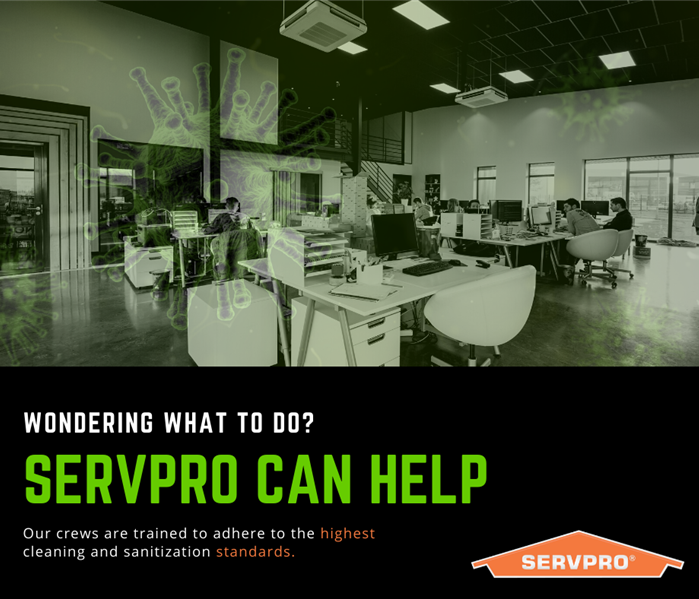 For peace of mind in your professional work space, consider SERVPRO for #germ #cleanup.
For peace of mind in your professional work space, consider SERVPRO for #germ #cleanup.
SERVPRO is Here to Help during this time of need
During this unprecedented time caused by the global pandemic of coronavirus, this is a reminder to our customers that we are specialists in cleaning services, and we adhere to the highest cleaning and sanitation standards.
Specialized Training
We are prepared to clean and disinfect your home or business, according to protocols set forth by the Centers for Disease Control and Prevention. We have years of experience in dealing with biological contaminants, and we will go beyond the scope of work that regular janitorial staff perform on a daily basis.
The CDC encourages cleaning of high-touch surfaces such as counters, tabletops, doorknobs, light switches, bathroom fixtures, toilets, phones, keyboards, tablets and tables. Other spaces mentioned in the CDC’s guidance for commercial spaces include:
- Kitchen/Food Areas
- Bathrooms
- Schools/Classrooms
- Offices
- Retail Spaces
- Water Fountains
- Shelving/Racks
- Sales Counters
- Carpets and Rugs
- Stair Handrails
- Elevator Cars
- Playground Equipment
- Fitness Equipment
Specialized Products
The CDC recommends usage of a labeled hospital-grade disinfectant with claims against similar pathogens to the coronavirus. Multiple products in the SERVPRO product line carry the EPA-approved emerging pathogens claims. While there is currently no product tested against this particular strain of the coronavirus, we are following all guidelines as provided by the CDC and local authorities.
Call Today for a Proactive Cleaning
If your home or business needs deep cleaning services, call the experts today – SERVPRO of South and Northwest Grand Rapids, 616-662-9700
Sources:
https://www.cdc.gov/coronavirus/2019-ncov/hcp/guidance-prevent-spread.html?CDC_AA_refVal=https%3A%2F%2Fwww.cdc.gov%2Fcoronavirus%2F2019-ncov%2Fguidance-prevent-spread.html
https://www.cdc.gov/coronavirus/2019-ncov/specific-groups/guidance-business-response.html
How To Deal With Water Damage In Your Attic
3/10/2020 (Permalink)
Few of us head up to the attic on a regular basis, so this space in a home is often completely ignored for months at a time. If your attic springs a leak, it can go on for quite some time before anyone realizes it. If you have discovered water damage in your attic area, you will want to take immediate action to avoid even more damage and the associated higher costs and stress.
Here are some tips to help you deal with water damage in your attic:
- Assess. Your first goal will be to fully assess the issue. You’ll need to find out if there is a leak, and if so, to determine where the leak is coming from. It may be from damage to your roof or a burst pipe, for example. Make sure you are thorough in your assessment and be sure to take safety precautions. Stay away from light sockets, recessed lights, and other electrical systems until the electricity to the attic area has been turned off. Also, be sure to get an accurate idea of how widespread the damage actually is, paying special attention to wood that could be rotten or moldy.
- Leaks. Find the source of the water issues and eliminate them before handling any of the damage. You may require the help of professionals here. Contact your homeowner’s insurance carrier at this point if it looks like repair costs will extend beyond your deductible. The carrier may decline to cover any damage, but it is better to be safe than sorry.
- Repairs. Your repair job will be unique to your property, but there are some common repairs you can probably expect after your attic experiences water damage, such as:
- Structural Component Replacements. This can include anything from basic framework to floorboards. This process can be time-consuming since each board used needs to be checked carefully to ensure that it is in good condition.
- Plumbing Component Replacements. If the source of your attic water damage was a plumbing issue, you will want to replace pipes or components that led to the event. If the main cause was the freezing and bursting of pipes, ensure that this never happens again by installing proper insulation.
- Electrical Component Replacements. Lighting, light sockets, and electrical outlets may have been negatively affected by a water damage event. This kind of situation is not really something you can handle yourself unless you are an electrical professional, so be prepared to contact a reputable company to take care of this part of your repair project.
- Insulation Replacement. If your insulation was affected when your attic was damaged, you have a great opportunity to replace or upgrade your attic insulation.
- Clean Up. The last step in the process of dealing with water damage in your attic will be the final clean up. Get rid of remaining items and residue, and wipe down surfaces with a bleach and water solution; don’t forget the Personal Protection Equipment here!
Your attic is a vital part of your home, even if you hardly ever visit it. This space protects everything underneath it, so it is important to make sure that you won’t experience damage from heavy weather and leaks to the rest of your house through your attic. If you need help with a major repair project of this kind, the SERVPRO of Northwest/South Grand Rapids is here to help! We are water damage and fire damage experts, and we handle mold prevention and remediation, too.
Cleaning Up After Smoke Damage
2/25/2020 (Permalink)
Fire and the accompanying smoke and soot affects everything in your home or business and will include the structure itself, equipment, and belongings. After a fire, contacting a cleaning professional may be the best decision you can make. You will need the assistance of professionals who have the expertise and equipment necessary to get your work or personal space back to normal as soon as possible.
Inhaling smoke, even for a short time, can have an immediate negative effect on anyone, so avoiding a smoky situation is vital. You will want to avoid entering your home or business until all the smoke is cleared from your premises. Hiring a professional fire and smoke damage restoration contractor will ensure that you experience a speedy and expedient return to normalcy.
SERVPRO specializes in restoring the contents of a home or business that have suffered from fire damage or water damage. They will assess all your belongings carefully to determine what items can be restored to their “pre-fire” condition. A professional cleaning company will use several methods to restore your property to its original condition, such as;
- Foam cleaning: used for upholstery, since it can shrink or bleed when water is used.
- Dry cleaning: used to clean light residue.
- Wet cleaning: a very effective cleaning method used to remove moderate to heavy residues.
- Immersion cleaning: items are dipped into a bath of cleaning products.
Electronics that have been damaged by fire and smoke often present a serious hazard. To maintain safety, never attempt to turn on or operate any electrical device that could possibly have been affected. Smoke residue contains acids that corrode metal and that can cause electronic failure in a device. Items that you should be careful of are:
- Computers
- Televisions
- CD and DVD Players
SERVPRO technicians are experienced in document and photograph restoration and can help in the event that your important records or personal keepsakes have been damaged during a fire.
If the damage to your home or business is such that it will need extensive restoration or cleaning, SERVPRO can organize an efficient move-out process of the affected areas. Removing your items from the area will aid in a quicker remodeling process and will protect your items from any further potential damage. After the restoration is complete, move-in can be coordinated easily.
If your home or business has suffered damage from fire, water, or mold, the members of the team here at SERVPRO of South and North West Grand Rapids are fire and water damage experts, and we maintain the training and equipment necessary to help our customers get back to normal after a fire event as soon as possible.
Creating An Exit Strategy For Your Commercial Building
2/11/2020 (Permalink)
You know that anything can happen during the course of even the most normal business day so it’s a smart move to be ready for whatever you might face. Your commercial property is an important investment, not only to you, but also to the people who work there, and as a smart business person, you want to protect that investment and the well-being of all involved.
Having an exit strategy in place is a basic requirement for guarding lives and keeping people safe. As you are creating your exit strategy, think about the types of disasters that are most common to your area, as well as those that are not common or weather-related, such as human threat or fire.
Six important points to consider first are:
- How will tenants and workforce members receive emergency alerts or warnings? An alarm system within the building might work best if your commercial building is composed of large shops or warehouses. If your property is an office, then perhaps a phone tree to contact each department or office individually would work best.
- What kind of shelters are available onsite for people? For areas that experience tornadoes, for example, an area on the lowest floor or below ground that is constructed to withstand the highest wind forces will be necessary.
- What are the evacuation routes in your commercial building? Ensure that a map is posted in all public areas. It needs to be clear and labeled properly so that anyone can reference it and easily know where to go.
- What is the communication plan? During the event and afterward, you will need to be able to communicate with your tenants so that they are updated concerning the state of your building. Your business will be discontinued so that the emergency can be handled, and they will want to know when it is safe and when they can exit shelters or re-enter the building and get back to work. Create a strategy where you can communicate with everyone in a timely and efficient way to prevent misinformation and confusion. Text messages could be the best course here, for example.
- Take special situations into consideration. It is a requirement that any exit strategy is tailored to individuals with any special needs, and you will want to think about older people and those that are impaired visually or in their hearing. Designating areas to gather ahead of time for having volunteers in place that can manage and oversee these situations will be helpful. If your commercial business houses sensitive equipment or machinery that is designed to save lives, this will need to be taken into consideration when dealing with emergency evacuation, as well.
- Create a complete guide for all tenants and members of the workforce who use your commercial building, outlining the information discussed above and including all templates, maps, and contact information, and place it online for easy access to all.
SERVPRO of South and North West Grand Rapids is here to help in the event of any emergency or accident. We specialize in water and fire damage clean-ups no matter the size.
Mold Prevention Tips This Winter
1/28/2020 (Permalink)
Kicking up the heater in the coming colder months will keep you cozy and warm. Unfortunately, it also creates the perfect environment for a colony of mold. These infestations are both unsightly and unhealthy and can make life truly miserable for those who have an allergic reaction. A mold colony can also spread quickly and secretly within your walls, compromising their integrity and strength.
Mold and its cousin, mildew, are both unpleasant and undesirable, with recognizable differences. Mildew has a flat surface and will appear powdery; it begins growing with white coloration and generally becomes yellow, brown, or black over time. Mold can be a wide range of colors and will have a fluffy appearance. The spores for both are everywhere, even in the air we breathe, and their risk increases when winter arrives due to the warmth of indoor temperatures in comparison to the outdoors.
Their growth can be prevented, however. Here are some tips for mold prevention this winter:
- Don’t Feed It. Mold and mildew feed on any organic material. Old bread, the rug on your kitchen floor, or wooden cupboards - it’s all a smorgasbord for these organisms. Make sure surfaces are kept clean and dry and don’t allow food to sit out and become moist and warm.
- Keep Things Dry. Moisture condenses when it comes into contact with a colder area, so you will most likely see mold or mildew on tile grout, windowsills, and baseboards during the colder months.
- Be Vigilant. Once a colony establishes itself, it cannot ever be completely eradicated. Once the moisture, warmth, and food it needs are reintroduced it will simply start to grow again.
- Look For Leaks. Improperly sealed windows, exterior doorways, skylights, and indoor plumbing will attract mold colonies.
- Exhaust Fans. Keeping the air dry in kitchens, laundries, and bathrooms will help prevent mold this winter. Running these fans during times when the air is moist will do wonders. You can also use dehumidifiers in your home to prevent mold from establishing itself. Follow the established recommendations for keeping your home at the proper level of humidity for this purpose.
SERVPRO of South and North West Grand Rapids is here to help if you experience a mold or mildew invasion this winter. Call us for more prevention tips or for mold remediation. We are experts in this area!
Storm-Proofing Your Basement
1/14/2020 (Permalink)
Water-proofing your basement will be the best way to storm-proof it, since most storms involve lots of water. You will be able to avoid a wet basement that encourages mold growth, which is another nightmare you don’t need. During a storm, water can leak through roofs and pipes and affect foundations, too, and flooded foundations will almost inevitably affect your basement.
Here are a few ways you can both water- and storm-proof your basement:
If you experience flooding or wet conditions after a heavy storm, your trouble can almost certainly be traced to your drainage conditions around the outside of your home. If too much water has collected around the foundation in the soil it will leak into your basement through the walls. The solution here will be to improve your drainage conditions ahead of more storms.
- Roof Drainage. This is the number one cause of basement leakage. Make sure your gutters have at least one downspout for every 600 to 800 square feet of roof surface for proper drainage. Keep them clean so that water doesn’t collect and overflow down to your foundations. Ensure that the ends of the downspouts are extended so that they direct water at least 4 to 6 feet away from the foundation, protecting your basement from storm damage. If your local building laws permit you to, you can direct this water into the street or another low-lying area.
- Sloping Soil. The angle of your soil around your home’s foundation can also cause wet basement issues after a storm. Your soil should slope away from the home to keep rainfall from collecting there. If your grading needs improvement, use clean fill dirt to build up soil around your house, and tamp it down to the correct slope. Finish with a topsoil layer and grass seed to prevent erosion, further storm-proofing your basement.
- Landscaping. Avoid landscaping that holds soil close to the house. It may look great but those brick or stone edgings can prevent water from draining away and increase your basement flooding risk.
These water- and storm-proofing measures will help prevent many of your wet basement situations, keeping you safe from all the unpleasant side effects of damp. If you experience a large flooding event or need help drying out a wet basement after a storm, the team here at SERVPRO of Northwest/South Grand Rapids is ready to help at a moment’s notice. We are mold remediation experts, too!
Preventing Water Damage In Your Apartment Complex
12/31/2019 (Permalink)
As we head into a season of wetter weather, now is a great time to think ahead concerning ways you can prevent damage from water in your apartment complex. From rain gutters that need attention to burst pipes from freezing temperatures, you can run into a lot of issues in the coming months that could have been prevented.
Here are some tips that could save you time and money spent on water damage:
- Keep Residents Informed. Update your residents on how to handle freezing temperatures. Many of your residents have moved from warmer climates and have no idea that this is an issue. They will need help in taking steps to avoid a water disaster from burst pipes. Use flyers and your website to keep everyone up to speed.
- See Something, Say Something. Make sure your residents know who to contact if they see a potential or actual problem. If your complex is really large, you could even offer prizes or discounts for those who identify an issue that is resolved before it becomes a real disaster. Ask for information about such things as loose or missing rain gutters, crumbling walkways from flooding, leaking pipes or water heaters inside units, or irrigation that is not in good repair.
- Inspections. Keep on top of potential issues by inspecting areas in your complex that could develop problems quickly, such as the pool area, laundry areas, and irrigation lines. Some complexes offer car washes, so if yours does, that’s another place to keep an eye on. Sprinkler heads can get broken off and spew water in places that aren’t supposed to get wet, hoses crack and lose water, and pools can develop leaks in their finish. All these issues can be prevented by being vigilant, saving you both time and money.
The team here at SERVPRO of South and North West Grand Rapids is ready to help with any size disaster caused by flooding or other water-related issues. When it comes to disaster recovery, we can be there right away to get your apartment complex back to normal. We are fire and water damage specialists, and mold remediation experts, as well.
SERVPRO - The Flooded Basement Experts
12/27/2019 (Permalink)
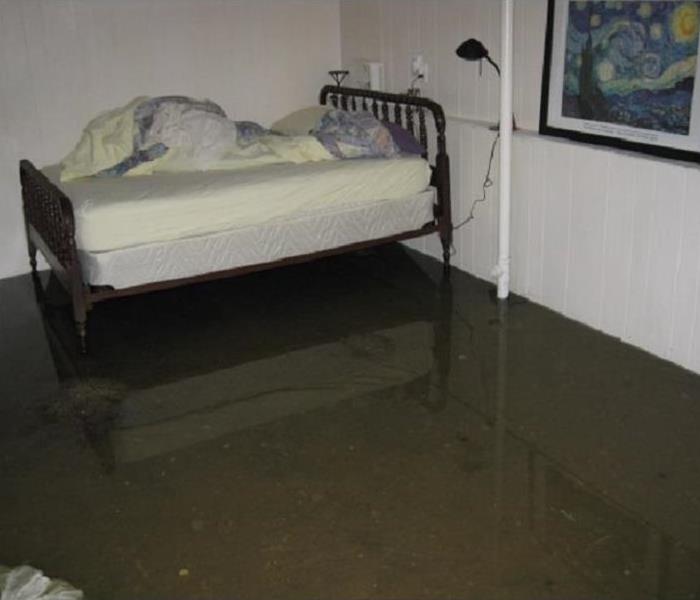 Flooded Basements can turn into serious water damage if not addressed quickly.
Flooded Basements can turn into serious water damage if not addressed quickly.
A basement can flood at any time, although flooding most often occurs during heavy rainfall. Basements are inherently prone to flooding because they are the lowest level of a building and are normally built partly or entirely below ground level. There are a number of reasons why your Grand Rapids basement could flood, including:
- A blocked or failed sewer lateral pipe
- Heavy rain causes surface water to pool around your home
- Foundation drainage failure
- Water supply-line break or hot-water tank failure
Customer Testimonial - Joyce G "Our basement flooded due to septic pump failure and SERVPRO of South and Northwest Grand Rapids responded to my call with-in 15 minutes with a team of Professionally Trained technicians. They handled all of our furniture and belongings with extreme care. It was a real blessing to have them in my home to relieve the stress of the situation and to have everything cleaned beyond my expectations."
Have Questions about Basement Flooding?
Call Today - 616-662-9700
If flood water is not handled quickly and properly, it can jeopardize your health and safety, and cause severe damage to your home’s structure. Remember, the longer you wait the worse the problem will get.
Here is the bottom line: a flooded basement can jeopardize your health, safety, and your home’s integrity. It’s worth making a call to SERVPRO of South and Northwest Grand Rapids and let our trained, professional crews handle the situation safely and correctly. We have earned the trust of hundreds of homeowners, business owners, and property professionals.
We are Flooded Basement Specialists:
- We are Available 24 hours/7 days per week
- We’re a Preferred Vendor to many National Insurance Companies
- We Bill The Insurance Directly – One Less Thing For You To Worry About
- Our Technicians are Highly-Trained in Water Restoration Techniques
- We use IICRC Restoration Standards
- Advanced Inspection and Extraction Equipment
Preventing Fires From Space Heaters
12/17/2019 (Permalink)
Almost half of all fires in homes across the country are caused by the use of space heaters, and an even larger amount of associated deaths from those fires happened because those space heaters weren’t handled correctly. This data is related to the misuse of electric space heaters, specifically; these heaters don’t use fuel so they aren’t vented to the outside of the home. Their proper use is important to keep you and your family safe. With that in mind, we are going to share some tips today that will prevent fires caused by the use of space heaters:
- Be Informed. Read your manufacturer’s information when you first purchase your space heater and make sure you understand how the heater works. Go over the warnings with your family so that everyone knows how to use the unit properly. Make sure the space heater is labeled by an approved entity.
- Be Aware. Your space heater is only intended for use in providing your home with supplemental heat and not as the primary source of heat for any part of the home. They must be kept at least three feet away from other objects. Data shows that this one issue is the main cause of many of the fires we talked about earlier!
- Be Careful. Never leave a space heater unattended - turn off the heat if you are leaving the area, and don’t leave children or pets alone with the unit. Make sure your smoke alarms are installed and working correctly and keep combustible materials away from your heater. The unit should only be placed on a flat floor rather than carpet, furniture, or tables, and away from foot traffic. Plug your space heater directly into the wall, not by an extension cord.
- Be Smart. Don’t use a space heater in damp or wet areas, such as your bathroom or kitchen. You may be able to purchase a safety plug for this purpose from some manufacturers.
- Be Proactive. Inspect your power cord often, looking for frayed insulation or exposed wires. Also, make sure your plug is in good condition. You might want to purchase a heater with a built-in heat sensor that will turn your unit off if it gets too hot.
Here at SERVPRO of Northwest/South Grand Rapids, we care about you and your family’s safety. We can be there to help with any size disaster right away, and we are experts in fire damage, as well as damage from flooding. If you experience a fire event, call us right away!
For Fast Service, call SERVPRO!
12/9/2019 (Permalink)
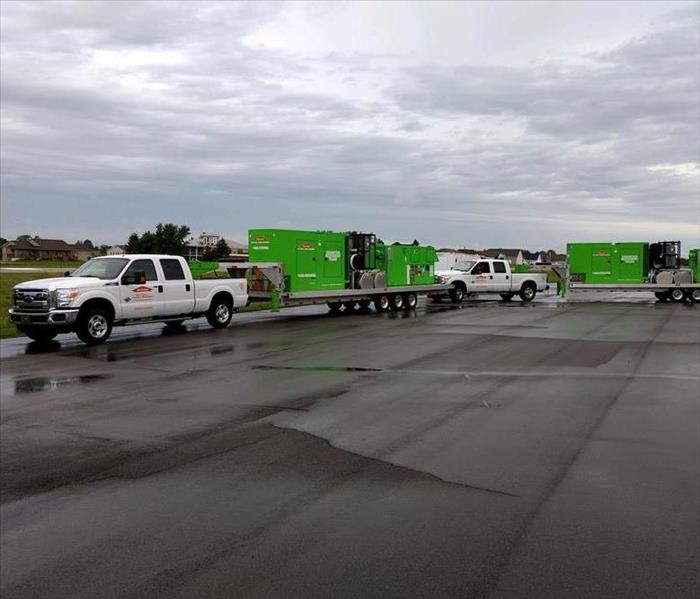 Emergency services of any size are no problem for #SERVPRO. We have the right equipment for any size #waterdamage or #firedamage.
Emergency services of any size are no problem for #SERVPRO. We have the right equipment for any size #waterdamage or #firedamage.
SERVPRO of South and Northwest Grand Rapids provides 24-hour emergency service and is dedicated to being faster to any-sized disaster in the Grand Rapids area. We can respond immediately to your emergency and have the expertise to handle your restoration or cleaning needs.
- 24-Hour Emergency Service
- Faster to Any-Sized Disaster
- Highly Trained Restoration Technicians
- A Trusted Leader in the Restoration Industry
- Locally Owned and Operated
- Advanced Restoration and Cleaning Equipment
Have Questions? Call Us 24/7 – 616-662-9700
Residential Services
Whether your Grand Rapids home needs emergency flood damage or you have mold that needs to be addressed, you can depend on us. Our technicians have extensive remediation and restoration training and can make your property look and be its best. Learn more about our residential services:
- Water Damage Restoration
- Fire Damage Restoration
- Mold Remediation
- Storm Damage Restoration
- Building/Reconstruction Services
Commercial Services
There's never a convenient time for fire or Water damage to strike your Southwest Grand Rapids commercial property. Every hour spent cleaning up is an hour of lost revenue and productivity. So when the need arises for professional cleaning or emergency restoration services we have the training and expertise to respond promptly with highly trained technicians to get your property back to business. Learn more about our commercial services:
https://www.SERVPROnorthwestsouthgrandrapids.com/commercial-restoration-cleaning
- Commercial Water Damage Restoration
Commercial Fire Damage Restoration
What To Do When A Pipe Bursts In Your Commercial Building
12/3/2019 (Permalink)
When it comes to a burst water pipe, the damage to your commercial building can be serious, and your equipment, possessions, and the health of your workforce can be damaged if the mess is not cleaned up properly.
Here are some important steps to take when a pipe bursts in your commercial building:
First thing, turn off the water flow when you suspect a pipe has broken. You’ll find the stop tap on the water main. It is typically located under the main sink or where the main service pipe connects to your building. Key people on your staff should know the location of the water shut-off stopcock for emergencies.
Once the main water switch is off, you’ll need to drain the pipes. Run cold water through all the faucets, and be sure to flush each toilet at least once. The hot water system needs to be turned off, which runs hot water through the faucets to drain that supply. When there is no more running tap water, the leak will stop.
After draining all the excess water, locate the burst pipe and inspect the damage. Consider where the pipe is located before you purchase parts or fittings. Regardless of the damage or size of the break, a major water pipe will take more time and effort to replace because it holds more water and leads to additional connections.
You might be able to patch a smaller leak yourself and prevent further damage while saving money. If you use commercial tape or chemical bonding agent you will need to keep an eye on that repair job, because it might burst later and create even more issues.
Fixing a rupture or crack in non-main pipes is usually fairly simple, but when it comes to bigger issues, you will want to call in professionals.
If the water from the burst pipe is on the walls or ceilings as well as the floor, contact a professional water restoration company. Simply using fans and open windows to dry a soaked area is not going to be sufficient to prevent mold and mildew from developing and possibly causing serious illness for your staff. You will also want to shut off the electrical power to that area of the house as a precaution against shocks.
The team here at SERVPRO of Grand Rapids is here to help in the event of a water damage event. Call us if you experience issues from a burst pipe, and don’t forget we are fire damage experts, too!
Wind Storms are here, are you ready? SERVPRO is!
11/27/2019 (Permalink)
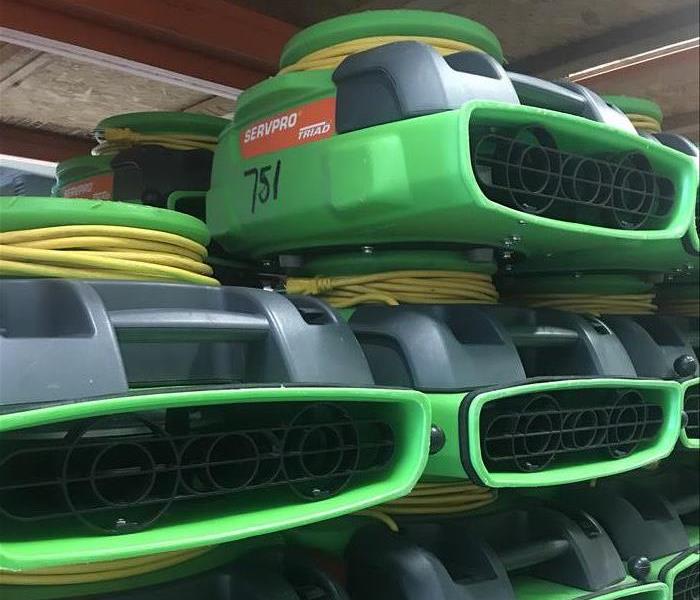 SERVPRO's state-of-the-art equipment
SERVPRO's state-of-the-art equipment
SERVPRO of South and Northwest Grand Rapids specializes in storm and flood damage restoration. Our crews are highly trained and use specialized equipment to restore your property to its pre-storm condition.
Faster Response
Since we are locally owned and operated, we are able to respond quickly with the right resources, which is extremely important. A fast response lessens the damage, limits further damage, and reduces the restoration cost.
Resources to Handle Floods and Storms
When storms hit the greater Grand Rapids area, we can scale our resources to handle a large storm or flooding disaster. We can access equipment and personnel from a network of over 1,700 Locations across the country and elite Disaster Recovery Teams that are strategically located throughout the United States.
Have Storm or Flood Damage? Call Us Today 616-662-9700
How To Prepare Your Home For Freezing Temperatures
11/19/2019 (Permalink)
We all know that freezing temperatures will be in Grand Rapids soon enough. None of us are fooled by the beautiful fall weather - winter will be here in just a few short weeks. If you haven't done so already, now is the time to prepare your home for freezing temperatures.
Water and storm damage from winter storms account for a large percentage of homeowner’s insurance claims, and it’s a busy time of the year for plumbers. It can be hard for local plumbing and clean-up companies to keep up with the demand.
Some home preparation ahead of time will help you avoid the costs of repairs that come from not planning ahead. There are a number of things you can do to ensure your house will not be a victim to freezing temperatures, many of which are fairly simple and easy on your wallet.
For example, one great place to start is by insulating exposed water pipes so they won't freeze when the thermometer is reading below freezing. If your pipes do crack, you also need to know how to shut off the water so that damage is minimized. It’s a good idea to make sure that family members or others in the household know how to do this, as well.
Insulation is key and should be packed into all corners of your house - from your walls to your attics and crawl spaces. This will keep the heat inside where you need it most.
When temperatures are forecasted to fall below freezing, make sure your room temperatures are set no lower than 65 degrees. Also, open the doors beneath your sinks to circulate any warmer air there, and set your faucet to drip water overnight. A slow drip will work just fine, and it’s a simple fix that will keep pipes from freezing and bursting.
A common oversight of many homeowners is forgetting to unhook the garden hoses. When this happens the water left in the pipes can freeze and burst inside your home. Make sure all those faucets outside are turned off!
Many of us will be traveling during the winter holidays, so if you are planning on going out of town and you anticipate a big freeze while you are away, turn off the main water valve to the house so that you don’t have a huge water cleanup project to do when you get home.
A little prevention goes a long way and can save you a lot of money spent on energy bills, too. The team here at SERVPRO of Grand Rapids is here to help with any water damage you may experience. We are also experts at handling fire damage and mold remediation.
Preparing Your Yard/Property For Storm Damage
11/5/2019 (Permalink)
Here at SERVPRO of South and North West Grand Rapids, we advise homeowners to prepare their homes and property for the coming winter storm season. Extreme weather can lead to power outages and disruption of communications, as well as damaging personal and business property and belongings. Flooding and large snow accumulations can cause travel to become extremely dangerous and even deadly, so it’s important to be prepared for many different serious situations to occur during winter here in Michigan.
Here are some essential safety tips to help you prepare your home for the coming winter season:
- Exterior Doors/Windows. These areas need to be inspected and sealed properly or replaced ahead of storms and other winter weather conditions. Not only will you stay safer, but you will save on related energy costs, especially if you replace old windows and doors with newer, more efficient models. There are many different types and styles to choose from.
- Gutters. When snow melts, it needs to be able to flow down your rain gutters and away from your roofing. If there is dirt and debris left in your gutters from last spring, the water will pool and begin to back up, possibly damaging even interior wall spaces in your home, and this can even lead to mold growth, causing a need for mold removal on top of the storm damage. A rain gutter that is full of dirt can become heavy and can pull away from the building, creating another set of issues.
- Landscaping. Before storm season comes, make sure all dead or unhealthy trees and bushes are trimmed back or removed. Cut away branches that are not stable, and clean up those items that may be littering your premises. Flying tree branches and other debris can cause major damages to your property when a storm hits.
Our team here at SERVPRO of Grand Rapids cares about your safety and the safety of your loved ones and your property. If you need help after an extreme weather event, call us. We are water damage and fire damage experts, and we specialize in mold remediation.
Water Damage Recovery Tips For Your Hardwood Floors
10/22/2019 (Permalink)
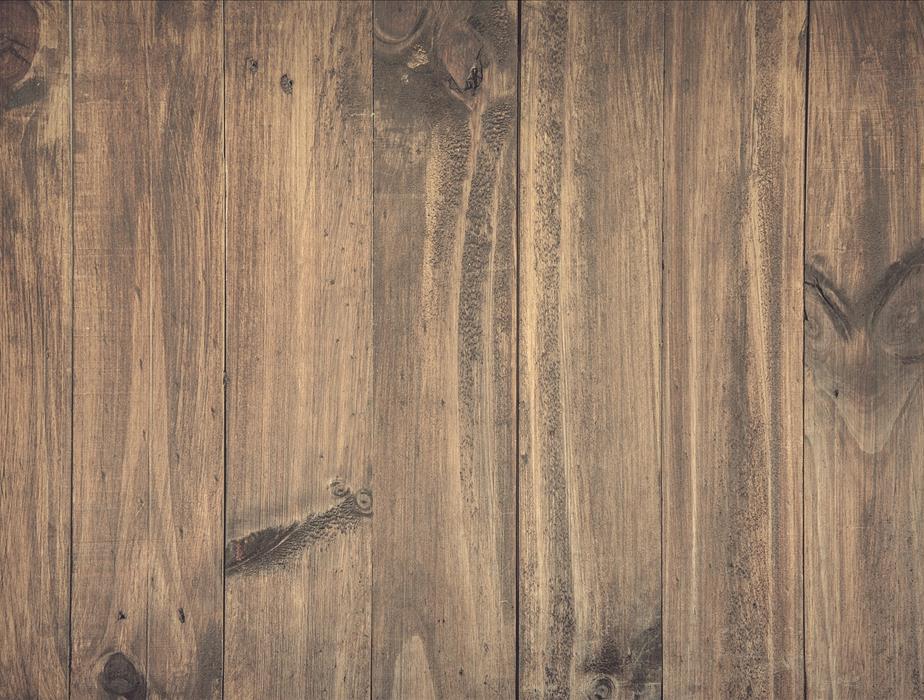 If water damage affects your hardwood floor, don't hesitate to call SERVPRO of South and North West Grand Rapids!
If water damage affects your hardwood floor, don't hesitate to call SERVPRO of South and North West Grand Rapids!
Floods are devastating to many areas of your home or business, and your wood floors will be seriously at risk. When water sits on top of hardwood, the wood absorbs the water through its pores and will cause warping and discoloration, potentially causing permanent damage. If you have experienced water damage to your premises, we would like to share some water damage recovery tips with you that can help:
- Remove Water Fast. Remove all water as quickly as you can. The longer the water remains, the worse the damage will be. The first 24 hours are critical, but if you are able to remove the water and dry your hardwood floors completely, you may be able to save them. You will also be alleviating the possibility of a mold invasion, too.
- Sand/Refinish. You will most likely need to sand and refinish the wood. This repair can bring your floors back to pre-flood conditions, or at least as close as possible. The sanding and refinishing step will save you both the time and the money that would be involved in having your flooring removed and new flooring installed.
- Bring In Professionals. If you have experienced really serious water damage, perhaps from a tornado, hurricane, or severe flooding, your best choice is contacting a professional water damage restoration service. Choose experts in this area that have the personnel and equipment necessary to get your water damage taken care of as fast as possible. Make sure you call them immediately, since these companies will probably have a waitlist if your entire area has been affected by a weather-related disaster.
- Preventive Measures.
- Find the source of water and plug it up.
- Remove all wet items from the flooring. If you have carpeting on top of your hardwood floor, remove both the carpet and the padding immediately. This is an area where mold can quickly become a real issue. Remember that your restoration professionals can help you with carpet-cleaning after a water damage event, too.
- Use a household vacuum or a shop-vac to extract as much water as you can, and be sure to contact your professionals if the amount of water is really large.
- Disinfect. Prevent mold and preserve your hardwood floors by using a non-sudsy disinfectant, and then vacuum again to remove standing water.
- Drying. Use a dehumidifier or run your heater or air conditioner constantly to keep the air dry inside the affected room(s).
These are just a few steps that you can take yourself when your hardwood floors are affected by water. SERVPRO of Grand Rapids is always here to help you with repairs and renovations to your property when you are affected by water damage, no matter the size. We also handle fire damage, and we are mold remediation experts, too.
Fall Fire Prevention Tips
10/8/2019 (Permalink)
With the cooler temperatures of fall just around the corner, it is a good idea to revisit fire prevention and safety tips that are specific to this time of year. As you focus more and more on staying warm, you’ll also want to focus on staying safe while enjoying this season.
- Checkups. Your smoke detectors and carbon monoxide detectors will need a change of batteries so they can stay on duty. Take a look at your fire extinguishers to ensure they are fully charged and in good working order.
- HVAC. Call your local certified HVAC technician and have them come clean, inspect and service your central heating system to avoid potential issues.
- Space heaters. Practice safety when using space heaters by:
- Making sure any unit is surrounded by at least three feet of empty space
- Never using these units to dry clothing or other objects
- Keep any space heater away from furniture or drapery
- Always turn these units off when you go to bed or leave the house
- Fireplaces. Practice fireplace safety using these tips:
- Your chimney should be inspected yearly
- Employ a certified chimney sweep to clean your chimney in early fall, every year
- Repair all cracks in your fireplace
- Use screens to keep sparks and debris inside your fireplace
- NEVER use gasoline to start a fire in your fireplace
- NEVER leave your fire unattended
- Store any combustible materials at least three feet away from the fireplace
- Holiday decorations. Enjoy the holidays safely by taking these precautions:
- Use flashlights instead of burning candles in your Jack-O-Lanterns
- Halloween costumes should be constructed with fire-retardant materials, as should all holiday decorations.
- Make sure that all extension cords and holiday lights have been tested by an approved organization - pay attention to labeling.
- Teach your family fire safety:
- Make sure even young children know how to call 911.
- Establish a fire escape plan for your family, and practice it until everyone is sure they know what to do, and where to meet.
- “Stop, drop, and roll” needs to be taught to everyone and practiced.
- Outdoor fire safety for fall:
- Clear your rain gutters and roof of debris buildup
- Find the outdoor burning regulations for your area, and never illegally burn leaves or other outdoor debris
Here at SERVPRO of Northwest/South Grand Rapids, we care about the safety of your family. Call us for help with fire or water damage, or when you are experiencing issues with mold or mildew. We’re always here to help.
How To Prevent Mold Damage In Your Commercial Building
9/24/2019 (Permalink)
You’ve worked hard to get where you are, and as a savvy business owner, you want to do everything possible to protect your enterprise. Routine preventive maintenance is one of the main methods to keep everything in great shape and operating smoothly. This gives your roofing, exterior doors and windows, parking areas, warehousing and storage, and office space the attention they need. You’ve thought of everything….or have you?
Today we would like to share some tips on preventing mold in your commercial building:
- Be aware. Mold can grow quickly in unexpected places. Create an inspection plan for your business that is designed to be done on a routine basis. Search for signs of mold in damp, high moisture areas, and look for spotty or fuzzy stains on walls, floors, and carpeting. Take note of musty smells, too. Request your cleaning crew to notify you of any specific areas they think may be at risk.
- Timely repair. Make sure any issues in your building are taken care of right away, especially leaks and water damage. Damaged roofing, unsealed windows and door frames, and cracked foundations are all risks for the establishment of a mold colony.
- Damp air. Your geographic location may mean that you are always dealing with high humidity, and since damp air encourages mold to grow, you may want to install dehumidifiers in your commercial building.
- Clean air. You can reduce the transfer of mold spores throughout your commercial property by cleaning and maintaining your HVAC system and air ducts properly and regularly.
We’re there. Every commercial property is different, so you may need to consult a mold remediation specialist for help in creating a customized plan that will fit the needs of your structure and your business. Working with a company that has experience handling mold and mildew issues will ensure that this expensive and harmful situation won’t cause problems for you, now or in the future. The SERVPRO of Northwest/South Grand Rapids team is always here to help, and we respond faster to any disaster, large or small!
Cleaning Your Commercial Office Building
9/10/2019 (Permalink)
A thorough cleaning will rid your commercial office building of the dust and grime of summer, bringing a clean and refreshed feel to your workplace as well as positively impacting your business’ profitability and your workers’ productivity. Commercial cleaning is a bit different than residential cleaning since it will call for more in-depth cleaning processes and better organization. You have a lot of people, and aspects, to think of.
Let your employees know that a cleaning process will be beginning, and inform them what that process will look like. If there are any possible interruptions in tools or workflow, you will want to let them know and get their feedback on how to handle these situations. Make sure they are aware of the cleaning products that will be used in case there are possible irritations or allergies that some may experience. Many people prefer to be exposed to more eco-friendly products these days, so that’s an option that will make everyone happy.
Provide employees with a schedule so that they know exactly what to expect as your cleaning process moves forward. If it will be necessary for them to box up any of their work items, let them know as far in advance as possible so that they can plan for the event.
The key areas you will want to focus on include:
Flooring.
- Deep-clean carpets to remove stains.
- Move file cabinets, conference tables, desks, and other large furniture items to clean the entire floor.
- Clean flooring baseboards and corners with a high-powered vacuum.
- Buff and scrub tile and concrete.
- Consider re-finishing and re-sealing floors for a renewed appearance.
- Look for fire hazards on the floor. Remove any floor or stairway blockages.
- Observe tile for breaks, dents, or cracks, and consider replacing broken tile or redoing the flooring.
Walls.
- Look for chipped paint and cracks, and decide if you need to repaint. If the cracks are large, you may want to have a professional inspect for damage.
- Clean all windows to remove dust and marks, cleaning both outside and inside. For tall or high windows, hire a professional window cleaning service.
- Dust and wash the drapes and blinds. This area is usually forgotten in weekly cleanings.
- Dust ceiling corners, light fixtures, and tops of doors.
Bathrooms.
- Clean the grout in between the tiles.
- Sanitize and deep clean all surfaces with bleach-based products.
- Re-caulk in areas of cracking or splitting.
- Bleach the inside of toilet bowls. Rub the external of the toilet bowls with a sanitizing cleanser.
- Wash the floor baseboards around toilets and urinals.
- Wash all trash-cans.
- Replace all toilet paper, soap, and other usables.
- Look for signs of mold or mildew, which is more common in high-humidity environments like bathrooms. Remove any mildew immediately.
Cleaning your commercial office building can be a big job. Here at SERVPRO of South and North West Grand Rapids, we can help you get your cleaning projects done in record time. Call us today for your commercial office building needs.
How To Prevent Storm Damage To Your Business
8/27/2019 (Permalink)
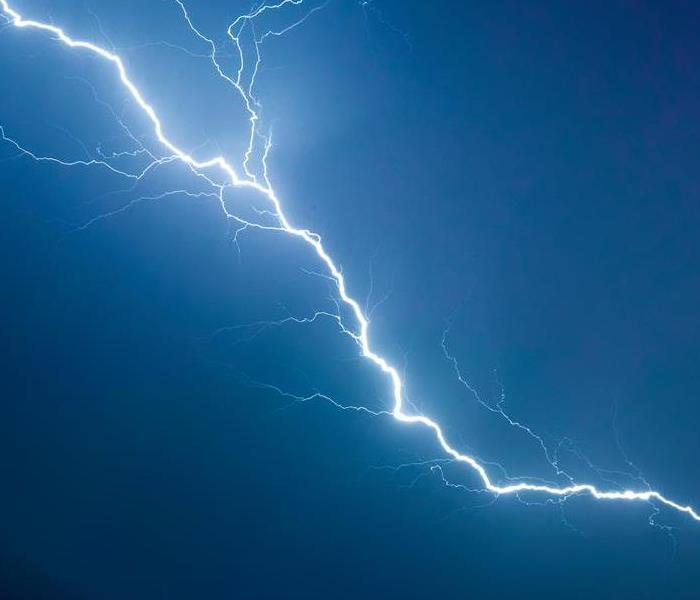 Lightning strikes during thunderstorms can cause significant damage to your home and property.
Lightning strikes during thunderstorms can cause significant damage to your home and property.
Falling trees, fire, high wind and hail storms often cause damage to roofing and other vulnerable parts of your property. Safety should always be your primary concern to prevent storm damage to your business.
- Roofing. The best way to prevent unnecessary damages is to ensure that your roof is in the best shape possible before storm season hits. After a storm, any initial roof assessment should be completed from the ground as you want to make sure you are safe. If you suspect damage to your shingles or structure, contact a professional immediately. Make sure everyone vacates the premises in the event of major roof damage.
- Landscaping. Before the stormy season, have your landscaping trimmed back and remove all dead or dying vegetation. This will help to lessen the risk of flying branches or falling trees.
- Parking Areas. Keeping your parking areas in good repair will mean that after a storm, your clients will still be able to get to you. Potholes and flooding in your parking lot will keep everyone away, including your workforce.
- Walkways. Heavy storms can undercut walkways, making them dangerous for pedestrians, and that’s something you definitely want to avoid. Have them updated and strengthened before heavy weather, and take a good look at them after a storm moves through the area. If you need a second pair of eyes, call a professional storm damage cleanup company for help.
Storms and inclement weather can bring wind damage, heavy rain, and flooding that can devastate any business in a matter of minutes. There’s never a convenient time for flooding or water damage to strike, and storms don’t just strike during regular business hours; that’s why SERVPRO Franchise Professionals offer 24-hour emergency service 365 days of the year.
The SERVPRO Disaster Recovery Team can provide help whether your property has experienced a tornado, hurricane, blizzard or flood. The SERVPRO System has a network of strategically positioned storm teams on standby should a disaster strike near you. Here at SERVPRO of South and North West Grand Rapids, we are always prepared for the unpredictable.
Preparing Your Grand Rapids Home For Fall
8/13/2019 (Permalink)
As summer comes to a close, it’s a good idea to think ahead to the colder months coming to our area. Getting your home ready for fall and winter’s colder temperatures and harsher weather conditions while it’s still warm and pleasant will make your life a lot easier and leave you with plenty of time to enjoy the coziness of your house during the holidays. Weather may be unpredictable during the fall here in Grand Rapids, but you won’t have to worry about it if you prepare your home for fall now! Here are some preparations to consider:
- Gutters. Remove dead leaves and debris from your gutters and drainpipes. This will prevent clogging during wetter weather. Drain all outdoor faucets ahead of freezing weather now, as well.
- Chimney and Fireplace. Clear out leftover ash and charred wood from the fireplace, and contact a professional to clean the chimney. Ask the chimney cleaning company to make sure your damper can be closed properly so that drafts of cold air won’t be coming into your home during fall and winter months.
- Heating System. Check your home’s heating vents to make sure they won’t be blocked by furniture, floor coverings, or curtains, and dust them as well. All filters should be changed, and now is a great time to have a professional come and make that annual system checkup.
- Air Conditioners. Unplug any removable window air conditioners, cleaning them thoroughly before putting them in storage.
- Drafts. Examine all your windows and doors for cracks. If you find any, have them sealed now so that you can stay warm and save energy this fall and winter. You’ll be saving both time and money here!
- Storm Windows. Removable screens should be taken down and cleaned, stored and replaced with storm windows.
- Water Heater. Drain the water heater and clean out any debris that may have settled in the tank.
If you need help with the job of preparing your home for fall, just call the professional team here at SERVPRO of South and North West Grand Rapids. We have the expertise and the equipment needed to get the job done right.
How to Clean Up Smoke Damage in Your Home
7/31/2019 (Permalink)
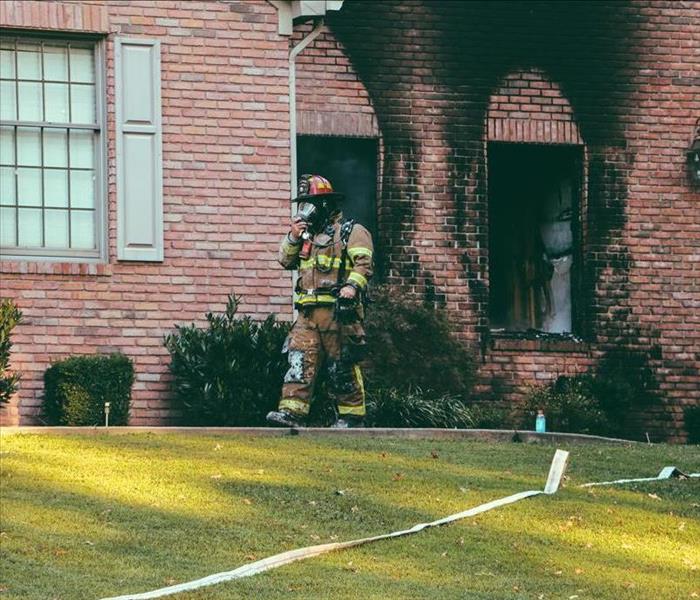 Enjoy a smoke-free home!
Enjoy a smoke-free home!
Cleaning up smoke damage in your home is extremely important, but unfortunately, it won’t be as easy as opening a window and letting things air out. The acidic nature of smoke and soot makes them difficult to remove. However, they both contain unpleasant odors and particles that are harmful to breathe, so it’s important to clean them up completely to maintain a healthy living environment. Here at SERVPRO of South and North West Grand Rapids, we have years of fire damage clean-up experience, and over the years, we’ve picked up a few helpful tips that we’re sharing today:
What You’ll Need
One item you may have to buy is a dry-cleaning sponge, but many other helpful cleaning products can probably be found around your home. A sponge, however, is very important for smoke damage removal, so we encourage you not to neglect adding this effective cleaning tool to your list of supplies. We recommend you acquire the following:
- Rubbing alcohol/paint thinner
- Vinegar
- Degreaser / commercial soot remover
- Vacuum (ideally a strong shop-vac) with an upholstery attachment
- Bucket / hot water
- Dry-cleaning sponge (chemical sponge)
- Clean rags
- Sponge
- Fan
After obtaining the cleaning tools above, here are a few next steps:
Ventilate. The first thing you need to do is ventilate the house to get fresh air flowing; be sure to open all the doors and windows in the home. You also can use fans to encourage airflow. Additionally, turn off your HVAC system to prevent smoke and soot from spreading.
Use Protection. Before you clean your house, make sure to protect yourself properly. Soot, smoke, and debris can be dangerous to inhale, so wear a respirator if there is significant soot in the damaged area. Long pants and sleeves will protect your skin, and wearing gloves and eye protection can help save your eyes and hands. Since you will be freeing soot as you clean, it’s important to lay down floor protection and remove any furniture or household objects that are not damaged. If the damaged area is small, you can simply cover furniture with plastic or sheets, but if you’re cleaning an entire room, it’s wise to remove clean items and even seal off other rooms that were not affected. Be mindful of the shoes you’re wearing so you don’t track soot stains into other rooms.
Vacuum It Up. Soot and smoke damage usually come in one ugly, smelly package, so remove loose soot particles with a vacuum with an upholstery attachment. A shop-vac with strong suction power is best for this task. Lightly brush the affected area with the brush attachment, vacuuming up the loose particles. Be gentle and avoid scrubbing, which can make stains worse.
Use The Sponge. After performing the steps above, it’s time to use that dry-cleaning sponge (chemical sponge) to wipe up the soot and smoke stains; these sponges use special chemicals to lift stains from walls. Never use soot cleaner or water before you use a dry-cleaning sponge or you could spread the soot, making it impossible to remove with a chemical sponge. Begin by wiping the walls gently with the dry-cleaning sponge, and turn the sponge to a different side as it gets soiled so that you are always using a clean surface. When all sides are soiled, slice off the dirty sides with a knife to reveal fresh surfaces beneath, or use a new sponge. Make sure you use a wiping motion the entire time because when you scrub the stains, you spread them and work the soot deeper into the surface.
Use Liquid Cleaners. After you remove as much soot as possible with the dry-cleaning sponge, you can use commercial soot/smoke remover (follow the manufacturer’s directions), rubbing alcohol, white vinegar or paint thinner and a clean rag. Soak the rag in your preferred cleaner and wipe the walls throughout the damaged room. Even if there is no sign of soot or smoke damage, it’s important to wipe every surface in the room, including light bulbs. Next, you’ll want to use TSP, dish soap or degreaser in a gallon of hot water to wash the walls with a rag or sponge; just a few teaspoons should be enough. Use the same wiping motion you used with the dry-cleaning sponge. You may need to use a combination or repeated treatments of these chemical cleaners depending on how bad the damage is. As the rag gets dirty, rinse it out in the bucket or use a new rag. The same applies to your cleaning water. Refresh your water when it gets black or smells like smoke. Once you’ve completed washing the room with your chosen cleaner, wipe the walls again with fresh water and a clean rag to remove any remaining cleaning products.
Dry It Up. Dry the clean surfaces with a clean rag. You can use fans to speed this process up if necessary. You will probably still smell smoke odors, as they can take a few days to a few weeks to dissipate. Identify materials that can easily absorb odors, such as upholstered furniture or area rugs, and place these items together in a separate room or outdoors to see if the smell dissipates after a few days. You may want to consider throwing out the items you can stand to part with. Getting your carpeting, curtains, and furniture professionally cleaned will also help with lingering smoke odors. Don’t forget to replace your HVAC filters, which may be circulating smoky air in your home.
Cleaning your home after smoke or soot damage can be a difficult job. If you need assistance, SERVPRO of South and North West Grand Rapids is here to help. With IICRC-certified techniques and state-of-the-art equipment, our trustworthy experts are the best in the fire damage restoration industry.
Storm Damage Prevention Advice for Your Home
7/16/2019 (Permalink)
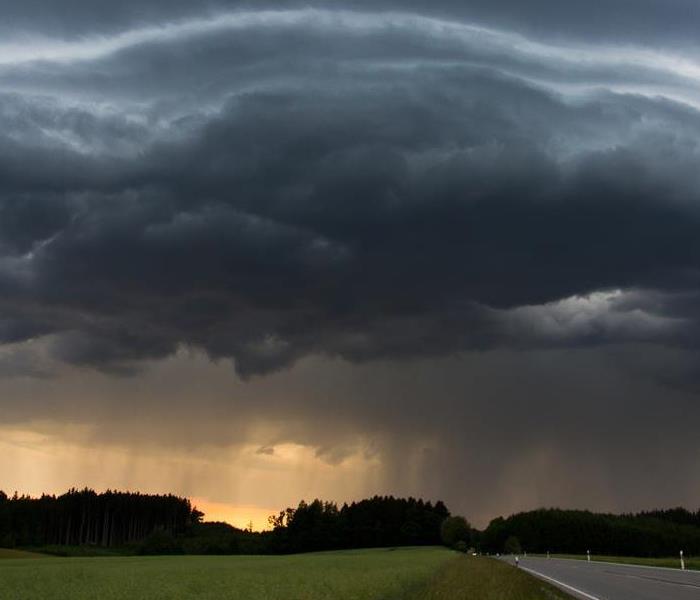 Prepare for storms before they hit!
Prepare for storms before they hit!
No homeowner gets to choose when a storm is headed his way, but a smart homeowner can choose to be ready for any kind of inclement weather. Today we’re sharing some advice for you that will help to reduce and prevent storm damage from adversely affecting your home and property.
- Roofing. Regular roofing inspections will help you identify issues like minor leaks or missing shingles, allowing you to get them repaired right away. This will help you avoid serious structural damages when severe weather arrives. If your home does suffer storm damage, you can call us here at SERVPRO of South and North West Grand Rapids to schedule repair and cleanup.
- Landscaping. Hard winds and heavy rain will accompany the storms of summer, and dead tree branches, unhealthy vegetation, and unstable trees can cause damage to your property under these conditions. We recommend regularly trimming your plants and trees, removing dead or dying limbs and plants wherever necessary. Replace plantings if some are removed by storms to prevent erosion from heavy rains, too.
- Storm Windows. Invest in high-quality storm windows to prevent leaks and other storm damage. These do a great job of protecting window glass, adding an extra layer of safety to your home’s interior against the wind and rain.
- Entrance and Parking. Keep your driveway and your entrance in good repair, replacing buckling concrete or stepping stones and filling in potholes ahead of inclement weather. Your friends and family’s safety is important to you, we know, and this important step goes a long way towards ensuring that no one gets hurt during the storms of summer.
- Basements. Keep an eye on all low lying areas of your home, like your basement. This is where leaks will show up and often go unnoticed, so taking a close look before and after wet weather will help you spot a problem right away.
For more tips on preventing storm damage, contact us here at SERVPRO of South and North West Grand Rapids for assistance. We specialize in cleanup from water and fire damage, no matter the size. We are also mold remediation specialists. Visit us online for a complete list of our services. You can call us at (616) 662-9700 at any hour for assistance. We’re available 24/7.
5 Ways to Prevent Water Damage In Your Commercial Building
7/2/2019 (Permalink)
 Be on guard against water damage—it can happen at any time!
Be on guard against water damage—it can happen at any time!
As a wise business owner, you know that damage prevention is always going to save you both time and money, and preventing damage from water is one of the most important prevention focuses you can have. Water damage is at the top of the list of mishaps a business can suffer from and the cleanup for this kind of event can be extensive, so today we want to share five ways to prevent water damage in your commercial building.
- REGULAR MAINTENANCE. This is the number one way to prevent damage from water. Whether we are talking about the drainage areas for your entrances and your parking lots, or we are discussing leaks and floods in kitchen and bathroom areas, many times you can avoid these kinds of events through regular maintenance. Identify the areas on and around your premises that are the biggest risk, and schedule regular inspections and repairs for these areas.
- VIGILANCE. Instruct your workforce to say something if they see something. When an area is damp that should not be, something needs to be communicated. Additionally, when equipment that uses water, like dishwashers or commercial kitchen sinks, is not functioning properly, encourage your employees to let you know right away.
- WEATHER. If the weather news people are projecting a wet season, make it part of your daily routine to look around your grounds for overflowing ditches or gutters after heavy rains and storms. Take note of standing water, too. Issues like these can cause erosion and potholes, not to mention breed mosquitoes.
- RESTAURANTS/CAFES. If you own a restaurant or cafe, make sure the kitchen flooring is always properly taken care of to avoid water damage down the road. Closing after a long, busy evening can be stressful, but it’s not the time to cut corners when it comes to getting everything into shape for the next day.
- IMMEDIATE CLEANUP. If you have a flooding event, large or small, it is always going to be a good idea to get it cleaned up and dried completely as soon as possible.
If you need help with a cleanup for water damage, large or small, here at SERVPRO of South and North West Grand Rapids we are always ready to help. You can call us at (616) 662-9700
for assistance with fire damage and mold remediation, too.
Fire Prevention Tips for your Office
6/17/2019 (Permalink)
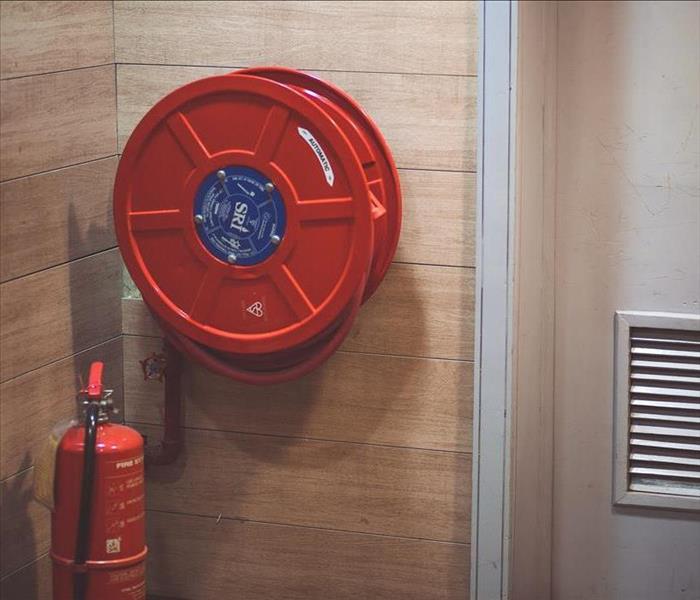 Having proper equipment to prevent fires is important.
Having proper equipment to prevent fires is important.
Studies have shown that most business fires occur while the premises are not populated, between the hours of 7 pm and 7 am, causing a large amount of damage. Commercial fires, caused by cooking equipment, are also potentially devastating, but surprisingly, the most damaging ones start in an office environment! Here are some fire prevention tips to help lower the odds your office is affected by fire.
Have A Plan. Designating someone as your “safety officer” is one step you can take that will really help. He or she can take the lead in establishing appropriate escape routes and meeting places, and setting up appropriate emergency procedures, as well. Your employees should be aware that the safety officer is in charge during any emergency and will be the one responsible for contacting emergency personnel, keeping track of employees, and assisting with providing information on equipment and chemicals kept in your office. An up-to-date emergency contact list should always be available at your place of business, and you should designate someone to be in charge of contacting family members or next-of-kin, in case of injury or a missing person.
Have Proper Equipment. There are specific items you will need to have on hand in advance of a fire, such as fire extinguishers and smoke alarms, and these are required through local building codes, so they should be present. Alarms and extinguishers need to be inspected monthly and replaced when necessary. You will also want to have a fully-stocked first aid kit and bottled water on hand, as well as flashlights, just in case.
Hold Regular Drills. Your safety officer should schedule regular drills and training to make sure everyone is well-versed in what to do in case of an emergency, such as an office fire. During these drills, new emergency response information can be shared to keep everyone up to date.
Follow these Preventive Tips to prevent a fire in the first place:
- Follow manufacturers’ recommendations for maximum volt/wattage load for surge protectors, power strips and adapters, and ask your electrician to periodically inspect these items and outlets for potential overload.
- Replace frayed power cords and never run them under rugs or carpeting. Use cord protectors, instead.
- Unplug appliances (coffeemakers, microwaves) and other equipment not in use at the end of the day and over the weekend.
- Replace appliances that feel warm or hot to touch.
- Ask the fire marshal to inspect chemical and equipment storage areas periodically to ensure proper ventilation and stowage.
- Store hazardous materials according to manufacturers’ instructions and OSHA regulations. Clearly mark these items to help emergency personnel identify and stabilize them.
- Don’t prop fire doors open or block exits with furniture or boxes.
- Don’t allow paper and other trash to accumulate outside of garbage or recycling receptacles, and never store this material near hot equipment, electrical outlets or the smoking areas.
- Don’t permit employees to burn candles, scented oils, etc. in their personal work areas.
Our SERVPRO of South and North West Grand Rapids team is here to help you in the event of damage from fire or water. We’re available 24 hours a day, 7 days a week, and we are mold prevention and remediation specialists, too!
The 3 Most Common Places to Check for Mold Growth
6/3/2019 (Permalink)
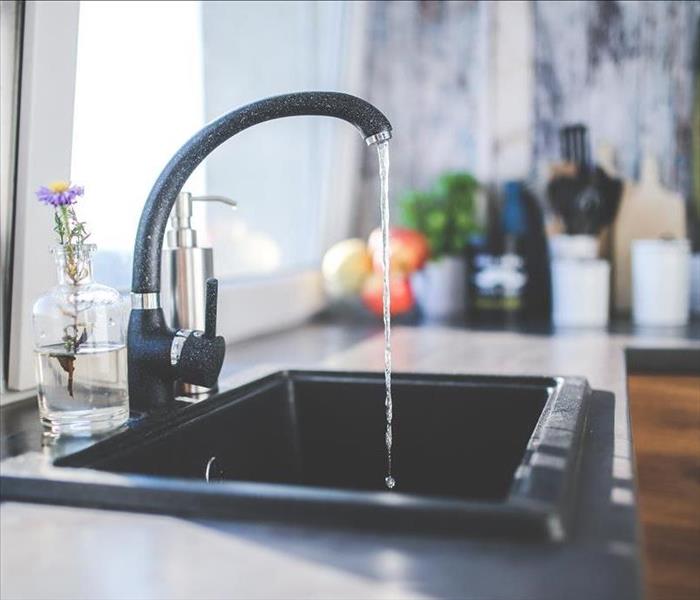 Make it a habit to regularly check under your sink for mold growth.
Make it a habit to regularly check under your sink for mold growth.
Mold. The mere mention of the word brings to mind all the unpleasant aspects of this organism - the unsightly black, red, or gray spots that appear, its odors, and the allergic reactions that many people experience when mold moves in. We all know that it can be very beneficial, though, by helping to create various cheeses and alleviate sickness, for example. But when we find it in our home or business, we forget about its benefits.
Keeping an eye out for mold growth in your house or place of business is a great way to prevent a colony from becoming established, protecting your possessions and the people you care about from being negatively impacted by its arrival.
Here are three of the most common places you will find mold:
Under The Sink. Sinks often spring small leaks, and we may not even realize it for quite some time. A tiny leak in the darkness of a cabinet or at the base of a sink pedestal that goes unnoticed is prime real estate for a mold colony. When you are doing your regular inspections, this type of space is the first place you should check for mold growth.
Behind Appliances. The refrigerator, dishwasher, and washer are heavily used household items that involve large amounts of water, of course. They can also spring small leaks easily, and unless you look behind them or under them, you might never notice. These areas are also perfect places for mold spores to settle down.
Basements/Low-Lying Areas. Low-lying areas and basements can often experience damp conditions, especially during warm, wet weather. Windows that are not properly caulked, or roofing and rain gutters that haven’t been properly maintained, can allow water to reach these areas and create the dampness that mold just loves to inhabit.
When it comes to mold, remember that the SERVPRO of South and North West Grand Rapids team is here to help. We are mold prevention and remediation specialists! We are also experienced in the areas of fire and water damage, too, and we’re available 24 hours a day, 7 days a week.
Preventing Flooding in Your Grand Rapids Office
5/21/2019 (Permalink)
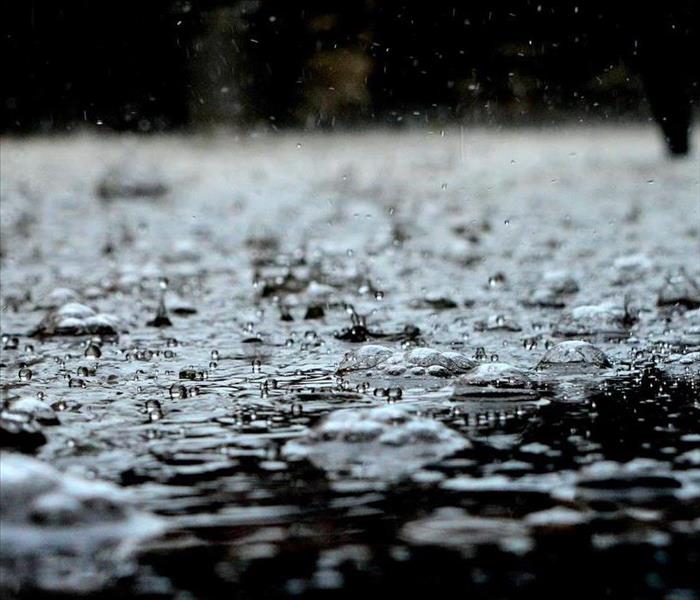 If you're dealing with flooding, give us a call! We can help you out.
If you're dealing with flooding, give us a call! We can help you out.
We all know what water damage to a business looks like after a flood or during heavy rainfall. Oftentimes, events such as these are unexpected, so it’s just good business to be prepared for this type of event.
Here are some tips to help you prevent flooding in your Grand Rapids office:
- INSPECTIONS. Take a good look around your place of business to ensure that you are prepared for wet weather. Check exterior doors to see if they fit as tightly as they should and that both doors and windows are properly weather-stripped. A small leak can easily turn into a small flood in your office space. Your office parking lot or driveway needs to have a well-planned drainage system so entering and exiting your building can be safe even during wet weather. Flooding in your parking areas can bring your business to a halt. If you know you’ll see a lot of run-off from the parking area, consider using sandbags. Low-lying buildings next to a parking lot full of water can end up flooding, and you will want to plan ahead to prevent that from happening.
- COMMUNICATE WITH PUBLIC SERVICES. Drainage areas that are maintained by the city or county should be monitored, especially during heavy rains. If these spots begin to overflow, contact your city representatives immediately. Keep them updated about the rivers and streams in your area, as well. If there is a problem developing, you can take steps to sandbag vulnerable areas around your office building.
- INTERIORS. Some flooding isn’t caused by weather, it’s caused by an equipment failure. Make sure your plumbing and appliances are regularly inspected and maintained so that you don’t walk into a mess on a Monday morning. It’s all about preparedness.
The team here at SERVPRO of South and North West Grand Rapids is ready to help in any way we can. We have the expertise to handle water and fire damage, and we specialize in mold remediation. If you have sustained water damage to your property, give us a call today at (616) 662-9700, or visit us on our website.
Five Steps to Storm-Proofing Your Garage
5/7/2019 (Permalink)
 Make sure to equip your garage to prevent storm damage!
Make sure to equip your garage to prevent storm damage!
Make storm-proofing your attached garage a priority when planning to protect your home from storms. Being one of the largest spaces in any home, your garage is also the most vulnerable place when it comes to high winds. Here are some tips to storm-proof your garage, which will also protect the rest of your home:
- High Impact Ratings. Storms with extreme wind will cause the most damage; when a garage is breached, the rest of your home is at risk. Water can come in, and even just an inch of water can cause expensive and unwanted damage. If you live in an area prone to tornadoes, it is recommended that you invest in a door that can withstand winds of 130 mph or higher. Doors with high impact-ratings will protect your home and belongings from flying debris.
- Bracing system. You can reinforce your garage door with a proper bracing system. Most garage doors are secured only by the tracks or hinges, which will be of no benefit during a powerful storm. A bracing system works by anchoring the door to the walls and floors and into each hinge.
- Maintenance. If there are any holes, cracks, or breaches in your garage door, that will allow storm winds through. Perform a monthly inspection looking for these types of issues as well as problems with the weather stripping or any parts of the garage door mechanisms and functionality to ensure that any repairs are performed as soon as possible.
- Secure all windows. If you have windows in your attached garage, these are considered weak points during extreme weather. Ensure they are in good repair and the weather stripping is strong at all times. Having wrought-iron window protection installed can also be a protective addition to keep your glass safe from flying debris.
- Install drainage and flood vents. Make sure that your entire home is properly outfitted for the drainage of large amounts of water. You can have a trench drain installed around your home and on the sides of your driveway to divert water, and flood vents inside the garage can quickly drain any water coming inside before levels rise and cause damage.
Here at SERVPRO of South and North West Grand Rapids, we are always ready to help you if you experience water or fire damages; whether at home or in a commercial setting. Contact us today by phone at (616) 662-9700, or visit us on our website.
Tips to Prevent Mold Damage in Your Home
4/24/2019 (Permalink)
 Mold can wreak havoc on your home. Take preventive measures today!
Mold can wreak havoc on your home. Take preventive measures today!
The very mention of the word “mold” is enough to make anyone uncomfortable. We all know that mold can be beneficial, such as when used in penicillin or the making of cheeses, and we are aware of its role in the decomposition of organic matter, but when it comes to finding it in our homes, that is a different matter!
Mold spores spread easily and can never be completely eradicated. It can grow almost anywhere, too: carpet, clothing, food, and other places we never see. It is very difficult and costly to manage once it is detected. It can also produce irritants, allergens, and even toxins that can compromise your health--that’s what makes it such a serious matter when it takes hold in our living spaces.
Here are some tips to help you prevent mold damage in your home:
Identify issues. You can't mold-proof your home, but you can make it mold-resistant. Do an audit of your home and determine the main weak spots. Does your basement flood? Do you notice frequent condensation on an upstairs window, or perhaps a water stain on the ceiling from a persistent leak? Preventing mold from growing or spreading might be as simple as removing carpet in a damp basement, installing mold-resistant products, or repairing damaged gutters. Whatever the case may be, address the problem now.
Dry wet areas immediately. Mold can't grow without moisture, so take care of wet areas right away. Any wet areas should be dried within 24 to 48 hours. Even everyday wet areas need attention: don't leave wet items lying around the house, and make sure to dry the floor and walls after a shower. Don't leave wet clothes in the washing machine, where mold can spread quickly. Hang them to dry outside or in areas with good air circulation.
Proper ventilation. Make sure an activity as simple as cooking dinner, taking a shower, or doing a load of laundry doesn't invite mold by providing proper ventilation in your bathroom, kitchen, laundry room, and any other high-moisture area. Use A/C units and dehumidifiers, but make sure they don’t produce moisture themselves by checking them periodically and cleaning them as directed by the manufacturer.
Use mold-resistant products. Use mold-resistant products like mold-resistant drywall or mold-resistant Sheetrock, and use mold inhibitors for paints when building or renovating.
Direct water away from your home. If the ground around your home isn't sufficiently sloped away from the foundation, water may collect there and seep into your crawlspace or basement. You may be experiencing leakage just because your gutters are full or damaged. Have your roof gutters cleaned and inspected regularly to make sure they are sending water away from your structure. Repair them as necessary, and keep an eye out for water stains after storms that may indicate a leak has started.
There is no one-size-fits-all solution when it comes to mold prevention. Knowing what works for your climate and your home is an important first step, and always keep in mind that the SERVPRO team at SERVPRO of South and North West Grand Rapids is here to help with any mold issues. We also handle damages from fire or water, such as flooding. Contact us today by phone at (616) 662-9700, or visit us on our website.
How to Prepare Your Grand Rapids Home for Spring
4/9/2019 (Permalink)
 Spring brings showers...which can bring water damage. Call us today to help out!
Spring brings showers...which can bring water damage. Call us today to help out!
There is often still some snow on the ground this time of year in Grand Rapids, but the obvious signs of springtime are around us, too. You can see buds on the trees and the daffodils are showing their faces. We know you are more than ready for warmer weather, but what about your home?
Here are a few things to think about when it comes to preparing your Grand Rapids home for Spring:
Rain Gutters. These should be first on your to-do list. They can be full of dead leaves, small branches, and even dirt from winter weather. Clean out all rain gutters right away so the spring showers don’t cause mold problems and water damage to interior walls, and make sure the downspouts are directing water the right way, as well. The winter weather here in Grand Rapids could have caused them to change position.
Roofing. Did your roof fare well during the winter? As the melting begins, keep an eye on it to see if any leaks have started over the past few weeks and months. Take a look at any vents to see if vegetation or mold has taken hold.
Filters. The filters in your HVAC unit will probably need to be changed at this point, and you will want to clean out ducts, vents, and the system itself. Ductwork can be hard to check, so keep in mind that the SERVPRO team at SERVPRO of South and North West Grand Rapids is always ready to come out and help.
Windows. Now is a good time to inspect windows for storm and water damage. Cracks, damaged weather stripping, improper fit: all these issues can cause problems down the road. Make arrangements to get your windows professionally cleaned and ready to enjoy the warmth and sunshine.
Foundations. Remove any remaining snow 3 to 5 feet away from your foundations and inspect them for cracks caused by winter weather conditions. These can be caulked and sealed as soon as you notice them.
Irrigation Systems. Check sprinkler systems and replace anything that has been affected by freezing conditions.
If you notice any really severe damage from winter storms during your inspections, don’t forget to take pictures for insurance purposes. If you need to make a claim of any kind, photos will come in handy.
You can rely on SERVPRO of South and North West Grand Rapids for all your repairs and clean-up needs. We specialize in water and storm damage, fire damage, and mold prevention. You can contact us by phone at (616) 662-9700, or visit us on our website.
Call the CLEANUP TEAM SERVPRO® of Southwest Grand Rapids, Faster to any size disaster
5/4/2018 (Permalink)
 We're here to help 24/7 for your water damage needs!
We're here to help 24/7 for your water damage needs!
There’s no such thing as a small disaster—especially when a small leak now could blossom into a big claim later. Unseen water can soak through walls, seep through carpet and pool on sub floors, causing major problems over time. You need help—fast. No matter what time of day or night, contact SERVPRO® of Southwest Grand Rapids at 616-662-9700 to begin emergency mitigation.
Emergency mitigation means that under normal circumstances, we will be on-site within four hours to begin drying your building and restoring contents. The faster the water is removed, the less chance of serious damage to your facility. Every SERVPRO® of Southwest Grand Rapids technician is trained and understands how to manage the drying process. By utilizing state-of-the-art equipment and the latest technology, your structure will be quickly and thoroughly dried, which helps prevent secondary water damages.
SERVPRO® of Southwest Grand Rapids will remove moisture and any contaminants by disinfecting and deodorizing to safely clean and dry your building and contents. Help ensure the value of your property by calling us at 616-662-9700.
Southwest Grand Rapids Take control of the Mold situation.
5/3/2018 (Permalink)
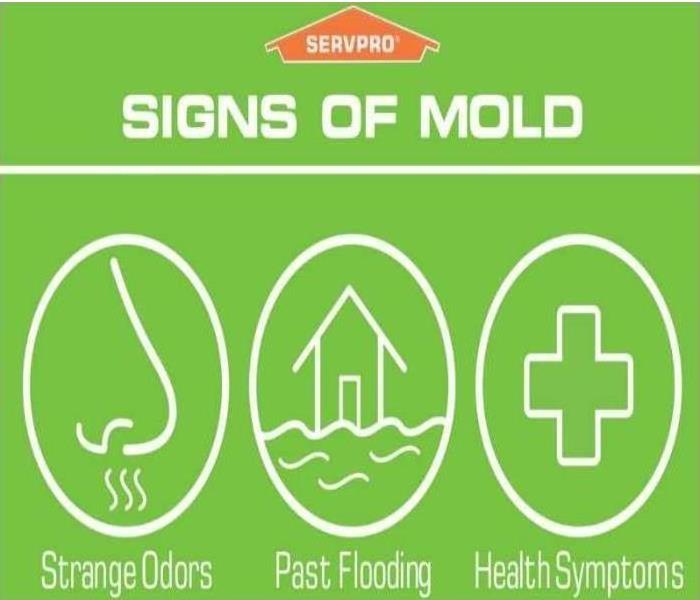 Mold is serious, let us take care of it for you.
Mold is serious, let us take care of it for you.
Moisture control is the key to controlling mold. Take time to check for water damage in your home, especially in your basement.
The CDC also recommends keeping the humidity level in your house below 50 percent. Use an air conditioner during humid months. Make sure to check the ventilation in the kitchen and the bathroom. Open a window or turn on a fan when showering. Do not carpet bathrooms and consider using mold inhibitors that can be added to paints.
If you see moisture building up, act quickly and dry the area. If you have any water leaks, whether it is coming in through the roof, or from a pipe or the ground, patch it up immediately.
Another thing to keep in mind: The recent trend in housing construction has been for "tight" houses that allow little air circulation. While they can be more energy efficient, they also encourage mold, because water that gets trapped inside walls may not be able to escape. In other words, the house doesn't "breathe."
While it is possible to have your home tested for mold, the CDC says reliable testing can be expensive. It also says that standards for judging what is and what is not an acceptable or a tolerable quantity of mold have yet to be established. Also, if you do have your home tested, chances are you won't get back the results for a couple of weeks. During that time the problem could get even worse.
SERVPRO® of Southwest Grand Rapids can mitigate and remediate the original damage, providing you with peace of mind while helping make it “Like it never even happened.” Call us today at 616-662-9700.
Southwest Grand Rapids Know your insurance coverage for Mold.
5/3/2018 (Permalink)
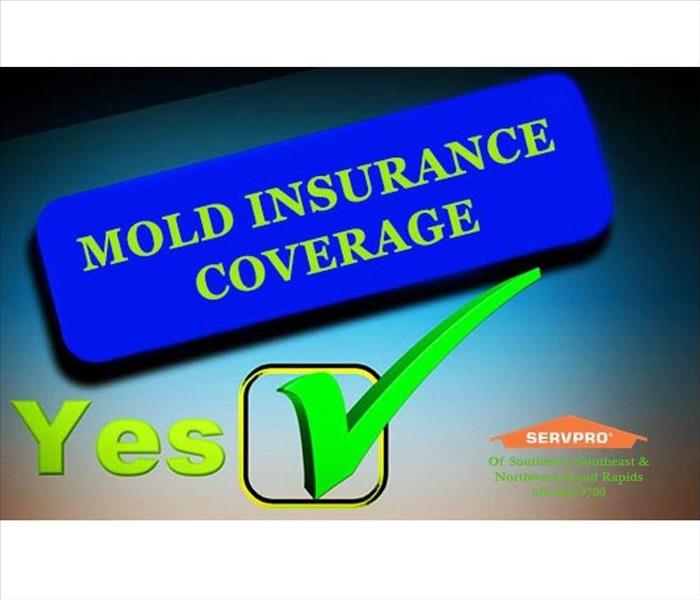 Check with your carrier and learn your options about Mold coverage.
Check with your carrier and learn your options about Mold coverage.
From the insurance perspective, damage from mold, like rust, rot and mildew is excluded from the typical homeowner’s policy.
The Insurance Information Institute says mold is covered under the homeowner’s policy, only if it is the result of a covered danger. For example, the costs of cleaning up mold caused by water from a burst pipe are covered. But mold that develops from, say, humidity or flooding is a maintenance issue that the property owner is responsible for.
The insurance industry argues that in order to keep homeowners insurance affordable and available to the masses this coverage wound up being excluded. If the policyholder does want mold coverage there is going to be an additional premium for it.
One thing to keep in mind is that there have been fewer claims recently. But critics say that is simply because insurers no longer cover the damage, so if it's not covered people do not put in claims.
SERVPRO® of Southwest Grand Rapids can mitigate and remediate the original damage, providing you with peace of mind while helping make it “Like it never even happened.” Call us today at 616-662-9700.
Southwest Grand Rapids, understand water types to ensure proper clean up
5/3/2018 (Permalink)
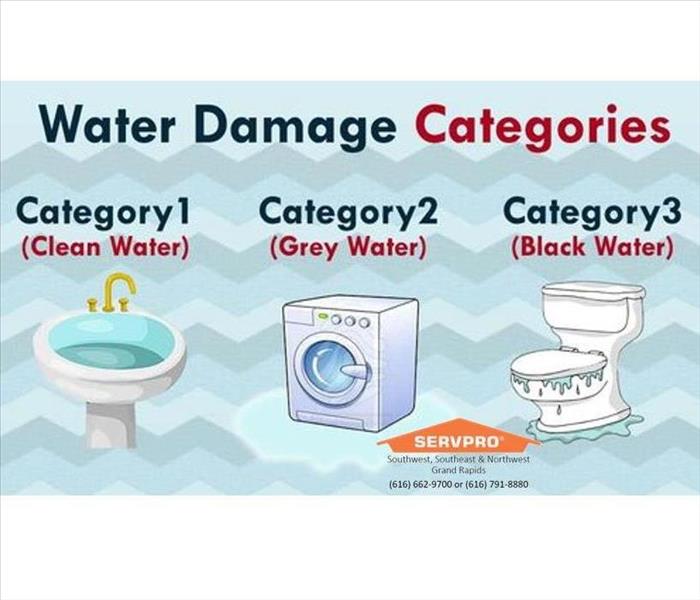 Different types of water loss determine how you should take personal precautions.
Different types of water loss determine how you should take personal precautions.
When your home or business suffers a water damage, understanding what type of water you are dealing with is critical to ensuring proper cleanup.
There are three types of water. Clean water is water from a broken pipe, or other water source; rainwater is also considered clean. The term gray water is used to classify slightly contaminated water. Clean water becomes gray water when it is left untreated allowing bacteria and other contaminants to begin growing, making the water hazardous. Black water is highly contaminate and filled with fungi, bacteria, chemicals and more. Black water is typically caused by sewage damage, flooding or any type of natural disaster. Black water should always be handled by trained professionals.
Consider taking the following precautions to help minimize damage or prevent further damage while waiting for help to arrive.
Damage from Clean Water
- Shut off the water source if possible or contact a qualified professional to do so.
- Turn off circuit breakers for wet areas of the building if access to the power distribution panel is safe from potential electrical shock. Do not enter rooms with standing water, as electrical shock hazards may exist.
- Remove as much excess water as possible by mopping and blotting. Wipe excess water from wood furniture after removing lamps and table top items.
- Remove and prop up wet upholstery cushions to allow more even drying.
- Move any paintings, art objects, computers, document sand other valuable items that may be sensitive to moisture to a safe place.
- Do not leave books, newspapers, magazines or other colored items on wet carpets or floors as they may cause staining.
- Do not use your household vacuum cleaner to remove water as there is potential for electrical shock or causing damage to the vacuum cleaner.
- Do not turn on ceiling fixtures if ceiling is wet; do not enter rooms where ceilings are sagging from retained water.
Damage from Contaminated Water
- Avoid all contact with sewage and items contaminated by sewage. Wash your hands thoroughly if you come in contact with contaminated items.
- Do not walk through contaminated areas, as you could spread damage to unaffected areas.
- Do not turn on the HVAC system if there is a possibility of spreading contaminated air.
- Discard any food and/or products for personal hygiene and cleanliness if exposed to the contaminated areas.
When you have a water damage, don’t leave your property to chance. Call SERVPRO® of Southwest Grand Rapids at 616-662-9700.
Proper Preparation Prevents Poor Performance
5/2/2018 (Permalink)
 Set your plan in action!
Set your plan in action!
How quickly your company can get back to business after a tornado, fire or flood often depends on the emergency planning done today. The regular occurrence of natural disasters demonstrates the importance of being prepared for any emergency. While each situation is unique, your organization can be better prepared if you plan carefully, put emergency procedures in place, and practice for all kinds of emergencies. The following are basic measures business owner and managers can take to begin preparing. A commitment to begin planning today will help support your employees, customers, the community, local economy, and even the country. It also protects your business investment and gives your company a better chance for survival. The following information is provided by ready.gov.
Develop a Business Continuity Plan
- Your organization’s risk needs will vary depending on the specific industry, size, scope and location.
- Begin by reviewing your business process flow char, if one exist, to identify operations critical to survival and recovery.
- Carefully assess your internal and external functions to determine which staff, materials, procedures and equipment are absolutely necessary to keep the business operating.
- You should also establish procedures for succession of management.
Review Insurance Coverage
- Inadequate insurance coverage can lead to major financial loss if your business is damaged, destroyed or simply interrupted for a period of time.
- Insurance policies vary; check with your agent or provider about things such as physical losses, flood coverage and business interruptions.
- Understand what your policy does and does not cover.
Prepare your Emergency Plan
- Your employees and co-workers are your business’ most valuable asset.
- Communication is essential before, during and after a disaster.
- Include emergency information in newsletters, on your company intranet, in periodic employee e-mails and/or other communication tools.
Practice the Emergency Plan
- Some disaster will require employees to leave the workplace quickly.
- The ability to evacuate works, customers and visitors effectively can save lives.
- If your business operates out of o more than one location, establish evacuation procedures for each individual building.
- If your company is in a high-rise building, an industrial park, or even a small strip mall, it is important to coordinate and practice with other tenants or businesses to avoid confusion and potential gridlock.
Secure your facility and Equipment
- Install fire extinguishers, smoke alarms and detectors in appropriate places.
- Secure all entry and exit points and plan for mail safety.
- Plan what you will do if your building, plant or store is not usable.
- Secure valuable equipment.
Improve Cyber Security
- Protecting your data and information systems may require specialized expertise, but even the smallest business can be better prepared.
- Use anti-virus software and keep it up-to-date.
- Don’t open e-mails from unknown sources.
- Use hard-to-guess passwords.
- Protect your computer from intruders by using firewalls.
- Back up your computer data and download security protection updates known as patches regularly.
SERVPRO® of Southwest Grand Rapids can help you prepare your Emergency READY Plan today! Call us at 616-662-9700.
No restoration need is too big for SERVPRO® of Southwest Grand Rapids
5/2/2018 (Permalink)
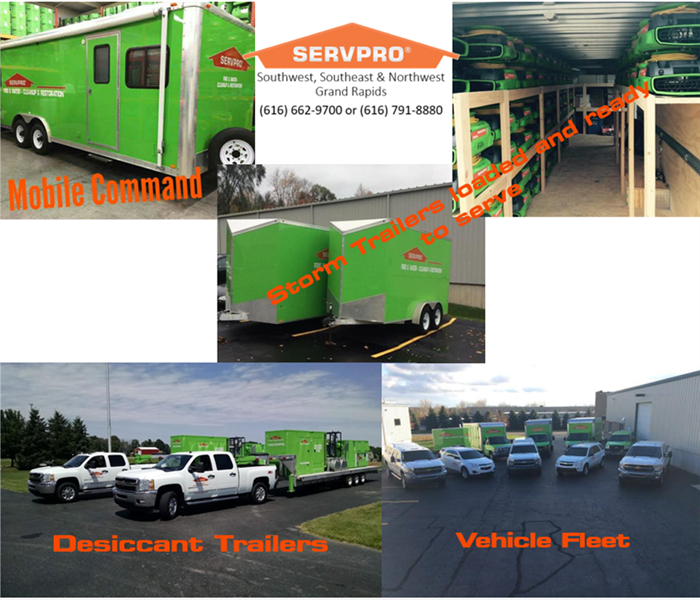 No loss is too big for our fleet handle.
No loss is too big for our fleet handle.
At SERVPRO® of Southwest Grand Rapids, no business is too big and no question is too small. So when fire or water damage strikes your home or business, call on the cleanup team the insurance industry has trusted for more than 40 years. That’s where you’ll find a team of specialist that’s faster to any-sized disaster. So when the things that matter most are on the line, make sure we are too by calling 616-662-9700 or visiting www.SERVPROpsouthwestgrandrapids.com. We’re here to help make Fire and Water damage “Like it never even happened.”
We are independently owned and operated with a team of 15 trained professionals. SERVPRO® of Southwest Grand Rapids is part of the nationwide Storm Response Team and has the support of over 1,700 franchises ready to serve your emergency needs.
Do you have an Emergency Communication Plan for when disaster strikes?
5/2/2018 (Permalink)
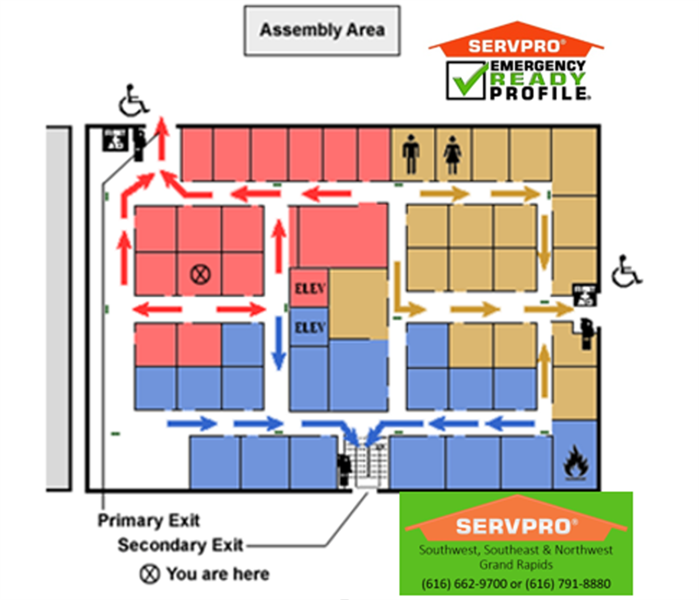 Is your plan in place?
Is your plan in place?
The following explains what an emergency communication plan is and why you should make one. It also provides tips and templates on how to make a plan. The following information is from ready.gov.
Your family may not be together if a disaster strikes, so it is important to think about the following situations and plan just in case. Consider the following questions when making a plan:
- How will my family/household get emergency alerts and warnings?
- How will my family/household get to safe locations for relevant emergencies?
- How will my family/household get in touch if cell phone, internet, or landline doesn’t work?
- How will I let loved ones know I am safe?
- How will family/household get to a meeting place after the emergency?
Here are a few easy steps to start your emergency communication plan:
- Understand how to receive emergency alerts and warnings. Make sure all household members are able to get alerts about an emergency from local officials. Check with your local emergency management agency to see what is available in your area, and learn more about alerts by visiting: ready.gov/alerts.
- Discuss family/household plans for disasters that may affect your area and plan where to go. Plan together in advance so that everyone in the household understands where to go during a different type of disaster like a hurricane, tornado, or wildfire.
- Collect information. Create a paper copy of the contact information for your family that includes:
- phone (work, cell, office)
- email
- social media
- medical facilities, doctors, service providers
- school
- Identify information and pick an emergency meeting place. Things to consider:
- Decide on safe, familiar places where your family can go for protection or to reunite.
- Make sure these locations are accessible for household members with disabilities or access and functional needs.
- If you have pets or service animals, think about animal-friendly locations.
Examples of meeting places:
- In your neighborhood: A mailbox at the end of the driveway, or a neighbor’s house.
- Outside of your neighborhood: library, community center, place of worship, or family friend’s home.
- Outside of your town or city: home of a relative or family friend. Make sure everyone knows the address of the meeting place and discuss ways you would get there.
- Share information. Make sure everyone carries a copy in his or her backpack, purse, or wallet. You should also post a copy in a central location in your home, such as your refrigerator or family bulletin board.
- Practice your plan.Have regular household meetings to review your emergency plans, communication plans and meeting place after a disaster, and then practice, just like you would a fire drill.
Source ready.gov
When disaster hits your property and you need restoration services due to Storm Damage, Call SERVPRO® of Southwest Grand Rapids at 616-662-9700 24/7 emergency services available.
Southwest Grand Rapids Get the facts on mold.
5/2/2018 (Permalink)
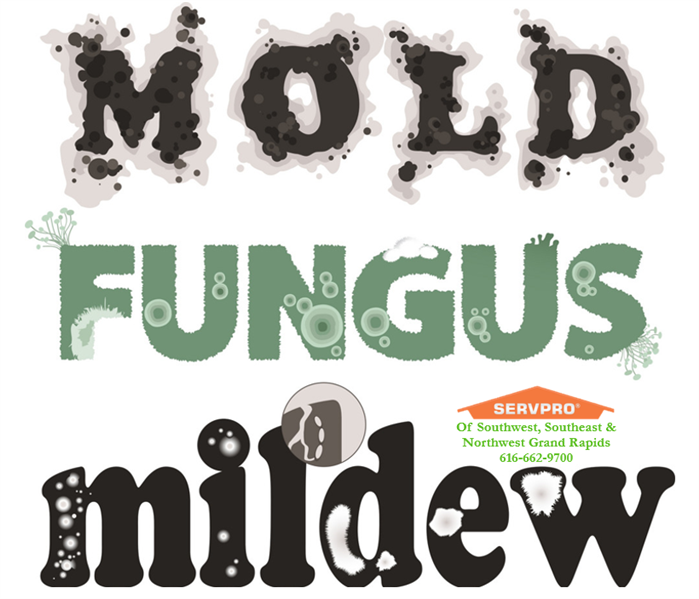 Mold is a fact of life, but there is bad mold. Know the facts!
Mold is a fact of life, but there is bad mold. Know the facts!
Mold is not a plant or an animal. It is a type of fungus and a fact of life. According to the Center for Disease Control (CDC), there is always a little mold everywhere and one cannot avoid being exposed to it. It grows year round and is found both inside and outside. Mold has existed for at least 400 million years and doesn't need much to grow. All it takes is moisture, warmth and food.
If you are concerned, make sure to check out areas in your home where humidity and moisture levels are high. This includes bathrooms, kitchens, basements, and in walls where water from leaky pipes can accumulate.
The National Association of Home Builders says that in just 48 hours, a moist environment combined with the right room-temperature conditions can lead to mold growth. While you cannot keep mold spores completely out of your home, regular cleaning can often prevent severe problems before they arise. Log onto the U.S. Environmental Protection Agency's Web site for more details at epa.gov.
SERVPRO® of Southwest Grand Rapids can mitigate and remediate the original damage, providing you with peace of mind while helping make it “Like it never even happened.” Call us today at 616-662-9700.
PLAN AHEAD Southwest Grand Rapids: May is Wildfire Community Preparedness Day
5/1/2018 (Permalink)
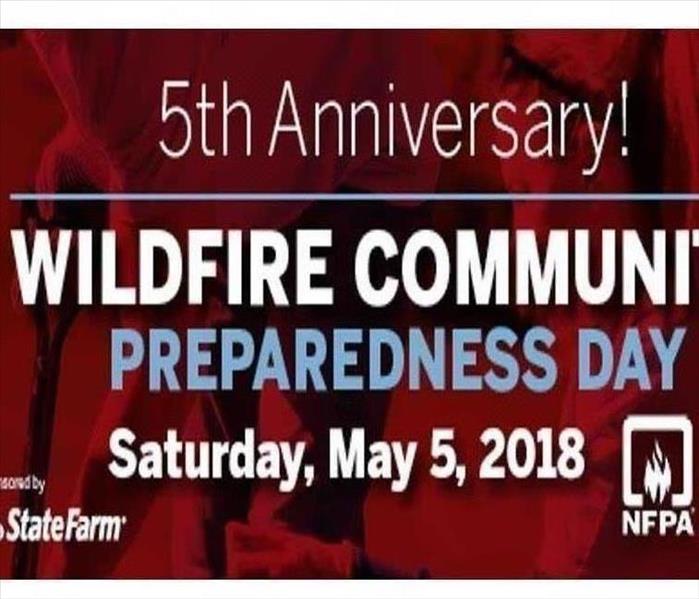 Wildfires happen! Join together to prevent with them.
Wildfires happen! Join together to prevent with them.
In 2017, there were 66,131 wildfires in the U.S., which burned 9.7 million acres, according to National Centers for Environment Information (NOAA).
Help reduce your community’s wildfire risk by participating in a local event for Wildfire Community Preparedness Day. To see a project map to locate local events, or for more information and resources to host your own event, visit wildfireprepday.org.
On Saturday, May 5, 2018 the NFPA celebrates national Wildfire Community Preparedness Day. At a time when wildfires are causing more damage to homes and businesses each year, Preparedness Day is a reminder that there are many things we can do to be prepared for wildfire. The event serves as means to inspire and encourage people of all ages to plan and participate in a risk reduction or wildfire preparedness activity that makes there community a safer place to live.
If a wildfire affects your home or business, contact SERVPRO® of Southwest Grand Rapids at 616-662-9700 today for 24-hour emergency service.
When you gather for dinner don't let fire ruin your supper
5/1/2018 (Permalink)
 When your following your favorite recipe to cook, follow this safety recipe as well. Stay SAFE!
When your following your favorite recipe to cook, follow this safety recipe as well. Stay SAFE!
Every year families gather to celebrate special occasions by preparing a delicious feast, but if you don’t practice safe cooking habits, your occasion could become hazardous very quickly. According to the National Fire Protection Association, cooking fires are the number one cause of home fires and home injuries. The leading cause of fires in the kitchen is unattended cooking. It is important to be alert to prevent cooking fires.
- Be on alert! If you are sleepy or have consumed alcohol don’t use the stove or stovetop.
- Stay in the kitchen while you are frying, grilling, boiling or broiling food.
- If you are simmering, baking or roasting food, check it regularly, remain in the kitchen while food is cooking, and use a timer to remind you that you are cooking.
- Keep anything that can catch fire—
- oven mitts
- wooden utensils
- food packaging
- towels or curtains—away from the stovetop.
If you have a cooking fire, consider the following safety protocols to help keep you and your family safe.
- Just get out! When you leave, close the door behind you to help contain the fire.
- Call 9-1-1 or the local emergency number after you leave.
- For an oven fire turn off the heat and keep the door closed.
- If you try to fight the fire, be sure others are getting out and you have a clear way out.
- Keep a lid nearby when you’re cooking to smother small grease fires. Smother the fire by sliding the lid over the pan and turn off the stovetop. Leave the pan covered until it is completely cooled.
SERVPRO® of Southwest Grand Rapids Professionals wish you a safe and happy family gathering.
Southwest Grand Rapids BBQ Hazards to avoid
5/1/2018 (Permalink)
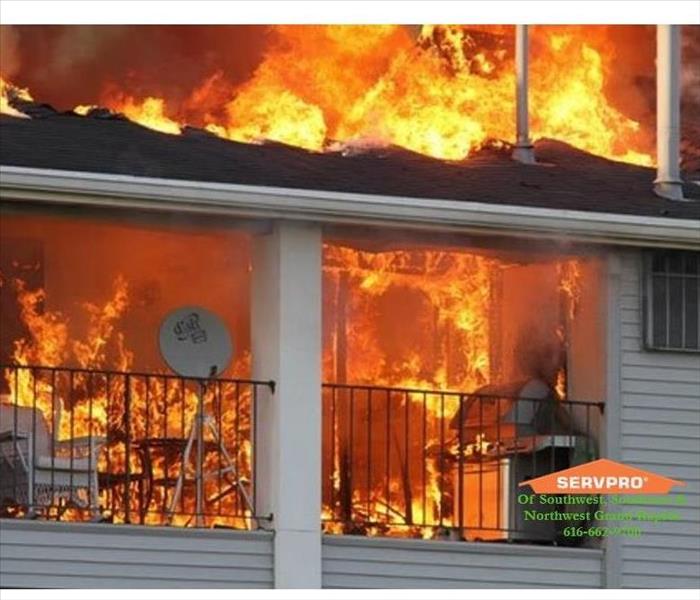 Keep your grill at least 10 feet from any structure.
Keep your grill at least 10 feet from any structure.
Summer is synonymous with barbecues, parades and fireworks displays; but along with all the festivities are plenty of visits to emergency rooms, especially during July. Each year, an average of 230 people are injured badly enough to require medical treatment after fireworks-related incidents, according to the U.S. Consumer
Product Safety Commission. In addition to causing injury, fireworks are also responsible for thousands of house fires each year with millions of dollars in property damage.
There is nothing like firing up the grill during the summer months! Did you know, July is the peak month for grill fires? A backyard barbecue can become dangerous if safety precautions aren’t considered. SERVPRO® of Southwest Grand Rapids want you to have an enjoyable and safe summer. Consider the following tips to ensure your summer celebrations are disaster-free!
- Propane and charcoal BBQ grills should only be used outdoors.
- The grill should be placed away from the home, deck railings and out from under eaves and overhanging branches.
- Keep children and pets away from grill area.
- Keep your grill clean by removing grease or fat buildup from the grills and in trays below the grill. Never leave your grill unattended.
- When using a charcoal grill, let the coals completely cool before disposing in a metal container.
- Anyone using fireworks or standing nearby should wear protective eyewear.
- Do not try to re-light or handle malfunctioning fireworks.
- Keep a bucket of water nearby to fully extinguish fireworks that don’t go off or in case of fire.
- Children should never pick up left over fireworks as they may still be active.
- The safest way to enjoy fireworks is to attend a public display conducted by trained professionals.
If you are affected by a fire contact SERVPRO® of Southwest Grand Rapids at 616-662-9700 for emergency services for your home or business.
MAY IS NATIONAL BUILDING SAFETY MONTH
5/1/2018 (Permalink)
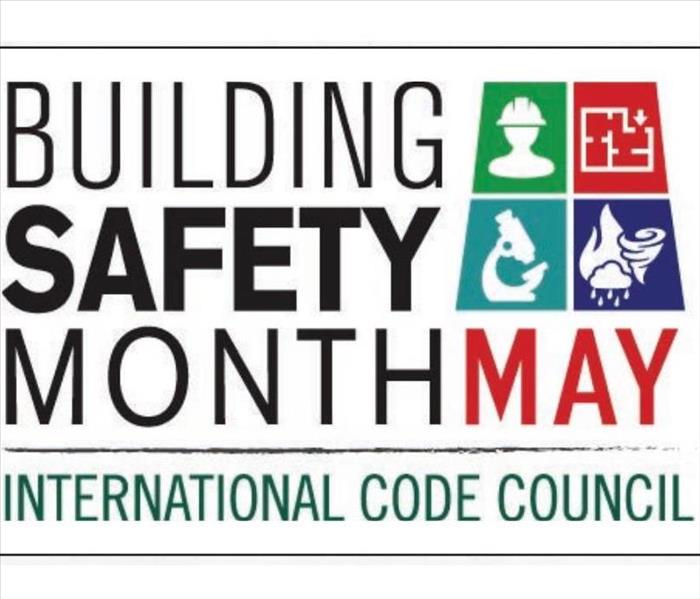 Building codes provide you, your family and your community protection in the event of a natural disaster.
Building codes provide you, your family and your community protection in the event of a natural disaster.
Building Safety Month, in its 38th year, is an initiative of the International Code Council (ICC) and their 64,000 members across the world, as well as their partners in building construction and design and the safety community. Building Safety Month is an opportunity to educate insurance and commercial property professionals, as well as the general public, on “what it takes to create safe, resilient, affordable, and energy efficient homes and buildings,” according to the ICC website.
The theme for 2018 is Building Codes Save Lives with a focus on safer communities over the five weeks in May.
One of the topics highlighted during the third week of the month is Protecting Communities from Disasters.
The general public may not be aware how codes and code officials “improve and protect the places where we live, learn, work, worship, and play,” and this month can certainly improve that awareness and educate communities on this topic!
IMPORTANT TIPS FROM THE ICC
Disaster Safety & Mitigation
- If you live in a high wind or hurricane-prone area and do not have tested and code-approved shutters for protection from windborne debris, consider temporarily protecting your doors and windows by mounting exterior grade, 7/16" minimum thickness plywood and fastening it into place. Visit www.flash.org for detailed instructions on how to use plywood for emergency board-up.
- Consider building or retrofitting to create a tornado-safe room in your home. Follow ICC/ NSSA 500 Standard for detailed construction information and to ensure you achieve the highest level of protection for your family.
- In wildfire prone areas, remove fine (dead grass, leaves, etc.) and coarse (dead twigs, branches, etc.) fuels within 30 feet of a building to create a survivable space in case of wildfire. Be sure to remove dry leaf and pine litter from roofs, rain gutters, decks, and walkways. Follow ICC’s International Wildland-Urban Interface Code® for detailed requirements.
- Flooded roads could have significant damage hidden by floodwaters. Never drive through floodwaters or on flooded roads. Do not attempt to cross a flowing stream. It takes only six inches of fast flowing water to sweep you off your feet and two feet of water to move an SUV-sized vehicle.
Source: iccsafe.org
If a disaster hits your home Contact SERVPRO® of Southwest Grand Rapids at 616-662-9700, available 24/7 for emergency services.
When Tornadoes cause damage to your Southwest Grand Rapids property
5/1/2018 (Permalink)
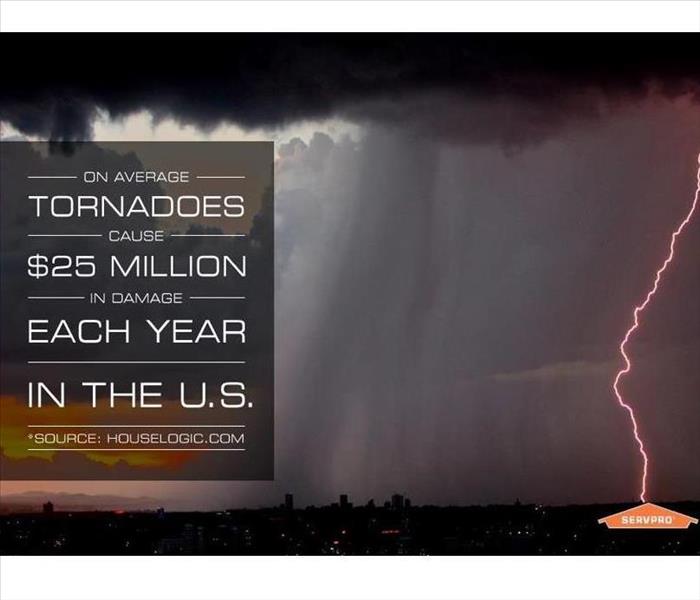 Tornadoes happen when we least expect them, do you know what to do when then occur?
Tornadoes happen when we least expect them, do you know what to do when then occur?
Tornadoes are nature’s most violent storms. Spawned from powerful thunderstorms, tornadoes can cause fatalities and devastate a neighborhood in seconds. A tornado appears as a rotating, funnel-shaped cloud that extends from a thunderstorm to the ground with whirling winds that can reach 300 miles per hour. Damage paths can be in excess of one mile wide and 50 miles long. Every state is at some risk from this hazard. Some tornadoes are clearly visible, while rain or nearby low-hanging clouds obscure others. Occasionally, tornadoes develop so rapidly that little, if any, advance warning is possible. Before a tornado hits, the wind may die down and the air may become very still. A cloud of debris can mark the location of a tornado even if a funnel is not visible. Tornadoes generally occur near the trailing edge of a thunderstorm. It is not uncommon to see clear, sunlit skies behind a tornado
After A Tornado
- Listen to local officials for updates and instructions.
- Check-in with family and friends by texting or using social media.
- Watch out for debris and downed power lines.
- If you are trapped, do not move about or kick up dust. Tap on a pipe or wall or use a whistle, if you have one, so that rescuers can locate you.
- Stay out of damaged buildings and homes until local authorities indicate it is safe.
- Photograph the damage to your property in order to assist in filing an insurance claim.
- Do what you can to prevent further damage to your property, (e.g., putting a tarp on a damaged roof), as insurance may not cover additional damage that occurs after the storm.
- If your home is without power, use flashlights or battery-powered lanterns rather than candles to prevent accidental fires.
Source ready.gov
If a Tornado should hit your property and you need restoration services due to Storm Damage, Call SERVPRO® of Southwest Grand Rapids at 616-662-9700 24/7 emergency services available.
Southwest Grand Rapids it’s the water you don’t see that causes the damage!
5/1/2018 (Permalink)
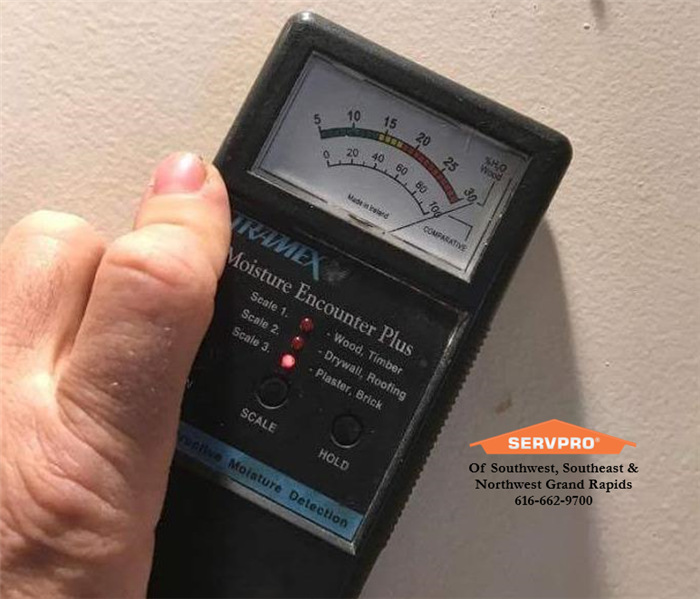 What's in your walls? Moisture in them can quickly lead to Mold.
What's in your walls? Moisture in them can quickly lead to Mold.
Even small water damages have the potential to cause serious structural and indoor air quality issues over time. The key to avoiding costly problems in the future is to handle every water damage as a threat to your property. SERVPRO® of Southwest Grand Rapids has the equipment, training and experience to find and dry unseen water before secondary damages occur. The proper equipment makes a measurable difference in reducing the damage expense during a fire or water loss. When time matters, technology and equipment must be counted on to perform.
SERVPRO® of Southwest Grand Rapids will answer your call with rapid action and a full arsenal of drying equipment. Here are a few of the tools used by SERVPRO® of Southwest Grand Rapids Professionals.
- Moisture Sensors are used to detect moisture in carpets, baseboards and walls.
- Moisture Meters are used to determine the actual moisture content of various materials. The moisture tester provides accurate readings, allowing our technicians to monitor the drying process.
- Thermohygrometers measure temperature and relative humidity.
When armed with this information, SERVPRO® of Southwest Grand Rapids can calculate and create an environment most conducive to drying. When facing a contaminated water loss, it is not only important to dry the structure, but the structure must also be disinfected and often deodorized.
- Ultra Low-Volume (ULV) Foggers will atomize liquid deodorizing agents, producing a fine mist that can easily penetrate the site where odor-causing residues may accumulate. This device can also be used to inject fungicides and disinfectants into wall cavities and other hard-to-reach areas.
- Thermal Foggers dispense solvent-based products by creating a dense fog. The fog consists of tiny particles of deodorant solution that attach to and neutralize odor-causing particles.
The bottom line? SERVPRO® of Southwest Grand Rapids has the training and equipment to help make it “Like it never even happened.” Contact us at 616-662-9700 today for 24-hour emergency service.
The Importance of Cleaning Dryer Vents to prevent fires
5/1/2018 (Permalink)
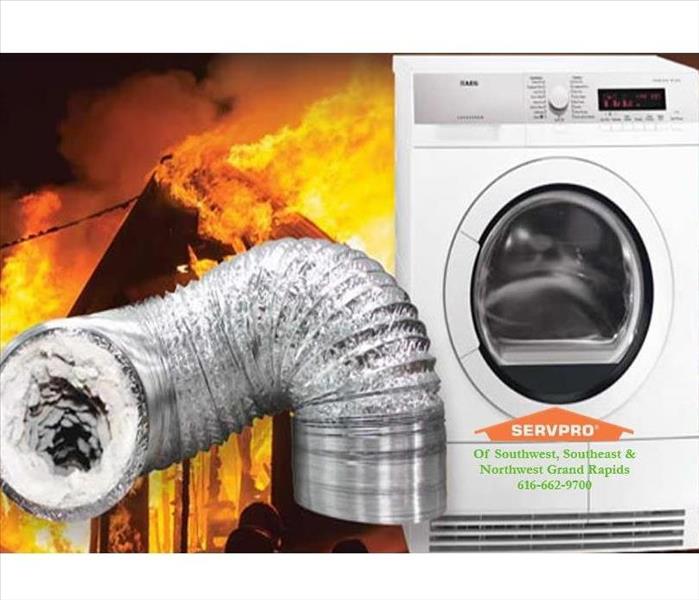 Don't let lint ruin your home!
Don't let lint ruin your home!
How often do you clean your dryer vent? Is this something you think about when you do your annual spring cleaning? Dryer lint is a great resource to save in a container to make fire starters for camping or outdoor fires. However it can wreak havoc in your home if you leave it in your dryer.
According to FEMA, failure to clean home dryers causes 34% of home dryer fires. Home dryer fires cause $35 million in property loss and can even cause injury or death.
To reduce the risk of these fires happening in your or your insured’s home or business ensure the following:
- Clean your Lint filter after every use
- Vacuum out the vent hose from the dryer
- Keep debris clear from around and under the dryer
- Keep vent flap clear of obstructions (such as: piled up lent, snow, a bird’s nest and potential obstacles)
For more information on cleaning dryer vents contact SERVPRO® of Southwest Grand Rapids at 616-662-9700 today.
Destroy Odors with DEODORIZATION in Southwest Grand Rapids
5/1/2018 (Permalink)
 Let the professionals remove the odor from your home! We know how to attack source.
Let the professionals remove the odor from your home! We know how to attack source.
Even a small fire can cause odors for years to come if the affected areas are not properly cleaned and deodorized. Fire, smoke and soot damage in your home or business can create unpleasant and potentially permanent problems.
Other odors that may require deodorization:
- Cigarette Smoke
- Pet Odors
- Decomposition
- Mold
As various materials burn, the smoke produced travels throughout the structure, leaving odorous residues and deposits on surfaces and in hard-to-reach places. Unless fast, professional action is taken, these residues and deposits can cause permanent damage to contents and may result in resurfacing odors.
With technicians certified by the Institute of Inspection, Cleaning and Restoration (IICRC), SERVPRO® of Southwest Grand Rapids provides specialized services that can rid your home or business of offensive odors left by fire or smoke damage. Our technicians do not cover up lingering odors with a fragrance; they seek out and remove the sources of the odor. Once the source is found, SERVPRO® own proprietary line of cleaning products is used to treat and prevent the odor from returning. Any restorable item in affected areas will also be professionally cleaned and deodorized, including furniture, draperies and upholstery, electronics, art, flooring, walls, ceilings, HVAC air ducts, and more.
Our trained professional will explain the various deodorization methods available and which will work best for you.
If you or a neighbor suffer a fire damage or some other accident and require deodorization services, contact SERVPRO® of Southwest Grand Rapids at 616-662-9700 today for 24-hour service. Whether it’s fire, water, or mold damage, or just a stubborn odor that refuses to go away, we’ll help make it “Like it never even happened.”
No time like the present to Plan for disaster Southwest Grand Rapids
4/30/2018 (Permalink)
 Being prepared can save thousands of dollars in Restoration and Mitigation cost.
Being prepared can save thousands of dollars in Restoration and Mitigation cost.
No one ever plans on a disaster, but now, you can prepare for it. The SERVPRO® Emergency READY Profile (ERP) will help ensure you are “Ready for whatever happens.”
In the event of an emergency, the ERP can help minimize business interruptions by having and immediate plan of action in place for your facility. The ERP is a comprehensive document containing critical information about your business, including emergency contacts, shut-off valve locations and priority areas. The ERP also establishes SERVPRO® of Southwest Grand Rapids as your disaster mitigation and restoration provider, giving you access to over 45 years of experience and a System more than 1,700 franchises strong. The ERP is a no-cost assessment; all it requires is little time, making it a great value that could save you time and money in the future. By downloading the free SERVPRO® READY App, this information is stored electronically and can be accessed using your mobile device making help just a few clicks away.
Preparation is the key to making it through any size disaster, whether it is a mall water leak, a large fire or an area flood. Having a plan in place may help minimize the amount of time your business is inactive and get you back in the building following a disaster. Don’t wait until disaster strikes. Call SERVPRO® of Southwest Grand Rapids at 616-662-9700 to establish your Emergency READY Profile, and be “Ready for whatever happens.”
Advantages of the SERVPRO Emergency READY Profile
- A no-cost assessment of your facility.
- A concise profile document containing only the ciriti9cal information needed in the event of an emergency.
- A guide to help you get back into your building following a disaster.
- Establishes SERVPRO® of Southwest Grand Rapids as your disaster mitigation and restoration provider.
- Identification of the line of command for authorizing work to begin.
- Provides facility details such as shut-off valve locations, priority areas and priority contact information.
Contact us today at 616-662-9700 to schedule your no-cost assessment!
BIOHAZARD, CRIME SCENE, AND VANDALISM CLEANUP
4/29/2018 (Permalink)
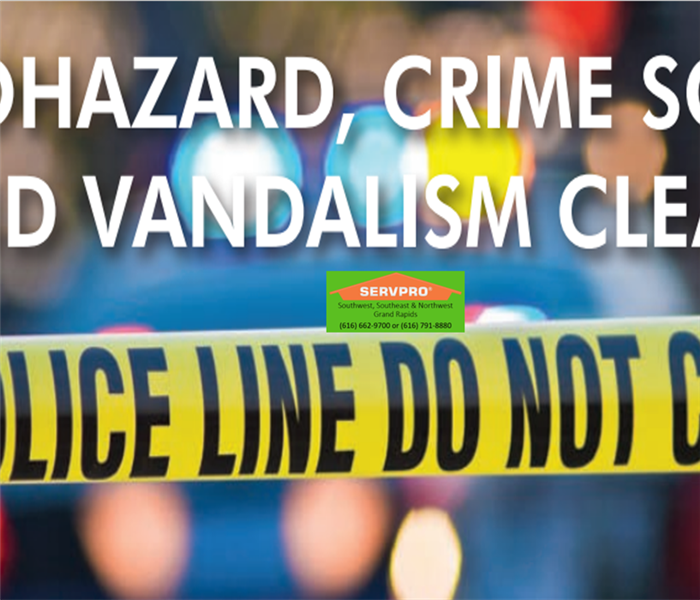 SERVPRO® of Southwest Grand Rapids help turn unsafe environments into clean, safe homes and offices.
SERVPRO® of Southwest Grand Rapids help turn unsafe environments into clean, safe homes and offices.
Recognized as a leading fire and water cleanup and restoration provider by hundreds of insurance companies, SERVPRO® of Southwest Grand Rapids Professionals also offer fast, reliable biohazard and crime scene cleanup and restoration services to residential and commercial property owners.
Exposure to biological and chemical contaminants can pose serious health consequences for building occupants, employees, customers, and owners. A failure to properly handle and safely remove such hazardous substances can contribute to unhealthy and even dangerous environments.
SERVPRO® of Southwest Grand Rapids Professionals are trained to safely and effectively remove bio hazardous substances and prepare waste for proper disposal according to OSHA, EPA, and state and local health regulations.
Equipped with the necessary safety equipment and cleaning products, SERVPRO® Professionals help turn unsafe environments into clean, safe homes and offices.
SERVPRO® of Southwest Grand Rapids can help with the following issues:
- Blood borne Pathogens
- Methamphetamine Labs
- Crime Scene Residues
- Arson n Vandalism
- Sewage Backups
- Black Water Intrusions
- Mold Mitigation and Remediation
State and local regulations vary. Contact SERVPRO® of Southwest Grand Rapids at 616-662-9700 today for 24-hour emergency service.
Southwest Grand Rapids, Who can clean up Mold?
4/26/2018 (Permalink)
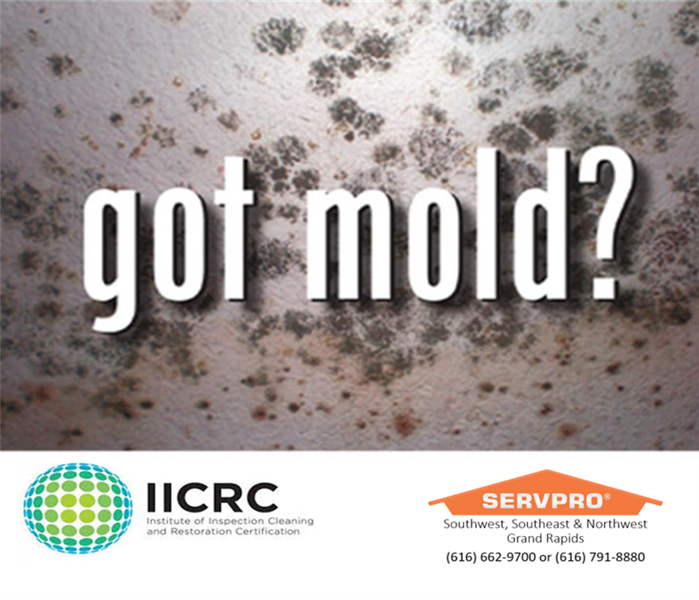 We are trained and certified to mitigate mold.
We are trained and certified to mitigate mold.
If you have mold, determining who should clean it up depends on several factors.
One consideration is the size of the mold problem. A little bit of mold in your shower is nothing to worry about. Frequent maintenance with bleach and water can do the trick. If the mold problem covers less than 10 square feet, chances are you can handle the cleanup yourself.
When handling or cleaning moldy materials wear gloves, goggles, and dress in long sleeves. If you want to limit your exposure to mold, you may want to consider wearing a respirator. They are available at many hardware stores for about $12 to $50. Also make sure the room is properly ventilated. Open a window, and get some fresh air.
If the problem extends beyond 10 square feet, consult the EPA's guide: Mold Remediation in Schools and Commercial Buildings. Although it focuses on larger buildings, the advice applies to other areas as well. For a free copy call 1-800-438-4318.
If you are developing a more severe mold problem you will most likely not only be able to see it, but also smell it. Have you ever walked into a room with a musty odor? Chances are you smell mold. Keep in mind, sometimes you will not be able to see the mold because it may be hidden on the back of the wallpaper, tile, drywall or even underneath the carpet.
If you detect mold on the surface or on some of your items, the items may be discolored or looked smudged and blotched. When hiring a professional to do the cleanup, make certain you are dealing with someone who is trained in this type of cleanup.
You'll want to be very careful when hiring someone to do the job. SERVPRO® of Southwest Grand Rapids is trained in Mold mitigation, with 25 years of experience. Don’t get stuck with an inexperienced remediator who ends up botching the job. And remediation can be very costly, ranging from a couple of hundred dollars to more than $100,000. Also make sure to check references and a company's complaint record with the Better Business Bureau.
One other point: non-porous items such as glass and hard plastics that are still in good condition after the mold has been removed can be reused after a thorough cleaning. But items such as carpeting, clothing and insulation should be thrown out.
SERVPRO® of Southwest Grand Rapids can mitigate and remediate the original damage, providing you with peace of mind while helping make it “Like it never even happened.” Call us today at 616-662-9700.
It only takes 1 to 2 inches of water to begin damage to your Southwest Grand Rapids property
4/26/2018 (Permalink)
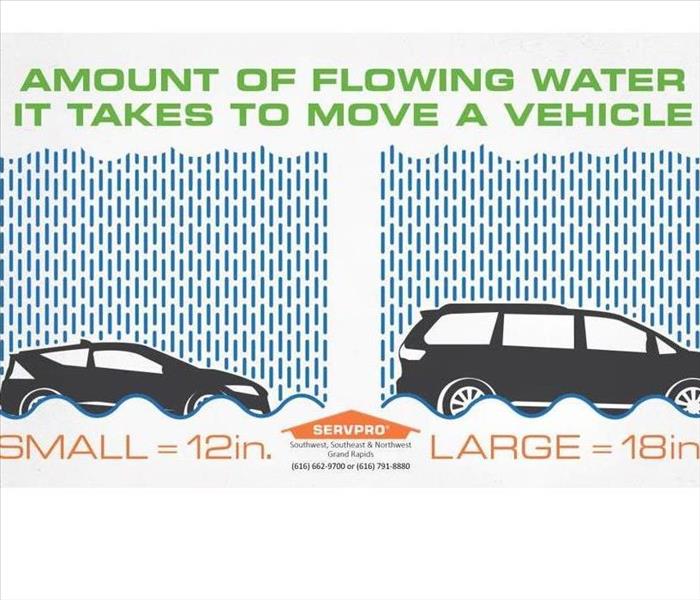 If water can move a car, imagine what it can do to your home!
If water can move a car, imagine what it can do to your home!
Image its 8:00 p.m. on a Sunday, and you walk into your home after a relaxing vacation expecting to switch on the lights, put the kids to bed then get some rest yourself.
The only problem? A water pipe burst over the weekend, dumping thousands of gallons of water over your hardwood kitchen floor, your carpeted living room and your cement utility room. You realize this problem is far beyond the reach of your shop vac. What do you do now?
When it is your home or business that is underwater, mitigation cannot wait. You need mitigation to begin immediately. If water damage strikes you or your neighbor give SERVPRO® of Southwest Grand Rapids a call at 616-662-9700 any time, any day.
The cost of water damages can increase exponentially with time. Wood Floors warp, dry wall soaks in moisture and mold develops in hard-to-reach areas of your home or business.
The benefit of rapid mitigation offer by SERVPRO® of Southwest Grand Rapids are two-fold: Your costs go down as potential hazards may be avoided, and your peace of mind goes through the roof.
If the unthinkable happens to your home or business, allow SERVPRO® of Southwest Grand Rapids to help quickly turn your “before” into a “happily ever after.”
Southwest Grand Rapids Leave the Hassle of Board-Ups to the Professionals
4/26/2018 (Permalink)
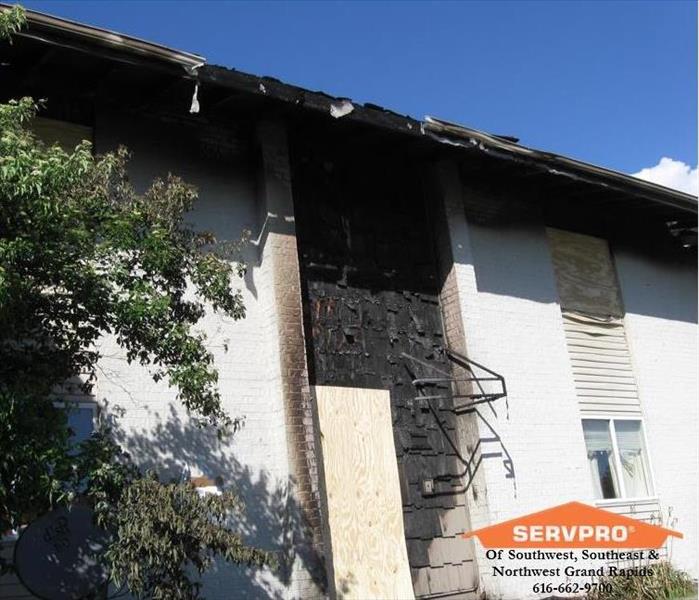 Let us do the work!
Let us do the work!
Why take the risk? Call SERVPRO® of Southwest Grand Rapids.
Whether after a fire, storm, or other structural disaster, boarding up damaged property is a burden that no one should ever have to go through—especially if it is your property that has been damaged.
Boarding up damaged property incorrectly could cause secondary damages such as moisture or animal intrusion, making the situation even worse. The process of boarding up after an unexpected damage can also be as dangerous as the damage itself.
SERVPRO® of Southwest Grand Rapids can board up the damaged property and mitigate and remediate the original damage, providing you with peace of mind while helping make it
“Like it never even happened.” Contact us at 616-662-9700 for 24/7 emergency service.
How to prepare for a Thunderstorm in Southwest Grand Rapids
4/26/2018 (Permalink)
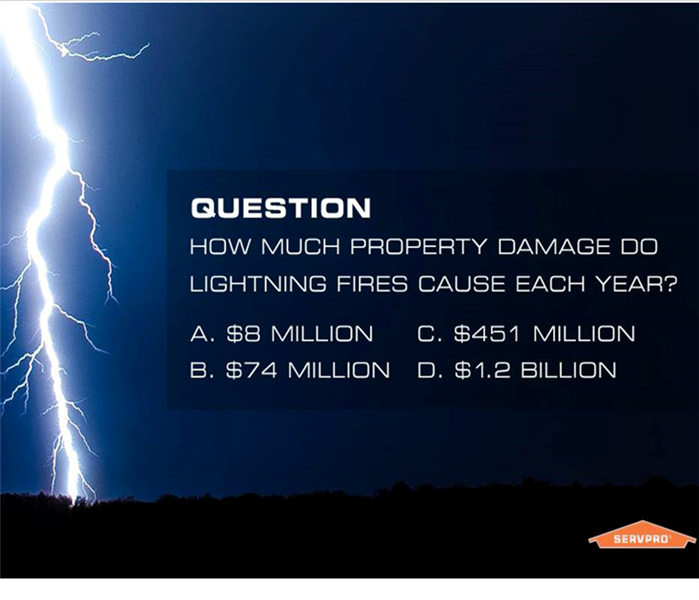 Lightning Fires cause about $451 Million in property damage each year.
Lightning Fires cause about $451 Million in property damage each year.
Southwest Grand Rapids, Is your family prepared for a Thunderstorm?
To prepare for a thunderstorm, you should do the following:
- To begin preparing, you should build an emergency kit and make a family communications plan.
- Remove dead or rotting trees and branches that could fall and cause injury or damage during a severe thunderstorm.
- Postpone outdoor activities.
- Secure outdoor objects that could blow away or cause damage.
- Get inside a home, building, or hard top automobile (not a convertible). Although you may be injured if lightning strikes your car, you are much safer inside a vehicle than outside.
- Remember, rubber-soled shoes and rubber tires provide NO protection from lightning. However, the steel frame of a hard-topped vehicle provides increased protection if you are not touching metal.
- Shutter windows and secure outside doors. If shutters are not available, close window blinds, shades or curtains.
- Unplug any electronic equipment well before the storm arrives.
Lightning Risk Reduction When Outdoors
If you are: In a forest
Then: Seek shelter in a low area under a thick growth of small trees.
If you are: In an open area
Then: Go to a low place such as a ravine or valley. Be alert for flash floods.
If you are: On open water
Then: Get to land and find shelter immediately.
Facts about Thunderstorms
- They may occur singly, in clusters or in lines.
- Some of the most severe occur when a single thunderstorm affects one location for an extended time.
- Thunderstorms typically produce heavy rain for a brief period, anywhere from 30 minutes to an hour.
- Warm, humid conditions are highly favorable for thunderstorm development.
- About 10 percent of thunderstorms are classified as severe – one that produces hail at least an inch or larger in diameter, has winds of 58 miles per hour or higher or produces a tornado.
Facts about Lightning
- Lightning’s unpredictability increases the risk to individuals and property.
- Lightning often strikes outside of heavy rain and may occur as far as 10 miles away from any rainfall.
- “Heat lightning” is actually lightning from a thunderstorm too far away from thunder to be heard. However, the storm may be moving in your direction.
- Most lightning deaths and injuries occur when people are caught outdoors in the summer months during the afternoon and evening.
- Your chances of being struck by lightning are estimated to be 1 in 600,000 but could be reduced even further by following safety precautions.
- Lightning strike victims carry no electrical charge and should be attended to immediately.
Know the Terms
Familiarize yourself with these terms to help identify a thunderstorm hazard:
Severe Thunderstorm Watch- Tells you when and where severe thunderstorms are likely to occur. Watch the sky and stay tuned to NOAA Weather Radio, commercial radio or television for information.
Severe Thunderstorm Warning- Issued when severe weather has been reported by spotters or indicated by radar. Warnings indicate imminent danger to life and property to those in the path of the storm.
Source ready.gov
If a Thunderstorm should hit your property and you need restoration services due to Storm Damage, Call SERVPRO® of Southwest Grand Rapids at 616-662-9700 24/7 emergency services available.
Southwest Grand Rapids, FLOODING CAN HAPPEN ANYWHERE
4/25/2018 (Permalink)
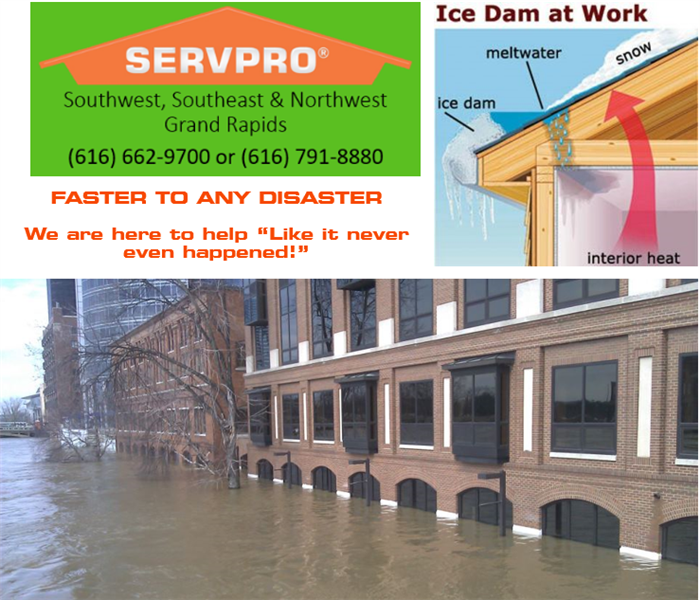 Flooding can happen anywhere. Are you prepared?
Flooding can happen anywhere. Are you prepared?
According the National Weather Service (NOAA), “Approximately 75% of all Presidential disaster declarations are associated with flooding.” NOAA lists the most common flood hazards in the United Sates as:
- Flash Flooding
- River Flooding
- Strom Surge and Coastal Inundation from Tropical and Non-Tropical Systems
- Burns Scars/Debris Flows (Caused by wildfires)
- Ice/Debris jams
- Snowmelt
- Dry Wash (Caused by heavy rainfall in dry areas)
- Dam Breaks/Levee Failure
Just because you haven’t experienced a flood doesn’t mean you won’t in the future. In fact, 20% of all claims paid by the National Flood Insurance Program (NFIP) were for policies in low-risk communities. ON average, floods cost $3.5 billion in annual losses in the U.S., and commercial flood claims average more than $75,000 (NFIP).
When catastrophic storm water damage happens to your commercial property, SERVPRO® of Southwest Grand Rapids can Help. We help you prepare ahead of time with and Emergency Ready Profile (ERP), or respond to any size disaster to begin clean up and restoration to get you back in business as soon as possible.
SERVPRO® of Southwest Grand Rapids is ready to help make it “Like it never even happened.” Contact us at 616-662-9700.
Smoke Alarms
3/30/2018 (Permalink)
 Test every month, change battery every year and replace every 10 years.
Test every month, change battery every year and replace every 10 years.
Smoke alarms save lives when properly installed and maintained, according to the National Fire Protection Association (NFPA).
In homes, smoke alarms should be in every bedroom, outside each sleeping area, and on every level, including the basement. Extra smoke alarms may be needed in large homes.
Test smoke alarms monthly using the test button. Smoke alarms with non-replaceable batteries need the entire smoke alarm unit replaced every ten years. Other alarms need batteries replaced every year, and the unit replaced every ten years. If the alarm chirps signaling low battery, take the proper steps to replace the unit or the batteries immediately. Never disable or remove the battery from an alarm. Almost half of fires where smoke alarms were present but did not activate had missing or disconnected batteries (NFPA).
If you need help installing, testing or changing batteries in your smoke alarms, contact your local fire department, an electrician or the American Red Cross.
Be sure your home has a fire emergency plan in place and conduct regular fire drills with your family. For more information on Emergency Preparedness, contact SERVPRO® of Southwest Grand Rapids Professional at 616-662-9700.
FIRE FACTS
* 7 People die every day from a home fire.
* 36 People suffer injuries as a result of home fires every day.
* $7 BILLION in property damage occurs every year.
We Specialize in Flooded Basement Cleanup and Restoration!
3/30/2018 (Permalink)
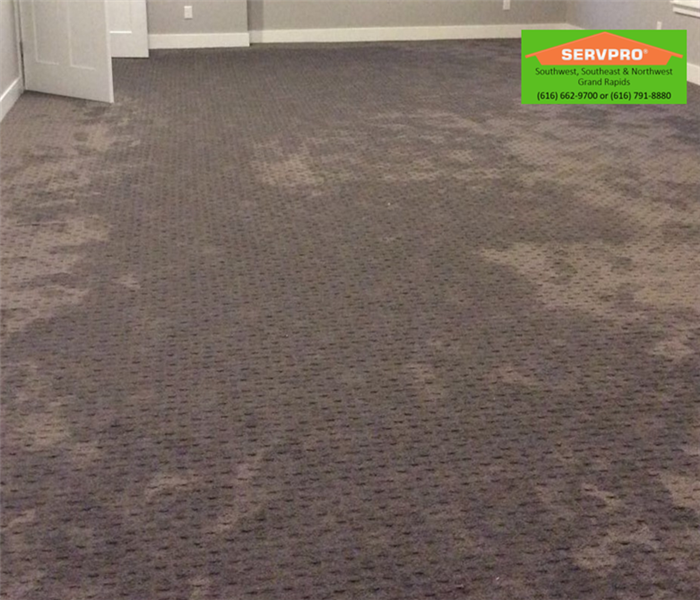 Frozen water line burst in the wall of this Southwest Grand Rapids home.
Frozen water line burst in the wall of this Southwest Grand Rapids home.
A basement can flood at any time, although flooding most often occurs during heavy rainfall. Basements are inherently prone to flooding because they are the lowest level of a building and are normally built partly or entirely below ground level. There are a number of reasons why your Grand Rapids basement could flood, including:
- A blocked or failed sewer lateral pipe
- Heavy rain causes surface water to pool around your home
- Foundation drainage failure
- Water supply-line break or hot-water tank failure
Customer Testimonial - Joyce G "Our basement flooded due to septic pump failure and SERVPRO of SW, SE, NW Grand Rapids responded to my call with-in 15 minutes with a team of Professionally Trained technicians. Their handled all of our furniture and belonging’s with extreme care. It was a real blessing to have them in my home to relieve the stress of the situation and to have all everything cleaned out beyond my expectations."
Have Questions about Basement Flooding?
Call Today - 616-662-9700
If flood water is not handled quickly and properly, it can jeopardize your health and safety, and cause severe damage to your home’s structure. Remember, the longer you wait, the worse the problem will get.
The bottom line: a flooded basement can jeopardize your health, safety, and your home’s integrity. It’s worth making a call to SERVPRO of Southwest Grand Rapids and let our trained, professional crews handle the situation safely and correctly. We have earned the trust of hundreds of homeowners, business owners, and property professionals.
We are Flooded Basement Specialists:
- We are Available 24 hours/7 days per week
- We’re a Preferred Vendor to many National Insurance Companies
- We Bill The Insurance Directly – One Less Thing For You To Worry About
- Our Technicians are Highly-Trained in Water Restoration Techniques
- We use s500 IICRC Restoration Standards
- Advanced Inspection and Extraction Equipment
Restoring Your Southwest Grand Rapids area Commercial Property After A Water Damage Event
3/30/2018 (Permalink)
 We are #heretohelp!
We are #heretohelp!
Flooding and water damage events at Grand Rapid’s commercial properties are often complex with numerous issues that require a knowledgeable and flexible response. Whether we’re dealing with a relatively small water cleanup scenario or a large scale event, we work quickly to assess each unique situation and isolate the damaged area. In many instances, normal operations can continue in a temporary space while we restore your facility.
Restoring Commercial Properties Presents Unique Challenges
Our professionals are trained to be mindful of legal and environmental concerns and strive to fully restore the damaged area while working within your budgetary constraints. We understand that every hour spent cleaning up is an hour of lost revenue and productivity. So when an emergency situation arises in your business, give us a call and we’ll be there fast with the help you need.
About SERVPRO of Southwest Grand Rapids
SERVPRO of Southwest Grand Rapids specializes in the cleanup and restoration of commercial and residential property after a water damage event. Our staff is highly trained in property damage restoration. From initial and ongoing training at SERVPRO’s corporate training facility to regular IICRC-industry certification, rest assured our staff is equipped with the knowledge to restore your property.
Sump Pump Failure during storm
3/30/2018 (Permalink)
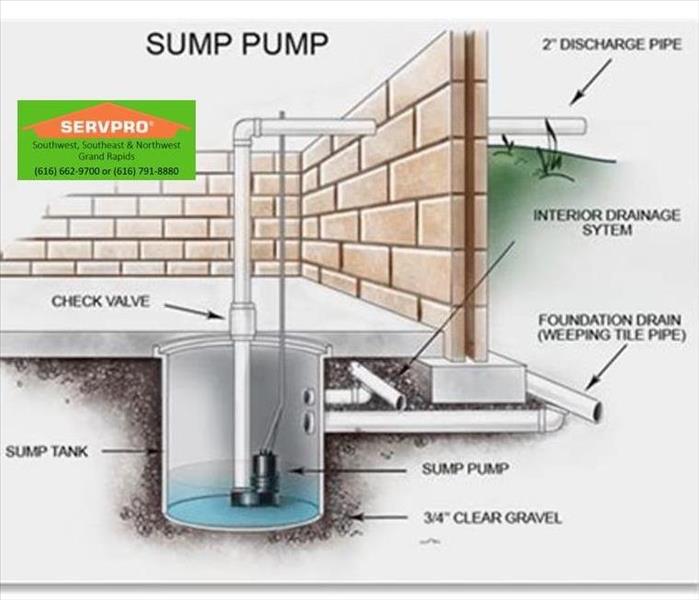 How to a sump pump works
How to a sump pump works
When the ground is dry and then gets an influx of water to saturate the ground, where does the water go? Once the water has flooded the surrounding grounds, the water searches for the weakest point to enter any hard surfaces. Many times that is your basement floor. Which is why we have sump pumps.
How it works - A hole is dug in the lowest part of your basement or crawlspace where a sump pump sits and filters out water. As the pit fills up, the pump turns on and moves the liquid out of the pit through pipes that run away from the foundation of your home into an area where it can drain, such as a municipal storm drain or a dry well. A one-way valve (check valve) keeps water from entering back into the home.
Why does it fail?
- Power Failure
- Pump is the wrong Size
- Improper Installation
- Switch Problems on the pump
- Lack of Maintenance
- Frozen or Clogged Discharge Lines
- Product Default
- Passed Life Expectancy
How can you prevent failure? Quarterly maintenance.
When there’s an influx of ground water or your power goes out, keep an eye on your pump to make sure you don’t become a victim of a flooded area in your home.
Another important point is the sump pump's power supply. The fact that sump pumps rely on electricity to operate does make them vulnerable in the event of a power outage. Fortunately, there are backup options available. For some people, at least those on municipal water systems -- and assuming the city water system is still functional -- water-powered sump pumps that don't need any electricity are an option. These pumps literally use the pressure of flowing water to pump water out of the sump. The downside to this design is that the pumping process uses virtually the same amount of city water as the quantity of water it pumps out. So, while water-powered pumps aren't necessarily a good choice for a main pump, they offer a viable option for a short duration backup pump.
SERVPRO® of Southwest Grand Rapids is here to help. We are available 24/7 for emergency services. Call us at 616-662-9700
Insert pic Sump pump C:\Users\Sales1\Documents\Sales\Web stages\Blog Pics
Mold clean-up process
3/30/2018 (Permalink)
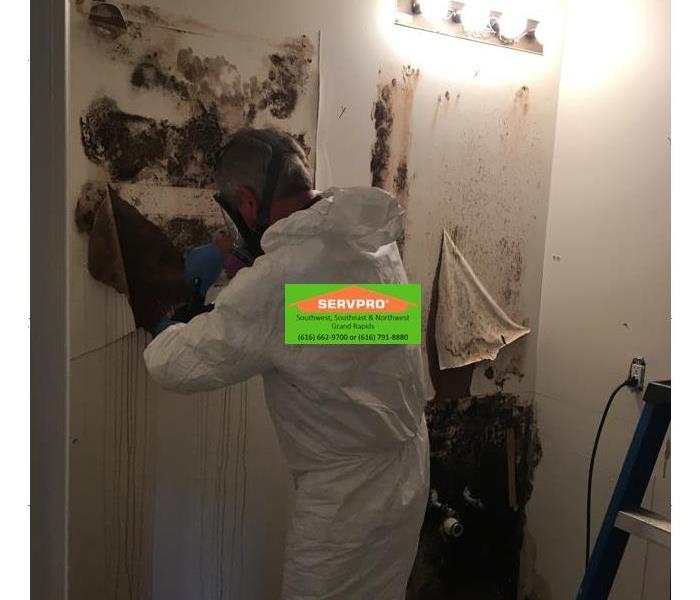 Mold likes to hide, let us take it away!
Mold likes to hide, let us take it away!
When there’s a water intrusion, mold can quickly become a problem in your home or business. Mold can affect your health and can also cause significant damage to your property. Fortunately, SERVPRO® of Southwest Grand Rapids Professionals have the training, protective gear, and specialized equipment necessary to handle your mold problem. Although every mold damage scenario is different, requiring a unique solution, the general mold remediation process stays the same. The following steps illustrate a “typical” mold removal process.
Call Your Local SERVPRO® Franchise Professionals
The mold cleanup and restoration process begins when you call SERVPRO® of Southwest Grand Rapids. A representative will ask a series of questions to help determine the necessary equipment, resources, and personnel needed.
Inspection & Damage Assessment
Your property will be carefully inspected for signs of mold using technology designed to detect mold and hidden water sources. Mold feeds on cellulose and water which can be hidden from plain view.
Mold Containment
Various containment procedures will be placed to prevent the spread of mold and isolate the contaminated area with physical barriers and negative air pressure to keep the mold spores from spreading during the cleanup process.
Air Filtration
Specialized filtration equipment captures microscopic mold spores out of the air. SERVPRO® technicians utilize powerful air scrubbers and HEPA vacuums to prevent the spread of these mold spores while the mold remediation is in progress.
Removing Mold & Mold-Infested Materials
The mold remediation process depends on the amount of mold growth and the types of surfaces on which the mold appears. Antifungal and antimicrobial treatments will be used to eliminate mold colonies and help prevent new colonies from forming. Removing and disposing of mold-infested porous materials, like drywall and flooring, may be necessary to remediate heavy mold growth.
Cleaning Contents & Belongings
SERVPRO® Franchise Professionals clean your furniture, decorative items, curtains, and other restorable items affected by mold. They use a variety of cleaning techniques to clean and sanitize your belongings. They are also trained to remove odors and deodorize using fogging equipment.
Restoration
Depending on the level of mold damage, drywall, subfloors, and other building materials may be removed. Restoration may involve minor repairs, such as replacing drywall, painting, and installing new carpet, or it may entail major repairs such as the reconstruction of various areas or rooms in a home or business.
SERVPRO® of Southwest Grand Rapids understand mold and mold growth and have the training and equipment to remediate mold in your home or business. Call us at 616-662-9700, were here to help with your mold mitigation.
Water damage prevention tips
3/5/2018 (Permalink)
 Decluttered and Organized spaces is a great way to protect your contents when water damage occurs at your home.
Decluttered and Organized spaces is a great way to protect your contents when water damage occurs at your home.
Water damage to your property is a very devastating experience. It gets into the tinniest of spaces and travels like a winding stream. That is because water has found the weak spot in any material and followed it. Have you ever had a sump pump fail or a busted water pipe? You unknowingly step in water and wonder where in the world is this coming from?
As you follow the water trail, you notice contents in your home are wet. It’s no big deal just the outside of the box is wet, Right? Keep following the water trail and now you know you have a bigger problem. Your entire floor is covered with water!
First things first – stop or turn off the water source, wither it be a water line or the sump pump. Turn off the main water line or just the affected portion to fix the pipe. Replace or fix the sump pump is that is the culprit. Either call a plumber or fix it yourself. Big thing is to stop the source of the leak to prevent more water damage.
Second call SERVPRO of Southwest Grand Rapids to extract the water and dry out your home.
But what about all your contents that got damaged? How can you protect your personal belongings from being ruined by water? Here are a few suggestions:
- Invest in Plastic totes with lids to store items instead of cardboard.
- Annual declutter clean. Take time each year to go through your items and use the Keep, Donate or Trash pile system. If it’s broke, trash it. If you have used in the last year and foresee usage in the next year keep it. If it doesn’t fit, haven’t used in the last year or more, donate it.
- Make sure you have the proper insurance coverage for your contents, in the event they do get damaged.
- Remember to winterize your pipes.
- Perform annual maintenance on your sump pump.
- Know where the main the water shut off valve to stop the water from pipes.
Being prepared to prevent damage is always a great measure to take, but do you know who to call when disaster strikes your property? Call SERVPRO® of Southwest Grand Rapids at 616-662-9700, we’re here to help!
What to do with Mold!
3/5/2018 (Permalink)
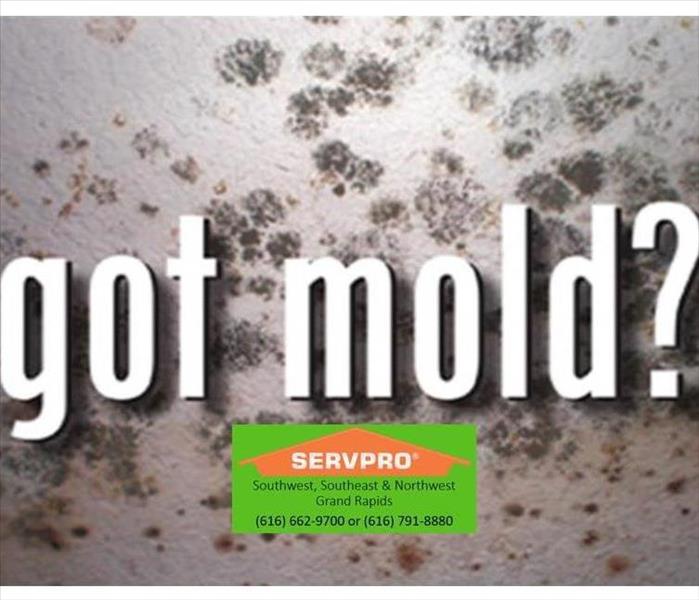 When you can see Mold, you need us!
When you can see Mold, you need us!
When there’s a water intrusion, like a roof leak or leaking water line, mold can quickly become a problem in your home or business. Mold can affect your health and can also cause significant damage to your property. Fortunately, SERVPRO® of Southwest Grand Rapids Professionals have the training, protective gear, and specialized equipment necessary to handle your mold problem. Although every mold damage scenario is different, requiring a unique solution, the general mold remediation process stays the same.
Call SERVPRO® of Southwest Grand Rapids for an estimate and we will do the rest! Our production manager will inspect your damage, give you an estimate and set you up with an appointment to get the rest of the job done.
Our trained technicians will arrive to set up the containment and air filtration system to protect from further mold spreading. We go through the process of removing the mold and Mold-Infested Materials, then we begin cleaning contents and belongings. Once that is complete we begin restoration process.
SERVPRO® of Southwest Grand Rapids understand mold and mold growth and have the training and equipment to remediate mold in your home or business. Call us at 616-662-9700, were here to help with your mold mitigation.
Be prepared for Natural Disasters
3/5/2018 (Permalink)
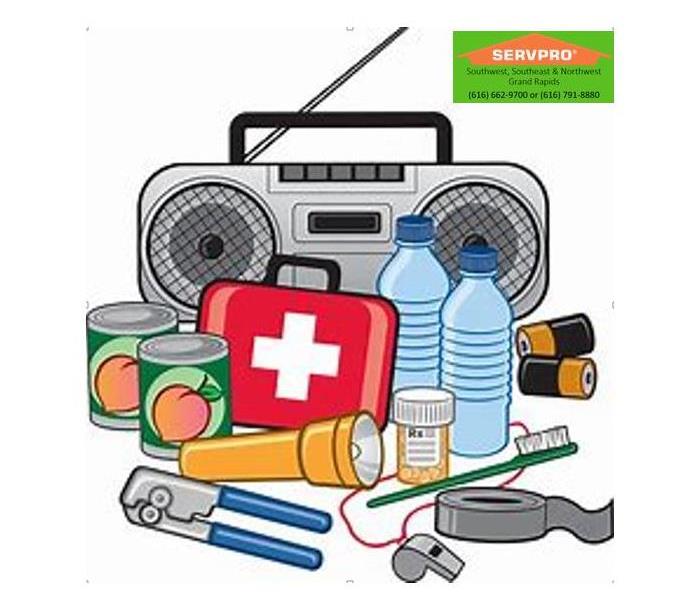 Have a kit and plan together for when the big storm hits!
Have a kit and plan together for when the big storm hits!
Don’t wait to prepare!! Emergencies can happen unexpectedly in communities just like yours, to people just like you. Tornado outbreaks, river floods, flash floods, historic earthquakes, and even water main breaks and power outages in U.S. cities affecting millions of people for days at a time.
Now is the time to think about the basics, things you will need in advance of an emergency; how you will communicate, what supplies you will need to keep in your home, car or office. Use the list provided here to build an emergency supply kit to ensure your family is equipped and ready for any type of disaster.
The more you know about what to do in an emergency, the more confident and secure you will feel in your abilities to manage through a disaster.
Preparation is the key to making it through any size disaster, whether it is a small water leak, a large fire, or an area flood. The best time to plan for such events is not when the event happens, but well before it happens. No one ever plans on a disaster, but now, you can plan for it.
Build An Emergency Supply Kit:
- Water, gallon per person per day
- Food, non-perishable 3-day supply
- Manual can opener
- Battery operated radio and extra batteries
- Flashlight and extra batteries
- First aid kit
- Whistle to signal for help
- Wrench or pliers to turn off utilities, if necessary
- Dust masks or bandanas
- Plastic sheeting, garbage bags and duct tape
- Local maps
- Hygiene items
- Clothing
- Fire extinguisher
- Matches in waterproof container
- Cash
- Important documents such as:
- Copies of insurance
- Policies, identification and
- Bank account information
Contact SERVPRO® Southwest Grand Rapids Professionals for more information and tools to help you be “Ready for whatever happens.”
Portable Fire Extinguishers
3/5/2018 (Permalink)
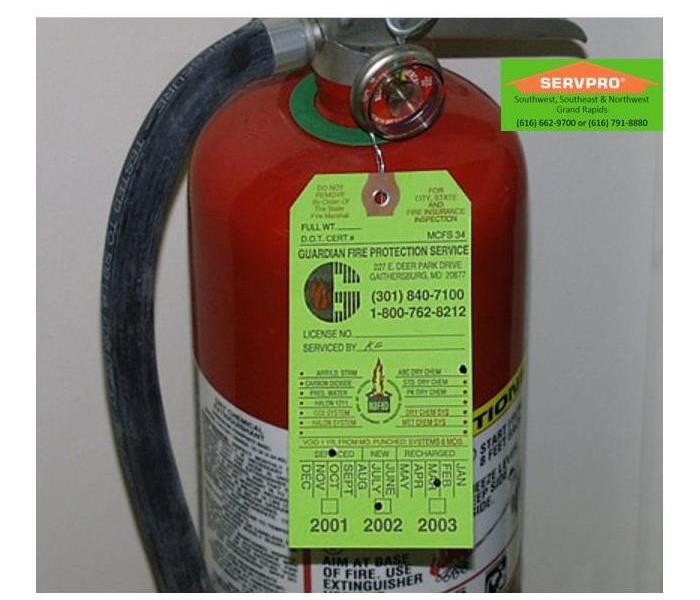 SERVPRO of Southwest Grand Rapids cleans up the mess after the extinguisher is dispensed.
SERVPRO of Southwest Grand Rapids cleans up the mess after the extinguisher is dispensed.
Portable fire extinguishers can be life and property saving tools when used correctly. Read the instructions on the fire extinguisher and become familiar with them before a fire breaks out. In order to operate an extinguisher, the National Fire Protection Association (NFPA) suggests remembering the word PASS:
Pull the pin. Hold the nozzle pointing away from you and release the locking mechanism.
Aim low. Point the extinguisher at the base of the fire.
Squeeze the lever slowly and evenly.
Sweep the nozzle from side-to-side.
Help people decide when to use a fire extinguisher
Fire extinguishers can be helpful on a small fire. Consider providing a checklist to help people prepare to use a fire extinguisher on a potential fire.
For example:
- Have I alerted others in the building that there’s a fire?
- Has someone called the fire department?
- Am I physically able to use a fire extinguisher?
- Is the fire small and contained in a single object (like a pan or a wastebasket)?
- Am I safe from the fire’s toxic smoke?
- Do I have a clear escape route?
- Use a fire extinguisher when all of these questions are answered “yes.” If you’re unsure about whether or not it’s safe to use a fire extinguisher, and for all other situations, alert others, leave the building, and call 911 from a mobile or neighbor’s phone. It is not recommended that children use fire extinguishers.
Visit US Fire Administration for more information on Choosing and using Fire extinguishers.
ARE YOU PREPARED?
3/5/2018 (Permalink)
 Our Emergency Ready Profile puts all your emergency information at the tip of your fingers 24/7.
Our Emergency Ready Profile puts all your emergency information at the tip of your fingers 24/7.
Are You Prepared? As a member of the Ready Campaign’s National Preparedness Coalition, SERVPRO® is proud to present the following information.
How quickly your company can get back to business after a tornado, fire, or flood often depends on the emergency planning done today. The regular occurrence of natural disasters demonstrates the importance of being prepared for any emergency. While each situation is unique, your organization can be better prepared if you plan carefully, put emergency procedures in place, and practice for all kinds of emergencies.
The following are common sense measures business owners and managers can take to start getting ready. A commitment to begin planning today will help support your employees, customers, the community, the local economy, and even the country. It also protects your business investment and gives your company a better chance for survival. Review the following questions to learn if your company is prepared.
Be Informed
Do you know what kind of emergencies might affect your company? Do you know what you will do in an emergency situation?
Develop a Business Continuity Plan Do you know which staff, procedures, and equipment are absolutely necessary to keep operating? Do you have backup plans for those operations? Do you know what you will do if your building or plant is not accessible? Do you know what you will do if your suppliers are impacted by a disaster? Are you ready for utility disruptions?
Prepare Your Emergency Plan
Do you have an evacuation and shelter in-place plan? Do you have a plan to communicate with employees before, during, and after an incident? Do you have copies of building and site maps with utilities and emergency routes marked? Are your employees trained for medical emergencies?
Practice the Emergency Plan
Have you practiced your plan recently? Do you practice and coordinate with other businesses in your building or industrial complex? Have you reviewed your plans in the last 12 months?
Review Insurance Coverage
Have you reviewed your insurance coverage recently to see if you’re covered in a disaster?
Secure Your Facility and Equipment
Have you secured all the ways people, products, and supplies get into your building? Have you conducted a room-by-room walk-through to determine what can be strapped down?
Improve Cybersecurity
Do you regularly install patches to your software? Have you installed a firewall on your computer? Do you regularly update your antivirus software?
Promote Family and Individual Preparedness
Do you encourage employees to have a personal emergency supply kit and a family communication plan?
If you answered “No” to any of these questions, visit ready.gov and learn how to better prepare your business. Or call SERVPRO® of Southwest Grand Rapids at 616-662-9700 and ask to speak to us about the Emergency Ready Plan.
Southwest Grand Rapids, Are you prepared for Thunderstorms?
5/8/2017 (Permalink)
Southwest Grand Rapids, To prepare for a thunderstorm, you should do the following:
- To begin preparing, you should build an emergency kit and make a family communications plan.
- Remove dead or rotting trees and branches that could fall and cause injury or damage during a severe thunderstorm.
- Postpone outdoor activities.
- Secure outdoor objects that could blow away or cause damage.
- Get inside a home, building, or hard top automobile (not a convertible). Although you may be injured if lightning strikes your car, you are much safer inside a vehicle than outside.
- Remember, rubber-soled shoes and rubber tires provide NO protection from lightning. However, the steel frame of a hard-topped vehicle provides increased protection if you are not touching metal.
- Shutter windows and secure outside doors. If shutters are not available, close window blinds, shades or curtains.
- Unplug any electronic equipment well before the storm arrives.
Lightning Risk Reduction When Outdoors
If you are:
- In a forest; Seek shelter in a low area under a thick growth of small trees.
- In an open area; Go to a low place such as a ravine or valley. Be alert for flash floods.
- On open water; Get to land and find shelter immediately.
Facts about Thunderstorms
- They may occur singly, in clusters or in lines.
- Some of the most severe occur when a single thunderstorm affects one location for an extended time.
- Thunderstorms typically produce heavy rain for a brief period, anywhere from 30 minutes to an hour.
- Warm, humid conditions are highly favorable for thunderstorm development.
- About 10 percent of thunderstorms are classified as severe – one that produces hail at least an inch or larger in diameter, has winds of 58 miles per hour or higher or produces a tornado.
Facts about Lightning
- Lightning’s unpredictability increases the risk to individuals and property.
- Lightning often strikes outside of heavy rain and may occur as far as 10 miles away from any rainfall.
- “Heat lightning” is actually lightning from a thunderstorm too far away from thunder to be heard. However, the storm may be moving in your direction.
- Most lightning deaths and injuries occur when people are caught outdoors in the summer months during the afternoon and evening.
- Your chances of being struck by lightning are estimated to be 1 in 600,000 but could be reduced even further by following safety precautions.
- Lightning strike victims carry no electrical charge and should be attended to immediately.
Know the Terms
Familiarize yourself with these terms to help identify a thunderstorm hazard:
Severe Thunderstorm Watch - Tells you when and where severe thunderstorms are likely to occur. Watch the sky and stay tuned to NOAA Weather Radio, commercial radio or television for information.
Severe Thunderstorm Warning - Issued when severe weather has been reported by spotters or indicated by radar. Warnings indicate imminent danger to life and property to those in the path of the storm.
Source ready.gov
If a Thunderstorm should hit your property and you need restoration services due to Storm Damage, Call SERVPRO of Southwest Grand Rapids at 616-662-9700 24/7 emergency services available.
When Tornadoes cause damage to your Southwest Grand Rapids property
5/8/2017 (Permalink)
Tornadoes are nature’s most violent storms. Spawned from powerful thunderstorms, tornadoes can cause fatalities and devastate a neighborhood in seconds. A tornado appears as a rotating, funnel-shaped cloud that extends from a thunderstorm to the ground with whirling winds that can reach 300 miles per hour. Damage paths can be in excess of one mile wide and 50 miles long. Every state is at some risk from this hazard. Some tornadoes are clearly visible, while rain or nearby low-hanging clouds obscure others. Occasionally, tornadoes develop so rapidly that little, if any, advance warning is possible. Before a tornado hits, the wind may die down and the air may become very still. A cloud of debris can mark the location of a tornado even if a funnel is not visible. Tornadoes generally occur near the trailing edge of a thunderstorm. It is not uncommon to see clear, sunlit skies behind a tornado
After A Tornado
- Listen to local officials for updates and instructions.
- Check-in with family and friends by texting or using social media.
- Watch out for debris and downed power lines.
- If you are trapped, do not move about or kick up dust. Tap on a pipe or wall or use a whistle, if you have one, so that rescuers can locate you.
- Stay out of damaged buildings and homes until local authorities indicate it is safe.
- Photograph the damage to your property in order to assist in filing an insurance claim.
- Do what you can to prevent further damage to your property, (e.g., putting a tarp on a damaged roof), as insurance may not cover additional damage that occurs after the storm.
- If your home is without power, use flashlights or battery-powered lanterns rather than candles to prevent accidental fires.
Source ready.gov
If a Tornado should hit your property and you need restoration services due to Storm Damage, Call SERVPRO of Southwest Grand Rapids at 616-662-9700 24/7 emergency services available.
Do you have an Emergency Communication Plan for when disaster strikes?
5/8/2017 (Permalink)
This page explains what an emergency communication plan is and why you should make one. It also provides tips and templates on how to make a plan. The following information is from ready.gov.
Why Make A Plan
Your family may not be together if a disaster strikes, so it is important to think about the following situations and plan just in case. Consider the following questions when making a plan:
- How will my family/household get emergency alerts and warnings?
- How will my family/household get to safe locations for relevant emergencies?
- How will my family/household get in touch if cell phone, internet, or landline doesn’t work?
- How will I let loved ones know I am safe?
- How will family/household get to a meeting place after the emergency?
Here are a few easy steps to start your emergency communication plan:
- Understand how to receive emergency alerts and warnings. Make sure all household members are able to get alerts about an emergency from local officials. Check with your local emergency management agency to see what is available in your area, and learn more about alerts by visiting: ready.gov/alerts.
- Discuss family/household plans for disasters that may affect your area and plan where to go.Plan together in advance so that everyone in the household understands where to go during a different type of disaster like a hurricane, tornado, or wildfire.
- Collect information.Create a paper copy of the contact information for your family that includes:
- phone (work, cell, office)
- email
- social media
- medical facilities, doctors, service providers
- school
- Identify information and pick an emergency meeting place. Things to consider:
- Decide on safe, familiar places where your family can go for protection or to reunite.
- Make sure these locations are accessible for household members with disabilities or access and functional needs.
- If you have pets or service animals, think about animal-friendly locations.
Examples of meeting places:
- In your neighborhood: A mailbox at the end of the driveway, or a neighbor’s house.
- Outside of your neighborhood: library, community center, place of worship, or family friend’s home.
- Outside of your town or city: home of a relative or family friend. Make sure everyone knows the address of the meeting place and discuss ways you would get there.
- Share information. Make sure everyone carries a copy in his or her backpack, purse, or wallet. You should also post a copy in a central location in your home, such as your refrigerator or family bulletin board.
- Practice your plan. Have regular household meetings to review your emergency plans, communication plans and meeting place after a disaster, and then practice, just like you would a fire drill.
Source ready.gov
When disaster hits your property and you need restoration services due to Storm Damage, Call SERVPRO of Southwest Grand Rapids at 616-662-9700 24/7 emergency services available.
Southwest Grand Rapids it’s the water you don’t see that causes the damage!
5/1/2017 (Permalink)
Even small water damages have the potential to cause serious structural and indoor air quality issues over time. The key to avoiding costly problems in the future is to handle every water damage as a threat to your property. SERVPRO of Southwest Grand Rapids has the equipment, training and experience to find and dry unseen water before secondary damages occur. The proper equipment makes a measurable difference in reducing the damage expense during a fire or water loss. When time matters, technology and equipment must be counted on to perform.
SERVPRO of Southwest Grand Rapids will answer your call with rapid action and a full arsenal of drying equipment. Here are a few of the tools used by SERVPRO of Southwest Grand Rapids Professionals.
- Moisture Sensors are used to detect moisture in carpets, baseboards and walls.
- Moisture Meters are used to determine the actual moisture content of various materials. The moisture tester provides accurate readings, allowing our technicians to monitor the drying process.
- Thermohygrometers measure temperature and relative humidity.
When armed with this information, SERVPRO of Southwest Grand Rapids can calculate and create an environment most condusive to drying. When facing a contaminated water loss, it is not only important to dry the structure, but the structure must also be disinfected and often deodorized.
- Ultra Low-Volume (ULV) Foggers will atomize liquid deodorizing agents, producing a fine mist that can easily penetrate the site where odor-causing residues may accumulate. This device can also be used to inject fungicides and disinfectants into wall cavities and other hard-to-reach areas.
- Thermal Foggers dispense solvent-based products by creating a dense fog. The fog consists of tiny particles of deodorant solution that attach to and neutralize odor-causing particles.
The bottom line? SERVPRO of Southwest Grand Rapids has the training and equipment to help make it “Like it never even happened.” Contact us at 616-662-9700 today for 24-hour emergency service.
Southwest Grand Rapids Leave the Hassle of Board-Ups to the Professionals
5/1/2017 (Permalink)
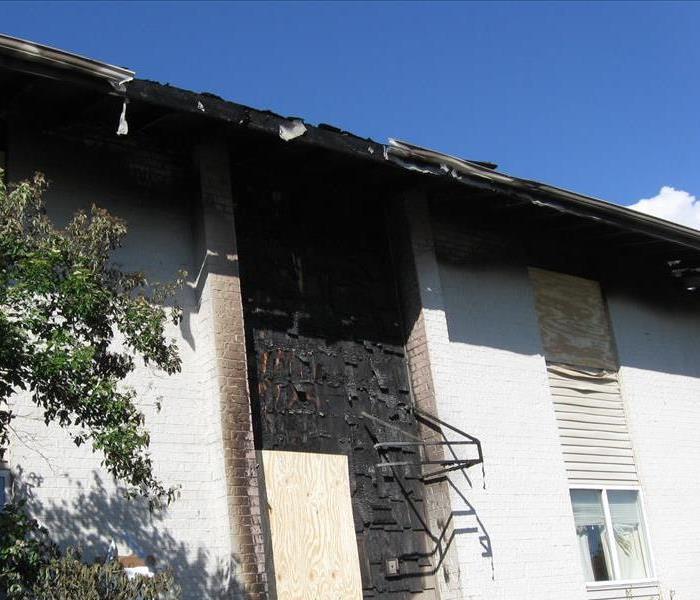 Boarded up apartment after a fire.
Boarded up apartment after a fire.
Why take the risk? Call a SERVPRO of Southwest Grand Rapids.
Whether after a fire, storm, or other structural disaster, boarding up damaged property is a burden that no one should ever have to go through—especially if it is your property that has been damaged.
Boarding up damaged property incorrectly could cause secondary damages such as moisture or animal intrusion, making the situation even worse. The process of boarding up after an unexpected damage can also be as dangerous as the damage itself.
SERVPRO of Southwest Grand Rapids can board up the damaged property and mitigate and remediate the original damage, providing you with peace of mind while helping make it
“Like it never even happened.” Contact us at 616-662-9700 for 24/7 emergency service.
Southwest Grand Rapids Get the facts on mold.
5/1/2017 (Permalink)
Mold is not a plant or an animal. It is a type of fungus and a fact of life. According to the Center for Disease Control (CDC), there is always a little mold everywhere and one cannot avoid being exposed to it. It grows year round and is found both inside and outside. Mold has existed for at least 400 million years and doesn't need much to grow. All it takes is moisture, warmth and food.
If you are concerned, make sure to check out areas in your home where humidity and moisture levels are high. This includes bathrooms, kitchens, basements, and in walls where water from leaky pipes can accumulate.
The National Association of Home Builders says that in just 48 hours, a moist environment combined with the right room-temperature conditions can lead to mold growth. While you cannot keep mold spores completely out of your home, regular cleaning can often prevent severe problems before they arise. Log onto the U.S. Environmental Protection Agency's Web site for more details at epa.gov.
SERVPRO of Southwest Grand Rapids can mitigate and remediate the original damage, providing you with peace of mind while helping make it “Like it never even happened.” Call us today at 616-662-9700.
Southwest Grand Rapids, Who can clean up Mold?
5/1/2017 (Permalink)
If you have mold, determining who should clean it up depends on several factors.
One consideration is the size of the mold problem. A little bit of mold in your shower is nothing to worry about. Frequent maintenance with bleach and water can do the trick. If the mold problem covers less than 10 square feet, chances are you can handle the cleanup yourself.
When handling or cleaning moldy materials wear gloves, goggles, and dress in long sleeves. If you want to limit your exposure to mold, you may want to consider wearing a respirator. They are available at many hardware stores for about $12 to $50. Also make sure the room is properly ventilated. Open a window, and get some fresh air.
If the problem extends beyond 10 square feet, consult the EPA's guide: Mold Remediation in Schools and Commercial Buildings. Although it focuses on larger buildings, the advice applies to other areas as well. For a free copy call 1-800-438-4318.
If you are developing a more severe mold problem you will most likely not only be able to see it, but also smell it. Have you ever walked into a room with a musty odor? Chances are you smell mold. Keep in mind, sometimes you will not be able to see the mold because it may be hidden on the back of the wallpaper, tile, drywall or even underneath the carpet.
If you detect mold on the surface or on some of your items, the items may be discolored or looked smudged and blotched. When hiring a professional to do the cleanup, make certain you are dealing with someone who is trained in this type of cleanup.
You'll want to be very careful when hiring someone to do the job. SERVPRO of Southwest Grand Rapids is trained in Mold mitigation, with 25 years of experience. Don’t get stuck with an inexperienced remediator who ends up botching the job. And remediation can be very costly, ranging from a couple of hundred dollars to more than $100,000. Also make sure to check references and a company's complaint record with the Better Business Bureau.
One other point: non-porous items such as glass and hard plastics that are still in good condition after the mold has been removed can be reused after a thorough cleaning. But items such as carpeting, clothing and insulation should be thrown out.
SERVPRO of Southwest Grand Rapids can mitigate and remediate the original damage, providing you with peace of mind while helping make it “Like it never even happened.” Call us today at 616-662-9700.
Southwest Grand Rapids Take control of the Mold situation.
5/1/2017 (Permalink)
Moisture control is the key to controlling mold. Take time to check for water damage in your home, especially in your basement.
The CDC also recommends keeping the humidity level in your house below 50 percent. Use an air conditioner during humid months. Make sure to check the ventilation in the kitchen and the bathroom. Open a window or turn on a fan when showering. Do not carpet bathrooms and consider using mold inhibitors that can be added to paints.
If you see moisture building up, act quickly and dry the area. If you have any water leaks, whether it is coming in through the roof, or from a pipe or the ground, patch it up immediately.
Another thing to keep in mind: The recent trend in housing construction has been for "tight" houses that allow little air circulation. While they can be more energy efficient, they also encourage mold, because water that gets trapped inside walls may not be able to escape. In other words, the house doesn't "breathe."
While it is possible to have your home tested for mold, the CDC says reliable testing can be expensive. It also says that standards for judging what is and what is not an acceptable or a tolerable quantity of mold have yet to be established. Also, if you do have your home tested, chances are you won't get back the results for a couple of weeks. During that time the problem could get even worse.
Your best bet is to clean the area immediately if you think you see or smell mold. If you are determined to hire a technician to test the area, check with your local health department for references.
SERVPRO of Southwest Grand Rapids can mitigate and remediate the original damage, providing you with peace of mind while helping make it “Like it never even happened.” Call us today at 616-662-9700.
Southwest Grand Rapids Know your insurance coverage for Mold.
5/1/2017 (Permalink)
From the insurance perspective, damage from mold, like rust, rot and mildew is excluded from the typical homeowner’s policy.
The Insurance Information Institute says mold is covered under the homeowner’s policy, only if it is the result of a covered danger. For example, the costs of cleaning up mold caused by water from a burst pipe are covered. But mold that develops from, say, humidity or flooding is a maintenance issue that the property owner is responsible for.
The insurance industry argues that in order to keep homeowners insurance affordable and available to the masses this coverage wound up being excluded. If the policyholder does want mold coverage there is going to be an additional premium for it.
One thing to keep in mind is that there have been fewer claims recently. But critics say that is simply because insurers no longer cover the damage, so if it's not covered people do not put in claims.
SERVPRO of Southwest Grand Rapids can mitigate and remediate the original damage, providing you with peace of mind while helping make it “Like it never even happened.” Call us today at 616-662-9700.
Call the CLEANUP TEAM SERVPRO of Southwest Grand Rapids, Faster to any size disaster
5/1/2017 (Permalink)
There’s no such thing as a small disaster—especially when a small leak now could blossom into a big claim later. Unseen water can soak through walls, seep through carpet and pool on sub floors, causing major problems over time. You need help—fast. No matter what time of day or night, contact SERVPRO of Southwest Grand Rapids at 616-662-9700 to begin emergency mitigation.
Emergency mitigation means that under normal circumstances, we will be on-site within four hours to begin drying your building and restoring contents. The faster the water is removed, the less chance of serious damage to your facility. Every SERVPRO of Southwest Grand Rapids technician is trained and understands how to manage the drying process. By utilizing state-of-the-art equipment and the latest technology, your structure will be quickly and thoroughly dried, which helps prevent secondary water damages.
SERVPRO of Southwest Grand Rapids will remove moisture and any contaminants by disinfecting and deodorizing to safely clean and dry your building and contents. Help ensure the value of your property by calling us at 616-662-9700.
It only takes 1 to 2 inches of water to begin damage to your Southwest Grand Rapids property
5/1/2017 (Permalink)
Image it’s 8:00 p.m. on a Sunday, and you walk into your home after a relaxing vacation expecting to switch on the lights, put the kids to bed then get some rest yourself.
The only problem? A water pipe burst over the weekend, dumping thousands of gallons of water over your hardwood kitchen floor, your carpeted living room and your cement utility room. You realize this problem is far beyond the reach of your shop vac. What do you do now?
When it is your home or business that is underwater, mitigation cannot wait. You need mitigation to begin immediately. If water damage strikes you or your neighbor give SERVPRO of Southwest Grand Rapids a call at 616-662-9700 any time, any day.
The cost of water damages can increase exponentially with time. Wood Floors warp, dry wall soaks in moisture and mold develops in hard-to-reach areas of your home or business.
The benefit of rapid mitigation offer by SERVPRO of southwest Grand Rapids are two-fold: Your costs go down as potential hazards may be avoided, and your peace of mind goes through the roof.
If the unthinkable happens to your home or business, allow SERVPRO of Southwest Grand Rapids to help quickly turn your “before” into a “happily ever after.”
Southwest Grand Rapids understand water types to ensure proper clean up
5/1/2017 (Permalink)
When your home or business suffers a water damage, understanding what type of water you are dealing with is critical to ensuring proper cleanup.
There are three types of water. Clean water is water from a broken pipe, or other water source; rainwater is also considered clean. The term gray water is used to classify slightly contaminated water. Clean water becomes gray water when it is left untreated allowing bacteria and other contaminants to begin growing, making the water hazardous. Black water is highly contaminate and filled with fungi, bacteria, chemicals and more. Black water is typically caused by sewage damage, flooding or any type of natural disaster. Black water should always be handled by trained professionals.
Consider taking the following precautions to help minimize damage or prevent further damage while waiting for help to arrive.
Damage from Clean Water
- Shut off the water source if possible or contact a qualified professional to do so.
- Turn off circuit breakers for wet areas of the building if access to the power distribution panel is safe from potential electrical shock. Do not enter rooms with standing water, as electrical shock hazards may exist.
- Remove as much excess water as possible by mopping and blotting. Wipe excess water from wood furniture after removing lamps and table top items.
- Remove and prop up wet upholstery cushions to allow more even drying.
- Move any paintings, art objects, computers, document sand other valuable items that may be sensitive to moisture to a safe place.
- Do not leave books, newspapers, magazines or other colored items on wet carpets or floors as they may cause staining.
- Do not use your household vacuum cleaner to remove water as there is potential for electrical shock or causing damage to the vacuum cleaner.
- Do not turn on ceiling fixtures if ceiling is wet; do not enter rooms where ceilings are sagging from retained water.
Damage from Contaminated Water
- Avoid all contact with sewage and items contaminated by sewage. Wash your hands thoroughly if you come in contact with contaminated items.
- Do not walk through contaminated areas, as you could spread damage to unaffected areas.
- Do not turn on the HVAC system if there is a possibility of spreading contaminated air.
- Discard any food and/or products for personal hygiene and cleanliness if exposed to the contaminated areas.
When you have a water damage, don’t leave your property to chance. Call SERVPRO of Southwest Grand Rapids at 616-662-9700.
6 Money-Saving Spring-Cleaning Hacks For Your Home
4/10/2017 (Permalink)
Spring is here and with it that familiar itch to overhaul your living space. Before you go wild buying fancy cleaning tools to eliminate every last speck of dust or raid your local home store for seasonal accents to fill every room in your house, pause to consider the cost. Spring cleaning doesn't have to be expensive. We've rounded up some affordable yet effective ways you can update your space.
Sell What You No Longer Need
Spring is about renewal, and Spring cleaning is about letting go of the old to make way for the new. So if you find yourself left with a pile of decor and furniture that no longer serves you, considering selling pieces or donating to organizations.
Rent or Borrow Expensive Equipment
Maybe you don't have room in your home for hefty cleaning supplies or maybe you just don't use them enough to justify the investment. This doesn't mean you can't go deep with your Spring cleaning; it just means you should outsource that carpet steamer or floor polisher, renting from local store or even borrowing from a neighbor or friend.
Shop Organizing Products Shrewdly
Baskets, bins, trays and canisters — these are the organization tools you need to organize pretty much every room in your home. And while buying them is a necessary evil for Spring cleaning, it doesn't have to be a budget blower. Instead of splurging on fancy products from name brand stores, shop at more affordable retailers.
Touch Up Old Pieces
If you do simple touch ups yourself, you may find you don't need to replace that dinged up ancient piece of furniture after all. A paint pen can erase a scratches in your table while a coat of fresh paint will make a chipped dresser look like new, all giving your home that fresh Spring look without the big expense.
DIY Products
From finding brilliant ways to clean everything in your home with WD-40 and vinegar, to mixing up your own fragrant air freshener, skip the expensive products and make your own.
Rearrange Your Furniture
Spring cleaning can remind you of what you hate or want to replace in your house, but if redecorating isn't in the budget, try rearranging instead. You'll be shocked by what a big design difference it makes to simply move pieces around — not to mention how much easier it is on your wallet.
https://www.popsugar.com/home/How-Spring-Clean-Budget-43350064
Is the job too big for you to handle? Call Us 24/7 – SERVPRO of Southwest Grand Rapids 616-662-9700
It's spring. Here's how to allergy-proof each room of your home
4/10/2017 (Permalink)
Warmer-than-normal weather launched allergy season early this year, pumping up pollen counts across much of the nation. And if you think you can retreat indoors to relieve your sniffles, think again.
Two thirds of people with allergies suffer them year round, said allergist James Sublett, M.D., co-founder of Family Allergy & Asthma in Lousville, Ky. And the leading cause of those year-round allergies are dust mites, animals and cockroaches, he said, all of which make their homes inside of ours.
Outdoor allergens will make it into our homes through normal ventilation, Sublett said. "And of course it gets tracked in, too."
If you can't escape allergens, it's time to go on the attack. Here are Sublett's tips on allergy-proofing each room of your home.
The bedroom
Your bedroom deserves the most attention, Sublett said, since you lie and breathe there for eight or so hours a night. Dust mites live primarily in bedding, so buy a set of high-quality, mite-proof encasements for your pillows and mattress. They should be tightly woven with zippers that seal completely. Wash all your bedding weekly in any temperature of water to kill any mites. Doing this weekly is key as it ensures you eliminate both mites and their eggs before they hatch, Sublett said.
If you're allergic to pollen, it's a good idea to shower at night before bed. And consider keeping your room a pet-free zone, as a Golden Retriever can track in allergens on a high pollen day.
The living room
Your living room, and any space you spend much time in, should have "smooth surfaces as much as possible," Sublett said. Smooth, clear surfaces wipe down easily, such as a hardwood floor or a plastic chair. Window blinds are perhaps preferable to drapes for the same reason, he said. Avoid rugs or carpeting whenever possible.
"I know the carpeting industry doesn’t like this idea, but when you have a carpet, you do have like a big sponge there that collects dust," he said. "Normal activity is going to throw that back up in the air."
If rugs and carpeting are unavoidable, regular vacuuming removes much of the dust. Sublett recommends a respirator mask to protect from particles while cleaning—just make sure it's an N95 respirator that's NIOSH-approved, he said. Finding a high-quality disposable air filter for your furnace is important, too, Sublett said. Most are made to be replaced every three months.
The kitchen
Your biggest enemy in the kitchen is mold. Periodically clean any spots where leaks or spills might occur, including under the sink and your refrigerator's drain pan, Sublett said. When you do clean, avoid products with strong odors or fumes. Sublett prefers a small amount of bleach mixed in a bucket of water with some dishwasher detergent. And seal food in stored containers, leaving nothing that might attract pests such as cockroaches.
The bathroom
Using a ventilation fan when you shower helps cut back on your home's humidity, which should stay under 50% to ensure dust mites lack the moisture to thrive, Sublett said. A humidistat will help you measure it. Avoid humidifiers or vaporizers in the home, too.
The laundry room
Don't leave out piles of damp clothing and towels, Sublett said, which become a welcome mat for dust mites and mold. Ensure your clothes dryer vents to the outside of your home, too, doing away with excess moisture.
http://www.usatoday.com/story/news/nation-now/2017/03/24/s-spring-heres-how-allergy-proof-each-room-your-home/99563062/?utm_source=feedblitz&utm_medium=FeedBlitzRss&utm_campaign=usatodaycomnation-topstories
Have Questions? Gives a call – SERVPRO of Southwest Grand Rapids 616-662-9700
Southwest Grand Rapids 24 Hour Emergency Water Damage Service
4/10/2017 (Permalink)
SERVPRO of Southwest Grand Rapids is available 24 hours a day for water emergencies, large or small. When you are dealing with water damage, immediate action is crucial. A delay of just a few hours can greatly increase the severity of the water damage.
We Answer the Phone Ready to Help Call Today – 616-227-9700
We understand that when you call us, you may be feeling confused, stressed, and vulnerable. You need an expert to guide you through this crisis. SERVPRO of Southwest Grand Rapids has the specific water damage training and experience to help you through this tough time. We specialize in water damage restoration—in fact, it's the cornerstone of our business.
What to Expect
When you call, we will ask several questions regarding your water damage emergency. These questions will help us determine what equipment and resources to bring, including how many trained SERVPRO Professionals may be needed.
Our SERVPRO Representative will ask several questions:
- Your name and contact information
- Your insurance information (if applicable)
- The street address of the water-damaged home or business
- When did the flooding or water damage occur?
- What caused the water damage (if known)?
- Is there electricity available (on-site)?
About SERVPRO of Southwest Grand Rapids
SERVPRO of Southwest Grand Rapids specializes in the cleanup and restoration of residential and commercial property after a fire, smoke or water damage event. Our staff is highly trained in property damage restoration. From initial and ongoing training at SERVPRO’s corporate training facility to regular IICRC-industry certification, rest assured our staff is equipped with the knowledge to restore your property.
http://www.SERVPROsouthwestgrandrapids.com/employee-photos
Certifications
- UFT - Upholstery & Fabric Cleaning Technician
- SRT - Fire & Smoke Damage Restoration Technician
- IICRC Certified Firm
- HST - Health and safety Technician
- WRT - Water Damage Restoration Technician
- CMR - Council-certified Microbial Remediator
- CCT - Carpet Cleaning Technician
- ECTP - Employee Certification Training Program
Does Your Southwest Grand Rapids Home Have A Mold Problem?
4/10/2017 (Permalink)
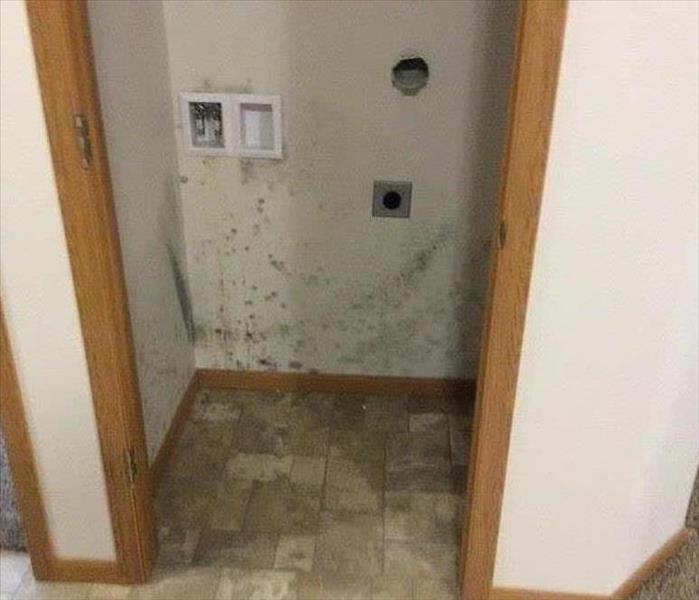 In Southwest Grand Rapids, mold can spread through a home in as little as 48 hours.
In Southwest Grand Rapids, mold can spread through a home in as little as 48 hours.
Microscopic mold spores naturally occur almost everywhere, both outdoors and indoors. This makes it impossible to remove all mold from a home or business. Therefore, mold remediation reduces the mold spore count back to its natural or baseline level. Some restoration businesses advertise “mold removal” and even guarantee to remove all mold, which is a fallacy. Consider the following mold facts:
- Mold is present almost everywhere, indoors and outdoors.
- Mold spores are microscopic and float along in the air and may enter your home through windows, doors, or AC/heating systems or even hitch a ride indoors on your clothing or a pet.
- Mold spores thrive on moisture. Mold spores can quickly grow into colonies when exposed to water. These colonies may produce allergens and irritants.
- Before mold remediation can begin, any sources of water or moisture must be addressed. Otherwise, the mold may return.
- Mold often produces a strong, musty odor and can lead you to possible mold problem areas.
- Even higher-than-normal indoor humidity can support mold growth. Keep indoor humidity below 45 percent.
If your home or business has a mold problem, we can inspect and assess your property and use our specialized training, equipment, and expertise to remediate your mold infestation.
If You See Signs of Mold, Call Us Today – 616-662-9700
When Storms or Floods hit Southwest Grand Rapids, SERVPRO is ready!
4/10/2017 (Permalink)
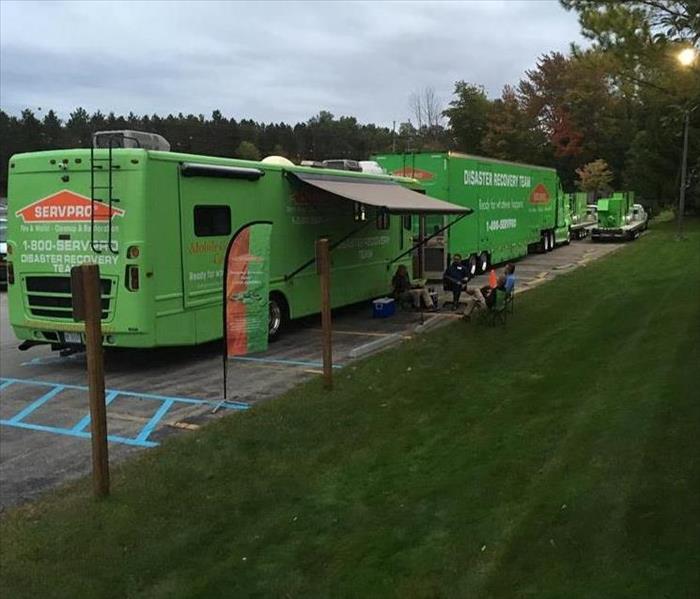 Our highly trained crews are ready to respond 24/7 to storm or flood damage in Southwest Grand Rapids.
Our highly trained crews are ready to respond 24/7 to storm or flood damage in Southwest Grand Rapids.
SERVPRO of Southwest Grand Rapids specializes in storm and flood damage restoration. Our crews are highly trained and we use specialized equipment to restore your property to its pre-storm condition.
Faster Response
Since we are locally owned and operated, we are able to respond quicker with the right resources, which is extremely important. A fast response lessens the damage, limits further damage, and reduces the restoration cost.
Resources to Handle Floods and Storms
When storms hit Southwest Grand Rapids, we can scale our resources to handle a large storm or flooding disaster. We can access equipment and personnel from a network of 1,650 Franchises across the country and elite Disaster Recovery Teams that are strategically located throughout the United States.
Have Storm or Flood Damage? Call Us Today 616-662-9700
For Immediate Service in Southwest Grand Rapids, Call SERVPRO
4/10/2017 (Permalink)
 Southwest Grand Rapids Residents: We provide immediate service day or night!
Southwest Grand Rapids Residents: We provide immediate service day or night!
SERVPRO of Southwest Grand Rapids provides 24-hour emergency service and is dedicated to being faster to any-sized disaster in Southwest Grand Rapids. We can respond immediately to your emergency and have the expertise to handle your restoration or cleaning needs.
- 24-Hour Emergency Service
- Faster to Any-Sized Disaster
- Highly Trained Restoration Technicians
- A Trusted Leader in the Restoration Industry
- Locally Owned and Operated
- Advanced Restoration and Cleaning Equipment
Have Questions? Call Us 24/7 – 616-662-9700
Residential Services
Whether your Southwest Grand Rapids home needs emergency flood damage or your upholstery cleaned, you can depend on us. Our technicians have extensive cleaning and restoration training and can make your property look its best. Learn more about our residential services:
- Water Damage Restoration
- Fire Damage Restoration
- Mold Remediation
- Storm Damage Restoration
- Cleaning Services
- Building/Reconstruction Services
Commercial Services
There's never a convenient time for fire or Water damage to strike your Southwest Grand Rapids commercial property. Every hour spent cleaning up is an hour of lost revenue and productivity. So when the need arises for professional cleaning or emergency restoration services we have the training and expertise to respond promptly with highly trained technicians to get your property back to business. Learn more about our commercial services:
http://www.SERVPROsouthwestgrandrapids.com/commercial-cleaning
- Commercial Water Damage Restoration
Commercial Fire Damage Restoration
Southwest Grand Rapids, MI Residents: Follow These Mold Safety Tips If You Suspect Mold
3/21/2017 (Permalink)
If you see visible mold, do not disturb it. You can inadvertently spread the mold infestation throughout your home. When mold is disturbed, the mold can release microscopic mold spores which become airborne and can circulate inside your home.
What to Do:
- Stay out of affected areas.
- Turn off the HVAC system and fans.
- Contact SERVPRO of Southwest Grand Rapids for mold remediation services.
What Not to Do:
- Don’t touch or disturb the mold.
- Don’t blow air across any surfaces with visible or suspected mold growth.
- Don’t attempt to dry the area yourself.
- Don’t spray bleach or other disinfectants on the mold.
About Our Mold Remediation Services
SERVPRO of Southwest Grand Rapids specializes in mold cleanup and restoration, in fact, it’s a cornerstone of our business. Our crews are highly trained restoration professionals that use specialized equipment and techniques to properly remediate your mold problem quickly and safely.
If You See Signs of Mold, Call Us Today – 616-662-9700
Southwest Grand Rapids, Smoke and Soot Cleanup
3/21/2017 (Permalink)
Smoke and soot is very invasive and can penetrate various cavities within your home, causing hidden damage and odor. Our smoke damage expertise and experience allows us to inspect and accurately assess the extent of the damage to develop a comprehensive plan of action.
Smoke and soot facts:
- Hot smoke migrates to cooler areas and upper levels of a structure.
- Smoke flows around plumbing systems, seeping through the holes used by pipes to go from floor to floor.
- The type of smoke may greatly affect the restoration process.
Different Types of Smoke
There are two different types of smoke–wet and dry. As a result, there are different types of soot residue after a fire. Before restoration begins, SERVPRO of Southwest Grand Rapids, will test the soot to determine which type of smoke damage occurred. The cleaning procedures will then be based on the information identified during pretesting. Here is some additional information:
Wet Smoke – Plastic and Rubber
- Low heat, smoldering, pungent odor, sticky, smeary. Smoke webs are more difficult to clean.
Dry Smoke – Paper and Wood
- Fast burning, high temperatures, heat rises therefore smoke rises.
Protein Fire Residue – Produced by evaporation of material rather than from a fire
- Virtually invisible, discolors paints and varnishes, extreme pungent odor.
Our Fire Damage Restoration Services
Since each smoke and fire damage situation is a little different, each one requires a unique solution tailored for the specific conditions. We have the equipment, expertise, and experience to restore your fire and smoke damage. We will also treat your family with empathy and respect and your property with care.
Have Questions about Fire, Smoke, or Soot Damage?
Call Us Today – 616-662-9700
We Specialize in Flooded Basement Cleanup and Restoration!
3/14/2017 (Permalink)
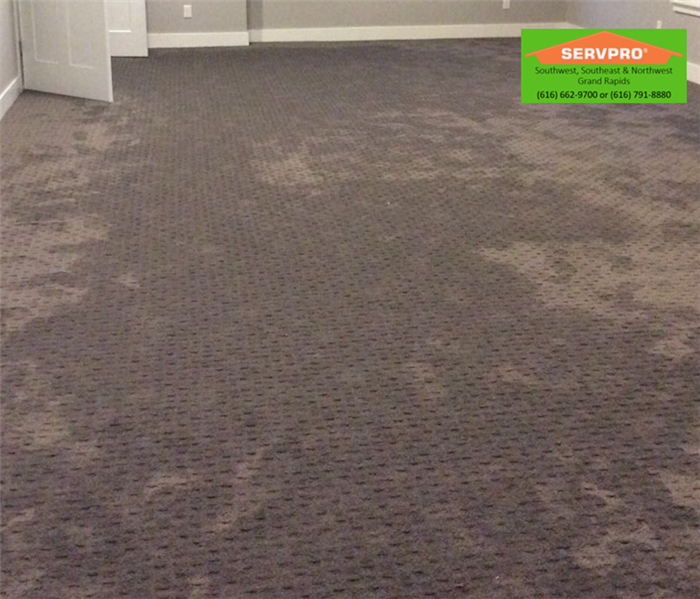 Frozen water line burst in the wall of this Southwest Grand Rapids home.
Frozen water line burst in the wall of this Southwest Grand Rapids home.
A basement can flood at any time, although flooding most often occurs during heavy rainfall. Basements are inherently prone to flooding because they are the lowest level of a building and are normally built partly or entirely below ground level. There are a number of reasons why your Grand Rapids basement could flood, including:
- A blocked or failed sewer lateral pipe
- Heavy rain causes surface water to pool around your home
- Foundation drainage failure
- Water supply-line break or hot-water tank failure
Customer Testimonial - Joyce G "Our basement flooded due to septic pump failure and SERVPRO of SW, SE, NW Grand Rapids responded to my call with-in 15 minutes with a team of Professionally Trained technicians. Their handled all of our furniture and belonging’s with extreme care. It was a real blessing to have them in my home to relieve the stress of the situation and to have all everything cleaned out beyond my expectations."
Have Questions about Basement Flooding?
Call Today - 616-662-9700
If flood water is not handled quickly and properly, it can jeopardize your health and safety, and cause severe damage to your home’s structure. Remember, the longer you wait, the worse the problem will get.
The bottom line: a flooded basement can jeopardize your health, safety, and your home’s integrity. It’s worth making a call to SERVPRO of Southwest Grand Rapids and let our trained, professional crews handle the situation safely and correctly. We have earned the trust of hundreds of homeowners, business owners, and property professionals.
We are Flooded Basement Specialists:
- We are Available 24 hours/7 days per week
- We’re a Preferred Vendor to many National Insurance Companies
- We Bill The Insurance Directly – One Less Thing For You To Worry About
- Our Technicians are Highly-Trained in Water Restoration Techniques
- We use s500 IICRC Restoration Standards
- Advanced Inspection and Extraction Equipment




 24/7 Emergency Service
24/7 Emergency Service





